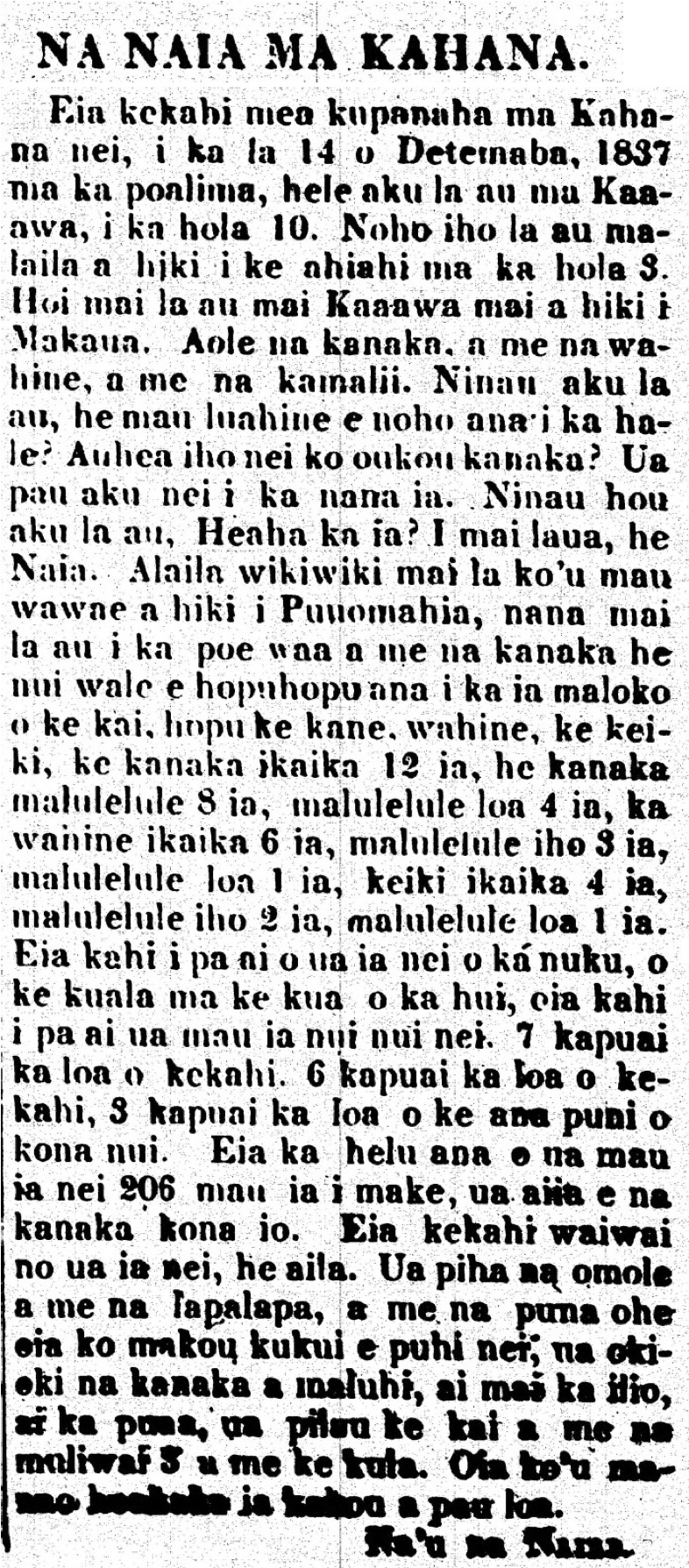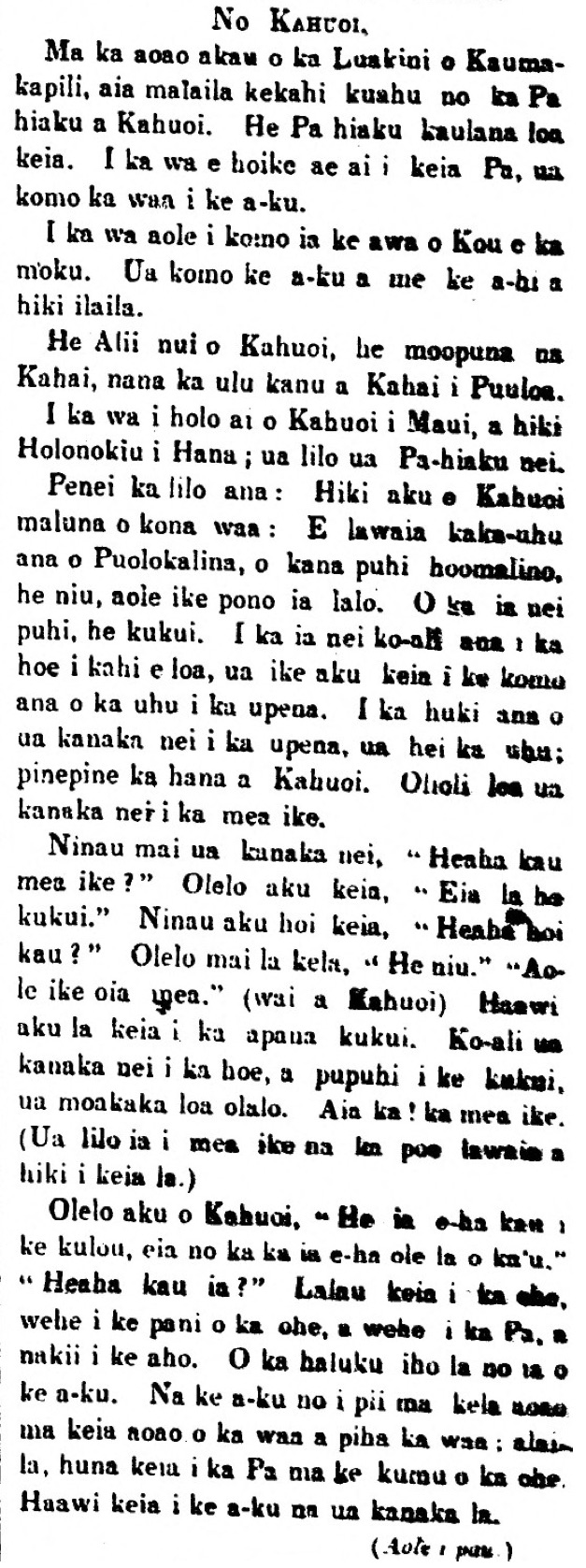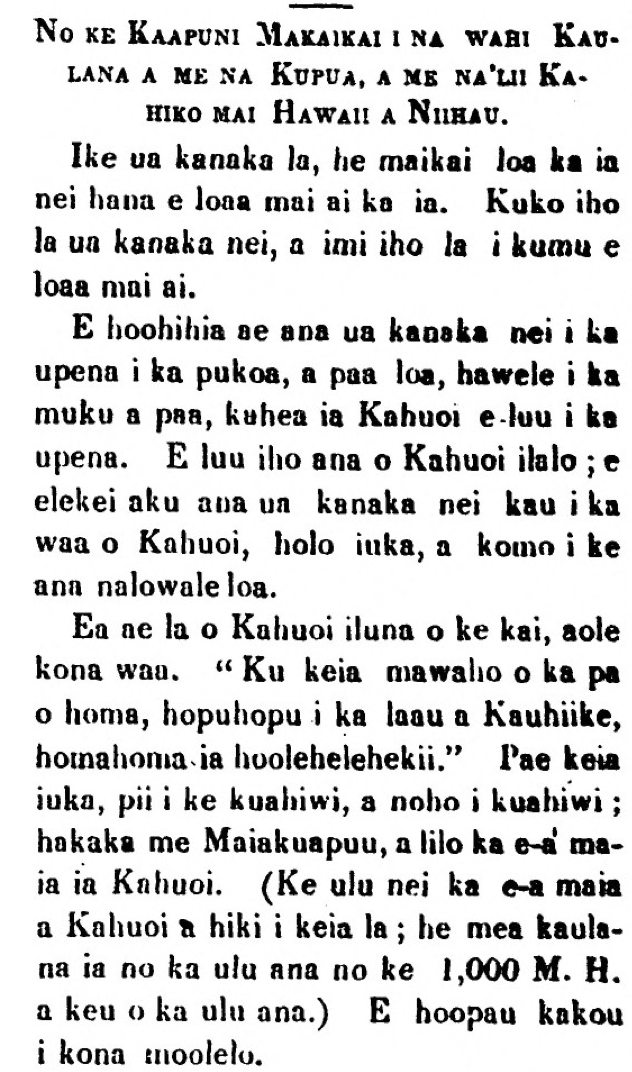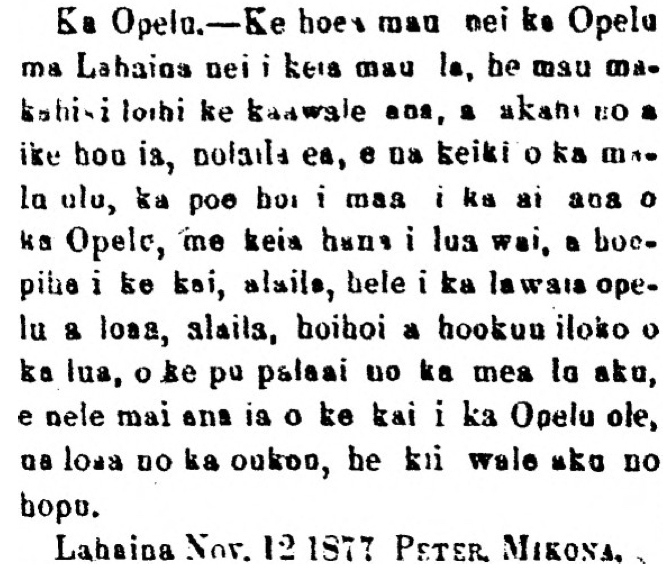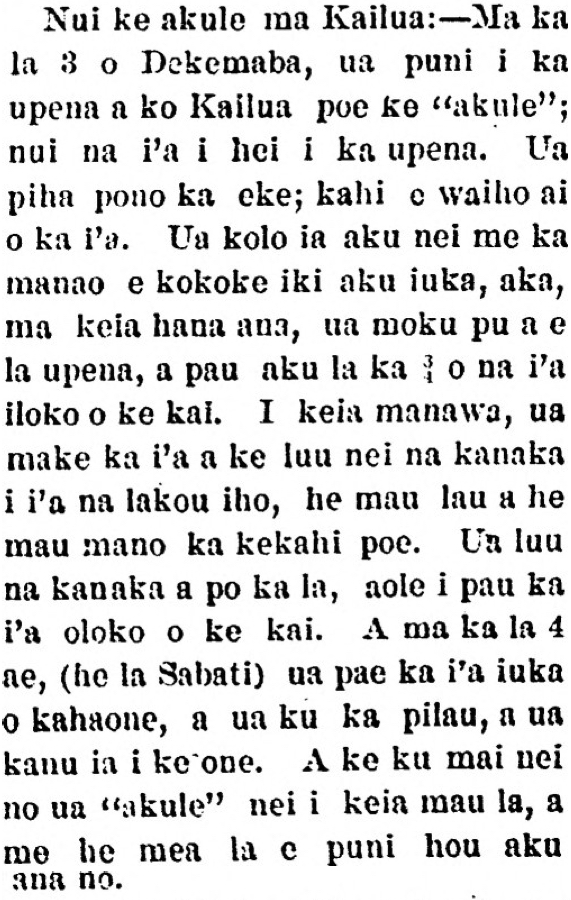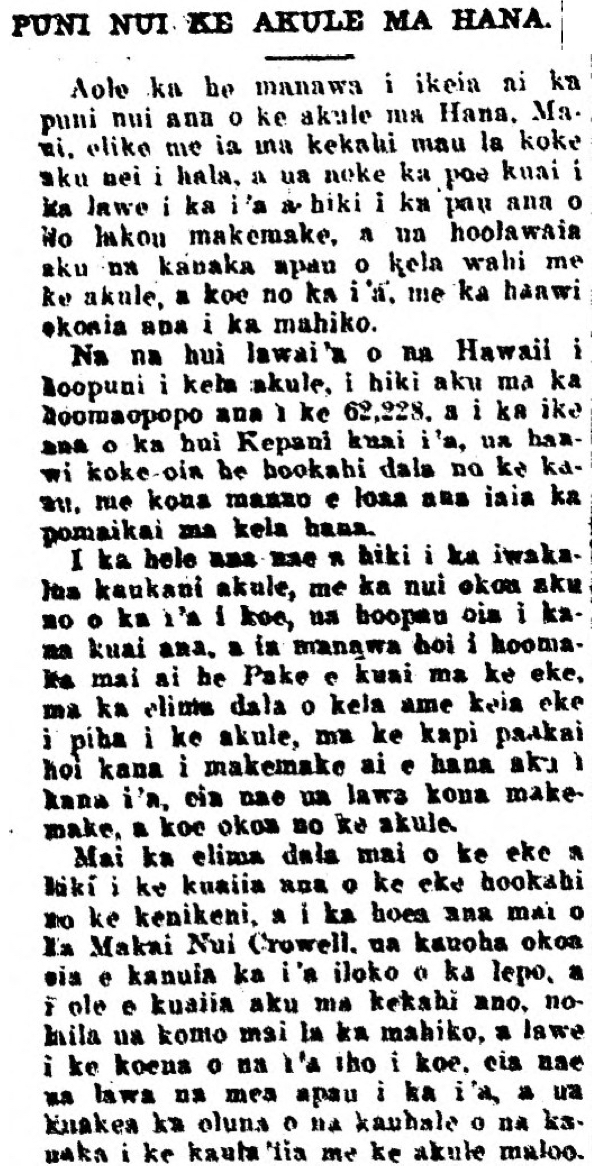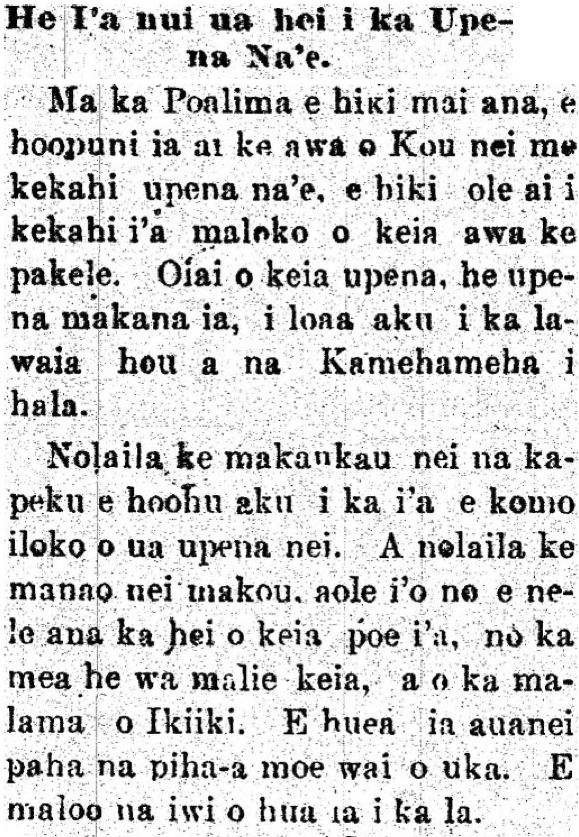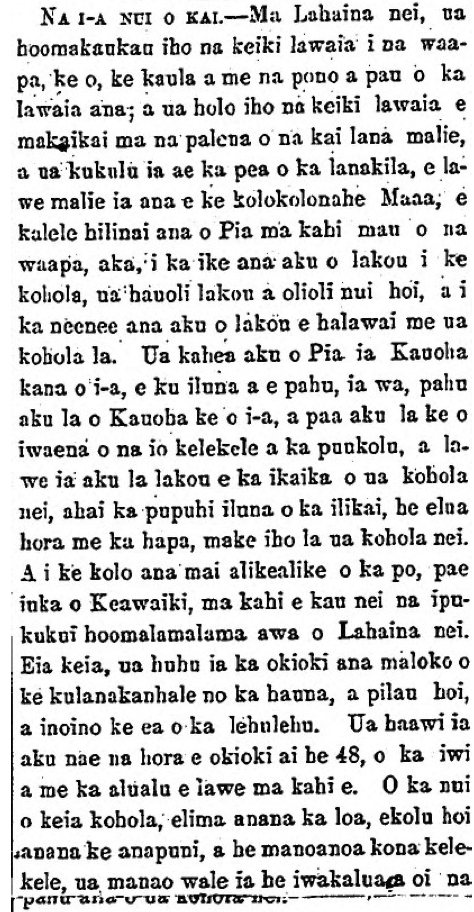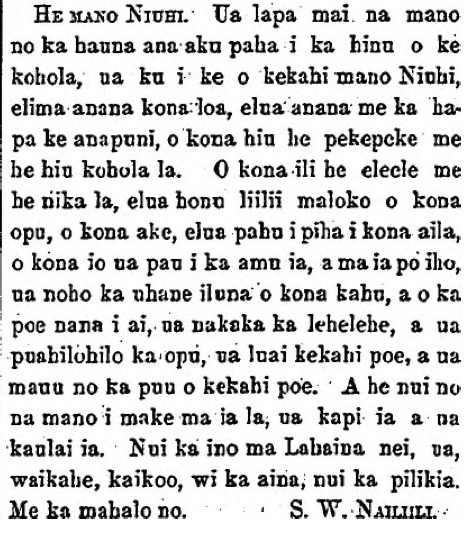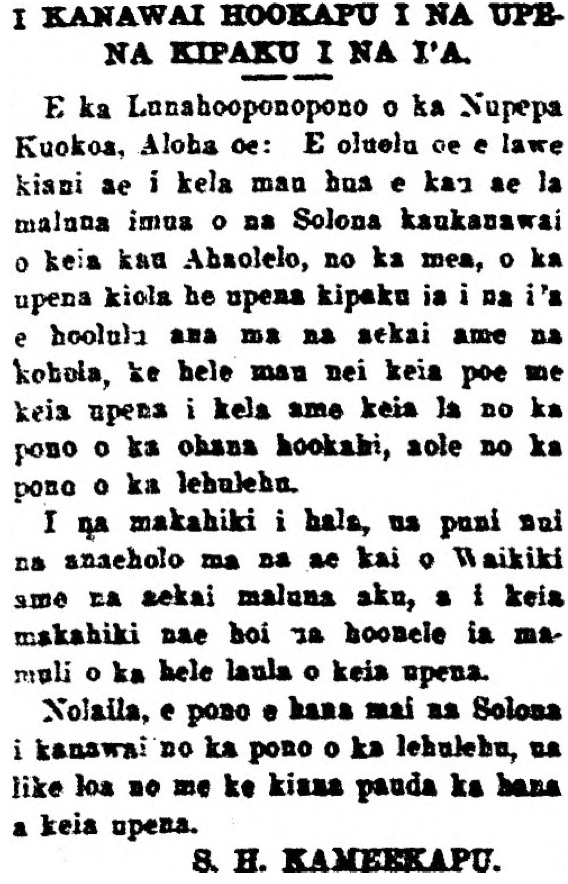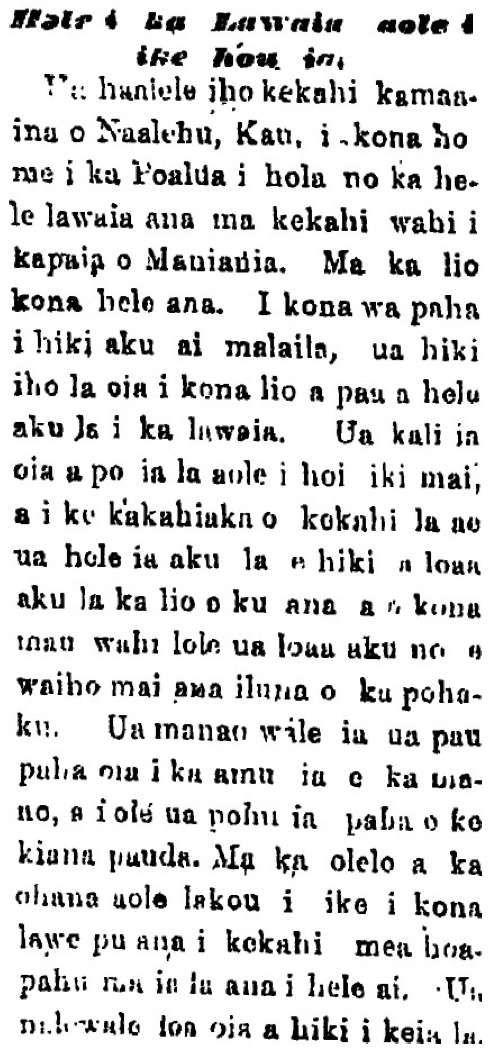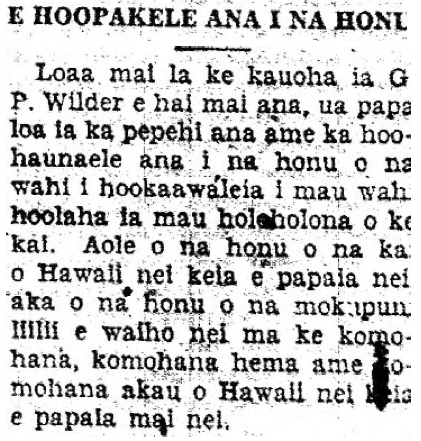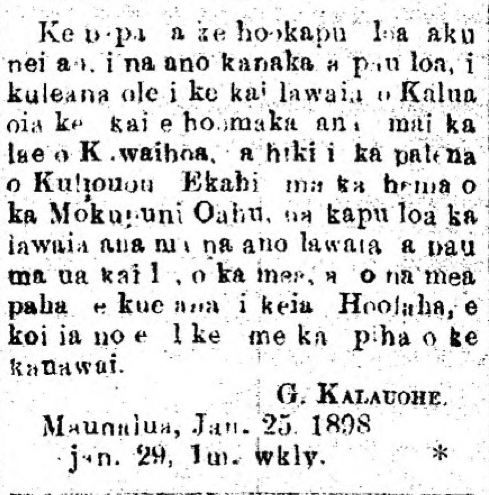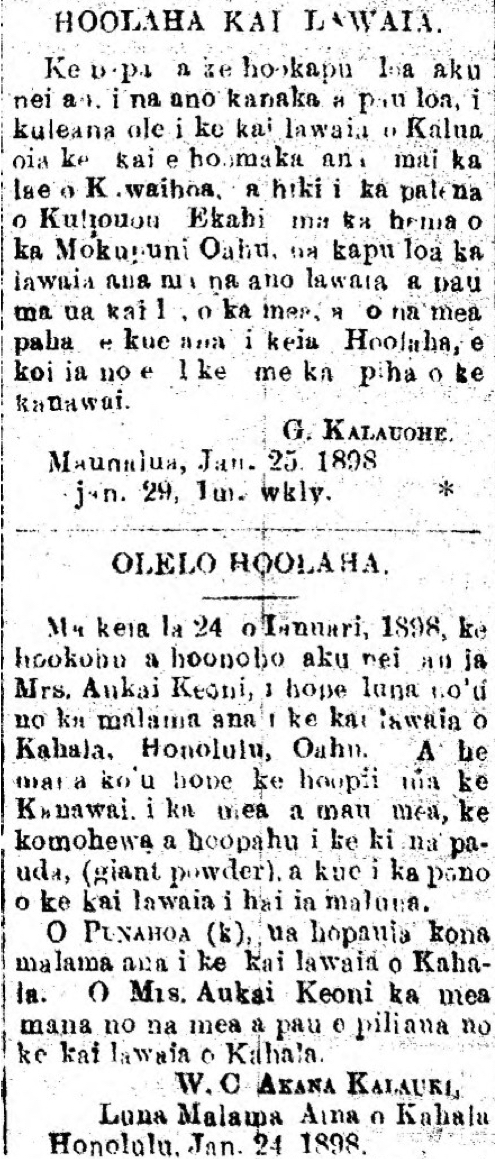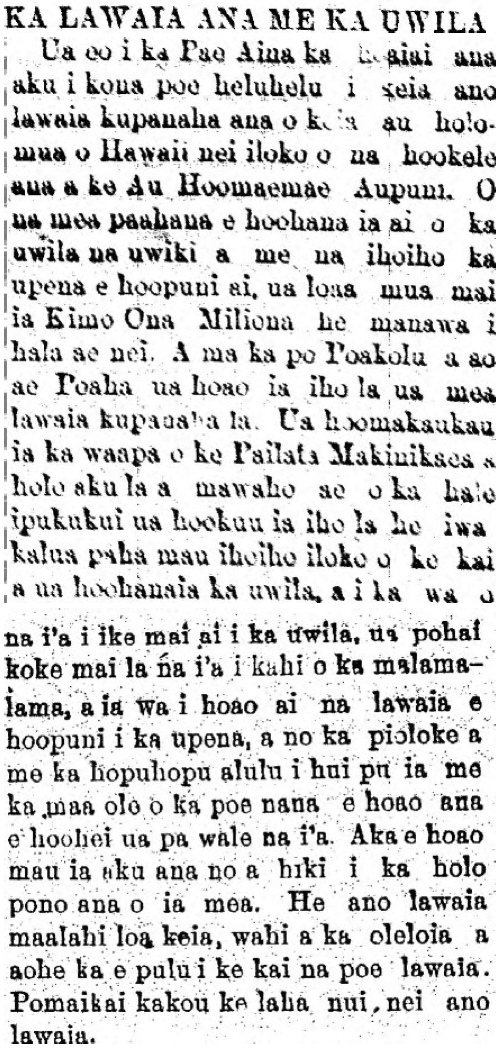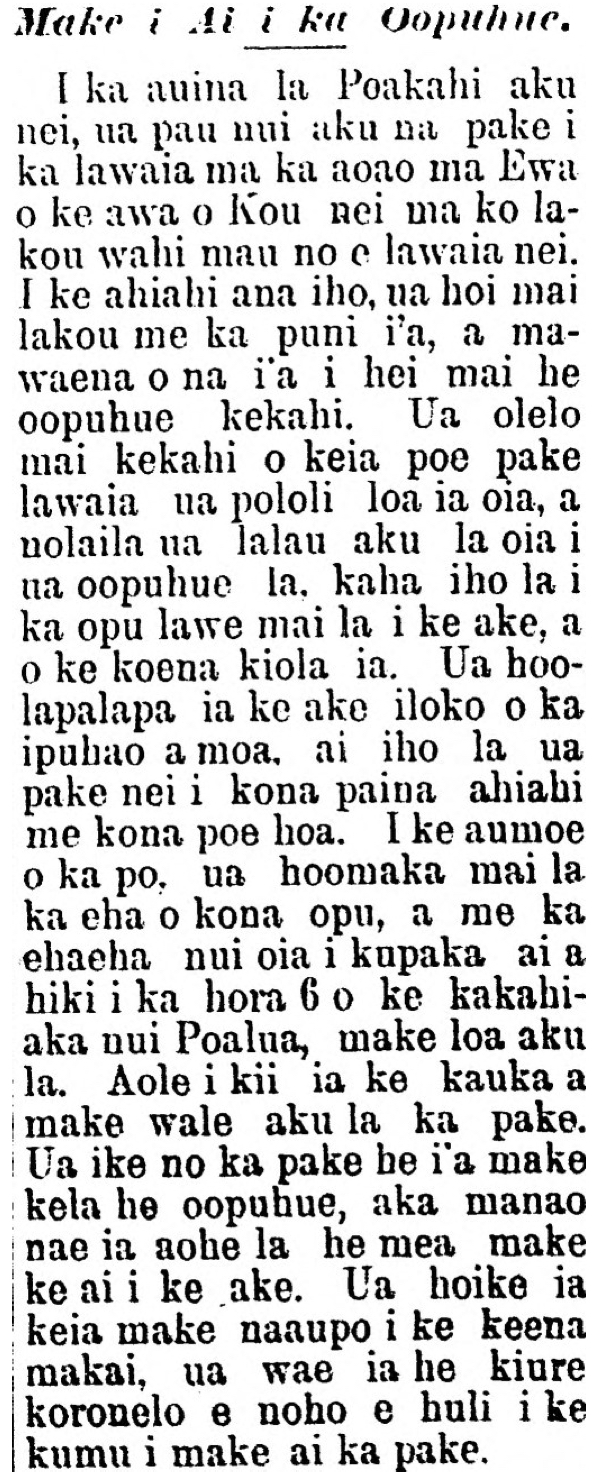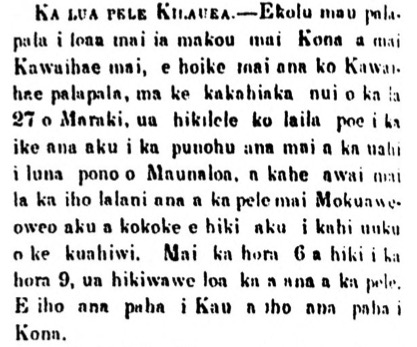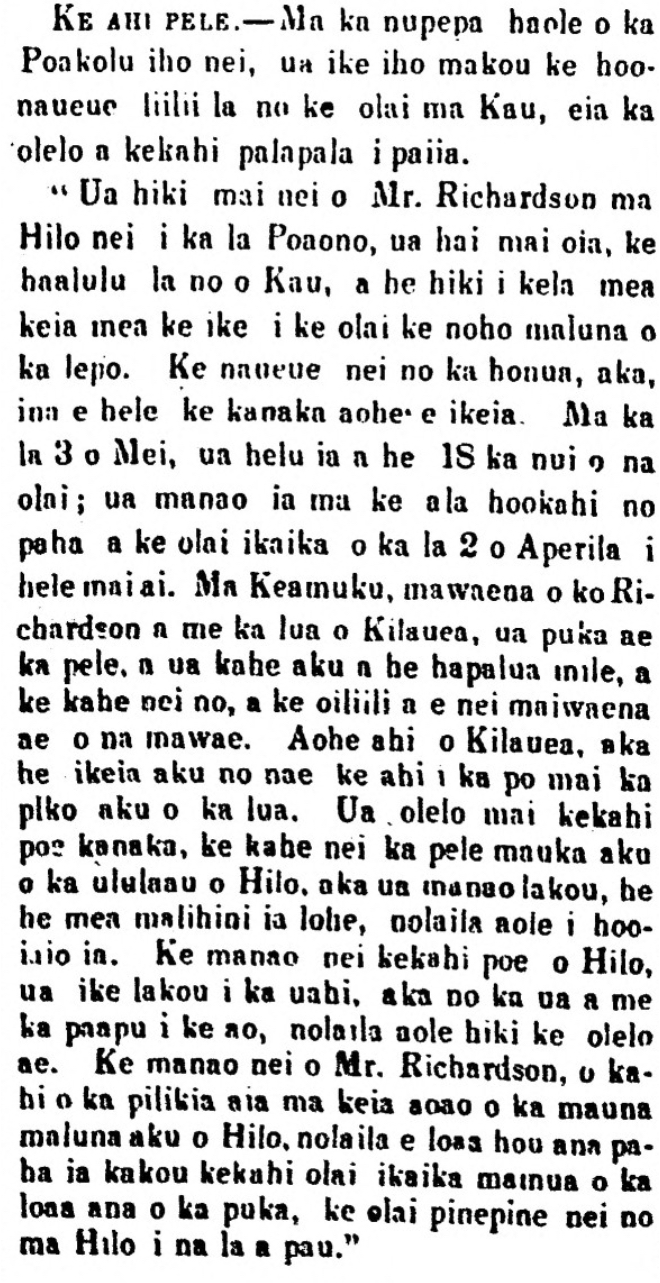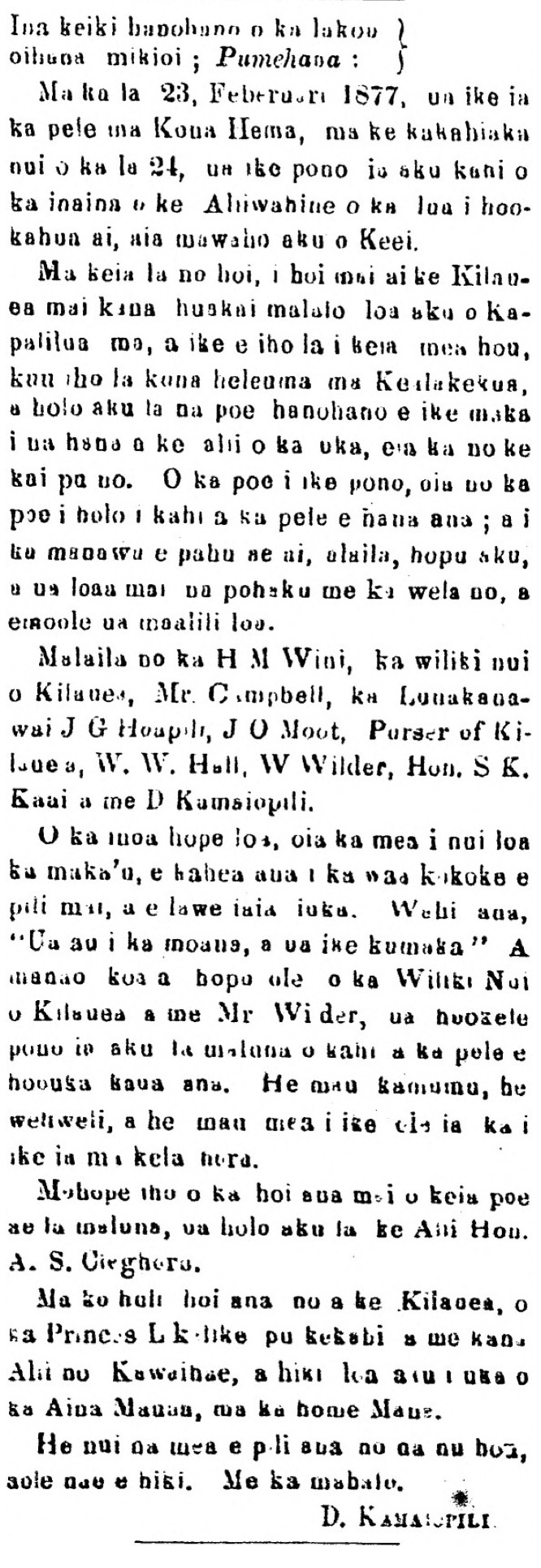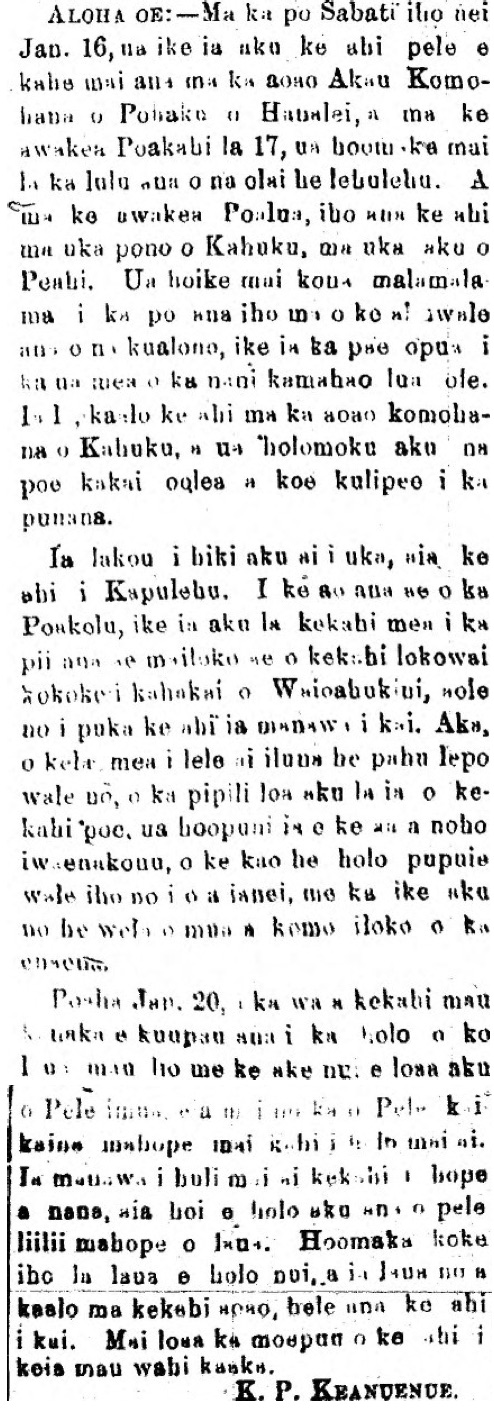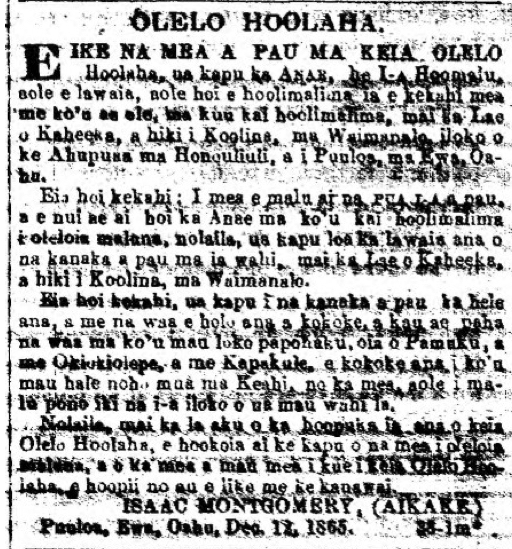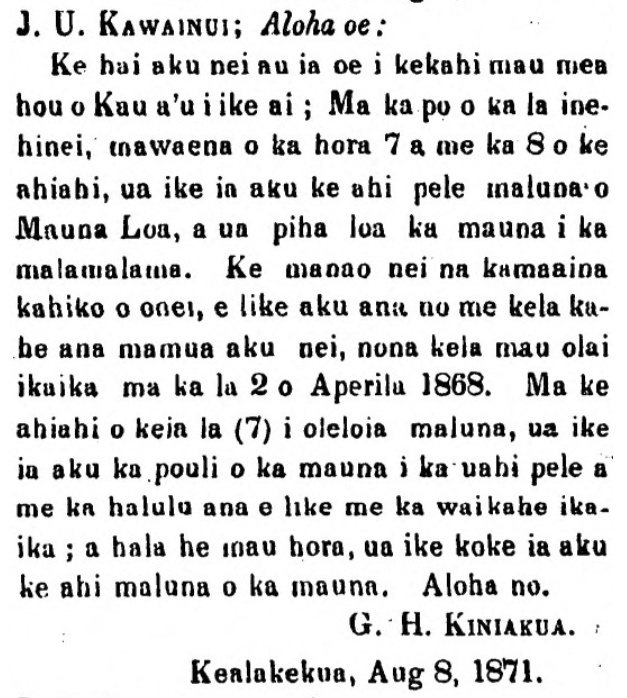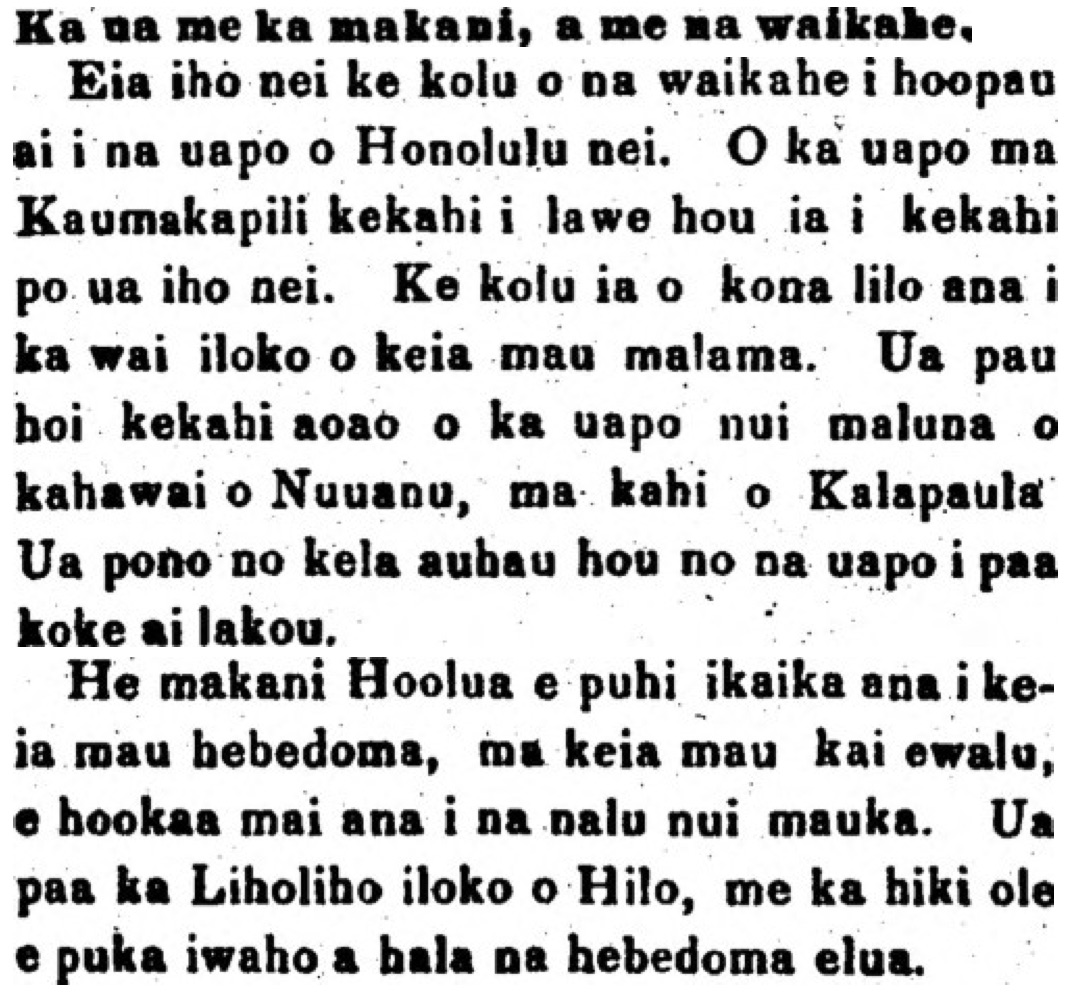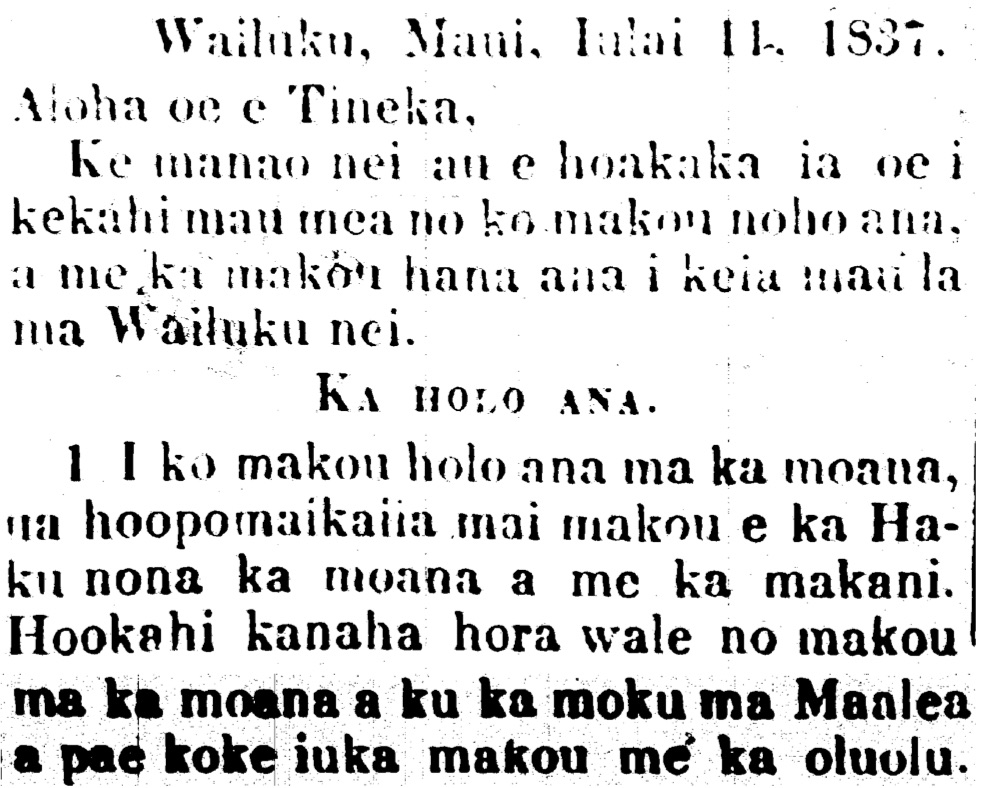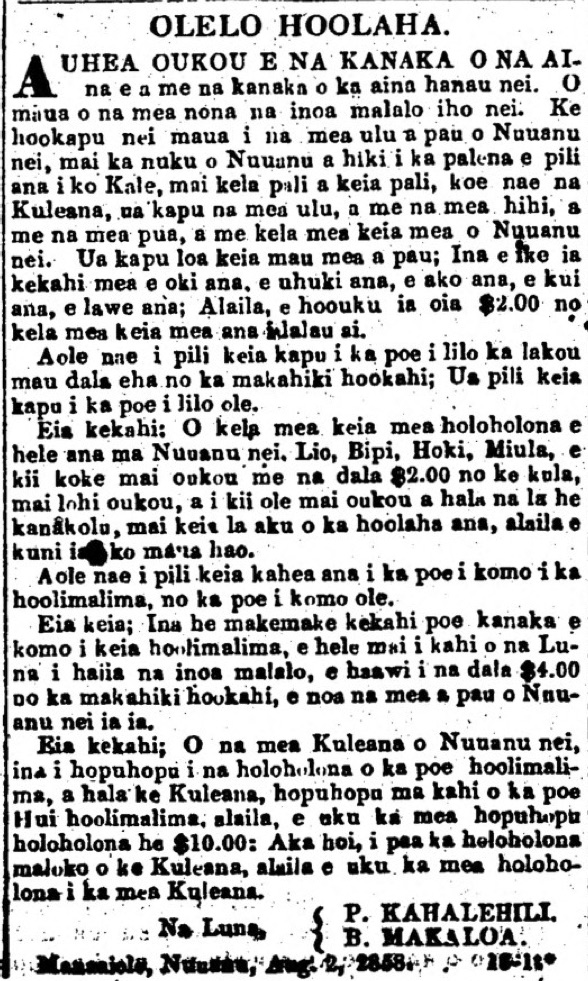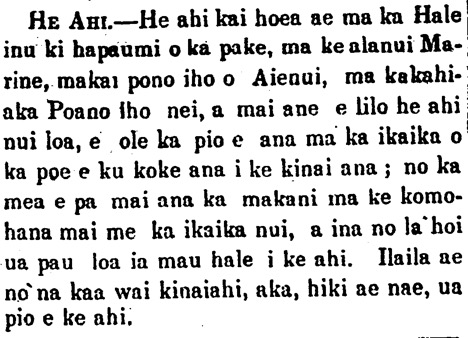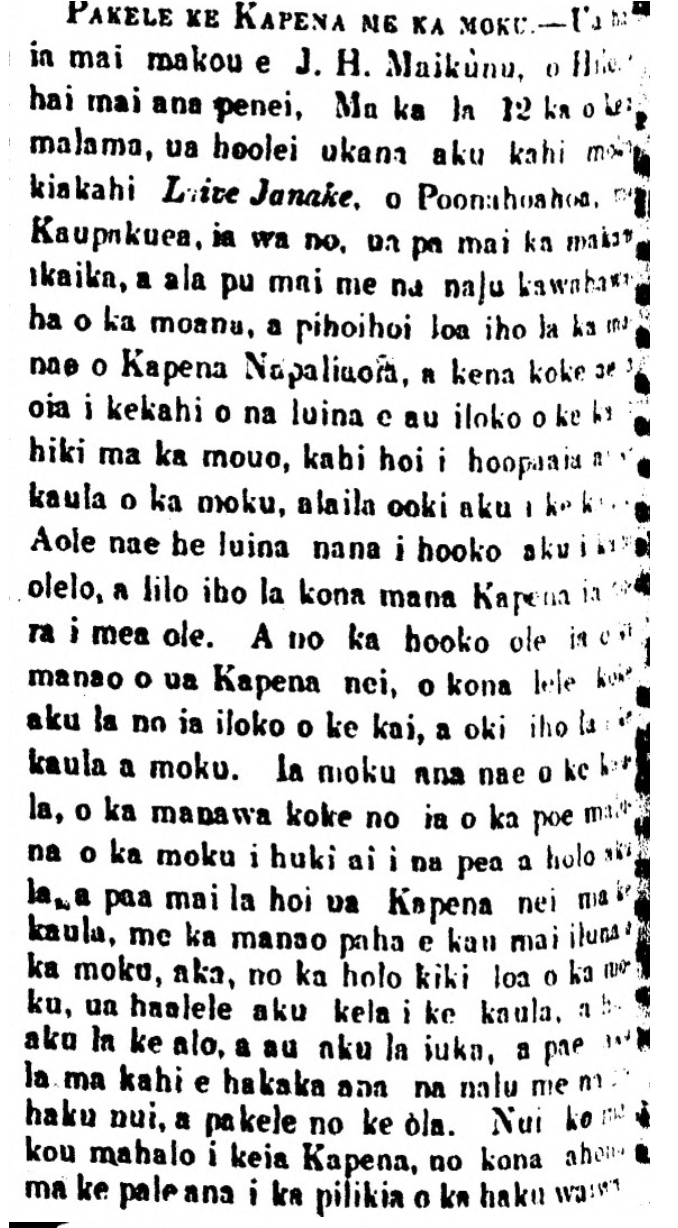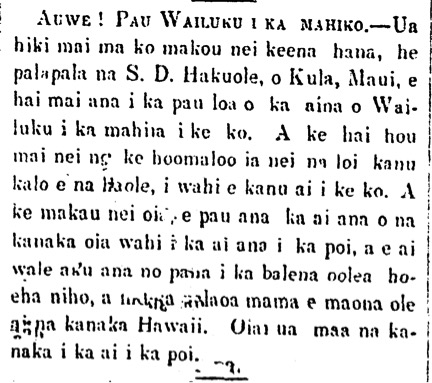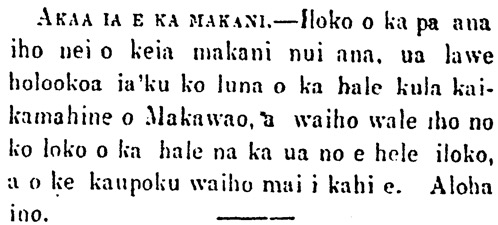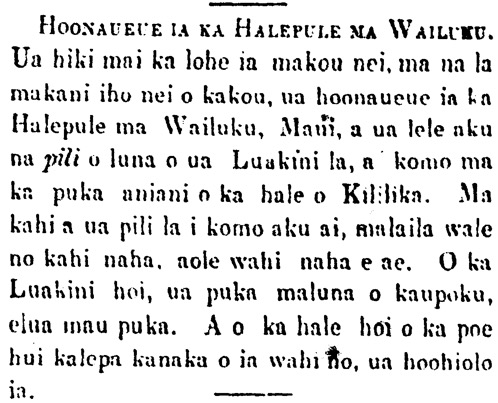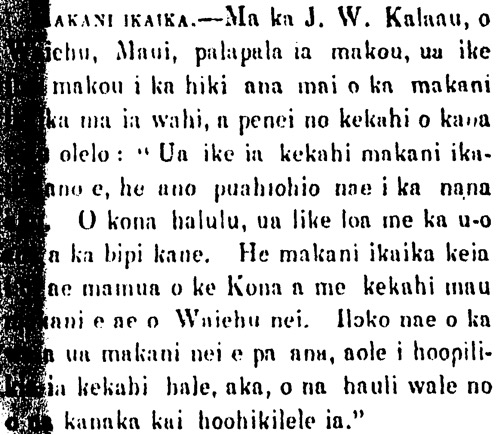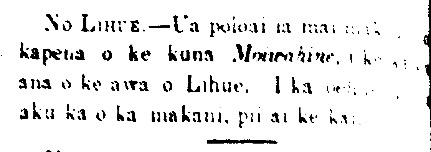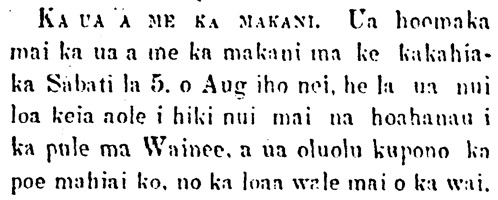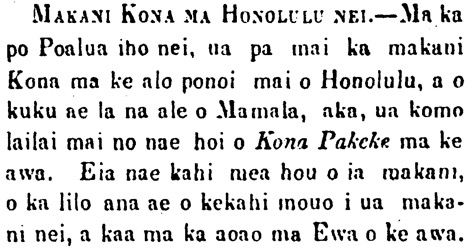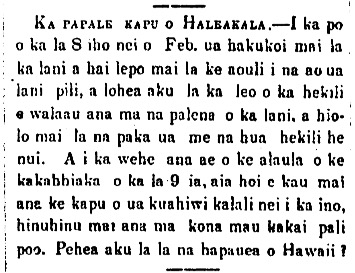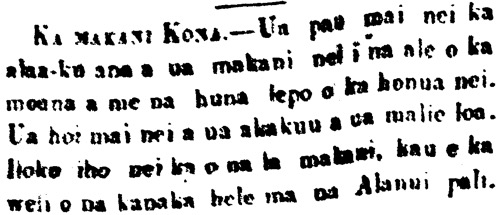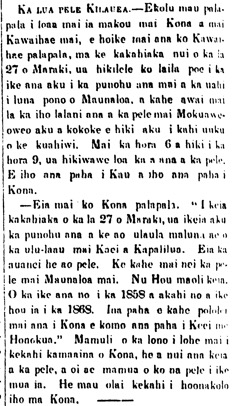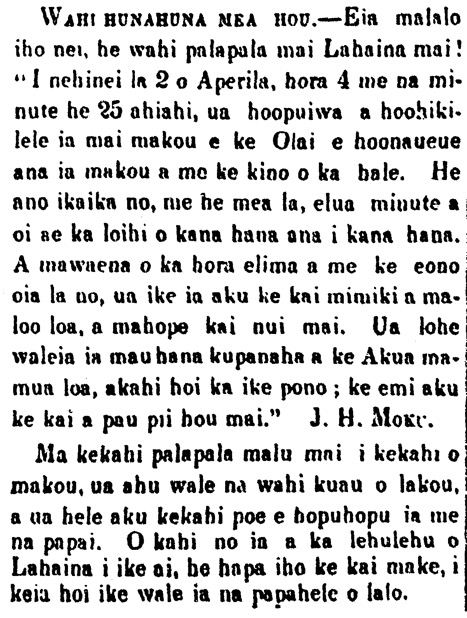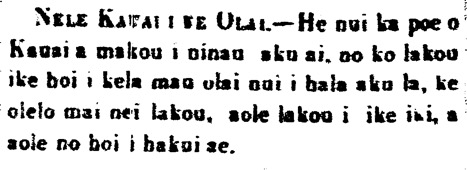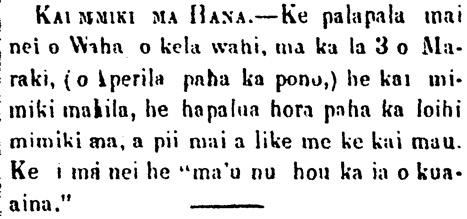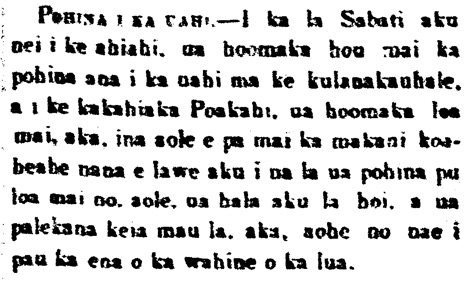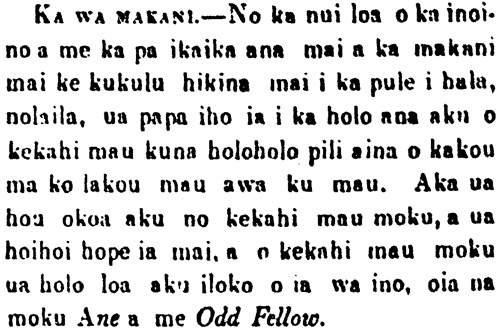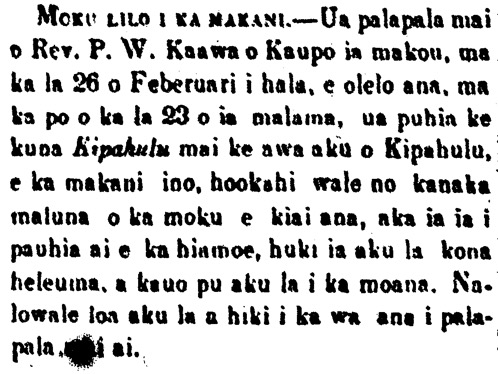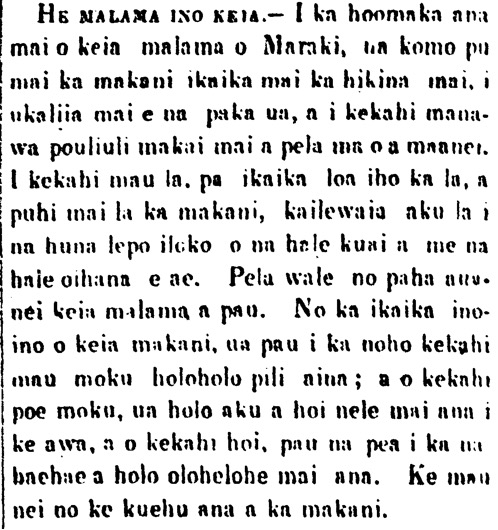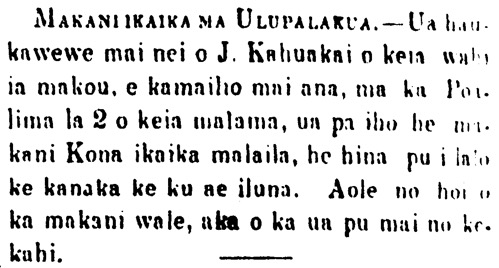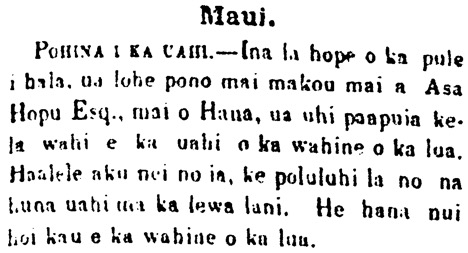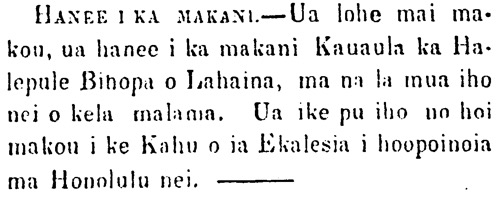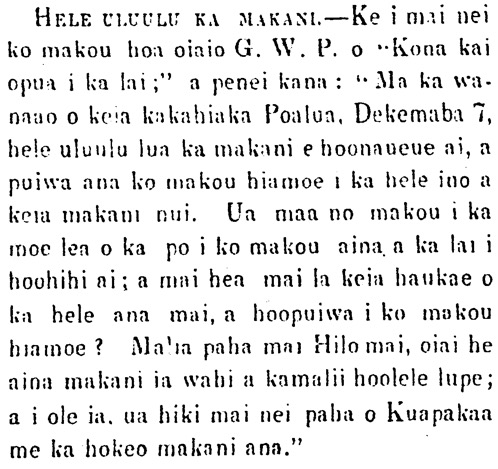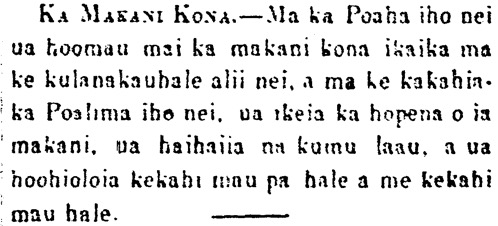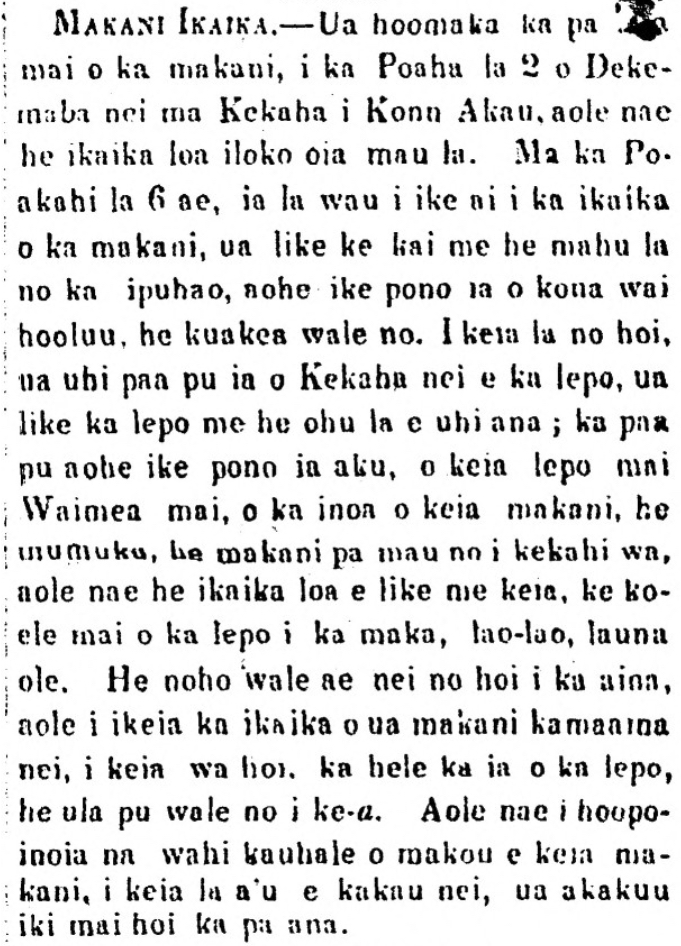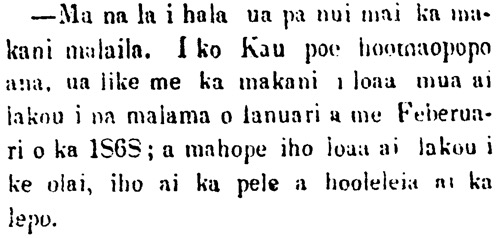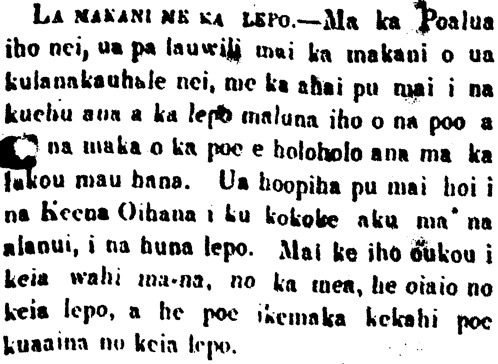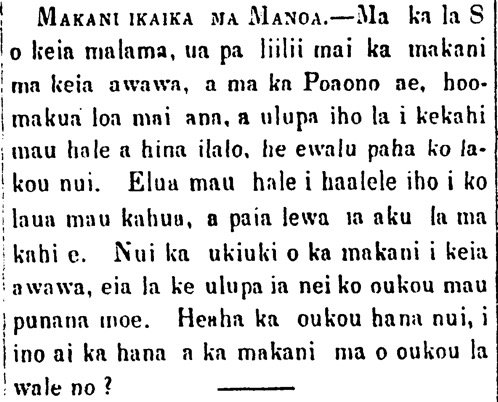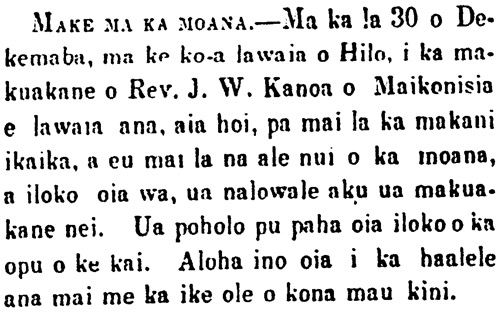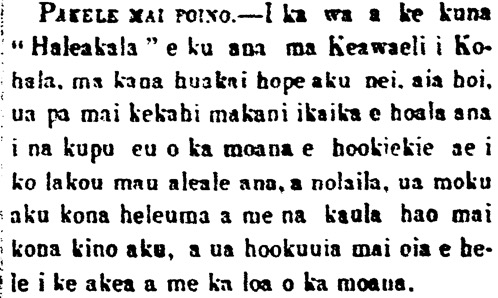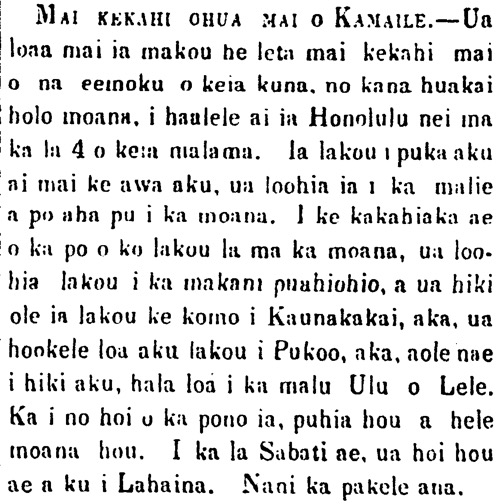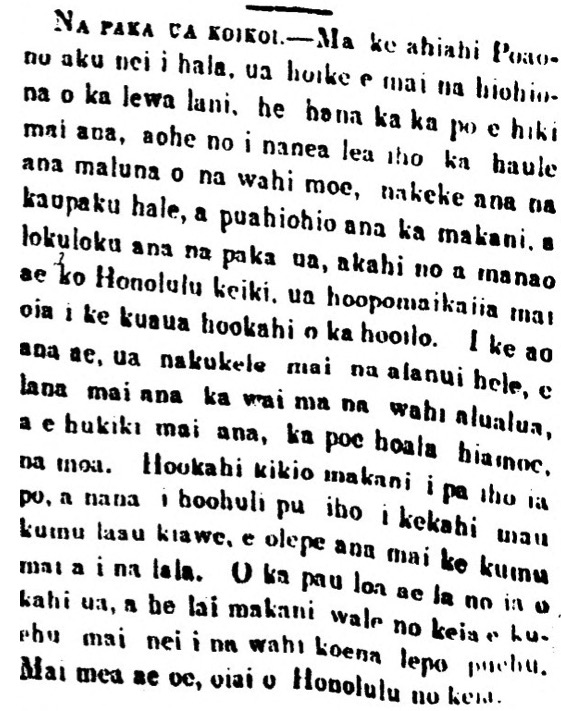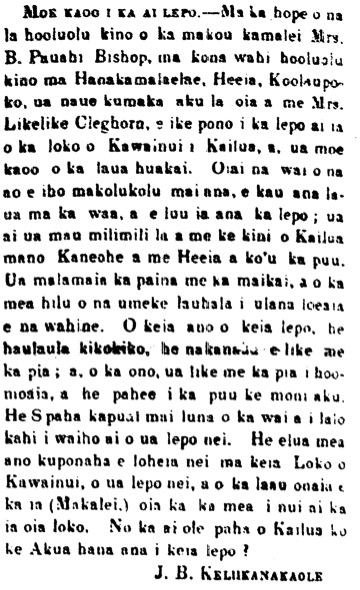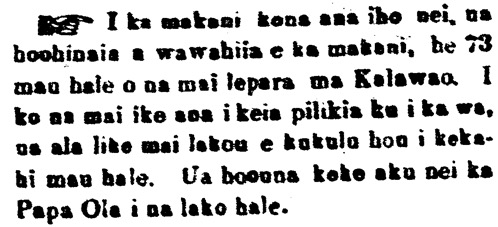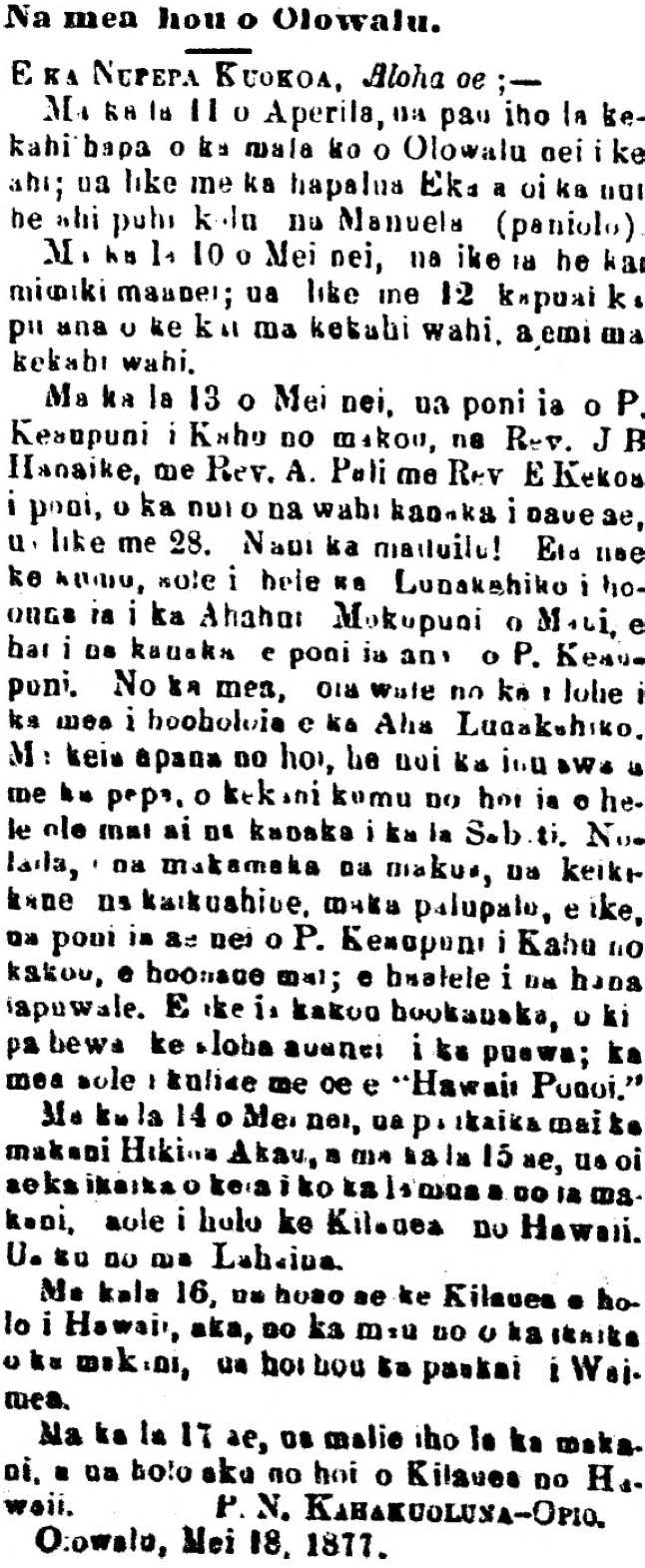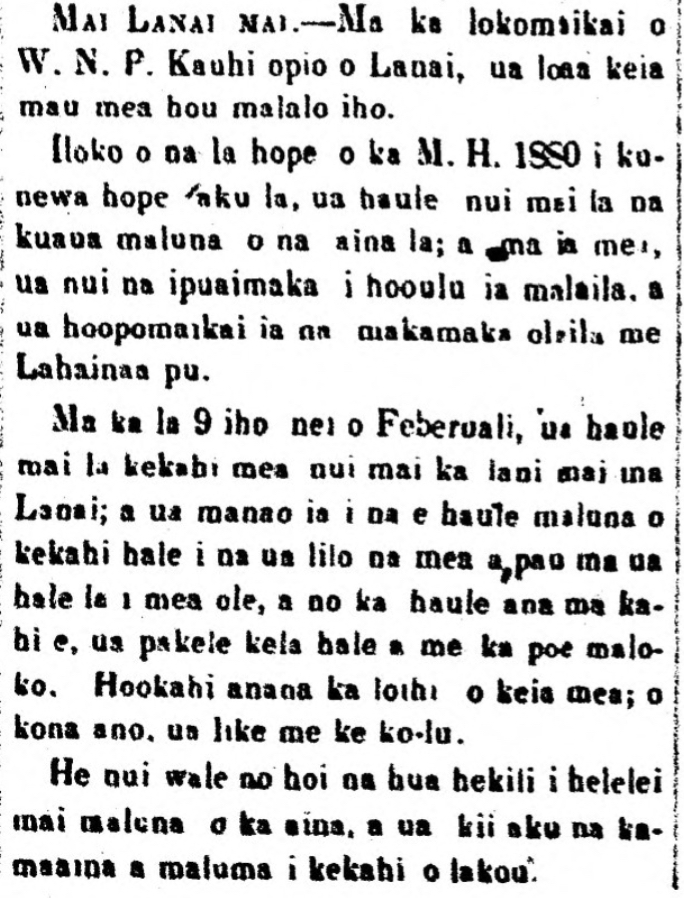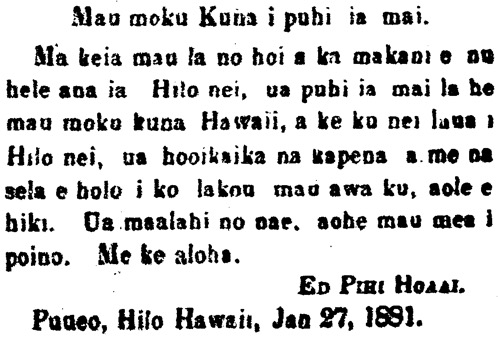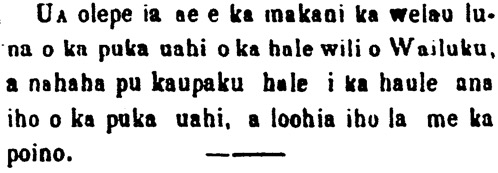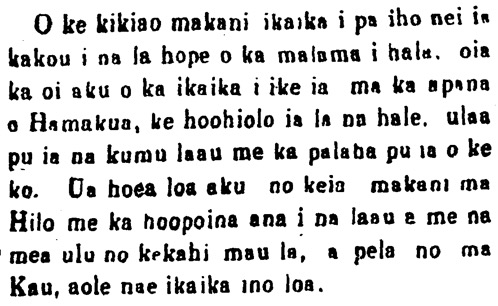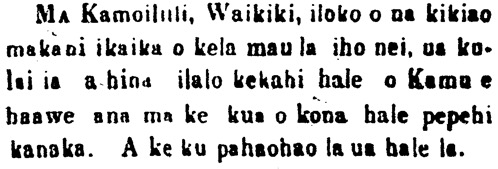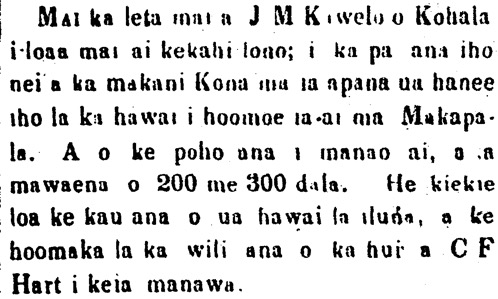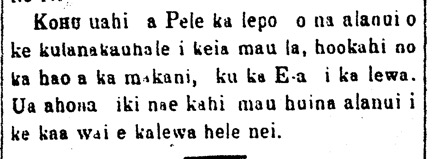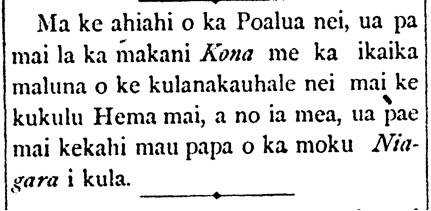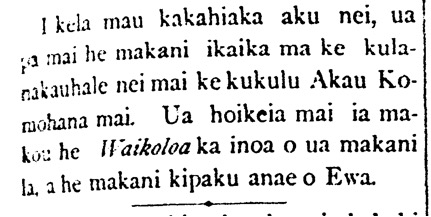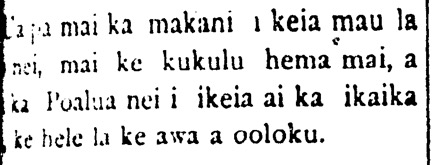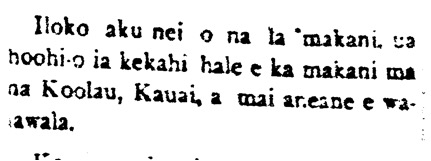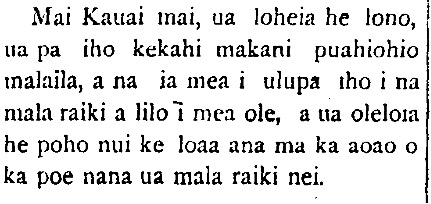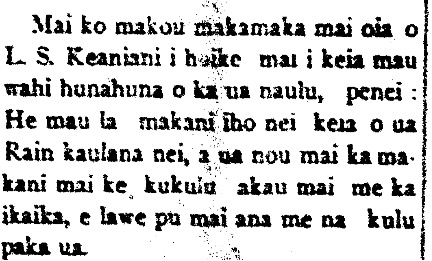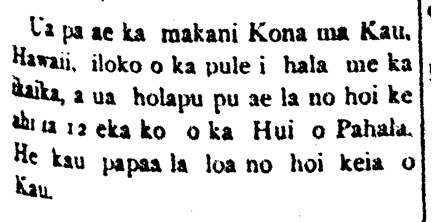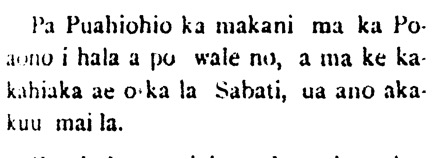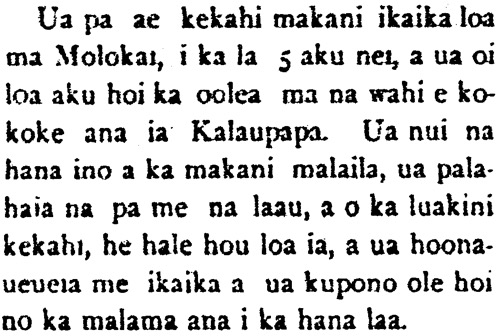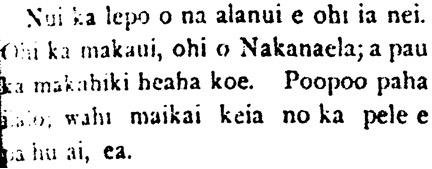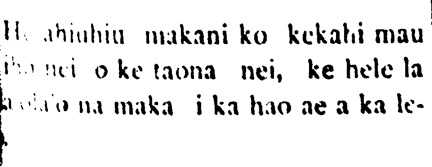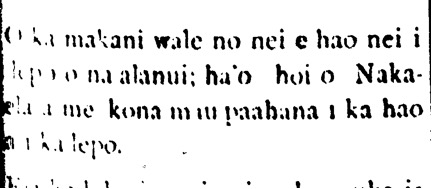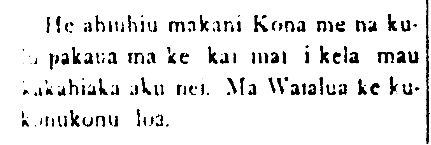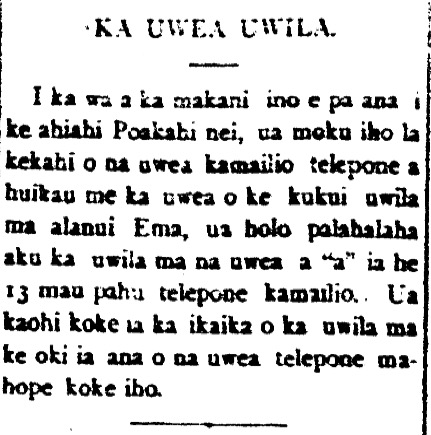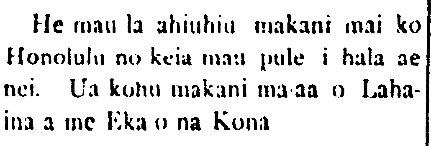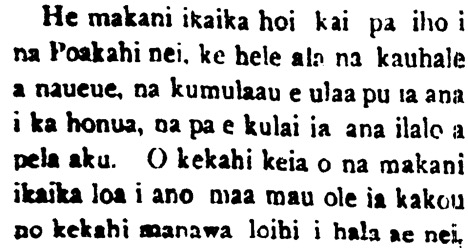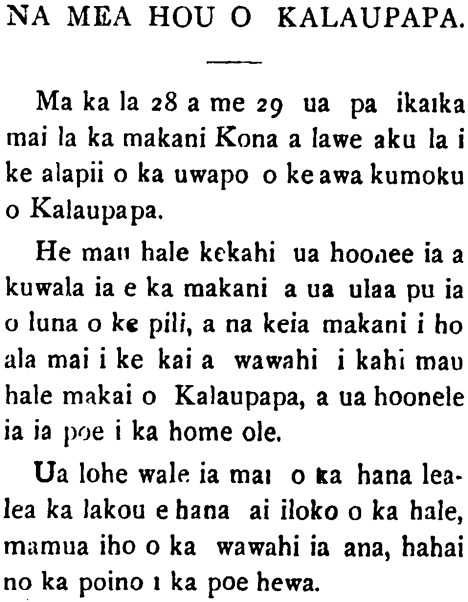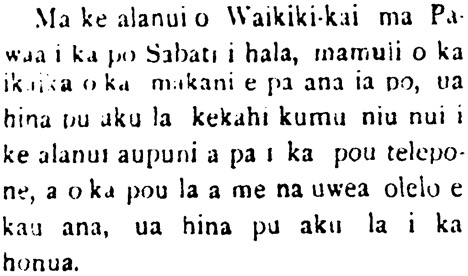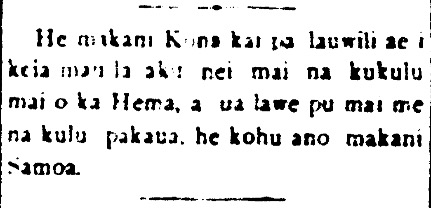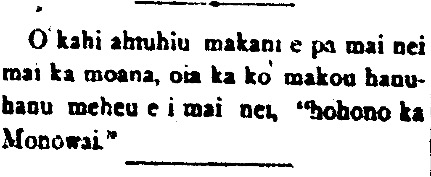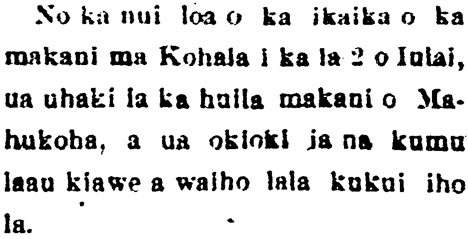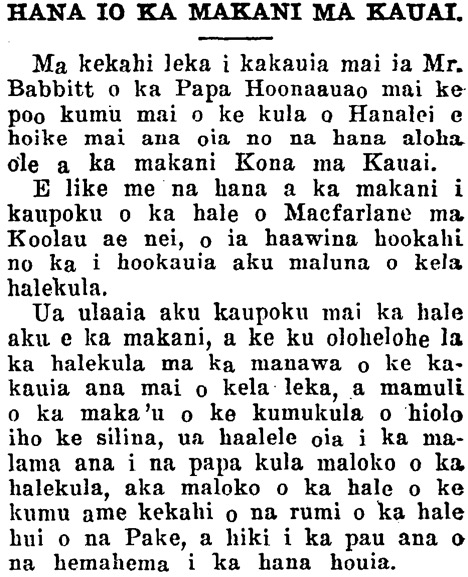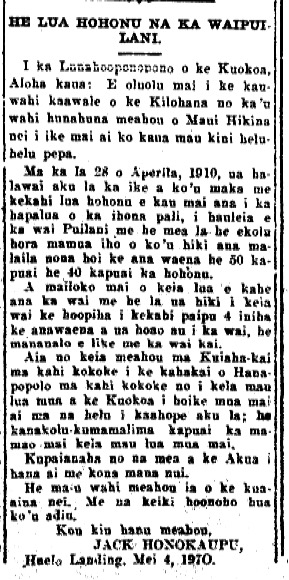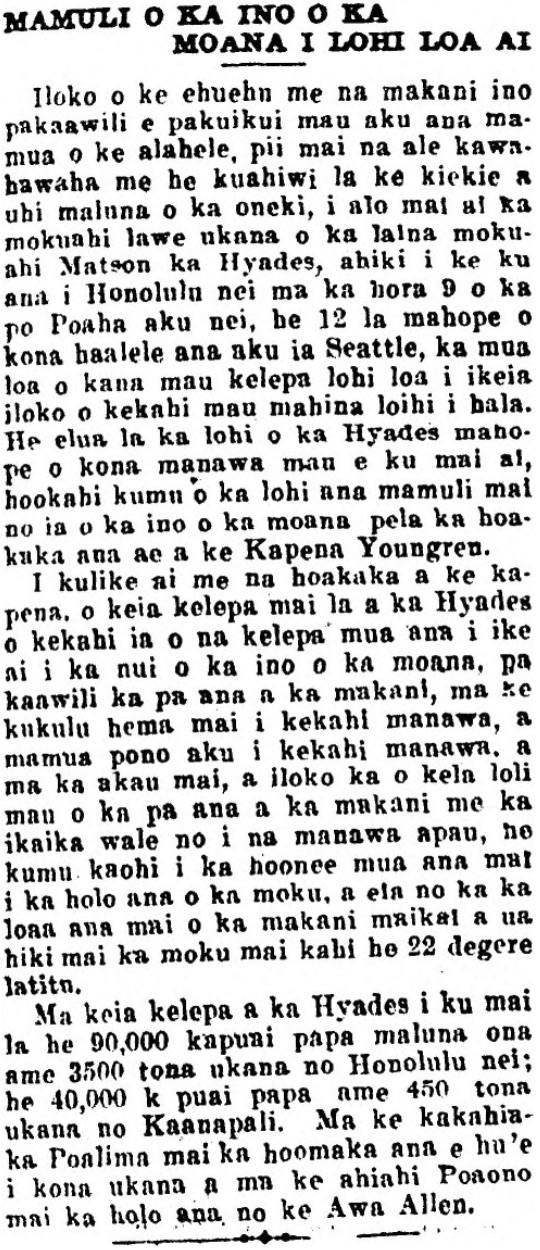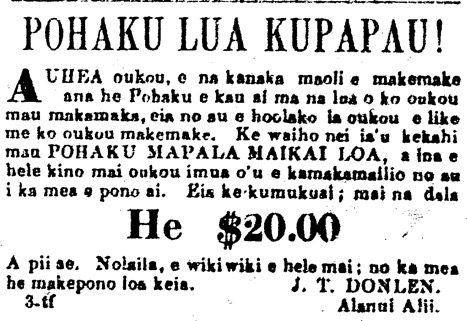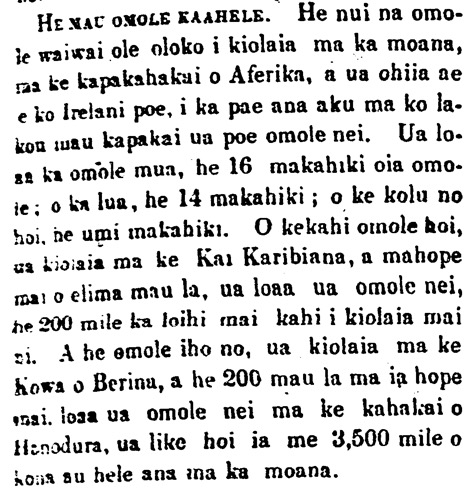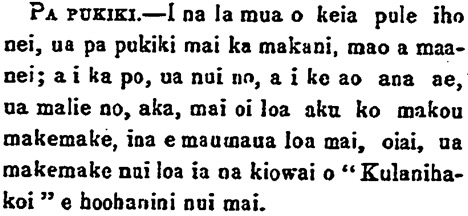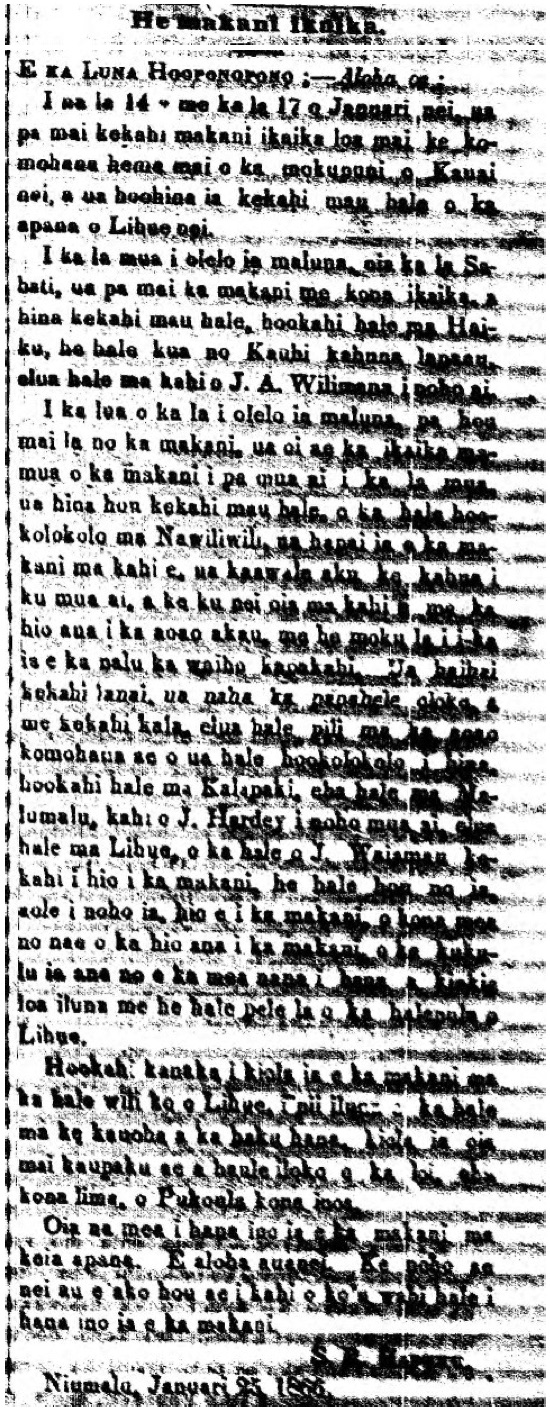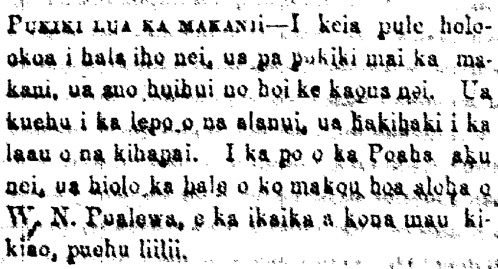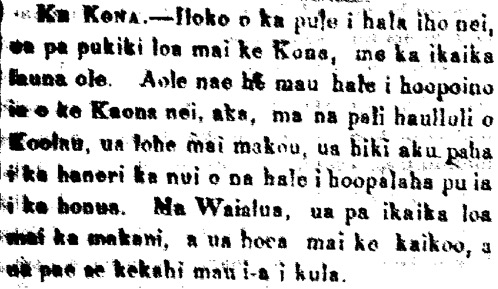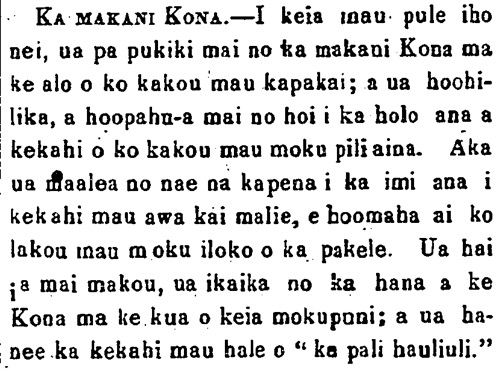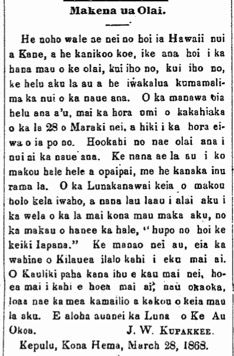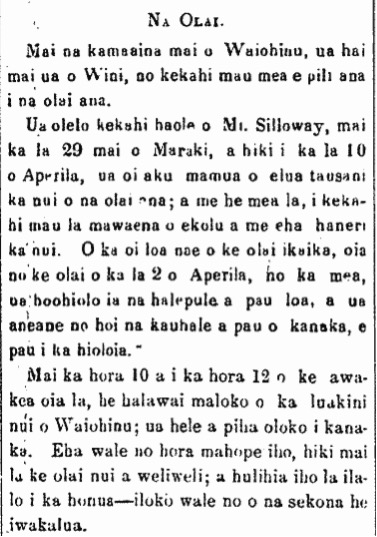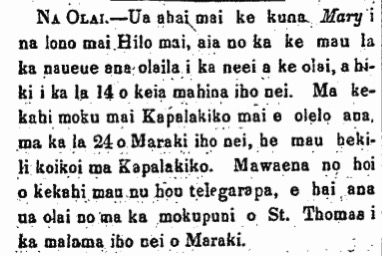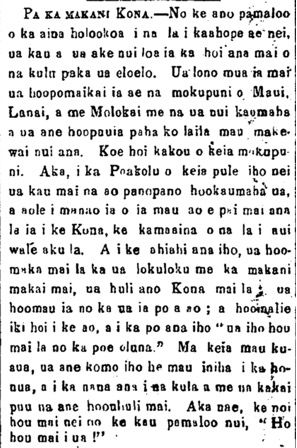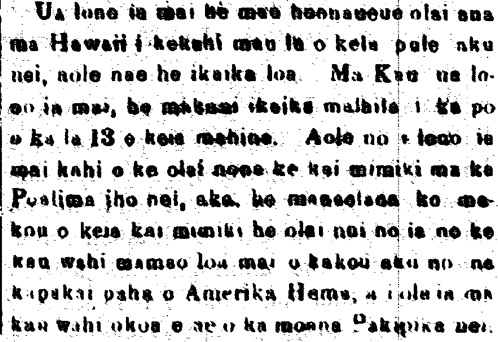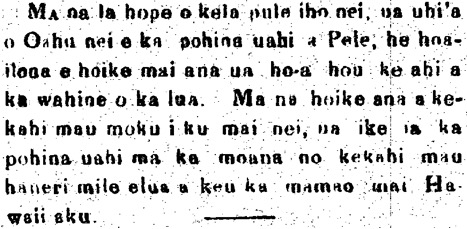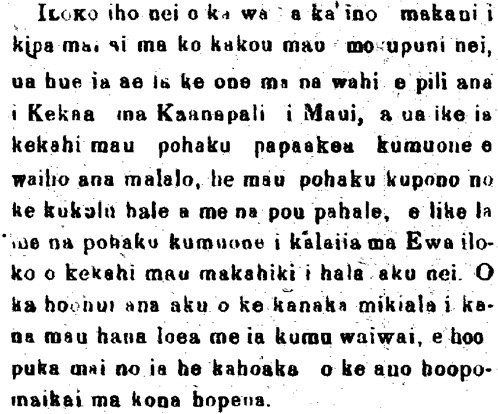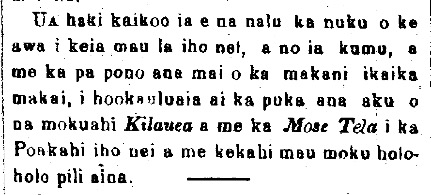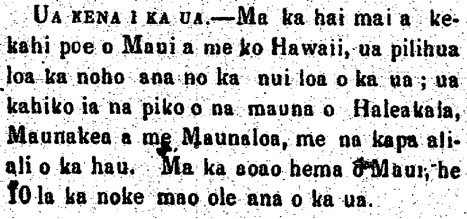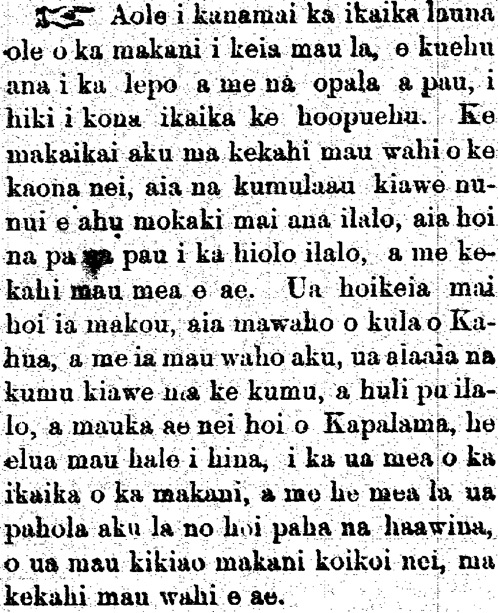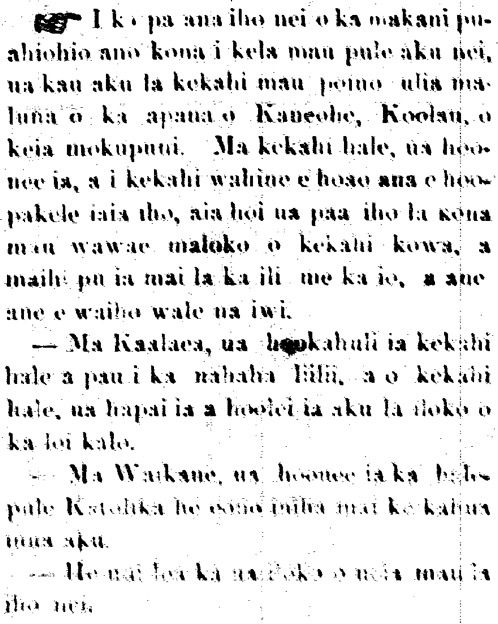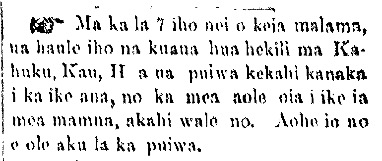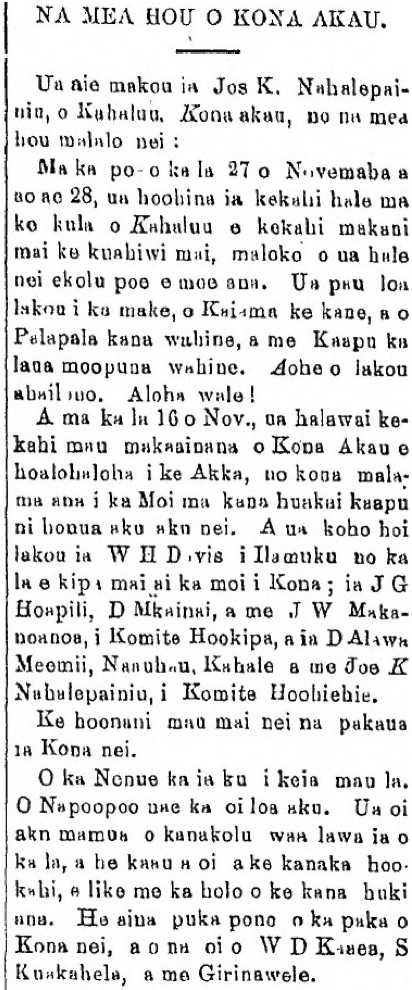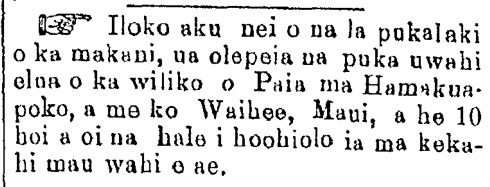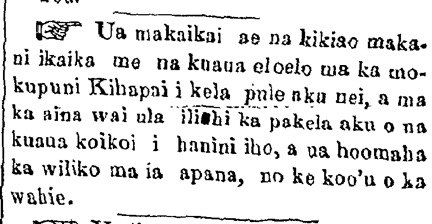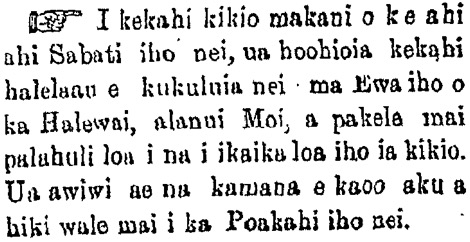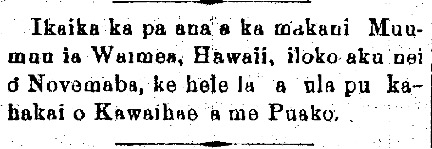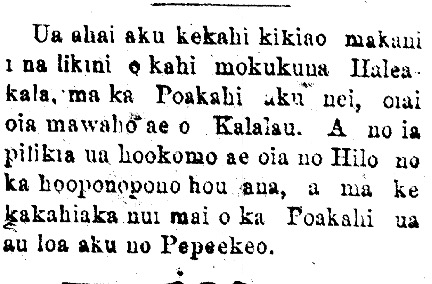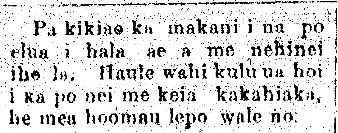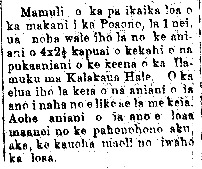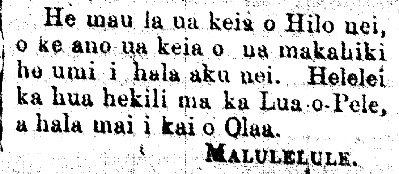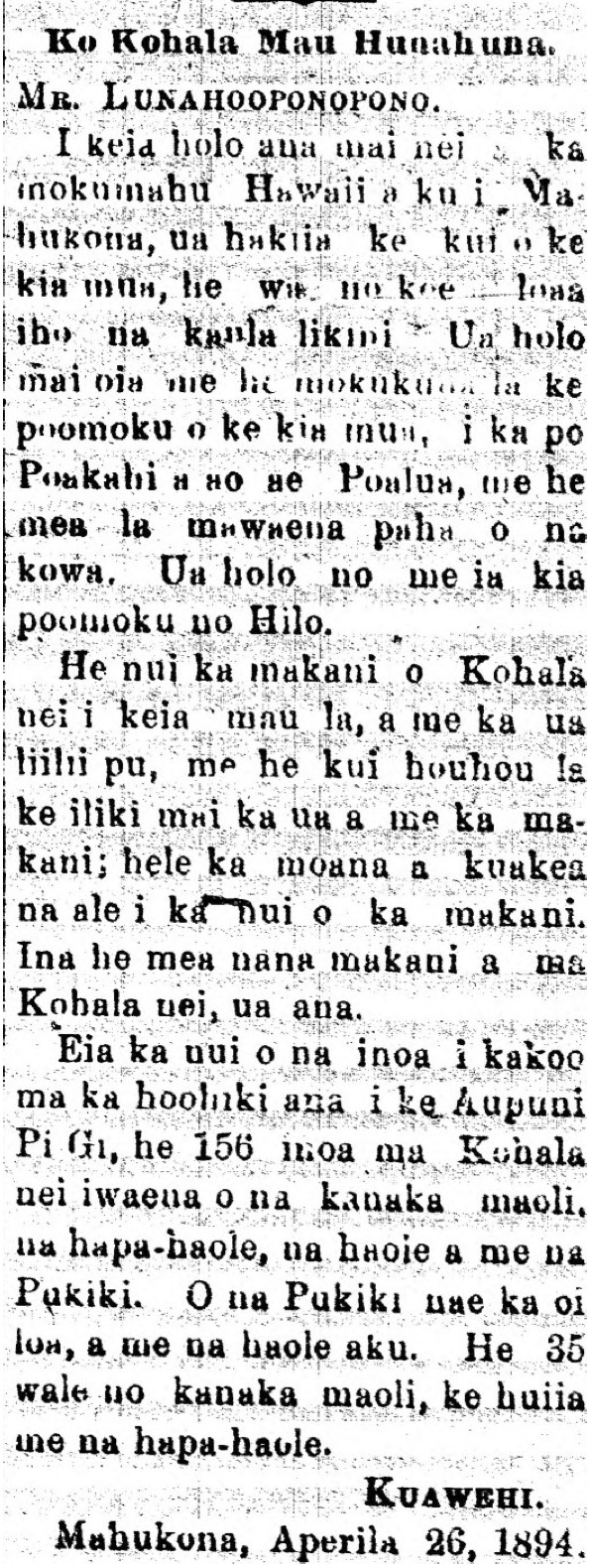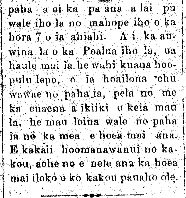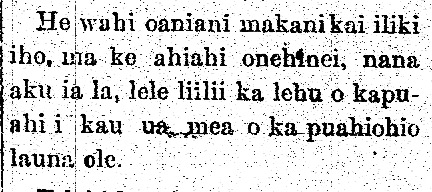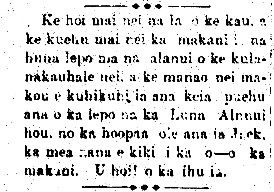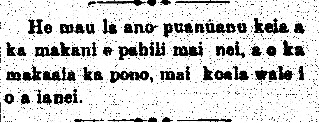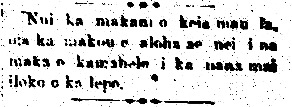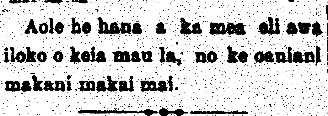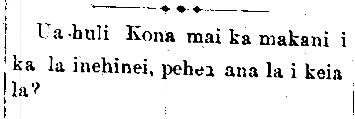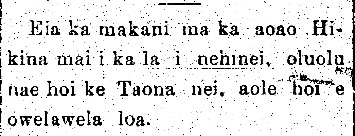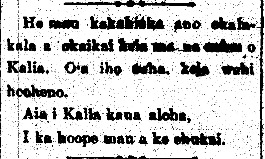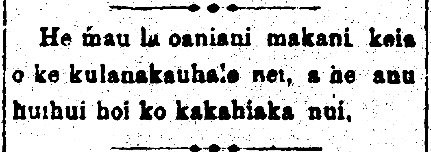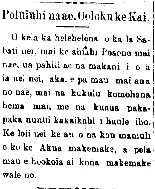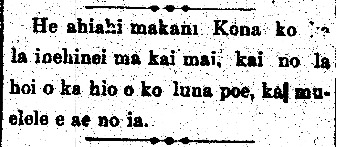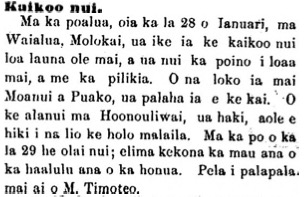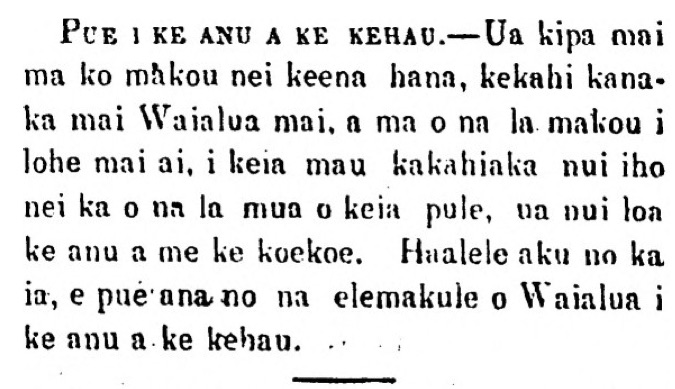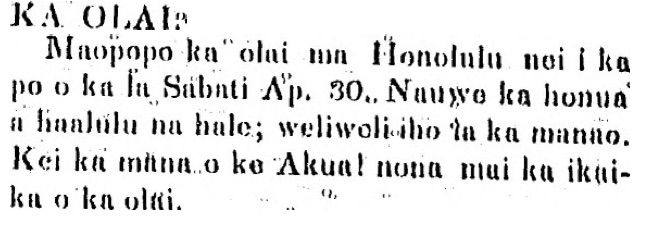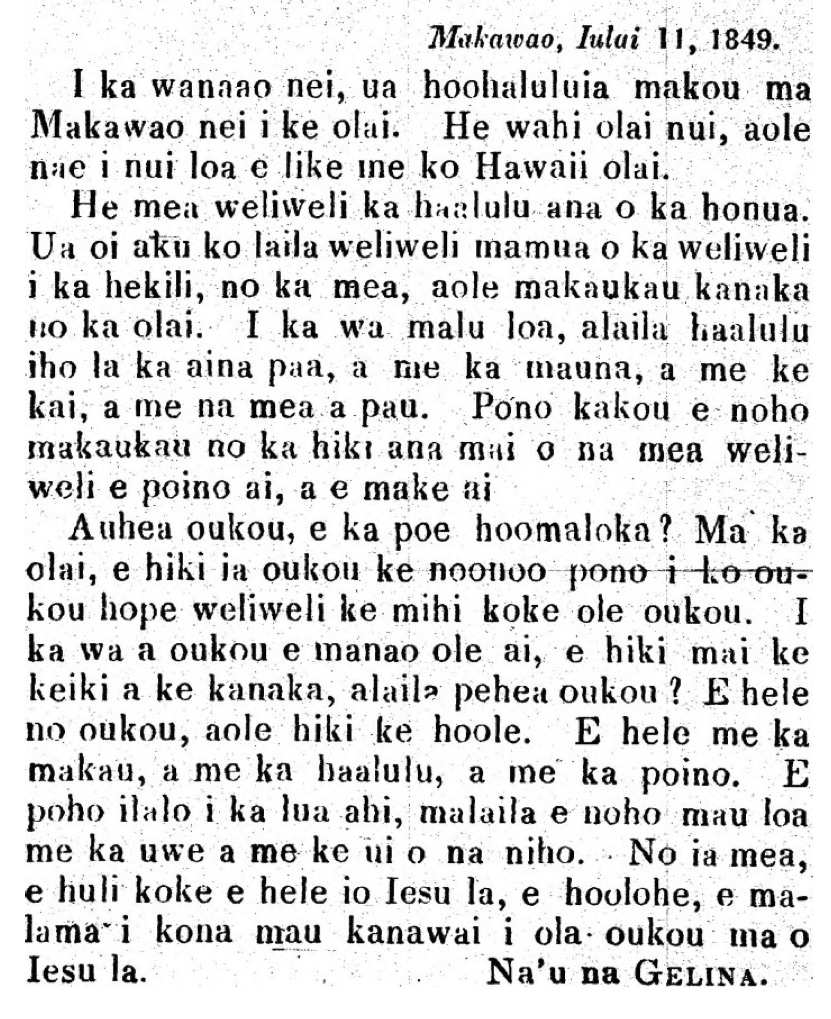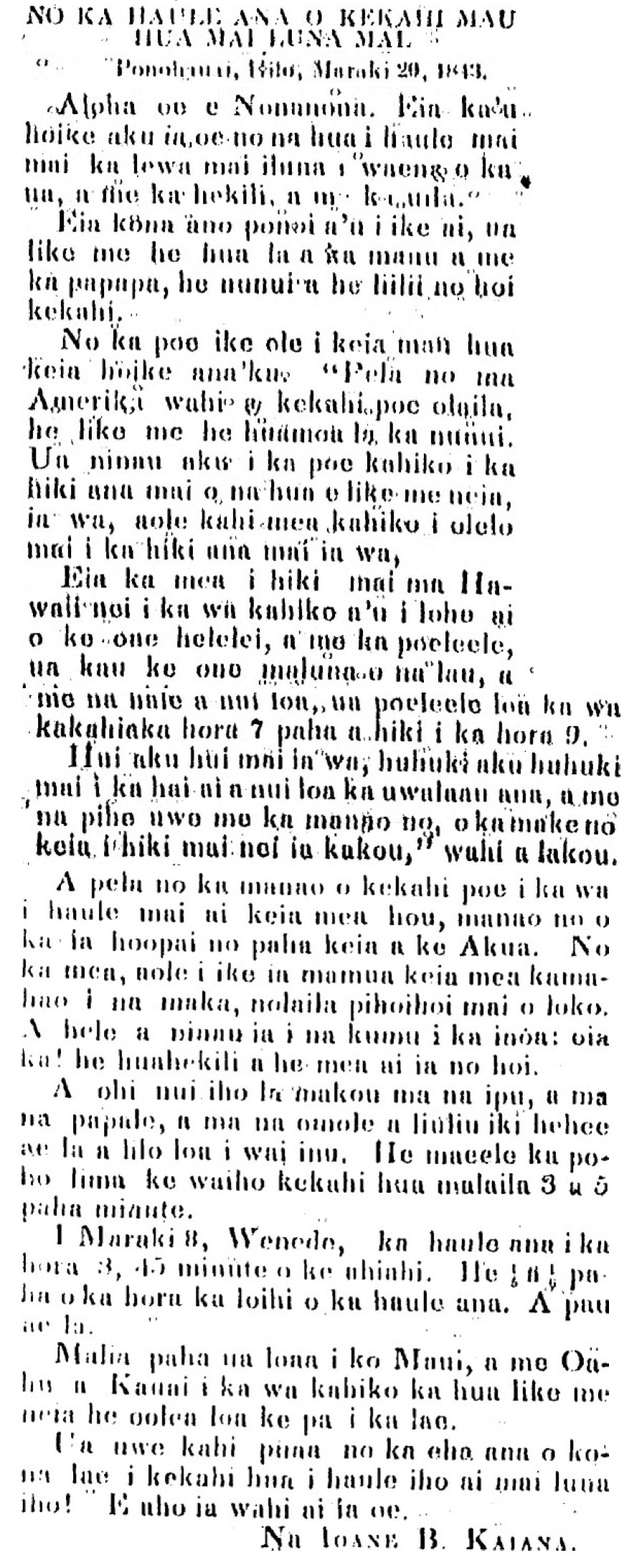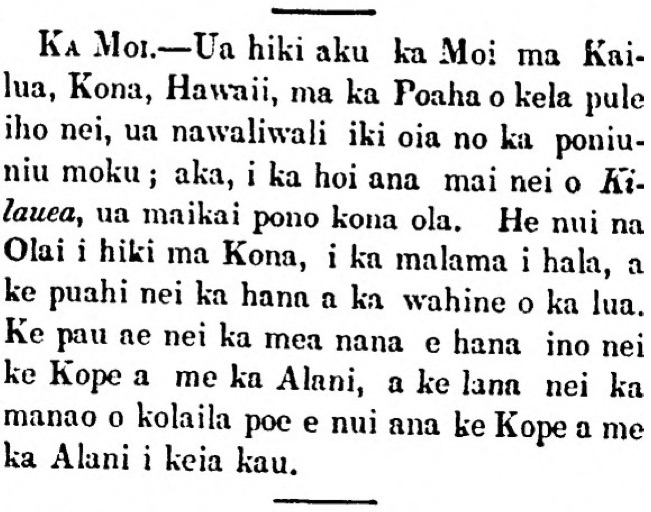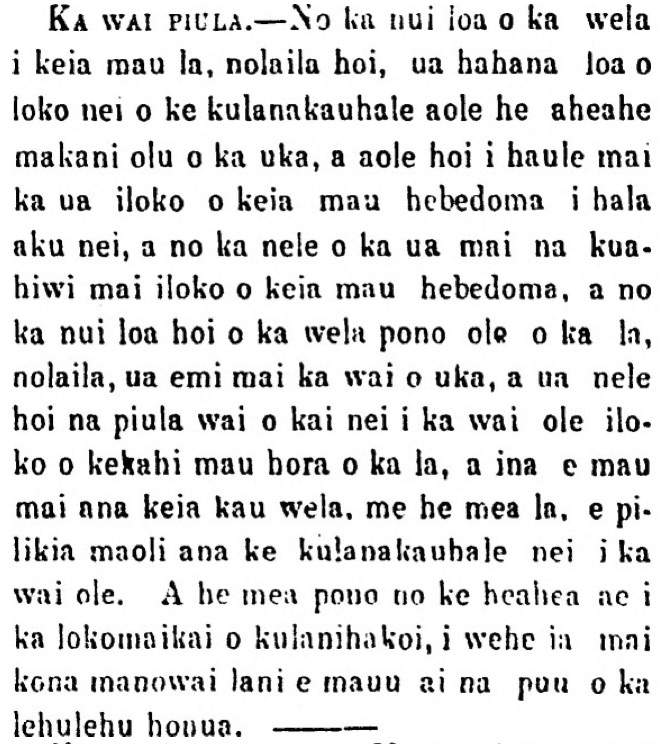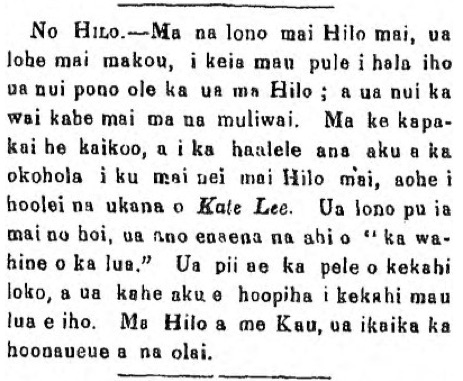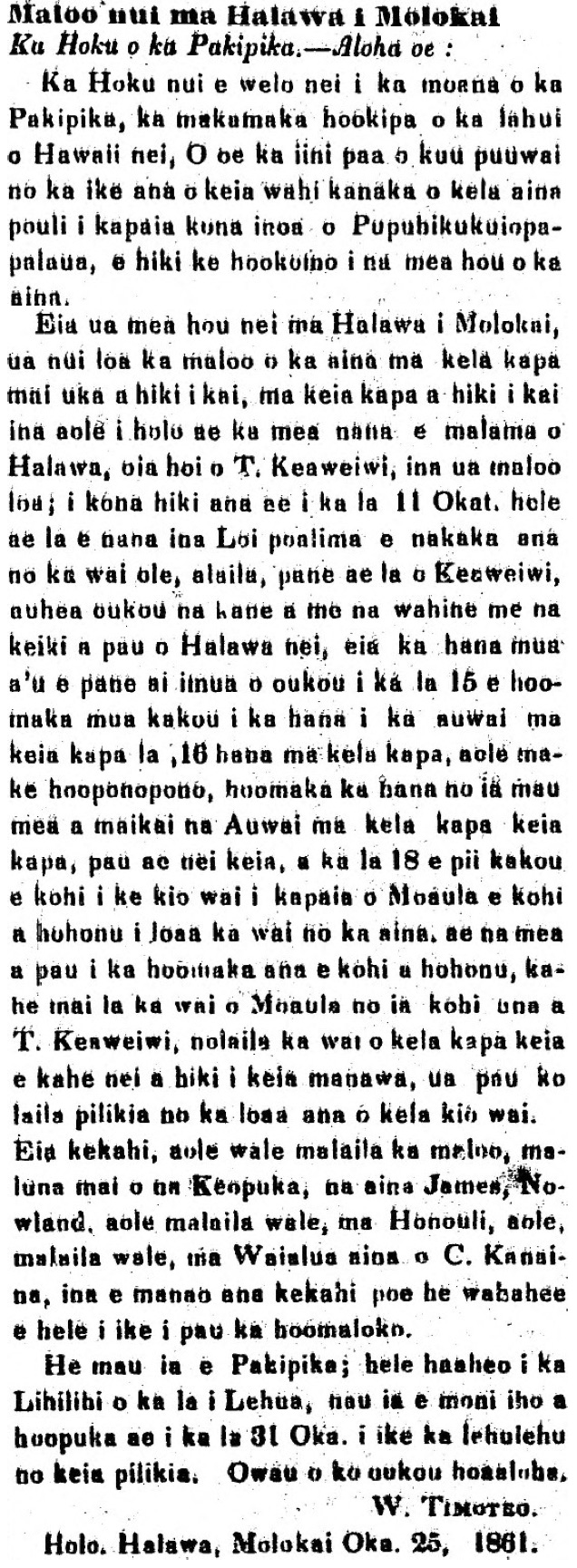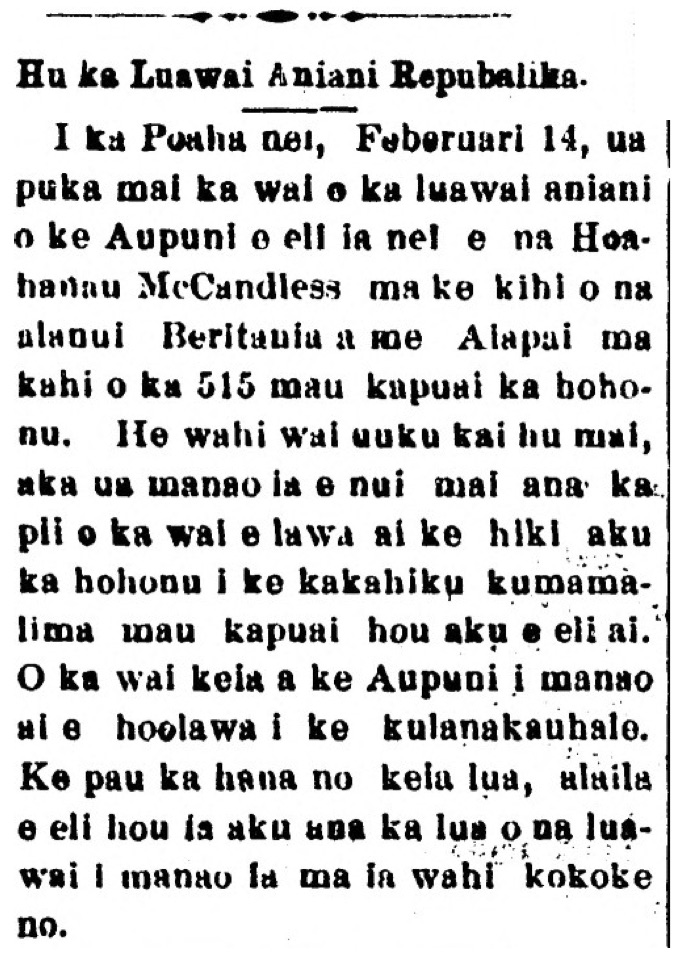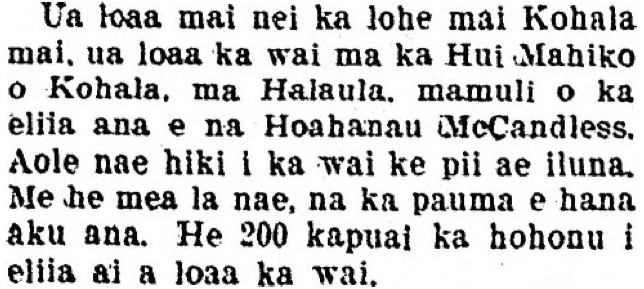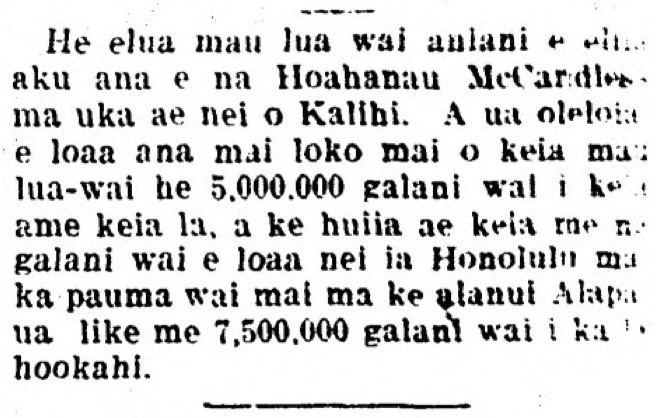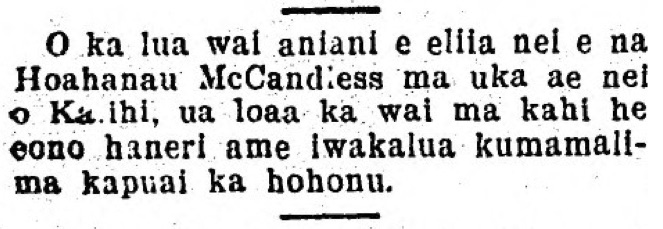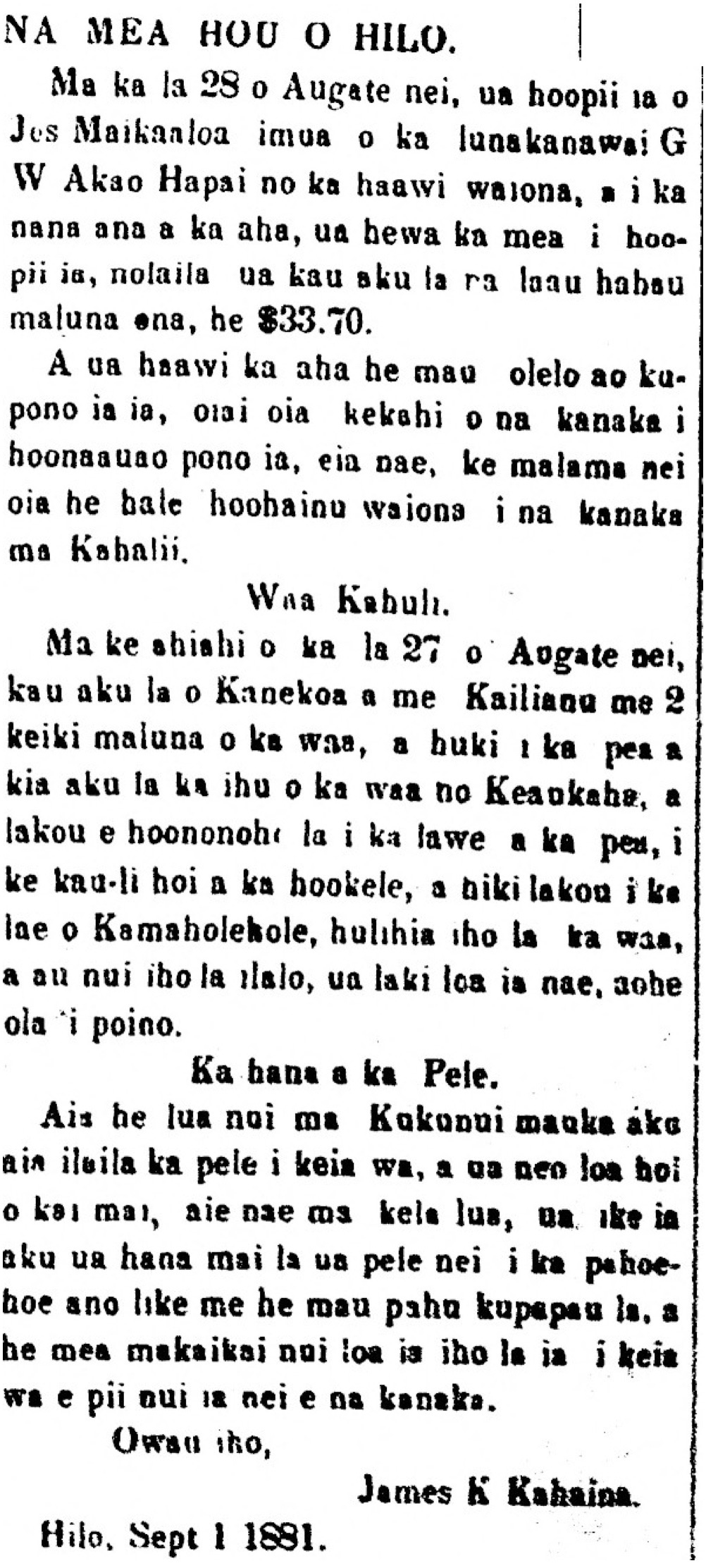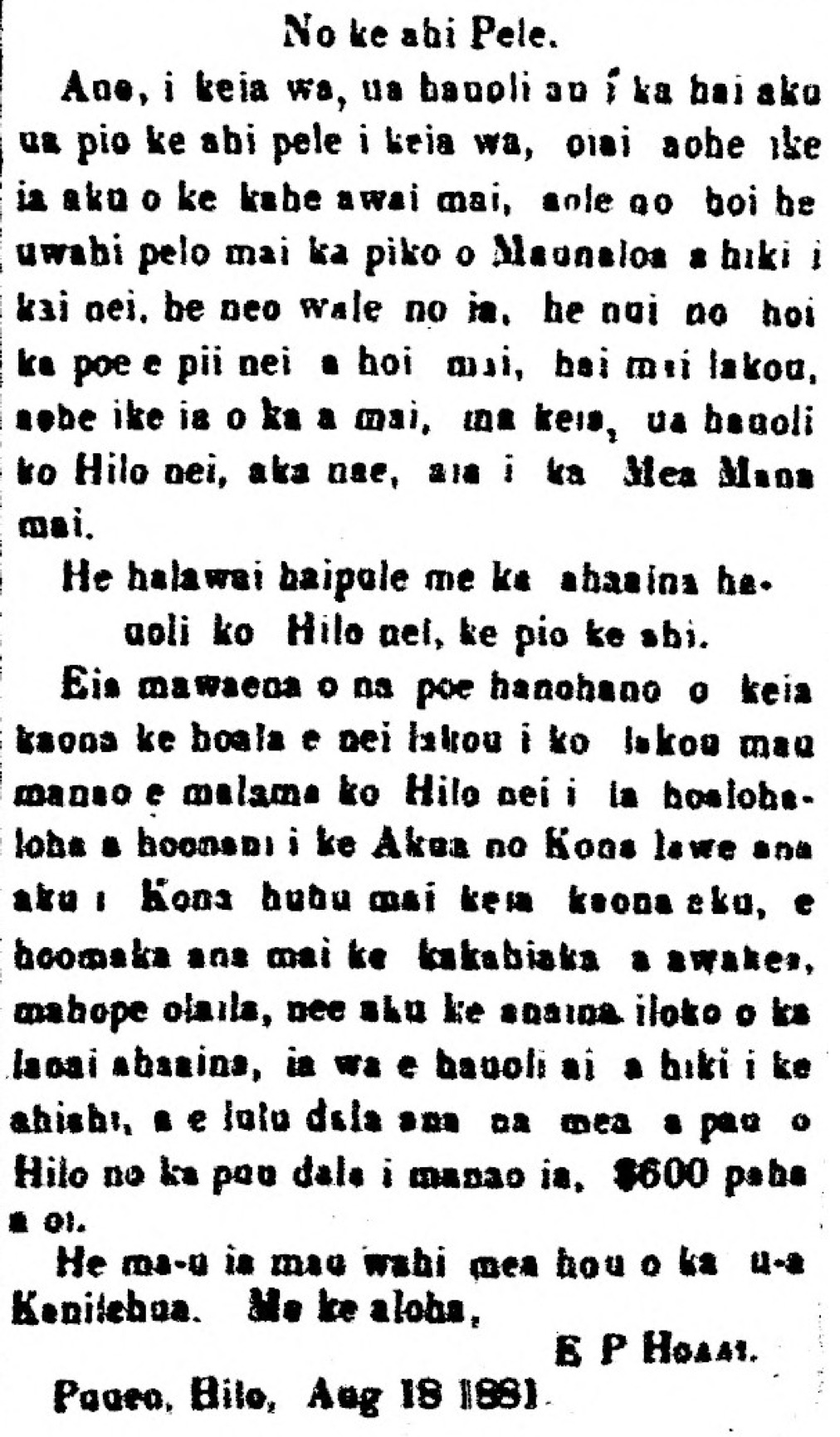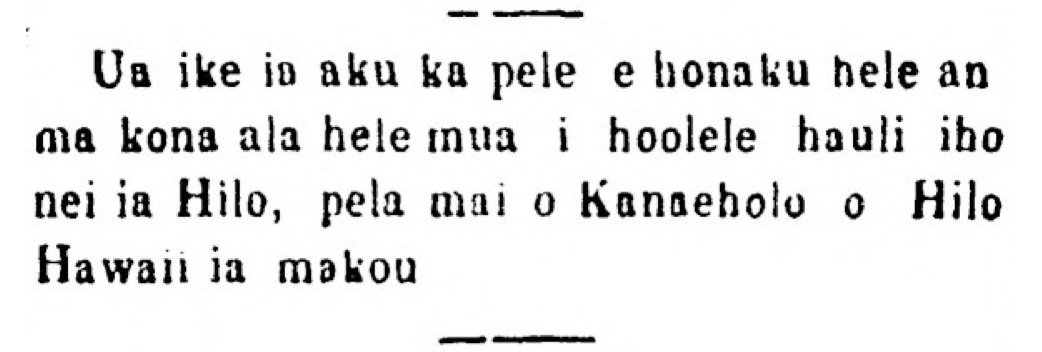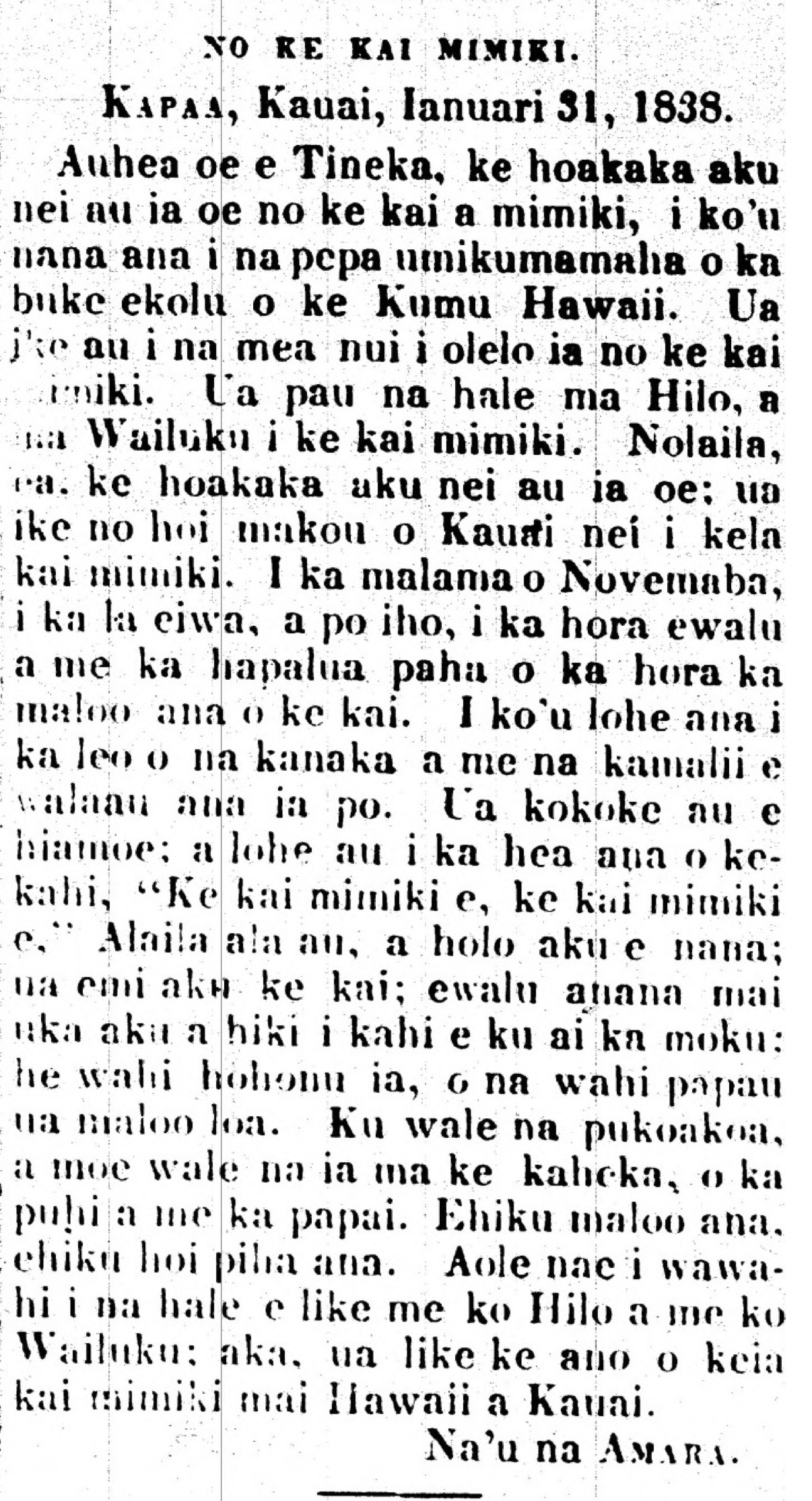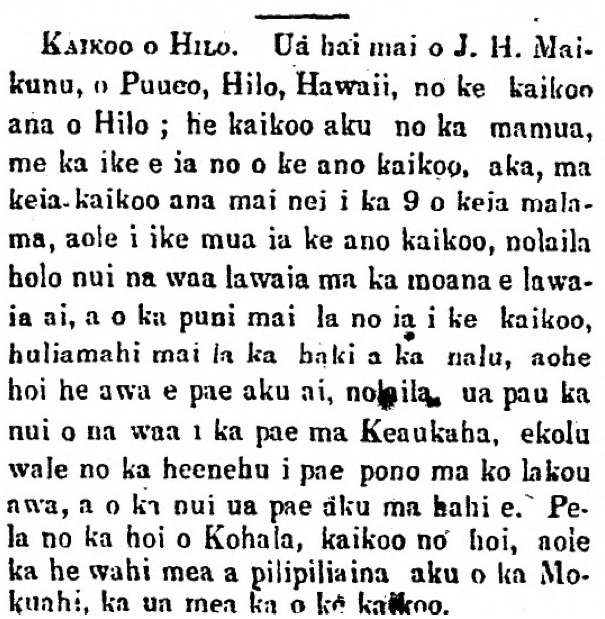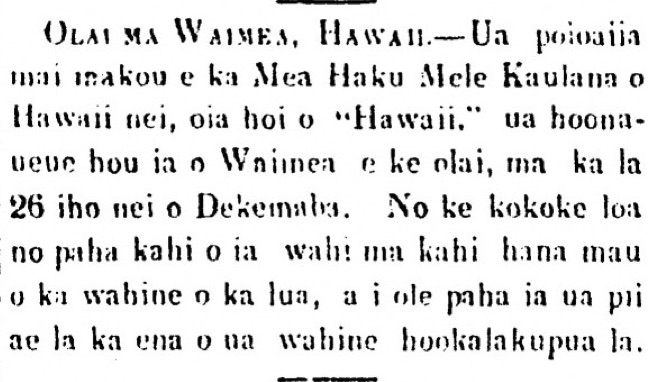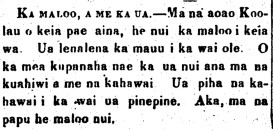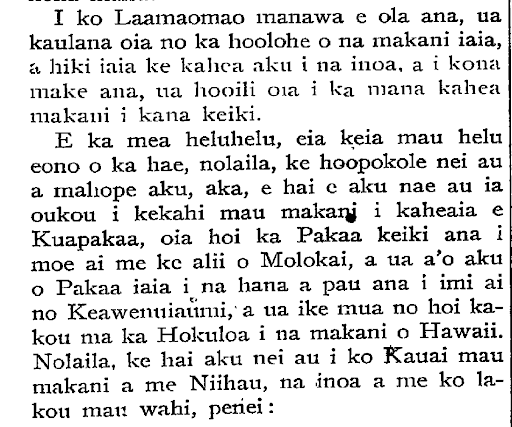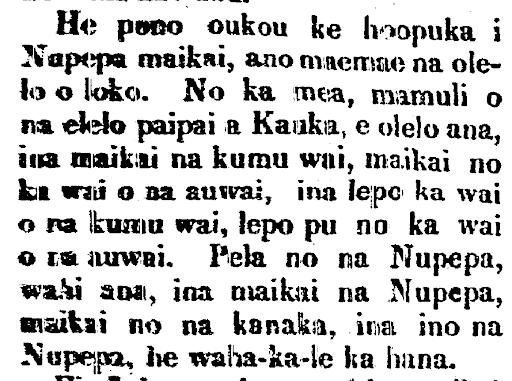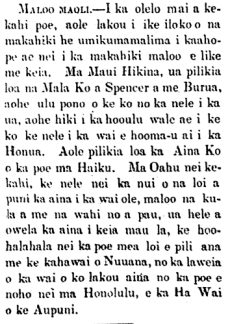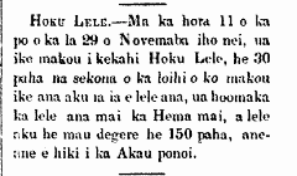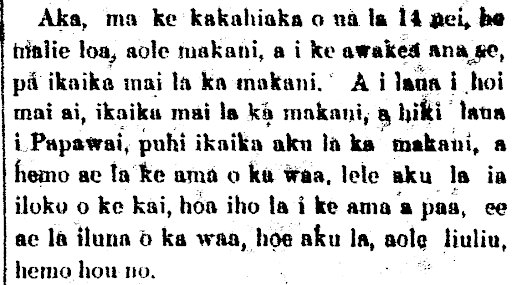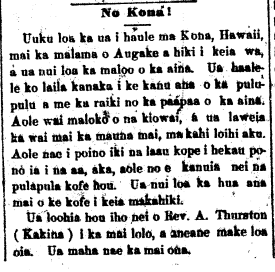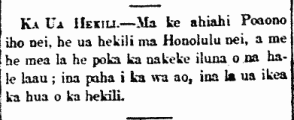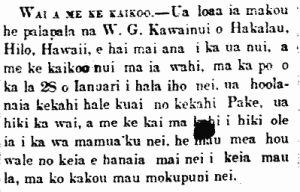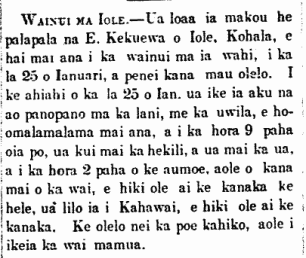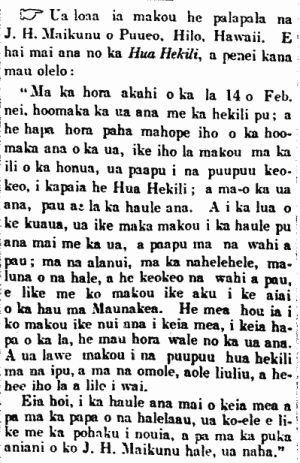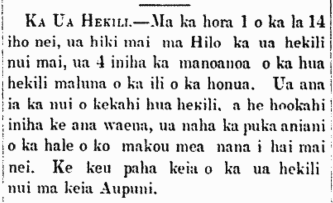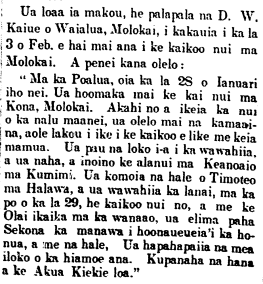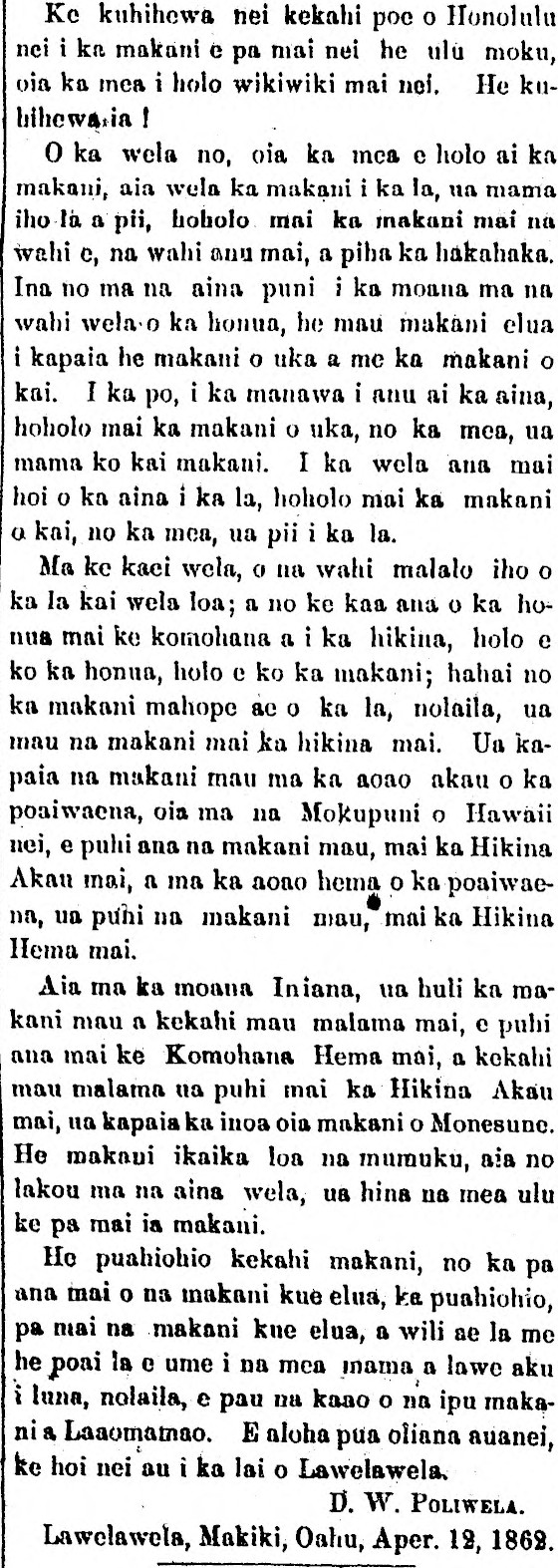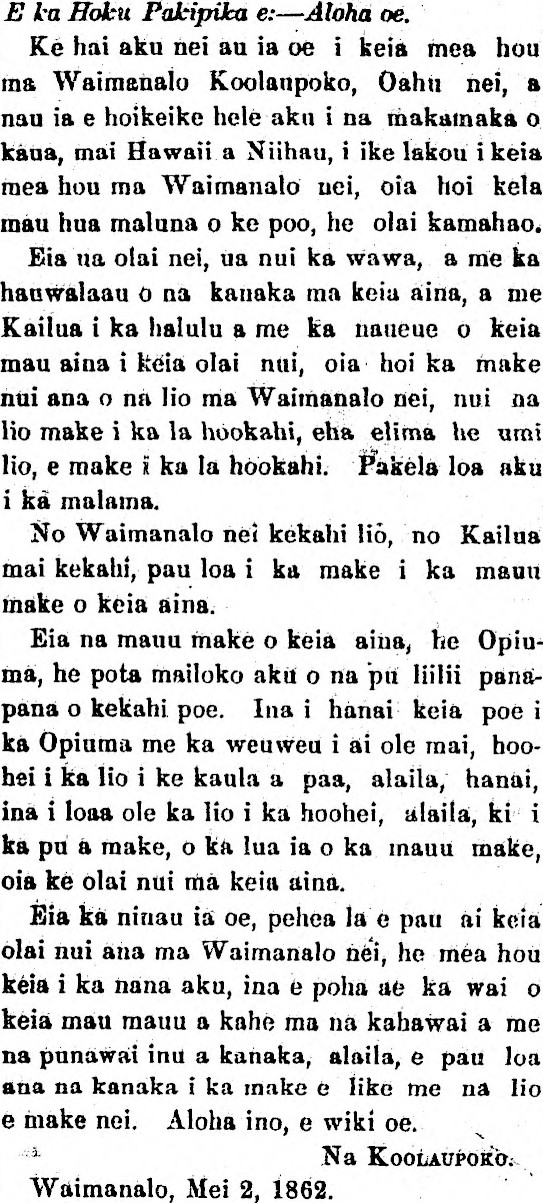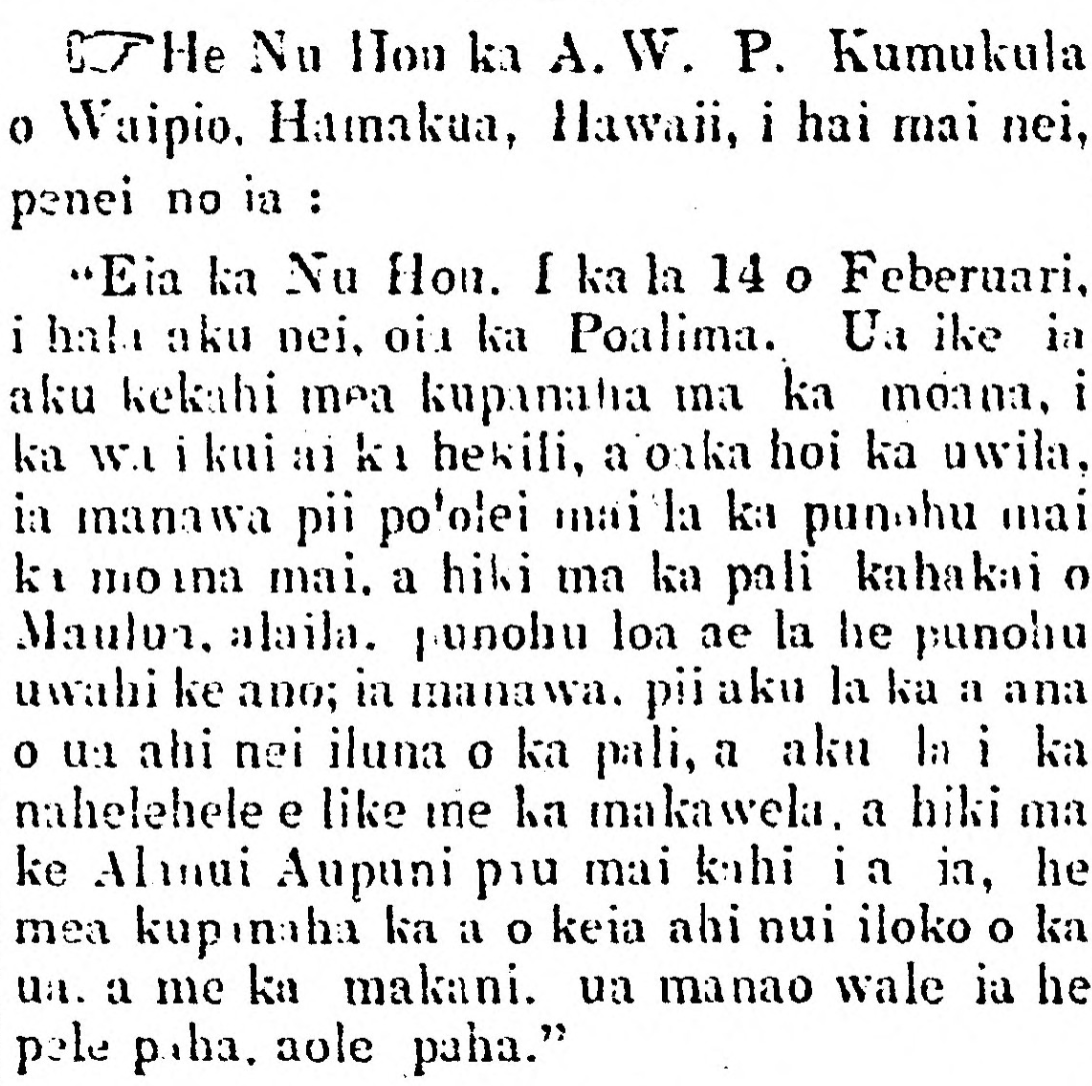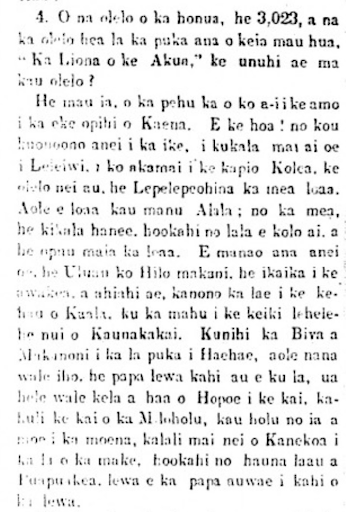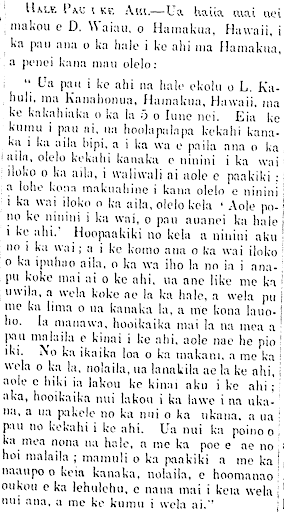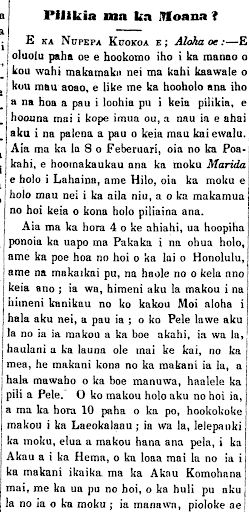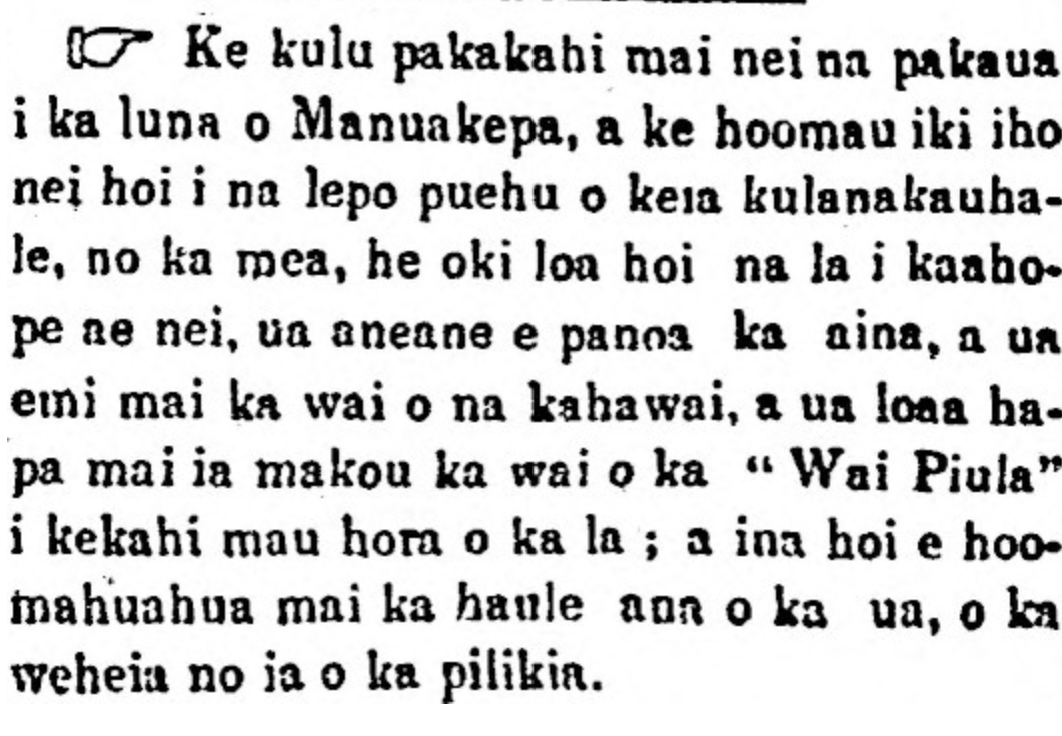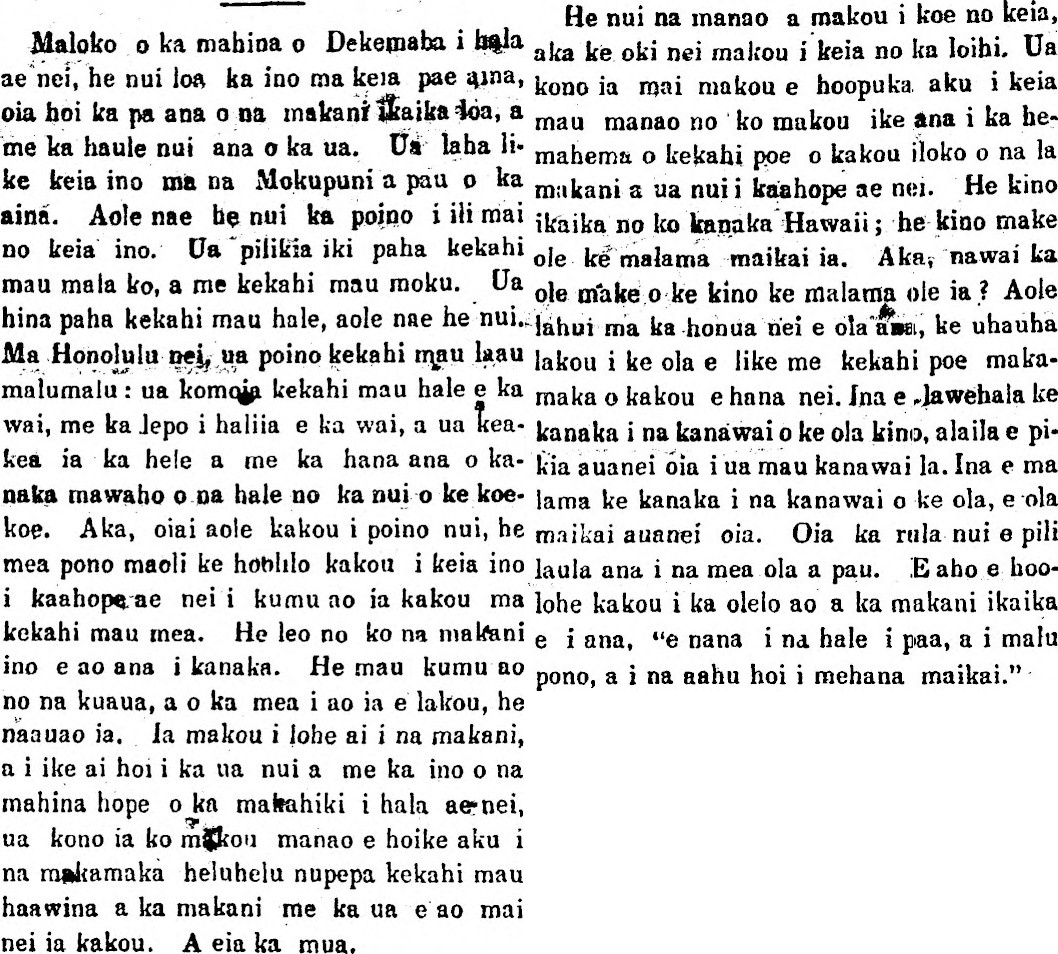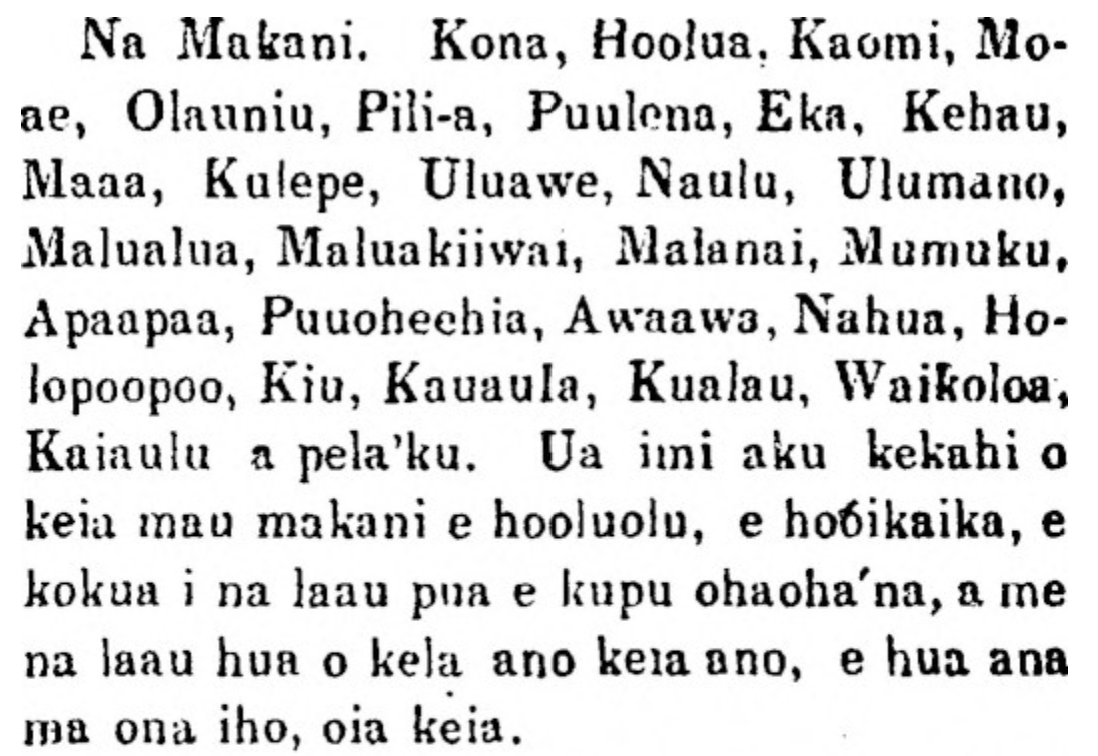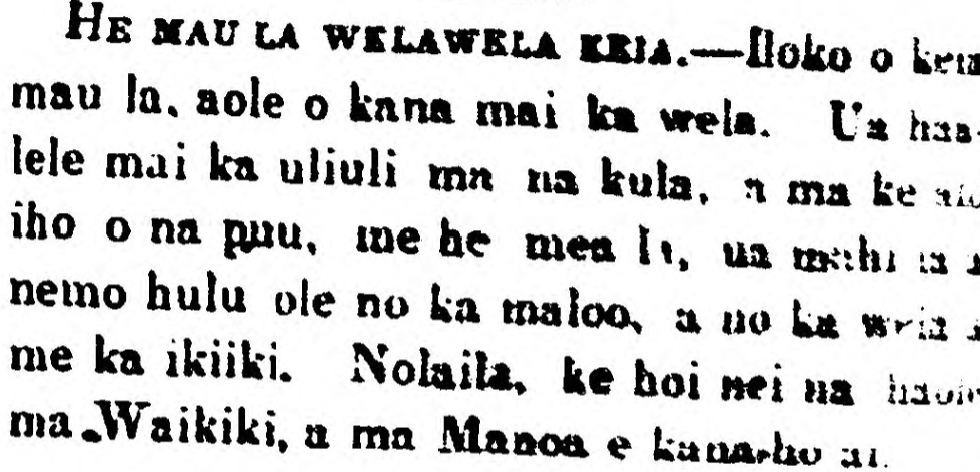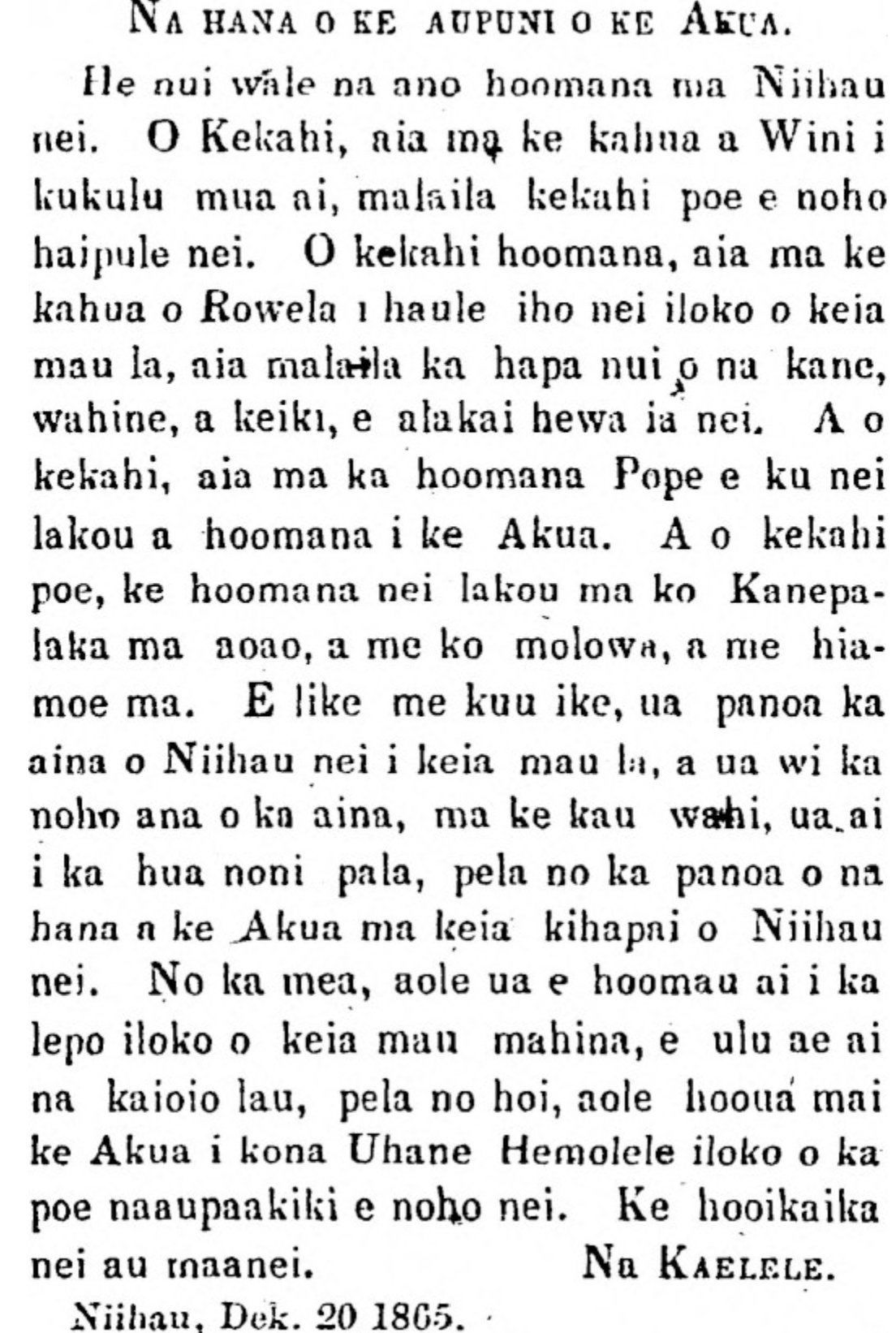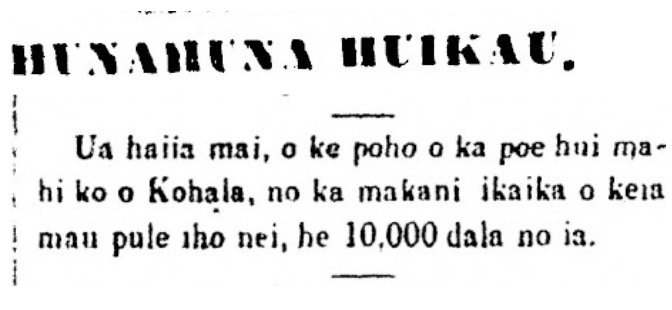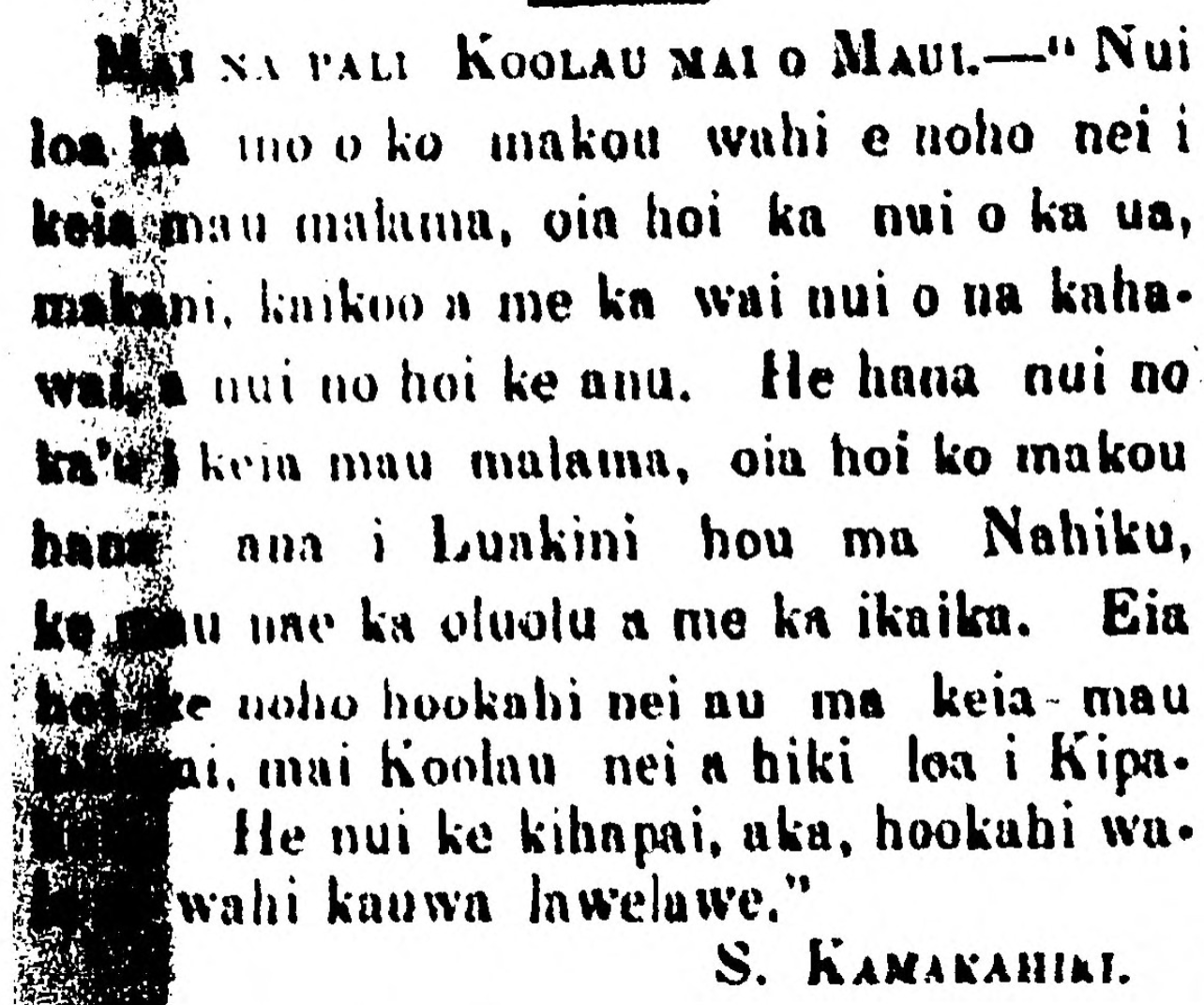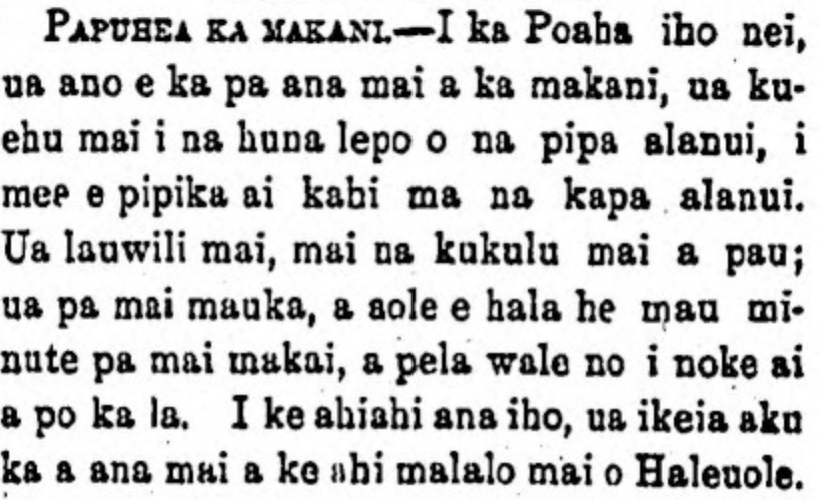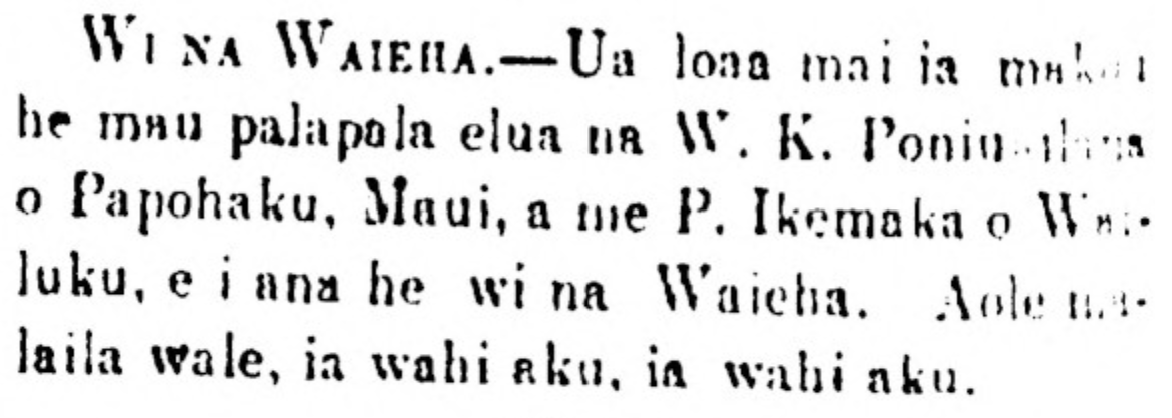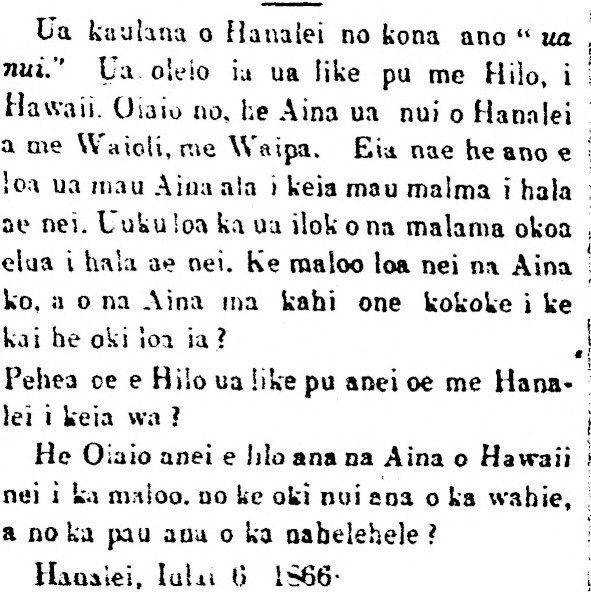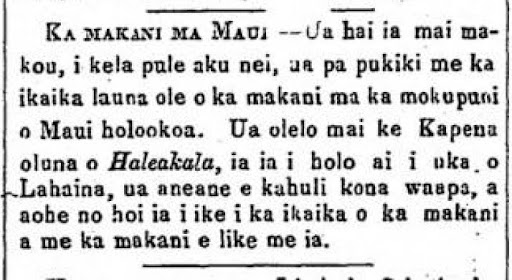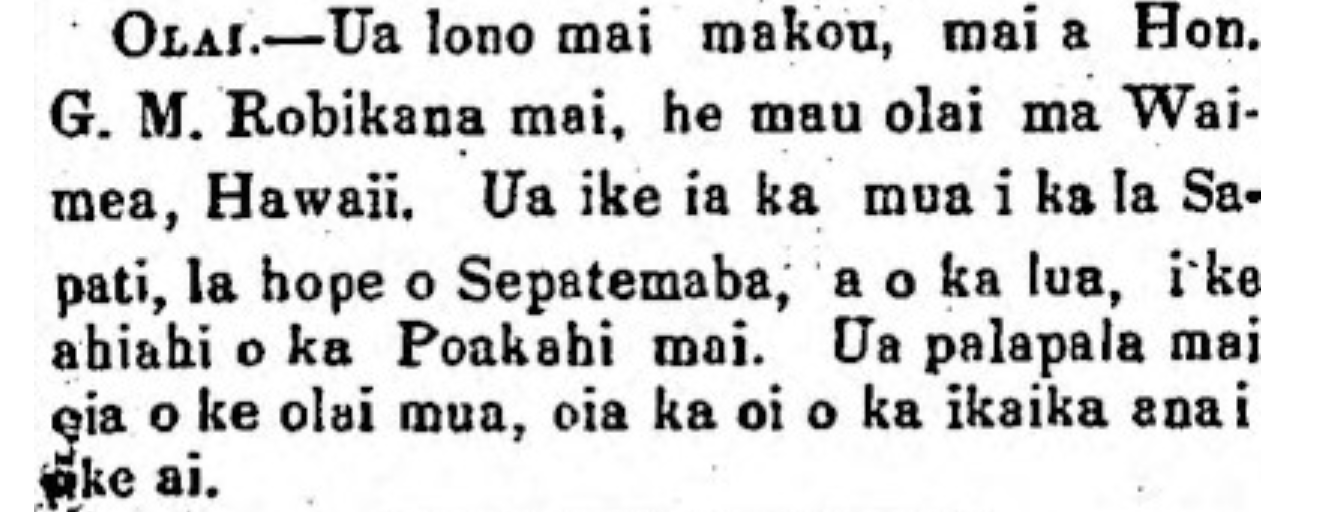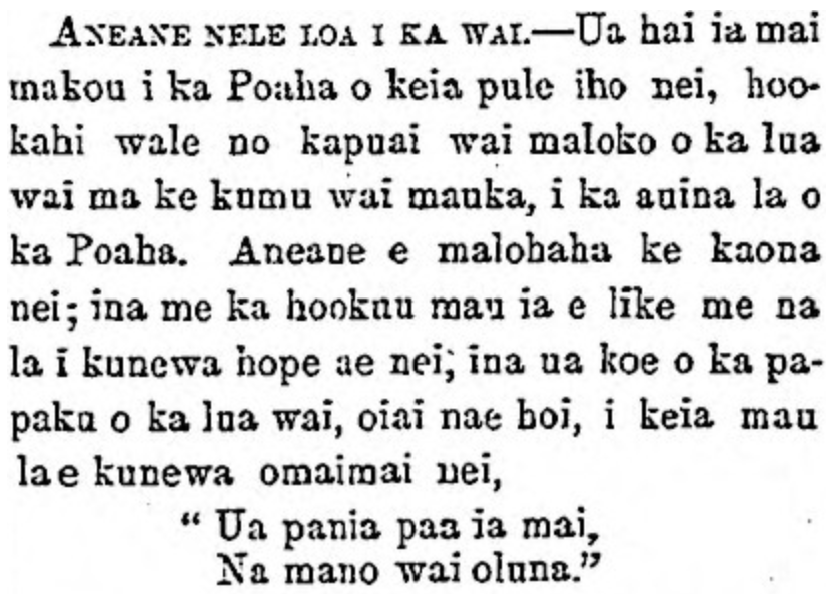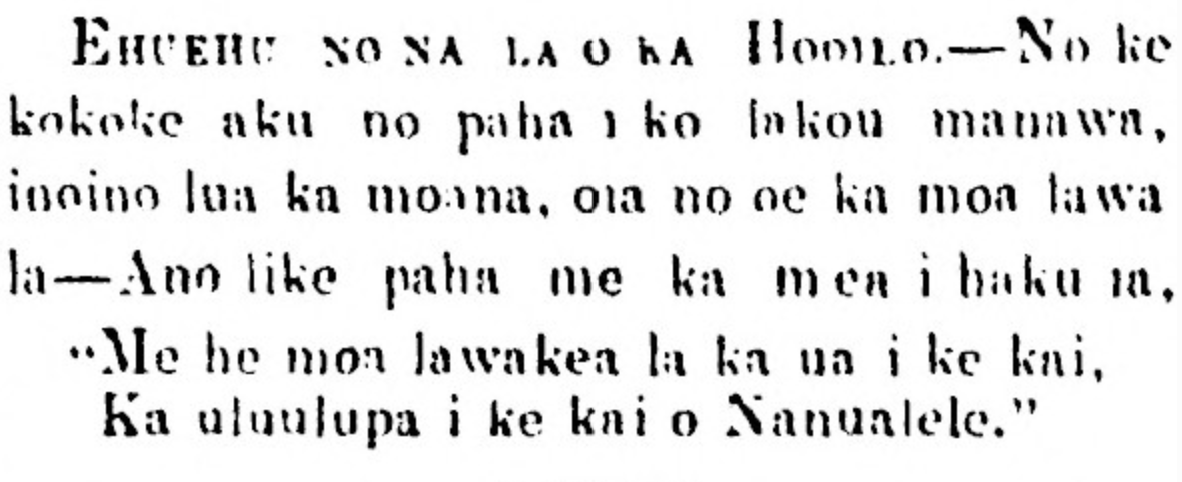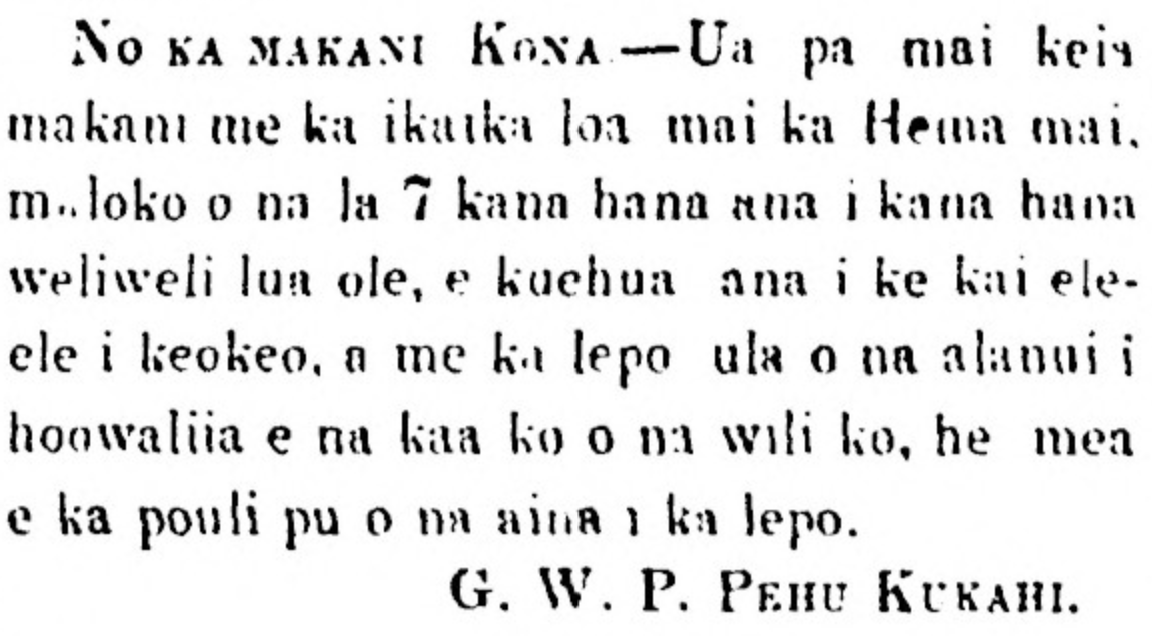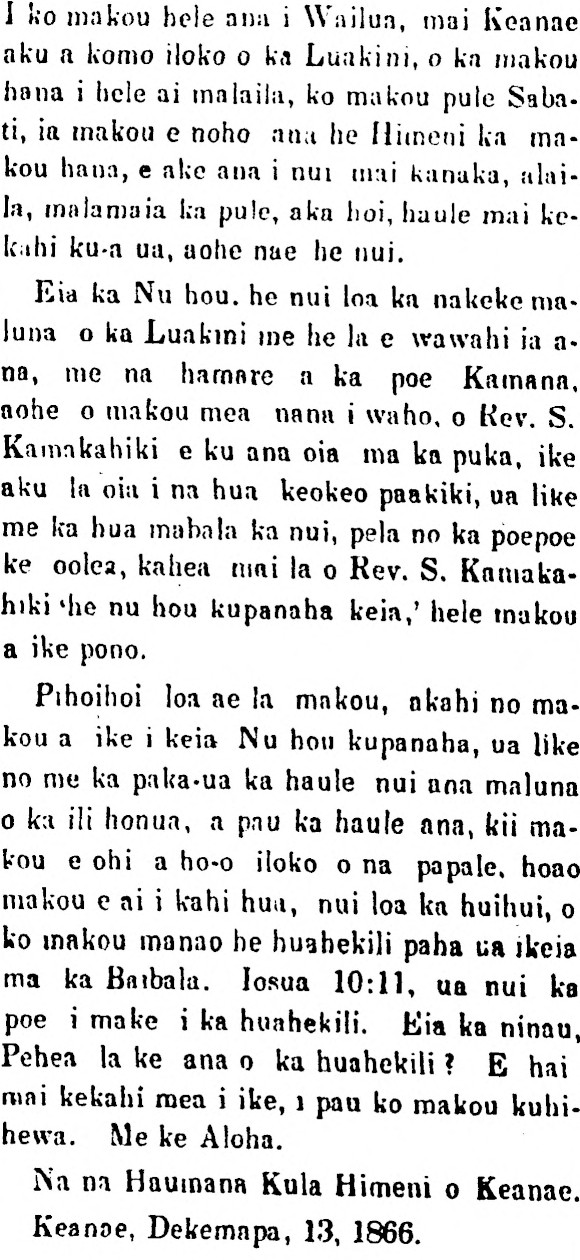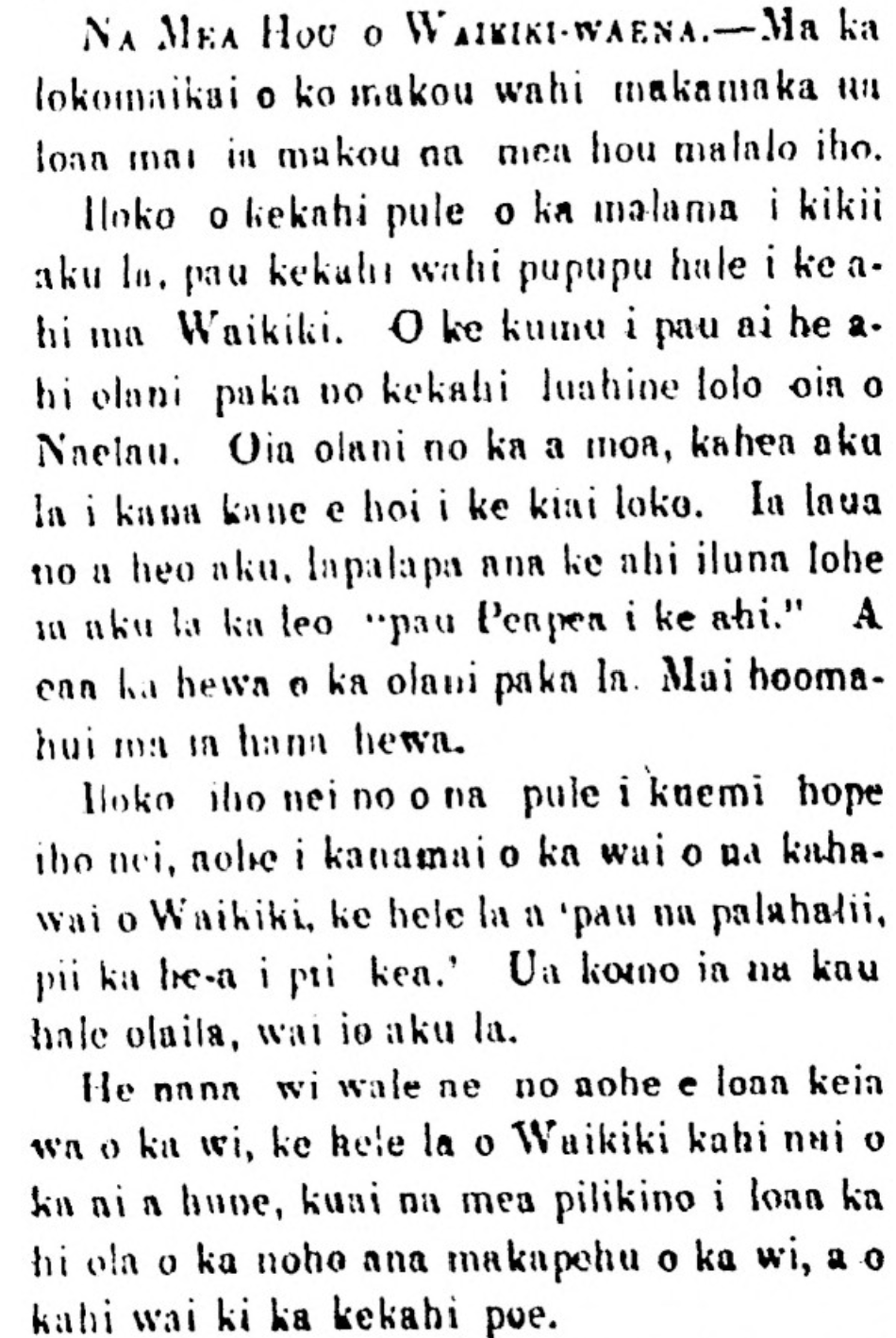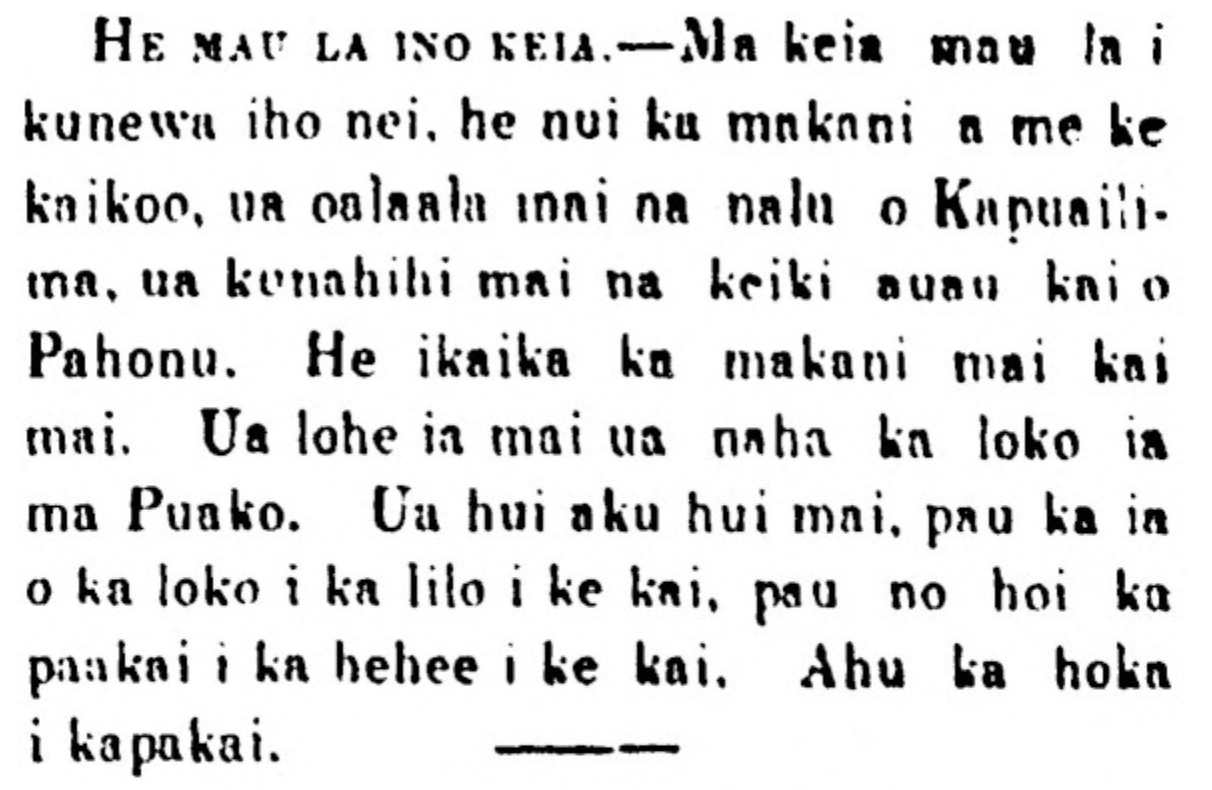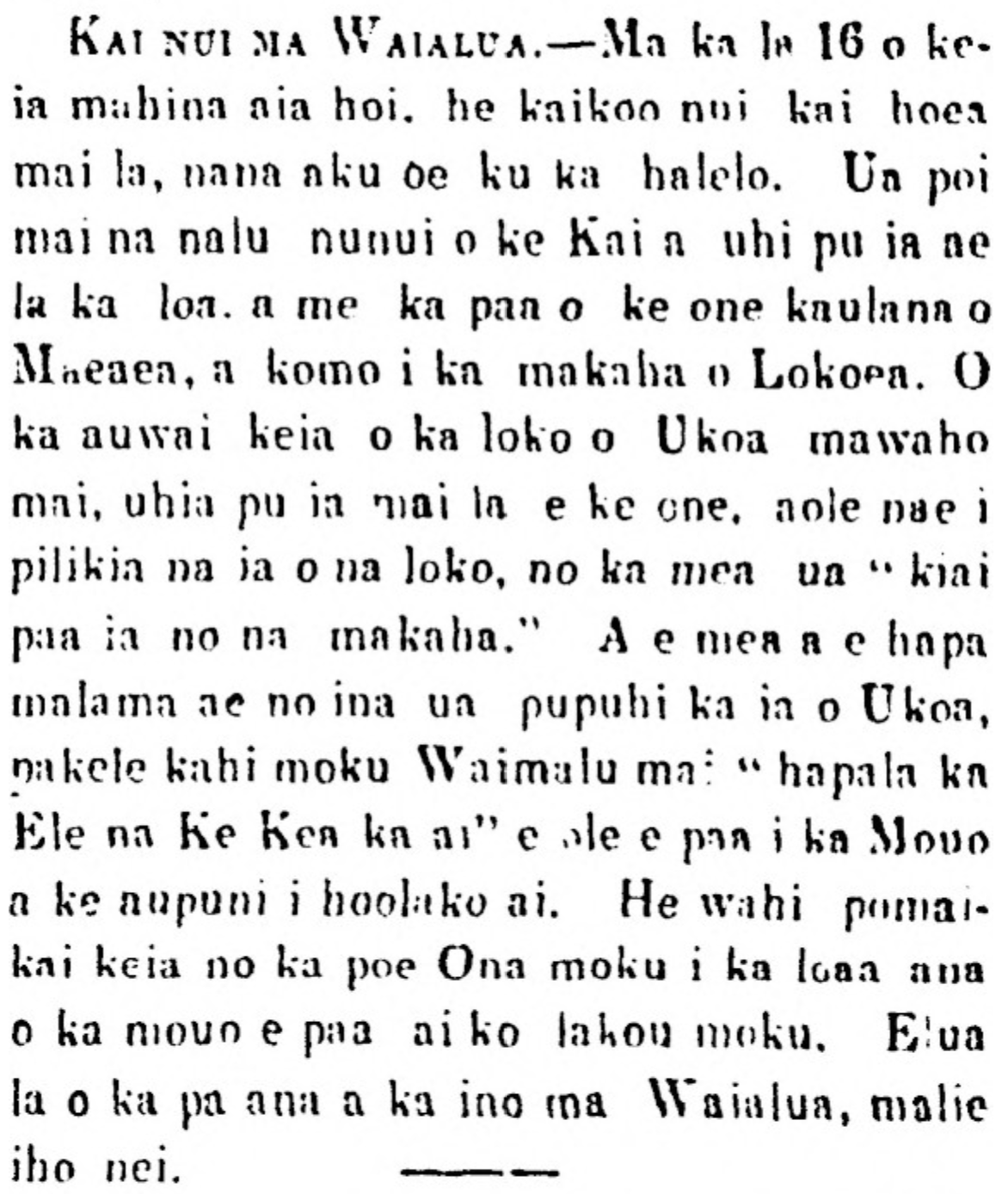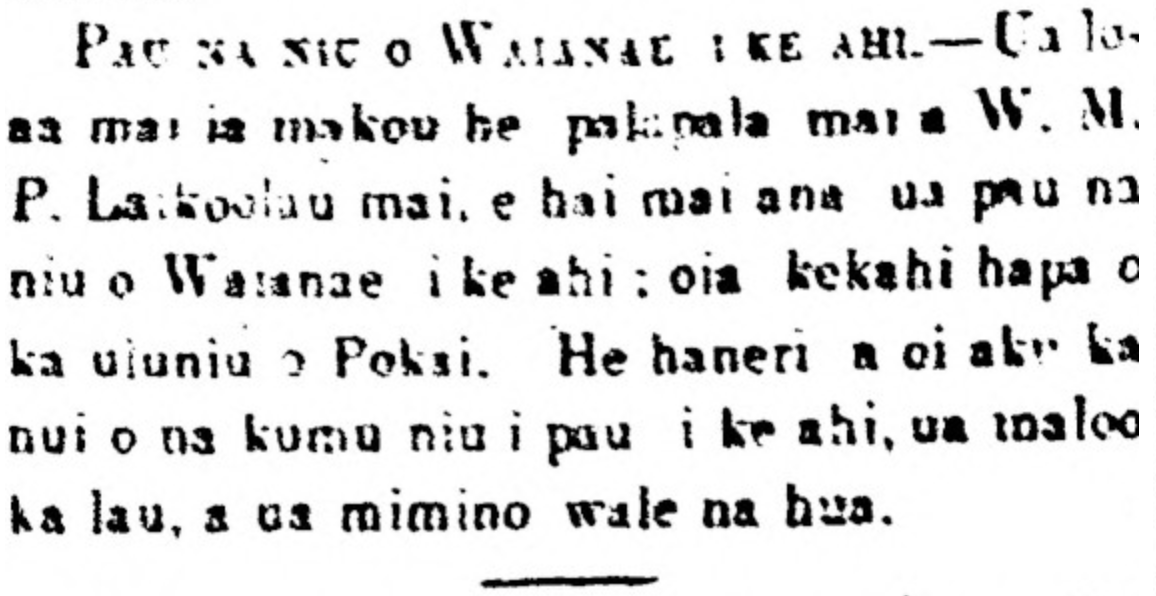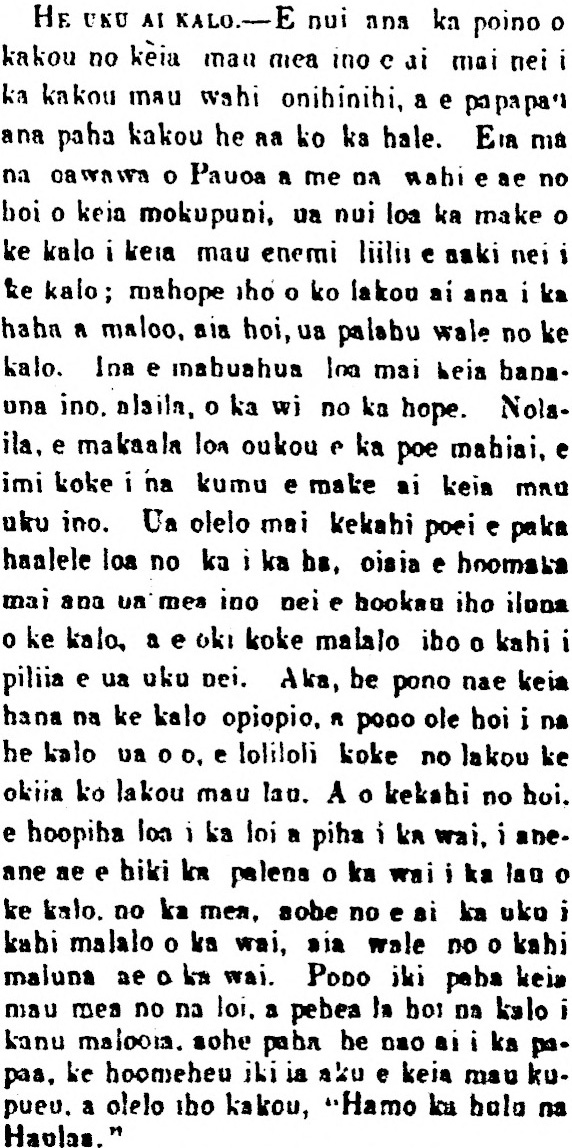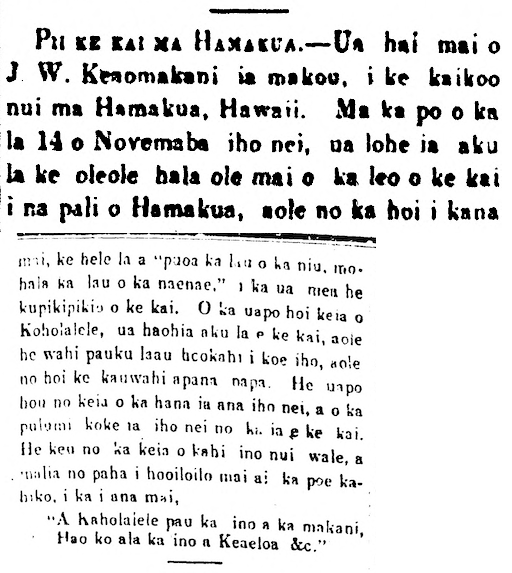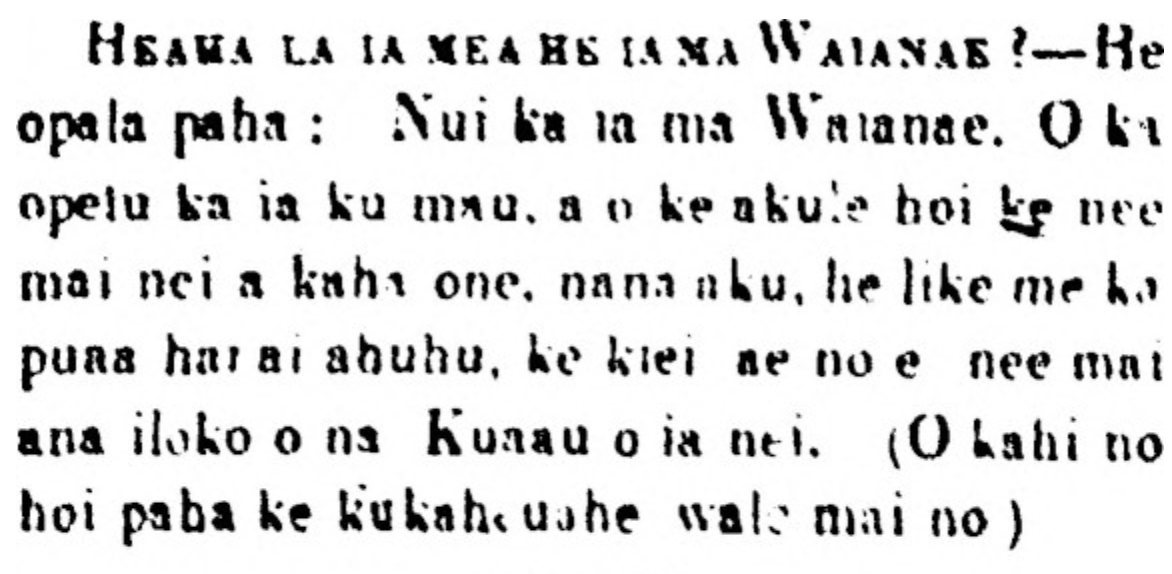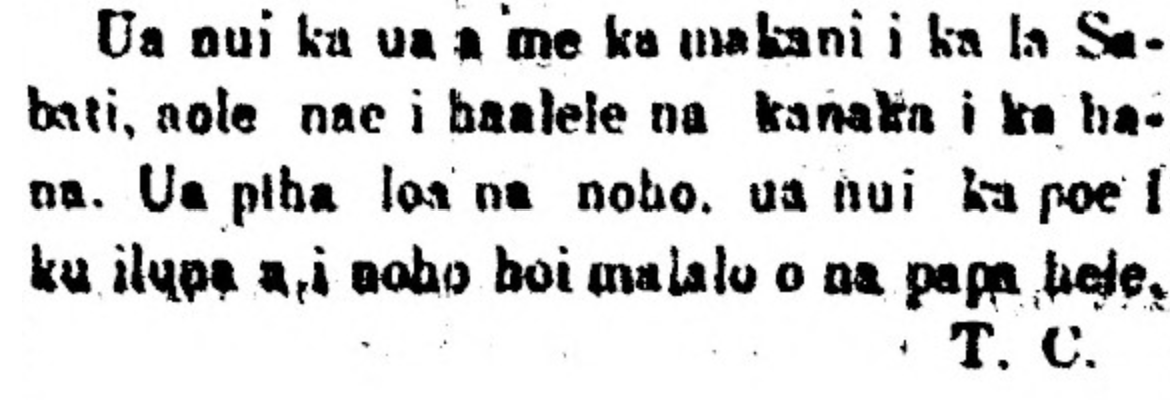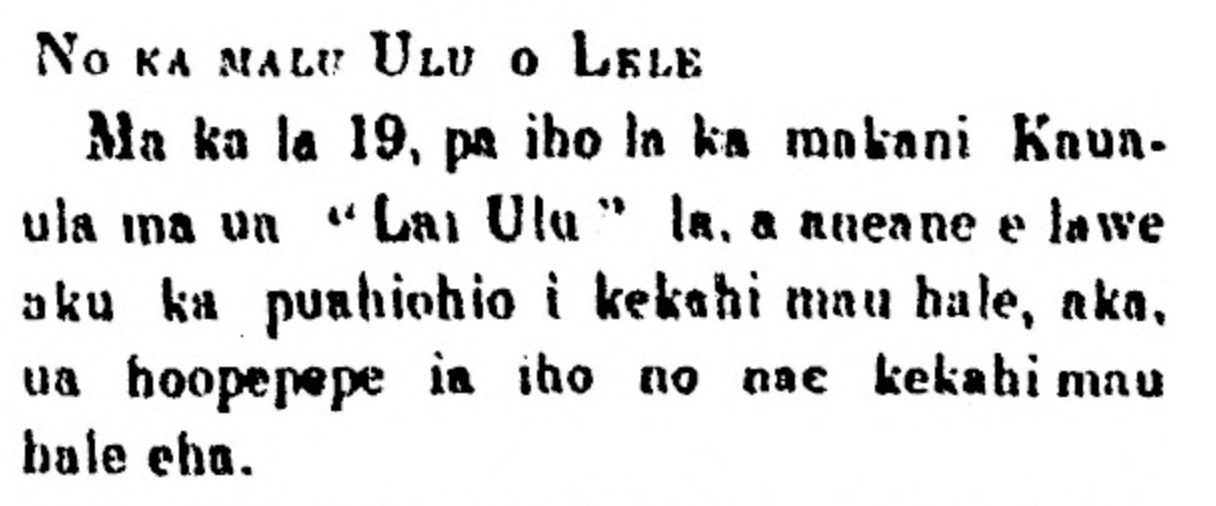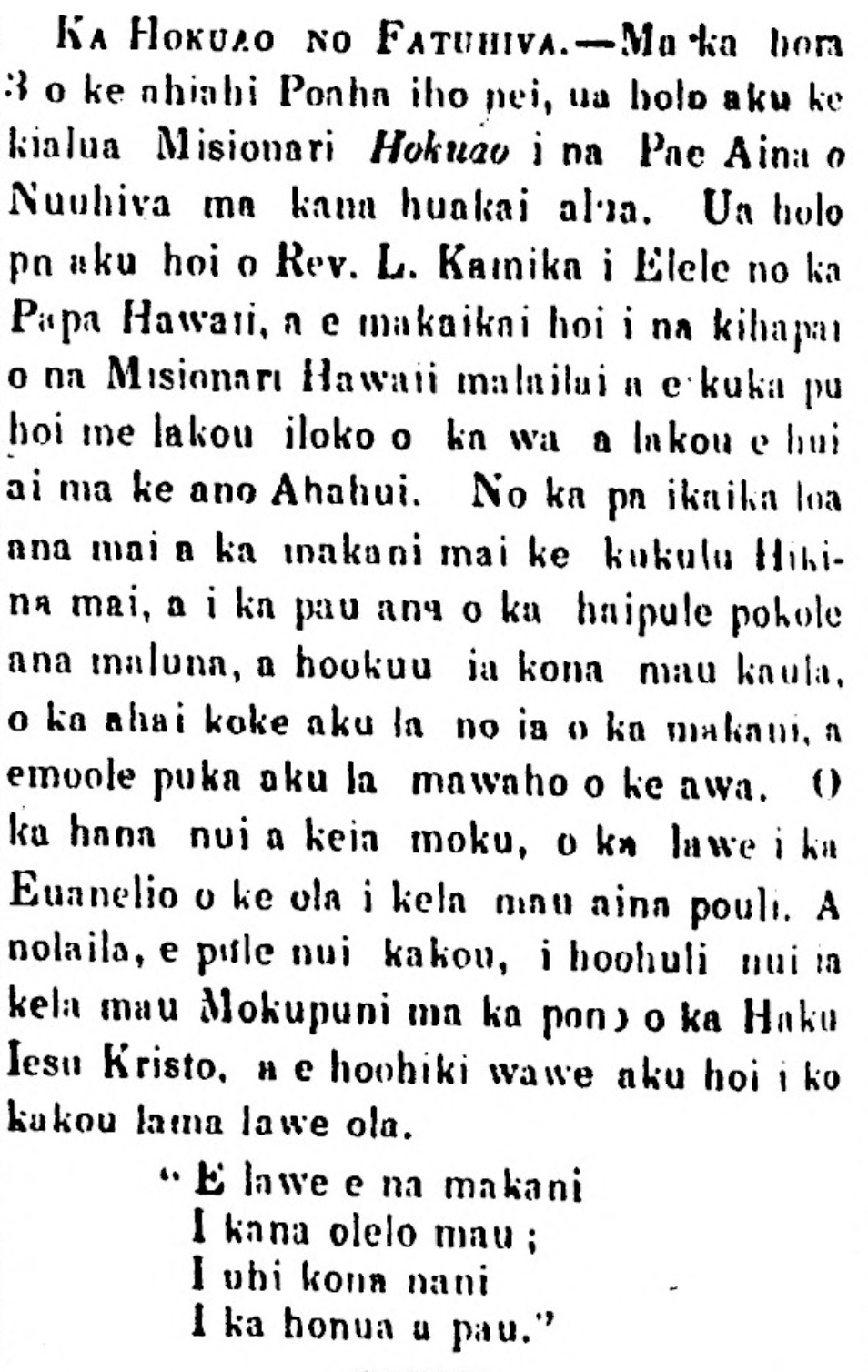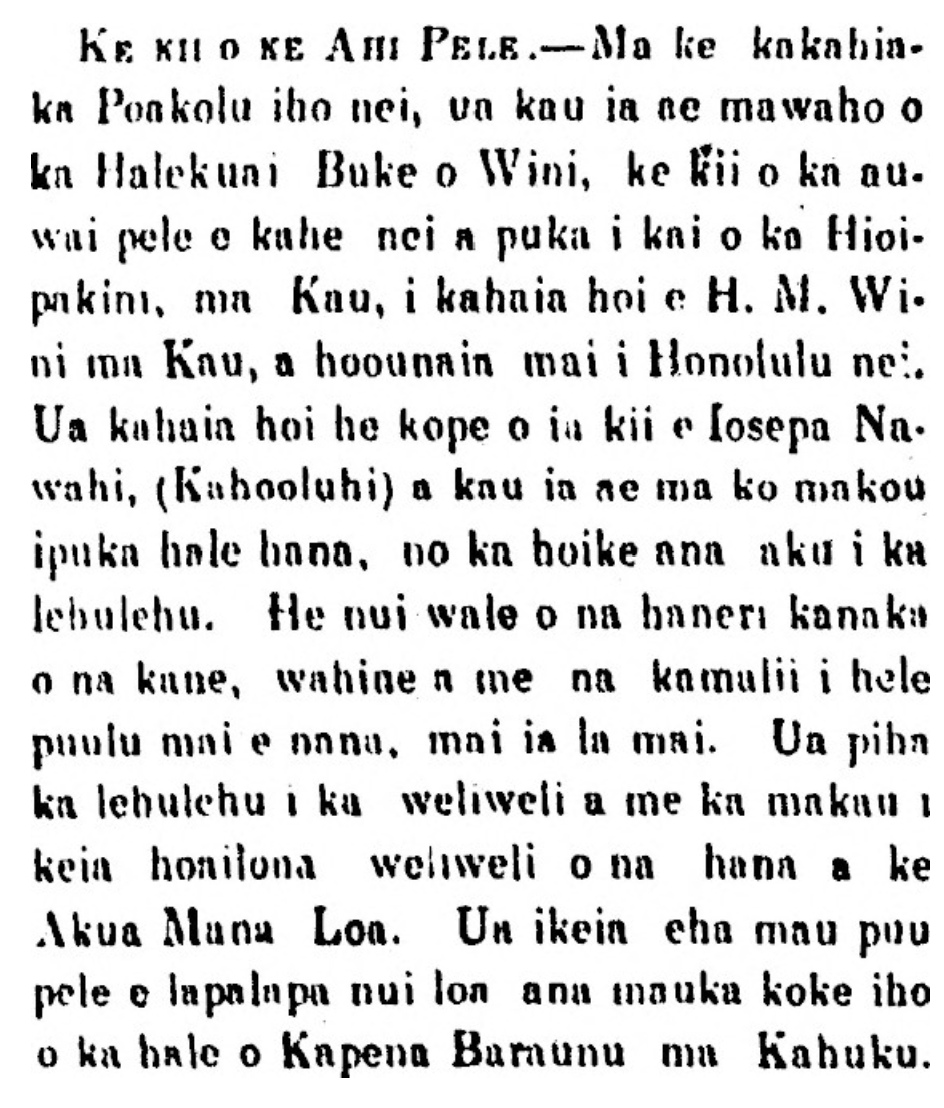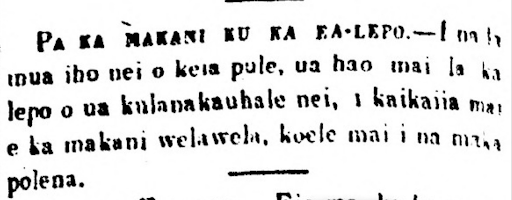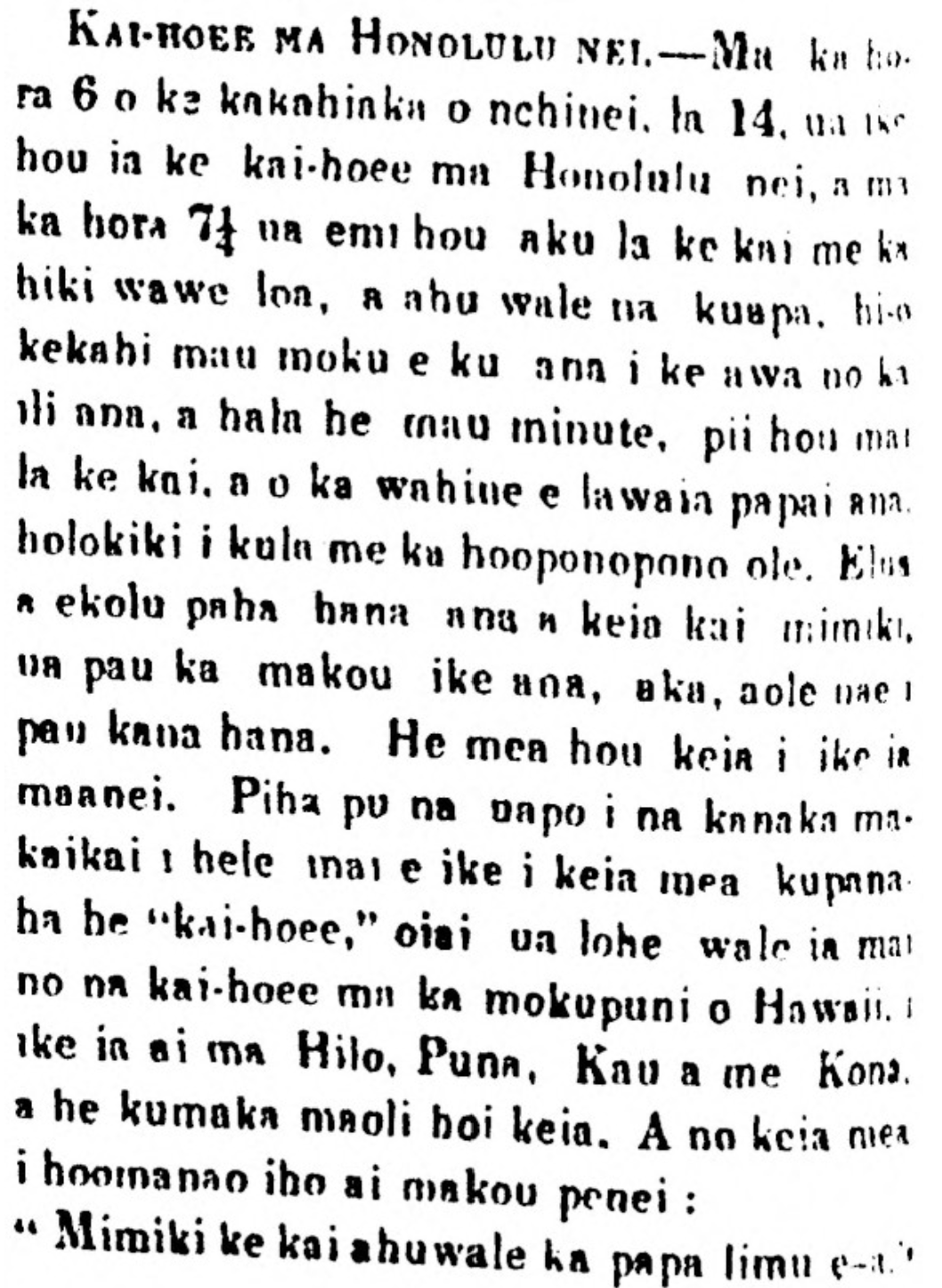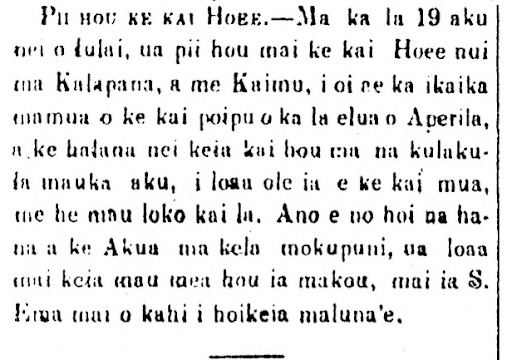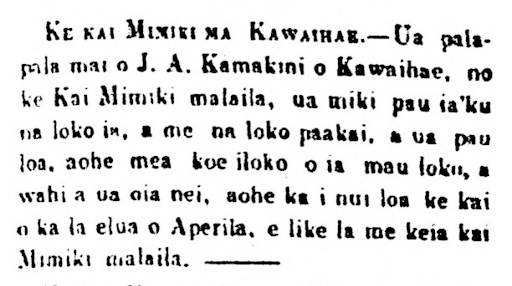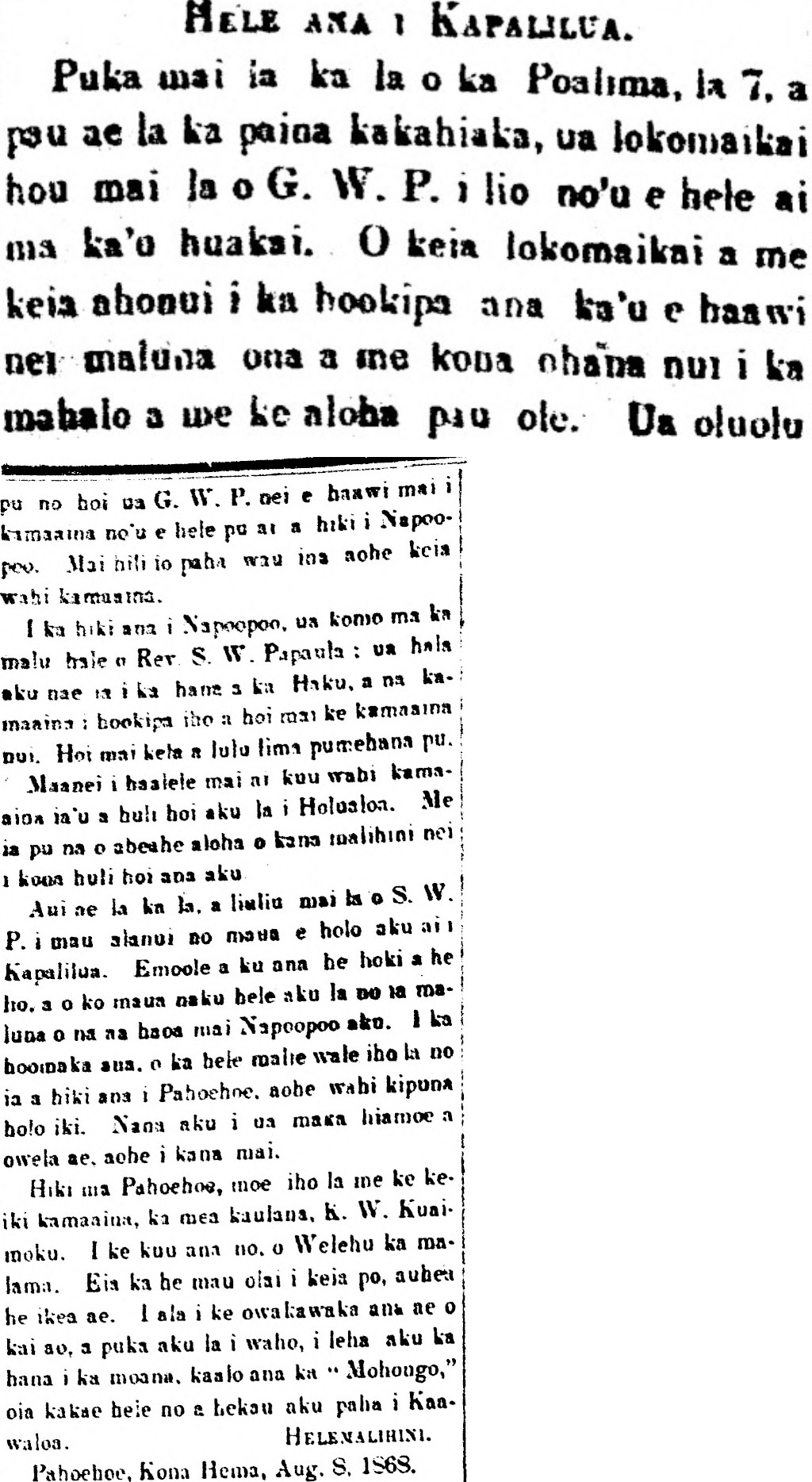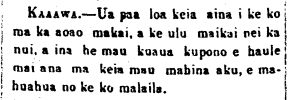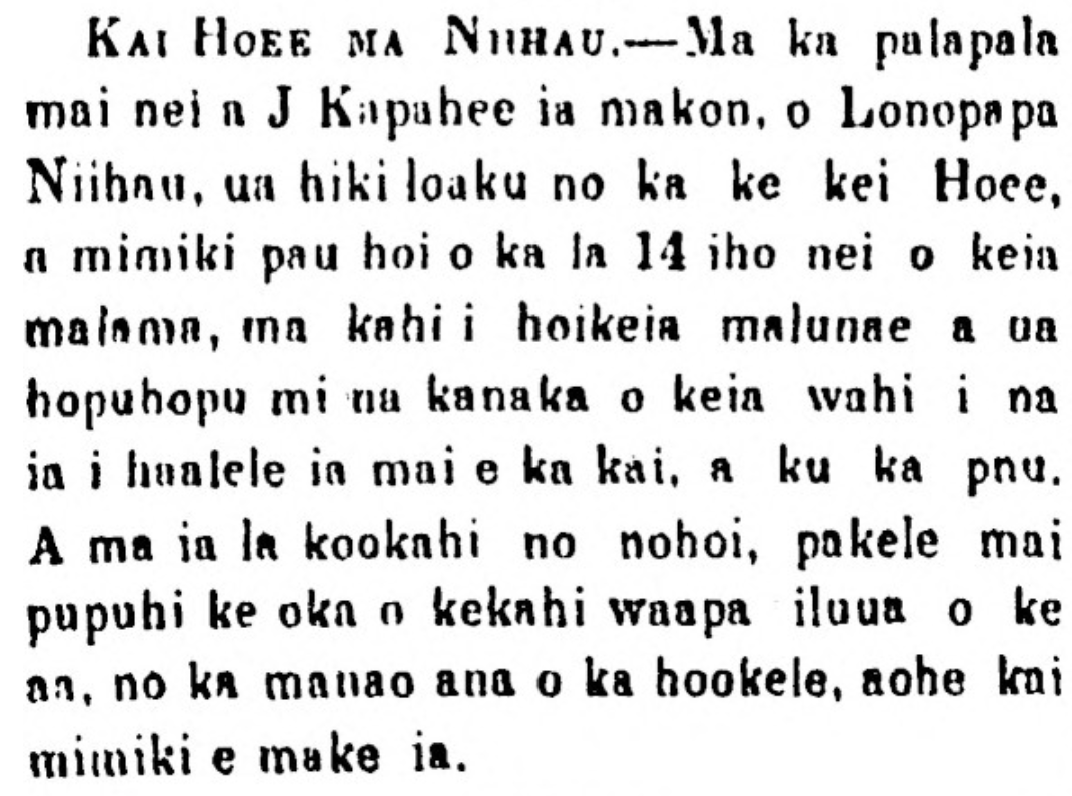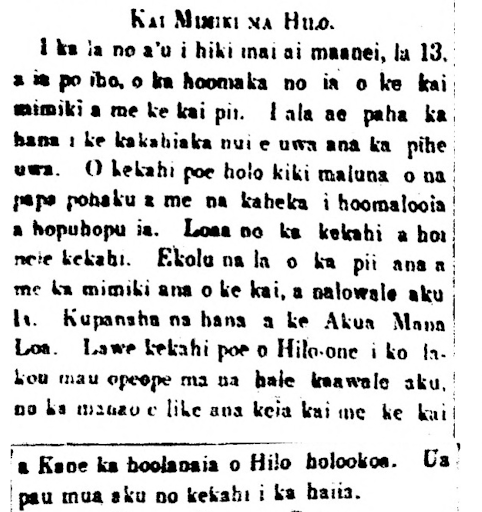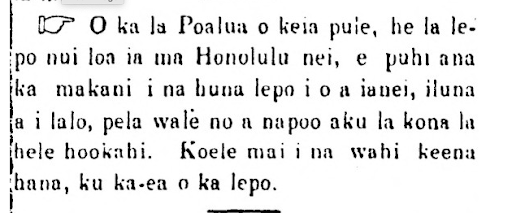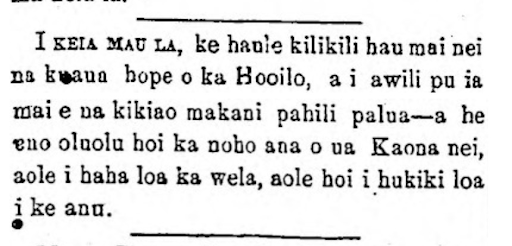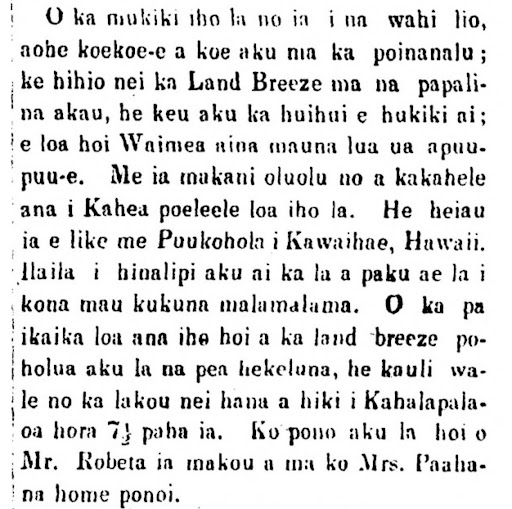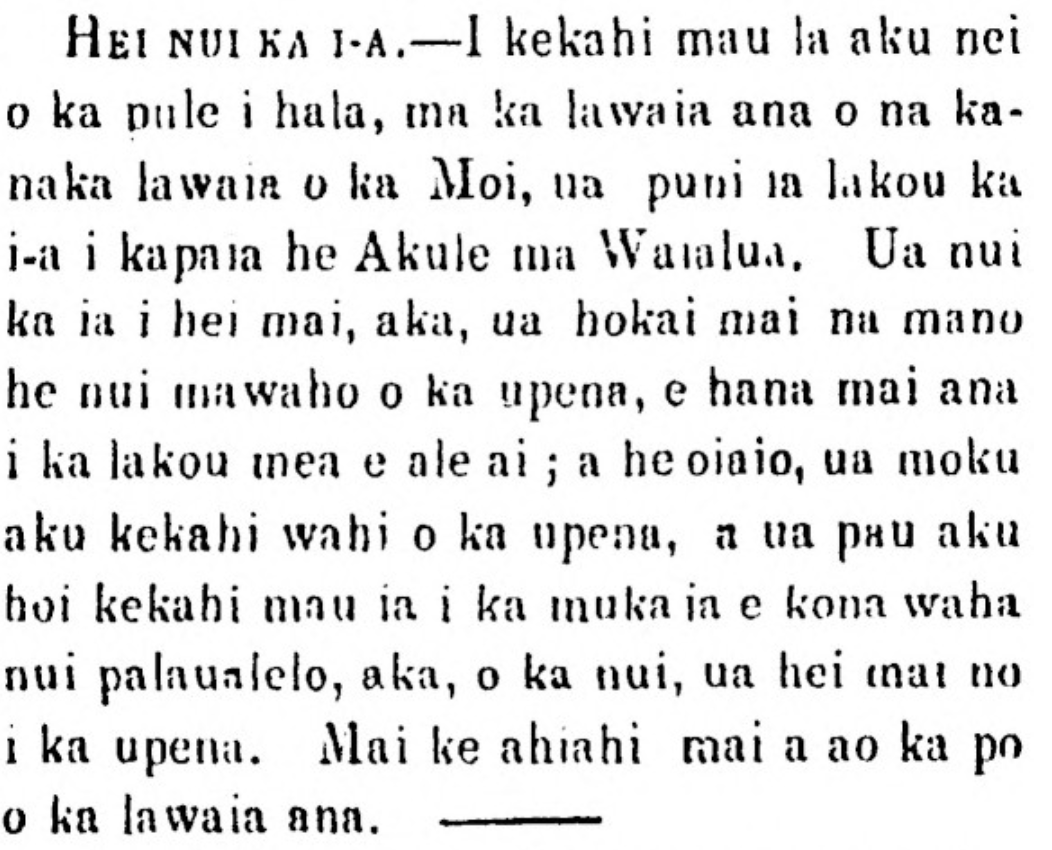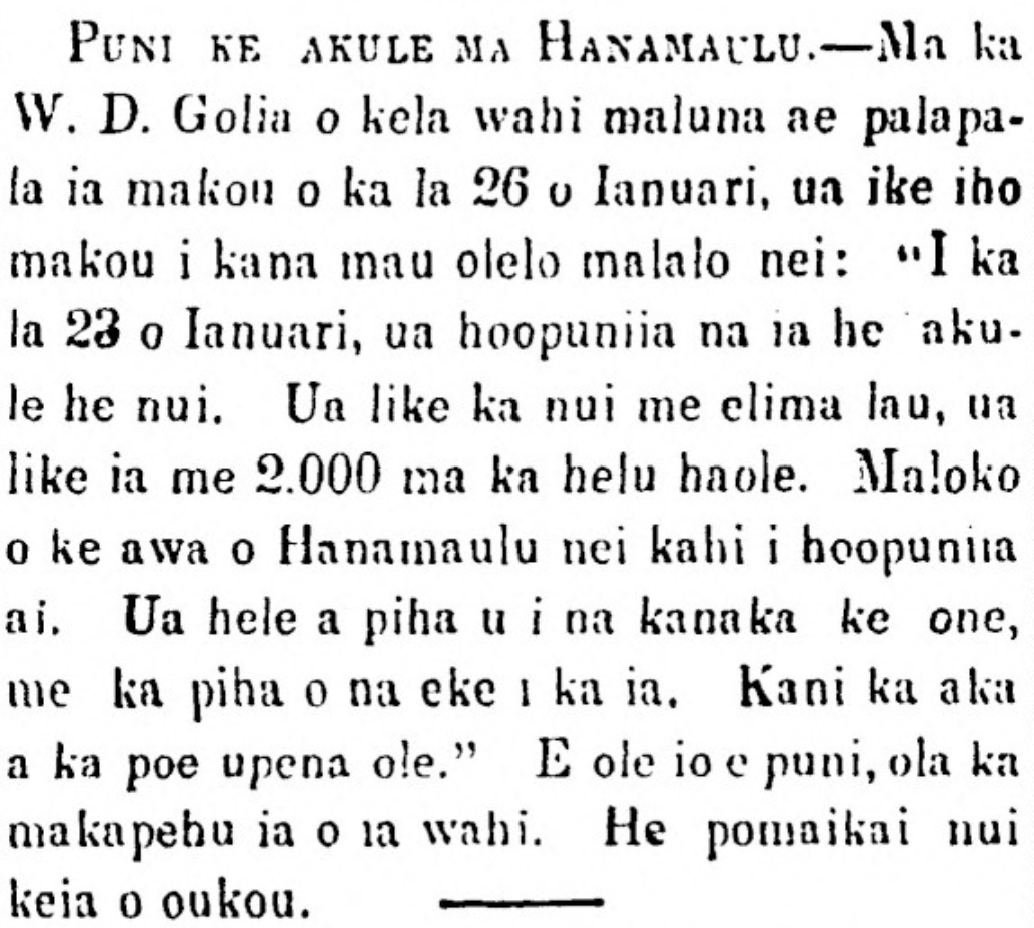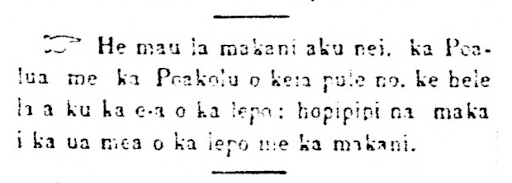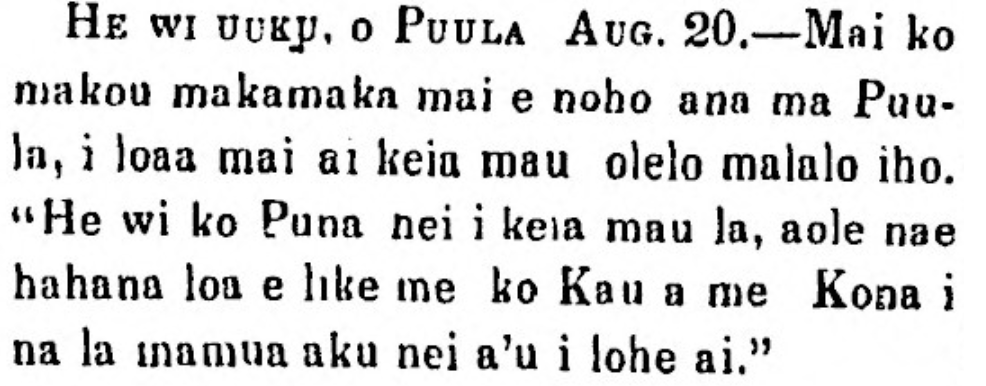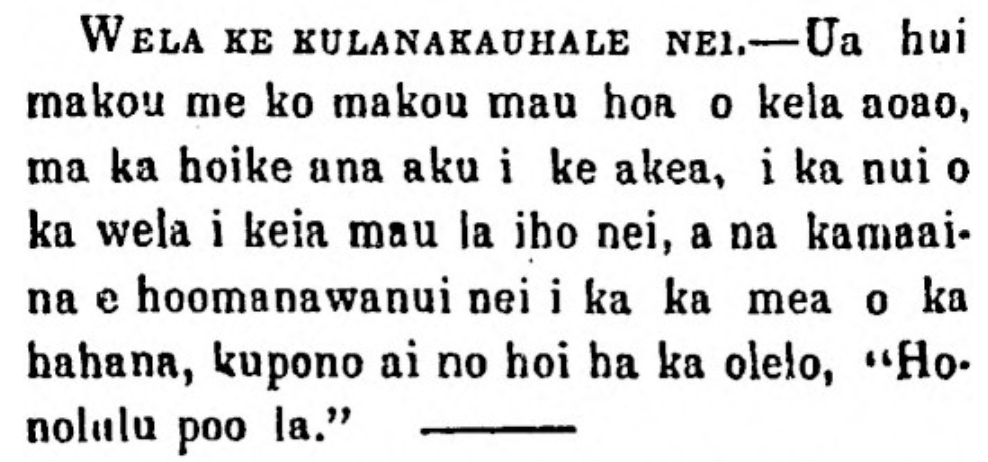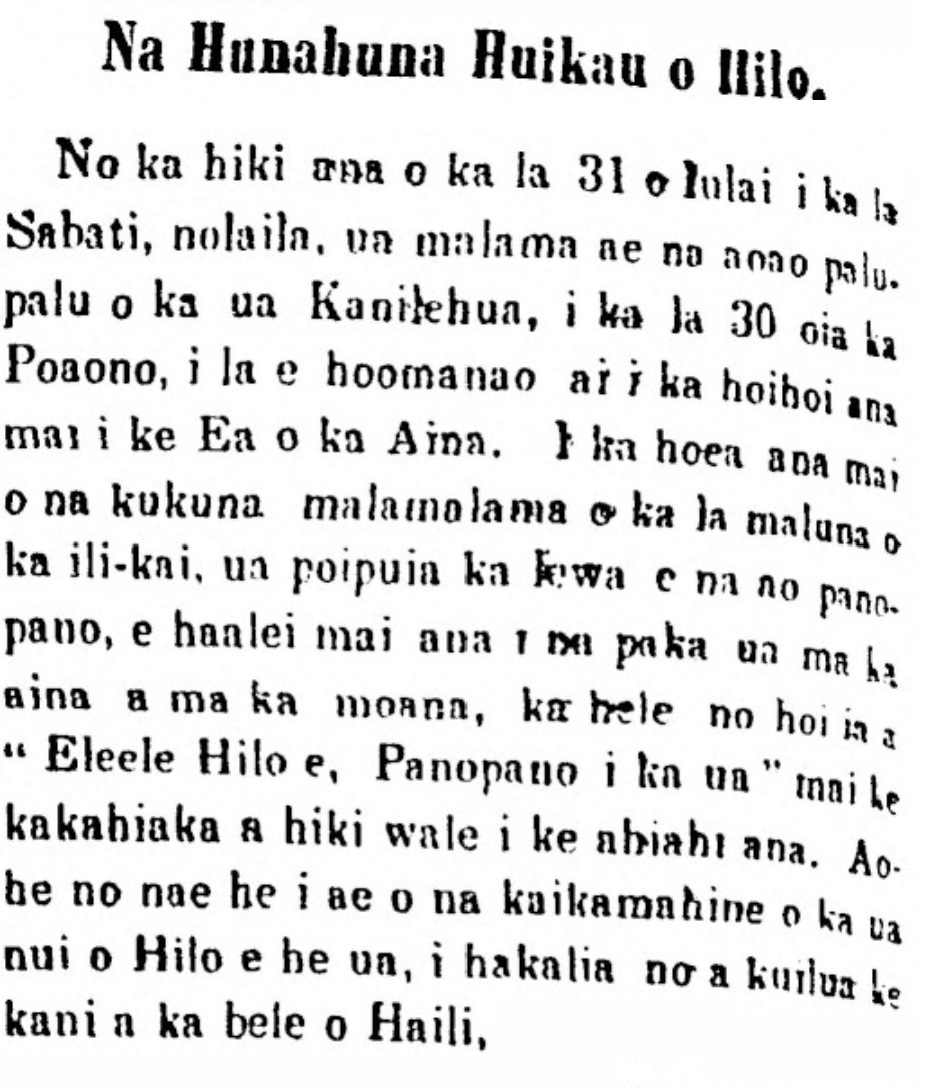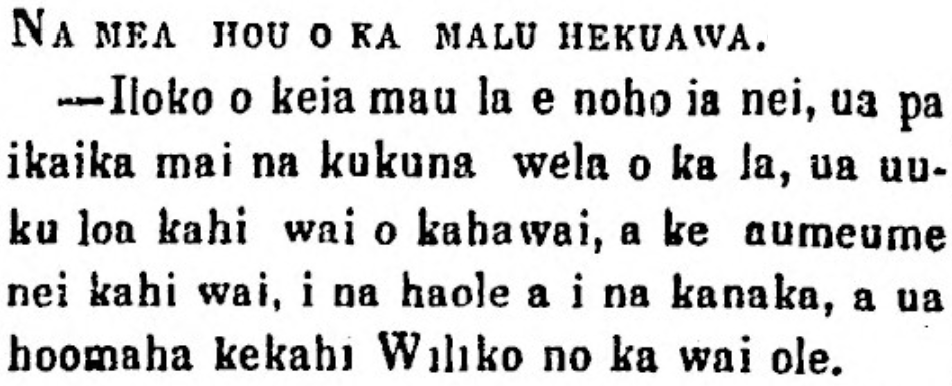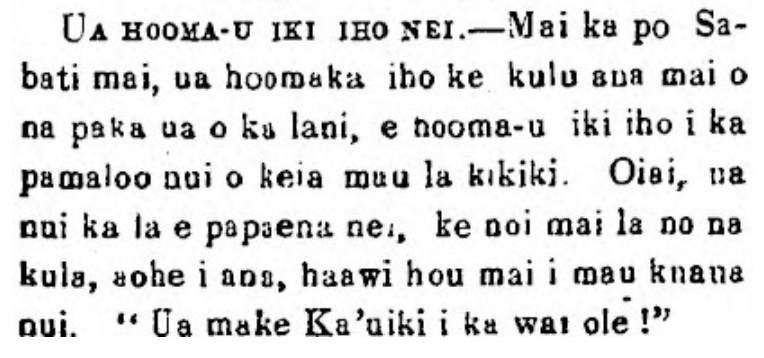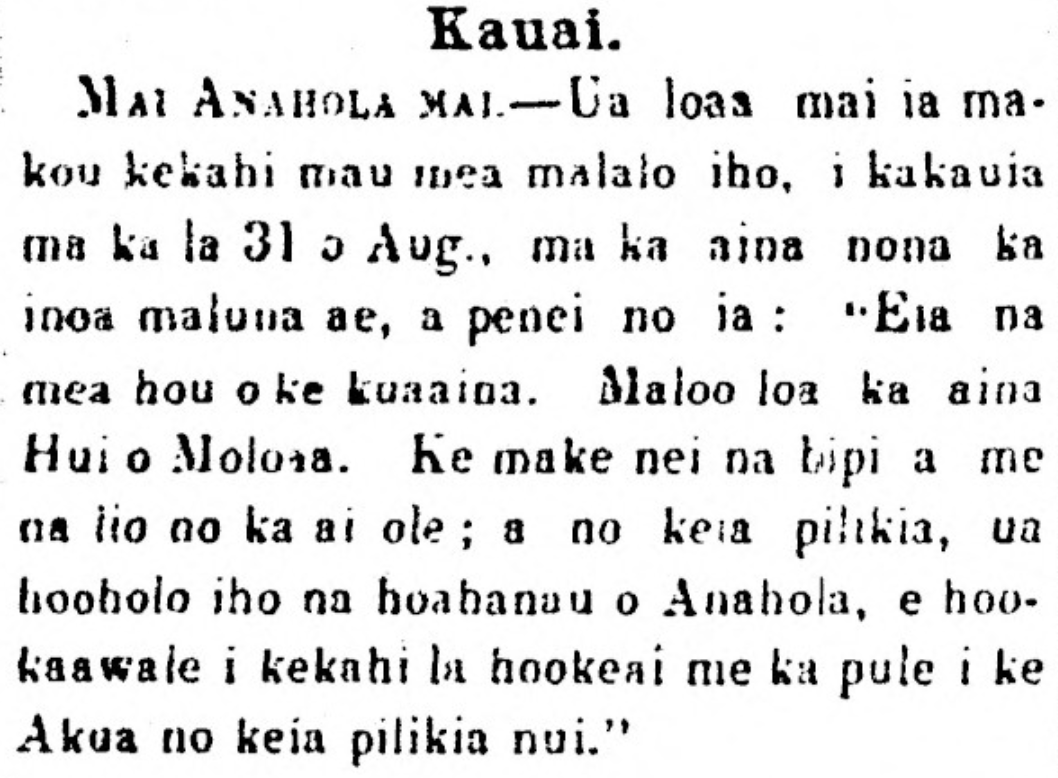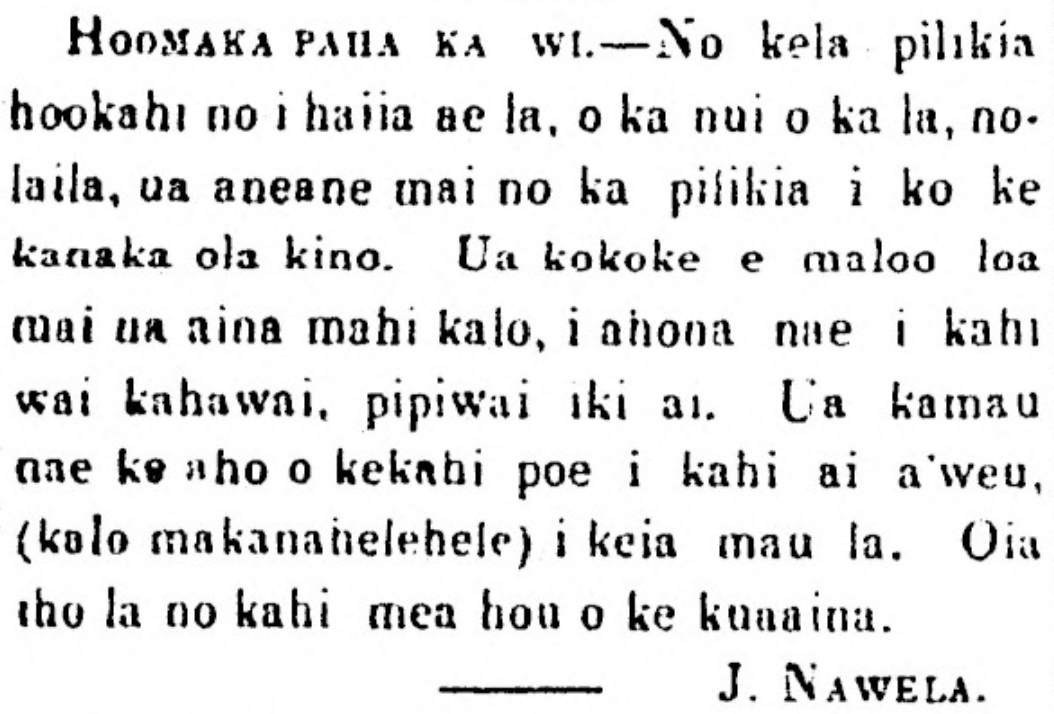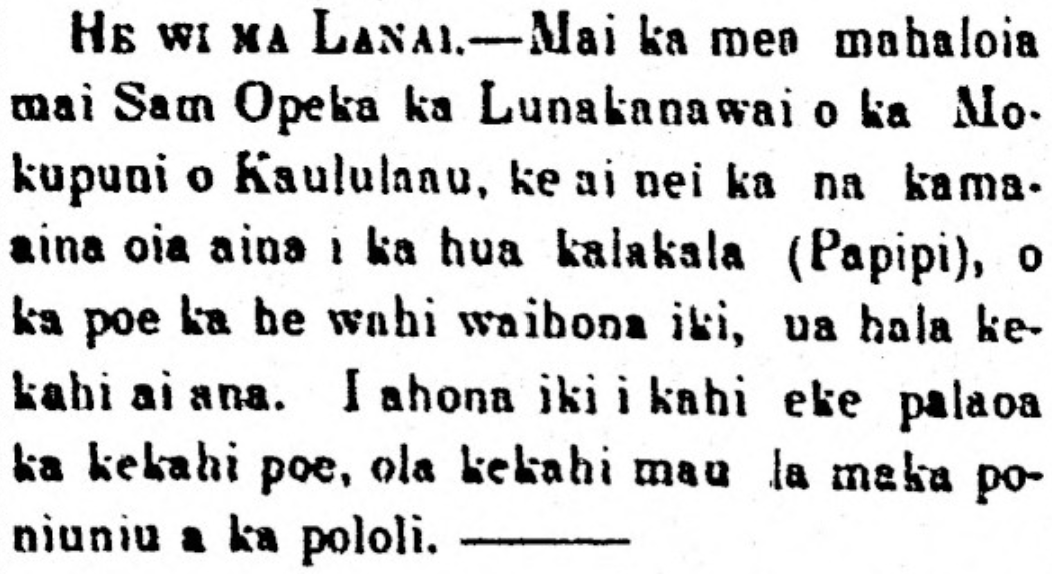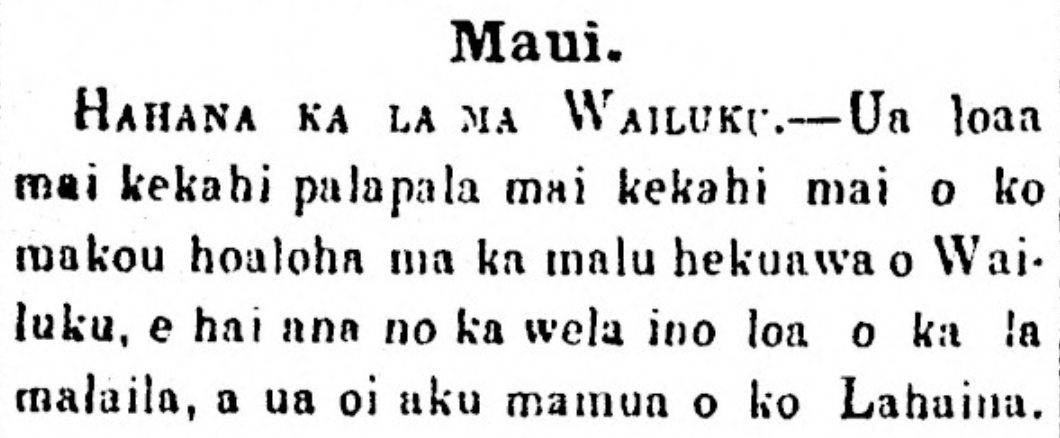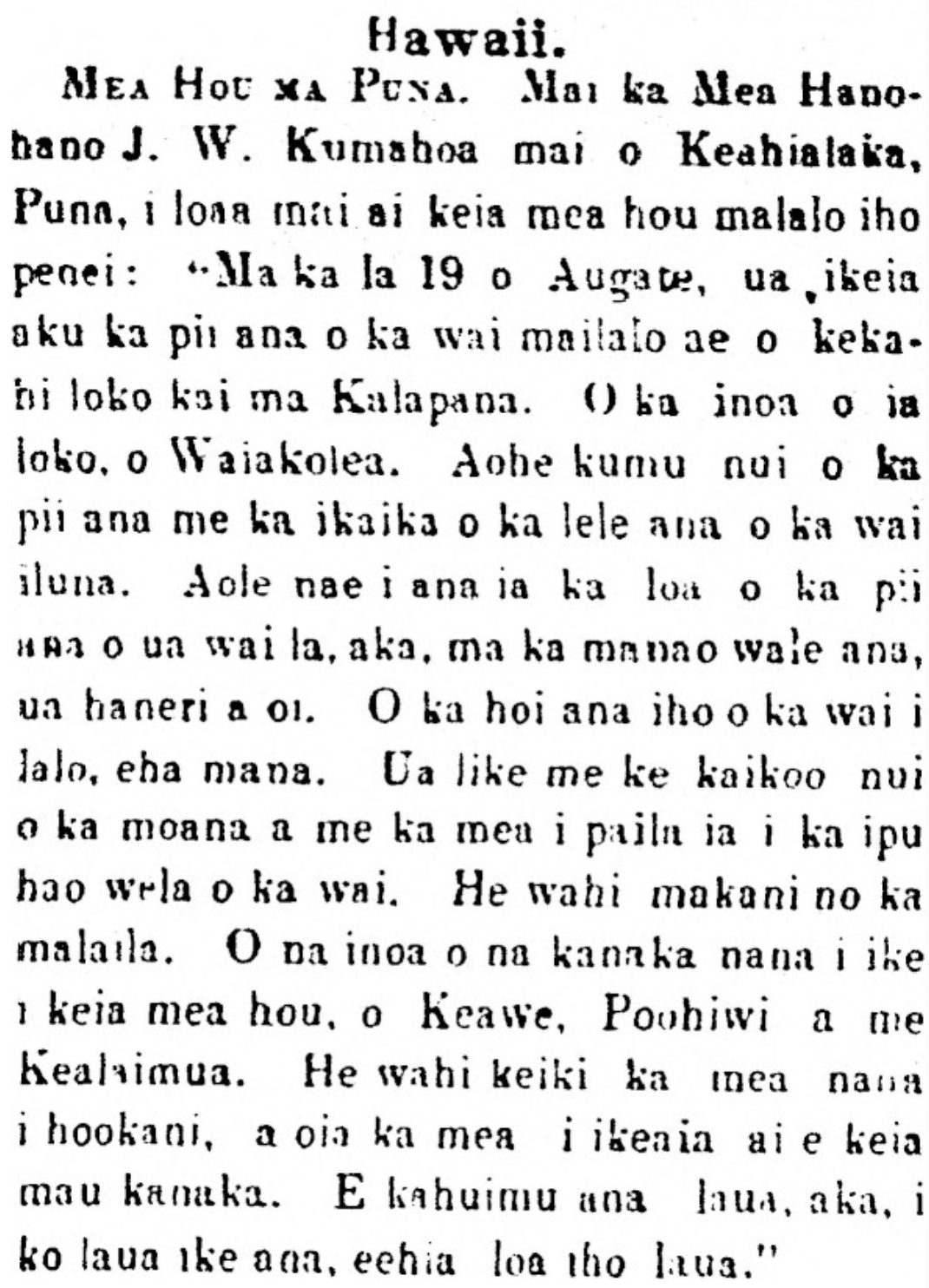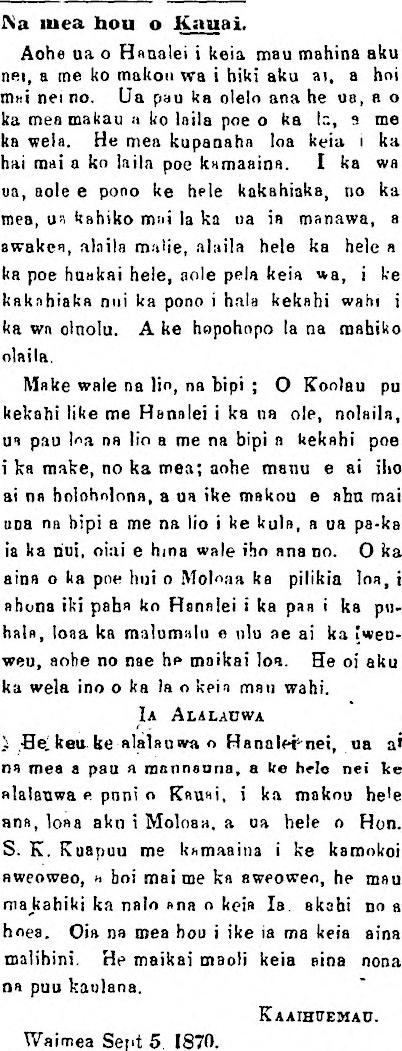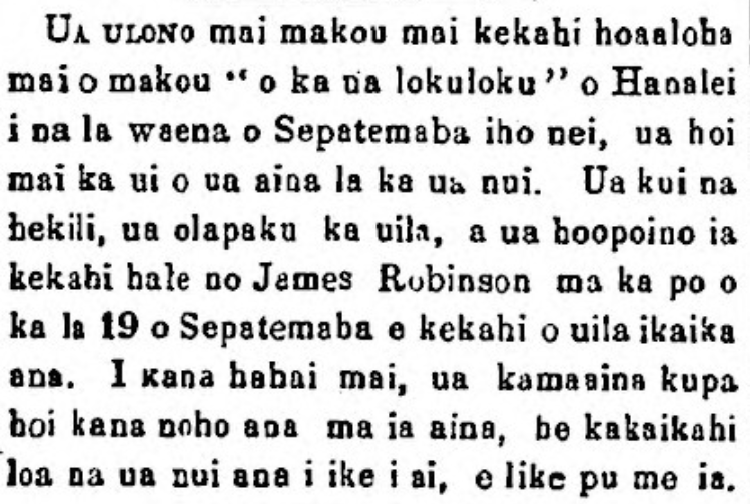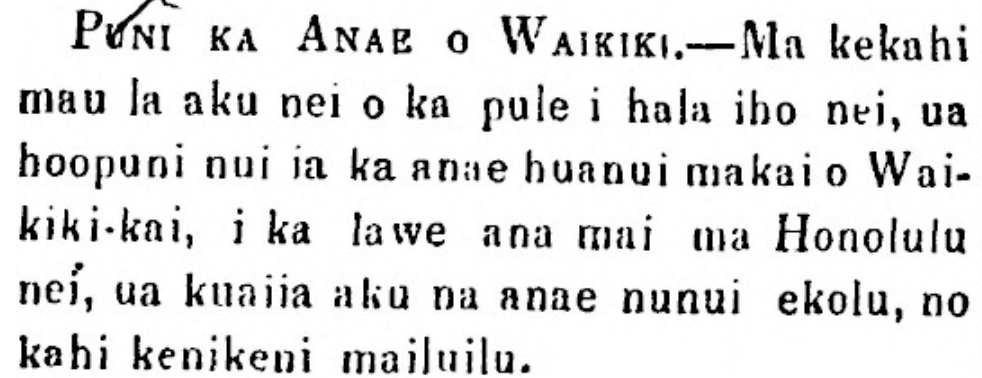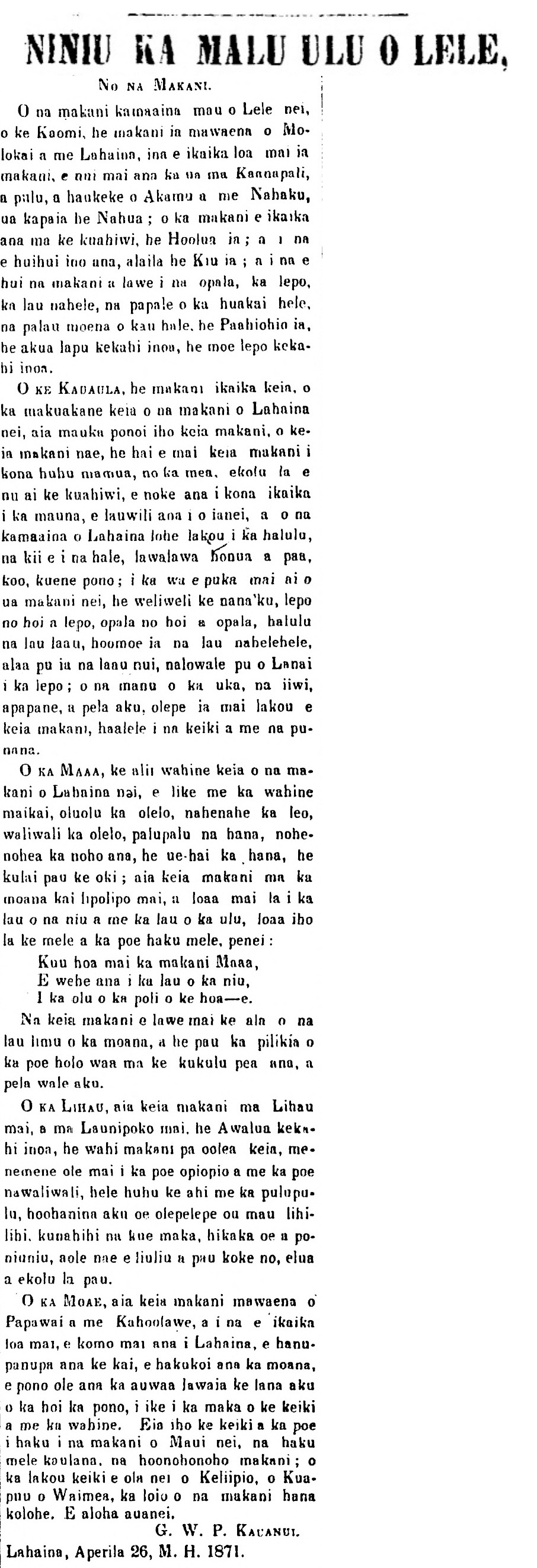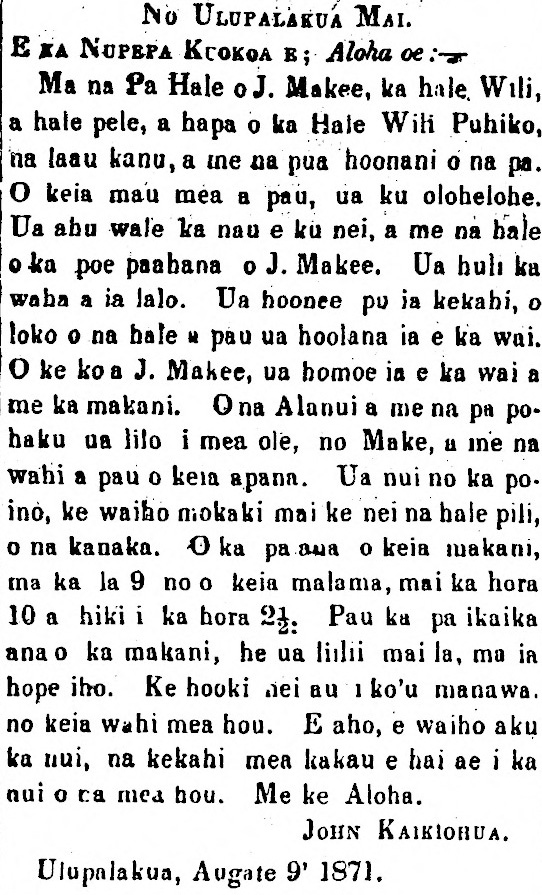| Na Naia Ma Kahana / The Dolphins at Kahana | Here is something surprising that took place here in Kahana on Friday, the 14th of December, 1837. I went to Ka‘a‘awa at 10 o‘clock. I stayed there until late afternoon, around 3 o‘clock. I was returning from Ka‘a‘awa until I reached Makaua. The men, women and children weren’t there. I asked, “Only a few old ladies are home? Where are all of your people?” “They have all gone down to look at the fish.” I inquired further, “What kind of fish?” They responded, “Dolphins.” Then my feet sped down to Pu‘uomahia where I watched the canoes, and all the people, grabbing at the dolphins in the ocean. Men, women and children were grabbing the dolphins; a strong man would get 12 dolphins, a weaker man, 8 dolphins, a very weak man, 4 dolphins, a strong woman, 6 dolphins, a weaker woman, 3 dolphins, and a very weak woman, 1 dolphin, a strong child, 4 dolphins, a weaker child, 2 dolphins, and a very weak child, 1 dolphin. Here is where they were grabbed: the snout, the dorsal fin, and the pectoral fins, those are the places where those very large fishes were grasped. Some were 7 feet long, some 6 feet in length, and up to 3 feet around at the widest point. Here is the count of these dolphins, there were 206 that were killed. The people ate the meat. Another benefit of these fish is oil. Pots, jars, and bamboo containers were filled, these are the lamps that we are currently burning. The people chopped the dolphins up until they were exhausted. Dogs came and ate, and pigs came and ate. The sea, the mouths of the 3 streams and the nearby open areas were filled with the stench. That is my description for everyone.
By me, NAILI.
Citation: 1838, Mar. 28. “Na Naia ma Kahana.” Ke Kumu Hawaii Vol. III, Num. 22, page 87. Retrieved from Papakilo Database. Translated by M. Puakea Nogelmeier. Institute of Hawaiian Language Research and Translation, 2015. Honolulu, HI: University of Hawaiʻi at Mānoa. | | 1 |
| No Ka Poe Lawaia / In Regards to Fisherman | From ancient times up until now, something like this may have never before been seen.
Because of the great consideration of His Highness L. Kamehameha, and his kind thoughts to bring blessings upon his people, he has stationed fishermen at Kaluako‘i. The skiffs are constantly filled with fish, snapping them up at the ʻUlakoheo fish market in a cacophony of gabble. Previously, Kaihuopala‘ai was the fishing ground that would always fill the stalls of ‘Ulakoheo, but, now Kaluako‘i is the place that brings in the parrotfish and the chub fish or pilot fish (Kyphosus bigibbus, K. vaigiensis). Most of the wanderers in town are now well-supplied with fish because of this fine idea of His Royal Highness. His Highness L. Kamehameha is to be admired for his thoughtful consideration.
W. N. PUALEWA. Kaliu, Honolulu.
Citation: 1861, Oct. 1. “No ka Poe Lawaia.” Ka Nupepa Kuokoa Vol. I, Num. 1, page 3. Retrieved from Papakilo Database. Translated by Manakō Tanaka and M. Puakea Nogelmeier. Institute of Hawaiian Language Research and Translation, 2015. Honolulu, HI: University of Hawaiʻi at Mānoa. | | 2 |
| Haole Lokomaikai / Good-Hearted Foreigner | This good-hearted foreigner, named Knudsen, has lived among us, his residence is at Waiawa. He has become an officer under the King, and he is charged with overseeing this area of Waimea.
I shall describe what I have witnessed of this foreigner's kindness when the fish reserved for the Konohiki, the big-eyed scad fish (Trachurops crumenophthalmus), is caught in the nets. If thirty-two thousand are caught, then it is divided such that the fishermen get sixteen thousand and the konohiki gets sixteen thousand. Of his sixteen thousand, all are given away to the people who show up there, the men, women and even the children and visitors. If the catch is greater, all are given out, and the same is true if the catch is less, all are given out with none left.
The old-timers here in Waimea are saying that the chiefs were not like that in the old days, for when they would distribute their fish, they would distribute them directly to their own people, not just giving them away to anyone else. That seems to have been the case up until now. It was not at all like the unmatched generosity of Kamehameha III’s officer.
I have heard that Kahiki‘ula and his wife, Hina, presided as chiefs over Waimea, along with their fishermen. These were their names: Kūkapalinu‘u, Kūkeuea, Aukeke, Kūlāuka, Kūlākai, Kamakapōhaku.
The fishermen of Kahiki‘ula and his wife would surround great numbers of fish with their nets, and the catch would be brought ashore at Keonepoko. Kamapua‘a made huge requests for fish from the fishermen, Kūkapalinu‘u and the others. This is how he asked: “Give me four hundred thousand, give me forty thousand, give me four thousand.” But he received not a single fish, and all the fishermen gave him were rude words. He asked in the same way of his parents, Kahiki‘ula and the others, but again, he got not a single fish. Perhaps his parents did not recognize him; that may be why he got no fish. The parents also gave him nothing but rude words. That was how we were denied fish up until now. This good-hearted foreigner who gives away fish is one of a kind.
J. W. KAPEHE. Waimea, Kauaʻi, Ian. 4, 1862.
J. W. Kapehe. 1862 Apr 5. “Haole Lokomaikai.” Ka Nupepa Kuokoa, Volume I, Num. 19, Page 3. Retrieved from Papakilo Database http://papakilodatabase.com. Translated by Manakō Tanaka and M. Puakea Nogelmeier. Institute of Hawaiian Language Research and Translation, 2015. Honolulu, HI: University of Hawaiʻi. | | 3 |
| Olelo Hoolaha / Public Notice | I am the one whose name appears below, and I publicly proclaim: the tuna has been declared the chosen fish of the Konohiki for Honomalino, Kona, Hawai‘i. Pertaining to entry within a mile, as outlined in the Civil Code, beginning on page 62 paragraph 387 and continuing on until the end of said law concerning the chosen fish of the Konohiki, therefore all persons fishing in these two Tuna Fishing Grounds, ‘Āinahou and Kamaua, are advised to remember the division of the catch between the fishermen and the Konohiki. I shall bring whosoever does not heed this restriction before the judge. To attest to the veracity of this statement above, I set my name:
D. W. KALUAIHALAWA.
Land Steward Honomalino Kai, Kona, Hawai‘i, Oct. 29, 1862.
Citation: 1862, Nov. 16. “Olelo Hoolaha.” Ka Nupepa Kuokoa Vol. I, Num. 51, page 3. Retrieved from Papakilo Database. Translated by Manakō Tanaka and M. Puakea Nogelmeier. Institute of Hawaiian Language Research and Translation, 2015. Honolulu, HI: University of Hawaiʻi at Mānoa. | | 4 |
| Na Mea Hou O Hawaii Nei / New Things of Hawaii | ‘Alalauā (Priacanthus alalaua) Fishing — The restless masses of the capitol are taking pleasant diversion these past moonlit nights in fishing for Priacanthus alalaua, seaward at ʻĀinahou and at other wharves as well. These places just mentioned are incredibly crowded with men, women, and people of every type, every night. Even the King and Queen were there last Tuesday evening.
Citation: 1863, Aug. 29. “Na Mea Hou o Hawaii Nei.” Ka Nupepa Kuokoa Vol. II, Num. 35, page 2. Retrieved from Papakilo Database. Translated by Paige Okamura and M. Puakea Nogelmeier. Institute of Hawaiian Language Research and Translation, 2017. Honolulu, HI: University of Hawaiʻi at Mānoa. | | 5 |
| No Na Waa Lawaia & Na Kanaka Ma Luna I Puhi Ia E Ka Makani / About Fishing Canoes and the People Onboard Who Were Blown By The Wind | On Friday night, the 9th of December, three canoes sailed off to go mackerel scad fishing, and at dawn the third canoe began to see fish. The people onboard this canoe were Hoʻonuʻu and Kauwahi, and the place where they saw the fish and also fished was outside of Kahea, Olowalu, Maui.
The second canoe had some elderly men on board named Naholowa‘a and Kamohomoho, and they were floating off of Keonepōhuehue; they did not see fish, they were just blown by the wind.
The first canoe had Nika and Keola on board, who had been floating off of Kāheka, and when they saw fish it might have been 6 AM on Saturday, December 10th, and at that time the wind blew directly at them from the shore. Nika said to Keola, "This wind is strange! Because I am a resident of this place and this is the first time I have experienced such a strong wind." Then, the wind reached full strength, and the violent swells of the ocean began to strike, and when they turned the prow of the canoe toward the shore, there was no way to get back there because of the force of the wind.
The wind blew far out to sea where there was no land. The float came loose from the outrigger, so Keola jumped into the sea to tie it on, but when he got back on the canoe it came loose again, so he jumped into the sea and secured the float, but the lashings of the canoe were all broken, so the canoe was useless. The nets were still there, so Keola cut them up and swam again in the sea to securely lash the outrigger. He immediately returned aboard the canoe, and became cold from the wind and the billows of the sea. Then Keola stood up and saw the Nāhi‘ena‘ena outside of Lāna‘i. Keola called the people on board the ship to come and get them, but those on board did not hear. It was the wind and the currents that took them to the Nāhi‘ena‘ena. They went aboard the ship with their fishing gear, nets and paddles from the canoe.
However, Nika still had one problem. After boarding the ship, he went below to lie down, being afflicted by the cold and illness. They had no clothes, for the clothes they had before were shredded by the sea, so they got clothes from the people on the ship.
Here is what they said: “Life is blessed by God.” And what about the other canoes, did they land, or not?
For Captain Helm (the captain of the Nāhi‘ena‘ena) was praised by everyone who understood this compassionate act, saving these people mentioned above, onboard the Nāhi‘ena‘ena.
Citation: 1865, Jan. 12. "No na Waa Lawaia & na Kanaka maluna i Puhiia e ka Makani." Ka Nupepa Kuokoa Vol. IV, Num. 2, page 4. Retrieved from Papakilo Database. Translated by Manakō Tanaka and M. Puakea Nogelmeier. Institute of Hawaiian Language Research and Translation. n.d. Honolulu, HI: University of Hawaiʻi at Mānoa. | | 6 |
| Ka Hoomana Kahiko, Helu 10 / Ancient Religion, Issue 10 | The gods of fishermen and the religious practices when going fishing. -- When looking at this topic there are two important items. 1. The gods of the fishermen. 2. The religious practices of going fishing.
1. Gods of the fishermen: Here they are, Kū‘ula, Hinapukuiʻa and their child, ‘Ai‘ai. – These are the gods that their attendants worship. According to some people of old, “These are gods of great power, able to bring fish in.” As for Kū‘ula, Hina, and their child, ‘Ai‘ai, they were actual people. However, Kū‘ula and his wife Hina were fisher-folk; they died and from them came the baby fishes. Their child, ‘Ai‘ai, still lives, here on land. When this child, ‘Ai‘ai, became hungry for fish, he wove a sturdy basket trap and walked to a point at the shore where he stood and said: “Kū‘ula is my father, Hina, my mother; big enough to fish, I remain a novice here in the world.” The mother said, “Hold back such noise, no more! Abide and marry the daughter of Keawekapilimanu, who controls Hawai‘i. The fishing tributes will come about, my lord.” Hina then said to her husband, “Look, we have but one descendant living in this world, and he is desperate for fish." "Perhaps we should give fish,” said Kū‘ula. Kū‘ula then spoke again, “Fish of what kind?” Hina answered again, “The wrasse fish because our son has a woven fish trap.” “Fill the fish trap until the wrasses overflow the brim.”– ‘Ai‘ai took the woven fish trap and placed it in a tide pool. The fish went into the trap until it was full. That is how ‘Ai‘ai got fish.
2. Religious practices for going to fish: Before one who is thinking to go fishing goes off, he commands everyone in the house to stay quiet and he goes on his way, while praying, perhaps silently within his heart or maybe by saying aloud: “Fishing gods, Kū‘ula in the night, ‘Ai‘ai in the night, and my own dear father, Kīlua, push away the night, emerge into day, I am Hua. Bring forth the fish, big fish, little fish,” and then he began to fish. If he is canoe fishing, the fishing hook, grant it to the point of our fish hook, to snag the gills, and snag the opening of the lip, snag the mouth, and snag the eye, no lack, no empty return, the need is for many fish, for our inland friends to eat, in order to trade with each other for taro, for banana, for kava, in order that you, O Deity, may be worshipped, so that the ceremonial food gourd of the gods may be filled with fish, enough for the gourd to become musty and smelly, O Kū, appropriate to you, O Kaneakilolohua; intense sanctity, intense freedom, amazing sustenance to allow the freeing of kapu, the restrictions are completely lifted.” At the end of the prayer, the line and the fish hook are released, set with bait. If the fish is snagged in the eye or the gill like what we saw in the prayer, then that person brags, speaking about the power of his gods.Here’s another thing, if the fisherman is fishing for octopus, this is how his prayer is when he is going to the octopus grounds: “The fish to the East, there are grounds there, octopus there, pūloa-octopus there, cuttlefish there, Christmas wrasse fish are there, sand dunes there, big-eyed scad are there, ‘mackerel scad are there, round herring are there, skipjack tuna are there, let them come in succession to this land of ours, O Kū, to be heaped in unwieldy mounds,” and that is how the prayers go throughout these islands, this being one prayer. – If there is net fishing, it is a sanction that nothing is eaten until the fish are encircled in the net, at which point the people of the house and the fishermen may eat. When the fish is caught one fish is held for the god, taken to the altar, and placed there. Another place to worship is a rock that is covered with white ‘oloa kapa. That is where to worship Kū‘ula and the other deities. – And that is how I was taught by the people of old. Perhaps now it is clear to us all by these explanations, if true.
Holokahiki.
Citation: 1865, Mar. 16. "Ka Hoomana Kahiko. Helu 10." Ka Nupepa Kuokoa Vol. IV, Num. 11, page 1. Retrieved from Papakilo Database. Translated by (?). Institute of Hawaiian Language Research and Translation. Translated by Manakō Tanaka and M. Puakea Nogelmeier. Honolulu, HI: University of Hawaiʻi at Mānoa. | | 7 |
| Ka Moolelo O Hawaii Nei, Helu 2 / The Story of This Land, Hawaii, Number 2 | Regarding Kahuoi.
On the north side of Kaumakapili Church, there is an altar for the aku lure of Kahuoi. This is a tuna lure of great renown. When this lure was revealed, the tuna would come into the canoe.
At a time before the harbor of Kou had ever been entered by ships, the skipjack and yellow-fin tuna would come in there.
Kahuoi was a great chief, a grandson of Kaha‘i, who planted the breadfruit grove of Kaha‘i at Pu‘uloa.
When Kahuoi sailed to Maui, and reached Holonokiu at Hāna, the tuna lure was lost.
This is how it was lost: Kahuoi reached there on his canoe. Puolokalina was fishing for uhu, and the thing he spat to calm and clear the surface of the water was niu, coconut meat, but he couldn’t see clearly beneath the surface. This one’s material that he spat out upon the water was kukui, candlenut. When he swept his paddle to spread the kukui out further, he could see the uhu entering the net. When he pulled up the net, uhu had been snared; that was the regular practice of Kahuoi. The man was delighted by the thing that allowed him to see.
The man asked him, “What are you using to see?” He answered, “It is this, candlenut.” Then he asked the other, “And what is yours?” That one replied, “Coconut.” “That doesn’t let you see much," (said Kahuoi). He gave the other a piece of candlenut. The man made a sweep with his paddle, spat out the candlenut, and the underwater area was completely visible. That really allows you to see! (It became what fishermen use to clear the waters surface until this day.)
Kahuoi said, “Your fish is one of aches because of bending, whereas here is a fish that comes with no pain – mine.” “What kind of fish are you talking about?” This one grabbed the bamboo, opened the cover of the tube, extracted the lure, and knotted it on the fishing line. The skipjack tuna were suddenly crowding about. The skipjack tuna leaped over both sides of the canoe until the canoe was filled; then this one hid the lure in the bamboo tube. He gave the tuna to the other man.
(To be continued.)
Citation: 1865, Jun. 22. "Ka Moolelo o Hawwaii Nei. Helu 2." Ka Nupepa Kuokoa Vol. IV, Num. 25, page 1. Retrieved from Papakilo Database. Translated by Manakō Tanaka and M. Puakea Nogelmeier. Institute of Hawaiian Language Research and Translation. n.d. Honolulu, HI: University of Hawaiʻi at Mānoa. | | 8 |
| Ka Moolelo o Hawaii Nei, Helu 3 / The Story of This Place, Hawaiʻi, Number 3 | About Touring the Famous Places, the Supernaturals and the Ancient Chiefs from Hawai‘i to Ni‘ihau
[Pertaining to Kahuoi]
That other man knew that this one had a very good way to get fish. That one coveted it, and sought a way to obtain it. That other man tangled the net on the coral head, and once it was stuck, lashed it to the end of the outrigger boom, then called to Kahuoi to dive to the net. While Kahuoi was diving down, the man jumped over into Kahuoi’s canoe, raced ashore, went into a cave and disappeared completely. Kahuoi came up to the surface and his canoe was not there. “This one is left standing outside of the yard of ‘Homa’ - disappointment, grasping at the tree of Kauhi‘ike - obscurity, and confounded to the point of Ho‘oleheleheki‘i - sullenness.” He came ashore, climbed up to the mountains and stayed on the mountain; he fought with Mai‘akuapu‘u, and the mountain banana patch was won by Kahuoi. (The mountain banana patch of Kahuoi still grows today; it is renowned for having flourished for 1,000 years or more of continuous growth.) Let us end his story.
Citation: 1865, Jun. 29. "Ka Moolelo o Hawaii Nei. Helu 3." Ka Nupepa Kuokoa Vol. IV, Num. 26, page 1. Retrieved from Papakilo Database. Translated by Manakō Tanaka and M. Puakea Nogelmeier. Institute of Hawaiian Language Research and Translation. n.d. Honolulu, HI: University of Hawaiʻi at Mānoa. | | 9 |
| He Puni Ia Nui Ma Hanapepe / A Large Catch of Fish At Hanapepe | DEAR "KA NUPEPA KUOKOA," GREETINGS TO YOU: — And to your Captain, please insert these little words of your friend into some free space in your body, which bears the title above.
On the 5th of November, G. B. Rowell surrounded one of the fishing grounds near Hanapēpē with nets. The kind of fish inside included kōkala, along with various other types of fish, good fish and bad, yet this fisherman did not toss back the bad ones, thus we have this bit of poetry: “The fish-craving uplanders grab at anything, stirring up a fire for fish.” He was a discerning fisherman before, but now, has become careless because of his craving, and he is greedily pursuing fish like this from this district all the way to Niʻihau. Not just the bad fish, but the good ones, are snared by this fisherman in his net until heads are rubbed raw and scales chafed off, yet he patiently keeps at it.
With gratitude,
S. Mahiole.
Hanapēpē, Kaua‘i, November 17, 1865.
Citation: 1865, Dec. 2. "He Puni Ia Nui ma Hanapepe." Ka Nupepa Kuokoa Vol. IV, Num. 48, page 2. Retrieved from Papakilo Database. Translated by Manakō Tanaka and M. Puakea Nogelmeier. Institute of Hawaiian Language Research and Translation. n.d. Honolulu, HI: University of Hawaiʻi at Mānoa. | | 10 |
| Ka Hoomana Kahiko, Helu 30 / Old Worship, Number 30 | [Remainder from Issue 48]
A MAKAHIKI GOD.
This is a circuiting god, called Lono by Hawaiians. For his frequent circuit every year, he is called Lonoikamakahiki. The form of this god is wood that is hollowed out, and placed on the top of it are the greens of the forest. Bird feathers are plaited over the timber until it is completely adorned, and it is set on the necks of the people who will transport it to every place of Hawai‘i. They walk until the boundary between two lands where the god stops and the commoners and the chiefs bring pig, taro, and every kind of thing and give tribute there.
The right side of this wooden god is sacred and the area to the left is free from restriction. If it is a man who goes on the right side, that man becomes the god’s own and the same goes for a woman; they will accompany the god, following it to every place the god will go and carrying it upon their shoulders. If a chicken, pig or dog enters the sacred side, these animals are consecrated for the god and seized as food for the people following the god. And because of the massive amounts of food and other presents given for the god, the boast of these people arose like this, “We can take our time as we encircle Hawai‘i, a big island."
THE SACREDNESS OF THE PROFESSIONS.
If the ancients were thinking to farm, there was a kapu for doing this. The kapu related to the farming god, Kūkeolomalu, and another name for him is Kūka‘ō‘ō. (This is a god that makes crops grow.) Kānepua‘a is the god who causes fruition on branches, mounded soil and for root crops. Prayer goes like this, “O Kānepua‘a, root about inland, root about toward the shore, root to the east, root in this garden of ours so to bear fruit in the mound, to bear fruit at the base, to bear fruit every where. Don’t root in someone else’s garden lest you be poked by the digging stick.”
CONCERNING FISHING PRACTICES.
This practice is sacred to the people who are training. If a person was going to fish, he commanded his wife like this, “Sit quietly. Make no mischief in our house. Don’t make mischief with others. Close up our house.” The man went to fish and if the fishing line was severed, that man would think the wife had misbehaved. Also, if the fish was lost, he would think the wife had cheated and would immediately return to beat his wife.
A person who crossed their hands behind their back was taboo, as no fish would be caught. If the fisherman saw this, he immediately returned home and didn’t go to fish.
When fishing for juvenile fishes, it isn’t right to exclaim when seeing the abundance of fish. This is very kapu and will certainly make the fish disappear, and definitely not enter the net. Instead, this is what should be said, “This is some dirt.” “This is truly trash.” And that is how Kū‘ula, the god of the fishermen, would say it.
CONCERNING BIRD CATCHING.
When the bird catcher would go into the mountains, the wife was extremely kapu and must not misbehave but should just sit quietly at the house. Any mischief of the wife could not be concealed, it was known by the manner of the birds’ actions. If the man thought his wife was misbehaving then he immediately returned, for his birds would not be caught or snared in the net. Kāneholopali is the god of the bird catchers and the people who hike in the mountains.
CONCERNING KAPA MAKING.
This practice is very sacred. It isn’t done out in the open, but requires a solitary place. Also, a stranger shouldn’t enter this work place of a woman making kapa so the door is propped closed with a stick. The reason for doing it like this is that the beaten kapa will tear, will not hold together, and the hands will be lazy. Lauhuki is the deity of the kapa beaters; La‘ahana is the deity of the printers; ‘Ehu is the deity of the dyers.
CONCERNING HOUSE BUILDING.
This was a very sacred profession in olden times. This is one way it went – they inserted some fish under the place where the pillar of the house would stand, but only on the eastern post. The fish that were placed were the āholehole or the kole. If the expert should peer in and inspect, any man who might incur misfortune would die. Another kapu is the impropriety of anyone climbing up and looking at the roof of the house while the expert is thatching the roof. This is a grave mistake. It would only be appropriate if the person climbed up with a thatch bundle. Another kapu is when the thatcher places the grass on the piko of the house (the navel, namely the place directly above the door). It should not be cut until the day that the house feast is held and then the piko of the house is severed. The reason for doing it like this is so that the person building the house won't become lazy or go off to do another house and so forth.
MEDICAL PRACTICE.
If one was thinking of learning medical practices, he will be very sacred – he must not be involved in any mischief until the ‘ailolo ceremony and that is when he is free [of kapu]. Going to see the sick person and gathering the plants is highly restricted; the work of an expert, only the sick and expert are there. Uli is the deity of those who practice sorcery and Kūwahailo is another. In all professions of Hawai‘i, they were only taught under kapu. Where did these practices come from? From ignorance, from simple fear, from a desire for evil and living in filth. This is the only reason for the different kapu. There are many other kapu remaining.
P.W. Kaawa.
Wailuku, Dec. 29, 1865.
Citation: 1865, Dec. 9. "Ka Hoomana Kahiko. Helu 30." Ka Nupepa Kuokoa Vol. IV, Num. 49, page 1. Retrieved from Papakilo Database. Translated by Manakō Tanaka and M. Puakea Nogelmeier. Institute of Hawaiian Language Research and Translation. n.d. Honolulu, HI: University of Hawaiʻi at Mānoa. | | 11 |
| Make Weliweli ma Kalihiwai, Kauai / Terrible Death at Kalihiwai, Kauai | A most terrible thing befell some weoweo fishermen at the shore by the cliff of Kapukamoi, Kalihi Kai, at 10 in the morning last Saturday, the 8th of September. There is a place where the sea narrows between the pāhoehoe and opens below the cliff. The length of this sea pool is perhaps 25 fathoms, nearly 3 fathoms wide, and the water in the pool is 4 or 5 fathoms deep. Many red fishes had gathered in that spot during those days, so many people went there to fish. On Friday, the 7th, an increasing number of people had come to fish there and to have a festive time under the slightly protruding cliff, and that outward angle of the cliff made a grotto at the base of the cliff. If the cliff had broken off that day, there would have been many people killed instantly, but such was not the intention of the creator of man.
And if it had collapsed at 8 on that Saturday, there were many people there at the time.
As the sun became hot, people left little by little, until at 10, there were just a few people remaining, sitting at the edge of that pool. Then suddenly the protruding cliff broke off at the eastern side of the pool, and the cliff completely collapsed. Flying rocks from the western edge of the break pummeled and tossed 7 of the fishermen into that deep pool amidst the flying rocks, and they disappeared. Three men there barely survived, but were injured by rocks, while a few people who were standing away from there escaped completely. Those who escaped were busy helping the wounded, while some people ran off to summon the people of the village of Kalihiwai, and there was a great upset among the people of that place. Wailing was soon heard from friends of those who had died! As we stood on the site of the amazing event, we were terrified. We said to ourselves, “Jehovah has come and displayed his might!”
One body was found that night. On Sunday and Monday, 5 more bodies were found, and one other was completely lost.
Here are the names of the deceased: Kukuiehu — a wood cutter from Opupahi.Pa‘akea and ‘Aimo‘o — Contract workers for Mr. Low.Kimo — A child from the English School at Wai‘oli.Kuaiki (m), Henry (m), and Ke‘alohi (f) from the English School of Kalihi. Here are the people who were injured.Momona, Kaho‘omana, and Mauwele. They are contract workers for Mr. Low.Here are the people who escaped because they were standing away at the time.Samuela (father of Kimo), Kamaka (m), Aukai (f), Akoni‘ia (f).This crumbling of the cliff face is amazing, for there had been no rain during those days to make the soil above the cliff soft and cause it to break apart. On consideration, it seems as though God allowed this terrible thing to happen there so that skeptical people would be made thoughtful. This is because Kalihiwai and Hanalei are renowned for the skepticism of the people, and it is said that the people fished at that pool on the previous Sundays. Perhaps because people ignore the word of God, thus this tragedy came about so that they would heed and consider.Foreigners are being summoned as well as Hawaiians these days. Because on Monday of that week a haole died, having been killed by a Hawaiian in Hanalei with his digging stick in the cane field. McIntyre was the name of the haole, an overseer for Hiram. If God allowed these tragedies to happen because of the haole people and the Hawaiians ignoring the commandments of Jehovah in the Bible, then they should heed this terrifying voice that is calling, and mind God’s will. This is what is right for all people hearing about this terrible thing, that they should think, and should heed this great voice that calls out, so that skepticism is ended, and so that each one may prepare to meet with his Maker.
E. J. Wai‘oli, September 11, 1866.
Citation: 1866, Sep. 22. “Make Weliweli Ma Kalihiwai.” Ka Nupepa Kuokoa Vol. V, Num. 38, page 3. Retrieved from Papakilo Database. Translated by Manakō Tanaka and M. Puakea Nogelmeier. Institute of Hawaiian Language Research and Translation. 2015. Honolulu, HI: University of Hawaiʻi at Mānoa. | | 12 |
| Hoomana I Ka Ia / Religious Practices Concerning Fish | To the best and foremost of the Hawaiian people; Greetings to you: Place these old things in your free space so that the young people living in our part of the world from Hawai‘i to Kaua‘i will see it.
They should know of the ignorant religious practices of the people of old at a time when the ancients prepared to go fishing. If fishing was to begin on a canoe, strict adherence to the taboo had been observed; in the evening the pig and chicken was put in the oven, they would sleep through the night, the pig and the chicken were then eaten; men and women ate. However, menstruating women did not eat; it was not pleasing to the fishing gods if one was unclean. When the feasting was proceeding well, the family gods took notice, and were drawn to the murmured prayer. The kalokalo is a mumbled prayer that is not clearly heard.
This is how the prayer goes, listing the names of every fish:
Family gods from east to west, to Kūlāuka, to Kūlākai, to Kū‘ula, to ‘Ai‘ai, to Hina,
to Hinapuku‘ai, and you shall eat, and I shall give Hāmākua of the ‘ūlili birds
Perching there on the cliff
The fisherman will puff and blow
Wanting, the parrot fish that does not shy away in the sea
The jagged-toothed eel
Appeal to the residents of the place
The mullet that pays attention shrinks away
The small flying fish lies in the water
The uouoa stays near the shore
The great octopus of Ha‘aluea
The sweet-eyed surgeonfish (Ctenochaetus strigosus) dwells in the cavern
Swimming about with the tattooed surgeonfish (Acanthurus triostegus)
The run of the wrasse
The large goatfish longs for the lehua
The red-skinned juvenile Christmas wrasse (Thalassoma fuscum)
The little blue snapper fish with long patience
I am a mudehen bird, to become a bonefish (Albula vulpes)
You are a reward for all things good
The orange-spine unicorn fish is chief
A juvenile bonito fish out at sea
The skipjack tuna with its ravaging dance
The undulating sweep of the mackerel scad
The flying fish that leaps the sea mounds
Arching low are his leaps
The crooked form of the small flying fish
And the ‘āiheihe fish as well
The sharp-beaked swordfish
The sharp-sided head of the tuna of Kalaʻe
One, two, the lure passes over the dorsal fin
Profound taboo, profound freedom of taboo
In the name of Nonohua, let it be free of taboo.
This is the fish prayer with which the people of old mistakenly worshiped, not knowing that Jehovah is the one who established the fish, being for mankind.
S.Z.E. KALAAUKUMUOLE.
Puaho‘owali, Lahaina, Nov. 6, 1866. [We did not intend to print this prayer to the family gods as a way to teach our youth this useless activity of our ancestors, since we all know the lifestyle of this time, which is not the same as the past. We are presenting this without pretense so that we may all know of the true foolishness of the prayers of our forebearers. EDITOR.]
Citation: 1866, Nov. 24. "Hoomana i ka Ia." Ka Nupepa Kuokoa Vol. V, Num. 47, page 4. Retrieved from Papakilo Database. Translated by (?). Institute of Hawaiian Language Research and Translation. n.d. Honolulu, HI: University of Hawaiʻi at Mānoa. | | 13 |
| Lawaia Mahiai a me Kalepa Hookahi No Ia Kino / Fishing Farming and Peddling Are One Body | (Written by J. K. Mokumaia)
(Continued)
So we appropriately return to the nature of Keoni Kaimi. I have known him the longest of the fisherman because from the year 1887 of our Lord I knew him up until this year 1925, his stamina is like that of the youth, sometimes octopus fishing, sometimes deep sea fishing, fishing for soldier-fish and goatfish, as well as kaʻiuhu when there was bait.
Therefore when important things of his life were taken, he survived in happiness.
Regarding lobster fishing, I am building up this expert about this kind of fishing because here in my thoughts is this gentleman,with his smile and kindness, that being the honored one of Kailua, Koʻolau, Oʻahu, Mr. K. Kawelo. This is probably the best of those I know at this type of fishing and here is how to do it.
There was continuous fishing every day and gathering good lobsters to sell, but the small lobsters are released. On Friday evenings they are brought upon horses and mules. There were many problems with the pathway in those days, the roads were poor however to keep up that kind of fishing the difficulty was no problem, and a call would still ring out at three in the morning.
"Are you all still sleeping?" When I awoke and saw him, he was always filled with joy, for this writer is a worker under the honorable Mr. S. K. Hamaia so it was my responsibility to be alert to the fisherman who came from far away.
When meeting with him and warmly shaking hands, the only thing he would say is “Here are 6 kaʻau [240] bundles.”
The nature of these 600 fine large lobsters and a bag of lobster, were to give to his family residing in town and friends. If that family and his friends are still alive please tells us of the thing you know of his nature.
Sometimes, he and his lady came to Kualaloa, in the rain and winds that rave in Nuʻuanu and nip at their cheeks. But these setbacks were nothing compared to their desire that their tiresome toils should make progress, along with their family.
The author has shaken hands with his chiefess. One type of fish they would bring was the threadfish that resides in the sea foam, the chub fish (Kyphosus bigibbus, K. vaigiensis), the surgeonfish, and the juvenille bonefish (Albula vulpes). The juvenille bonefish cannot be mistaken, it has white scales and its body has a nice shine to it. It is nicely plumped and when you prepare it right it smells like līpoa seaweed (Dictyopteris plagiogramma and D. australis), like a mistress on a cold night, because the spot you would catch these fish from was where the waves break at Oneawa, Kailua, Koʻolau, Oʻahu. All fish that are caught at these places are fat and fragrant when eaten. You can smell the surgeonfish, and also the chub fish, when its broth is made it is scented and fragrant.
So that is how the beautiful girls of that stretch are: fragrant when inhaled so that you crouch down upon the sand dunes of Oneawa. I remember those children at that beach where they would take delight.I crouch down outsideAnd you are in the roomThe 5 o’clock hour has struckOneawa is wide open to view. Please excuse the great digression outside of this sandy cape; those are not the only fish you will get. If it becomes the time when the baby fish come in, all the types of baby fish, it is a beautiful sight when they are poured out of the pandanus baskets. This is his favorite type of fishing when the two of them do it, then when the order is done, they return to fishing for juvenille ʻahuluhulu parrotfish, which is probably one of the most amazing types of fishing.
By doing it and thinking about it, it becomes something that exemplifies the skill of those days that have been referred to as inept ignorance, and in this enlightened period many laws have been made outlawing some of these fish so that you cannot get them, kill them, eat them or try to make a profit.
It was you, people of the Koʻolau area, who chose them to win while these dignitaries and lawmakers are not raw fish eaters such as juvenille fish and other small fishes that have been named haphazardly whenever the fish are seen in great numbers. When they grow larger there are babies, ʻahuluhulu parrotfish, that have been called stareye parrotfish (Calotomus sandvicensis, 2nd growth stage of parrotfish).
Therefore O masses, this is what I know from when I was taught how to sell fish by my caretaker. I learned that the juvenilles of the wrasse, triggerfish, surgeonfish, cigar wrasse, reef surgeonfish, parrotfish, and ornate wrasse has a different taste, and when it gets larger, it has a different taste. So I am writing these thoughts so that the public can see the truth of these remarks about these three areas.
So, these fish above are shown in millions if they school. Juvenilles are first gathered for money and for food, and when they reach the second growth stage, more money and food is gained. Then when they become adult red parrotfish or blue parrotfish, they become money and food as well.
Therefore reader, were the people of those days troubled as much as we have described in these past articles? There was no sign of these troubles and in this era of overwhelming enlightenment and quick work, in the blink of an eye your body is flexible to descend Maʻemaʻe and laws have been created that will end the fishing of juvenilles because within these types of fishing you will be troubled by the law and the people who we have elected. Even though these are people who were not born on the beloved soil that our elders watched over for your betterment, o people of Kailua and all around this island.
What about you, Maui, and how about you, Hawaiʻi? And Kauaʻi and Molokaʻi? This law stands to cease your eating of fish that have been passed down from the elders. This is literally unnoticed, it is said that we are Hawaiians who were born upon these islands but the tricky thing is not seeing the problem sitting right there upon the nose.
As we return to the nature of this fish known as ʻōhua juvenilles, many different fish come up within this family. Look to my friend who knew this type of fishing since I am not a fisherman but I am a peddler as I have said. From this fishing you would get juvenille reef surgeonfish, māʻiʻi fry, wrasse (Labridae) fry, wrasse (Cheilio inermis) fry, stareye parrotfish fry, blacktail wrasse (Thalassoma ballieui) fry, and many more. All sorts of fish fry because this family, they all come under the name "ʻōhua glistening in the calm."
So it cannot be avoided: If the net is set at Koʻokā and there is a great deal of seaweed, the juvenille fishes of Koʻokā will all be taken. The big question in those days comes from the many ʻōhua juvenilles, called by that name, and so all the fish were confused and when the reef surgeonfish grew large they came in many four hundreds. The big question in those days was are you done eating the juvenille reef surgeonfish? Because the law calls for 5 inches from one end to the other end and it is the same for the juvenille stareye parrotfish (second growth stage) which will also be banned. Pity upon our Hawaiian race, it was Hawaiians that have troubled us as we look at Mr. Kawelos work that he’s done for the masses and for his food. So this is probably the man who the author will take and place somewhere that you, as a Hawaiian, should be proud of because as for myself, I have witnessed it. If someone else has done it and he brings it forth, then please excuse my mistake in the reasons for supporting him, that all things be secured in his name.
So, o reader, in returning to the rightful position of these remarks, I must move entirely to the remaining things, the things that will do well so that you may see the veracity of these thoughts. However, I am going to show the things that the legislature has recently done with a few laws that trouble the fisherman but a few of my thoughts have come out, and they will come out again. While going about those seashores in those days, I return to my shore where I was seeded, until I could crawl, then walk and then became an adult.
It was common at our seashore to care for the cleanliness of the rivers and beaches. The things that were sought for money at this seashore in those days were crabs, the shrimp, the puhi manini, the juvenille mullet that were dried with ʻoʻolu seaweed, black crabs, and black seaweed (Enteromorpha prolifera) of the streams. These things, o reader, they were all clean; you were not met with surprise in those days. In these days it is scary, because there are two pipes spewing the winds of Laʻamaomao halfway across the harbor of Kalihi.
So it all clings to the wall, but when you think about those people in those days it was a truly clean living and this is how to acquire good things. The crab fishermen that the author knows are Nakeu, Kalaeloa, Pauaka, Hoopii, and Mr. I. If they were to work from Monday until Sunday morning, there are great amounts of rubbish crawling along, and here is how they have to work.
One canoe is boarded at two o’clock, and by six o’clock there is enough. They return to the fish trap they'll set up in the ocean and they arrange everything neatly. A bag is placed over it and weighed down with stones, and they let it down to the right area then leave it there alone, then at four o’clock they go and bring it ashore and the ocean water pours out, when that’s done then they would walk to the market at five thirty and place it on the table then ask for money.
Then they returned, having gotten some shellfish for bait, drinking a little coffee and when done, it was already in the morning hours. They returned on foot in those days, they worked the whole week to get sometimes seven dollars or less. It went up on Sunday. I became a helper to sell and in those days and it was done with ti leaf, no paper. You just watched how it was done by the people who knew how to do it, and that was what you did until you got it.
When I first began working, it took seven ti leaves for one bundle of crabs that were fighting and nipping. I’m remembering one lady who bought herself some crabs, and I created a proper bundle for her believing that it was nice and tight. The tragic thing was that she hadn’t gone ten feet when the crabs began to nip and move all around, then some spilled out from where it was trapped and it fell down then pinched her hand and as she groped to gather them there was a great cry for help, and I ran quickly, saying “Do not pull the crab from your hand or it will hurt terribly later, lower the crab to the ground.” As soon as she touched the ground it released its pincer because she had followed directions. When that happened I was challenged to become skilled, I tried hard to get better until I was victorious at it because if all the crab fisherman were gone on the Sunday morning, some of us had to become helpers so I helped with that task. One really had to be energetic and once accustomed. I would hold one crab and then take it and grab another until it was enough for a quarter, speedily working until my caretaker took me with him to learn how to be a peddler, and his wishes were fulfilled.
The shrimp brought in a lot of money, because it is bait for nights when the akule bite. So you will see, o reader, all the good things that Moanalua had in those days. The juvenille mullet always schooled at its time to stop just outside of Mokuaeʻo. My dear reader this little island of Mokuaeʻo is a dear favorite name for King Kalākaua and his chiefly ranks, and his vacation home remains there today. When he wanted to sail to this humble island, he would bring many things with him, and when he saw problems faced by his attendants, he created a seawall from the bay of Kalihi to this humble island, so it was easy to go there at that time.
As we return to the topic of the mullet fry, they become known as "weke," and that was one source of monetary income in those days up until this time that I am writing. One thing you will probably not see again is the skewers of dried juvenille mullet.
Look close those of the Koʻolau areas from Kualoa moving on until you get to Kaʻaʻawa and the warm embrace of Kahana and Hauʻula, and the two birds of Lāʻie, and Kahuku the yellow bird that peers into Waialua, Kualakaʻi and Keahi, and Kumumauʻu and Mokuaeʻo and where the axle breaks at Moanalua; perhaps we will all find compassion and some benefit from the candidates for representatives and senators regarding the lack of appropriate thought about the troubles that will come upon you, o my blood and my flesh, because the people that we have honored, they are not [Hawaiian] people, so they do not see these problems. The reason is, O Oʻahu, they are not people who eat dried fish, like ʻoama fry and they don’t eat raw fish, like the baby ʻoama which has a different taste at the same time. The Heavenly Father sent the juvenille mullet to the shores so that it would be near you to get it and take it and it gives you money so you can get some coffee, sugar, and poi. Then when it gets big and becomes a weke it will reside in the dark depths of the ocean and a one-finger or two-finger-mesh net will catch it. It appears that most of the law makers are Hawaiian, but the thing is that they are prone to fighting about the mesh size of the net and not thinking about the well being of their own blood, which is the thing that brought them esteem and this famous saying of Lawyer Aluli, "alas for us!" So, at this foundation of Mokuaeʻo there are many good things at this sea. The octopus, the eel, manini, and they will probably meet trouble because the law stands at this time. One rather odd thing in those days was the ʻalalaauā and the moiliʻi that is where they often stop, at that island of Mokuaeʻo in those days. The sad thing is that that fish has disappeared for those who fish for hahalalū and akule. (To Be Continued)
Citation: 1925, Jul. 27. "Lawaia Mahiai Ame Kalepa Hookahi No Ia Kino." Ka Nupepa Kuokoa Vol. LXIV, Num. 27, page 5. Retrieved from Papakilo Database. Translated by Manakō Tanaka. Institute of Hawaiian Language Research and Translation. n.d. Honolulu, HI: University of Hawaiʻi at Mānoa. | | 14 |
| Na Upena Lawai'a o ka Wa Kahiko a me Ka Lakou Hana Pakahi / The Fishing Nets Of Old And Their Uses | (Written by Z. P. K. Kawaikaumaiikamakaoka‘ōpua.)Net 1. ‘Āki‘iki‘i net, or also lu‘ulu‘u net are two names for this fishing net. Most fishermen probably do not know of this type of net; or there may not even be one who does. Therefore, subscribe to the Kuokoa so as to see how this net works!As for the nature of this net, it is similar to a basket trap for catching ʻōhua that is made with the ‘inalua vine, it is rather large in front, and then gets progressively smaller, it [seems to] blossom open.There is a little bag at the back end of this net, and in a suitable place as you will see. Once the mouth is established there, then it should be set up, for there are many places to set it, as it is only a small net. At the mouth of the net, at the bottom, two little rocks are placed so that the net doesn't move around, thus scattering the fish.You set up rocks on either side, just like on akule nets, deep sea fishing nets used on canoes and such. And when this is done, you should have already gone diving for sea urchins to be used as bait. This type of net is laid far shoreward in a shallow area.You crush up the sea urchin into small bits and pieces, and then take it and deposit it.At the place where the mouth of the net lays open, deposit the sea urchin there. Then, move aside a bit until you have distanced yourself slightly from the net so that you can clearly see the net. If there is a mound of rocks or perhaps a clump of coral, stand on it. The sea should not be deep; indeed only a fathom or less. When you are standing there watching and you see fish entering the net to eat the sea urchin which you have crushed, then dive in.When you dive in, then all of the fish will be drawn into the net, and they will remain there in the bag. Not a single fish will escape, because both sides of the net are secured by the rocks. And as for the fish that enter into this type of net, they are all good fish: weke, pānuhunuhu, pākole, halahala, and moano. Fish of poor quality do not enter this type of net.When this is finished, return once again to where you first stood, deposit more sea urchin, and then return to where you stood on the mound of rocks, watch, and when they enter, dive in again. It is up to you when to cease this activity. Whenever you feel that you have quite enough fish, then stop diving. Such is the reason this net is named an ‘āki‘iki‘i, or dip net, and a lu‘ulu‘u, or dive net.This type of net is used by people who go upland to farm and, when evening falls, fetch their nets and head off. They don't say to anyone, “let‘s go fishing.”This is a net to be used anytime one desires, and just one person is sufficient. It is unlike other nets which can be very tedious, requiring two, three, or even four [people] to catch fish. It is your writer's opinion that if this type of net is used in a spot where fish are plentiful, there will be no lack of fish. The sea urchin is the most important thing, and once it is gotten, you may go and set the net. And then you nimbly climb up onto a rock mound or coral clump to squat.Say, do use this type of net of the people of old! This ancient net has completely disappeared, unused because the people of today don‘t have any knowledge of it.(To be continued.)
Citation: Z. P. K. Kawaikaumaiikamakaoka’ōpua. 1923, Feb 22. “Nā ‘Upena Lawai‘a o ka Wā Kahiko a me Kā Lākou Hana Pākahi.” Ka Nupepa Kuokoa, Volume LXII, Number 8, Page 4. Retrieved from Papakilo Database http://papakilodatabase.com. Translated by Manakō Tanaka and M. Puakea Nogelmeier. Institute of Hawaiian Language Research and Translation, 2015. Honolulu, HI: University of Hawaiʻi. | | 15 |
| Na Upena Like Ole O Ka Wa Kahiko A Me Ka Lakou Hana / The Fishing Nets Of Old And Their Uses | (Written by Z. P. K. Kawaikaumaiikamakaoka‘ōpua.)(Continued.)Our ‘āki‘iki‘i or lu‘ulu‘u net has been covered. Let us now move on to the second net; this is the uluulu net, a scoop net with two parallel sticks for a frame. This net is for shallow seas. Here is a love song written for this type of net, and it is truly beautiful when danced to.I have a big fish,That is held fast at the tail,I go to grasp it,As it sinks down,This fish is a venturesome one,That lives in the reef,The watchman calls out,To open the net,And the fish is ensnared,Like a crab with a missing claw,There are two of us there,In that scoop net,It is an akule fish,That inhabits the ocean depths,And it is a moi fish,That inhabits the sea foam,The ‘Ōhiki crab is the fish,Digging in the sand,The story is told,Of the scoop net.As for the uluulu net, it is kind of similar to the holoholo net, a net into which fish run after being frightened. Two sticks are used, one on either side, and a line is attached near the end of each stick. This is the same line at the front end of the net that secures the sticks to it.This is the easiest net to use and one person is quite enough to manage it, seeing as it is a net for shallow waters and is one often kept by farmers. This type of net is also accompanied with the jabbing of coconut fronds into reef crevices, the coconut fronds are called pula.It is because of this pula being thrust into reef crevices that this net is named the uluulu, or agitated net. If you are in fishing ground, and there is a hole that goes straight through one side of the rock to the other, then two people are needed. The pula thruster should stand over there on the far side of the rock, and the man with the net should stand here on this side. Only good fish are ensnared in this type of net. The weke, kūmū, ʻāhuluhulu, moana, pākolekole and many other fish are caught in this net.To use the ‘āki‘iki‘i net, you must go diving for sea urchins, but as for this net, that is not the case. All you have to do with this net is grab it and go fishing. The actual fishing depth though is the same as that with the ‘āki‘iki‘i net; the water should be one fathom or less in depth, for one shouldn't fish alone in extremely deep waters.If there are two people in your company, however, than you can move off a bit to a deeper part of the ocean.In the old days, these were very common nets that were kept by many, and yet in these modern times, these nets are not seen at all.The ku‘u, gill or set net: This is perhaps the greatest and most commonly known net in all lands. This net is quite similar to those aforementioned nets that are set in shallow waters. For those first two nets, one man is sufficient.This net, however, is dependent on having many people to drive the fish, and these people are called kāpeku or splashers. The people of old didn't do things in the same way that we do them now. For example, today the first thing we do is attach sinkers onto the net, but that is not how the people of old did it.It was not until they went fishing that they attached the rock sinkers, held by lines that were threaded through the meshes of the upper and lower edges of the net because this net does not require a whole lot of work to set up. One area that needs to be recognized and explained on this type of net is its very middle section. This spot was called the “poho” or depression. This area was firmly secured with stone sinkers that were spread a distance apart from each other.If there is between one fathom and one yard of net on either side of it, then the poho will be of adequate size and you can then place the stone sinkers there, setting them apart from each other. And then, the fish will run directly into the poho, where you have properly positioned the rocks.Each side was an ‘aukiʻi[ʻaukuʻu]. And on either side of these ‘auku‘u were lines attached to the top edge of the net, and these lines were called kāwelewele lines. These were lines by which the people releasing the net could use as a guide to move themselves along the net to the place where all the lines met.That was done to distance the fishermen from the net. There was no problem if the net was long enough. The net could be secured and managed with those lines. If one of your fellow fishermen is on the left, and one is on the right, then the man to the left should coil up his kāwelewele line in his left hand, and the man to the right should do the same.That is done so that the line doesn't get dragged and entangled on a rock or on the floats. So, it is necessary to be well accustomed to using these lines. When the net has been set, and the two people controlling the net with the lines command the kāpeku to start slapping the water, then those two men watch closely as the fish move into the net.If the kāpeku don't come real close to the net, then the fishermen must roll up the net with the fish inside and not wait until the fish have passed through the net or escaped. You see, that is the time when the fish jostle around and struggle strongly in the net. Now, if you have a good net, then the fish will get stuck in it, and that is that. But for some nets, the fish go into the net and then get free and escape.When the people of old were finished fishing with a ku‘u net, they threw the rock sinkers back and didn't save them. They would wait until they went fishing again to get more rocks.(To Be Continued.)
Citation: Z. P. K. Kawaikaumaiikamakaoka’ōpua. “Nā ʻUpena Lawaiʻa O Ka Wā Kahiko A Me Kā Lākou Hana Pākahi.” 1923, Mar 01. Ka Nupepa Kuokoa, Volume LXII, Number 9, Page 5. Retrieved from Papakilo Database http://papakilodatabase.com. Translated by Manakō Tanaka and M. Puakea Nogelmeier. Institute of Hawaiian Language Research and Translation, 2015. Honolulu, HI: University of Hawaiʻi. | | 16 |
| Na Upena Lawai'a O Ka Wa Kahiko Ame Ka Lakou Hana / Fishing Nets of Old and Their Uses | (Written by Z. P. K. Kawaikaumaiikamakaoka‘ōpua.)(Continued.)Our previous explanations have been of the ku‘u net. Now here is a general rule: if you are the last to arrive at a place where a net is being prepared, and you just stand there and watch everyone else doing the work, and you don't tend to the work yourself but cross your hands behind your back instead, you will be the cause of much cursing and reviling talk. You see, this stance is considered bad luck.That is the rule of the people of old. The old people get very angry at this. And if you sit and pick up some rocks and tie them to the net, not a single person will come and talk to you.There are two ways to lay the ku‘u nets, in the day and in the night. The ku‘u net for the day is very different to the one for the night. When using the daytime net, you will say, “let's go ku‘u net fishing;” but at night, the people of old won't say “let's go ku‘u net fishing.” Instead, they say, “tonight let's go swimming”, or,” let's go wandering about”. And when the old folks went during the night, they did not return inland until they had drifted ashore near their homes. They would remain in the sea, swimming, until they arrived at a place that was desirous to land and go ashore.The man holding onto the fish would have a long line measuring seven fathoms, and the fish would be strung onto it; that is the bag where the fish would be left. You see, no little fish are caught when fishing at night time, only large fish such as the palani, nenue, mū, and all kinds of other large fish.The only thing this man had to do was to pull along this line with the fish all the way to shore. The people of old were not afraid of sharks; they were no big deal to them. That was the third fishing net for use in shallow seas. Now the fourth net is the ula, or spiny lobster, net. This type of net, used by the people of old, is a short net, not a very tall one like the other nets. It is between an iwilei, [length from fingertip to mid-collarbone], or a muku, [length from fingertip to opposite elbow]. The mesh size is a fingers’ width, and this type of net is placed aboard a canoe to be taken out and released. This type of net is lowered in reefed-in areas that aren't too deep.Similar to the ku‘u net, rocks are secured to the bottom edge of the net and are placed far apart from each other, with the very large rocks located only at the corners of the bottom edge. Also, there are kāwelewele lines at the end of the top edge of the net securing the buoy sticks.The purpose of these lines is to maintain the tautness of that net, so that it stands up properly. If there are a great number of lobsters there, they will all be caught in this net. This net is one that requires little effort. Take it out and set it up at night, and when daylight comes, go and pull it up. One man is quite enough to manage this net. (To Be Continued.)
Citation: Z. P. K. Kawaikaumaiikamakaoka’ōpua. 1923, Mar 8. “Nā ‘Upena Lawai‘a o ka Wā Kahiko a me Kā Lākou Hana Pākahi.” Ka Nupepa Kuokoa, Volume LXII, Number 10, Page 3. Retrieved from Papakilo Database http://papakilodatabase.com. Translated by Manakō Tanaka and M. Puakea Nogelmeier. Institute of Hawaiian Language Research and Translation, 2015. Honolulu, HI: University of Hawaiʻi. | | 17 |
| Na Upena Lawai'a O Ka Wa Kahiko Me Ka Lakou Mau Hana / The Fishing Nets of Old and Their Uses | (Written by Z. P. K. Kawaikaumaiikamakaoka‘ōpua.)(Continued.)As for the Poupou [short, stocky] net. This type of net is for all kinds of fish, except for those big fish like the nenue, and the uhu for which different nets are used. However, all of the various kinds of smaller fish are caught in this net. If the manini is the fish you desire, then go early in the morning to dive for hālula sea urchin because that is the bait for all of the fish caught in this net.When you dive for the hālula, dive with a long stick to stab the hālula, and in front of the hand that's holding the stick, you should use cross-shaped sticks as guards so that the hālula cannot slide up the stick and prick your hand. You should get between five to seven hālula stabbed on your stick, and that will be enough bait so that you will not run out. Then take [that bait] back to a spot where the manini constantly run, and lower the net. The manini will run straight into the net, and then pull it up and the manini will be caught.If there are four or five manini, then use one line for each of these fish and tie them to the mesh of the net, above the pōhaku mole, the anchor stone, which I have previously explainedAnd once these fish have all been secured to the net, then lower it in an area for the poupou net, that is, where you commonly set the net. If there are multitudes [unreadable] there, then not one of them will be spared. It is because of those fish tied to the net as decoys, wiggling here and there, that the other fish outside are attracted into the net.If all of the fish in this poupou area are gone, then go to another spot. And if those first decoy fish have become too limp, then replace them with new ones. And draw in the net in a spot that it is normally lowered, this spot is termed an au. Men who always fish for manini don't go inland to farm, because the fish is his garden to weed, and to plant, and to grow, and cover with a layer of grass or cover with a layer of wetness. Fishermen get lots of taro. That is the only endeavor of these people all year. They must go every day [to tend to their food]. For the people of ancient times, they only stopped working when they became very weak and old.If the pōuouo [bag net with two-finger mesh] fisherman desires pānuhunuhu to be their catch, then go diving for hālula in the early morning, because this is the time when there are plenty of fish. Then, when you have gotten the hālula, strike it with a stick until it is crushed, and then put it inside the net and lower the net in an area for pōuouo nets where you know this fish can be found in large numbers.When you lower the net, look carefully at all of the different kinds of fish. And look for the fish that you desire, namely the pānuhunuhu. When you see that it has entered the net, then pull it up. Then use a decoy line; on this decoy line, there is a spike that pierces the mouth of the fish, and like what is done with the manini fish, the same is done with all types of fish. Then the pānuhunuhu is secured to the net.If there is only one fish that entered the net, pull it up. If, perhaps, there are four pānuhunuhu, pull up the net. And you proceed thus, over and over again. When you see that all the fish in that area are gone, move to a different fishing spot. When you decide that you have enough of that type of fish, use a different fish as a decoy since there are many different kinds of fish that will enter into this net. On the ends of some sticks of ‘ūlei wood, two rocks are fastened. These dense, smooth basalt stones are carefully sought, and they must have holes in which you can thread a line and tie the rocks securely.Bind them to the ends of the ‘ūlei sticks, one on each end. The most ferocious among these little fishes is the halahala fish. Vigilantly watch out for this species of fish, for it will run into the net to kill the fish that is being used as a decoy.When you see [the halahala] nearing the ‘ūlei sticks, and the head enters [the net], you must pull it up immediately lest it get the decoy fish. This is because he will be unable to get out of the net, since the net slackens when it is pulled up.Take the net to be released in the the fishing spot, which is where to lower the net. When you have lowered the net and left it down in the water, all kinds of fish will swarm around, however, when this kind of fish sees that this is their companion, they will quickly enter into the net. When they enter the net, pull it up. You cannot wait until there are many fish inside the net to pull it up.Some of these types of nets were used by the old people along with fish baskets that were affixed to floaters in the ocean. If while lowering the net, one caught a ‘ōpule or a moano, then the person manning the pōuouo net would take these fish and put them into the fish basket, since these fish were an easy catch.Then you won't be spending the early morning diving for hālula. You just take the fish you want to use as decoy. If the ‘ōpule fish is what you want to use as a decoy, then pierce the lip securely with the spike and the decoy thread, then take the fish a little above the pōhaku mole, where you secure it to the mesh of the net. Then, take your net to a good spot where you can lower your net. (To Be Continued.)
Citation: Z. P. K. Kawaikaumaiikamakaoka’ōpua. 1923, Mar 22. “Nā ‘Upena Lawai‘a o ka Wā Kahiko a me Kā Lākou Hana Pākahi.” Ka Nupepa Kuokoa, Volume LXII, Number 12, Page 3. Retrieved from Papakilo Database http://papakilodatabase.com. Translated by Manakō Tanaka and M. Puakea Nogelmeier. Institute of Hawaiian Language Research and Translation, 2015. Honolulu, HI: University of Hawaiʻi. | | 18 |
| Na Upena Lawai'a O Ka Wa Kahiko Ame Ka Lakou Hana / The Fishing Nets of Old And Their Uses | (Written by Z. P. K. Kawaikaumaiikamakaoka‘ōpua.)(Continued.)The pā‘ou‘ou net. This is the best net to catch all sorts of fish in shallow waters. This type of net is a round net. There are four sticks made of ‘ūlei; this first ‘ūlei is laid out until it reaches a loop, then another ‘ūlei is attached; that is continued on until all of the ‘ūlei sticks have been inserted and then the net will be rounded.There are many cords, or hānai, for this kind of net; there are four, just like the ‘a‘ei net used for ‘ōpelu. On top of each of these hānai, the ropes used to pull the base of the net, there is a small, nicely shaped basalt stone of just the right size that already has a hole, and it is there that the rope is tied below the base of the net, which is then the place where you would fasten the decoy fish. On the sides of this pā‘ou‘ou net, there are some small bags. These small pockets were made to make the net puff out, so that it does not twist and stretch. If the person doing this wants ‘ōpule, then he has to find ‘ōpule [as a decoy] so they can be caught in his gill net.A basket to transport the decoy fish must first be prepared, and in the morning, the fisherman must be alert when going to where this net will be set, because if he is very lucky, this type of fish will be caught in his net. And if you do not get this kind of fish, then you have to go early in the morning and dive for wana, or sea urchin.This is a type of net that must be set in the very early morning. And when the wana is caught, you must pound it to a pulp, then it is put into the net, and the net is released into the fishing spot, or au. That is the way it is said by the elders: the place where you set the net is an au. (To Be Continued.)
Citation: Z. P. K. Kawaikaumaiikamakaoka’ōpua. 1923, Mar 29. “Nā ‘Upena Lawai‘a o ka Wā Kahiko a me Kā Lākou Hana Pākahi.” Ka Nupepa Kuokoa, Volume LXII, Number 13, Page 4. Retrieved from Papakilo Database http://papakilodatabase.com. Translated by Manakō Tanaka and M. Puakea Nogelmeier. Institute of Hawaiian Language Research and Translation, 2015. Honolulu, HI: University of Hawaiʻi. | | 19 |
| Na Upena Lawai'a O Ka Wa Kahiko Me Ka Lakou Hana Pakahi / The Fishing Nets Of Old And Their Individual Uses | (Written by Z. P. K. Kawaikaumaiikamakaoka‘ōpua.)(Continued.)This is fifth of the nets that the ancient people used, the ka‘i uhu net. All of these nets were known as designated nets. This is how the ka‘i uhu net is used:The wood that the ancient people got for this kind of net was a type of wood known as alahe‘e. There is one piece of wood on the north, and one on the south, and so on for the west and the east, the heads of the sticks are set up as a peak, and the rope ties all of the tips of the sticks together, [then] they are fastened tight. There are fine edging cords, or ‘alihi, at the bottom of these sticks attaching them to one another.The mesh of this uhu net measures three fingers' width, or three fingers and a finger tip. Dark cordage is the type used to make this net. Just below the heads of these four sticks, there are four stones, the same number of stones as sticks; the area within these fine ‘alihi cords was called an H. by the people of old, and attached to the heads of these sticks are the ropes to lift the net up and release it down into the good fishing spot, called an au.If you do not get a decoy uhu, then you must go diving for sea urchin. At the place you think is proper, you must crush urchins there, and continue to do so until morning light. Then the uhu will congregate there and you will have your ho‘oloulou hook ready.Just like casting for fish with a hook, the person casting has to carefully watch the uhu, not slacking the line, because this type of fish is not like other types of fish that pull directly away. This kind of fish is not like that; if it eats the bait, then it wishes to escape into the rocky pits, and if there is an opening in the rocks on the other side, then it will escape on that side. That is why this fish's taking of the bait has to be watched so carefully by the people with the ho‘oloulou hooks.If an uhu is caught, you place it in the basket that you set up with floaters and release it there. That basket is always attached to where you fastened it. There is a stone below, and a rope is tied and fastened to the base of the basket, with the floater above that you will attach to the basket. If you have caught an uhu, then only one thing remains: using the uhu you caught for pākali, a decoy line. This is how you do it:It is with a cord that you would set up this uhu as a decoy, several or perhaps many are bound to this cord, as per the desire of the uhu fisherman; if there are ten or more, that is enough. Making the pākali line is like making a snare to catch a chicken; they are exactly the same; the snare is larger, the pākali a bit smaller; these pākali lines are all attached to a long cord.All of the pākali lines used are made differently. The ones used vary in size from large to small, and smaller still, the reason being that they are made for fish that are smaller than the uhu, such as the halahala, pānuhunuhu, pākole, and lauia, and the decoys are prepared in advance. On top of these pākali lines there is a small floater.Just below the end of the rope there is a spike that has been fastened tight; the reason this spike is attached there is for the fish that is entering into the net, and that spike is prepared so it can be attached at the head of that pākali line. Grab it, holding the fish that will be used as a decoy, then take out the spike and put the cord through the eye of the spike. If the cord is too large, wrap it around the middle of the spike so that it does not come off.If you wrap it too short, the rope will come off of the spike. The way to poke the uhu with the spike is to thrust it through the cheek of the uhu and exit through the mouth along with the cord, bringing the end of the cord through loop, like a chicken snare or loop of sennit for catching ‘a‘ama, and pull the cord tight, then secure the cord that holds the decoys. Make certain it is secure so the fish do not escape.Out of all of these uhu, there are two types that are extremely aggressive, namely the uhu lāuli and the ‘a‘a kole; if these fish are seen, the person with the pākali line must take watchful care, lest these fish follow the line and bite the decoy uhu, which might be a pāhau uhu, a hiʻu kole uhu, or a keʻo.You let out the decoy uhu to attract this uhu lāuli or ‘a‘a kole. Once the ʻaʻa kole sees the decoy, you quickly pull the decoy in close to the canoe.If you do that two or three times, the aggression will subside; then you attach the decoy fish to the net, and you will have also fixed a cord at the base of the net.Subscribe to the Nupepa Kuokoa in order to know the works of the ancients!(To Be Continued.)
Citation: Z. P. K. Kawaikaumaiikamakaoka’ōpua. 1923, Apr 05. “Nā ‘Upena Lawai‘a o ka Wā Kahiko a me Kā Lākou Hana Pākahi.” Ka Nupepa Kuokoa, Volume LXII, Number 14, Page 6. Retrieved from Papakilo Database http://papakilodatabase.com. Translated by Manakō Tanaka and M. Puakea Nogelmeier. Institute of Hawaiian Language Research and Translation, 2015. Honolulu, HI: University of Hawaiʻi. | | 20 |
| Na Upena Lawai'a O Ka Wa Kahiko Me Ka Lakou Mau Hana / The Fishing Nets Of Old And Their Uses | (Written by Z. P. K. Kawaikaumaiikamakaoka‘ōpua.)(Continued.)When that uhu is coming closer to the edge of the net, that is when the person fishing for uhu must be extremely alert to that uhu ‘a‘a kole, lest it swim wildly into the net where the decoy fish is attached and bite it, making its scales fall off, and tearing up the decoy's body.It would mean the uhu fishing would be useless, because these two types of uhu, lāuli and ‘a‘a kole, are the most aggressive of the parrotfish. When the fisherman sees that the fish has entered the edge of the net, that area around the edge called an H., then you should quickly pull up the net and grab it; you should not wait until the fish has gone all the way inside and then pull, or they will take the decoy fish. That is how the ka‘i uhu net is used.The Kāwa‘a NetThis is the sixth type of net of the people of old. The mesh of this net are mākolu, or three-fingers width, on the pā section, and between the pā sections, it was mālua a hoene, or two fingers and a fingertip in width, people might not understand the meaning of this word hoene; this is what it means: two fingers can enter the net-mesh, along with the tip of another finger, it can't fit all the way in.The center of this net was fashioned for the fish that are a little bit smaller. As for the large fish, they were caught with the larger-eyed net. This net is used in a manner similar to that of the ku‘u, or gill net, meaning that the stones are set close together in the deep part of the net. And on the pā sections, the rocks are placed somewhat farther apart; good sized larger rocks, so that the net does not lift up when the large fish come inside. Here is how to fish with this net. The canoes, both the one on the right and the one on the left, are filled with rocks, and if there are other canoes, they are also filled with rocks. These canoes are then called wa‘akau.When these canoes are filled with stones, then you sail to the place where you would like to fish. After sailing to the place where the net is to be let down into the sea, the net canoes let out the nets where they are always set, and then one of the wa‘akau keeps watch on the deep part of the net so that it does not catch upon the If some part gets stuck on the rocks, then they have to dive down and arrange the net correctly, so that there is not a gap in the net and the fish escape under the net. When the net is set properly, the rightmost canoe ties the net lines to the wooden float; the leftmost canoe ties off its lines in the same manner. Then it's time to start splashing the water by tossing the rocks, so the net canoes must wait for the arrival of the wa‘akau.At the place where the net canoes are floating, the stones are tossed together into the sea, and the canoes move together toward the net. Then someone calls out that they should dive, and they dive in together. When they get down below, they watch each other. If someone moves out too far ahead, then someone grunts to the one who is too far out in front. They grunt like this, “‘Ū”! The idea is to move forward together, without someone going out ahead.When everyone reaches the poho, the deep part of the net, and if it has not snagged, then the divers have to lift up the net together. If some part of it does snag, and is stuck, they must toss the rock over the floater of the net, then you should surface and take a break, for one is out of breath. If the fish are all twisted in the net, then the net canoes will get their pā sections and pull them quickly onto the canoes. If one side is unsnagged all the way to the deep section where the fish are, then that canoe has to pull all of the fish onto the canoe.This is the net that will snare the big fish, such as the uhu, nenue, palani, uhu, and all sorts of other large fish. The big fish, like the uhu, nenue, and palani, swim around the pā sections. It is rare that the large fish are caught in the deep part of the net, because the eyes of the net are very close together and the fish flee toward the area where the eyes are bigger. This type of net is easy to use; rocks are what you load on the canoe. (To Be Continued.)
Citation: Z. P. K. Kawaikaumaiikamakaoka’ōpua. 1923, Apr 05. “Nā ‘Upena Lawai‘a o ka Wā Kahiko a me Kā Lākou Hana Pākahi.” Ka Nupepa Kuokoa, Volume LXII, Number 14, Page 4. Retrieved from Papakilo Database http://papakilodatabase.com. Translated by Manakō Tanaka and M. Puakea Nogelmeier. Institute of Hawaiian Language Research and Translation, 2015. Honolulu, HI: University of Hawaiʻi. | | 21 |
| Na Upena Lawai'a O Ka Wa Kahiko Me Ka Lakou Mau Hana / The Fishing Nets Of Old And Their Uses | (Written by Z. P. K. Kawaikaumaiikamakaoka‘ōpua.)(Continued.)The kūpō net is the seventh of the nets of the people of old. This one is long; if the net is so long as to have reached 100 fathoms, then it is enough for one person, and if there are two people, then the work will be quite fast.In windy lands, three people are needed: one person to set the net, and two people to paddle the canoe. Here in Kona, this hundred fathoms is enough for one person to lay, and then gather in the fish. Here is how this type of net is used.The people who are going to take this net out must first prepare the stones to tie to the kāwelewele lines of the ‘alihi cord along the bottom of the nets. This type of net has to be prepared before the setting of the sun. You must attach the rocks evenly from one ‘auku‘u line to the other ‘auku‘u.When everything is prepared, the net is loaded onto the canoe.Before the sun sets, the people doing the kūpō fishing must arrive at the place where the net is to be let down, in order to know the good spot for them to release the net. It cannot be set if there are rocky mounds or coral heads, and if the net is set upon either of these, it will soon snag, and be shredded.This net must be set in sandy areas only, so that it does not snag when you try to gather in the fish. When the net is let out all the way, you must attach a sufficiently large floater so that it is seen by the people who come in the night to gather the fish that are snagged. There are two floaters, one on each end of the net, and it is there that one end is attached to the kāwelewele cords. When the net has been let out all the way, the people return to shore to sleep until the time of night desired to go pull up the net and check the fish.If the kūpō fishermen sail out around ten o'clock at night, and the two of them pull up the net and there are a lot of fish, such as ‘ō‘io, kawele‘ā, ulua, and the other types of fish that are caught in the night, then they sail to the place where the net was first laid and that is where they first begin to lift.You can just see the fish spread out before you. If there is a roiling there when you look down into the net, then there are a lot of fish in that netting spot. And in the areas where there are no fish, the net does not tremble. When all the fish are gathered, then you return to shore to sleep. But as for the people of old, they did not want to sleep that night because there was work to do.They stand guard, and then between the hour of one and two in the morning, one tells the companion, “Let's get a move on.” They sail out and look for the wooden floaters, the markers to find the net, and then they start to check the fish, and if fish have been snared, the net is raised up until all of those fish are gathered, and then the net is released again.Only the fish are gathered, until all are out of the net; the net is not brought up onto the canoe. The nighttime fish, they are not like the fish of the daytime; the daytime fish insist on struggling here and there, and if the mesh of the net is small, it will get twisted up and folded. The nighttime fish just go close to the net. They do not move; they just lie calmly. The net is let down again, and this is the setting of the net for morning, for that is when you will go to pull it in. And if you stay aboard the canoe, the anchor rock must be let down and you can sleep there.When it is completely light, you sail out to see the fish that were caught this time, the entire net is pulled onto the canoe, and taken to shore to dry. This is how the kūpō net is used.You just look for the proper place, without rocks or coral heads. Do not leave it until dark to sail out to lay the net. However, if it is a sandy area, then it is not really a problem.Subscribe to the Nupepa Kuokoa to know about the fishing nets of the ancients. We are going through the valuable nets used by the people of old.(To be continued.)
Citation: Z. P. K. Kawaikaumaiikamakaoka’ōpua. 1923, Apr 26. Hana Pākahi.” Ka Nupepa Kuokoa, Volume LXII, Number 17, Page 7. Retrieved from Papakilo Database http://papakilodatabase.com. Translated by Manakō Tanaka and M. Puakea Nogelmeier. Institute of Hawaiian Language Research and Translation, 2015. Honolulu, HI: University of Hawaiʻi. | | 22 |
| Ka Upena Lawai'a O Ka Wa Kahiko Me Ka Lakou Mau Hana / The Fishing Nets of Old and Their Uses | (Written by Z. P. K. Kawaikaumaiikamakaoka‘ōpua.)(Continued.)The Pāku‘iku‘i Net. This is the ninth of the nets of the people of old. As for the nature of these nets, the cordage would be thick beneath, where it would touch coral and rock, this is the same kind of line as used for ‘ahi fishing but the cordage beneath was made thick so that there wasn't much snagging when the nets were raised upon the canoes. The net at the bottom was called a papa. The mesh of this net would be mākahi a hoene, or a fingers width plus a finger tip; so too would be the net above, covering the papa net. The cordage for the net above would be lighter like the cordage for throw nets of smaller mesh. This is a bag net, three to four anana in length, the width of the mouth is one anana and an iwilei, to two anana. The height, an anana and iwilei. On the sides of this bag net, are pili, these nets were called pili, these were close meshed nets attached there so that the small fish would not escape; this net would catch the sweet-eyed kole; I recall a few lines pertaining to this sweet-eyed kole: The bracing waters of Hāli‘ilua, Waters frequented by the visitor, The sacred cliffs of Keōua, The sweet-eyed kole. On the outside of these pili the pā nets were joined; these are large meshed nets. These large meshed nets are no problem, because they are set some distance apart. At the top of the net were attached floaters, from the opening until the middle, these floaters were put there to attach the stone sinkers at the mouth of this net, and then the mouth was finished. Below the papa net, along its edge were stones, 16 or 18 of them; and to those stones the floaters were secured. At the mouth of the net and following it, there would be long sticks, and those sticks are called puhi.There are two of these sticks; one just behind the mouth and one in the middle. The stick at the front is the longer one; the length of these sticks would stretch across the width of the papa net. They are fastened tightly by cord. Upon these ropes would be attached the notched ends of ‘ūlei sticks. At the ends of these ‘ūlei sticks are stones. For two puhi sticks, there were four stones. Two stones to one puhi stick. The puhi sticks would be attached below the papa net on the ropes that were previously set there. The people of old would make preparations in the evening, and load the nets aboard the canoes early in the morning.The procedure for this net was to first go into the mountains where ‘ōhi‘a grow to cut a pole used to probe into the crevices of the rocks. There shouldn't be any fish left in its hole, they should all be driven out. The length of the pole should be from two to three anana. Short poles are good for the shallows, two anana in length, and in the deep areas three anana in length and longer, lest the stick not reach the bottom when you jab down to the floor. Afterall the sea is deep, and a short pole would be of no use. After acquiring the poles, that is when you prepare to go fishing for kole; two canoes for the net. In the canoe to the right are the things necessary for the net; and only the pili and the pā would be on the canoe to the left. The fisherman will call out to let down the net, and then drop down the pōhaku mole. This was a stone, it was secured to the end of the fish bag. And then the two puhi sticks were let out, which were earlier secured beneath the papa net. If the fisherman called out, “Hold back both sides,” he would say, “Don't let the net out,” and when he saw that the mouth was positioned where he wanted it, then he would call out, “Give both sides slack,” or, “Give one side slack.” And when the net was laid, then the fisherman would call out, “Thrust the poles,” and that is when all of the pole thrusters upon the canoes dove into the sea, and all of their poles would thrust, moving inland in unison.When the poles were thrust, they were thrust together, people did not poke ahead, or leave others stayed behind. That would scatter the fish, and some of them would turn back. There would be some divers atop the net canoes, along with the fisherman; they would watch the proximity of the fish to the mouth of the net, then they would all dive in, while telling the people thrusting with the poles to continue thrusting until they reached the bottom, moving forward in unison toward the bag.
As was shown earlier, the stones were at the edge of the papa net and were in place to secure the floaters above. There was one thing left to be done, the gathering of pā by the canoe to the right and the canoe to the left until they arrived at where the bag was; the mouth was pulled aboard until they got the puhi sticks, and then, they were arranged nicely, lest they get entangled when the net is let down.They kept pulling until they reached the stone at the bottom of the fish bag. If a lot of fish were caught then two or three men could handle it; because the fish for which this net is used is the kole, however other fish also enter, like the mā‘i‘i, lā‘īpala, pānuhunuhu, halahala, maiko, and many others; and because the people thrust their poles into the crevices in unison, this net is called a pāku‘iku‘i, or splashing, net.There are two important things that must be done with this kind of net. The fisherman possessed a stick called a melomelo stick. The net fisherman would not be without one. This stick was like the wood used for the runners of the ancients' hōlua sled. It was larger in the front and smaller at the back.The area behind the tip was notched so that a cord could be attached to let it down into the water to entice the fish. When the fisherman let down the melomelo stick, to where it stops below, the fish, like the kole and all other kinds of fish, would gather around it.When the fisherman saw that there were a lot of fish, that was when he called out, “arrange the canoes”; in other words, move the canoes apart and let down the net. When the net was let out, everyone jumped into the water to dive down.(To Be Continued.)
Citation: Z. P. K. Kawaikaumaiikamakaoka’ōpua. 1923, May 24. “Nā ‘Upena Lawai‘a o ka Wā Kahiko a me Kā Lākou Hana Pākahi.” Ka Nupepa Kuokoa, Volume LXII, Number 21, Page 3. Retrieved from Papakilo Database http://papakilodatabase.com. Translated by Manakō Tanaka and M. Puakea Nogelmeier. Institute of Hawaiian Language Research and Translation, 2015. Honolulu, HI: University of Hawaiʻi. | | 23 |
| Na Upena Lawai'a O Ka Wa Kahiko Me Ka Lakou Mau Hana / The Fishing Nets of Old and Their Uses | (Written by Z. P. K. Kawaikaumaiikamakaoka‘ōpua.)(Continued.)The pāku‘iku‘i net. Here is the third thing done in relation with the pāku‘iku‘i net. One would drag the tī leaves until the place where the net should lay, and this was hard work. The lau was good for catching all types of deep sea fish; as for the kole, it lives in the shallows and at the base of cliffs.So the people of old made probing poles, and melomelo sticks; when some people were working the lau, others would be jabbing with the poles; after three or four efforts by the people jabbing with the poles, then the lau was pulled; and here is something that made the pole good. Should there be mounds of rocks, or crevices, or coral perhaps where the fish would stay, they won't remain in there, or stay in the crevices, being scared of the never ending tapping of the poles from all directions. So, this was the third way the Pākuʻikuʻi net was used.Maomao Net. This is the tenth of the fishing nets of the people of old; and this is the foremost net that the people of old would release into the deep sea; and it is through this net one could discern the skilled from the unskilled ones.This is the kind of net where a man could get snagged, or he could be tangled up and lose his life. It is deep where these nets are let down; from 12 to 15 anana or deeper. The writer has dove for these nets with the people of old, and these are the nets which taught me to hold my breath for a long time; and I bested some of the old timers in diving. In the year 1913, the 11th of June was a holiday for us here in Nāpo‘opo‘o, it was for King Kamehameha, and those who could hold their breath long dove for a $5.00 prize; I won. 1914, 11th of June, was a holiday in Kailua, I won again the $10.00 prize.Don't be annoyed at my reports of this, for it is the ability to hold one's breath that allowed you to wield these nets.The maomao nets were very similar to kole nets. There was no difference; the puhi sticks set under the papa net were done in the same way as the maomao nets. It was the melomelo stick which gathered the fish to one location.When the fisherman saw that there was a lot of fish, he called out to the canoes holding the net, “Let down the net,” and then the net was lowered; and when that was done, the fisherman called out, “dive to the bottom together, and move forward without one going ahead of the others.” The fisherman remained above, with some who would dive to wrap the mouth of the net closed; and when the fisherman saw that those who had dived were close to the mouth, that was when he ordered the people who had remained aboard to dive; and when the others saw these folk, they rose to the surface.The fisherman was watching the people surfacing, to see if any got tangled or snagged, and if the fisherman saw one was tangled, he dove quickly; and when the mouth of the net was closed up, it was pulled up. With one release, they loaded it onto the canoe; and if the fisherman questioned, “Shall we return?” Then his fellow fisherman would reply, “Let's release the nets one more time, and then return;” then they would go to where there was a lot of maomao.When the fishing canoes reached the grounds, the fisherman made quick of his work; he threw the melomelo stick into the ocean; he would let it down in the fishing grounds, and when the fisherman saw that there was a lot of fish, then he'd call out, “Ready.” And then calls out again, “Arrange the canoes.” The fisherman said, “Set apart the net bearing canoes, and release the nets,” and they let it down and the net was set in the ocean.The divers dove when the fisherman called out. He dragged the melomelo stick along with the fish close to the opening of the net, lest the divers run out of breath; and the fisherman called out, “Ready, dive together,” and they went down into the depths of the sea. This is the best fishing net to release into the deep ocean and for divers to do their work.For close to 40 years, this type of fish has not been seen at all, for there are no more people around who can catch this kind of fish.In these modern times, there are only unskilled people. This is one of the most delicious fishes, and because of this, the people of old kept going after this fish, without concern for life or death. There are [two] types of maomao, the maomao ‘ele and the maomao kea. The maomao kea is the more tasty of the two.It is only through using the melomelo stick that one may acquire this type of fish. It is astonishing how this fish chases after this kind of stick. There is no fish, young or old, that does not approach this stick. The Ko‘olau lands, namely Kailua, had its Mākālei, and as for the Kona districts, we have our Melomelo. It is perhaps for this stick that this lyric was composed.The melomelo stick hoists along at Wa‘ahila,A blessing upon the sands of Kū.
Citation: Z. P. K. Kawaikaumaiikamakaoka’ōpua. 1923, May 24. “Nā ‘Upena Lawai‘a o ka Wā Kahiko a me Kā Lākou Hana Pākahi.” Ka Nupepa Kuokoa, Volume LXII, Number 21, Page 3. Retrieved from Papakilo Database http://papakilodatabase.com. Translated by Manakō Tanaka and M. Puakea Nogelmeier. Institute of Hawaiian Language Research and Translation, 2015. Honolulu, HI: University of Hawaiʻi. | | 24 |
| Ka Upena Lawai'a O Ka Wa Kahiko Me Ka Lakou Mau Hana / Fishing Nets of Old and Their Uses | (Written by Z. P. K. Kawaikaumaiikamakaoka‘ōpua.)(Continued.) Maiewa Net. This is the 11th of the nets of the people of old. This is the most used of all fishing nets. Lau lines are the kind of thing to use for this net, along with the hīnano, which is the flower of the pandanus. This is used for the schooling fish of the very deep sea, like the akule and the a‘ua‘u which live in great depths. The way in which these nets caught fish: on every canoe there were the po‘o lau, 100 anana in length; and on a few canoes were the hīnano blossoms of the pandanus. Here is how it was done:
When the canoes reached the area in which the fish were, if the fish were akule, they would move far from where the fish schooled, then the po‘o lau of each canoe was joined. Upon each canoe was a cord attached to the lau; and these cords fashioned thus, were used to pull up and to let down the lau, because of the large coral beds of the deep sea.
This lau was released down, and hīnano was on the top part of the lau. The people with the hīnano would swim out with lona, or blocks made of hau. The fishermen went back and forth, so that everyone would be prepared. The space between each of the canoes would be equal. They would average about three anana apart.
The people who swim out with the hau blocks, they swim close to each other according to the length of the hau block each possesses. As for the hīnano, it is tied securely at the tail.
All the way at the bottom, there was a stone that kept the net taut when moving forward; and when the fisherman saw that everything was set, they called out, “Move together;” and that is when the fisherman would watch closely, going back and forth to keep the lau from getting caught in the coral beds; the fishermen would call out, "Hey you, X, you folks raise your side", and it could be done . And if it was too high up, they called, “you folks give your part some slack,” and so too to the people swimming breast-stroke above the lona.This is exactly like the commanders of troops, how they move their soldiers; and these people swimming breast-stroke, they would be behind the lau canoes, and the people with the hīnano would set it atop the lau, where the canoes are pulling the lau.If those swimming got cold, the people left on the canoes would jump into the ocean, and that is what this net is named for, for the swimming of some people in the ocean; the maiewa or swaying, net.If your hīnano cords are slacking, you wrap your line around the block that you are on; and shorten it up or lower it down. Everyone listened to the words of the fishermen.No fish shall be left to the sea, for this is Huluipau, or fishing season—the akule has come to the shallows, along with all varieties of fish; they would all swim to the shallows.When the fisherman saw that they were close to where they intended, the proper place to lay the bag net, the po‘o lau would be made to encircle it, and some po‘o lau would be opened up and taken up onto the canoe, for it had come together in a narrower space.This was the all-out effort by the people of old. It is not like what people do today; that only when the fish come close on their own, then they go and surround them. Therefore, the fishing techniques of the people of old are not found today.Who is knowledgeable and will teach those of today? As there are only a few people of old that know how, so too with farming; for in fields that were unproductive, the people of old had fertilizers for use on the new taro plantings to make them grow double or triple in size, if patiently managed; who will teach this?Earlier, I have shown things pertaining to farming, and fertilizers that make things grow. That is done. We have arrived at the netting of fish. When the akule are netted, there is an abundance of fish of every kind trapped within the shallows. There is no fish that can turn back to the deeps, for they are afraid of the lau and the scary white hīnano.Then the net was encircling within this lau and the hīnano. As is customary with the bag net, stone sinkers were set close to the bag and out to the side nets, not beyond the edges. And when the net has been brought together, if the bag has not been prepared ahead of time, it can be done on the canoe. Then open the kūka‘i ropes and insert the bag between the two side nets.At the mouth of the bag net are attached sticks that prop open the opening of the bag, and so that the mouth will stay on the surface of the ocean and not sag, letting the fish escape above. When the fish are brought into the bag net and the fishermen see that it is enough to load on the canoe, bringing fish into the bag is stopped; once that catch was loaded onto the boat, more could be brought into the bag net.When the fishermen saw that all the households had enough fish to salt, then the fish would be set free, lest they be harmed or just thrown away.This activity of driving fish brings them in from the deep; the fish were mano, kini and lehu, that's the way of the people of old. It is through fishing that we have our counting system, that being: 4 single items are a kāuna; 10 kāuna are a ka‘au; ten ka‘au are a lau; 10 lau are a mano; ten mano are a kini; ten kini are a lehu. That is like (4,000,000) four million. If it were not for fishing, we would have no counting.
Therefore, the people of old thought nothing of the fish coming into the shallows. The deep and the shallows were the same thing to them, just as if the two were one kind of sea, a shallow sea. This could be done in the old days because there were many people, and they had nothing to fear of the ocean. Probably no one of this day will agree to swim in from the deep sea. Yet this can be done wherever there is a good number of people. So there, go out and get the fish in the deep.(To Be Continued.)
Citation: Z. P. K. Kawaikaumaiikamakaoka’ōpua. 1923, Jun 14. “Nā ‘Upena Lawai‘a o ka Wā Kahiko a me Kā Lākou Hana Pākahi.” Ka Nupepa Kuokoa, Volume LXII, Number 24, Page 5. Retrieved from Papakilo Database http://papakilodatabase.com. Translated by Manakō Tanaka and M. Puakea Nogelmeier. Institute of Hawaiian Language Research and Translation, 2015. Honolulu, HI: University of Hawaiʻi.
| | 25 |
| Na Upena Lawai'a O Ka Wa Kahiko Me Ka Lakou Mau Hana / The Fishing Nets of Old and Their Uses | (Written by Z. P. K. Kawaikaumaiikamakaoka‘ōpua.)(Continued.)KA ‘UPENA KAHEThis is the 12th of the nets of the people of old, and fish were caught in a different manner using this net.This kahe net is the net used to catch kole and maomao. The method to attach the stone sinkers to this net is the same; it is done earlier, in the evening. All the kinks are worked out, and then it is placed on the canoes because with this net, one travels at night time to reach the fishing grounds. One would not sleep during the night when using this net; if one had to travel a far distance, one would go and let down this type of net in the night between the hours of one and two, and the fisherman was familiar with where to lay the net.When the net was laid, then the canoes waited until the fisherman could see clearly below, then he would call to the divers, “Get ready to dive below.” The reason that these nets were put out at night was because the fish travel inland, and when it was close to light, the fish would return to the deep, and when they returned to the deep the fish would be blocked off by the net, and the fish would hang about by the mouth of the net.To look at the fish in the dark, without any light, one needed kukui. Insert a kukui nut into your mouth, or pieces of kukui; when spit onto the water and swept with the paddle, the floor of the deep sea would be clearly visible.The knowledge of the people of old is astounding! Were you to look with the naked eye in the dark night, there would be nothing that your eyes could see. But with a chewed mass of kukui nut, it would be just as bright as a candle burning in the night.This net is released into the deep, dark sea of Kāne. These two, the kahe net and the male net, are the nets for the deep, below where the maomao net is used. When the fisherman spat out the chewed kukui nut and saw the fish, he called out, “Take off your clothes;” this would be a very dark time, when you'd not be able to see very well. And then the fisherman called out so that the canoes followed after the divers. When the fisherman saw that the canoes were floating together, that was when he would call out to the divers, “Dive together until reaching the bottom, and then look at each other. No one should be ahead of anyone else.”Fishing maneuvers in the ocean would be just like those of the soldiers on land, moving in unison. It is only through skilled movements that one could obtain the fish. If some were ahead and others behind, they would not get any fish. On top would be the fisherman, where he could see where the fish were staying; he would not move forward quickly, and he would order some men who were on the canoes to dive at once to the right section of the net, or perhaps to the left section. And the divers went down to where the fisherman directed them, and then they most certainly made their catch.Then the mouth of the net is rolled closed with the stones that are attached to the ‘īkoi at the top of the main net.When the mouth of the net is secured, the work was over; everyone returned aboard the canoe. This type of net would only be let down once. When the bag was pulled back up, there would be a tremendous amount of fish in the bag. It would be set just once and pulled back into the canoe; then they would head back, and before the sun rose they'd already be at home.This is the best net to use when diving in the early morning, when it is cold. It doesn‘t take much effort; this net is not hard to use. You go out to sea, wait until the right moment to lay the net; and when it is light enough to see, we‘ll see the fish going back out to sea near the bag that lay out there.When the fish move near where the mouth of the bag net lay, because all the routes the fish could take to return were screened off by the nets, and when the fish return from the shallows, they return all at once, all in line.There would be no fish that would go outside of these grounds that are encircled. The fish would travel straight along the route called a kahe, a flow; it is because of this that the net got its name—Kahe Net.Kahe are not many and numerous; they are very uncommon. Were there to be two or three in a broad stretch of sea, that would be it; and if people decide to lay their net somewhere that there is no kahe, they would not get any fish and would just go home.So too, with the maomao net. The fishing grounds for maomao are not many, three or four, that‘s all in a broad span of sea; therefore, the people of old worked to know them, and as for the people of today, they have no abilities, and this type of fishing is totally lost.(To Be Continued.)
Citation: Z. P. K. Kawaikaumaiikamakaoka’ōpua. 1923, Jun 21. “Nā ‘Upena Lawai‘a o ka Wā Kahiko a me Kā Lākou Hana Pākahi.” Ka Nupepa Kuokoa, Volume LXII, Number 25, Page 3. Retrieved from Papakilo Database http://papakilodatabase.com. Translated by Manakō Tanaka and M. Puakea Nogelmeier. Institute of Hawaiian Language Research and Translation, 2015. Honolulu, HI: University of Hawaiʻi. | | 26 |
| Lawai'a Mahiai Ame Kalepa Hookahi No Ia Kino / Fishermen, Farmers, and Peddlers Are Of One Body | (Written by J.K. Mokumaia)(Continuation)There are many types of deep-sea line fishing practiced, however dear reader, in those days there were many skiffs and outrigger canoes that were always ready for these types of fishing, just as we have stated previously.I have heard from my guardian that it was extraordinary to get akule in the deep. If as soon as the baited hook descended, weighted with a stone, and once the stone came off the akule immediately took the hook, then the area below was filled with fish, so that if six hooks went down, then six fish would be hooked, and one must be lively to pull them in. When all the fish rose to the sea surface, the ocean was like glistening molten lava with the multitudes of fish. If they were biting, you could catch several forties before larger fish came to raid them, such as the ulua, and then all would disappear.He said if many skiffs sailed, they would all catch fish. In the early morning they would tie up to the dock with great joy, and some of these experts are still living. So Kapuʻukolo was renowned in those days, and you would see the skiffs afloat as well as single-masted canoes in the space now occupied by Pier 15. As we return to recollections of those days, we find the names of those experts, the Honorable Kaulahea, Nahalelaau, Enoka. This last one was the most astounding man, and an often-teased friend of this writer. If there were many fish, then I would tell him and his friends, “This luck that you have is thanks to the foot of this one that went into the ocean.” When the fish were all hooked, they would all laugh because his leg was bent and the instep of his foot was turned upwards. Regarding knowledge of deep-sea fishing, and strength too, and enthusiasm as well; some of his children were like him. A few of them are alive, Mr. Pahukula, Hamaia, Haaloku and Kaimumoku are living now and they have fish tables at the market. There are many other experts but they have passed to the other side.So this is important that we remember those days as well as this time that is pushing forward. ʻŌpelu fishing in those days was a meticulous type of fishing and looked very tidy. The ʻōpelu of those days were fed at Waikīkī and Waiʻanae and when the fisherman saw that they were good and large, then the ʻōpelu net was made and when ready it was sailed out to the fishing spot where the fish were always fed. Then, the net was set at the just the right place to their liking, and food was scattered, and that was usually papaya or pounded taro that was worked until ready. When the fish came to the center, the fisherman knew that one pull would reap many thousands. They immediately returned as their toils were sufficient. However, in these days these types of fishing have disappeared because they are stolen, there is no protection, for many people go to the ocean, and they know where these fish reside, but these expert Hawaiians of Waikīkī continue to care for these types of fishing. The nature of the ʻōpelu from Waikīkī cannot be missed, a body nicely plumped with well developed form and features and is delectable to eat. The same is true of that of Waiʻanae. Those ʻōpelu are raised by the hands of Hawaiians. If the Japanese go fishing and catch them, they will be small, like a racing horse and look white. When you eat it, the meat is chewy and will smell unpleasant, but those days have passed. (To be continued.) | | 27 |
| Lawai'a Mahiai Ame Kalepa Hookahi No Ia Kino / Fishermen, Farmers, and Peddlers Are Of One Body | (Written by J. K. Mokumaia)
When the traveling ʻanae move out of the lagoon and if they settle at Waikīkī, then the experts that were mentioned in previous issues will catch them. If they travel far beyond, so then they will settle at Maunalua and be caught by the famous lad of that place, that being Bill Muumuu, the boxer of Maukelana. After residing there for a few days, they return on the route they took and they may settle at Kaihupalaai, Puʻuloa, and then they go into the ʻEwa regions. There they gain a new name, they are called cliff ʻanae, the reason being, the conditions of the fish are changed by the stream branches. You are probably puzzled dear reader, here are the attributes of the traveling ʻanae. Its scales have a fine shimmer and its body is not plump upon observance, but full bodied in the net. When you catch it, once it ceases its squirming, then the slime of the fish excretes and it becomes white, similar to the horse that bucks about here and there until the sweat begins to flow, and it becomes white. That is just like this traveling ʻanae, and this author is an eye witness, having worked upon their route. You would see a lot of sea foam like washing soap because you could see the nature of these fish; it simply swims, just like a real race horse, and that is the nature of the traveling ʻanae, until it goes back to its condition as the cliff ʻanae. This author is accustomed to the names of this fish and where to catch it. ʻEwa was renowned in those days, but these days that are pushing along, that fish isn’t remembered, and neither is the place to catch it nor the attributes of the cliff ʻanae. Its body looks plump, like a pond-raised fish. Its scales are quite dark and there is red on its gills when you examine it on both sides. On its mouth it is somewhat red from constantly eating seaweed. It is like the girl who is cared for by her grandparents, when examined she is nicely plump, with bright eyes and red cheeks and the hips are nice and ample making it hard for you to think, such is this fish the cliff ʻanae. Its tail spreads out nicely from the flank, so it looks more like a pond-cultivated fish. So, O reader, those who were accustomed to this fish and where it was caught would never miss seeing it, because those areas were renowned then, but these days that are pushing forward, it has greatly changed. There are big buildings and it's a large city, and the place where sewage and trash is kept is right in the middle of that area, so it all looks bad, and not only there, but also where the author resides this has occurred in the days past. Keʻehi,the salt water area connected to Moanalua, was famous and from here came the delectable pua ʻamaʻama. The reader will probably be surprised by this name and so it is appropriate that it be explained. This pua ʻamaʻama and the kōhāhā or ʻamaʻama liʻiliʻi, they are the similar to the traveling ʻanae and the cliff ʻanae, but upon reaching this salt water area of Keʻehi it changes. The reason it changes is that when the traveling ʻanae stops over at Kaihupalaai, half of them will then enter the boundaries of ʻEwa and the other half will go into Kumumauu, then when they assemble again into Heʻu the entrance path changes to the bay of Kalihi. There they have found a place to reside and spawn, then they return up to Keʻehi and into Moanalua as well. Living at the shore of these places when you looked out the numbers were indeed great. When you got them they would be hung to dry at all the homes of these places. Along the shores of Keʻehi, no one would get them until they were fully developed, and that was probably around 5 inches. My source about those days is the renowned man, that being the honorable Mahelona Sr. His residence was at Puʻuhale, the fishpond of Kaʻihikapu at the sea of Keʻehi and he was associated with that pond as it was for him to care for it as those seas belonged to royalty, the chiefess Pauahi. So, if it came from the fish pond, as I have just said, 5 inches or less, it would be fat and delicious to eat, tasty. That fishpond was well-known in those days. Two canoes would be filled when these fish were brought in. The reader may be puzzled that the pua ʻamaʻama were taken, I will tell you the facts. As for the large ʻamaʻama when you catch them its size is as big as the thigh of a three year old baby, and it was strictly prohibited to kill them because that was the parent fish. Also prohibited was setting nets in the pond. If one desired fish, when the tide rose it was by the point of a fishhook and strainer one would get them. When I saw these places, they were filled with the pua ʻamaʻama. If you placed a stone of 10 pounds in weight, it will float upon the fish and that is where you can take fish until your desires as satisfied. This author knows for he has worked as a merchant, selling them, and then returned to reside at this pond. Apologies, the pen has gone outside of the line, but it his made this better. Upon catching these pua ʻamaʻama on the sea of Keʻehi, they look nice and plump, with a bit of red on the gills, the scales are quite shiny. It was a well known fish in those days from that area, and that was also true of the awaaua, which was delicious. When you encountered a school of fish, the canoes would fill up. It is rare to obtain the large ʻamaʻama types in the horror of these pipes that bring in all sorts of sewage, and as time progresses so too do those things change. So, let us return again to the traveling ʻanae. Upon returning to the place it first stopped at Kahana, then it moves on to the Koʻolau sections and if not caught by some fishermen of those areas, they settle at Kailua near Oneawa. Then, while they stop there, a few days will pass, and when they disappear, it's in those days that the small pua ʻamaʻama will be seen along the shores. When the kohala move in, all these fish will be seen in the market, as it's just a short season in those areas, but the cliff ʻanae will continue to move at the places mentioned above.While observing the nature of the schooling of the fish that stopped first at Kahana, you see this is indeed true and it was customary then and up until this time, and the akule is one of the fish that is similar to the traveling ʻanae, but there is no other name that refers to the akule. There may be one in that is rather romanticized and called poetic, “the akule that resides in the deep,” this is a fish that follows a regular course. If it first stops at Kahana then passing Hauʻula and it stays at Lāʻie. It remains for a while, then it goes to Waimea, doesn't stop at Waialua but goes on to school at Waiʻanae, and that is the explanation of Keonipili in those days. The stench rose at the beaches when they're encircled with the nets, and then it was in barrels that they were brought in on the train, but before that it was brought in upon a whaleboat. Sometimes it would be done after two weeks and if they passed then they would school at Kualakai, and life would be brought to that area, Aaalona, and if not there they would go to the akule pen of Puʻuloa. This pen was renowned in those days. If the akule entered, none would get out or go over the pen that was covered over by the ocean. So, the fish were often brought in from that pen, then a few weeks passed and they moved again to Kalihi at Kahakaʻaulana and if they were schooling, then Waikīkī would be where they would stop. If they were not seen by those experts, then they were caught by the boxer of Maukelana, for the last place they would school is at Maunalua. Among all of these fish that have been described when you consider it, all places near the shore have benefitted, for I've seen it with my own eyes and have worked to sell them to those who would buy. The hahalalu is rather similar to the akule in nature but if they are rising first at Kahana, then they will split onto two paths. One will go along the Koʻolau districts, and the other half will go along the Waiʻanae side. So, when when they come together, it's confusion, for all those of Kailua enter, and there's an abundance of fish during those days being sold at the market. It was hard to watch, for the horses would carry them, but one matter was that the children had good health. Nowadays the fast cars carry them and in the blink of an eye in Waiʻanae, they're at the market with the fish in good condition. So, among these three fish you will see, O reader, the nature of those days. If the movement of the akule was done, then we had that poetry, “the akule resides in the deep,” then the deep water fisherman were the ones who caught them. They would catch a few forties, as that was when fish came up for those lads of Puʻukolo and Kakaʻako, so these experts understood very well how to get them. (To be continued. )
Citation: J. K. Mokumaia. 1925 May 21. “Lawaiʻa Mahiai ame Kalepa Hookahi No Ia Kino / Fisherman, Farmer and Peddler All Are Of One Body.” Ka Nupepa Kuokoa, Volume LXIV, Num. 21, Page 6. Retrieved from Papakilo Database http://papakilodatabase.com. Translated by Manakō Tanaka. Institute of Hawaiian Language Research and Translation, n.d. Honolulu, HI: University of Hawaiʻi. | | 28 |
| Lawai'a Mahiai Ame Kalepa Hookahi No Ia Kino / Fishermen, Farmers, and Peddlers Are Of One Body | (Written by J. K. Mokumaia)(Continued)One of the famous types of fishing in those days that was performed meticulously was kaʻiuhu fishing. It was a sight to behold and I knew someone in those days. This man was renowned. If he went alone, stealthily, then upon return your eyes were in disbelief when you saw so much red and blue uhu, but not the small uhu, which is also known as pānuhunuhu. O dear reader this is perhaps the expert that is of the best grade. If he went to get kūmū there would only be red from front to back of the canoe, and if it was ʻūʻū it would be the same. His demeanor was really something amazing to see, the body was small, the face was little and he walked with his chest puffed out while his arms dangled. That was not all that he knew about, he was skilled at smoothing cement on street corners where the water flows on the sides of the street. This gentleman was supported by these jobs, and in those days the honorable Mr. Keohokii was famous. His place of residence in those days was at Kakaʻako, or at Honuakaha.Sorry, we’ve slipped away. We return to our original topic of uhu fishing and kaʻiuhu. There was a great deal of knowledge when as I recall, such as this, if he heard that there was dragnet fishing on a particular day, he would go to the market and examine the uhu. The strange thing you would see him doing as he went through the uhu fish of his liking was that when his desire was met he would say, “Hey Julia, save this little uhu.” If it was two dollars, or maybe a dollar and a half, that was ok. It was wrapped well in tī leaf. This was red uhu.Let the two of us examine, O reader, how he would sort the fish until they met his desire by returning with him the next morning. You will see that in the place of the dead uhu he had taken, there were many more uhu again and a new uhu was saved and the first uhu is discarded. In those days there were no ice factory like there are these days, however it was indeed made in those days and there was a lot to see. Dead uhu would be used to fish for living uhu, and they would enter the net and thus that type of fishing was made famous, kaʻiuhu fishing. So it is up to you to discern what was needed for this type of fishing. You must always be on the lookout for fresh bait every day to get your uhu. It looked as though he was filled with joy to go alone, and when he left this life he also took with him his knowledge. However there is just one who is living that knows this type of fishing, that is the honorable Keoni Kaimi that resides at the shores of Hamohamo, Waikīkī. His body is small and skinny. One peculiar thing is that those with large bodies were troubled by the expert. The writer has born eye-witness to this guy, and the thing that made him the absolute best. I will explain his demeanor in full. He was probably the most famous fisherman of kūmū. He knew it and preserved it up until today when your writer is writing and what I appreciate about him keeping up this professions is that he supported his family. Lulu heʻe, anchored octopus fishing, was his greatest task because he did it with a cowry shell. Upon seeing the flaunting of the cowry, then the octopus will continually romance your cowry. This kind of fishing is quite tidy. It is done just outside of the wave breaks and requires a lively nature. (To Be Continued)
Citation: J. K. Mokumaia 1925 Apr 30. “Lawaiʻa Mahiai ame Kalepa Hookahi No Ia Kino / Fisherman, Farmer and Peddler All Are Of One Body.” Ka Nupepa Kuokoa, Volume LXIV, Num. 18, Page 5. Retrieved from Papakilo Database http://papakilodatabase.com. Translated by Manakō Tanaka and M. Puakea Nogelmeier. Institute of Hawaiian Language Research and Translation, n.d. Honolulu, HI: University of Hawaiʻi. | | 29 |
| Lawai'a Mahiai Ame Kalepa Hookahi No Ia Kino / Fishermen, Farmers, and Peddlers Are Of One Body | Fishing, Farming, and Peddling Are of One Body(Continued)Written by J. K. MokumaiaSo, O Nation, let us examine the distress of these waters that flow into the shore lines that have just been described. If there is a pineapple cannery at Waiʻalae or at Maunalua, I am declaring before you, O reader, the fish will die just as they have at the shore lines of Kalihi. If there is a pineapple cannery at Pūpūkea, Waialua and that acidic pineapple water is made to flow into the ocean, I am telling you, O reader, from the shorelines of the Kaʻena point until both Lāʻies and into Kahana, a stench will dwell on the shores of those beaches because, the draw of the tides will transmit the acidic water and it will continue to travel about until finding the place that this pen is writing about and my dear shore line of Moanalua as well as Mokuaeʻo. And something not seen before is the death of the urchins and the lobsters, and the red uhu washing onto the beaches, something not being monitored by this little Portuguese officer who came to confront the author about hahalalū, saying that he has in fact seen these announcements and that they are not true since there are plenty of hahalalū in the market. Actually this little Portuguese officer has some capability in reading Hawaiian, but if someone hears him read aloud, the Hawaiian who was read to probably won’t understand the sentences that were published by this author. So the first time the voice of that little Portuguese officer grew very loud while driving in his car I paid no heed to him nor did I question him, because I had a job at that time and the passengers were coming to board my vehicle and then a lady asked me, “Is that man calling you, o Mokumaiʻa?” and his car had stopped. The only thing I said to the good lady was "That is the Portuguese officer watching the fishermen." “Auē, so that’s what it is, Mokumaiʻa? I've become an old lady. I have lived on my land and have many grandchildren, but now it turns out they are monitoring the ʻopihi fishing and the amount of time you can do it, five pounds of ʻopihi and you have three hours to fish." "There is much to be amazed at regarding these tasks as seen in my publications; I am really happy to meet you. Where are you from?” “I am from Kohala, and yes it really is a joy.” "This is the second person who mentioned this good news, folks from Kohala who went to fish for ʻopihi and the officer told them that only five pounds were allowed per trip. Then when these men went night fishing they were told this type of fishing was forbidden. So, listen up, O Kohala, you have many candidates for Senator and Representative, that you have sent here, and it was before their very eyes that these laws were created. For that reason the voice of this little officer has grown greater, by whom our ribs are to be snagged, to be a pain in the side when you meet with him." "I have great regard and gratitude for our meeting."When I returned and stood once more at my grounds, I saw that he was inside the market. When I went there and saw him standing at a table, I passed by without looking at him. Instead, as I passed I was side-eyeing him and when I stood before another table I saw the baby pāʻāʻā, the hahalalū. I was looking at the fish and I asked the chinaman for an ʻūʻū and I saw him approach like the Czar of Russia and he stood by my side because I knew what he was thinking, he wanted to ask about it, about the baby hahalalū. So, O reader, look upon this with discretion, as this is for your benefit, a benefit provided by the law, where all things are released from restrictions because you are a native of Hawaiʻi, born here in Hawaiʻi and have also become a citizen of America, therefore the reader must comprehend the opinions written, so that these truths may be beneficial. There were a few obstacles when I met with him, he said that my publication was not correct because there were many hahalalū that were being sold at the market and I told this little Portuguese officer, “Do you know what you are telling me?” “O, I know what I am telling you, Mokumaiʻa.”May the populace see that a man of foreign lands has become one who teaches the people who were born upon their own land, so that they learn the nature of that birth land which he is saying has hahalalū, and I told him, “You are mistaken and so are your people who created this law because your words have been taken and reflected upon and we say that they should not be heeded. I want to teach you that the hahalalū has different type of body, this fish is a baby akule pāʻāʻā and the baby hahalalū is small, about three inches in length. Where did you learn about the nature of the fish of these seas? You have become a nuisance to the Hawaiian people because you have taken to words that are not correct. The same happened with the manini, yet you folks and the Haole have consumed the manini.” Quickly, the little Portuguese officer left me while the Chinese fish sellers noted the volume of my voice which accused the officer of having done these things, and he left before my message for him was done.But, O populace, this is a big question to consider since the people that we have chosen did not mention that they would make these laws about the nets and the fishes that would be restricted. Therefore, I have undertaken to clarify my thoughts about these fish that have recently been restricted by the power of this, and this is how it censures. If appropriate to consider faulting those who helped pass this amazing law, then this opinion article that has been placed in the Kūʻokoʻa has been seen, and it has been printed and become law, and a department has been created for that field, along with a main director, called a Professor, to monitor fish and their breeding. On the morning of this past Thursday, the 27th of August one of the native born sons of the land and a famous orator of these current days, who knew all things upon these islands joined in, namely the Honorable and esteemed Hon. Lorrin. A. Thurston, because one of the members of the fish commission contested my publications in the Kūʻokoʻa about the hahalalū fish, since that fish is being sold in the markets. He therefore wanted to meet with me and ask directly if in fact my publication was factual since he just had found out that my publications about baby fish have been running for a long time. I affirmed that these opinions have been published for a long time in the Kūʻokoʻa and that I knew the one who was slandering was that Portuguese officer so that his words would be believed. When Thurston asked me about the hahalalū fish, its size and length, I told him there are two types of hahalalū.“The baby hahalalū is about two to three inches in length and the baby akule pāʻāʻā hahalalū is five or six inches in length, and then there is the akule which is seven and eight inches or more in length, and it is from the mouth to the tail fin that you will measure these inches. I am familiar with these fish, and was taught how to use these fish and the nature of the names of these fish that are called hahalalū.” He was greatly surprised and he said to me, “I will write the names of these fish and their nature from the beginning until they are large.” So, when I saw that he had the truth, I told Thurston, “That which you are disseminating is not entirely true.” Then he asked where it was incorrect and I told him “While I am building my remarks about the fish, since we’re on the subject, I will tell you Thurston, not many people know, perhaps no one here in Honolulu knows about that problem. You know Thurston, you are accustomed to these shorelines with only white sand. The only thing you see from Kakaʻako to Waikīkī and beyond into Waiʻalae and Maunalua, when you look you’ll only see white. When you go you will see sand and you will see the fish swimming about, and on the pitted reef the manini dwells since the pit for the fish to live in is large. Now I tell you, Thurston, the reason that the fish are dwindling in these shores is the filth that is being discarded outside of Kālia, the same filth that is being carried everywhere by the tide and comes back in again on the shores. The proof now is that the nooks of the reef are filled with filth from Moanalua to Maunalua because, here is the certain proof, if you go amongst these shore lines now you will see two feet of that filth, and you can see, O Thurston, the filth from the scows that has been been taken and dumped just outside of Kālia. So the lobsters and other fish that were common are no longer present at these shore lines.” Thurston finally understood these problems and he spoke a lot about dredging the filth and taking it into the dark ocean depths, and when he understood how much filth there was on the shorelines then he finally said, “Mokumaiʻa, I want you to write to me.” And I told him, “Allow my thoughts to be published in the Kūʻokoʻa.” He kindly acquiesced, “I want you, Mokumaiʻa, to continue to write the true things and good things.” My response to him was, “All of my thoughts will be proofread by Solomon Hanohano,” and he gave me his thanks, then I spoke again, “A law was created where poison will not be used nor will gun powder, but the tricky thing is, O Thurston, the acidic water from the pineapple canneries have caused many deaths of fish from Kalihi to Moanalua, so please note this problem Thurston as this problem of acidic water is much greater than the gun powder because it is constantly carried by the rising and falling tides. He was shocked at what I had observed, “So, you will see that these areas of need will be published and you should do what you know is correct.” I gave him my thanks for his cooperation, and I was rather surprised that his insights and mine had not been at all the same, and that he so graciously agreed, saying “Your ideas are extensive, and they support the greater good and oppose those who do wrong.” So, my dear reader, take note of the opinions of a man who is filled with deep knowledge and who is searching for the right, then when he finds it, he finds something worth fighting for. In returning my editorial to the actual line, I would like to present something that I saw with my own eyes as I was deeply in reflection about the boldness of this law that bans you from taking and selling, yet other nationalities are seeking their own profit at pier 16. I saw a mosquito net of about 100 feet long, so I stood and watched the sewing and patching of some Japanese and I told them "this net kapu for hanahana fish." So they said that kiʻi net will catch nehu and ʻiao to be used for bait for larger fish. My dear people from all around this Territory, make note of this outrage: you have been banned from hanging and drying until grass baskets have been filled to make some money, maybe four or five dollars; but this bait has been allowed for the Japanese, and that is why the gossip is that the fish are depleted by the Japanese and the Filipinos. The tricky thing is that it’s used for bait to catch larger fish. On the tables you have kalo paʻa that goes rotten because you don't have a small dish filled with dried nehu. Five cents, and there are great amounts of poi that are delicious that these wise people are turning their backs on, this necessity that you so need, O Hawaiians, which the Senators noted at the beginning of this law that was proposed by the Honorable Senator H. Rice of Maui. How does the reverend father not see these problems? Because when you think about it the thoughts of these wise people have been led astray by great feasts and people who desire only their pensions, and the problems of the people are not considered. Raising the wages is the main thing they care about. The greater good of the people is cast aside. So a great fund is gained for those people known as Professors who have graduated from the high schools, where came the honorable one from Kona who knew nothing about these new problems of the people so raised the taxes again, thus leaving those who honored them without anything. It is boasted that the words of the professors and scientists is heeded more than those who have strived and who truly know what will allow the people to thrive. Look at the work of the professors by whom the mosquito fish was brought in and instead of eating the mosquito, it now eats small fish and I no longer see the baby ʻoʻopu nākea and the ʻōkuhekuhe, ʻoʻopu, goldfish, ʻōpae, and if you look at the shore line you see gathering what you think are baby ʻamaʻama, and yet it is that fish, and like the wise people say, "What you see is what you get." Dear honorable one of the Kona districts and honored members of the 5th district who don’t know this author who are asking about this net query. When you want ballots, then you come and shake hands. But I return to you, O voter, to look fearlessly and be alert for the man who is independent and without fear, so that we can go and work for the greater good of the people and not just for one person. (To Be Continued)
Citation: J. K. Mokumaia. 1925 July 2. “Lawaiʻa Mahiai ame Kalepa Hookahi No Ia Kino / Fisherman, Farmer and Peddler All Are Of One Body.” Ka Nupepa Kuokoa, Volume LXIV, Num. 27, Page 5. Retrieved from Papakilo Database http://papakilodatabase.com. Translated by Manakō Tanaka. Institute of Hawaiian Language Research and Translation, n.d. Honolulu, HI: University of Hawaiʻi. | | 30 |
| Hoopunipuni Nui / A Great Lie | Greetings Nupepa Kuokoa, Aloha to you:—On Monday, March 27th at Koko Maunalua, the men, women and children were lively in kuʻu net fishing for akule, however Moluhi (a male), a visitor from Waiʻanae, came to share his deceitful remarks. “Fish nets should not be cast today, tomorrow on Tuesday that is when the nets should be cast. The catch will be so great that the stench will rise on the beach.”“The reason being, I have come here from Waiʻanae along with the akule” and after the talk of this liar, one local man responded, “These are probably not new fish, they are the regular ones here at Maunalua all the time.”And this chatter between the newcomer and the locals made the local people uncertain because this false prophet was of the house of Kanealauahine (male), the one who cares for the lands of the chiefs. So, those who fully heard the words of this great babbler became thoughtful. Because they listened to him, it made the crowd of people stop, so as to heed the time that had been stated. Then early that Tuesday, it was filled with people of Kuliʻouʻou, Niu, and Wailupe to witness the truth of the prophesy of this trickster who had no shame about his false leads in the enlightened realm of proper lifestyles.When the multitudes of people came, the beaches of Maunalua were filled with people, men, women and children because of the fish cravings of the uplanders, to get some fish and go home lucky. They were stopped on the hill seaward of Kahuwā, and here is what came from the mouths of most of the crowd:“Where is the akule! Where is the akule!!” “Shocking!” “Astonishing are the lies!” “From whence came this trickster who goes about telling lies?”And when the blunderer heard this, as well as all the people in that house, they did not venture outside, but closed the door, and sat quiet, embarassed at what had been said with no substance, where a caretaker of the land becomes something that brings no benefit to the landowners.So, I reveal the medicine that will cure his great ailment, lying, is to turn and review the Bible in Genesis 1:22–31, and then it is quickly seen. Therefore, all friends, don't do like the useless acts of this pagan who babbles about. Myself,Eyewitness
Citation: Ikepono (Eyewitness). 1882 Apr 8. “Hoopunipuni Nui.” Ka Nupepa Kuokoa, Volume II, Num. 14, Page 3. Retrieved from Papakilo Database http://papakilodatabase.com. Translated by Manakō Tanaka and M. Puakea Nogelmeier. Institute of Hawaiian Language Research and Translation, n.d. Honolulu, HI: University of Hawaiʻi. | | 31 |
| Na Anoai O Ka Malu Ulu O Lele / The News Of The Breadfruit Shade Of Lele | The ʻŌpelu-The ʻōpelu keep coming into Lahaina these days, after years of being away and only now seen again, therefore, O children of the breadfruit shade who are accustomed to eating ʻōpelu, do like this: create a pool and fill it with salt water, then go and catch ʻōpelu, then return and release them into the pool, pumpkin is the feed to scatter; it will keep one from facing an ʻōpelu-less sea, for you will have yours, and just have to grab them. Lahaina, Nov. 12 1877 PETER MIKONA
Citation: P. Mikona. 1877 Nov 12. “Ka Opelu.” Ka Nupepa Kuokoa,Volume XVI, Number 47, Page 1. Retrieved from Papakilo Database http://papakilodatabase.com. Translated by Manakō Tanaka and M. Puakea Nogelmeier. Institute of Hawaiian Language Research and Translation, ____. Honolulu, HI: University of Hawaiʻi. | | 32 |
| Lanakila Ka Hoopahu Ia / Fish Blasts Prevail | To Mr. Editor: During this the tour of the traveling Judges of Maui at Kaupō, Kīpahulu, Hāna, passing the Koʻolau cliffs of Maui to request monies for the building at Wailuku, we had good winds. I am also one traveling with this tour. Upon our arrival at Kīpahulu near Hakuole, an officer, and his son Kimo Hakuole, a school teacher, the two locals were very kindhearted. The meat of land animals and fish of the ocean such as manini, pala, kole and nenue were the delicacies of the table. Poi and sweet potato were the staples prepared by the kind hearted locals. For over a week we resided with them, but to my astonishment I constantly saw the locals bringing in these sorts of fish even though those were days of high surf and strong gusting winds, yet they were still catching these types of fish. So one day, I asked one of Hakuole’s children, “How ever are you still catching these wild fish?” That one responded, “By blowing them up with gun powder.” I was shocked because Hakuole was the police officer of this area, but they still carried out fish blasting. I said to myself, “Fish blasting prevails here.” We were the only outsiders residing there with the priest of Wailuku, and we ate these blasted fish. I was assuming that ours was the only house lucky enough to have blasted fish, but it turns out that the house of the Honorable J. W. Kalua did as well, he being with some other locals. Fish basting is triumphant here in Kīpahulu, there is no fear of the government officials, and so I had a choice. We all heard about this activity from the Judge and the Priest. This is sufficient.
J.N. LanakilaKeʻanae, August 10, 1895
Citation: J.N. Lanakila. 1895 Aug 10. “Lanakila Ka Hoopahu Ia.” Ka Makaainana, Volume IV, Number 9, Page 3, Column 1. Retrieved from Papakilo Database http://papakilodatabase.com. Translated by Manakō Tanaka and M. Puakea Nogelmeier. Institute of Hawaiian Language Research and Translation, ____. Honolulu, HI: University of Hawaiʻi.
| | 33 |
| Na Mea Hou o Kona / The New Things of Kona | On the third of December, the people of Kailua’s net caught “akule,” many fish were snared in the net. The basket net was filled, that is where the fish were left. It was dragged with the intention of getting closer inland, but in doing this, the net ripped and ¾ of the fish were back in the sea. At this time, the fish were dead and people were diving for their own fish, some getting hundreds and others getting thousands. Men dived until nightfall, but all the fish in the water were not retrieved. Then on the 4th (a Sabbath day) the fish washed up ashore, and the stench rose, and they were buried in the sand. The akule are coming in again these days, and it seems that they will be caught again.
Citation: 1892 Dec 31. “Na ke Akula ma Kailua.” Ka Nupepa Kuokoa, Volume XXXI, Number 53, Page 4. Retrieved from Papakilo Database http://papakilodatabase.com. Translated by Manakō Tanaka and M. Puakea Nogelmeier. Institute of Hawaiian Language Research and Translation, ____. Honolulu, HI: University of Hawaiʻi. | | 34 |
| Puni Nui Ke Akule Ma Hana / A Large Catch of Akule at Hana | There has not been a time known that the akule were caught in great numbers at Hāna, Maui the likes of that of a few days ago. The peddlers were persistent in taking the fish until their desires had reached their end. All the people of that area were sustained with akule, and the remaining fish were all given to the sugar plantation. It was the fishing groups of Hawaiians that caught those akule, which was understood to reach about 62,228 and when the Japanese fish buying group saw this they quickly gave a dollar for a kaʻau, 40 fish, believing they would benefit from this.But when it came to twenty thousand akule with a great deal of fish more, it stopped purchasing them. At that time a Chinaman began to purchase by the bag at 5 dollars for every bag filled with akule. Salting the fish was what he planned to do, but when he had all he wanted, much more akule still remained. From five dollars per bag until it was sold one bag for 10 cents, then Chief of Police Crowell commanded the fish be buried in the dirt or sold by some other means, so the sugar plantations came in and took the remaining fish. However, all people were supplied with fish and the roofs of the townspeople were encrusted with drying fish and dry akule.
Citation: 1912 May 24. “Puni Nui Ke Akule Ma Hana.” Ka Nupepa Kuokoa, Vol. XLVIII, Num 21, Page 8. Retrieved from Papakilo Database https://papakilodatabase.com. Translated by Manakō Tanaka and M. Puakea Nogelmeier, Institute of Hawaiian Language and Research Translation, 2015-2016. Honolulu, HI: University of Hawaiʻi. | | 35 |
| He Ia Nui Ua Hei I Ka Upena Nae / A Large Fish Caught In The Small-Meshed Net | On this coming Friday, the bay of Kou will be surrounded with a small-meshed net, so that no fish of this bay will be able to escape. Whereas this net is a gift received by the new fishermen of the late Kamehamehas.Therefore the splashers are preparing to drive the fish into that net. So we assume that all these fish will be snared, for this is a calm time, the month of Ikiiki. The upland waterways may even overflow. The bones of the catch will dry in the sun. [This article may not actually be relative to fishing, but rather a glimpse into symbolic usage of fishing to explain current events.]
Citation: 1891 Mar 12. “He Iʻa Nui ua hei i ka Upena Naʻe.” Ka Leo o ka Lahui, Volume II, Number 148, Page 2, Column 3. Retrieved from Papakilo Database http://papakilodatabase.com. Translated by Manakō Tanaka and M. Puakea Nogelmeier. Institute of Hawaiian Language Research and Translation, ____. Honolulu, HI: University of Hawaiʻi. | | 36 |
| Na I-a Nui O Kai / The Great Fishes of the Sea | Here in Lahaina, some fishing children prepared the skiffs, the harpoon, the lines, and everything else necessary for fishing, then the fishing children sailed out to tour about at the boundaries of the calm sea. The sail of victory was drawn up and they were transported calmly by the gentle Maʻaʻa breeze. Pia depended trustingly in the usual spot of the skiffs, but then, they saw a whale. They were happy and delighted and moved on to meet with the whale. Pia called that Kauoha should take up his fishing harpoon, to stand up and thrust the harpoon. Then Kauoha hurled the harpoon and the harpoon stuck in the oily meat of the hump. They were taken by the strength of that whale, tracking along on the water’s surface for two and a half hours before the whale died. They crept along back this way until the middle of the night, when they landed at Keawaiki at the place where the harbor lights of Lahaina now stand. Here is this, slaughtering it in town generated great anger, because of the stinky smell and stench and everyone's air was spoiled. They were given 48 hours to cut it up, and the bones and the blubber were to be taken somewhere else. As for the size of this whale, it was five fathoms in length and three fathoms in circumference and the blubber was very thick, estimated to contain twenty barrels of oil.
S. W. NAILIILI
Citation: S.W. Nailiili. 1867 Mar 11. “Na I-a Nui O Kai.” Ke Au Okoa. Volume II, Number 47, Page 2. Retrieved from Papakilo Database. http://papakilodatabase.com. Translated by Manakō Tanaka and M. Puakea Nogelmeier. Institute of Hawaiian Language Research and Translation, ____. Honolulu, HI: University of Hawaiʻi. | | 37 |
| He Mano Niuhi / A Huge Shark | The sharks were frenzied, probably from the stench of the grease from the whale and a great man-eating shark was harpooned. It was five fathoms in length and two and a half fathoms in circumference. As for its tail, it was short like a whale’s tail. Its skin was black like a negro’s and there were two small turtles inside of its stomach. Its liver filled two barrels with its oil and the flesh was eaten. That night, the spirit possessed his caretaker and the people who ate, their lips became cracked, the stomachs got scaly. Some threw up, and the throats of others choked and gurgled. There were a lot of sharks killed that day, which were salted and hung to dry. There is a lot of bad things here in Lahaina – rain, floods, tidal waves, famine, there is great trouble.With thanks,
S.W. Nailiili
Citation: S.W. Nailiili. 1867 Mar 11. “He Mano Niuhi.” Ke Au Okoa. Volume II, Number 47, Page 2. Retrieved from Papakilo Database. http://papakilodatabase.com. Translated by Manakō Tanaka and M. Puakea Nogelmeier. Institute of Hawaiian Language Research and Translation, ____. Honolulu, HI: University of Hawaiʻi. | | 38 |
| Weheia Ka Home O Na I'a / The Home Of The Fish Is Open | It Is A Place of Education and Relaxation for Visitors
A TASK OF THE MONEYED PEOPLE OF HONOLULU FOR THE GOOD OF ALL PEOPLE.
On Saturday of last week the aquarium of Hawaiʻi was opened in Waikīkī just seaward of Kapiʻolani Park, for touring. This opening was not intended for the public, instead it was opened only for those invited to go and tour it. The next Sunday was the day the public was let in. Prior to this it was advertised in the columns of the Kilohana that a home would be made to care for the fish of Hawaiʻi, and in the end that which was advertised was affirmed by the invited guests entrance into that house, as well as the people of Honolulu this past Sunday.Many years ago it was suggested that an aquarium should be built here in Honolulu, and Dr. Dorn was the first who brought up this idea. However because the government held back some resources, the task of this doctor fell through, and this thing laid peacefully until it was brought up again by the Rapid Transit Company. This idea was heavily considered by this company until Mr. James Castle and Mr. and Mrs. C. M. Cooke became interested in this project.Mr. James Castle gave a portion of the land of Kapiʻolani park where he holds the lease, as a foundation upon which to build this home. When Mr. C. M. Cooke and his wife became part of the project, that is when the Rapid Transit Company realized the dream that this company had dreamed would be fulfilled. Mr. and Mrs. C. M. Cooke, with their benevolence, took on the costs to build this structure. So the task of the Rapid Transit Company was to gather Hawaiian fish for this exhibition hall, and that is how this aquarium was obtained here on Oʻahu.This is an effort seen in the great lands existing around this globe, and the value of this effort is understood. One valuable thing that is gained from this is that people who seek things about the life of the fish can be obtained, and this is a lesson for education that is being taught in the high schools. The high schools have graduated thousands of people who have gained knowledge about the parts of the great lands where the fish of the ocean are seen, such as humpback whales, sharks, and fish of the ocean floor, and beyond this, the small fish living near the shores.At the aquarium of Hawaiʻi shown above, there are all sorts of fish of Hawaiʻi. Those of the ocean and of fresh water have been separated, and per the reports of those who have gone and seen this new thing and also seen the exhibits of other lands, they have said that Hawaiʻi’s is the best when it comes to the colors of the fish and they say that Hawaiʻi’s aquarium will become a place often traveled to and explored. On the day that this aquarium was opened, some speeches were given for the opening, and the people who expressed their thoughts were L.A. Thurston, Prof. W. T. Brigham of the Bishop Museum, Mr. Peck, an American judge, Sanford B. Dole and W. R. Castle.In Mr. Thurston’s presentation it was seen that $8,000 were spent to build this aquarium. The true value of the land that James Castle gave was $7,500, and the expenses of the Rapid Transit Company as they gathered the fish and created their habitats was $3,233; so the total expenses for the home of fish reached $18,733. Thurston also reported that seventeen years is the length of the lease for this place where the rented building stands that was bequeathed by James Castle. For that same amount of time that the lease is in effect, is how long there is to pay the expenses of this building under the Rapid Transit Company. He hopes that after that time this place will transfer into the care of the government and become part of the the government budget.The doors to this aquarium will be open every day of the week from 10 o’clock until 9 o’clock at night on the weekdays, and from 1 o’clock in the afternoon to 9 o’clock on the nights of the Sabbath days. On Wednesdays, it is free with no admission fee, but on other days there is a charge of one dime for adults and five cents for children. This thing will become a big thing in Honolulu in these days, so it is not necessary to free-up time but you must go and see this new thing. Some people say that going to that place is like going to the fishmarket as you will see Hawaiian fish. This is true, but this is better because you are going to see the fish swimming and alive, not at all like the market, where you only see dead bodies.
Citation:
D.N. Poinalo, M.K. Leleo. 1899 Feb 11. "Hoolaha Hookapu Kai Lawaia." Ke Aloha Aina, Volume V, Number 6, Page 8, Column 5. https://www.papakilodatabase.com Translated by Manakō Tanaka and M. Puakea Nogelmeier. Institute of Hawaiian Language Research and Translation, n.p.n.d. Honolulu, HI: University of Hawaiʻi. | | 39 |
| Noho Paahao Ma Kahi Hoikeike I'a / Imprisoned in the Aquarium | A Haole Was Enjoying His Visit Without Knowing the Doors Were Being LockedBecause a haole named Chas. Pool was engrossed in looking at the fish at the aquarium right outside of Waikīkī last Sunday evening, he forgot what time the doors closed. And as a result of his being totally absorbed in the fish, he was a prisoner for an hour. Only through luck was he able to get out by climbing a window and falling outside.That haole arrived at the aquarium after 4 in the afternoon, and being that there were many other visitors there, he thought nothing of the time. There was but one thing on his mind, looking at the fish from one area to the next.But while he was entertaining himself, gradually the other visitors grew less and less until it was deserted, leaving him alone inside by himself.When the time came to close the doors, just as always, the guard locked the doors and got ready to go home, thinking that everyone had left.Chas. Pool heard the closing of the doors but did not think it was time for him to leave the aquarium, so he went on looking around. After some minutes had past, it finally dawned on him to turn back. The strange thing was that when he got to where the doors were, they were closed and locked.He was at a loss as to how he could get out. He continued calling out loudly, but because it was by then in the evening, that area was deserted, and there was no one to hear him calling. So he was in real trouble, as he felt badly about his predicament, that if there was no way out, he'd stay there until the next day.He searched here and there for a way out. And only through good fortune, he found hope. He went to a big window, pulled himself up, and struggled to remove the grate on the outside, and when it was open, he made to get out, and he found himself outside; he promised himself that he would not get himself in trouble again when he went to go see the fish, but he would keep good watch on the time.
Citation: 1912 Jul 26. "Noho Paahao Ma Kahi Hoikeike I'a." Nupepa Kuokoa, Volume XLVIII, Number 30, Page 1 Column 4, Page 4 Column 4. https://www.papakilodatabase.com Translated by Manakō Tanaka and M. Puakea Nogelmeier. Institute of Hawaiian Language Research and Translation, n.p.n.d. Honolulu, HI: University of Hawaiʻi. | | 40 |
| Ku Ke Akule Ma Oahu / Akule Schooling at Oahu | Last week the akule were schooling at Honolulu from Diamond Head to Mākua point. About a half a mile from shore, five Japanese fishing vessels appeared with nets and surrounded the fish.The markets of Honolulu are packed full of akule. Because there is so much of the fish in the markets, the price of akule has dropped drastically to a dime for a pound. That is like half the price of what it was before.There are about five fishing boats anchored at that fishing spot. The nets are dropped and the Filipinos are the ones that dive down.Five or six tons of akule were taken to the markets at Honolulu, and according to Mr. Lee, the owner of the Pāpio boat, he caught fifteen tons of akule the week before.The price of that fish is 8 cents wholesale and 10 cents retail.In the old days, if a fish of this kind schooled, the oldsters would say that a chief would die or there would be something newsworthy. These days however that is not the case. This is a new age, and everything is new. The ways of old are forgotten these days.
Citation: 1938 Nov 16. "Ku Ke Akule Ma Oahu / Akule Schooling at Oahu." Ka Hoku o Hawaii. https://www.papakilodatabase.com Translated by Manakō Tanaka and M. Puakea Nogelmeier. Institute of Hawaiian Language Research and Translation, n.p.n.d. Honolulu, HI: University of Hawaiʻi. | | 41 |
| Kuaiia He Hapuupuu No Ka Haneri Dala / Hapuupuu Sold For A Hundred Dollars | Last week on Monday there were seen a number of huge fish arriving at the market. However, the highest priced fish, sold for a hundred dollars, on that Monday, was a hāpuʻupuʻu that reached approximately 750 pounds.The hāpuʻupuʻu was caught on the hook of Mino Tatani outside of Mākua, Waiʻanae, and after fighting to win the battle, the fish succumbed to him after an hour. It reached Honolulu nei after being pulled by his small fishing boat.That Japanese was enjoying his time going for ʻulua, without the slightest idea that his hook was taken by a fish. But when he was pulling in the slack, he noticed how heavy it was, and mistakenly thought that it was stuck on the bottom. So he began to pull it in using a lot of strength when he noticed that there was something on the other end fighting, he knew that he caught a fish.He kept pulling it in for an hour, at which point the hāpuʻupuʻu came up, and with a gaff that had been readied on board, he beat the fish until it died.Being that the hāpuʻupuʻu was bigger than his small boat, he dragged the fish on the side until entering Honolulu nei. When it was put on his cart, just that one fish, it was very heavy.When it was weighed, it reached about 750 pounds. And at auction, it was bid on by the Chinese and Japanese until it went for 100 dollars.When that fish was sold as pieces at 50 cents per pound, it went in no time, and the Chinese who bought that fish made out big, making 365 dollars.Last week, there was an aʻu weighing 1500 pounds caught by hook by a Japanese outside of Mākua. He fought for an hour and a half with that fish until it died. When it was put to auction, it went for 85 dollars.Two years ago, for the first time a huge hāpuʻupuʻu caught by hook by a Japanese outside of Diamond Head was seen. But it was but 500 pounds, less than the one from this past Monday.However, the biggest fish caught in Hawaiian waters and brought to market was a hīhīmanu, weighing almost 2,000 pounds, and was bought.
Citation: 1917 Jan 26. "Kuaiia He Hapuupuu No Ka Haneri Dala." Nupepa Kuokoa, Volume LV, Number 4, Page 4, Column 4. https://www.papakilodatabase.com Translated by Manakō Tanaka and M. Puakea Nogelmeier. Institute of Hawaiian Language Research and Translation, n.p.n.d. Honolulu, HI: University of Hawaiʻi. | | 42 |
| I Kanawai Hookapu I Na Upena Kipaku I Na I'a / A Law that Would Ban Nets that Scare Off Fish | O Editor of the Newspaper Kuokoa, Aloha to you: Please be so kind as to float these words above before the statesmen of this session of the Legislature, because the throw net is a net which frightens away the fish that gather in the shallows and the reefs. These people keep going with their nets everyday for the benefit of one family, not for the good of the general populace.In past years, the schooling ʻanae used to surround the shore of Waikīkī and the shores above there. This year however, they are lacking because of the spread of these nets.Therefore, it is necessary that the lawmakers create a law for the benefit of all; the use of this net is like the use of gun powder.
S. H. KAMEEKAPU.
Citation: 1904 Mar 25. "Weheia Ka Home O Na I'a." Nupepa Kuokoa, Volume XLII, Number 13, Page 1 Column 4, Page 2 Column 3. https://www.papakilodatabase.com Translated by Manakō Tanaka and M. Puakea Nogelmeier. Institute of Hawaiian Language Research and Translation, n.p.n.d. Honolulu, HI: University of Hawaiʻi. | | 43 |
| Hookuuia Maloko O Ka Muliwai He 40,000 I'a Hoopulapula / 40,000 Fish Spawn Released in the River | After the release of 40,000 or more fish (Rainbow Trout) into the rivers of Kauaʻi, the commissioner of fish and birds of the Territory, I. H. Wilson, returned to Honolulu last week.50,000 trout eggs were sent to Hawaiʻi from Leadville, Colorado as a gift of the US Bureau of Fisheries to this Territory, and that was the first time fish eggs were sent here to this Territory. On this past June 1st, the eggs arrived and were held in Honolulu until the 3rd, in a tank chilled with ice. According to Wilson’s report to be taken back to H. L. Kelly, the authorized representative of the commission on fish and birds, 7,200 eggs perished in the three days before the batch was sent to Kauai on the 3rd of June.It was also clarified in Wilson’s report that 35,000 eggs hatched on Kauaʻi before they were released in the rivers, and four thousand eggs were placed in the river. As for the eggs that were left in the river 2,800 were placed in the river of Kōkeʻe and perhaps 500 each in Kawaiakama, Kawaikōī, Waiakoalii and Mōhihi. After the eggs hatched, and were released into the streams, Wilson continued to watch for their movement for some days, and when he left Kauaʻi, he knew that they were surviving in those streams and they swam and lived as the fish within the rivers from which they were brought. The task of taking these fish from the government breeding area at Kōkeʻe. The fish eggs that were left in the river of Kōkeʻe to hatch on June 6th, and from there they were taken to set free in other rivers. On June 5th the eggs began to hatch and they were done on the 12th as the report of the commissioner said. At that time when the eggs hatched they took careful care and always cleaned the area where the baby trout hatched. From the 19th the fish were seen swimming in the breeding ground and on Monday, June 21, a few fish were set free into the river, it being a distance of about two and a half miles to get there. Senator Rice supplied the commission with one man and two horses as well as one baggage donkey to take the fish to the river. All of these things were done without cost to the commission according to the report he submitted.
Citation: 1920 Jul 09. "Hookuuia Maloko O Ka Muliwai He 40,000 I'a Hoopulapula." Nupepa Kuokoa, Volume LVIII, Number 28, Page 4, Column 5. https://www.papakilodatabase.com Translated by Manakō Tanaka and M. Puakea Nogelmeier. Institute of Hawaiian Language Research and Translation, n.p.n.d. Honolulu, HI: University of Hawaiʻi. | | 44 |
| Hele I Ka Lawaia, Aole Ike Hou Ia / Went Fishing And Wasn't Seen Again | A local from Nāʻālehu, Kaʻū, left his home on Tuesday to go fishing at a place called Maniania. He went on horseback. Perhaps when he arrived there he tied up his horse and went fishing. He was waited for all that day, but never returned, and the next morning they went there to go see, and they found the horse still there and his clothes, they found upon some rocks. It is believed maybe he was eaten by a shark, or maybe he was blown up by gun powder. According to the family, they did not see him take explosives with him on the day he went. He is missing until today.
Citation: 1893 Aug 5. “Hele I Ka Lawaia.” Ka Lei Momi, Volume I, Number 38, Page 2, Column 1. Retrieved from Papakilo Database http://papakilodatabase.com. Translated by Manakō Tanaka and M. Puakea Nogelmeier. Institute of Hawaiian Language Research and Translation, ____. Honolulu, HI: University of Hawaiʻi. | | 45 |
| E Hoopakele Ana I Na Honu / Saving the Turtles | There is an edict by G. P. Wilder stating that the killing or disturbing of turtles is prohibited in areas set aside as breeding places for those sea creatures. This does not prohibit it in the oceans of Hawaiʻi, but turtles of the small islands located to the west, south-west, and north-west of Hawaiʻi nei is what is being prohibited.
Citation: 1928 Oct 25. "E Hoopakele Ana I Na Honu." Ke Alakai o Hawaii, Volume I, Number 26, Page 4, Column 6 https://www.papakilodatabase.com Translated by Manakō Tanaka and M. Puakea Nogelmeier. Institute of Hawaiian Language Research and Translation, n.p.n.d. Honolulu, HI: University of Hawaiʻi. | | 46 |
| Hoolaha Hookapu Kai Lawaia / Announcing Prohibition of Fishing Grounds | We two hereby ban and completely prohibit the people of all kinds, they are not to go and fish at the seas of Lualualei and Nānākuli as well as the river mouths near the aforementioned seas. We have officially appointed Paikai (m) as agent and Head Supervisor for us, who will care for our rights and our benefits in the aforementioned seas, and this agent of ours has the power to collect taxes from people who would like the rights to fish in these seas that have been shown. For any and all who might oppose this, this agent and head supervisor has the authority to apprehend them and do as the law dictates. The two of us with sincerity,
D.N. Poinalo, M.K. Laleo,
The owners of the fishing grounds of Lualualei and NānākuliWaiʻanae, Oʻahu, January 31, 1899
Citation: G. Kalauohe. 1898 Jan 29. "Hoolaha Kai." Ke Aloha Aina, Volume IV, Number 5, Page 7, Column 3. https://www.papakilodatabase.com. Translated by Manakō Tanaka and M. Puakea Nogelmeier. Institute of Hawaiian Language Research and Translation, n.p.n.d. Honolulu, HI: University of Hawaiʻi. | | 47 |
| Hoolaha Kai Lawaia / Fishing Grounds Announcement | I am banning and fully restricting all people who have no rights at the fishing grounds of Kalua, that is the sea that begins from the cape of Kawaihoa until the boundaries of Kuliʻouʻou ʻEkahi on the South side of the island of Oʻahu. Fishing in all forms is banned at that sea, and any person or persons who contest this Announcement will be charged to the full extent of the law.
G. KalauoheMaunalua, Jan. 25, 1898Jan. 29, 1m. wkly. *
Citation: G. Kalauohe. 1898 Jan 25. “Hoolaha Kai Lawaia.” Ke Aloha Aina, Volume IV, Number 5, Page 7, Column 3. Retrieved from Papakilo Database http://papakilodatabase.com. Translated by Manakō Tanaka and M. Puakea Nogelmeier. Institute of Hawaiian Language Research and Translation, ____. Honolulu, HI: University of Hawaiʻi. | | 48 |
| Olelo Hoolaha / Announcement / Malama ana i ke Kai Lawaia o Kahala | On this 24th of January, 1898, I am appointing and assigning Mrs. Aukai Keoni as assistant manager for me to care for the fishing grounds of Kāhala, Honolulu, Oʻahu. My agent has the power to sue by law any person or persons that trespass and blast with gun powder (giant powder) or opposes rights regarding the fishing grounds stated above. As for Punahoa (m), his caring for the fishing grounds at Kāhala has been discontinued. Mrs. Aukai Keoni is the authority concerning all things regarding the fishing grounds of Kāhala.
W.C. Akana Kalauki Head Land Manager of Kāhala, Honolulu, Jan. 24, 1898
Citation: W.C. Akana Kalauiki. 1898 Jan 24. “Olelo Hoolaha.” Ke Aloha Aina, Volume IV, Number 5, Page 7, Column 3. Retrieved from Papakilo Database http://papakilodatabase.com. Translated by Manakō Tanaka and M. Puakea Nogelmeier. Institute of Hawaiian Language Research and Translation, ____. Honolulu, HI: University of Hawaiʻi.
| | 49 |
| Nu Hou Kuloko / Domestic News | This past Monday, May 18, Wailehua (m) of Waikīkī Kai went to fish for mālolo, flying fish. He cut across to get offshore of Kalihi Kai, and Kahaleluhiole’s net was set. Wailehua and some other people were swimming there in waiting, observant of how the fish would enter, and then they would dive down. When the mouth of the net began to be pulled, that was when the shark was seen amongst the men however they weren’t bitten. But Wailehua saw it swimming towards him with an open mouth. He then swam and stepped over the net. While his front portion entered, his back side remained outside of the net. Then a chunk of his buttocks was bitten, and when he saw that he was bitten he fended it off with his hand, but it bit him again on his left hand. Then Wailehua entered within the net, and the shark went inside as well. Wailehua swam away and went aboard the canoe, and so did all the others. When he went aboard, the bite was recognized on his left buttock and also on his left hand. It was sorrowful to see it: and right after that, Kaukanaka began to jab the shark with a paddle repeatedly until it became weakened, at which point the net was quickly pulled in and bundled, and the shark was brought upon the canoe. Upon examination it was not a fathom in length, but its head was not like other sharks that are known. Its fins were quite long and it had no dorsal fin on its back. It had a blunt head, but unlike the other sharks, being pointed in the front, and with an underbite. Its eyes were constantly looking up, and there were bristles that were like eyebrows. The upper lip had some bristles except in the middle. It endured a long time, it did not die quickly. When it was brought out at Kawehewehe at the sea of Waikīkī, it was burned in flames and it took many bundles of firewood to burn it, although its head took the longest, it took a long while to catch fire. Wailehua remains in pain, however he will live and is not weak. The author asks everyone that one should be reflective about himself, lest he be met with an unfortunate fate like this friend, since Laka is the god that this man prays to. (Maybe that's what attracted that big fish, don't you wonder?)
W.H. Nailipelapela
Citation: W.H. Nailipelapela. 1874 May 23. “Kanaka Nahuia E Ka Mano.” Ka Nupepa Kuokoa, Volume XIII, Number 21, Page 2, Column 5. Retrieved from Papakilo Database http://papakilodatabase.com. Translated by Manakō Tanaka and M. Puakea Nogelmeier. Institute of Hawaiian Language Research and Translation, ____. Honolulu, HI: University of Hawaiʻi. | | 50 |
| Ka Amaama O Kaihuopalaai / The Amaama of Kaihuopalaai | In the afternoon of last week Tuesday, we were gleeful to see the masses returning with bundles of ʻanae, each eight or ten of which were worth a hapawalu [a coin worth twelve and a half cents]. Residents of this town were quite happy because of the return of the circuiting ʻanae, and the masses have come down to purchase them. Our entire printing company also went to the market that was selling. Kapapaapuhi at ʻEwa and Kaipapaʻu at Koʻolauloa are where those of old have said that this fish, the ʻanae, schools together. However its permanent home is at Kapapaapuhi.Here below is a tale from an elderly man regarding the nature of the circuiting of the ʻanae around this island. A TALE OF THE ʻANAEAt Kapapaapuhi in ʻEwa there lived a large family. The father of this family had a good daughter that the parents loved very much. The parents probably loved this daughter more than the other children. The daughter grew up until she had reached almost fifteen years, and then she was tainted by something. Once the taint of this girl was known to the parents, the parents questioned her in such a way that the child would say something redeeming, but nothing induced her to tell. The girl kept it hidden in darkness.The parents often asked that she tell them, but nothing was revealed; and because of this the parents resentfully banished her, and they told the girl, “Go and seek what you can find, but don’t think that you have a home here!” The girl got up, and with tears streaming, left her family.She went until reaching Kaipapaʻu, where she was desired by a man, possibly for her beauty, and they married as man and wife, so she then lived as a woman of the windward side's green cliffs. The main trade of this man was farming every year. This man consistently toiled until the land was filled with food such as sweet potato, banana, sugar cane and all other things. Once the land was filled with all sorts of food, one day the man told the woman, “We have planted the land until it is filled with crops of all sorts, and where will we find the accompaniment, the rich morsel that this food needs?”The wife bowed her head down and answered, “Fish! If the love of my parents for me endures, then we will have the tasty accompaniment for the food we have grown. Travel until you pass such-and-such ahupuaʻa, then you get to so-and-so, and just keep going. Go on like that until you reach the land called ʻEwa, and then ask about Kapapaapuhi. That is where I lived until I grew up. Go there, and then, introduce yourself to my parents. When you are asked about your journey, then you will say that your journey is for fish and that is what brought you there. If you are given the fish in the house, do not take it. You must mention the fish of the sea.” The husband agreed.One anahulu, ten days, later that man began traveling destined for the hopeful welcome of his in-laws. He inquired as he went until reaching the birth land of the wife, and he was told where the house was that his in-laws resided in. He went to that place and introduced himself. The entire family wept, as though the girl herself had come back. They finished the tearful greeting, bathed and rested, and then the father in law asked, “Why have you journeyed here?” This one said, “I was sent here for fish.” “Yes” said the in-law, “here are fish, 10 houses full, and you can bundle and carry back 5 of them.” This one suggested, as he was told by the wife, the fish of the sea. The in-law bowed his head and then said, “That is the fish, take it, when you go back, take the fish too!”A few days afterward, the man headed back, and at Kapuʻukolo in Honolulu he slept. When he arose from slumber the next morning people were releasing nets for the ʻanae. He realized that there were fish at that place and he remained there and ate fish. It continued this way on until Luahole at Waikīkī. He went from there to Maunalua, where net fishing was the task of the people. It was thus all the way until he reached Kaipapaʻu on the evening of the next day, and when the woman arose and looked at the sea it was dark with fish, so she told the man, “There is the fish that you went to get.” Finally, this one realized that these are the same fish for which people have been releasing nets wherever he rested.That is the reason the fish travel around this island, such is the belief of the people of old. Perhaps it is so and perhaps not. It is quite perplexing for us to comprehend, as the people of old say.
Citation: 1866 Sep 17. “Ka Amaama O Kaihuopalaai.” Ke Au Okoa, Volume II, Num. 22, Page 3. Retrieved from Papakilo Database http://papakilodatabase.com. Translated by __. Institute of Hawaiian Language Research and Translation, n.d. Honolulu, HI: University of Hawaiʻi. | | 51 |
| Ka Moolelo Oiaio O Ko John Kaelemakule Ola Ana-Helu 8 / The True Story of John Kaelemakule’s Life-Number 8 | As we were not again able to reside in Honolulu due to lacking and truly poor circumstances, my caretakers set their minds that we would return to the Kona side and leave Honolulu. Thus we would return to our fishing home at Mahaiʻula at the arid lands of Kekaha in the Konas, and it was an arid land that we loved.Here is one thing we were met with before we left the town of Honolulu. A woman came with her daughter and met with my dear adoptive parents, them being Kaʻaikaula and Poke his wife, and requested that I become the fiance of her daughter. Kaʻaikaula rather favored this idea of the man-requesting mother. However, my female guardian, Poke, refused because of the rather young features of the girl that was considered a girl for me. The womans thoughts were astonishing when considering the desitution we lived in and the lack of necessities to care properly for a woman. Yet still she came and asked for me to be betrothed to her daughter. I was thankful that my dear adoptive mother disagreed, for where would we get all the necesities for a woman in those days of wanting and poverty?It was however the notion of the mother to that girl that we should reserve the betrothal until the time when we were matured, and that would be the time to fulfill this engagement between the two of us. However, the deliberations between both sides did not go well. That one was a young woman who had rather becoming features and if it were left with me then I may have granted the engagement request of that woman with the comely faced daughter. On the other hand, I was thankful for my adoptive mothers rejection since she well understood the hardship of living in poverty as she too had begun to suffer in the poor lifestyle of those days. Upon our return to the fishing home at Mahaiʻula that I had known from my childhood days, it brought me great joy since it is a home that had gone unnoticed. It was a place of rather tattered clothes and often talked-down as it was a humble lifestyle.Upon returning to our home at Mahaiʻula, there was aku fishing at the famous fishing ground of “Haleohiʻu,” and that was during one of the traditional aku seasons in those days. The canoe fleets of the Kekahas all sailed to the fishing grounds, and not only were the people of Kekaha all there at the fishing grounds, but from Kona sailed in multitudes of canoe fleets to fish for aku at this famous fishing ground of Haleohiu.Those canoe landings that were uninhabited such as Hoʻona, Makakou, and ʻAwalau had shorelines filled with the fleets from Kona, and that is where they resided during those days. From these coves they sailed out to the aku fishing grounds of “Haleohiʻu,” and then returned to those landing harbors, salted their fish, and hung them all over since these fleets from Kona came with their own vegetables, and their salt. There were a truly great number within those canoe landings that I have described above.When these fleets of Kona met with the local canoes of the Kekahas, they amassed outside of the famous aku fishing ground of Makaohiʻu. That was when one would see the aku fishing lures that were famous for being nibbled by the aku fish, and because of the truly great numbers of aku fish in the sea, the canoes began to return inland from where all the canoes were and go ashore. I ventured with my dear father into this aku fishing season, and we searched for an area where we could get needed assistance for this common practice of the “Kekahas–the arid of the Konas.” That is how I became somewhat accustomed to aku fishing practices of my beloved land, the Kekahas.We lived quite some time at our home at Mahaiʻula. I met and spoke with a young girl from the uplands of Kalaoa and she told me that a couple girls of Kalaoa were quite taken with me. Because of this conversation, the notion lingered since she told me about them, and so I asked her.“How do you know these girls would like me to be their man?”She offered this explanation that I had not before known pertaining to the nature of young women, “It is a common thing for us young women to come together with other woman that are a bit more grown, and we gather and discuss the men that we favor. This social gathering consists of only women, and entertaining remarks are shared which show the first signs that brought on the desire for such a male companion, and these restless thoughts show clearly the beloved being, the man that is desired. Some young women never hide the one they rather desire. It was during such custom that those young women of Kalaoa expressed wide-eyed that you should be a male companion to one of them. That is probably how you were detected by the feelers which seek desirable males of those beauties of Kalaoa. That is how I know and thus have brought this to you, and further action is indeed yours to consider.During those days when we lived in the tranquility of Mahaiʻula as we passed time fishing for aku, our thoughts were fully consumed in that practice. So there was no notion to consider that which this young girl of Kalaoa had brought forth. Upon hearing the enlightening words of this young beauty of Kalaoa, and since it was the early days of a persons youth, and it was only a short time that they would boast of this strong desire, these words of that girl from the high uplands of Kalaoa truly became a brain-teaser. I saw some of the girls that this girl spoke of and their beauty that blossomed in the rough, moistened by the bracing mist of those high up mountains. A desire was indeed awoken within. There was a yearning to find them, and a desire to simply experience the brims of the flowers which bloomed in the lands where beauty pleasantly resides. Perhaps the nature of young people in those days was that nothing could fulfill the “unexpected desires.” I also thought if these young girls of the uplands of Kalaoa did not urge further, then my covetous thoughts would continue for “my dear yellow ʻilima lei of the town of Honolulu,” to whom belonged the mother who came to my dear adoptive parents seeking our betrothal. That was a beauty that could not be denied, and she probably lovingly waits for me until a time which is right for the two of us to come together in the covenant of marriage.When that girl returned from the high uplands of Kalaoa who was also the messenger who brought mind stirring news, I spoke to her thus.“Hey, I will take your words and contemplate them, and time will respond to your words that have been brought with great care and have been heard. The future will respond with a revelation.”To be continued.
Citation: J. Kaʻelemakule, Sr. 1928 Aug 21. "Ka Moolelo Oiaio O Ko John Kaelemakule Ola Ana-Helu 8." Ka Hoku o Hawaii, Volume XXII, Number 13, Page 3, Column 3-4. https://www.papakilodatabase.com Translated by Manakō Tanaka and M. Puakea Nogelmeier. Institute of Hawaiian Language Research and Translation, n.p.n.d. Honolulu, HI: University of Hawaiʻi. | | 52 |
| Ka Moolelo Oiaio O Ko John Kaelemakule Ola Ana-Helu 10 / The True Story of John Kaelemakule’s Life-Number 10 | The binding of aku lures had several taboos which the old fishermen held great respect for, and those "taboos" have perhaps become to the people of this generation something to be teased. We should not however, O reader, fault our elders for placing strict rules from our expert ancestors upon that famous occupation of fishing here in Hawaiʻi.I listened to these traditions that were taught by my dear caretaker, and I also observed the toils of those who knew this proud fishing industry of our elders that have passed on.As I recall those rules and traditions that were carried out by the people of old of Hawaiʻi nei, they were rules and traditions befitting to the prestige of that fishing industry. Thus as those fisherman among our elders who observed these were met with benefits, and the occupation of fishing was celebrated because of those strict methods. Some of these “taboos” were indeed similar to those set upon the fibers used for ahi fishing line. I will describe some of the rules and traditions that our elders performed, but not to insist that the people of this generation must follow these traditions pertaining to how they were carried out in this important industry of our elders. Here is an initial rule for binding the aku lure. The house will be quiet at the time the aku lure is bound, no one will move about within and no one will enter. If you enter a house while lure binding is being performed, then you will care for that tradition of sitting calmly in that home during the time when that task is being carried out. People do not just run about within the house of a fisherman. The fisherman will make his family aware that he will carry out this task, and as for the people within the house, they should go before the fisherman does this work related to his occupation. It is strictly taboo to hop over the fishing lure. That fishing lure should not be left lying around in inappropriate places where it might be leaped over by those who were not aware of the value of that sort of fishing work. The aku fishing lure should not be under a light, rather one should bind the aku fishing lure in the afternoon or at a good time on the day after you have returned from the fishing grounds. When the lure is being bound, the inside of the house must be truly silent, no one should open their mouth. Also, the most critical taboo is the “Surprising Sound” from the aperture at a person's bottom. This is something that enrages fisherman, and causes the swear words to come out of their mouths for that person who "Sounds Below."You should not stand above the back and peer at the one who binds the aku lure while he binds it. The fisherman becomes furious with whoever stands during the time he binds his lure. Also, if you are crossing your arms behind your back or if your hands are placed on your hips, that is "standing like an idol," bringing bad luck to the fishermen because you "stand like an idol" - pretend to be supervising - while they carry out their task of binding the lure. When the fisherman goes to fish for aku, the wife of the fisherman must stay quiet and must not go about to the houses of others to gossip, and fisherman's wife should not sleep, but should stay and maintain her demeanor. While those who are accustomed are fishing, if one of the "canoe holders" needs to urinate, he must be respectful of the sanctity of the lure that is being used. He should not make water while that lure is floating within plain sight upon the sea. If he is distressed, then he should inform the fisherman then that the fisherman will raise his pole up and take the lure out of the water. It is an honored rule from the ancient fishermen of the chiefs of this land.We easily recognize, my dear reader, that these taboo traditions of the fishermen were not unseemly, but uplift the status of that occupation to a good foundation.And when the fisherman is prepared to go fishing, it is the fisherman who must carry his aku lure container, and he cares for his bait container with reverence. He shouldn't be called after by a member of his own home or return to the house after he has boarded the canoe. Some great fisherman of this aku fishing field believe that these are omens that will cause one to meet with unfortunate accidents. The fisherman's departure from his house is very careful, he will not speak carelessly along his path from his home to the canoe he will ride; instead, he will go strait to the place where the canoe is waiting for them to board.“Be wary indeed of encounters with one-eyed men, for this type of person is found amongst all walks of life. It is unlucky to meet with a man or woman who is partially blind.”In the next issue of our little story about the life of this Old Native Hawaiian, he will show the nature of fishing in the time when the aku is carried aboard the canoe. These things that he is explaining are related to his own story, and are of great value because they are meant to truly educate the people of our next generation. Not only that, but it uplifts the fine status of the Hawaiian people, allowing the drive with which the Hawaiians of old carried out their work in the ancient days of our beloved land to be known and understood.To Be Continued.
Citation: J. Kaʻelemakule, Sr. 1928 Nov 27. "Ka Moolelo Oiaio O Ko John Kaelemakule Ola Ana-Helu 10." Ka Hoku o HawaiiVolume XXII, Number 26, Page 3, Column 5-6. https://www.papakilodatabase.com Translated by Manakō Tanaka and M. Puakea Nogelmeier. Institute of Hawaiian Language Research and Translation, n.p.n.d. Honolulu, HI: University of Hawaiʻi. | | 53 |
| Ka Moolelo Oiaio O Ko John Kaelemakule Ola Ana-Helu 10 / The True Story of John Kaelemakule’s Life-Number 10 | When fishing for aku, there are two customs for fishing and for raising the aku onto the canoe. One sort of raising technique is called “a squatting" fishing,” and another is “spreading" fishing.The raising of the fish in the fishing style of “squatting” involves raising the fish straight up in front of you while it is snagged to bamboo from beyond the depths and then it’s raised to go into the lap. Then when the aku fishing bamboo is released, at the tip, move it up and down with the tugging of the bamboo. When the bamboo lays flat behind. Then, the aku fishing lure will fly up and behind and will not touch the swell of the sea. Sometimes the line sits upon the aku fishing bamboo and you mustn’t shake it lest the line become tangled, but when that happens the best thing to do at that time is to raise up the bamboo until it stands straight, then the tangled mess will undo itself.The second custom for raising up aku is the “spreading” type of lifting of the aku from the ocean spot with to where the aku is grabbed. (Sometimes that style of lifting is called “a snap” although the common name is an “spreading” type of lifting.)When lifting this type of fish from the depths from which the aku took the aku fishing lure, this type of fish will jump out from the depths and with good slacking by the fisherman he will skillfully return that fish to the lap with great ease, and the body of the fisherman will precariously turn outwards. This is a rather difficult custom to grasp this lifting of the aku in the “spreading” way, or which some call the “fish brought in with a snap.”While understanding the nature in which the fish are lifted, one still will probably not grasp it in the first or even fifth aku season, yet sometimes only three aku seasons will pass or perhaps four, when the fisherman gets how to angle the aku in from the depths and to let it run out from the canoe, then, just as I have said before, by lowering the end of the bamboo and by the fisherman's body turning precariously to the side just out from the canoe, then the aku will easily come back to land in the lap with little effort. Forcefully draw the aku from the depths, and the darting of the aku from the depths will be rather strong and when the fish comes close to the chest or lap of the fisherman, then the tip of the bamboo determines whether it comes in easily or not. When the smart fisherman knows that “snapping” style of fishing, and the aku is approaching the lap, then the tip of the aku fishing bamboo is lowered and fish rushes in to the lap easily. Once this fish is in the lap, then the fisherman who knows those customs of aku fishing will quickly remove the aku lure from the mouth of the aku, and the lure will be flung from the fisherman and touch the water's surface before the aku falls from the lap of the fisherman. When the second aku is caught, the first aku has dropped from the lap of the fisherman onto the canoe and the aku leaps up while snapping about. It is a truly beautiful sight to see the flailing back and forth of the aku as it races along, and this “spreading” type of fishing will be employed by the skilled fisherman, which is also called snap fishing.The fisherman who doesn’t know the great customs of lifting aku from the depths, and that also doesn’t understand the customs of allowing the aku to swim out without turning over the bamboo fishing pole, then the “canoe holders” will hear a thumping on the chest or lap of the fisherman, and those words of the people of old here will be fitting. “Thumping in front of Kaʻuiki.”Sometimes while lifting that fish from the depths, the "canoe holder's" back will be caught by the fish that leaps in and hits his back, but those skilled in raising the aku from the depths use the tip of the bamboo pole to slow down the leap of the fish so that bringing the fish in to the lap is dignified, as is the form of the fisherman when observed from other canoes.A scary thing for the “canoe holder” sometimes is an aku that is being strongly raised from the depths where it bit the aku lure, for when the aku leaps up and the fisherman intends to bring it in to his lap while the fish is still leaping, if the fish breaks loose from the lure, that fish will hit the back of the canoe holder and then it becomes a real breathtaking endeavor to catch such a fish that has broken loose. Even if the aku is secured on the lure then the line tangles, snagged on some part of the canoe, then when the fisherman tries to catch that fish the line may go slack and you'll just be counting how many fish got away. It is simple to observe these rules for aku fishing, but if you don't know the traditions and how to use this "spreading" style of fishing, then you will meet with the difficulties I've described above.Sometimes this type of fishing is taught on land with a fish made of wiliwili wood, so the novice could gain practice from the fishing teacher, where the nature of the lifting of the aku can be demonstrated as well as how to move the tip of the aku fishing bamboo. Although it is comfortable to do this in the uplands, when attempted at the fishing grounds while the canoe is rocking, then sometimes there is a lot of trouble, however when one is truly accustomed it is very easy to use that method to bring aku in from the deep til it rests in the lap. In next week's edition, I will explain some customs of this type of famous fishing of our beloved people. To be continued.
Citation: J. Kaelemakule. 1928, Dec. 04. “Ka Moolelo Oiaio O Ko John Kaelemakule Ola Ana.” Ka Hoku o Hawaii, Volume XXII, Number 27, Page 3. Retrieved from Papakilo Database http://papakilodatabase.com. Translated by Paige Okamura and M. Puakea Nogelmeier. Institute of Hawaiian Language Research and Translation, 2017. Honolulu, HI: University of Hawaiʻi.
| | 54 |
| Ka Lawaia Ana Me Ka Uwila / Fishing With Electricity | The Pae Aina newspaper wins in clarifying to its readers this astounding type of fishing in this age of progress in Hawaiʻi under the ministrations of the Government Reformist Era. The supplies necessary are electricity, wicks, batteries and nets to catch the fish which Kimo the Millionaire acquired some time ago. On the evening of Wednesday and into Thursday this astonishing type of fishing was attempted. The skiff of Pilot McIntyre was prepared and sailed out beyond the light house then around twenty batteries were released into the ocean and electricity was run. When the fish saw the sparks they quickly swarmed around the luminescence. Then the fishermen tried to encircle them in the net, and because of the anxious carelessness combined with the unfamiliarity of those who were attempting the technique, the fish were scared away. However, it will continue to be tried out until it is successful. This is a very easy type of fishing, and it is said that in fact the fisherman do not even get wet. We would be very fortunate if this type of fishing gained popularity.
Citation: 1890 May 3. “Ka Lawaiʻa ana me ka Uwila.” Ko Hawaii Pae Aina, Volume XIII, Number 18, Page 2. Retrieved from Papakilo Database http://papakilodatabase.com. Translated by Manakō Tanaka and M. Puakea Nogelmeier. Institute of Hawaiian Language Research and Translation, ____. Honolulu, HI: University of Hawaiʻi. | | 55 |
| Make I Ai I Ka Oopuhue / Death From Eating Pufferfish | In the afternoon of this past Monday, many of the Chinese were fishing on the ʻEwa side of the harbor of Kou at the place they usually fish. As twilight befell, they returned with a catch, and amongst the fish caught was the puffer fish. One of these Chinese fisherman said he had grown hungry, and so he took the puffer fish, sliced it’s belly, removed the liver then discarded the rest. The liver boiled in a pot until cooked, and then the Chinaman ate his dinner with his friends. Later that evening, his stomach began to hurt, and he struggled with great pain until 6 in the morning on Tuesday, and then passed on. The doctor wasn’t fetched until the Chinaman had passed. The Chinaman knew the puffer fish was deadly, however he thought one wouldn’t die from eating the liver. This ignorant death was made known to the police department, a coroner’s jury has been established to seek the cause of death of the Chinaman.
Citation: 1893, Apr. 15. “Make i Ai i ka Oopuhue.” Ka Nupepa Kuokoa, Volume XXXII, Number 15, Page 3. Retrieved from Papakilo Database http://papakilodatabase.com. Translated by Paige Okamura and M. Puakea Nogelmeier. Institute of Hawaiian Language Research and Translation, 2017. Honolulu, HI: University of Hawaiʻi. | | 56 |
| Ka Lawaia Kohola / Whaling | Within the past years we have continually seen the decline in profits from this branch of industry. The numbers of fishing boats of this time sailing to the Arctic have decreased, and there are just about 40 of them including ships of Hawaiʻi.This is an unfortunate fact for us because we have indeed seen that some of the benefits that have been reaped and circulated throughout all people of these islands were obtained through the gains that came from whaling. It seems that financial development here in Hawaiʻi came from this industry, and within the early years when the Aleutian and the Arctic fishing grounds were brimming, our harbors were filled with fishing boats. While they rested and prepared again, a great deal of money was left there for repairs and preparations. However, with great pity we are saying that those days have past, and this is a brand new season in which we seek income.
The fishing boats have returned from their income-seeking paths, and some have stopped here these days for a few short weeks before departing upon their ceaseless travels. In early reports, hopes are diminished among those who relied upon the fleets of fishing boats of this season for their well-being. On recent boats, we have other hopeful reports that the vessels that braved the storms and difficulties of winter as it moves into that region are doing rather well.
On Wednesday the ship Josephine docked with 1,450 barrels of oil and there were few other vessels that got as many oil barrels as hers. The average number of oil barrels in this season is falling below that of the seasons past.Due to this, it is believed that the number of ships will continue to deplete year after year in this industry. On that point, gains coming into this archipelago will apparently diminish at the same pace. Therefore, before a complete end comes about we must all ponder a good course of action to maintain the standard of living from here on out.
Citation: 1873 Nov 8. “Ka Lawaia Kohola.” Ka Nupepa Kuokoa, Volume XII, Number 45, Page 2. Retrieved from Papakilo Database http://papakilodatabase.com. Translated by Manakō Tanaka and M. Puakea Nogelmeier. Institute of Hawaiian Language Research and Translation, ____. Honolulu, HI: University of Hawaiʻi. | | 57 |
| No Ka Lawaia Upena / On Net Fishing | There is not only one net that the people of old of Hawaiʻi regarded, rather there were as many as there were types of fish that the fisherman wished to get from the ocean. That was how they determined which net to make.When they made the nets some were large and others were small, for example, there were nets for mālolo, ʻōpelu, weke, uhu, akule, kala, ʻamaʻama and there were the koki, the hano, the kāpapa and so forth.When all the aspects of these types of nets are prepared, they go fishing. They made some nets to be used with clubs, and the name that they use for this is the alluring stick, and diving is the means of getting fish with this net. The reason is, this club in the hands of the fisherman goes down within the sea to the bottom where the fish swim about in great numbers, then it performs its task to tame the fish until the fisherman sees a great amount of fish have been tamed. Then, he goes up to the surface and says to those on the canoe, or returns to his canoe that is floating in those waters, to release the net. Then the many fish that were sought by this alluring stick net come into it.This may seem to be a babbling and straying by the author since we know enough of the ways of fishing of our people in this time and I do believe that theirs was like that of our own, their own progenies. But something that is different in this time is the praying to the god of fishing.The work of the people of old involved praying to their fishing god, to Kūʻula, or to the sun, or there were many other fishing gods that our elders cared for in the past.On Basket FishingIt takes many days to hike up for the ʻie root. Upon getting ʻie, the basket weaver goes into the house that was prepared for the fishing guardian, and then weaves the basket.This is a large basket being woven, and the weaving is taboo. If there should be a dead person, the basket weaver may not go to that person's basket to cry by it, but if the basket weaver wrongfully goes near the basket of the deceased, then in order to rid himself of the defilement, he must reside in solitude for two anahulu, 20 days, and then the defilement is cleared. The braiding of chord is sacred as well, and it is taboo for a stranger to go over the chord of the basket, lest the fisherman regard him with contempt.When the basket is finished, then the ʻapi, decoy stick basket, is brought to the ocean. The ʻapi is like a basket, its upper mouth is open and that is where limu kala is stuffed in. That same limu kala that is placed in the ʻapi is also scattered below so that the fish will be tamed, and enjoy dining upon the limu kala.When the fisherman sees the fish are enjoying eating the limu kala in the ʻapi, then the basket is brought to the ʻapi and set up and the ʻapi is brought back inland, setting a buoy at the surface to mark the basket so it will not be lost.When all the necessities are prepared, the fisherman returns ashore to wait until the afternoon, then he retrieves it and pulls it up. Then, he looks into the basket and sees a great deal of fish splashing about, like goats crowding in a pen, and that is when the fish are brought aboard the canoe. The weatherboard area is filled with the large haul of fish.When the canoe of the fisherman lands ashore, the fisherman seeks out the large kala, about four or perhaps five large kala. He returns to the house and steams the fish until cooked. Then the fisherman gets the fishing guardian from within the Kūʻula, the residence of the fishing god of the people of old.Once he finishes his tasks and his chant to the guardians is complete, then he eats heartily, slurping up the juices. The leftovers of those fish that had been offered up are then thrown to the dogs and the pigs and that would be the end.
Citation: 1896 May 16. “No Ka Lawaia Upena.” Ke Aloha Aina, Volume 2, Number 20, Page 7, Column 2-3. Retrieved from Papakilo Database http://papakilodatabase.com. Translated by Manakō Tanaka and M. Puakea Nogelmeier. Institute of Hawaiian Language Research and Translation, ____. Honolulu, HI: University of Hawaiʻi. | | 58 |
| Ka Anesona Moolelo No Hawaii Nei - Helu 8 / Andersons Account Concerning Hawaii - Number 8 | HEAT FROM THE EARTHThe road lies from the mountain to Waimea, amid the woods, but most of the road is a horse path. It is twelve miles from the sea to the grounds of the missionaries, directly atop the heights, seemingly a flat plain when observed from the mountain, but the actual truth is that it is broken up by valleys and hills, continuing on a slope all the way to Kawaihae. In the last hours of our ride on that road, we saw the heat being cast up above the clouds. There is a procession of mountains to the side of us running from west to east and then continues on; the clouds were black, rising up from the line of mountains, as though sudden rainstorms would pour down upon us. Their fall upon us, however, was shielded by the heat rising from the earth.[...]Here Maunaloa is clearly seen to the south, as is the lava flow (almost the entire flow can be seen) which turned in A.D. 1859 to a place quite near the summit of the mountain, then flowed seaward for thirty miles. Laiana told us about the long firy stream, terrifying to look upon when he saw it from his house.A PRAYER SERVICE WAS GREATLY DESIREDA call was made for all true Christians of South Kohala and Hamakua to assemble on Monday. That call set up many people, and if they had all come, then not half of that assembly would have been seated in the meeting house, even if the seating had been improved. The house was filled and the pastor and the assembly thought deeply about ways to make that meeting pleasant. Two songs were composed by Liana and Samuela, they being two members, and these were sung with great joy by the choir; a speech was given to Timoteo and actually done by him, he being the old Deacon in the church. The prayer service containing those two actions was almost like everything that prayer services of the finest missionary areas of our own land here would ever want.[...]
Citation: 1865 Mar 16. "Part 1: Ka Anesona Moolelo no Hawaii nei - Helu 8 - No Maunaloa a me ka luai Pele o ka M.H. 1859." Ka Nupepa Kuokoa, Volume IV, Number 11, Page 1. https://www.papakilodatabase.com Translated by M. Puakea Nogelmeier. Institute of Hawaiian Language Research and Translation, n.p.n.d. Honolulu, HI: University of Hawaiʻi. | | 59 |
| Nu Hou Kuloko / Local News | We have received three letters from Kona and Kawaihae, and Kawaihae's letter reports that in the early morning of the 27th of March, people there were startled to see a rising column of smoke directly atop Maunaloa, as streams of lava flowed like water from Mokuʻāweoweo, almost reaching the base of the mountain. From 6 o'clock to 9, the lava quickly blazed along. It may be flowing down to Kaʻū and perhaps to Kona.- Here is Kona's letter, "This morning, the 27th of March, columns of red clouds rose over the forest from Keʻei to Kapalilua. It turned out to be volcanic clouds. Lava is flowing from Maunaloa. This is real news. It was sighted in 1858 and only now in 1868 is it seen again. If it flows directly into Kona it might enter Keʻei and Honokua." According to news heard from one Kona resident, this is a great eruption of the volcano, greater than the eruptions previously seen. There were also earthquakes that rumbled through Kona.
Citation: 1868 Apr 04. "Ka Lua Pele o Kilauea." Ka Nupepa Kuokoa, Volume VII, Number 14, Page 2. https://www.papakilodatabase.com Translated by M. Puakea Nogelmeier. Institute of Hawaiian Language Research and Translation, n.p.n.d. Honolulu, HI: University of Hawaiʻi. | | 60 |
| Ke Ahi Pele Nui Ma Hawaii / The Great Fires of Pele | At 3 o'clock in the evening, Thursday, the 2nd of this April, a great, strong earthquake arrived. The people could not stand up neither could the animals. The dirt of the earth rose in the sky like the smoke of the hills that had been demolished. The large trees fell, some of the valleys were filled, and the total houses that were knocked over were more than 30. 3 churches fell, the church[es] of Kahuku, Waiohinu, and Punaluʻu. A large pit at Kahuku, 80 fathoms in circumference, 350 or more feet deep, and from within this pit, steam rose like the steam of the volcanic crater, the length from the harbor of Kaʻaluʻalu to this pit is more than 6 miles. Numerous indeed are the things the Lord has done.Fifteen minutes after the earthquake, the high tide rose and some folks died because of the sea, the total loss of life to this sea is 46. Those who are left destitute are uncounted. Some corpses have been recovered, and some corpses are at the place where they long floated all the way to where they finish for 167 fathoms. The sea rose twice and then stopped. In the drying [receding] of the sea, numerous fish were seen, and two fish that are not [usually] seen a whale and a shark.The small minor trembling of the earth began on Friday night until the day stated above, which is the fifth day and sixth night that this large earthquake was seen, all the people here of Kaʻū left their houses, the living place residence of the people took up is among the grasses with the mat tents;, the haole's are cloth tents. The reason yet for the earth's frequent quakes, is that steam was trapped within the earth, and when the earthquake was done, the lava was seen blazing west of Maunaloa. Three branches of thate fire were blazing, with the fiery strength onstrength of that blaze from the 28th of March until this morning on Monday, the 6th of April. The quaking of the earth is continuing, therefor, I am finishing my writing. With thanks.C.J. WaialohaKīʻao, Kaʻū, Hawaiʻi, April 6, 1868.
Citation: J. W. Kupakee; C.J. Waialoha; J. Maunahoano; C.H. Kuluwaimakalani; J.A.K.Hulinoeanu; R.K.Pahee. 1868 Apr 18. "Ke ahi pele nui ma Hawaii." Ka Nupepa Kuokoa." Volume VII, Number 16, Page 4. https://www.papakilodatabase.com Translated by the Institute of Hawaiian Language Research and Translation, n.p.n.d. Honolulu, HI: University of Hawaiʻi. | | 61 |
| Nu Hou Kuloko / Local News | THE LAVA. - In the haole newspaper this past Wednesday, we saw the small rumbling of the earthquake at Kaʻū, here is the account of a certain letter that was printed."Mr. Richardson arrived here in Hilo on Saturday, he said Kaʻū is nervous and everyone can feel the earthquake when sitting upon the ground. The earth is indeed shaking, but, if a person is traveling it is not felt. On the 3rd of May, a total of 18 earthquakes were tallied; it was thought that the powerful earthquake traveled only one path on the 2nd of April. At Keʻāmuku, between Richardson's and Kīlauea crater, the lava emerged and flowed for half a mile, and is indeed currently flowing, and is appearing here and there from the crevices. There is no fire at Kīlauea, but the fire is still seen at night from the center of the crater. Some have said the lava is flowing upland of the forest of Hilo, but they thought this was a strange thing to hear, therefor it wasn't verified. Some people of Hilo are thinking they saw the smoke, but because of the rain and cloud coverage, therefor it can't be said. Mr. Richardson is thinking the location of the problem is on this side of the mountain above Hilo, so we may get another powerful earthquake before getting the eruption, it is indeed quaking often in Hilo every day."
Citation: Richardson. 1868 May 30. "Ke Ahi Pele." Ka Nupepa Kuokoa, Volume VII, Number 22, Page 2. https://www.papakilodatabase.com Translated by Paige Okamura and M. Puakea Nogelmeier. Institute of Hawaiian Language Research and Translation, n.p.n.d. Honolulu, HI: University of Hawaiʻi. | | 62 |
| Nu Hou Kuloko / Local News | By the generosity of J.W.K. Kaleilehua, one of our writers of this newspaper, we've received the new things down below.- In the month of December, there was lots of rain and wind that fell and blew upon that famous rainy land.- On the 3rd of January, that being a Monday, an earthquake shook the base of the pit, and the volcanic fires reached above the summit of Maunaloa, and Hilo also quaked.- Mauna Kea was seen, whitening with snow on its peaks, and the cold is returning.- The one above also stated, the fishpond of Waiākea was greatly improved, the place where fat ʻanae fish can be found.
Citation: 1870 January 15. “Nu Hou Kuloko.” Ka Nupepa Kuokoa, Vol. IX, Num 3, Page 2 & 3. Retrieved from Papakilo Database https://papakilodatabase.com. Translated by M. Puakea Nogelmeier, Institute of Hawaiian Language and Research Translation, 2017. Honolulu, HI: University of Hawaiʻi. | | 63 |
| Ke Ahi Pele Maluna O Mauna Loa / The Lava Atop Mauna Loa | At the arrival of the schooner from Hawaiʻi, the rising of the red fiery lava above the summit of Maunaloa, from Mokuʻāweoweo was heard of. It was these two letters below, written at Kaʻū and South Kona, that confirmed this thing:Keaiwa, Kaʻū, Aug. 8th, 1871.J.U. Kawainui, Greetings to you,I am telling you of some new things of Kaʻū that I have seen. Last night, between 7 and 8 o'clock in the evening, the volcanic fires were seen above Maunaloa, and the mountain was all aglow. The old time locals here are thinking it will be like that last flow, which had strong earthquakes on the 2nd of April, 1868. On the evening of this day (the 7th) stated above, the darkness of the mountain was seen due to the volcanic smoke and the roaring which was like a rush of water. A few hours later, the fire above the mountain was soon seen. Aloha nō.G.H. KiniakuaKealakekua, Aug. 8, 1871.J.U. Kawainui, Greetings to you,Last night, the 7th of August, a glowing in the sky was seen by some people, and on this past night of the 10th, my family and I saw the acts of said wonderment above Mokuʻāweoweo. My dear companion uttered some song lyrics for the first arrival of said fire above Mokuʻāweoweo, which was perhaps in the year 1830,"The lava above Mokuʻāweoweo on the mountain Maunaloa has only red glimmer, the heavens glimmer red with the many roaring blazes."Clearly turning one's eyes to the east, to properly observe its action, the leaping of its glow became very strong in the heavens, as the glow traveled and touched the Mauliola bluff. When the thoughts turn inside to reflect, if its strength is at full boil now, then it's not at all clear where it would descend since it is there above. We will be watchful in these coming nights of the actions of that woman of the pit.Kakaiokona.
Citation: G.H. Kiniakua. 1871 Aug 19. "Ke ahi Pele maluna o Mauna Loa - Ke hai aku nei au." Ka Nupepa Kuokoa, Volume X, Number 33, Page 3. https://www.papakilodatabase.com Translated by Paige Okamura and M. Puakea Nogelmeier. Institute of Hawaiian Language Research and Translation, n.p.n.d. Honolulu, HI: University of Hawaiʻi. | | 64 |
| Ka Pele Ai Honua Iloko O Ke Kai / The Earth-Devouring Lava Is In The Sea | The Woman of the Pit is following Kamapuaʻa!To the publisher of the "Kuokoa" at the boxing grounds of the Lava.A true story!Letters from friends (written and edited for the Kilohana, the Finest).Honolulu, Feb. 26th - The steamer Kilauea returned here last Monday afternoon, Feb. 26th, from the grounds where Madam Pele is chasing Kamapuaʻa seaward of Keʻei, in South Kona. She [the Kilauea] had sailed with some lava sightseers all the way past Kaʻū, to the place that the lava was thought to have flowed after the flashing fire and the red glow had been seen at the old crater of Pohakuohanale in the summit of Maunaloa, on the 14th of February. But upon reaching there, they were deprived of any features of Pele, so they returned without on Friday, the 23rd. And dawn on Saturday, February 24th, an amazing lava flow emerged in the sea, at a point nearly entering the harbor of Kealakekua.The lava was first seen emerging at dawn, perhaps a mile off the point of Keʻei, in a form like dark green fires - some people thought it was the lights of the steamer, but they were surprised at the extent of the flames, if that was so. Yet as dawn emerged, Pele was seen in her bathing garb, and only then was it clear that she indeed was the cause of the strange colored fires seen in the night.This was not lava flowing on land, but this lava had dug a pathway for itself to emerge into the sea underneath the earth, from Maunaloa to emerge at Keʻei.The Steamer's First GlimpseWhen the Kilauea returned to anchor at Kealakekua, lines of volcanic smoke were seen issuing over the surface of the sea, like a whale spouting sea water according to its wishes.And when the Kilauea approached, it was clear to those onboard that this was lava coming up in the sea and not a whale as they had guessed.The Features of the Lava's ArrivalAt dawn after the night the lava was seen, an earthquake shook the Kona districts, but no damages were reported afterward. And yet this earthquake was an action of the volcano.The First Visits to the GroundsAt the place the lava was emerging, three canoes were floating. Among the people on those canoes were the chief S.K. Kaʻai, Judge J.G. Hoapili and some others who had come to see this new thing, for this news had sped through all parts of the adjacent Kona lands.In the afternoon of the Saturday mentioned above, the Kilauea released three skiffs and sent them to the lava field, with the sightseers listed below: The Bishop of Honolulu, Chief A.S. Cleghorn, The Honorable H.M. Whitney, Publisher of the Finest Treasure of the Hawaiian People, W.W. Holo Jr., W. Wilder, S. Myers of California, A. Moot from Canada, J.M.G. Sheldon the Head Engineer of the Kilauea, the pursers and the sailors to row the skiffs.The skiffs sailed directly until they right above were the lava rocks were flying out with force, and they were grabbing for the rocks. Some rocks struck directly below the skiff that was floating right above that lava, no less than six rocks struck the bottom of the skiff. They weren't hard rocks, therefor, the striking of the skiff wasn't even a worry.All the volcanic rocks that were emerging from the sea were still hot, but quickly cooled, and sand into the depths.Some folks took the lava rocks as souvenirs, the Publisher of this paper brought one big box all the way here to Honolulu to show the public at his bookstore, and some of the rocks will be returned to the Museum of Hawaiian Antiquities.The Rumbling Beneath the EarthA rumbling is coming up from beneath the earth like a top whirring in front of the spinner, or perhaps like the roar of steam when being released. There is no doubt, this fire is eating its way along beneath the earth.The Actions of PeleA certain place of the earth cracked from an inch to three feet in width, and was struck, for it seems it is a distance of three miles from the shore that this crack is seen.Within the sea, she is slaughtering the fish in multitudes who enter the borders of the place where her power extends.The hurried picture of Pele drawn by the Publisher of this newspaper will be seen in the window of his book store.In the end, I didn't see anything else that was exciting to show the thousand readers of the Kuokoa, only the seeing of this lava emerging from the sea , and this is the finish of the fourth time I personally toured the great eruptions here in Hawaiʻi during my term as newspaper editor - first in 1859; second in 1868; third in 1872, namely the time I hiked to the summit of Maunaloa and gazed and saw the great volcanic crater Mokuʻāweoweo in all it's glory; and the fourth being this past trip.
Citations: 1877 Mar 03. "Ka Pele ai honua i loko o Ke Kai!" Ka Nupepa Kuokoa, Volume XVI, Number 9, Page 2. https://www.papakilodatabase.com Translated by Paige Okamura and M. Puakea Nogelmeier. Institute of Hawaiian Language Research and Translation, n.p.n.d. Honolulu, HI: University of Hawaiʻi. | | 65 |
| E Ka Nupepa Kuokoa; Aloha Oe / To The Nupepa Kuokoa; Greetings to You | On Friday night, and dawn on Saturday, which was the 24th of February, at the time when the moon was close to setting, something blazing was seen in the sea, beyond Pale point at Keʻei, and was thought to be the steamer the Kīlauea, but in waiting for a long time, there was no movement forward, no backing up, and it became the big topic of discussion that night, with some people understanding it was indeed lava, but, at dawn Pele clearly revealed herself.Pele began her action at Pulehuino, the land was split open, and was slightly cracked at some places, and it kept doing that until entering the sea. And Pele's action there, was just like the spouting of a large whale, such was the force of the steam as it leapt up, and apparently, on recognizing it, it was very shallow and looked rather like sand at that place.In one instance of seeing the action of that lava was very much like a dolphin breaching here and there, then spouting steam upward. It was very much like a human sometimes, playing ball and tossing back and forth.It is true that prior to the lava revealing itself, it was seen by some hāuliuli (mackerel) fisherman and the two of them recognized that the lava was nearby, onshore at Keʻei, and that was spread among the people, and here it turns out to be true. I shall report again later.Z.P. Kalokuokamaile
Citation: Z.P. Kalokuokamaile. 1877 Mar 03. "Ma Ka Po a ka Poalima." Ka Nupepa Kuokoa, Volume XVI, Number 9, Page 2. https://www.papakilodatabase.com Translated by Paige Okamura and M. Puakea Nogelmeier. Institute of Hawaiian Language Research and Translation, n.d. Honolulu, HI: University of Hawaiʻi. | | 66 |
| I Na Keiki Hanohano I Ko Lakou Oihana Mikioi; Pumehana / To The Honorable Youths of Their Skilled Profession; Warm Regards | On the 23rd of February, 1877, the lava was seen in South Kona, and early morning on the 24th, some of the wrath the Queen of the Crater had established was clearly seen outside of Keʻei.On this very day is when the Kīlauea had returned from her journey far below Kapalilua and surrounding districts, and had already seen this new thing. So it let down it's anchor at Kealakekua, and all of the dignitaries sailed off to witness the actions of the fires of the uplands, yet of the sea as well. Those who saw clearly were the ones who sailed to where the lava was in action; and when it would explode, they grabbed for it, and caught some stones still hot, but in no time, completely cooled.H.M. Whitney was there, as was the main engineer of the Kīlauea, Mr. Campbell, Judge J.G. Hoapili, J.O. Moot, the Purser of the Kīlauea, W.W. Hall, W. Wilder, the Honorable S.K. Kaai and D. Kamaiopili.That last named person was the one who was most fearful, calling out to neighboring canoes to come and take him ashore. According to him, "I traveled by see and saw firsthand". Brave and fearless were the main engineer of the Kīlauea and Mr. Wilder, and they were steared properly to above where the lava was launching its attack. There were rumbles, shudders, and things never before seen were witnessed at that hour.Following the return of these people listed above, the Noble Hon. A.S. Cleghorn sailed out.On the return of the Kīlauea, Princess Likelike accompanied her chief headed to Kawaihae and onto the Mountain Lands and the home at Mānā.There are many things about the news but all is not possible. With appreciation,D. Kamaiopili
Citation: D. Kamaiopili. 1877 Mar 03. "Ma Ka La 23 (a letter included in preceding article entitled "Ka Pele Ai Honua iloko o ke Kai")." Ka Nupepa Kuokoa, Volume XVI, Number 9, Page 2. https://www.papakilodatabase.com Translated by Paige Okamura and M. Puakea Nogelmeier. Institute of Hawaiian Language Research and Translation, n.p.n.d. Honolulu, HI: University of Hawaiʻi. | | 67 |
| Haukawewe Ka Madame O Kilauea, Pii Ke Okoko O Ke Ahi Iluna O Mokuaweoweo / The Madame of Kilauea is Clattering Away Embers of the Fires Rise Over Mokuaweoweo | On the night between the 14th and 15th of this February, my mind was surprised and I was startled at seeing the woman of Kīlauea rising with her Madamely beacon over Maunaloa at a place called Mokuʻāweoweo. It came with full illumination of Kaʻū from side to side. The volcanic fires were seen flowing like water atop the mountain breaking like a wave. That night, I brought the newspaper to try and see if I could read it, and I was able like in the midday sun.Seemingly this is the first born of my witnessing the great fires of the volcano above Mokuʻāweoweo. And because of my being away from my homeland for some years past, I asked my friends about the volcano of 1848 that flowed down to Kahuku in Kaʻū, and the answer I got was that this eruption was greater than that time.Wondrous and beautiful are the works of the Lord. Praised be He in the high heavens, peace on earth, goodwill to men.M. NakuaauHokukano, Kaʻū. Feb. 16, 1877.
Citation: M. Nakuaau. 1880 Mar 03. "Haukawewe ka Madame o Kilauea Pii ke okoko o ke ahi iluna o Mokuaweoweo." Ka Nupepa Kuokoa, Volume XVI, Number 9, Page 2. https://www.papakilodatabase.com Translated by Paige Okamura and M. Puakea Nogelmeier. Institute of Hawaiian Language Research and Translation, n.d. Honolulu, HI: University of Hawaiʻi. | | 68 |
| No Ke Ahi Pele o Kilauea / Regarding the Lava of Kilauea | On the 27th of this past March, at 6 o'clock in the morning, my wife and I awakened from our bed holding my watch, and at that time, we both looked to the mountain Maunaloa, there indeed was the pit Mokuʻāweoweo, a billowing smoke cloud, the first sighting, it was five minutes past 7 o'clock, the smoke emerged, this is the second appearance of the smoke, and at 10 minutes passed 7 o'clock, the redness appeared in the west, with us carefully observing there, the volcanic ejecta was being thrown above, for thirty feet, and the flame receded again below, right about then, that place flowed red like water, the fire flowed in six places from the pit of Mokuʻāweoweo, and numerous were the people standing with me at that time, at my home, weeping in fear.Some people who were standing with me grew upset then, for we found volcanic glass threads and ʻōʻō birds, but they were dead, left there with the volcanic glass threads. At 15 minutes passed 7 o'clock, the mountain Maunaloa was completely covered by haze, and I could no longer clearly see the volcanic fires at that point, then, the fearful thought entered my mind, and in my thinking there were two hours left, then perhaps the lava would appear at my home, within the two hours stated above. Therefore let us look at these lines of poetry, as follows:"I was at the stone of HanaleiBeing with LilinoeThe mountain-dwelling woman."And the fire of the woman tore this way in many directions from Mokuʻāweoweo, and some old folks are saying they have never seen so much lava like this before, indeed this is so much more, we'll know for certain later the places that the lava will flow, and there may be much damage. My love be with the Editor, and regards to the children who fly the printer's type. Greetings to you all.D. Holoua.Ninole, Kaʻū, Hawaii, Ap. 6, 1868
Citation: D. Holoua. 1868 Apr 16. "No ke Ahi Pele o Kilauea." Ke Au Okoa, Volume III, Number 52, Page 2. https://www.papakilodatabase.com Translated by Paige Okamura and M. Puakea Nogelmeier. Institute of Hawaiian Language Research and Translation, n.p.n.d. Honolulu, HI: University of Hawaiʻi. | | 69 |
| Ka Hu Ana O Ka Pele - Na Olai A Me Ke Kaihoee /The Eruption of the Volcano - Earthquakes and the Tidal Wave | The First EruptionOn the 27th of March, Friday, at six oʻclock in the morning, the eruption of the volcano and the rising of the smoke above Mauna Loa was seen by the people of Kona and Kaʻū. The smoke rose straight up like a pillar of cloud, disappearing into the upper atmosphere. Half an hour later, the smoke was seen rising farther south, as if descending to Kaʻū.On Saturday morning, March 28, the earthquakes began in Kona and Kaʻū and perhaps in other parts of Hawaiʻi Island. Those frequent quakes continued for two weeks, all the way until Friday, the 10th of April, and the last ships left Hawaiʻi to sail here to Oʻahu. Within those days there were around 1,500 quakes, when counted from big to small.There were great rockslides at the sacred cliff of Keōua at the Kealakekua harbor, the cliff of Poʻohina at Kaʻū, the cliff of Keauhou at Puna, the cliffs of Hāmākua and the steep rising cliffs of all of the island of Hawaiʻi.The most terrifying quake.At four oʻclock in the afternoon of Thursday, April 2nd, a powerful, terrifying quake shook Hawaiʻi, Maui, Molokaʻi and Oʻahu. It was strongest though, on the southern side of Hawaiʻi Island. Houses were knocked down, rocks were rolled on the cliffs, the large stone churches of Kaʻū were torn apart. The earth cracked at Kaʻū, and a large fissure opened up at the government road at Kiolakaʻa, Kaʻū. This quake was also quite strong in Puna, Hilo and Kona, and at Hāmākua and Kōhala the people left the houses and ran outside. In Hilo, all the bottles in Dr. Wetemora's wood frame building shattered. The plates, lamps, glassware were all shattered. Stone foundations of all the wooden buildings in Hilo all cracked and some collapsed. The brick chimneys of my house and the smoke stacks of the sugar refinery in Hilo were all tumbled, except for Paukaʻa's.The eruption of the red lava at KeaiwaOur dear friend, Pele Laimana, writes about the great quake of that Thursday, April 2nd. At Keaiwa perhaps is where this quake was the strongest. According to Pele Laimana, they laid down and grasped on to the weeds, lest they be rolled away. Trees here and there were knocked down, or they would be tumbled. Trees were knocked over eveery where as if strewn by a great wind. Right at that moment they saw the eruption of the red lava [ash] upland of Keaiwa, flowing rapidly for about three miles in perhaps three minutes. The width of this red lava that was erupted by the volcano was about one mile. Some houses and people, horses, cattle and goats were destroyed/killed by being covered in this red dirt [ash], they were buried alive and lost.The plunging of the land into the sea.The great quake passed, along with the eruption of the red dirt [ash] from the volcano, they soon looked toward the shore of Punaluʻu and Honuʻapo. We know, according to Pele Laimana, about the plunging of the land of the shore into the sea, where some houses, people and animals were lost in the sea. They left the house and went to the hill at the place of Nahala. In no time they arrived before their beloved friend, Rev. J. Kauhane and his family. That evening, others arrived and stayed with them for the night. Prayer was their main endeavor all that night until dawn, thinking they were going to die. A man arrived and told of the death of his wife and children due to the lava. A woman told of her escape, the husband was covered by the red dirt [ash] of Pele. There indeed were many quakes that night and day with loud cries and noise, as though the volcano was flowing right below them in the belly of the earth. They didnʻt think theyʻd survive, but death was something that they acknowledged.At dawn on Friday, April 3rd, and Kale Richardson arrived from Kapāpala and said there's a road that they can escape on seaward of Pele's red lava. They quickly mounted the horses and rode around the lava to reach Kapāpala, and from there to Kilauea, and safely emerged in Hilo on Saturday. This red dirt that was spewed from the volcano at Keaiwa is a cold dirt indeed, it was not hot!The eruption of the volcano at Pakini, Kaʻū, Friday, April 7th.At 6 oʻclock in the evening of Tuesday, April 7th, the schooner the Okepelo was sailing seaward of Kalai [?], Kaʻū, and they saw the erupting of the volcano upland of the Kahuku church. The fire was shooting up like a faucet with a great fiery glow. The fire flowed swiftly like a red river at Pākini. The fire moved very quickly through the plain of Kamāʻoa perhaps, and within three and a half hours the fire reached the sea and flowed into the ocean. As the sailors of the Okepelo returned at nine thirty, the lava was flowing into the sea.That's all that we heard about this last eruption of the volcano at Kaʻū. Some may have died in this fire, perhaps not. What a pity for the people of Kaʻū! The Lord has placed his powerful hand upon them, and his actions are terrifying.Our love swells along with the welling of tears for our friends and brethren in Kaʻū that were thrashed by the Lord through these powerful acts that he presented there. All the prayers of Hawaiʻi are being raised to the Lord for him to show mercy and to spare the lives of men and to lighten his hand.The Word of the Lord is Relevant.We remember Jehova's decent upon Sinai with smoke, the roar of thunder and an earthquake, and all the Israelites were afraid, and they distanced themselves from the mountain, and only Moses was the one who climbed up and met with the Lord and received the commandment.In Psalm 114, it's said: "The mountains skipped like rams, and the hills like lambs. What was it, o sea, that you fled? O Jordan, that you were driven back?"Psalm 29: "The voice of Jehova breaketh the cedars; it is true Jehova broke the cedars of Lebanon. He maketh them to also skip like lambs; Lebanon and Sirion like a young buffalo. The voice of Jehova divided the flames of the fire; the voice of Jehova shook the wilderness in fear; Jehova is shaking the wilderness of Kadesh in fear."Psalm 104:32 : "He looks upon the earth and it trembles; he touches the mountains and they smoke."
Citation: 1868 May 01. "Part 1: Ka Hu ana o ka Pele--Na Olai a me ke kaihoee." Ke Alaula, Volume III, Number 2, Page 6. https://www.papakilodatabase.com Translated by Paige Okamura and M. Puakea Nogelmeier. Institute of Hawaiian Language Research and Translation, n.p.n.d. Honolulu, HI: University of Hawaiʻi. | | 70 |
| Kahe Ka Pele I Kai O Kau! / Lava Flows At The Shores Of Kau | Greetings to You:-This past Sabbath [Sunday] night, Jan. 16th, the lava was seen flowing through the north western side of Pohaku of Hanalei, and on Monday afternoon the 17th, the shaking of the numerous earthquakes began. And on Tuesday afternoon, the lava descended directly above Kahuku, inland of Peahi. It's glow was shown that night by it's clear presence on the mountains, the cloud banks were seen in unmatched astonishing beauty. On that day, the lava passed through the western side of Kahuku and the "able bodied rushed off while the feeble were left in the nest."When they reached the uplands, the lava was in Kapulehu [Kaʻūpūlehu]. As Wednesday dawned, something was seen rising from a pond close to the shore of Waioahukini, the fire had not yet emerged by the sea at that time. But, the thing that made it rise above was just an explosion of dirt, some people went very close; surrounded by aa lava and remaining in the middle, a goat was running crazily here and there, and even knowing about the heat in front, entered into the blaze.Thursday, January 20th, in the time that some people were riding their horses with all their might with the great desire to find Pele up ahead, it turns out Little Pele was there, behind where they were riding. Then one turned back and looked, and little Pele was running behind them. They quickly began to gallop and as they passed along one side, the lava turned seaward. The fire almost had its death companions with these fellas.K.P. Keanuenue
Citation: K.P. Keanuenue. 1887 Jan 29. "Kahe Ka Pele I Kai O Kau: Huluhulu Ka Hana A Pele - 379 Olai Hoonaueue Honua - Leta Mai K.P. Keanuenue." Ko Hawaii Pae Aina, Volume X, Number 5, Page 3. https://www.papakilodatabase.com. Translated by Paige Okamura and M. Puakea Nogelmeier. Institute of Hawaiian Language Research and Translation, n.d. Honolulu, HI: University of Hawaiʻi. | | 71 |
| Kahe Ka Pele I Kai O Kau / The Lava Flows To The Sea of Kau | Pele is Bristling!379 Earthquakes!The land is hazy with smoke! On the evening of the 16th is when the shaking of the earthquake started, and on that night the blaze of the that magical mischievous one was seen directly above Pohaku o Hanalei, on this side of Mauna Loa.The number of earthquakes from the 16th to the 18th is 379, not including the lesser rumblings that were unacknowledged, that would bring the estimate to nearly 400.On the 17th, that mischievous one disappeared completely, all were quite alarmed at this sudden disappearance without knowing where it would burst forth. On the evening of the 18th, like an angel from heaven, red fires waved in triumph on the surface of the earth like a cloud appearing in the sky.That magical one arrived inland of Keokeo, a direct length from Pohaku o Hanalei to the place where it burst forth, almost 16 miles and was restlessly flowing down at Halepohaha and Kepuna, flowing ferociously into the gullies, descending the ravines, climbing the hills, filling the low spots, destroying the forest, the home of the birds that were happily singing in recent days, and was so for the horses, cattle, goats etc. which were all running in terror. These hallowed forests will be devasted along with the verdant plains of that peaceful upland home.As we continued to carefully watch that upland, bodies quivering with fear, memories of the acts of the year of our Lord 1868 returned, and it was those terrifying acts that caused my wife and my family's hearts to flutter. Bundles were hurriedly tied up for leaving the house and we were like prisoners of war, fleeing with our very last breaths and gasps fluttering in our hearts from terror at the red volcanic fires rising to the sky and at the fiery ranks flowing like water, speeding and pressing forth here and there, ferociously roaring.Between 8 and 9 o'clock at night, I held my family back to wait before leaving home and I ran to see where the lava was flowing. It looked as if our residence would be a center point for the lava.J.M. Naeole and I were the ones who went from Kahuku, and afterwards came chief Martin, J.N. Kaouli, and some other folks, and we all ran to G.W.C. Jones' place, and it appeared that it would descend at Kapūlehu, almost 2 miles away, so the concern passed.On the 19th the lava passed seaward of the government road traveling towards Kona, making Kapūlehu the center point for it's rage.On the 21st, that man-eating shark again swam in the sea at Hopeloa, nearing Pohue and Kahakahakea, some miles apart from the volcanic mound of 1868, 5 or more miles from the clinker lava [ʻāʻā] to Kapūlehu. From the place where it burst forth to Hopeloa is almost twenty or more miles. I endured the glowing heat of the fire to fetch a ti leaf offering bundle, and on opening it, there were unfurled taro leaves inside. Hawaiʻi cannot end its silliness.This is a very good time for people who have not seen lava before to come and sightsee. The average number of people coming to see the lava day and night is 80 or more, traveling by horse, treading on foot, so we look much like Honolulu. J.N. Naeole and I are here in the presence of that wondrous one, witnessing the amazing actions.Great regards,S.H. KahukulaKeaa, Kaʻū, Haw., Jan 24, 1887.
Citation: S.H. Kahukula. 1887 Jan 29. "Kahe ka Pele i Kai o Kau." Ko Hawaii Pae Aina, Volume 10, Number 5, Page 1. https://www.papakilodatabase.com. Translated by Paige Okamura and M. Puakea Nogelmeier. Institute of Hawaiian Language Research and Translation, n.d. Honolulu, HI: University of Hawaiʻi. | | 72 |
| Ke Kai Hoee Ma Koolau, Kauai / Tsunami at Koolau, Kauai | I have news to relay to you so you may report it to all of our friends who enjoy news across the island chain. It is news to see current events of other places.Here’s that news. I am writing about the afternoon of Friday, August 23rd. At Pilaa, a tsunami was seen, and one man was lost to the wave. His name was Kulu. Here is the report of the tsunami: On that afternoon, my family and I went to Piikalama’s house, and upon arriving at the house, there were only two people in the house, Miss Laheamanu and her grandfather. Shortly after, we heard my mother exclaiming, “Some news! Some news! There was a tsunami, Kulu was lost to sea,” when we heard this news, we ran to the Mikiloa cliff that faces the beach, for we knew that they always went fishing, and Kulu was a pole fisherman. While they were fishing, they saw an swift recession of the ocean on the sandy beach. At that point, they called out to Kaulu and Haole to return, because they saw that there were no waves, and it was very calm, no wind, but Haole said to Kulu, the sea has receded, let us go back. Kulu agreed, and they began to go back, but as they were wading the ocean began to rise quickly and came far inland, approximately ten chains from the sand, to places never touched by the sea since ancient times until today, this being the first time it was being seen. Kaulu was caught by the force of the water and lost into the rough, whirling water of the ocean. People on shore were alarmed, racing to summon a man named Paniipuka, to help to retrieve (Kulu) on a canoe. As he paddled out he was almost unable to paddle the canoe straight because of the force of the ocean’s recession. Paniipuka strived harder to paddle and reached Kulu, who was almost gone, his spirit heading for the sun, for someplace warm, and who had no words to say at that time. As they neared the sand, a large shark was seen swimming in the area where Kulu had been swept to sea. If it had arrived while Kulu was still swimming, then its day of hunger would have been ended. When I looked carefully, it seemed the length was three fathoms and its width, four feet, or so I could see.It was the first time this kind of high sea was seen here in Koolau and other places close by since olden times. The works of the Lord of Lords has been astonishing these days. High seas have been heard about in other places throughout our island chain, and for the first time it was seen today. That’s all for the news I have to tell you, Kuokoa, and your captain who navigates.John Ku
Citation: J. Ku. 1872 Sep 07. "Ke Kai Hoee ma Koolau, Kauai." Ka Nupepa Kuokoa, Volume XI, Number 36, Page 3. https://www.papakilodatabase.com Translated by Manakō Tanaka and M. Puakea Nogelmeier. Institute of Hawaiian Language Research and Translation, n.p.n.d. Honolulu, HI: University of Hawaiʻi. | | 73 |
| Kai Mimiki / Receding Sea | Hana's news - On this past 10th of May, a Thursday, at 5:30 that morning, the sea here in Hana began to recede. It was seen that the rocky flats at the shore were exposed and the rocky crags were completely dry. The sea rose and fell up to twenty times. Seaward of Kawaipapa there were many men and women who went out to grab the numerous fish. Kalawekane (f), killed one ulua. At Haneoʻo, there were two kala and nenue fishes, many short-tailed manini, so a group of forty or more fishes were caught by people's hands that day. From the 13th to the 18th, there was a great storm, high seas, rain and flooding of the streams, and the adornments of the land of the Uakea rains were displayed, standing out like a white-feathered chicken amid the fronds of the Amaʻu fern.On the night of Friday and through dawn of Saturday the 19th of May, the pounding of the thunder was forceful that night, like the boom of a cannon, or almost like the fireworks of the Chinese in the way that it crackled and popped, and this is something very new.The drought here in Hana is becoming very serious now, this drought being because of the sun and lack of rain. Crops, sweet potato and taro, are very dry and finally some serious rain has fallen these days. All of the farmers are active and the crops in the gardens of residents here in "Hana of the Rain from Lowering Heavens" are becoming green.[...]
Citation: L.K.N. Paʻahao. 1877, Jun. 02. “Kai Mimiki.” Ka Nupepa Kuokoa Volume XVI, Number 22, Page 3. Retrieved from Papakilo Database http://papakilodatabase.com. Translated by Paige Okamura and M. Puakea Nogelmeier. Institute of Hawaiian Language Research and Translation, 2017. Honolulu, HI: University of Hawaiʻi. | | 74 |
| Mai Ka Peni Mai A Ka Hon. J. Nawahi / From The Pen Of The Hon. J. Nawahi | Hilo, May 13th. - My dear Whitney, greetings - Maybe not 12 full hours after our meeting on May 9th, suddenly, very terrifying news arrived. Namely, a tsunami in Hilo! Here are the pictures that were drawn right after the covering of that sea also being sent along (The three pictures of the place where the tsunami burst forth it's terrifying actions can be seen in the window of Whitney's bookstore. L.H. [Editor]).The first picture is of the state of Ohele in Waiākea right after the tsunami was over. The second picture is of the state of the young folks who escaped after the surging of the sea. The third picture is of the foundation of the place where the old market building stood.Five died. One man, two women and two small children. Four were critically injured, and more than 50 or more people were left destitute. 30 or more houses were damaged. Fifteen animals died, namely horses and donkeys. The majority of folks don't have homes. There's not enough food for these coming months. No less than maybe $25,000 is the damage incurred. This is a time of rain. The haole and the people here of Hilo are helping with what they have, but it will not be enough.J. Nāwahī
Citation: J. Nawahi. 1877 May 26. "Mai ka peni mai a ka Hon. J. Nawahi." Ka Nupepa Kuokoa, Volume XVI, Number 21, Page 2. https://www.papakilodatabase.com Translated by the Institute of Hawaiian Language Research and Translation, n.d. Honolulu, HI: University of Hawaiʻi. | | 75 |
| Ke Kai Hoee Weliweli / The Terrifying Tsunami | Lives LostDisasters in Hilo!Many Letters to the Kuokoa.A letter from a Chinese friend!There was unparalleled shock and surprise when the sad news was brought on the morning of this past Sabbath, that the "Tsunami" and the "Receding Sea" had visited the town of Hilo, on the 10th of May, and leaving a cargo of sadness and heartbreak.In the letter below, written by a Chinese friend of Hilo, and sent here to the Minister of Finance, the disasters and the strange acts of The Lord Almighty in the District of Hilo will be seen. This letter should be read with touching grief:Kaupakuea, May 14, 1877Great regards to you:Within these days, the Lord is displaying his great power, in the sending of the great terrifying signs, so that man will know and remember his diminutive stature within the palm of Jehova the Lord, he who made all things.In the days that passed, the destruction of the sugar mill of Kohala by fire, and after some short days immediately after, the sugar mills of Kaupakuea and Pāpaʻikou were destroyed by fire, and indeed on the day just passed, (the 10th of May 1877) the Lord sent again another great terror, that the eyes of man have seen. In the early morning of that day, a little before the striking of the 5th hour [5 o'clock], the Receding Sea arrived. In the words of some old folks, no great tsunami has been seen since the receding sea in the time of Keaweikekahialiʻi and Kanaʻe, only now has it been seen.In the early morning of Thursday, the 10th of May, the shouting voices of the people were heard in all the places adjacent to the shores from here and there of Hilo town. And shortly after, the receding of the sea was seen, from 200 to 300 feet perhaps from the shoreline outward. And the people saw a receding sea, and they immediately began to run. Some people were caught by the sea, and some died, but, perhaps because of the love of the Lord for that which he made, the ocean finished with few lives afflicted.Waiākea was the place directly entered affected by this trouble, because shortly after the Lord finishing his wondrous work, and in looking back at the action, not one building was standing at Waiākea, it was laid to waste - it was completely taken by the sea far upland, and was broken to dust, except the meeting house, and yet that house was taken and left within the forest unharmed; it was perhaps three to four hundred feet its original foundation to its new foundation where it stands. A bridge of Wailoa was taken far upland by the sea, and left in the forest, about a quarter mile distance. This new house of Kapena Hopu of the Pauahi schooner, the top half was picked off, as were the houses of others.At Waiākea, at the time the sea was rising, everyone ran without thinking about their little children,"Abandon the small breath,Take care of the big breath,"and others ran taking their children along, and then the strong surge of the sea snatched them from the arms of the parents. One, K[i]onehu was his name, ran with his small daughter in his arms, who was eight months old, but because of the power of the sea, they both were completely lost. And when the sea event ended, were sought and found with some other little children who were left in a rocky crevice; another child was found with a large stone on its chest, and was dead. Another child and one of the little girls previously spoken of were found, their hearts still warm with shallow breathing, but they were warmed by the fire and revived.As the sea began to rise, the agitation of the whaling ship and a schooner Mele Eleua was seen while being anchored in the harbor at that time; they were swept away and taken by the sea and run aground, to the place close to the sand, and in the returning of the sea, those ships were again drawn far out, thankfully they released a second anchor, or would have gone ashore to stand watch.This is the fishpond that R. A. Laimana recently built seaward of Waiākea, which turned to nothing, and when some people went to look for personal property, they ocean fishes, scattered in the shrubber, they being large ulua, octopi, crabs and so on.Our Store in Hilo wasn't greatly damaged, but the buildings adjacent to ours, and standing within 20 feet, were broken and some were crooked, and the front of one was upturned.By what I heard, the number of buildings affected by this sudden disaster was between forty and fifty, and the majority of them were reduced to rubble.Here is a sad thing regarding a friend of ours and a good citizen of Hilo, namely Rev. J. H. Pahio, in the rising of the sea, he left his dwelling place and went through Hilo for work, and while he was in Hilo with his family, was caught by the sea, he tried to run with his small child on his back, and before escape could be had, he fell in the water and fell again and afterward arrived in a completely dry place, left his boy he was carrying on his back, turned again to search for his wife and daughter because at the time he was running, he saw his wife behind with the daughter on her neck, but when the sea crested, Pahio turned again to look, the wife and daughter weren't there, so he searched again but the wife and daughter were found unharmed, the Lord showed compassion for his servant.The receding sea was seen at Kahaliʻi drying out all the way until the small islets outside of the sugar warehouse of Onomea and when the sea rose again, it rose all the way to the government road. I heard the receding and rising was seen by some at Hakalau but was not a problem. The district of Hilo One, Sandy Hilo, was the only place that took damage. I forgot, at the time that a house was being taken by the ocean seaward of Waiākea some people were calling out because some people were seen inside the aforementioned house, and at the time they got to it, there were two men and a woman stuck and tangled in trash, not able to move. They were quickly released, and were very weak yet they're lives weren't endangered - The caucasian man seaward of Waiākea named Parker, was very close to his end in the knowledge of the doctor. He received many wounds at the time when his house was lost and so did his family that was living with him, but they weren't gravely injured like Parker. The people of Hilo who weren't greatly troubled are helping those who were harmed by giving food, fish, and clothes with the things that warm life these days, because it is raining a lot in Hilo these days.The acts of the Lord are truly terrifying.With much love,W.S. Akana.
Citation: W.S. Akana. 1877 May 26. "Ke Kai Hoee Weliweli." Ka Nupepa Kuokoa, Volume XVI, Number 21, Page 2. https://www.papakilodatabase.com Translated by the Institute of Hawaiian Language Research and Translation, n.p.n.d. Honolulu, HI: University of Hawaiʻi. | | 76 |
| Olelo Hoolaha / Announcement | Know all persons by this announcement that the Mullet is restricted, is a Protected Fish, not to be fished for nor to be sold by anyone without my permission, in my fishery from Kaheʻekā Point to Koʻolina at Waimānalo in the subdistrict of Honouliuli and on to Puʻuloa in ʻEwa, Oʻahu.This too: As a means to protect all the fingerlings so that the Mullet will increase in my leased fishery stated above, all fishing is therefore forbidden for all persons at that place, from Kaheʻekā Point to Koʻolina in Waimānalo.This as well: all persons are forbidden to go, and canoes to sail near to or land at my stone-walled fishponds, namely Pāmuku, ʻOkiʻokiʻolepe and Kapakule, near my previous residence at Keahi, because the fish in those places are not properly protected.Therefore, from the day this Announcement is published, the restrictions upon things stated above shall be in place and if any person or persons should oppose this Announcement, I shall sue in accordance with the law.
ISAAC MONTGOMERY (ʻAIKAKE)
Puʻuloa, ʻEwa, Oʻahu, Dec. 12, 1865.
35-1m
Citation: Isaac Montgomery (ʻAikake). 1865 Dec 12. “Olelo Hoolaha.” Ka Nupepa Kuokoa, Volume I, Num. 42, Page 4. Retrieved from Papakilo Database http://papakilodatabase.com. Translated by Manakō Tanaka and M. Puakea Nogelmeier. Institute of Hawaiian Language Research and Translation, n.d. Honolulu, HI: University of Hawaiʻi. | | 77 |
| Ka Moolelo Oiaio o Ko John Kaelemakule Ola Ana-Helu 9 / The True Story of John Kaelemakule's Life-Number 9 | The last portion of my story ran on until the point that described my activities when I was one who had to seek the means for a good living for myself and my beloved wife. Therefore, at this point the descriptions of my youth while I was living with my patient parents will cease. In this section of the story, you readers of the Hoku will see how I came into all sorts of occupations in search of a means of living. It’s not at all like when I lived with my parents, leading a difficult, poor lifestyle.It will fulfill those fine words that are shown in the great book.“By the sweat of your brow will you gain yours, and it will continue throughout all days of your life.”Therefore, I delved into all sorts of occupations, progressing along with the times. The first occupation I took on was fishing, as it was the occupation I always knew from working with my caretaker while I was quite young. He constantly taught me this beneficial occupation of the people of old, that being fishing in shallow waters as well as fishing in the ocean depths. Before I get too far in, I request the reader of this autobiography please excuse me for discussing traits of the fishing trade, as it may not be something that you readers of the Hoku desire. However, please keep the beneficial. As for the worthless, you should set it aside. Fishing in shallow waters is something that everyone can do, and the same goes for fishing in the deep oceans. In this time it’s as if there are no young people who are willing to fish. Instead, clerical jobs, where one sets a pen on one's ear, are the jobs the children of these times desire. That’s because these are clean jobs that are not criticized by the young lovelies of the land. However, in my days, fishing was the most successful occupation, and it was preferred by the people of old of the Kona districts.The Fishing Trade, from the times of old of our land, is an occupation greatly regarded by our beloved aliʻi of the olden times, and it was a favored trade to be taught by parents to their children. There was farming on the land, and there was fishing in the ocean. Those were the main occupations in the old times of our ancestors. These trades were “highly desired” by parents with daughters, as those were the occupations beneficial for a woman residing with her husband in those old days of our Hawaiʻi.I am bringing this occupation forth for discussion at this point in my story, with the notion that aspects I discuss in this section of my personal account will stir up some favor for this trade that our Elders highly regarded in the past days of the land. I am going to talk about deep ocean fishing, as that is one of the kinds of fishing that my caretaker Kaʻaikaula taught to me and included me in at the times for such fishing. Some of the prominent fishing of the days of my youth that was done by the fishermen of Kekaha that will not be forgotten by my family were aku casting, ʻahi casting, and net fishing as well. Those are the types of fishing that were rather dominant in those days when I began to work this trade since those were the types of fishing that brought sustenance to the lives of the families of Kekaha. From the fish caught in those prominent types of fishing in those days one acquired food, or perhaps clothing, or necessary equipment to carry out these important fishing styles. These types of fishing were performed at the ʻōpelu fishing grounds or just beyond those grounds, and as for the aku casting and the ʻahi casting, those would be done in the places inhabited by those types of fish. However, the greatest fishing area for these types of fish I have just described is the famous fishing grounds of Kekaha that is known by the name Haleʻōhiʻu.In my explanations of these types of fishing for the kinds of fish that I am discussing, some of my explanations may not be similar to what other expert fisherman might think about these famous types of fishing on our land.I will be excused for that, however, as I will describe the way that I performed them. These fishing practices are my own, in my autobiography, and these endeavors are related to those younger days of my life. I will divide the discussions for these prominent fishing customs of our land.Aku CastingSome of the fishing styles of the aku casting customs utilized an aku lure, and such an aku lure would be shaped from pearl shell [pāpaua] of the ocean; this was done by aku casters from long ago on this land.There are four types of aku lure, and thus they had four names given by the old fishermen of Hawaiʻi, from our elders. Here are the most common names of the aku lures, “Ka pā-hī-aku KEA”, and “HAU.” Both of them are white but the difference between the two is this: The white of the “kea” lure is shiny while the white of the “hau” lure is dull.The “KAAPE [KĀʻOPE]” lure has a yellow body, and the fourth of the lures I referenced is the “Mūheʻe, lure,” and that is a lure that rather resembles the cuttlefish of the ocean. These are the common names of the aku lures of the people of old, and from these four names, they are once again divided into more aku lures names.To be continued
Citation: J. Kaʻelemakule, Sr. 1928 Nov 13. "Ka Moolelo Oiaio o Ko John Kaelemakule Ola Ana-Helu 9." Ka Hoku o Hawaii, Volume XXII, Number 24, Page 3, Column 5-6. https://www.papakilodatabase.com Translated by Manakō Tanaka and M. Puakea Nogelmeier. Institute of Hawaiian Language Research and Translation, n.p.n.d. Honolulu, HI: University of Hawaiʻi. | | 78 |
| Kela A Me Keia / This And That | The wind is blowing where it pleases, but the heat of the sun is the same as always. If tonight the moon is bright and clear, with the gentle Kēhau breeze, then it will be truly chilly.
Citation: 1893 Sep 22. "Kela A Me Keia." Ka Lei Momi, Volume I, Number 78, Page 2. https://www.papakilodatabase.com. Translated by Kapomaikaʻi Stone, Iasona Ellingwood, and M. Puakea Nogelmeier. Institute of Hawaiian Language Research and Translation, n.d. Honolulu, HI: University of Hawaiʻi. | | 79 |
| J.U. Kawainui; Aloha Oe / J.U. Kawainui; Greetings To You | Keaiwa, Kaʻū, Aug. 8, 1871J.U. Kawainui, Greetings to you,Last night, the 7th of August, a glowing in the sky was seen by some people, and on this past night of the 10th, my family and I saw the acts of said wonderment above Mokuʻāweoweo. My dear companion uttered some song lyrics for the first arrival of said fire above Mokuʻāweoweo, which was perhaps in the year 1830,"The lava above Mokuʻāweoweo on the mountain Maunaloa has only red glimmer, the heavens glimmer red with the many roaring blazes."Clearly turning one's eyes to the east, to properly observe its action, the leaping of its glow became very strong in the heavens, as the glow traveled and touched the Mauliola bluff. When the thoughts turn inside to reflect, if its strength is at full boil now, then it's not at all clear where it would descend since it is there above. We will be watchful in these coming nights of the actions of that woman of the pit.Kakaiokona. | | 80 |
| No Ke Ahi I Loko O Ka Honua / Concerning The Fire Within The Earth | Concerning the Fire within the Earth.In previous generations, it was not thought that fire was the entire center of the earth. The intellectuals believed that solid rock was the material at the center of the earth from side to side. However, in the past 40 years geologists have found a new idea. In this recent research, while drilling for water is in dry places, going a half a mile deep, and in some places close to one mile, hot water is found. The water gets hotter as the pit gets deeper. If the pit is perhaps two hundred feet deep, the water is only warm, and at one thousand feet the water is a little hot. When the hole goes past about 1500 feet the water is very hot, hot enough to cook food. Due to the heat in all of these deep wells that have been drilled, geologists have been convinced that the earth that we live on has a hard shell that has cooled by being on the outside for a long time, like lava rock. However, at the center is a glowing, red-hot fire melting the rocks to liquid. Such is our round earth, it is lava rock that has cooled on the outer layers, and solidified down to 25 miles, or 30 in some places. And further within that is a glowing red-hot fire that melts the rocks all the way until the core of the earth. They think that when the earth was created in the beginning, the earth was entirely composed of fire, and it became round. And then the outer layers cooled, and the liquids flowed in the low-lying areas, which became the oceans. The higher places remained, and those became lands surrounded by water. This is the reason for the oceans, islands, and continents.The fire within the earth is the reason for the over 200 volcanoes here on earth. The spots where smoke emerges come from the great fire of the core, spewing out smoke and steam, and sometimes, hot, molten rock that flows upon the land.At this time the characteristics of volcanoes are understood, these are things that maintain the tranquility of the earth. It is there that the earth-shaking steam emerges. If there is no hole for the internal steam to emerge from, it goes here and there, and the earth shakes due to the earthquakes that cause houses and fences to fall, and the earth opens in some places, swallowing everything above. However, because volcanoes make openings, the earthquakes are calm and life upon the earth is peaceful.The earth has a thick shell, perhaps about 30 miles, supporting the mountains, the seas and the oceans upon it. At the beginning, the seas floated upon most of the land. After that, the land rose from the seas. It was the fire and strong steam that caused them to rise. They did not rise all at one time. There were thousands of years of blazing. As they rose upward, the sides of the mountain cracked, and spaces opened up, becoming rivers, and valleys. There were no people at this time of the rising. God’s deeds were first, making solid things and liquid things. Then he divided the water and the dirt of the earth. After that, the earth was ready for the lush plants to grow. Then the animals were made, and the birds, and the crawling creatures. Finally, man was made. This is the last living thing made on earth, and man became the master of every other living thing.However, the fire within was made by the Creator to destroy the earth on the day he returns again. First we will all be awakened by him, and as we are taken up, the fire will arrive again to destroy the earth. His people will not die there, because the living kingdom is ready for them to reside with Him in everlasting life. | | 81 |
| Ka Ua Me Ka Makani, A Me Na Waikahe / The Rain, Wind, and Floods | This has been the third flood that destroyed the bridges here in Honolulu. The bridge at Kaumakapili was carried away again during one of the recent rainy nights. This is the third time it has been swept away by water in recent months. One side of the large bridge over the Nuʻuanu river, near Kalapaʻula, was also destroyed. More tax dollars for the bridges are necessary to quickly restore them.A Hoʻolua wind has been blowing strongly these past weeks, throughout these eight seas, causing large waves to roll onto shore. The Liholiho is stuck in Hilo, and has been unable to leave for two weeks.The house of P. J. Palea was destroyed by fire in Hanamāʻulu, Kauaʻi, on the 4th day of this past February, according to W. D. Kolia.
Citation: 1859 Mar 02. "Ka Ua a me Ka Makan , me ka Wai Kahe." Ka Hae Hawaii, Volume III, Number 48, Page 190. https://www.papakilodatabase.com Translated by Kapomaikai Stone, Iasona Ellingsworth, and M. Puakea Nogelmeier. Institute of Hawaiian Language Research and Translation, n.p.n.d. Honolulu, HI: University of Hawaiʻi. | | 82 |
| Kela A Me Keia / This And That | This morning was chilly despite the warmth of the wind. Our Professor escaped from getting his back burnt. Oh the gauls.
Citation: 1893 Sep 14. "Kela Me Keia." Ka Lei Momi, Volume I, Number 71, Page 1. https://www.papakilodatabase.com. Translated by Kapomaikaʻi Stone, Iasona Ellingwood, and M. Puakea Nogelmeier. Institute of Hawaiian Language Research and Translation, n.d. Honolulu, HI: University of Hawaiʻi. | | 83 |
| He Moolelo Kaao No Pakaa - Helu 1 / A Story Of Pakaa - Number 1 | [...]When La‘amaomao was living, she was famous because the winds obeyed her, and she could call their names. When she died, her child inherited the power to call the winds. O reader, here are these six issues from the newspaper Ka Hae, so I am shortening this for later. However, I will tell all of you some of the winds that were called by Kūapāka‘a, the child of Pāka‘a from his union with a Moloka‘i chiefess. Pāka‘a taught him all the duties that he sought out on behalf Keawenuiaumi, and we already saw the winds of Hawai‘i in the newspaper Ka Hokuloa. So I recite to you the winds of Kaua‘i and Ni‘ihau, their names and the places in which they reside, as follows:“Awaken and take heed, O you,The wind of La‘amaomao,The secret observer of Ko‘olau, woman of Kaua‘i,This is what I have to present before you—I call out to the multitude on the row of mountains,Clouds of omen, pressing a bank of clouds,There is a bad-smelling wind at Kapa‘a,The wind is at Kaua‘i,Lehua has a Moa‘e wind,Kawaihoa has a Miki‘oi wind,Ni‘ihau has a Nāulu wind,Ka‘ulakahi has a Nāulu wind,Nāpali has a Lawakua wind,Kalalau has a Lanikuʻua wind,Honopū has a Laua‘e wind,Nu‘alolo has an ‘Aiko‘o wind,Miloli‘i has a Makani Ka‘ehukai wind,Mānā has a Pu‘ukapele wind,Kekaha has a Moeāhua wind,Waimea has a Waipao wind,Kahana has a Kapa‘ahoa wind,Pe‘ape‘a has a Maka‘upili wind,Hanapēpē has an ‘Ao‘ao windWahiawā has an Unulau wind,Kalāheo has a Kiu Anu wind,Lāwa‘i has an A‘e wind,Kōloa has a Malanai wind,Weliweli has a Kuiamanini wind,Kapa‘a has a Makahū‘ena wind,Manenene has an Onehali wind,Māhā‘ulepū has a Ko‘omakani wind,Kīpū has a Puapua wind,Hulā‘ia has an Ala‘oli wind,*Kalapakī has a Waikai wind,*Hanamā‘ulu has a Kā‘ao windWaikua‘a‘ala is the house-tumblin wind from Konolea,*Wailua has a Wai‘ōpua wind,Nāhanahanai has a Waiolohia wind,Waipouli has an Inuwai wind,Makaīwa has a Ho‘oluamakani wind,Kapa‘a has a Kēhau wind,Keālia has a Mālamalamaiki wind,Hanaikawao has a Makanihulilua wind,Anahola has an Amu wind,Moloa‘a has a Kololio wind,Ko‘olau has a Kiuinuwai wind that flies beyond,Kalihiwai has a Maheu wind,Kalihikai has a Nau wind,Hanalei has a Luha wind,Wai‘oli has a Waiamau wind,Waipā has a Ku‘unahele wind,Lumaha‘i has a Haukoloa wind,Wainiha has a Lūpua wind,Naue has a Pahelehala wind,Hā‘ena has a Limahuli wind,The Kawaikūʻauhoe waters on the cliff,The tip of that wind,It grasps like a whirlwind and then rushes out to sea,When it comes ashore, it will come as a storm,Yesterday was calm,To be overrun, should it come ashore. These are the names that this child called, and they are indeed the true names to this day. According to the natives of those places, the names are the same. So, in the second volume of this story, the legend starts with Keawenuiaumi reviling his servant. —By S. K. Kuapu‘u. (To be continued.)
Citation: 1902 March 15. “He Moolelo Kaao No Pakaa – Helu 1.” Home Rule Republika, Vol. I, Num 16, Page 5. Retrieved from Papakilo Database https://papakilodatabase.com. Translated by M. Puakea Nogelmeier, Institute of Hawaiian Language and Research Translation, 2017. Honolulu, HI: University of Hawaiʻi. | | 84 |
| Olai Me Kai Hoee / Earthquake And Tsunami | Earthquake and TsunamiPerhaps Japan is the source of our tsunami.Upon the steamship Kop[e]tika the news was received which cannot be distrusted regarding the source of the receding tsunami that was seen here this past 17th. The importance of the news received is as follows:A letter from Yokohama of June 17th is the one that stated there were many lives lost in northern Japan because of the shaking earthquake and the roiling tsunami. Within 20 hours, there were 159 known rumblings of the earthquake. The damage at the shore was great due to the drawback. The island of Yesso is where this rumbling started, and at this island are the most northern districts of Japan, those districts were perhaps completely destroyed by the swelling. It has been clarified that the roaring was very much like the sound of a canon far away. It was maybe every eight minutes that the successive rumblings occurred without remiss.One letter said of the 19th: It was estimated that 10,000 people died, eaten by the tsunami on the island of Yesso in the following terrifying shakings of the earthquake, which continued for almost 22 hours. Outside the village of Kumasiri was completely destroyed, many other coastal towns were also completely or partly destroyed, erased by the sea.
Citation: 1896 Jun 29. "Olai me Kai Hoee." Ka Makaainana, Volume V, Number 26, Page 2. https://www.papakilodatabase.com. Translated by the Institute of Hawaiian Language Research and Translation, n.d. Honolulu, HI: University of Hawaiʻi. | | 85 |
| Na Anoai O Oahu / News of Oahu | Written by Geo. Poola.[...]The period during which the aliʻi resided in these places was indeed a long span. Queen Kaʻahumanu came by canoe and went to Hanauma, where Pākī was the konohiki at the time and which was an area of the (legendary) chiefesses, ʻIhiʻihilauākea and Kauanonoʻula and of the hula dancers, Mrs. Alapai, Mr. Hewahewa and Mr. Ahukai. It was important to them to gather together in a welcoming manner, to maintain the pleasure of the royal courts. The men played the game of Uma, wrestling, where one man gripped the hand of the other and pushed to knock him down. It would build excitement and women joined in on that track where whole months were spent in residence. That was why the place was called Hana-uma, wrestling, and was renowned in the stories about it.[...]
Citation: 1930 February 11. “Na Anoai O Oahu.” Ka Hoku o Hawaii, Vol. XXIII, Num 35, Page 4. Retrieved from Papakilo Database https://papakilodatabase.com. Translated by Paige Okamura and M. Puakea Nogelmeier, Institute of Hawaiian Language and Research Translation, 2017. Honolulu, HI: University of Hawaiʻi. | | 86 |
| No Ka Poe Holo Ana Ma Ka Waa / Concerning The People Sailing By Canoe | June 24, 1837.We sailed from Kahaluʻu to Palaoa, and then a canoe had a hole in it at Waihae so we stayed there for three days. We plugged the hole until our canoe was fixed, and on Monday evening we sailed and landed at Awanui. Then we slept, and at dawn we sailed to Honuaula, Maui, and stayed for two days. On the morning of the fourth day, Thursday, we sailed on. It was an extremely windy day, and our sail got twisted, so we rowed strongly and landed ashore at Ukumehame. Friday was the last day of June, and on Saturday, the first day of July, we sailed and landed at Mala, lower Lahaina. Sunday passed, and on the third day of the week we patched the canoe again because the hole had become quite large, half a foot wide and two and a half feet long. On the morning of the fourth day of the week, we sailed to Waialua, Molokai, and spent two nights there. I asked the master craftsman to patch the canoe and he agreed. Yes. Several of our group urged, and several others supported, saying, "Let us sail, it is calm, and we shall land at Oahu," and I said, "That's up to your opinion, but my opinion is that we should complete repairs."[...]On Saturday, the eighth day of July, in the afternoon, we sailed out to the middle of the ocean, and the plug came out when a wave crashed into us. The plug came out and someone fell into the sea, and that canoe was completely filled with bilge water. He came on and he grabbed a blanket and the plug and inserted them into that hole. The wind quickly calmed, and some of us jumped into the ocean with[...]
Citation: A. Lahaba. 1837 Aug 02. No ka poe holo ma ka waa." Ke Kumu Hawaii, Volume III, Number 5, Page 17. https://www.papakilodatabase.com Translated by Iasona Ellinwood, Kapomaikaʻi Stone, and M. Puakea Nogelmeier. Institute of Hawaiian Language Research and Translation, n.p.n.d. Honolulu, HI: University of Hawaiʻi. | | 87 |
| Aloha Oe E Tineka / Greetings To You, Tinker | Wailuku, Maui, July 11, 1837.Greetings to you, O Tineka [Tinker],I would like to make clear to you several things about our status and our work these days here in Wailuku.SAILING.1. When we sailed on the ocean, we were blessed by the Lord who has created the sea and the wind. We only spent forty hours on the ocean before the ship arrived at Maʻalea and we quickly went ashore with ease.[...]
Citation: Gelina. 1837 Aug 02. "Aloha Oe E Tineka..." Ke Kumu Hawaii, Volume III, Number 5, Page 17-18. https://www.papakilodatabase.com Translated by Iasona Ellinwood, Kapomaikaʻi Stone, and M. Puakea Nogelmeier. Institute of Hawaiian Language Research and Translation, n.p.n.d. Honolulu, HI: University of Hawaiʻi. | | 88 |
| He Make I Ka Hekili / Death Due To Thunder | Makaweli, Kaua‘i. Sep. 1836.Greetings to you all, the readers of this Kumu Hawaii.I am explaining to you all something that we clearly saw here on Kaua‘i; a child from Kapuniai was killed by thunder in the month of September, on the 17th. He died at Mānā.This is how he died. The first thunder struck above; this aforementioned child said, “And the cliff is broken.” Someone else said, “The gun of the red wall fired.”Elia says to this child, “Go and release the horse.” The aforementioned child ran to the place of the horse; the first lightning flashed; the flint of Kaihuhanuna flashing, flashing and flashing again. The thunder struck, sounding like a gun. The people in a house saw the pillar of fire descending from the sky, from the hand of Jehovah, striking right outside of the aforementioned house, and the fire entered, and the people sleeping succumbed to the fire, and one person was thrown.
Citation: 1837 Feb 15. "He Make I Ka Hekili." Ke Kumu Hawaii, Volume III, Number 5, Page 18. https://www.papakilodatabase.com Translated by Iasona Ellinwood, Kapomaikaʻi Stone, and M. Puakea Nogelmeier. Institute of Hawaiian Language Research and Translation, n.p.n.d. Honolulu, HI: University of Hawaiʻi. | | 89 |
| Na Anoai O Ka Malu Ulu / The News Of The Breadfruit Shade | Last week Saturday, the 8th, there was a sea wind shaking the breadfruit and coconut trees of that peaceful grove.
Citation: 1883 September 22. “Na Anoai O Ka Malu Ulu.” Ko Hawaii Pae Aina, Vol. VI, Num 38, Page 1. Retrieved from Papakilo Database https://papakilodatabase.com. Translated by Paige Okamura and M. Puakea Nogelmeier, Institute of Hawaiian Language and Research Translation, 2017. Honolulu, HI: University of Hawaiʻi. | | 90 |
| Olelo Hoolaha / Notice | HARKEN ALL YOU PEOPLE OF foreign lands and those of this birth land. We are the persons named below. We are forbidding access all of the plants here in Nuʻuanu, from the mountain pass of Nuʻuanu to the border along Kale's property, from that cliff to this cliff, except the Kuleana lands. The plants are forbidden, as well as the vines and the flowers, and everything here in Nuʻuanu. All of these things are completely off-limits. If someone is seen cutting, uprooting, picking, stringing, or taking, then there will be a fine of $2.00 for each thing that was taken.However, this restriction does not apply to those people who have paid their four dollars for one year; this restriction applies to those who have not paid.Furthermore, all owners of animals grazing here in Nuʻuanu, Horses, Cows, Donkeys, Mules, you all must quickly fetch them with $2.00 for pasturage, do not be late, and if you do not come to get them and thirty days pass from the day of this announcement, then our brand will be put on them.[...]Supervisors, P. KAHALEHILI. B. MAKALOA,Manaaiole, Nuʻuanu, Aug. 2, 1858. 18-1t*
Citation: P. Kahalehili. B. Makaloa. 1858 Aug 04. "Olelo Hoolaha." Ka Hae Hawaii, Volume III, Number 18, Page 71. https://www.papakilodatabase.com Translated by Kapomaikai Stone, Iasona Ellingsworth, M. Puakea Nogelmeier. Institute of Hawaiian Language Research and Translation, n.p.n.d. Honolulu, HI: University of Hawaiʻi. | | 91 |
| He Buke Lapaau / Medicine Book | [...]The illness is dropsy of the head, the medicine is the pū‘ili berry.Here are the symptoms of dropsy of the head: A harsh roar pounding in the head, as thought struck by a rock or against another hard place. Take a pū‘ili, the green berry of the pōpolo, and salt, broil until cooked, insert into a ti leaf package, and then squeeze into the nose. This medicine is a blood purgative, in the nose or mouth, then there is relief. An enema of fresh kukui nut juice follows.[...]
Citation: 1858 Dec 15. "He Buke Lapaau." Ka Hae Hawaii, Volume III, Number 37, Page 148. https://nupepa.org Translated by Iasona Ellingsworth, Kapomaikai Stone, and M. Puakea Nogelmeier. Institute of Hawaiian Language Research and Translation, n.p.n.d. Honolulu, HI: University of Hawaiʻi. | | 92 |
| No Ka Pele / Concerning The Lava | I should tell you what I saw concerning the lava flow in Wailea, Wailoa and Kīholo in North Kona, and then you shall show the people who did not see. The lava began to flow seaward in the month of February this year from the mountain of Maunaloa, to the northwest, and first reached seaward of Wailea, then from there it turned south until reaching Wailoa, and continued into the deep ocean, filling it with smooth pāhoehoe lava. It extended perhaps 40 chains or more, it being the New Point extending from shore and was named Laehou. There is one long promontory point there, Koehalimu, an old point, it being shorter than Laehou. Then it turned from Wailoa towards the south until reaching Kīholo, where the pond was solidified. It then turned again toward the sea, to the west; there is another promontory point that is burning right now. Laehou is longer than this one. However, the creation of its length by the lava flow is not finished at this time, but it has reached the depths of the sea. In my estimation, the depth where it is burning is about forty fathoms or more, and the place that is burning is fifty fathoms out in the ocean. The waters are extremely hot at this place. If fish swim into this place, they die. Here are the new things caused by this lava flow: In the year 1810, the walls of Kīholo fishpond were built, in the reign of Kamehameha I. It was a fishpond and there was a great amount of fish from the ocean in this pond. This year, during the reign of Kamehameha IV, Kīholo was solidified by the pāhoehoe lava and is now a stony heap. Furthermore, as for the Protestant church that was standing at Kīholo: when the lava neared that area, the residents thought the church would surely be destroyed, so they demolished it and took the wood, for fear that it would be destroyed. However, when the lava came, it encircled the foundation, leaving the foundation, not destroying it, but there are stony heaps all around. The place where the church stood was left, like a grave. I think that if the church had not been demolished, it would not have been destroyed. J.H. KAAKUA.Puapua, North Kona, Oct. 25th, 1859.
Citation: J. H. Kaakua. 1859 Nov 09. "No Ka Pele." Ka Hae Hawaii, Volume IV, Number 32, Page 125. https://nupepa.org Translated by Kapomaikai Stone and Iasona Ellingsworth. Institute of Hawaiian Language Research and Translation, n.p.n.d. Honolulu, HI: University of Hawaiʻi. | | 93 |
| He Mele No Ka Haku O Hawaii / A Chant For The Hawaiian Prince | This is a name song for you, O Kalanikauikeaouli,ʻIolani, indeed, is your father,And Emma-lani your mother,From the two of them comes this firstborn child,The fuming lightning strikes in the Heavens,It is the red streak of fire,Above the Royal Rainbow-hued Flag, [...] The third of the Kahekili lineThe clarion trumpet of the stormy month of Ikuā,The voice of Kānehekili incessantly roars,The loud-voiced god that devours islands,The solid cliff of the taboo falls, The great coral reef that closes the harbor is smashed,The coral reef that was resided by the dark sea urchin,The sea recedes, revealing the sea urchins, [...] Oh sweet-voiced ʻŌʻō bird,In the Wilderness,The Forest of Paliuli,The voice of the god echoes,The voice of man is lonely,Makalei is from Paliuli, ohThe birds of Kawainui are stunned,When splashed by Makalei,The tree that attracts the Fish,A Fish that stares at the Heavens,At the rains and the winds,The ʻUkiʻuki plants rustle,The fish lie crossed in the neki reeds,They yearn to see Mākālei,The tree that the Fish will climb,Proudly rising in the rain of Nuʻuanu,A fish-fetching rain for Kawainui,Filling up the bags,[...]The peak of Konahuanui is heavy,Inundated by the rain,The Kīaweawe rain of Leleʻānae,Causing the waters to flow,Upon Waipuhia,A fair, white rain,The rainbow is green,A Crown Flag for the red streaked rain,Displaying Maui of Chief Kama,A child is Kalanikauikeaouli,A chief from Mokuola,Long live Kalanikauikeaouli,Until old age,Here he is responding,O—indeed,[...]Composed by AMI.Honolulu, May 14, 1860.
Citation: Ami. 1860 Jul 25. "He Mele No ka Haku Hawaii." Ka Hae Hawaii, Volume V, Number 17, Page 72. https://www.papakilodatabase.com Translated by Kapomaikai Stone, Iasona Ellingsworth and M. Puakea Nogelmeier. Institute of Hawaiian Language Research and Translation, n.p., n.d. Honolulu, HI: University of Hawaiʻi. | | 94 |
| No Ka Laau Niu / Regarding The Coconut | Greetings to you, my friends, those reading the Hae Hawaii: I will tell you something important that I saw among the locals of Fatuhiva, Hivaoa, and Tahuata.The great blessing and the great misfortune of the people of Fatuhiva, Hivaoa, and Tahuata comes from the plant that we call a coconut. The people of the Nu‘uhiva archipelago call this plant "ehi."When I first reached Fatuhiva, I was craving coconut water, and when I found it, my nausea and dizziness stopped.During the six years that we stayed there, I saw all the things that the locals did with the coconut. I gained an appreciation for the coconut, for all the things within it that are valuable to people. I also felt sorry for the many people who became intoxicated and died. I will first tell you about the many the blessings that come from the coconut.1. Its body is firewood, from the trunk to the leaves; all its parts can become firewood. If it is dry, it can be used completely as firewood.2. It is a covering for the top of the house. The frond of the coconut tree thatches people’s houses; it stays secure for two years.3. It is a broom for the house and the boats. The part called a nīʻau, the midrib of the coconut frond, is good for sweeping the house, and it is something children trade to the foreigners from the ships.4. It is a mat. The coconut frond is what most people sleep upon, as something for spreading on the floor. Genuine lauhala mats are rare; coconut fronds are the main thing.6. It is a food; the meat and the milk is its best, most superb thing. The young coconuts are good for small children as well as grown-ups, and the meat is delicious; people greatly enjoy the meat and the milk of the coconut, as something to mix with breadfruit poi, and to accompany taro and sweet potato. The milk of the coconut is almost like cow’s milk.7. A lamp oil. The oil of the coconut is good for lighting the house. Coconut oil is not smelly like whale oil; it is a fragrant oil, so it is good when used as a perfume oil.8. It is used as a medicine. Coconut milk is broiled until hot and mixed with other medicines; that is what one drinks to immediately induce diarrhea and vomit. The stomach will then be comforted.9. It is something made into cordage. The fibers of the coconut are made into cordage for the house, cordage for the canoe, cordage for the net, and other things.10. It is a food for the animals, the pig, the dog, the cat, and the chicken. The animals become plump because of this good food.11. It is used for making fans, which have a fine appearance. The young coconut frond, as well as the midrib, is woven into a fan. These are greatly desired by people to carry about, and are quite beautiful to look at.12. It is something to trade with the foreigners on ships. The coconut is what the locals trade with foreigners to get knives, necklaces, clothes, cups, bullets, flints, and a lot of other things.13. It is a water carrier. Coconut containers are the people’s water vessels and their food containers; it is the hard shell of the coconut. If the meat inside is gone, that is preferred.That is the value that the native inhabitants gain from the coconut. What the coconut gives to people on these islands is really a great thing.God made these blessings for people from the coconut; I have made them clear above, you have all seen quite clearly, and you all might greatly appreciate the great blessings of men. People are truly blessed; the coconut plant is like a treasure chest for man.The locals of these islands, they cannot alter the different kinds of resources, they cannot change, for they are used to the blessings I have mentioned; that is all, they are used to them since the time of the ancestors. [...] Aug, 26, 1853. (To be continued.) S. KAUWEALOHA.
Citation: S. Kauwealoha. 1861 Jan 23. "No ka laau Niu." Ka Hae Hawaii, Volume V, Number 43, Page 178. http://nupepa.org Translated by Kapomaikai Stone, Iasona Ellingsworth and M. Puakea Nogelmeier. Institute of Hawaiian Language Research and Translation, n.p.n.d. Honolulu, HI: University of Hawaiʻi.
| | 95 |
| He Wahi Moolelo-Helu 4 / A Humble Story-Number 4 | [...]He heard their conversation, calling him a lying child, so he secretly told his father, “Those people of yours are refusing to land.” His father responded, “Call the winds.” He immediately started to call, beginning with the winds of Hawaiʻi, and you all might have seen this in the newspaper Ka Hoku Loa. for it was told there, but it was incomplete. So perhaps Ka Hae will retell it for all of us, because Ka Hoku Loa only has a few subscribers, so only a few people saw it there. Here are the winds of Hawaiʻi. There it is! There it is!! There it is!!! Kohala has an ʻĀpaʻapaʻa wind, Kawaihae has a Nāulu sudden wind and showers, Waimea has a Kīpuʻupuʻu wind and rain, Kekaha has an ʻŌlauniu wind, Kanikū has a Piliʻā wind, Kalāʻau has an Aʻe wind, Kona has a sheltered lee, Kahaluʻu has a Maʻaʻakualapu wind, Kaʻawaloa has a Pilihala wind, Kapalilua has a Kēhau wind, Kaʻū has a Puʻuohoʻohilo wind Kamāʻoa has a Hoʻolapa wind, Nāʻale has a Kuehulepo wind, Kīlauea has a Uahiapele wind, Leleiwi has an ʻAwa wind, Waiākea has a Puʻulena wind, Hilo Palikū has the Uluau wind, Hāmākua has the Koholālele wind, Waipiʻo has a Holopoʻopoʻo wind, The tip of that wind, The tip of this wind, A gusting embrace, The buffeting is breathing upon the back, Baggage comes that could strike and swamp a canoe, It is the small canoe that will perish, Along with the large canoe, So be it, the chief dies, The priest dies, The feeble one dies, The offering of all, All is darkening, All is spray, Searching, Thinking, To see the star of the wave, The red star, The rising star, Swimming one at a time, Swimming two at a time, O Keawenuia‘umi, land, there is a storm, Yesterday was calm, Today is stormy, Kūapākaʻa finished calling the winds of Hawaiʻi, and then he called the winds of Kauaʻi. These are the winds that were already mentioned in the first issue of this story. So if you tell this story to people who have not seen Ka Hae, be sure to tell them from the first issue. However, leave the Kauaʻi winds until the fourth issue and then include the winds of Kauaʻi after the winds of Hawaiʻi, and then the reading and telling will be absolutely correct. [...]
Citation: S. K. Kuapuu. 1861 May 08. "He Wahi Moolelo Helu 4." Ka Hae Hawaii, Volume VI, Number 6, Page 21. https://www.papakilodatabase.com Translated by Kapomaikai Stone, Iasona Ellingsworth, and M. Puakea Nogelmeier. Institute of Hawaiian Language Research and Translation, n.p.n.d. Honolulu, HI: University of Hawaiʻi. | | 96 |
| He Wahi Moolelo - Number 5 / A Story - Number 5 | Here are the winds of Maui and Molokaʻi.Waiākea has a Pakiele wind,Hāna has a wind, an ʻAimaunu wind,Kaupō has an ʻAiloli wind,Honuaʻula has a Papa wind,A Nāulu wind goes out to Kanaloa,The uplands of Kula have the Hinakahau wind,That is the wind of that place,Persisting in the pili grass,The Puʻukoa rain is at Kokomo,The ʻEleheʻi rain is at Lilikoʻi,There, it is freshened with dew,Wailuku has the Iʻaiki wind,Waiheʻe has the ʻOʻopu,The Kauaʻula wind blows,It is roaring along the cliffs,To the far cliffs of Pōhakuloa,Waiuli at Honolua,The white stone of Māhinahina,An Unuloa wind in that area,Lahaina has a Maʻaʻa wind,It is settling at Kamaiki,The cliffs sigh in the wind,Līloa has an ʻAlani wind,The Paʻalā wind of the Kaha areas,The children there of Nāiwi,The wind is continuousThrough the abundant Koaiʻe on the plains,It sweeps down upon Paomaʻi,There is a Pelu wind from the sea,It is a familiar, an Ōkea wind,There is a duel out at se,The Hoʻolua wind and the Moaʻe trades,The Ka‘ele wind is at Pālā‘au,A Haualialia wind is there,The Ikiaea wind is at Hoʻolehua,At the fishpond wall above Moʻomomi,The kapa-tossing wind of Kaeleawaa,That wind is the Waikaloa,Puʻuapāpaʻi, Puʻuanahulu, Kaʻamola,The gusting wind of Waialua is a Pākaikai wind,The Hoʻolua wind blows down at Hālawa,There is the misty Hoʻolua wind at Hālawa,The noisy Hoʻolua wind at Hālawa,The ʻAʻano breathes at Hālawa,Hālawa has a Laukamani wind,Hālawa has an ʻOkia wind,Hālawa has an Ualehu wind,Hālawa has a Laʻikū wind,Hālawa has a Nāulu wind,Hālawa has a Kēhau wind,Hālawa has a Kōīpali wind,Hālawa has a Līanu wind,Hālawa has an ʻEhukai wind,There is a Kaʻupumoaʻula of Kalawao,Makaluhau has a Kiliʻoʻopu wind,Kalaupapa has a Koki wind,Drink of the waters emerging in the uplands,Kalamaʻula has an ʻAlahou wind,Burning the kalo on the heated plains,The Paʻūpili at Kalaʻe brings the yearning calm,It is gusting over the exposed reef,Gathering the fish, the baggage of the Moaʻe wind,The Moaʻe will soon rest in the uplands,Kona will soon have a Moaʻe wind,Koʻolau has a Hoʻolua wind,A Kāʻaokaua wind is adrift,The wind at Kalāʻau Point is a Pelu wind,The Huaʻi wind will emerge,Malei has a Koa wind,A tangle of coralline rock,Haleolono has a Mālualua wind,A Kumumaʻomaʻo wind,The wooded areas have a Hoʻolua wind,There is a Kaikoʻo wind from Kona, from Koʻolau,Koʻolau to the sea; the harbor is the border,Ah! Land at the harbor,While you, the chief, is near,While I, the servant, am near,Depend on the calm days,This is Welehu, a stormy month,Makaliʻi, Kāʻelo, Kaulua, the red glow bursts forth,At Olana the calm settles in,The months of Welo and Ikiiki are when the fisherman's lines get wet,As you look the sea is vast,The island is short,The canoe will land,Search for Pākaʻa, and Pākaʻa is found,Waimea seeks revenge, Molokaʻi was stormy, In the last lines of this paha chant, where it “was saying.” “The canoe will land, search for Pākaʻa, Pākaʻa is found,” that is where Lapakahoe said that the child is a liar. He tells Kūapākaʻa, "How very fine your work is, but the lying is wrong. First I asked you about Pākaʻa, and you told me that you did not know, that this is just something the children of this beach do. Later, now you say to land ashore, and then Pākaʻa will be found." [...] S. K. K.
Citation: S. K. Kuapuu. 1861 May 15. "He Wahi Moolelo-- Helu 5." Ka Hae Hawaii, Volume VI, Number 7, Page 25. https://www.papakilodatabase.com Translated by Kapomaikai Stone, Iasona Ellingsworth, and M. Puakea Nogelmeier. Institute of Hawaiian Language Research and Translation, n.p.n.d. Honolulu, HI: University of Hawaiʻi. | | 97 |
| He Moolelo No Hiiakaikapoliopele - Helu 6 / A Story Of Hiiakaikapoliopele - Number 6 | [...]They then traveled past Waiʻopihi, and past the places beyond, and onward from there, until reaching the place of the one who is publishing this, that place being Kaulu, and from there to Kunanalepa, ah! then these two saw that Hauwahine was bathing in the waters of Kawainui. Hauwahine saw them and kicked up a splash of the waters of Kawainui and the birds of Kawainui flew up, covering the sun. Wahineʻōmaʻo said to Hiʻiakaikapoliopele, "Oh! the sun has suddenly darkened. The day had just begun, and yet darkness has already fallen." Hiʻiakaikapoliopele said to Wahineʻōmaʻo, "It is not night, it is birds. Hauwahine saw us, kicked her feet in the water, so the birds flew up and covered the sun." Then Hiʻiakaikapoliopele chanted this song:At Kailua with the Malanai wind,The leaves of the ukiuki plant rest,Startled by the voice of the bird—e,A bird, a bird is Hauwahine,Hauwahine the moʻo—e,When the above song was complete, the birds all disappeared and brightness shone forth.
Citation: 1862 February 6. “He Moolelo No Hiiakaikapoliopele – Helu 6.” Ka Hoku o ka Pakipika, Vol. I, Num 20, Page 4. Retrieved from Papakilo Database https://papakilodatabase.com. Translated by Paige Okamura and M. Puakea Nogelmeier, Institute of Hawaiian Language and Research Translation, 2017. Honolulu, HI: University of Hawaiʻi. | | 98 |
| I kakahiaka o nehinei... / Yesterday morning... | Yesterday morning, there was a huge rain shower here in Honolulu, and hailstones fell again. Some stones were the size of peas.
Citation: 1862 Feb 20. "I kakahiaka o nehinei..." Ka Hoku o ka Pakipika, Volume I, Number 22, Page 2. https://www.papakilodatabase.com Translated by Kapomaikai Stone and Iasona Ellingsworth. Institute of Hawaiian Language Research and Translation, n.p.n.d. Honolulu, HI: University of Hawaiʻi. | | 99 |
| Na Mea Hou O Hawaii Nei / News Of Hawaii | This past week, a multitude of people have gotten a cough and a fever; most of them being on Maui. Perhaps the bad wind that is blowing is the cause of this illness we have.
Citation: 1862 Apr 26. "Kunu me ka Wela." Ka Nupepa Kuokoa, Volume I, Number 22, Page 2. https://www.papakilodatabase.com Translated by iasona Ellingsworth, Kapomaikai Stone, and M. Puakea Nogelmeier. Institute of Hawaiian Language Research and Translation, n.p.n.d. Honolulu, HI: University of Hawaiʻi. | | 100 |
| Na Mea Hou O Hawaii Nei / News of Hawaii | Due to the terrible wind these past days, the voyage of the mail ship Yankee was postponed. However, last Friday, she was towed by the steamship Pele. A good wind is blowing for sailing to San Francisco, so this voyage might be speedy.
Citation: 1862 Jan 11. “Na Mea Hou o Hawaii Nei,” Ka Nupepa Kuokoa, Volume I, Number 7, Page 2. https://www.papakilodatabase.com Translated by Iasona Ellingsworth, Kapomaikai Stone, and M. Puakea Nogelmeier. Institute of Hawaiian Language Research and Translation, n.p.n.d. Honolulu, HI: University of Hawaiʻi. | | 101 |
| He Kanaenae Aloha No Ke Kuokoa / A Chant Of Loving Praise For The Kuokoa | Dear Nupepa Kuokoa; my fond greetings to you:I am one of your subscribers. You have become like a beloved wife to me, a friend to talk to night and day. I have fed you the food that nourishes your body.I received your three most recent issues. After reading them, I knew the important issues concerning the welfare of the public, as well as news of foreign lands, war, and many other such things. My desire was definitely satisfied by reading, and then some. It is due to your great size, which your late predecessors did not have.So, I have composed a song of admiration for you, while we are meeting together. Here below is this song.[...]The rain that causes you to nestle in the cold,The mists of the cliffs,I am warded off,By the Uluau wind of Hilo,By the Kēhau wind of Puna,By the lehua mist of the uplands,That has risen up to great heights,The Lehua wind blows at Kaʻana,It is the Alewai wind,I have no desire,For the horse with no muzzle,'Tis an inappropriate horse,For my day of enjoyment,My desires lie with you,Sealed and secured,You always have privileges here.My song is finished. The child of Kekaha is returning home.J. N. Palaile.Halehoʻomaha, Pōkiʻi, Kauaʻi, Jan. 2, 1862.
Citation: J. N. Palaile.1862 Jan 18. "He Kanaenae Aloha No Ke Kuokoa." Ka Nupepa Kuokoa, Volume I, Number 8, Page 1. https://www.papakilodatabase.com Translated by Kapomaikai Stone, Iasona Ellingsworth, and M. Puakea Nogelmeier. Institute of Hawaiian Language Research and Translation, n.p.n.d. Honolulu, HI: University of Hawaiʻi.
| | 102 |
| He Kanikau No Rode Koleiki / A Lament For Rode Koleiki | [...]To Rode Koleiki; Greetings between us;My dear wife from the uplifting wind of the land,In the gentle breeze of Kona, the Unulau wind,Beloved is my dear wife in the light, drizzling rainFrom the scattered raindrops of Hilina,Beloved is Pueo point, jutting out into the ocean,Beloved are the great long billows of Ka‘ie‘iewaho,The billows where we huddled together for warmth in the cold,Above Queen Kamalalehua,[...]
Citation: E. Kahale. 1862 Nov 01. "He Kanikau no Rode Koleiki." Ka Nupepa Kuokoa, Volume I, Number 49, Page 4. https://www.papakilodatabase.com Translated by Kapomaikai Stone, Iasona Ellingsworth, and M. Puakea Nogelmeier. Institute of Hawaiian Language Research and Translation, n.p.n.d. Honolulu, HI: University of Hawaiʻi. | | 103 |
| He Kanikau Aloha No D. W. Poomanu / A Lamention of Aloha For D. W. Poomanu | [...] My dear husband from the Pōpōkapa rain of Nuʻuanu, Treading upon the leaves of the ʻĀkōlea, The flower of that tree is raw from being eaten by the birds, Being pecked away at atop the tree, Your love persists here, but not your body, You are above with Lanikahuli folks, Your spirit is enjoying stringing the ʻāhihi blossoms, The desire is entangling, yearning to see, There is no possibility, blocked by Waipuhia, Gazing upon the mountain pass of Nuʻuanu, Sharing discussions with Kalaʻihauola folks, With the women who reside in the cold of those uplands, Alas my dear husband—e, BY EMILIA KAPULE. [...]
Citation: E. Kapule. 1862 Sep 06. "He kanikau aloha no D. W. Poomanu." Ka Nupepa Kuokoa, Volume I, Number 41, Page 3. https://www.papakilodatabase.com Translated by Kapomaikai Stone, Iasona Ellingsworth, and M. Puakea Nogelmeier. Institute of Hawaiian Language Research and Translation, n.p.n.d. Honolulu, HI: University of Hawaiʻi. | | 104 |
| He Kanikau no ka Moi Iolani Kamehameha / A Lamentation For The King Iolani Kamehameha | [...]Alas my dear foster child.My brother, indeed,From the Wa‘ahila rain of Mānoa,Spreading out over the pili grass,Being restored by the wind,To bathe in the waters of Kahoiamano—[...]
Citation: 1864 Apr 30. "He Kanikau no ka Moi Iolani Kamehameha." Ka Nupepa Kuokoa, Volume III, Number 18, Page 4. https://www.papakilodatabase.com Translated by Kapomaikai Stone and Iasona Ellingsworth. Institute of Hawaiian Language Research and Translation, n.p.n.d. Honolulu, HI: University of Hawaiʻi. | | 105 |
| He Ahi / A Fire | A fire appeared at the Chinese Nickel Teahouse, on Marine Street, directly seaward of Aienui, last Saturday morning. It would have soon become a huge fire, but thankfully was extinguished by the efforts of the people standing nearby to put it out, because the wind was blowing from the west with great force. If not for them, those buildings would have been completely destroyed by the fire. The fire department carts eventually got there, but when they arrived the fire had already been extinguished.
Citation: 1864 Feb 20. "He ahi." Ka Nupepa Kuokoa, Volume III, Number 8, Page 3. https://www.papakilodatabase.com Translated by Iasona Ellingsworth, Kapomaikai Stone, and M. Puakea Nogelmeier. Institute of Hawaiian Language Research and Translation, n.p.n.d. Honolulu, HI: University of Hawaiʻi. | | 106 |
| No Ka Pua Lilia / For The Lily Flower | For The Lilia Flower.[...]Gazing upon the Mololani rain--la,The ʻĀpuakea rain in the mist,ʻAhulimanu is in the uplands--la,The Pōʻaihala rain of Kahalu--u,Looking upon the coral of Heʻeia--la,The coral set as islets in the se--a,The beloved murmuring of the sea comes on the wind--la,Beautiful to gaze u--pon,Seeing the pandanus of Moelana--la,The flowering drupes of the hīnano blossom,The ʻĀhihi blossom of Nuʻuanu--la,Prized flower of the cliff tops,The kāwelu grass of Lanihuli--la, The red mist garland in the tre--es,The persisting desire--la,To look upon the Kiʻoao rain,Waʻahila flows in the uplands--la,At the top of Waipu--hia,Drizzling upon the leaves of the koa--la,Adorning the fronds of the ʻu--ki,Drinking the cold water--la,Water of Kahuailana--wai,The thought within is hopeful--la,Joined together with jo--y,When seeing the invitation from within--la,The urge of desire that appears,The town is nearing,The Horses are giving their all,I desire to see--la,The adorning protection of the Paci--fic,And I reach there--la,Smelling the buds of the flo--wers,[...]MRS. H. K. L. & E. N. K. & R. K.
Citation: Mrs. H. K. L. & E. N. K. & R. K. 1865 Dec 30. "No Ka Pua Lilia." Ka Nupepa Kuokoa, Volume IV, Number 52, Page 1. https://www.papakilodatabase.com Translated by Kapomaikai Stone, Iasona Ellingsworth, and M. Puakea Nogelmeier. Institute of Hawaiian Language Research and Translation, n.p.n.d. Honolulu, HI: University of Hawaiʻi. | | 107 |
| Ka Hoomana Kahiko - Helu 5 / The Ancient Religion - Number 5. | THE STORY OF PELE; HER DEEDS, HER POWER; AND HER NATURE: It is said that Kūwahailo was her father, and Haumea was her mother. Her father was a man-eater, and her mother was a cliff. From them came Nāmakaokahaʻi (f.) and Pele (f.)Here are the Brothers of Pele:Kānehekili, (He rules thunder,)Kānehoalani, (He rules knowledge,)Kānepōhākaʻa,Kānepōhaku, (He rules stone,)Kānemilohaʻi, (He rules sickness,)Kānehulihonua, (He rules earthquakes and tremors,)Kānehulikoʻa. (He destroys the coral reefs of the ocean,)Punaʻaikoʻa,Kamohoaliʻi, (He has power,)Kauilanuimākēhāikalani, (He rules lightning,)Lonomakua, (It is he who lights the fire.)Here are the younger sisters of Pele:Hiʻiakaikapuaʻenaʻena,Hiʻiakaikapuaaneane,Hiʻiakanoholae,Hiʻiakaikapoliopele.[. . .]
Citation: 1865 Feb 02. "Ka Hoomana Kahiko. Helu 5." Ka Nupepa Kuokoa, Volume IV, Number 5, Page 1. https://www.papakilodatabase.com Translated by Kapomaikai Stone, Iasona Ellingsworth, and M. Puakea Nogelmeier. Institute of Hawaiian Language Research and Translation, n.p.n.d. Honolulu, HI: University of Hawaiʻi. | | 108 |
| He Kanikau No Ka Haku-lani L. Haalelea / A Lamentation Chant For The Royal Ruler L. Haalelea | [...]Inviting the large raindrops, tears,Kūlanihakoʻi's heavenly pool and the waters of Kulukuluʻā burst forth,Little drops of rain trickle, it is a sign,This thunder of midday strikes with force,Announcing the departure.Ewa-kai-lua has seen the soil,In the departure of Hoanolei,Departing as the lightning flashes powerfully,[...] [Composed by] KAHUIIKAMANEA.
Citation: Kahuiikamanea. 1865 Feb 02. "Kanikau no ka Haku-lani L. Haalelea." Ka Nupepa Kuokoa, Volume IV, Number 5, Page 1. https://www.papakilodatabase.com Translated by Kapomaikai Stone, Iasona Ellingsworth, and M. Puakea Nogelmeier. Institute of Hawaiian Language Research and Translation, n.p.n.d. Honolulu, HI: University of Hawaiʻi. | | 109 |
| Ko Kohala Akau Noho Kuaaina / Country Life In North Kohala | [...]THE NATURE OF THE WIND.There is one regular wind in this land, and it is called a Kaomi. However, once it moves around to the Southwest, it is renamed an ʻĀpaʻapaʻa. Also, if this wind blows quite lightly, then it is renamed a Malanai.[...]
Citation: S.K. Kahookano. 1865 Nov 11. "Ko Kohala Akau noho kuaaina." Ka Nupepa Kuokoa, Volume I, Number 45, Page 4. https://www.papakilodatabase.com Translated by Iasona Ellingsworth, Kapomaikai Stone, and M. Puakea Nogelmeier. Institute of Hawaiian Language Research and Translation, n.p.n.d. Honolulu, HI: University of Hawaiʻi. | | 110 |
| Olelo Pane Ia P.R. Holi / Reply To P.R. Holi | P. R. Holi's opinion piece was in the "Au Okoa," Number 14, and by his presentation of ideas I was invited to reply. I am not faulting his explanation of what the Winds do; I am putting in proper order the places where the winds blow.The Nāulu wind: According to P. R. Holi, this Wind blows from the North, and there he began listing the winds all around the Island of Niʻihau.O my fellow laborer in presenting ideas, the wind that blows on the lee side of Niʻihau is the Nāulu, but it's not from the North; this Wind is from the West, where the Sun goes down.The Lehua and Kiulehua winds: These are two Winds from the Northwest. The Lehua wind is a little up from the West. The Kiulehua wind is quite a bit up, almost at the North.The Koolauwahine wind: This Wind is from the North of the Island of Niʻihau; this is the wind that brings the kindling.The Kiu wind: This Wind is from the Northeast; this is the wind, the face of which blows the cold of the Kiu deep into the flesh.The Aoa wind: This Wind is from the East of the Island of Niʻihau.The Aoalaenihi and Papaainuwai winds: These are two Winds from the Northeast. The Aoalaenihi Wind is a little towards the East. The Papaainuwai is far below, almost to the South.The Unulau wind: This wind is from the South of the Island of Niihau.The Kona wind: This Wind is from the "Southwest," and it is the number 1 of the strong Winds of the Island of Niʻihau.The Kūlepe wind: According to P. R. Holi, this wind only blows over the ocean, over the canoes sailing from Kauaʻi to Niʻihau through the "Huinamakani," the meeting place out at sea where all of the Winds fight, and the one that is successful in this fight is the Wind that carries one to land at Niʻihau.The Mikioi wind: It is not known where this Wind blows from; the morning is the only time when this Wind comes.Here I stop; the child of the majestic upland of Kapālama returns, for the Moae trade wind are gathering strength.S. NAPAHUKAPU.Kapālama, Oʻahu.14 Aug, A. D. 1865.
Citation: S. Napahukapu. 1865 Sep 02. "Olelo Pane ia P.R. Holi." Ka Nupepa Kuokoa, Volume IV, Number 35, Page 3. https://www.papakilodatabase.com Translated by Iasona Ellingsworth, Kapomaikai Stone, and M. Puakea Nogelmeier. Institute of Hawaiian Language Research and Translation, n.p.n.d. Honolulu, HI: University of Hawaiʻi. | | 111 |
| Hunahuna Mea Hou O Hawaii Nei / Bits Of News Of Hawaii | THE CAPTAIN AND THE SHIP SURVIVE—This was told to us by J. H. Maikunu of Hilo, saying, "On the 12th of this month, the sloop Laive Janake, from Poʻonāhoahoa, unloaded cargo in Kaupakuea, and at that time a strong wind blew and yawning waves rose in the ocean. Captain Napaliaoia became alarmed and immediately ordered one of the sailors to swim in the sea over to the buoy, where the ship's rope was attached, and cut the rope. [...]
Citation: J.H. Maikunu. 1866 Feb 24. "Pakele ke Kapena me ka moku." Ka Nupepa Kuokoa, Volume V, Number 8, Page 2. https://www.papakilodatabase.com Translated by Iasona Ellingsworth, Kapomaikai Stone, and M. Puakea Nogelmeier. Institute of Hawaiian Language Research and Translation, n.p.n.d. Honolulu, HI: University of Hawaiʻi. | | 112 |
| Hunahuna Mea Hou O Hawaii Nei / Bits Of News Of Hawaii | ALAS! WAILUKU IS CONSUMED BY SUGAR PLANTATIONS—A letter has arrived here at our office written by S. D. Hakuole of Kula, Maui, saying that all the land of Wailuku is being farmed for sugar cane. And it is also being reported that the taro patches are being dried up by the Foreigners to make space for planting sugar cane. He fears that the people there will no longer eat poi, and will simply eat hard crackers that hurt your teeth and light bread that does not satisfy Hawaiians. Hawaiian people are accustomed to eating poi.
Citation: S.D. Hakuole. 1866 Jan 13. "Auwe! Pau Wailuku i ka Mahiko." Ka Nupepa Kuokoa, Volume V, Number 2, Page 2. https://www.papakilodatabase.com Translated by Kapomaikai Stone, Iasona Ellingsworth, and M. Puakea Nogelmeier. Institute of Hawaiian Language Research and Translation, n.p.n.d. Honolulu, HI: University of Hawaiʻi. | | 113 |
| Hunahuna Mea Hou O Hawaii Nei / Bits Of News Of Hawaii | TORN OFF BY THE WIND -While this great wind was blowing, the top of the Makawao girls school was completely carried away, leaving the inside of the house exposed for the rain to come in, and the roof was deposited somewhere else. Too bad.
Citation: 1866 Jan 27. "Akaa ia e ka Makani." Ka Nupepa Kuokoa, Volume V, Number 4, Page 2. https://www.papakilodatabase.com Translated by Iasona Ellingsworth, Kapomaikai Stone, and M. Puakea Nogelmeier. Institute of Hawaiian Language Research and Translation, n.p.n.d. Honolulu, HI: University of Hawaiʻi. | | 114 |
| Hunahuna Mea Hou O Hawaii Nei / Bits Of News Of Hawaii | News has reached us that during our recent days of wind, the Church in Wailuku, Maui was shaken, and the shingles on top of that Church flew off and went through the window of Kililika's house. Where that shingle went through there was a broken hole, but only there and nowhere else. As for the Church, there were two holes in the roof. Also, the building of the merchants association of this place was knocked down.
Citation: 1866 Jan 27. "Hoonaueue Ia Ka Halepule Ma Wailuku." Ka Nupepa Kuokoa, Volume V, Number 4, Page 2. https://www.papakilodatabase.com Translated by Iasona Ellingsworth, Kapomaikai Stone, and M. Puakea Nogelmeier. Institute of Hawaiian Language Research and Translation, n.p.n.d. Honolulu, HI: University of Hawaiʻi. | | 115 |
| Waa Make Ma Ka Moana / Canoe Lost At Sea | TO THE NEWSPAPER KUOKOA; GREETINGS TO YOU: Insert this small bit of news into your available space, and carry it throughout the eight seas so that it reaches our multitudes residing from the rising sun at Haʻehaʻe to the setting sun at Lehua; I refer to those words perched above, "Canoe lost at sea." This canoe was sailing from ʻAleamai and landed at ʻUlaʻino, the boundary between Hāna and Koʻolau, and that is where the cargo of this canoe was loaded; the cargo was kava. They were escorting this cup of poison for the souls of the multitudes in Wailuku on February 13th of this year. When they sailed out of the harbor at ʻUlaʻino, there were five people aboard this canoe. Here are each of their names: Kunewa of ʻAleamai, Pake of Kīpahulu, Moae of Pāʻauhau, Waha of Honomāʻele, and Kahawae of Honolulu, who lived in Honomāʻele this past year; the kava belonged to the latter two.While they were pleasantly sailing off of the shore cliffs of Koʻolau, they did not know of the disaster that was coming to them at that time. They simply relaxed on the canoe, like fish caught in a net: they did not know that this was their time to die. Such was the case with these people who were sailing on this canoe. The prow of the canoe was steered towards the point of Mokumana, and after they passed that place, they arrived off of Keane and Nuaʻailua, where disaster struck them, and the messenger of death, a wind, appeared. Then, the children of the sea, the swells, asked, "Where am I?" There was no place where the swells did not rise. The ocean billows raged, and they all saw that disaster had struck them, for they looked up and saw that the sky was darkened by clouds, and the light of the sun had been hidden. The voice of thunder soon crashed, lightning flashed, and raindrops fell from the sky. Then Kunewa called to Waha, "Release the sprit of the sail." Waha quickly released it, and the sprit of the sail was loose. Kunewa called again, "Fasten the line of the sprit to the mast." However, Waha could not grab it in his hand, due to the force of the wind striking the sail, so Kahawae quickly moved to the center of the outrigger boom, but the force of the wind filling the sail and the weight of Kahawae caused the outrigger float to quickly sink, and the top of the canoe flipped over, and they appeared from down in the sea. "They were courting danger, patting the dorsal fin of Puna, the canoe wood deserted the human valor, and the floating relied on the chin bones." They assembled together on the side of the floating canoe, discussing the cause of their disaster, and telling one another, "Kahawae is the cause of our problem." After this discussion of theirs, they righted the canoe. Then Kunewa called to his companions, saying, "This is worthless, there is nothing left to do, because I do not know how to right the canoe. If my canoe had sunk a long time ago, then I would know how to right a canoe. However, this is the first time my canoe has sunk."After Kunewa was done talking, they turned the prow of the canoe towards the shore, swimming with the waterlogged canoe, and they thought that Makaīwa would be the right place to go to. They swam perhaps halfway there, and then the wind turned again, coming from the upland, and they thought that there was no use remaining and left the canoe, swimming to shore just inland of Keapuka. When they neared the surf break, they were again met by trouble, for there was water flowing from inland, with all the flotsam carried by the water on the surface of the ocean, and with the waves breaking forcefully. They patiently entered this danger, and when Kahawae was near disaster from being pounded by waves and completely exhausted, Waha aided him by grabbing him with his hand, but due to the great force of the waves pounding them, Kahawae came loose from Waha's hand, and he died, crushed by the waves. Kunewa and Waha made it to shore, while Pake and Moae had swum to a different place. Pake came ashore in the dark of night, while Moae died because of cramping, alas! Too bad for the two of them, their bodies are left in the sea, at the sea cliffs of Koʻolau.[...]Also, the residents ashore here were standing on the cliff, watching with concern, and they wanted to help the people in distress, but could not, because of the disaster of the overflowing river and the waves at the harbor where the canoe would go out. All they could do then was feel compassion. I finish here. With regards to the Editor of the Kuokoa.DANIELA PUHI.Hāna, Maui, Feb. 26, 1866.
Citation: D. Puhi. 1866 Mar 10 "Waa make ma ka moana." Ka Nupepa Kuokoa, Volume 5, Number 10, Page 4. https://www.papakilodatabase.com Translated by Iasona Ellingsworth, Kapomiakai Stone, and M. Puakea Nogelmeier. Institute of Hawaiian Language Research and Translation, n.p.n.d. Honolulu, HI: University of Hawaiʻi. | | 116 |
| Kahi Mele: He Kanikau / A Song: A Lamentation | [...]2.The din of mourning crackles and roars,The fleeing one crackles and roars,The bundle is carried on the back,The child is held in front,Loudly wailing in the forest,The exploding voice of the thunder sounds above,Rumbling and roaring in the late night,An incessant noise from the lightning's mouth,The sound rushes down to the sea's edge,Echoing on the sandy shore,The flight of victory,The predawn darkness is broken; the early light of dawn unfolds,[...]
Citation: 1835 Jan 21. "He Kanikau." Ke Kumu Hawaii, Volume I, Number 6. https://www.papakilodatabase.com Translated by Iasona Ellinwood, Kapomaikaʻi Stone, and M. Puakea Nogelmeier. Institute of Hawaiian Language Research and Translation, n.p.n.d. Honolulu, HI: University of Hawaiʻi. | | 117 |
| Hunahuna Mea Hou O Hawaii Nei / Bits Of News Of Hawaii | STRONG WIND—The letter we received from J. W. Kalaau, of Waiehu, Maui, informed us that a strong wind came to that place, and here is a portion of what he wrote: "An unusually strong wind has been observed, which appeared to be something of a whirlwind. Its roar was like the bellow of a bull. This is a strong wind, stronger than the Kona wind and several other winds of Waiehu. However, during the time that this wind was blowing, no buildings were damaged, the only upset being the people who were startled."
Citation: J.W. Kalaau. 1866 Mar 24. "Makani Ikaika." Ka Nupepa Kuokoa, Volume V, Number 12, Page 3. https://www.papakilodatabase.com Translated by Iasona Ellingsworth, Kapomaikai Stone, and M. Puakea Nogelmeier. Institute of Hawaiian Language Research and Translation, n.p.n.d. Honolulu, HI: University of Hawaiʻi. | | 118 |
| Hunahuna Mea Hou O Hawaii Nei / Bits Of News Of Hawaii | Concerning Līhu‘e—We were summoned by the captain of the schooner Mō‘īwahine about passing Līhu‘e harbor. Because of the wind gusting, the ocean rose.
Citation: 1866 May 05. "No Lihue." Ka Nupepa Kuokoa, Volume V, Number 18, Page 2. https://www.papakilodatabase.com Translated by Kapomaikai Stone, Iasona Ellingsworth, and M. Puakea Nogelmeier. Institute of Hawaiian Language Research and Translation, n.p.n.d. Honolulu, HI: University of Hawaiʻi. | | 119 |
| Na Mea Hou o Lahaina Nei / The News of Lahaina | RAIN AND WIND. The rain and wind began last Sunday, Aug. 5th. This was an extremely rainy day; many of the brethren could not make it to church service in Wainee. The sugarcane growers were naturally pleased about getting water without effort.
Citation: C.W.P. Kukahi. 1866 Sep 01. "Na mea hou o Lahaina nei- Ka ua a me ka makani." Ka Nupepa Kuokoa, Volume V, Number 35, Page 4. https://www.papakilodatabase.com Translated by Iasona Ellingsworth, Kapomaikai Stone, and M. Puakea Nogelmeier. Institute of Hawaiian Language Research and Translation, n.p.n.d. Honolulu, HI: University of Hawaiʻi. | | 120 |
| Ko Hana, A Me Kipahulu Mea Hou / New Things Of Hana And Kipahulu | STRONG WIND ON THE 5TH OF AUGUST. This wind blew forcefully from the Northeast, if you live in Kipahulu; the duration of the forceful gusting was almost twenty minutes, and when its force let up, four large buildings had collapsed, the shingles of some other buildings blew off and what remains is loose and rattling. A ship was also pulled by this wind; when this one-masted ship sailed into the harbor, it was hit by this wind and ran aground, but not much of it was damaged, the seal was all that came off. It's been windy recently, but that afternoon was the worst of the last five days.
Citation: A.P Kuinau. 1866 Sep 08. "Ko Hana, a me Kipahulu mea hou-Makani Ikaika ma ka La 5 o Augate." Ka Nupepa Kuokoa, Volume V, Number 36, Page 3. https://www.papakilodatabase.com Translated by Iasona Ellingsworth, Kapomaikai Stone, and M. Puakea Nogelmeier. Institute of Hawaiian Language Research and Translation, n.p.n.d. Honolulu, HI: University of Hawaiʻi. | | 121 |
| Nu Hou Kuloko / Local News | KONA WIND HERE IN HONOLULU—Last Tuesday night, the Kona wind blew directly into the face of Honolulu and the billows of Mamala rose up, but the Kona Packet easily made its way into the harbor. But here is some news of this wind: a buoy was taken by this wind and moved to the Ewa side of the harbor.
Citation: 1867 Aug 17. "Makani Kona ma Honolulu Nei." Ka Nupepa Kuokoa, Volume VI, Number 33, Page 2. https://www.papakilodatabase.com Translated by Iasona Ellingsworth, Kapomaikai Stone, and M. Puakea Nogelmeier. Institute of Hawaiian Language Research and Translation, n.p.n.d. Honolulu, HI: University of Hawaiʻi. | | 122 |
| Nu Hou Kuloko / Local News | CONCERNING THE KONA WIND.—Most people on this island probably felt the great Kona wind that blew forcefully during those final days of the past week, but they probably did not see or hear about the damages that befell several building and ships at sea. The things we heard and saw for ourselves have been gathered below to inform to the public:At the boundary of Kewalo and Kālia, seaward of Captain Luika's place, from Friday night until Saturday morning, which was the night of the 13th of this month, a wooden house at the edge of the pond was completely dislodged and fell into the pond. A man and a woman were sleeping inside of this house, and an elderly man was fast asleep outside on the porch. He was startled when the entire house rolled into the water, and the porch where he was sleeping was also destroyed. The elderly man mistakenly thought that a rough sea had risen to carry them out to sea. While he was crouched on the edge of the pond, after he had climbed out of the water, he heard the people in the house crying out about their mortal peril and searching for a way to escape, but the door was blocked on the side under the house, in the water. The woman broke a board in the wall of the house to allow her escape, and the man followed. Here is the strange thing - as the people who came out of the house: they asked each other, "Where is the pig and our cattle?" All of their lives were spared, but they have no house.That same night, at Waikīkī-kai, a pili-thatched house was knocked down and the life of a little seven year old child was taken, and she joined with the people who die so young. Oh! Great disaster occured during this wind! What of the parents? They all survived with those of the house, and there was only one great tragedy, the body of the little living soul who was taken early, in such a short time, and it was never expected that this would be her time, but death is a robber, according to the great book. The name of the girl who died was Kapulani.During this same night of bad luck, the Wailupe schoolhouse was moved two feet from its original foundation. You might think it would end there, but that wind continued to the home of E. Kuhia of Koko, blown apart and knocked down, and the life of that elderly man was only saved by getting inside a box. "This is the strongest Kona wind," said the natives there.During that same night of unmatched bad luck, when the schooner Kate Lee was sailing amongst "the pounding waves of the Pailolo channel," it was overwhelmed by this Kona wind, whose wrath buffeted the sails of the ship and carried away some pieces of it, leaving only torn strips fluttering when the wrath subsided, and the Captain barely survived, almost being lost at sea.Off of Kawaihoa, on that singular night of rough travel, the sails of the schooner Mere Elena were suddenly struck and went down, and the ship floated in circles off of the cape of Kawaihoa. Some people thought that it would run aground, but the wind returned from its usual direction and pushed away people's concerns.Perhaps at the same time that those ships were overwhelmed, the schooner Kona Packet was hit by this wind as it was going down the ʻAlenuihāhā channel. The passengers were sealed belowdecks, the prow of the schooner rutted along in the sea, while the sea carried off one large pig. The passengers below were distressed, and most of them were humbly asking the Almighty to bring them alive to dry land. They held a feast here in Honolulu to celebrate their survival.Seaward of Kaholoakeāhole, here in Honolulu, while some children were sleeping, they were startled awake by the house shaking, asking each other, "What is this?" | | 123 |
| Hunahuna Huikau / Jumbled Bits | CONCERNING THE NEW KONA WIND.—Following the publication of last week's paper, the Kona wind continued to blow, and the streets were continually wet with falling rain. However, the ships on the ocean were the ones in trouble.On Friday, December 20, the Kilauea left Lahaina and sailed to Honolulu. As it sailed, night soon fell, between Molokaʻi and Lānaʻi, and when day broke it was at Kalāʻau Point. Saturday afternoon, it barely appeared at the far horizon, and its signal was raised. Due to the extreme force of the wind earlier, its steam had been diminished, and so it was steered with sails, traveling slowly. Its small amount of coal was saved for entering the harbor. Saturday night passed, and on Sunday evening it finally entered the harbor. No lives were lost.When the schooner Neti Mele was returning from Kauaʻi last week, it was struck by this wind which carried away its sails, shredding the sails' remainders, leaving it to creep along barrenly on the ocean's surface. On the windward side of this island, at Waialua, several passengers disembarked, and then it continued on that course and stopped at Kahana. We heard that its sails were being sewn there. It came to Honolulu this Thursday.In Lahaina, in the valley of Kauaula, at dawn on Friday, December 20, three living bodies were dragged away, crushed by the water. One survived, but an elderly man and a woman died. The next day, the body of the man was found, but that of the woman had disappeared. The misfortune of this is worse than what was announced earlier.Several of our interisland schooners, the Kona Packet and several other ships, had their voyages delayed due to the storm conditions and the force of this Kona wind.
Citation: 1867 Dec 28. "No ka makani Kona hou." Ka Nupepa Kuokoa, Volume VI, Number 52, Page 3. https://www.papakilodatabase.com Translated by Iasona Ellinwood, Kapomaikai Stone, and M. Puakea Nogelmeier. Institute of Hawaiian Language Research and Translation, n.p.n.d. Honolulu, HI: University of Hawaiʻi. | | 124 |
| Nu Hou Kuloko / Local News | The Cap of Haleakalā.—On the night of February 8th, the heavens were agitated, and the sky turned an ashen gray with low-hanging clouds of heavy rain. The voice of thunder was heard rumbling at the edges of heaven, and great amounts of raindrops and hailstones tumbled down. And when the first glow of dawn opened on the morning of the 9th, suddenly, the cap of this mountain that strides through the storm was settled upon it, shimmering upon its uppermost ridged peaks. How do you suppose the old ones of Hawaiʻi Island are doing?
Citation: 1867 Feb 23. "Ka Papale kapu o Haleakala." Ka Nupepa Kuokoa, Volume VI, Number 8, Page 2. https://www.papakilodatabase.com Translated by Kapomaikai Stone and Iasona Ellingsworth. Institute of Hawaiian Language Research and Translation, n.p.n.d. Honolulu, HI: University of Hawaiʻi. | | 125 |
| Nu Hou Kuloko / Local News | THE KONA WIND—This wind has just stopped stirring up the ocean billows and the dust of the earth. Quiet has returned and it is completely calm. During the windy days, people traveling on cliff paths were frightened.
Citation: 1867 January 5. “Nu Hou Kuloko.” Ka Nupepa Kuokoa, Vol. VI, Num 1, Page 2 & 3. Retrieved from Papakilo Database https://papakilodatabase.com. Translated by Iasona Ellinwood, Kapomaikaʻi Stone, and M. Puakea Nogelmeier, Institute of Hawaiian Language and Research Translation, 2017. Honolulu, HI: University of Hawaiʻi. | | 126 |
| Nuhou Kuloko / Local News | The wind in Koʻolau, Kauaʻi was quite strong during these past few days, according to what E. Helekunihi told us.
Citation: 1867 January 12. “Nu Hou Kuloko.” Ka Nupepa Kuokoa, Vol. VI, Num 2, Page 2. Retrieved from Papakilo Database https://papakilodatabase.com. Translated by Iasona Ellinwood, Kapomaikaʻi Stone, and M. Puakea Nogelmeier, Institute of Hawaiian Language and Research Translation, 2017. Honolulu, HI: University of Hawaiʻi. | | 127 |
| Koʻu Hele Malihini Ana - Helu 2 / My Journey As A Stranger - Number 2 | [...]This island is close to the equator. From there, sailing Northwest to head straight for the United States of America went well, because there was a local wind from the East, and the sail was calm in this part of the ocean. However, as we neared the United States, and passed 32° latitude, we entered that stormy area, the Gulf Stream. This is like a river of warm water in mid-ocean from the Gulf of Mexico—a strong current that moves along to the North. That is where we came into a storm—powerful thunder and twisting winds all over; the winds of Cape Horn were nothing compared to this, and I have also seen the usual condition of the northern Atlantic Ocean, which is rough.[...]...fathoms was the depth of the sea. We were floating in this deep fog for three days, with numbingly cold winds from the north and with know proper knowledge of which part of the land would be the right place for us.[...]We sailed all through the night along the shore. It was a nice and calm day on Monday, the first of May. The pleasant breezes of the South were blowing gently, and our sails were completely filled with wind. The lighthouses to guide the ships were white on the points of the land. [...]
Citation: 1867 January 19. “Ko’u Hele Malihini Ana – Helu 2.” Ka Nupepa Kuokoa, Vol. VI, Num 3, Page 4. Retrieved from Papakilo Database https://papakilodatabase.com. Translated by Kapomaikaʻi Stone, Iasona Ellinwood, and M. Puakea Nogelmeier, Institute of Hawaiian Language and Research Translation, 2017. Honolulu, HI: University of Hawaiʻi. | | 128 |
| Nu Hou Kuloko / Local News | CONCERNING LAHAINA'S OWN—When some of us left the Breadfruit Shade of Lele, the Maʻaʻa wind was blowing gently, and the breadfruit leaves were swaying in the breeze. Keawaiki harbor was a little choppy, but in spite of the rough sea the skiffs were setting out, because the waves at ʻUo were breaking expansively. As one watched, the sea rose.
Citation: 1867 May 18. "No Lahaina Ponoi Iho." Ka Nupepa Kuokoa, Volume VI, Number 20, Page 2. https://www.papakilodatabase.com Translated by Iasona Ellingsworth and Kapomaikai Stone. Institute of Hawaiian Language Research and Translation, n.p.n.d. Honolulu, HI: University of Hawaiʻi. | | 129 |
| Nu Hou Kuloko / Local News | AN EARTHQUAKE.—Around 4 PM last Thursday, this city [Honolulu] was shaken by an earthquake. It seemed to come from the Northwest; such was the appearance of the shaking. The wonder of all of God's works is glorious.
Citation: 1868 Apr 04. "He Olai." Ka Nupepa Kuokoa. Volume VII, Number 14, Page 2. https://www.papakilodatabase.com Translated by Iasona Ellingwood, Kapomaikaʻi Stone, and M. Puakea Nogelmeier. Institute of Hawaiian Language Research and Translation, n.p.n.d. Honolulu, HI: University of Hawaiʻi. | | 130 |
| Nu Hou Kuloko / Local News | We received three letters from Kona and Kawaihae; the letter from Kawaihae reported that in the early morning of March 27th, the people there were shocked to see smoke rising right above Maunaloa, and the descending line of the lava flowed in a stream from Mokuʻāweoweo until approaching the lower part of the mountain. From 6 o'clock until 9 o'clock, the blazing of the lava was extremely active. It might be descending to Kaʻū or maybe descending to Kona.—Here is the letter from Kona. "This morning, March 27th, a red cloud was seen rising above the forest from Kaei to Kapalilua. It was soon realized to be a volcanic cloud. The lava is flowing from Maunaloa. This is real News. This was seen in 1858 and now has just been seen again in 1868. If it is flowing straight to Kona it may enter Keʻei and Honokua." According to the news heard from another resident of Kona, this is a great eruption of the volcano, greater than that of the lava flows seen before. Several earthquakes also rumbled in Kona.
Citation: 1868 Apr 04. "Ka Lua Pele o Kilauea." Ka Nupepa Kuokoa, Volume VII, Number 14, Page 2. https://www.papakilodatabase.com Translated by M. Puakea Nogelmeier. Institute of Hawaiian Language Research and Translation, n.p.n.d. Honolulu, HI: University of Hawaiʻi. | | 131 |
| He Nu Hou Hawaii Ano Nui: Ka Pele, Olai A Me Ke Kaihoee / Important Hawaiian News: Lava Flow, Earthquake, And Tidal Wave | There have been five or six letters sent to this office from Ka‘ū, Kona and Kohala, Hawai‘i, and from Waihe‘e and Lahaina, Maui. We are thanking those who sent these letters in, for their quickness in sending them. However, we are taking a little here and there from each letter.Letter from Ka‘ū.—“On the 27th day of March, we saw Maunaloa in clear view, not covered by a single cloud. A few minutes later, mist was seen rising, starting out like a cloud. Right after, that mist quickly turned red at the summit of Mauna Loa and its fiery blaze quickly flowed West, like a torrent of rushing water.”Letter from Kona.—“The fiery blaze of the lava flow came down to the base of Mauna Loa, near the place named Pupuawai, where it roiled and ravaged. Liki (Mr. Neville) and Keakaikawai, the native child of that forest, hiked up to take a look and returned. They think the lava will flow into Ka‘ū.”One wise person who slept at the Guest House of the pit of Pele on Monday night, the 30th day of March, is saying lava did not flow, and no sign of an eruption was seen by him. And if that is the case, he saw nothing on the side by him, but as for Ka‘ū and Kona, it appears the people of these places truly did see, according to the letters above.Concerning the Earthquake.“On the 28th of March, the earthquake stirred with great strength. The tremors reverberated and pounded us, some were bigger than others, and some were smaller, but due to the rapid succession, a foreigner here in Kona, Kake Kealoha, fell down, and he remained on the ground for a few minutes. The next day, the 29th, the shaking continued with great trembling. However, on the 28th, it was heard far and wide that the sacred Cliff of the chiefs collapsed, the “sacred cliff of Keōua.” The landslide started from Kalepeamoa and went on to the Cliff of Ki‘i, and all the way to the cliff above the town of Kealakekua. Dusty haze hangs in the air today, along with smoke from burning lava. Some people made a wrong assumption that the lava had emerged down here at the shore, and loudly shouted, “The Lava erupted! The Lava erupted!!” Kona was obscured.According to another writer, it was as follows: “The earthquake was dreadful these past days, and from the 27th until the 30th the trembling of the earth continued. I have never seen earthquakes like these of this year. So all the rocks and cliffs of our shores have tumbled and broken. The old folks think that it is due to the force of the eruption. Perhaps this is true, but it was shown in Geography that it is due to the contained steam.”It was also heard that the rock walls of Kona tumbled, and the merchants of that area were startled by this astounding sight that has not been seen before.Here is the important part of the letter from Ka‘ū about the earthquake: from the night of the 27th there was a huge tremor in Ka‘ū, some house lots were destroyed, and some people suffered losses. A solid part of the famous cliff of Pōhina cracked open and some of the native residents were worried that this crisis would land on all of them. According to some news, it has been confirmed, Ka‘ū was the place with the greatest tremors, because it is the district closest to the pit of Pele. The rock house of Captain Baraunu [Brown] in Kahuku collapsed, and the family barely escaped. The chimney of Mr. Pogue’s store fell a little. The next Sunday, the 29th, Rev. J. F. Pogue met with his brethren beneath the shade of the kukui tree. That is what the English newspaper of the Government has reported, due to the fear that the church would soon fall. It was also reported in that newspaper, there were three hundred tremors that struck Hawai‘i. If that is so, there is truly a reason for some of the solid cliffs to collapse, like the observations of our people who wrote down their thoughts.We have heard again, when a whaling ship was sailing outside of Hāmākua, the ship was broken into pieces, and the cliff peaks were seen collapsing.At Kawaihae, “on Thursday (?) evening, the earth shook three times due to the earthquake.J. A. Kamakini.”In the news that reached us, the people of Wailuku, Maui saw the red glow of the lava last Tuesday night, and so did some people on Molokaʻi. This is probably the greatest true burning. The rows of cliffs are completely obscured by smoke.In Waiheʻe, on Tuesday the 2nd, at 3:50, the people there saw the shaking of the earth. The people there were startled, and wondered what was happening to them. On Friday night through Saturday morning, at 1:15 that night, the people there were startled again by this aforementioned earthquake.Here in Honolulu, there was an earthquake at 4 PM on Thursday the 2nd, and on Friday night through Saturday morning, there were two or three quakes, but we did not feel them. Perhaps some people were completely overcome with sleep, and some other people were the ones that felt it.Concerning the Tidal Wave.J. A. Kamakini of Kawaihae wrote that when the people there were startled by the earthquake, and for a short time after, the ocean receded until the places just above where the surf breaks were dry. Not long after that, a high tide came in. During the earthquake, the crowd left the (?) Store, and only this man remained.Here in Honolulu, right after 6 o'clock, a rising sea and an ebbing sea were seen here in Honolulu. This was an incredible thing; while we were standing and watching the ebb and the rise of the ocean, a resident of Honolulu said, "a tidal wave and a dry sea have been seen here in Honolulu, and the ships anchored in the harbor were wrecked at that time."News in Hilo and Puna.Terror and Fear!When the whaling ship Hercules arrived from Hilo, we received, through the generosity of Iosepa Nawai [Joseph Nāwahī], news from there about the lava, earthquake and tidal wave, which is this below:On March 27th, the quaking began in Hilo, continuing all the way to April 3rd. There were around 30 earthquakes every day, but they were not very strong. There was one extremely powerful earthquake in Hilo between 3 and 4 o'clock on April 3rd. At the Drug Store of Doctor Wekemea, all of the medicine bottles fell down and broke, turning into a worthless loss. The bowls, plates and glass things in all the stores were all cracked. Laimana's [Lyman's] schoolchildren left their building at night and slept at Hikikoki's [Hitchcock's] English School. The multitude of rich people had hearts throbbing with concern over the extent of their losses. Stone walls collapsed and lay about in the streets. People left their homes and lay down outside of the house.The roads just cracked open, from one inch to one foot wide. As for the road running from Hāpai’s Store to Waiolama, the crack was slightly wider. The cliffs everywhere around the Wailuku river collapsed greatly. All the chimneys of the Sugar Mill in Hilo all fell down, with the exception of Pauka‘a. In Onomea, a cliff based collapsed, one woman died and a man barely escaped, and he will probably die. In Hilo, because a girl was so frightened from the earthquake while she was sleeping, she jumped through the window and broke her foot.The foreigner who is taking care of the guesthouse at the Volcano was frightened and left. He ran towards the ocean of Hilo with great fright. The foundation of the house that was standing was cracked all around the outside. The road going to Ka‘ū from the volcano opened up wide and one could not pass. The place where the lava was especially strong was at Kaluaiki, the place overgrown with weeds adjacent to the road descending to Puna. There was lava at the usual opening, but not as strong as this.The town of Keauhou, and James C. Kini’s (King) Storage House of Coconut Fibers was covered and taken away by the tidal wave. The schooner Odd Fellow was sent to sail at Keauhou to look for anything else left there, and rescue anyone if possible. The tidal wave at Hilo One rose past eight feet deep. The wharf at Kaipalaoa was completely covered by this tidal wave, to a depth past a man's chin. The rocks below the wharf at Wailuku were expose when the sea receded, and when it rose it went and took with it the chains of the wharf. The people of that area are very scared right now. The lava is definitely seen burning atop Maunaloa, and it is thought to be descending to Ka‘ū.
Citation: J.A. Kamakani. 1868 Apr 11. "He Nu Hou Hawaii Ano Nui (5 palapala i hoounaia): Part 1: Palapala o Kau Mai; Part 2: Palapala o Kona Mai; Part 3: No ke Olai; Part 4: Nu Hou ma Hilo a me Puna; Part 5: No ke kai hoee." Ka Nupepa Kuokoa, Volume VII, Number 15, Page 2. https://www.papakilodatabase.com Translated by Kapomaikaʻi Stone, Iasona Ellingwood, and M. Puakea Nogelmeier. Institute of Hawaiian Language Research and Translation, n.p.n.d. Honolulu, HI: University of Hawaiʻi. | | 132 |
| Ka Moolelo Oiaio o Ko John Kaelemakule Ola Ana-Helu 9 / The True Story of John Kaelemakule's Life-Number 9 | So from among these names shown in the last edition other lures were named through combinations that made them more specific than those that I have described. If “mūheʻe” coloring was within the kāʻope, then it was given another name of “kāʻope mūheʻe.” Then if there were some yellow within the mūheʻe of a lure, it would be given the name of “Mūheʻe Kāʻope.” If the red of the lehua blossom was within the mūheʻe of a lure, the name of this type of lure was “mūheʻe-Lehua,” and that is how a few aku lures were named until there were many names given by the aku fisherman.This last aku lure that I have just mentioned, namely the “mūheʻe lehua lure,” is responsible for the lehua-red blush along the sea of my land, waterless Kekaha of the Kona districts.This type of mūheʻe-lehua lure embodied the red color of the lehua that grows in the lehua groves of Panaʻewa.A lehua-red blush spreads through the sea in my beloved land of Kona, stretching from corner to corner of the sea in my birthplace. It may be seen by those who look upon it from the canoe fleets out at sea, and it is visible to those ashore who see the lehua coloring arching into the streaked seas of the Kona districts and the nearby areas, and also reaching places near this famous fishing ground, Haleohiʻu, the famous fishing spot from the times of the aliʻi who loved the streaked seas of Kona and who made the Kona districts a regular residence for themselves. That fascination with these fishing seas continued all the way up until the times of our late parents. It is because of a lack of people at these "waterless strands of the Kona districts” that the “flourishing lehua at the fishing grounds of the Elders” is seldom seen.For this type of fishing these old song lines came about from the beloved lands of the Kona districts.Grand Kona with the lehua cluster stretching into the seaArching into the ocean depths, the abundance of my lehua in the sea.Into the streaked sea of my beloved land, Kona.You probably recognize, dear readers of my little story, that I have brought forth these accounts while I'm living, and not after my death when I wouldn't be able to read the accounts of my life. Instead, my main objective as I write my bit of story is that some small aspect of my life may become something that will teach and instill wisdom in the youth of my dear mother's people. Perhaps it will become something to inspire the notion of bringing back the famed industry that our elders toiled at while living on these remarkable islands that God has made for our aliʻi and our elders who passed to the after life.BINDING THE AKU LUREThere are many traditions associated with binding the aku lure and it was often referred to as “a covering” by the old fishermen. Here are a few customs of binding the aku lure. When you bind your aku lure, do so with exact precision, and the point of the lure aligns with the shaft of the lure. (the shaft that I mention is the front of the lure, where the cord of a lure will be attached). It is the shaft that will rip through the water, and then the point of the lure will enter the space in the water made by the lure's shaft. Then the lure will not flail about here and there, turn over upon itself or end up wrong with its back facing down, where the aku could not nab the “aku lure bait.”Enlarge the fishing line from the tip of the aku pole, and when there is about one fathom from the bound lure, then diminish the cord from that point up to where it reaches the bound lure. Do not let the binding of the boar bristles go beyond the body of the aku lure and do the same on the other side of the lure. Do not bind it high up or above the cord that rests on the body of the aku lure, and reduce where the bristles attach in front of the area called “the shaft” which is where the lure is bound. If you are not careful in how you attach the lure's bristles, then when it is dampened by the ocean it will be stiff and the shaft of the aku lure will be inflexible and make the long portion of the lure crooked. The boar bristles are fashioned and placed directly behind the aku lure so that the lure will move swiftly when fishing at sea. The lure will not move well at all along the surface if any traditional customs or this meticulous binding are performed incorrectly, as the fish will look at the dirty bait with disfavor. The aku lure will work well only when one protocol supports the next in the binding process of “that aku-casting sleeve of the fishing grounds.”Perhaps in line with what I am comparing in these clarifications offered to your readers, my dear and patient Hoku newspaper, here are additional comparisons for these statements of mine.“The branch of the lure will rise directly and be aligned with the shaft, and at the place that the line from the ‘aku-casting bamboo,’ is bound and fastened, you fasten the lure's bristles. Only go a few times around, the wrapping must not extend beyond of the body of the lure. Do not bring the binding too high, up to the shaft, so that area remains supple. The branch of the lure rises straight up to the steadying shaft of the aku lure.If all of these customs are properly carried out on the lure then the aku lure will always work well and tantalize the eyes of the aku becoming a prize for it so it will take the lure. If that is so, if that's really the case, then it is a fine lure that the deep-sea aku will desire and because of the fine action of the "aku lure sleeve" it will be prized in shallower waters and the deep ocean. Do acknowledge these customs for the binding of the lure.To Be Continued.
Citation: J. Kaelemakule. 1928, Nov. 20. “Ka Moolelo Oiaio O Ko John Kaelemakule Ola.” Ka Hoku o Hawaii, Volume XXII, Number 25, Page 3. Retrieved from Papakilo Database http://papakilodatabase.com. Translated by Paige Okamura and M. Puakea Nogelmeier. Institute of Hawaiian Language Research and Translation, 2015. Honolulu, HI: University of Hawaiʻi. | | 133 |
| Ka Moolelo Oiaio o Ko John Kaelemakule Ola Ana-Helu 10 / The True Account of John Kaʻelemakule’s Life-Number 10 | The aku lure fishing of the past performed by the elder fisherman of the fishing waters at the famous spot of “Haleohiʻu” off arid Kekaha of the Kona districts was among the proudest fishing traditions of this people. Those beloved seas became a joyful playground for those who were skilled in this type of fishing from the time of our beloved Aliʻi. Our older folk also engaged in that commotion of fishing that brought pride to the elders of our beloved nation. This type of aku fishing with a lure was highly acclaimed and thus some people of old patiently learned and taught this kind of fishing.It is believed that it was from this arid strand of the Kona districts that the aku lure was first seen, and it began with the blade bones of Keuwea, the father of that famous fishing child of the Kekaha districts. It is noted in his story that was first told a while back in the “Nupepa Ka Hoku o Hawaii,” and it was the child from these districts that wandered in grief, searching for that aku lure that snapped and was lost in the stomach of an aku fish. He scoured throughout these islands until he found this “rough-backed lure” at the fishing house of the Aliʻi Kākuhihewa on the Koʻolau side. It was this Hip-Bone Rough-Backed Lure of Keuwea that brought about the chants between “Kāneiki,” the child of Kākuhihewa, and his brother-in-law “Kaʻeha,” the most famed aku fisherman of arid Kekaha of the Kona districts and it was this “aku lure” that brought up the poetry between them. (Please indulge this autobiographer as I digress into the poetry between those two, as it will bring beauty to “My Life Story.”)It is said in that story I read that Kaʻeha killed his uncle by the command of his father Keuwea, and his flat hip bones were discarded into the tidepools of Kekaha. One day he went to examine the hip bones of his uncle and he saw that some “Mother-of-pearl bivalves” were growing. The mother-of-pearl bivalve on the right was fashioned into a “Rough-backed Aku Lure,” and the mother-of-pearl bivalve on the left was discarded into the ocean. That is how this “mother-of-pearl bivalve-used-as-an-aku lure” spread about in the seas of this Archipelago.When this famous aku lure of Kaʻeha was lost, he went to all the aku fishing areas of this Archipelago until finally reaching the famous island of Aliʻi Kākuhihewa. Because of the imposing splendor of this handsome child of arid Kekaha of the Kona districts, the voluptuous daughter of the Aliʻi Kākuhihewa of Oʻahu came to desire him. This famed aku fishing child of arid Kekaha of the Kona districts noticed that the noio bird often perched upon the roof of the Royal House of the Aliʻi Kākuhihewa, because the spirit of “Keuwea” had returned and possessed the Noio Bird, which is why this type of bird follows the aku shoals at all times, and it has become a sign for aku fishermen of where the fish are swimming. That is probably the reason he became a “Noio Bird” so that he may guide fisherman even until this very day as I write my account of my life. When the daughter of the Aliʻi Kākuhihewa fell for this fisherman of the arid Kekaha lands of the Kona districts,” they slept inside of the platforms of the house without going to help his in-laws, and that made the Aliʻi Kākuhihewa upset. So, he sent his child to get the brother-in-law to go aku fishing with his aku fisherman on the Koʻolau side. When his brother-in-law arrived outside the home, Kaʻeha layed there with the aku lure in his hand. Since he did not know the given name of that aku fishing youth of Kekaha, he called out a name that was rather insulting to this fishing youth of that famed strip of the Kona districts with these words.At Kahikikū is the night, at Kahikikū is the dayThe oar thumps, the fisherman, Nihoʻelekī, paddlesBut Nihoʻelekī sleeps, and does not ariseTo go aku fishingSustaining the wife, and sustaining the wife's parentsThe aku fishing child of arid Kekaha of the Kona districts did not even open his eyes, yet he saw, by means of the spirit of his father, that Kāneiki had a lure in his hand while noting the type of lure that the brother-in-law held. So, he responded with these lines of poetry.Kāneiki’s lure is a mūheʻeIt brings life, it answers to that which beckonsWhere is the rough-backed lure?Which Kāneiki has consumedIt is the very lure, bring it hereAnd the current will go down to Makaʻena“Take that useless lure back to your father, then smash it and discard it.”When Kāneiki heard these words from his brother-in-law that he had playfully called “Nihoʻelekī,” or "Black-toothed spitter," he grew shameful, and went to his father Kākuhihewa and reported the conversation that they had. He fulfilled what the brother-in-law said to do, smashing the lure and discarding it. He went back before the brother-in-law with a different aku fishing lure, and just as he had called out before, thus he called out again to his Brother-in-Law. Kaʻeha knew the type of lure without looking. Then he answered with the same words as he did above, except for the type of aku lure. He kept responding in that fashion until they went through all the lures within the father's lure gourd. When he went back and gave the last report to his father, he remembered that rough-backed lure that they had found in the stomach of the aku, and which because of its poor quality, had been thrust into the grass walls of the House of his Father.To Be Continued.
Citation: J. Kaʻelemakule, Sr. 1928 Dec 11. "Ka Moolelo Oiaio o Ko John Kaelemakule Ola Ana-Helu 10." Ka Hoku o Hawaii, Volume XXII, Number 28, Page 3, Column 5-6. https://www.papakilodatabase.com Translated by Manakō Tanaka and M. Puakea Nogelmeier. Institute of Hawaiian Language Research and Translation, n.p.n.d. Honolulu, HI: University of Hawaiʻi. | | 134 |
| Ka Moolelo Oiaio o Ko John Kaelemakule Ola Ana-Helu 10 / The True Account of John Kaʻelemakule’s Life-Number 10 | They left that place where they went fishing for the second time to head in toward land. That fishing canoe moved along with Kaʻeha and his brother-in-law Kāneiki aboard, and on reaching the aku grounds where many of the canoes were fishing for aku, Kāneiki assumed they would stop at that customary aku spot of the aku fishermen of Kākuhihewa, but the amazing act of that "Fishing Son of The Waterless Strands of the Kona districts" was that he commanded the canoe-holders on that double-hull canoe to paddle for a spot near the lagoon, a spot previously unknown for aku fishing.“You are doing something strange, brother-in-law. My Elders did not recognize this place near the reef to be for aku fishing. The fish that are sought here are the poʻopaʻa, the ʻaʻawa, the hīnālea, and other types of fish that are sought in shallow waters, and you intend to make the reef basin into an aku fishing ground.”“I am the head fisherman of this double-hull canoe, and I told all of you previously that all must heed my commands upon this canoe. He who does not pay heed will be tossed in the ocean by myself." Because of the brother-in-law’s words, Kāneiki sat quietly as he did not dare to protest the commands of the brother-in-law that he called “Nihoʻelekī.” So, everyone on that double-hull canoe continued to paddle toward a spot near the lagoon where Kākuhihewa was staying in order to fish for aku.When their double-hull canoe came very near the “shallows,” Kaʻeha repeated to everyone aboard this double-hull canoe what he said before just as has been shown. When Kaʻeha saw that they were very close to the shallows of the sea, then he quickly commanded all upon the double-hull canoe to dive into the ocean after he had discreetly exposed that “blade-bone rough-backed aku lure of his father.” He was the only one that remained aboard the canoe as it filled with aku until Kaʻeha saw that the canoe was about to capsize. Since everyone had jumped into the ocean and the water nearly reached the gunwale strakes of the canoe, Kaʻeha commanded everyone in the ocean to swim that double-hull canoe inland while he remained aboard. When the aku fishing canoe was on the sand Kaʻeha grabbed just two aku, and then he turned to speak these words to his brother-in-law.“Listen up Kāneiki! You have seen the aku fishing of the youth of Kekaha, the one that you have teasingly named Nihoʻelekī. Here is my final command to you and your Father: distribute the fish to all, and let the Aliʻi and the masses eat this fish that the aku fishing child of arid Kekaha of the Kona districts has caught. Heed my words and the fishing guardians of my ancestors will be gentle.”With these words, Kaʻeha returned with those two aku. One of the aku was sufficient for the long house, and it was ceremoniously offered up to the spirit of his father Keuwea whose blade bone was also discarded into the ocean depths, and it became something that fostered the growth of the “pearl shell” of the seas of Hawaiʻi. As for the second aku, he brought it for his wife, the daughter of the Aliʻi Kākuhihewa of Oʻahu.I have run this short story that is unrelated to my life so as to show your readership “My Good Hoku,” something from my homeland where I ran about in my The reason for all those exasperating deeds of Kaʻeha towards his brother-in-law was to get revenge after being called that teasing name.Let us return, my good readers, to details of my life story.Fishing with the “aku lure” was performed in the past from our elders’ time and it was carried out with pride at the famed fishing spot of “Haleohiʻu” off the land of Kekaha. This is the proudest fishing style of this people, and those fishing waters became a playground from the era of the chiefs of our beloved land. Also this type of fishing gained high regard from the fishing elders of this land. This type of fishing became something that was taught by parents who fished to their children who came after them. My caretaker Paʻakaula taught me, however I also took the opportunity to observe the fishing of the master fishermen of those days while I was engaged in the field of fishing.There are two sides from which you can pull in the aku: one is on the right, and the other on the left. For the fish that is pulled up on the right, this lifting is called an “ʻEkea,” and for the fish pulled up on the left, that type of lifting was called “an Ama,” and it was probably named such for the “outrigger side of the canoe.”While we were fishing at that famed spot of “Haleohiʻu,” the famous grounds were overrun with fleets of canoes. The fisherman in our canoe was my caretaker Kaʻaikaula, and I was the lookout of our canoe. We had not fished for long before our canoe was filled with aku, and it wasn’t that way for only our canoe, but all the many canoes had a similar amount of aku. The local wind of those famous lands of the Kona districts shifted, that is “the comforting ʻEka,” and then the sails of the canoe fleets were unfurled and they headed for shore. At that time, my dear caretaker Kaʻaikaula told me to go to his place in the back of the canoe to operate our canoe, and he returned to my area at the prow. As I went to the back of our canoe to steer it, that being the place for the “fisherman,” Kaʻaikaula commanded the man near the mast of the canoe to prepare to unfurl our sail. A group of aku suddenly swam right in front of our canoe, then Kaʻaikaula quickly commanded me to toss the lure in the water, and before the sea had touched it, you already had to be careful about the aku grabbing it. To Be Continued
Citation: J. Kaelemakule. 1928, Dec. 18. “Ka Moolelo Oiaio O Ko John Kaelemakule Ola.” Ka Hoku o Hawaii, Volume XXII, Number 29, Page 3. Retrieved from Papakilo Database http://papakilodatabase.com. Translated by Paige Okamura and M. Puakea Nogelmeier. Institute of Hawaiian Language Research and Translation, 2015. Honolulu, HI: University of Hawaiʻi. | | 135 |
| Ka Moolelo Oiaio O ko John Kaelemakule Ola Ana-Helu 10 / The True Account of John Kaʻelemakule’s Life-Number 10 | When Kāneiki brought this rough-backed lure that Kaʻeha had insisted on in his responses to his brother-in-law, he had already known that the “Aku Lure” fashioned from the hip-bone of his natural father Keuwea was taken. A soiled kīhei fluttered about where the two had lain, he and his wife, the voluptuous daughter of the Aliʻi Kākuhihewa of Oʻahu, and she came and sat at the door of their home and tears fell from her eyes.When the brother-in-law came before him he snatched that rough-backed lure that was scorned by his brother-in-law and his father-in-law, clasped it to his chest as torrents of tears flowed from his eyes. Once that passed, he spoke to his brother-in-law thus.“Return to our Aliʻi Father. Then, tell him to prepare a double-hull canoe and staff it with strong men who are able to paddle and with canoe-righters. Once these are prepared then I'll go down to accompany those men, and you will ride along with me aboard that double-hull canoe, then we will go aku fishing in these seas of Oʻahu.”Kāneiki quickly fulfilled the wishes of Kaʻeha, and he told of all he could recall about what his brother-in-law had done. When Kākuhihewa heard these reports from his son Kāneiki, he immediately commanded that that double-hull canoe be prepared and manned with men who were strong paddlers that were capable of holding the canoe still. It was not long before the canoes and the men were ready, and so Kāneiki returned to get his brother-in-law and they went together to the place where the double-hull canoes floated near the shore at the residence of Aliʻi Kākuhihewa. Kaʻeha sailed with his brother-in-law Kāneiki to fish for aku, and when they arrived at the area where canoe fleets were aku fishing, Kāneiki thought that was where they would fish for aku, however they were bewildered when this Aku Fishing Youth of the Aku Fishing Grounds of arid Kekaha of the Kona districts “There is no aku here; we will continue to paddle until we are far out, that is where the aku fish reside.” This made Kāneiki respond thus:“From the time of my Ancestors up until the time of my father, this place where the fishermen are fishing for aku is the aku fishing spot of this area. People are never seen going into the deep oceans to fish for aku.”“All of you have sailed with me and I am the head fisherman of these canoes so you will pay heed to my words.”Then these men paddled forth until the elevation of land was at sea level, and this aku fishing youth of arid Kekaha of the Kona districts turned and spoke to the brother-in-law and those on the canoes.“This is the aku fishing ground, and it is where there are always aku fish. You will listen well however to what I am describing to you. All men must face forward, and no one on this canoe may turn even slightly to glance back. He who does not follow these commands of mine will be thrown by me into the purplish-blue sea of Kāne. So turn the prow of our canoe toward the land and every man must paddle to the extent of his strength and do not forsake my commands, do not turn and glance back here. When I tell all of you to leap into the sea, then you must fulfill my words, and anyone who disregards my words I will personally fetch and toss into the sea.”The men of this double-hull canoe noted the stout form of this “aku fishing youth of the arid Kekaha areas in the Kona districts” and they recognized how truly strong his body was. There were muscles on his arms and his shoulders were ridged from his great physical strength. They were intimidated by this youth of fantastic form that was in the back of their double-hull canoe.When they all faced the prow of their canoe, and when the son-in-law of the Aliʻi Kākuhihewa called out that all the paddlers aboard should paddle, and that even the brother-in-law should disregard his status as a son of the Aliʻi Kākuhihewa and paddle. While the men paddled forcefully, then Kaʻeha brought out the “rough-backed flat-bone lure of his father” and right then those aboard the canoe heard the powerful ruckus of the aku behind their canoe, and the aku leaped into their canoe. In a short time their canoe was filled and that is when Kaʻeha told everyone aboard the canoe to leap into the ocean, and they did so. Then those double-hull canoes sank due to the weight of those aku that were so enticed by the rough-backed lure. When this double-hull canoe sank, Kaʻeha leaped onto the platform between the canoes while everyone was “up to their chins in distress.”This one commanded the paddlers who were learned in setting canoes afloat to once again bring up their canoe which sank because of the multitudes of aku, and all the fish that were in this double-hull canoe were lost once more. They sprang to action to bring the canoe afloat and their double-hull canoe floated once more. All the men climbed aboard and then this one commanded them to paddle toward land again. When they reached an area where the land was clearly visible, Kaʻeha spoke these words to his brother-in-law and to all those aboard the canoe. “Right here is a great source of aku, and just as I commanded you previously at that aku fishing spot where we fished, such is my next command to all of you. Not one of you should turn back, and whoever disregards my orders will be tossed by me into the sea.”That fishing youth of Kekaha commanded all those on the canoe to paddle with strength and without turning back. When those men heard the commands of their head fisherman, they carried them out, powerfully paddling forward.At that point Kaʻeha exposed that “rough-backed lure so desired by the aku” and the aku began to crowd about, and then leap into the double-hull canoe. When Kaʻeha saw that the canoe was near to sinking, then he commanded all the men aboard the canoe to jump into the ocean and they all did so leaving Kaʻeha upon the platform of the double-hull canoe. This canoe sank and all the aku fish aboard were lost as well, and that is when Kaʻeha commanded all the paddlers who could bring the canoe afloat to do so just as had been done before. To Be Continued
Citation: J. Kaelemakule. 1928, Dec. 25. “Ka Moolelo Oiaio O Ko John Kaelemakule Ola.” Ka Hoku o Hawaii, Volume XXII, Number 30, Page 3. Retrieved from Papakilo Database http://papakilodatabase.com. Translated by Paige Okamura and M. Puakea Nogelmeier. Institute of Hawaiian Language Research and Translation, 2015. Honolulu, HI: University of Hawaiʻi. | | 136 |
| Ka Moolelo Oiaio O ko John Kaelemakule Ola Ana-Helu 11 / The True Account of John Kaʻelemakule’s Life-Number 11 | The people aboard our canoe faced the same direction, although when we arrived I was turned towards the back holding the aku fishing bamboo. I was scrutinizing the proper run of the aku lure’s skimming along the sea’s surface and since the aku so readily seized the lure, before I realized it the lure had nabbed an aku and the pole was arching downward. Then I easily raised the aku up and it was in our canoe. When that aku was aboard our canoe, my caretaker then spoke to us and we quickly returned inland to offer up the first aku of a new fisherman. As the aku continued to swim about near our canoe, I implored my caretaker that we should fish again as my hands were itching from having caught that first fish and getting into our canoe. I was overwhelmed with desire to fish for aku since it was the first time I had caught one. Even with my insistence, Kaʻaikaula would not allow my aku fishing and so he spoke this to me while canoe holders listened. “It is not appropriate for aku fishing customs to be broken, since these are fishing types that are ‘patient, sacred and taboo’ within the fishing trade. If the proper protocols of aku and ahi fishing are broken, then that fisherman will be abandoned by the canoe holders because of bad luck. So child, do not be obstinate to fish again, but leave it until after the offerings of your first aku have been made, then the laws of the fishing guardians will be lifted and that will entreat the “fishing guardians” to guard the fishermen who care for the taboos of the fishing guardians and fulfill the laws that I am explaining to you, child. Then, the fisherman who fulfills these customs correctly will become a “Head Fisherman” in the future. Because of what my caretaker said, my agitated thoughts passed and I sat calmly while looking out with regret upon the aku that were swimming nearby where our canoe was floating. Kaʻaikaula immediately commanded the holder near the mast to unfurl our sail, and we turned back for Mahaiʻula where we were residing at arid Kekaha of the Kona districts. As we returned inland and as I concentrated on our canoe, Kaʻaikaula cared for the aku that I had caught with the aku lure so as it would not be confused with other aku upon our canoe.When we landed ashore at Mahaiʻula, my caretaker brought that aku and carried out the tasks related to the “offering of the first aku of a new fisherman,” and here is how he performed those tasks. “A small portion was cut from the mouth of the aku, some tiny bits were also cut from both eyes of the aku and he cut some fatty portions from the tail of the aku, some from the right and some from the left. Then these were all wrapped in tī leaf, and the body of the aku was all cut up and placed into a pot, then the tī leaf bundle that held all those cuttings from different parts of the aku was also placed into the pot. A broth was made with all these things and when it was ready, the food was set for all of us. When we sat together at the meal table, Kaʻaikaula reached for that bundle which held all the things that had been cut from the aku and he opened it up. Then, he began to pray to the fishing Guardians with these words that I will recall here.“To you, the Fishing Guardians, from East to West, from North to South and from the Zenith to the Horizon. Here is the aku from head to tail, an offered aku from Kaʻelemakule, who is a new fisherman, so that you will acknowledge your descendant. The eyeball of the aku from the heavens to touch the sea, and it is the aku from the terracing clouds of the heavens down to the sea. A body of the fish is yours, the aku that rush from the heavens to touch the ocean. The essence of the transforming aku that enters the moving cloud, and the steadfast cloud, from the heavens to touch the sea.When Kaʻaikaula finished his prayer, he opened that bundle of fish and handed all of the contents of the tī bundle to me while saying, “The prayer is finished, take this and eat all of the things within this tī bundle.”When I heard the words of my caretaker, I reached out for it and placed it in my mouth, then the taboo of the first “offering” was lifted, whereupon we immediately consumed the body of that first aku of a new fisherman. I have brought these things before the readership of the “Hoku” that is reading my little autobiography, not intending that you should believe in that which I have explained, but I am presenting some of the customs of our Parents and Grandparents of times that have passed, and it can become something that educates about the level of expertise of the Ancestral Fishermen of this People in days past. This is not done with the intention that you will believe in the prayers of our Elders and that you will perform them thus–not at all. However, I am presenting these aspects where they are relevant to the story of my life as they are tasks related to fishing customs of our Elders. I ran the entire story about the Tale of Kaʻeha because I was talking about things relative to fishing for aku and the aku lure, and all was relevant to the types of fishing that I was discussing before the readership of “Ka Hoku o Hawaii.” Please good friends forgive me if it does not match with the thoughts of your readership, “Good Hoku.” You will remember those famous words of the “Beloved Father of the Mountain Lands.”“Held in the heavens, it belongs to God, and once it falls down, it is for [Rev. Lorenzo] Lyons.”Any silliness you might recognize, leave it as being by “John Kaʻelemakule,” and those good things to educate and benefit your readership, my good Hoku, will become something to remember about the beloved days of the past. To Be Continued
Citation: J. Kaʻelemakule, Sr. 1929 Jan 01. "Ka Moolelo Oiaio O ko John Kaelemakule Ola Ana-Helu 11." Ka Hoku o Hawaii, Volume 22, Book 31, Page 3, Column 4-5. https://www.papakilodatabase.com Translated by Manakō Tanaka. Institute of Hawaiian Language Research and Translation, n.p.n.d. Honolulu, HI: University of Hawaiʻi. | | 137 |
| Nu Hou Kuloko / Local News | SOME BITS OF NEWS.—Here below is a letter from Lahaina!"Yesterday, April 2, 4:25 PM, we were surprised and startled by the Earthquake shaking us and the structure of the house. It was fairly strong, and it seemed like it carried on its action for over two minutes. And between five and six o'clock that day, the sea was seen receding until it was extremely low, and afterwards, high seas rose. Such wondrous acts of God were only heard about from the distant past, and have only now been witnessed; when the ocean goes down completely and rises again." J. H. MOKU. According to an anonymous letter to one of us, their outer reefs were exposed, and some people went to grab fish and crabs. That was where the multitudes of Lahaina saw that low tide was only a fraction of this, and with this the sea floor below was clearly seen.
Citation: J.H. Moku. 1868 Apr 11. "Wahi Hunahuna Mea Hou." Ka Nupepa Kuokoa, Volume VII, Number 15, Page 3. https://www.papakilodatabase.com Translated by Iasona Ellingwood, Kapomaikaʻi Stone, and M. Puakea Nogelmeier. Institute of Hawaiian Language Research and Translation, n.p.n.d. Honolulu, HI: University of Hawaiʻi. | | 138 |
| Nu Hou Kuloko / Local News | KAUAʻI HAD NO EARTHQUAKE.—We asked many people on Kauaʻi if they felt those powerful earthquakes that occurred some time ago, and they say that they didn't feel them at all, and there were no reverberations.
Citation: 1868 Apr 18. "Nele Kauai i ke Olai." Ka Nupepa Kuokoa, Volume VII, Number 16, Page 3. https://www.papakilodatabase.com Translated by Iasona Ellingwood, Kapomaikaʻi Stone, and M. Puakea Nogelmeier. Institute of Hawaiian Language Research and Translation, n.p.n.d. Honolulu, HI: University of Hawaiʻi. | | 139 |
| Nu Hou Kuloko / Local News | RECEDING SEA IN HĀNA.—Waha, from that place, writes that on March 3rd (perhaps April is correct), there was a receding sea there. The receding lasted for maybe half an hour, and then it rose to the usual sea level. He says it's a "bit of news from the countryside."
Citation: 1868 Apr 25. "Kai Mmiki (mimiki) ma Hana." Ka Nupepa Kuokoa, Volume VII, Number 17, Page 3. https://www.papakilodatabase.com Translated by Iasona Ellingwood, Kapomaikaʻi Stone, and M. Puakea Nogelmeier. Institute of Hawaiian Language Research and Translation, n.p.n.d. Honolulu, HI: University of Hawaiʻi. | | 140 |
| Nu Hou Kuloko / Local News | HAZY WITH SMOKE.—Last Sunday evening, hazy smoke began covering the city again, and on Monday morning, it began in earnest. If the gentle wind doesn't blow to carry it away it becomes a solid covering, but no, it did pass on. So these days are rescued, but the rage of the woman of the pit is not over.
Citation: 1868 Apr 25. "Pohina i ka uahi." Ka Nupepa Kuokoa, Volume VII, Number 17, Page 3. https://www.papakilodatabase.com Translated by Iasona Ellingwood and Kapomaikaʻi Stone. Institute of Hawaiian Language Research and Translation, n.p.n.d. Honolulu, HI: University of Hawaiʻi. | | 141 |
| He Kanikau Aloha Keia Nou E Kiope Puawahie Kapule / This Is A Lamentation Chant Of Aloha For You, Kiope Puawahie Kapule | [...]My dear wife in the chilly uplands of Nuʻuanu e!From the sun rising in the cold above Konahuanui,From the thick mist shrouding the mountains,My dear wife in the cold waters of Waihī e,My dear wife in the shade of the koa leaves of Kolowalu e!From the climb made difficult by Kahaukomo,We rest at the mountain pass of Nuʻuanu e!Turning to look at the coral islets of Heʻeia,My dear wife adorned in the pandanus garland of Kekele e!From the kāwelu grass of Lanihuli swaying in the wind,My dear wife in the chilly waters of Waikahalulu,My dear wife huddling together in the cold of Puoina,From the grand days, days of the Hawaiian Kingdom,My dear wife taking evening strolls in Honolulu,From the dance hall of Keōpū, farewell,My beloved wife in the serenity of Kaʻakopua,That place of ours where we resided with love,Alas my dear wife! My beloved companion unto death - e!!J. W. K. WAHINEOLE K.Kalepolepo, Hilo, July 14, 1868.
Citation: J. W. K. Wahineole K. 1868 Aug 01. "He Kanikau Aloha keia nou e Kiope." Ka Nupepa Kuokoa, Volume VII, Number 31, Page 4. https://www.papakilodatabase.com Translated by Kapomaikaʻi Stone, Iasona Ellingwood, and M. Puakea Nogelmeier. Institute of Hawaiian Language Research and Translation, n.p.n.d. Honolulu, HI: University of Hawaiʻi. | | 142 |
| Nu Hou Kuloko / Local News | GREAT EARTHQUAKE.—On July 22, an extremely powerful earthquake was felt in Hilo, greater than the great earthquake on April second; however, it was not heard what things were affected.
Citation: 1868 Aug 15. "Olai Nui." Ka Nupepa Kuokoa, Volume VII, Number 33, Page 2. https://www.papakilodatabase.com Translated by Iasona Ellingwood, Kapomaikaʻi Stone, and M. Puakea Nogelmeier. Institute of Hawaiian Language Research and Translation, n.p.n.d. Honolulu, HI: University of Hawaiʻi. | | 143 |
| Nu Hou Kuloko / Local News | THE WINDY TIME—Due to the great amount of stormy weather and the strong wind blowing from the east this past week, several of our interisland schooners have been forbidden from sailing to their usual ports. However, several ships pushed onward and were turned back, while some other ships sailed on regardless of this stormy period; namely, the ships Ane and Odd Fellow.
Citation: 1868 March 7. “Nu Hou Kuloko.” Ka Nupepa Kuokoa, Vol. VII, Num 10, Page 2. Retrieved from Papakilo Database https://papakilodatabase.com. Translated by Iasona Ellinwood, Kapomaikaʻi Stone, and M. Puakea Nogelmeier, Institute of Hawaiian Language and Research Translation, 2017. Honolulu, HI: University of Hawaiʻi. | | 144 |
| Nu Hou Kuloko / Local News | SHIP TAKEN BY THE WIND—Rev. P. W. Kaʻawa of Kaupō wrote to us on February 26th, saying that on the night of the 23rd of that month, the schooner Kīpahulu was blown from Kīpahulu harbor by a stormy wind. There was only one person on board keeping watch, but while he was overcome with sleep, the anchor was pulled and dragged along out to sea. It was still missing at the time that he wrote.
Citation: 1868 March 21. “Nu Hou Kuloko.” Ka Nupepa Kuokoa, Vol. VII, Num 12, Page 3. Retrieved from Papakilo Database https://papakilodatabase.com. Translated by Iasona Ellinwood, Kapomaikaʻi Stone, and M. Puakea Nogelmeier, Institute of Hawaiian Language and Research Translation, 2017. Honolulu, HI: University of Hawaiʻi. | | 145 |
| Nu Hou Kuloko / Local News | THIS IS A STORMY MONTH—At the start of this month of March, a strong wind came from the east, accompained by raindrops, and sometimes it was gloomy seaward, and sometimes everywhere. For several days, the sun shone strongly and the wind blew, and dust was carried into shops and other workplaces. Perhaps that will be the case for this whole month. Due to the extreme force of this wind, some interisland ships were left sitting; other ships sailed out but returned unsuccessfully to the harbor, and still others had their sails ripped in the shredding rain and they are sailing barren. The gusting of the wind continues.
Citation: 1868 March 28. “Nu Hou Kuloko.” Ka Nupepa Kuokoa, Vol. VII, Num 12, Page 2. Retrieved from Papakilo Database https://papakilodatabase.com. Translated by Iasona Ellinwood, Kapomaikaʻi Stone, and M. Puakea Nogelmeier, Institute of Hawaiian Language and Research Translation, 2017. Honolulu, HI: University of Hawaiʻi. | | 146 |
| Nu Hou Kuloko / Local News | BLOWN BY THE WIND—On this past 11th, the schooner Hattie entered Nāwiliwili, right after it was blown about by the strong wind that recently struck, and one of their sailors barely avoided being lost at sea.
Citation: 1868 Mar 28. "Puhi ia e ka Makani." Ka Nupepa Kuokoa, Volume VII, Number 13, Page 3. https://www.papakilodatabase.com Translated by Iasona Ellinwood, Kapomaikaʻi Stone, and M. Puakea Nogelmeier. Institute of Hawaiian Language Research and Translation, n.p.n.d. Honolulu, HI: University of Hawaiʻi. | | 147 |
| Nu Hou Kuloko / Local News | KONA WIND ON THE LEEWARD ISLE.—We received a letter from A. K. and others, of Waimea, telling us about the force of the wind that blew there on the 3rd of this month, and the heavy rains that fell. All the trees that were standing fell over, and four houses in Waimea were completely blown over. The top of one side of the church standing there was broken up. Perhaps two-thirds of that side was shattered. The shingles, the rafters, and the railings were thrown down to the ground.In Līhuʻe, all the sugarcane was knocked down, and the damage from being flattened was thousands of dollars. The water pipe that Mr. G. N. Wilikoki [Wilcox] laid down was broken into little pieces.In Kōloa, the sea was rough; it broke onto the wharf and carried it off as its own. There were other damages that happened there as well. That Kona wind has been very furious there.
Citation: A.K. 1868 Oct 17. "Makani Kona ma ka Moku o Lalo." Ka Nupepa Kuokoa, Volume VII, Number 42, Page 3. https://www.papakilodatabase.com Translated by Kapomaikaʻi Stone, Iasona Ellingwood, and M. Puakea Nogelmeier. Institute of Hawaiian Language Research and Translation, n.p.n.d. Honolulu, HI: University of Hawaiʻi. | | 148 |
| Nu Hou Kuloko / Local News | STRONG WIND AT ʻULUPALAKUA—J. Kahuakai of this place roared to us, saying that on Friday, the 2nd day of this month, a strong Kona wind blew there, causing a person standing up to fall over. Not only was there wind, there was also rain.
Citation: J. Kahuakai. 1868 Oct 17. "Makani Ikaika ma Ulupalakua." Ka Nupepa Kuokoa, Volume VII, Number 42, Page 2. https://www.papakilodatabase.com Translated by Iasona ELlingwood, Kapmaikaʻi Stone, and M. Puakea Nogelmeier. Institute of Hawaiian Language Research and Translation, n.p.n.d. Honolulu, HI: University of Hawaiʻi. | | 149 |
| Nu Hou Kuloko / Local News | THE SMOKE OF PELE.—Last Monday, our mountains were covered in smoke, as if a rain cloud was darkening the sky, but that was not the cause. It seems Madame Pele is again doing her excavations. A particular place where her steam was emerging is not known. We heard that there was smoke in Puna on the last day of the past month from the pit of the place where that woman lives. What will be the outcome? Some people from Hawai‘i are saying that the lava flow that emerged at the shore of Hioipakini is not done steaming, the steam is still thick there. The work of the wondrous woman of the Puna uplands is not known.
Citation: 1868 Oct 17. "Ka Uahi a Pele." Ka Nupepa Kuokoa, Volume VII, Number 42, Page 2. https://www.papakilodatabase.com Translated by Iasona Ellingwood, Kapomaikaʻi Stone, and M. Puakea Nogelmeier. Institute of Hawaiian Language Research and Translation, n.p.n.d. Honolulu, HI: University of Hawaiʻi. | | 150 |
| Nu Hou Kuloko / Local News | HAZY WITH SMOKE.—In the final days of the past week, we heard from Asa Hopu Esq., of Hāna, that place was completely covered by the smoke of the woman of the pit. Then it left, but bits of smoke make the sky overcast. You are working hard, O woman of the pit.
Citation: A. Hopu. "1868 Oct 24. "Pohina i ka uahi." Ka Nupepa Kuokoa, Volume VII, Number 43, Page 3. https://www.papakilodatabase.com Translated by Iasona Ellingwood, Kapomaikaʻi Stone, and M. Puakea Nogelmeier. Institute of Hawaiian Language Research and Translation, n.p.n.d. Honolulu, HI: University of Hawaiʻi. | | 151 |
| Nu Hou Kuloko / Local News | COLLAPSED BY THE WIND—We heard that the Bishop Church in Lahaina collapsed due to the Kauaʻula wind during the first days of this month. We also saw the Priest of that damaged Church here in Honolulu.
Citation: 1869 Dec 18. "Hanee I ka Makani." Ka Nupepa Kuokoa, Volume VIII, Number 51, Page 3. https://www.papakilodatabase.com Translated by Iasona Ellingwood, Kapomaikaʻi Stone, and M. Puakea Nogelmeier. Institute of Hawaiian Language Research and Translation, n.p.n.d. Honolulu, HI: University of Hawaiʻi. | | 152 |
| Nu Hou Kuloko / Local News | THE WIND GOURD OF LA‘AMAOMAO—On Monday, the 6th of this month, the Mumuku wind of Kawaihae blew gustingly, though the force of this wind was not too extreme. The ocean spray rose, and the sky was obscured by a dense layer of dust. That is what J. A. Kamakini told us in his letter.
Citation: J.A. Kamakini. 1869 Dec 18. "Ka Ipu Makani a Laamaomao." Ka Nupepa Kuokoa, Volume VIII, Number 51, Page 3. https://www.papakilodatabase.com Translated by Iasona Ellingwood, Kapomaikaʻi Stone, and M. Puakea Nogelmeier. Institute of Hawaiian Language Research and Translation, n.p.n.d. Honolulu, HI: University of Hawaiʻi. | | 153 |
| Hunahuna Mea Hou O Hawaii Nei / Bits Of News Of Hawaii | Our true friend G. W. P. of "Kona of the calm seas that mirror the cumulus clouds " writes in, and here is what he says: "At dawn this morning, Tuesday, December 7, the wind blew extremely violently, shaking things, and our sleep was startled by the terrible blowing of this great wind. We are used to a pleasant sleep at night in our land embraced by calm, so where did this despicable one come from to startle our sleep? Perhaps from Hilo, since that is a windy land where children fly kites, or perhaps Kuapākaʻa has come with his wind gourd."
Citation: G.W.P. 1869 Dec 18. "Hele Uluulu ka Makani." Ka Nupepa Kuokoa, Volume VIII, Number 51, Page 3. https://www.papakilodatabase.com Translated by Iasona Ellingwood, Kapomaikaʻi Stone, and M. Puakea Nogelmeier. Institute of Hawaiian Language Research and Translation, n.p.n.d. Honolulu, HI: University of Hawaiʻi. | | 154 |
| Nu Hou Kuloko / Local News | THE KONA WIND—Last Thursday, the strong Kona wind continued here in the capital, and last Friday morning, the results of this wind were seen. Trees were broken, and several fences and buildings were knocked down.
Citation: 1869 Dec 25. "Ka Makani Kona." Ka Nupepa Kuokoa, Volume VIII, Number 51, Page 2. https://www.papakilodatabase.com Translated by Iasona Ellingwood, Kapomaikaʻi Stone, and M. Puakea Nogelmeier. Institute of Hawaiian Language Research and Translation, n.p.n.d. Honolulu, HI: University of Hawaiʻi. | | 155 |
| Nu Hou Kuloko / Local News | STRONG WIND—The wind started to blow on Thursday, December 2nd, in Kekaha, North Kona, but not that strong during those first days. It was the next Monday, the 6th, that I saw the strength of the wind. The ocean was like steam from a kettle. You could not make out the color of the sea, for it was just white foam. On this same day, Kekaha was thickly covered by dust, the dust covering like fog, so thick that you could not see clearly. This dust comes from Waimea, and the name of this wind is the Mumuku, which regularly blows sometimes. It's usually not so extreme as this, where the dust taps against one's eyes, needing to be dug out, so unpleasant. In all my time living in this land, I have never seen such strength of this local wind until now. The dust moves along, reddening everything, even one's jaws. However, none of our homes were damaged by this wind. Today, as I write, the gusting of the wind has lessened slightly.
Citation: 1869 December 25. “Nu Hou Kuloko.” Ka Nupepa Kuokoa, Vol. VIII, Num 51, Page 2. Retrieved from Papakilo Database https://papakilodatabase.com. Translated by Iasona Ellinwood, Kapomaikaʻi Stone, and M. Puakea Nogelmeier, Institute of Hawaiian Language and Research Translation, 2017. Honolulu, HI: University of Hawaiʻi. | | 156 |
| Nu Hou Kuloko / Local News | —In recent days there has been a lot of wind blowing there. In the memory of Kaʻū's people, it is like the wind that they had in the months of January and February in 1868; and right afterward, they had an earthquake, the lava came down and dirt was blown out.
Citation: R.K.P.1869 Feb 27. "Na Mea Hou o Kau." Ka Nupepa Kuokoa, Volume VIII, Number 9, Page 3. https://www.papakilodatabase.com Translated by Iasona Ellingwood, Kapomaikaʻi Stone, and M. Puakea Nogelmeier. Institute of Hawaiian Language Research and Translation, n.p.n.d. Honolulu, HI: University of Hawaiʻi. | | 157 |
| Nu Hou Kuloko / Local News | WINDY AND DUSTY DAY—Last Thursday, the wind of this city blew from various directions, while stirring up clouds of dust and blowing them onto the heads and into the eyes of the people going about their work. Offices near the roads were also filled with the dust. Do not criticize this little tidbit, because this dust is real, and some country folk are eyewitnesses for this dust.
Citation: 1869 Jan 02. "La Makani me ka Lepo." Ka Nupepa Kuokoa, Volume VIII, Number 1, Page 3. https://www.papakilodatabase.com Translated by Iasona Ellingwood, Kapomaikaʻi Stone, and M. Puakea Nogelmeier. Institute of Hawaiian Language Research and Translation, n.p.n.d. Honolulu, HI: University of Hawaiʻi. | | 158 |
| Nu Hou Kuloko / Local News | STORMY WINDS—The variable winter wind is not done blowing. Lately, the Waikōloa wind blew, bringing the sharp pangs of huddling cold. Then, in these recent days, the usual wind returned, blowing forcefully.
Citation: 1869 Jan 16. "Na Makani Ino." Ka Nupepa Kuokoa, Volume VIII, Number 3, Page 2. https://www.papakilodatabase.com Translated by Iasona Ellingwood, Kapomaikaʻi Stone, and M. Puakea Nogelmeier. Institute of Hawaiian Language Research and Translation, n.p.n.d. Honolulu, HI: University of Hawaiʻi. | | 159 |
| Nu Hou Kuloko / Local News | STRONG WIND IN MĀNOA—On the 8th of this month, the wind blew a little in this valley, and then on the following Saturday it grew considerably, hitting and knocking over several houses, perhaps eight in total. Two houses left their foundations, and were tossed to another place. The wind of this valley is quite peevish; here it comes, tearing up your nests. What did you folks do to make the wind do such terrible things only where you are?
Citation: 1869 Jan 23. "Makani Ikaika ma Manoa." Ka Nupepa Kuokoa, Volume VIII, Number 4, Page 3. https://www.papakilodatabase.com. Translated by Iasona Ellingwood, Kpomaikaʻi Stone, and M. Puakea Nogelmeier. Institute of Hawaiian Language Research and Translation, n.p.n.d. Honolulu, HI: University of Hawaiʻi. | | 160 |
| Nu Hou Kuloko / Local News | DEATH AT SEA—On December 30th, at the Hilo fishing grounds, while the father of Rev. J. W. Kanoa of Micronesia was fishing, the strong wind suddenly blew, and large swells were stirred up in the ocean, at which point, this aforementioned father disappeared. He might have sunk into the belly of the sea. Alas for him, leaving without his kin knowing.
Citation: 1869 Jan 23. "Make ma ka Moana." Ka Nupepa Kuokoa, Volume VIII, Number 4, Page 3. https://www.papakilodatabase.com Translated by Iasona Ellingwood, Kapomaikaʻi Stone, and M. Puakea Nogelmeier. Institute of Hawaiian Language Research and Translation, n.p.n.d. Honolulu, HI: University of Hawaiʻi. | | 161 |
| Nu Hou Kuloko / Local News | A building above Kalamaʻula in Kalaʻe, Molokaʻi collapsed due to the Hoʻolua wind. This was a log cabin that was completely thatched and solid, but this solidity was nothing to the gusting wind.
Citation: 1869 Jan 30. "Nu Hou Kuloko." Ka Nupepa Kuokoa, Volume VIII, Number 5, Page 3. https://www.papakilodatabase.com Translated by Iasona Ellingwood, Kapomaikaʻi Stone, and M. Puakea Nogelmeier. Institute of Hawaiian Language Research and Translation, n.p.n.d. Honolulu, HI: University of Hawaiʻi. | | 162 |
| Nu Hou Kuloko / Local News | ESCAPE FROM NEAR DISASTER—When the schooner Haleakalā was anchored at Keawaʻeli in Kohala, during its latest voyage, a strong wind suddenly blew, arousing the rascals of the ocean to make their billows tower, and its anchor and chains broke away from the body of the ship, which was was released to travel the width and breadth of the ocean.
Citation: 1869 Jan 30. "Nu Hou Kuloko." Ka Nupepa Kuokoa, Volume VIII, Number 5, Page 3. https://www.papakilodatabase.com Translated by Iasona Ellingwood, Kapomaikaʻi Stone, and M. Puakea Nogelmeier. Institute of Hawaiian Language Research and Translation, n.p.n.d. Honolulu, HI: University of Hawaiʻi. | | 163 |
| Nu Hou Kuloko / Local News | FROM A PASSENGER ON THE KAMAILE—We received a letter from one of the passengers of this schooner concerning its sea voyage, which departed from Honolulu on the 4th of this month. When they left the harbor, they were surrounded by calm, and the whole night was like that at sea. The morning after the whole night they spent at sea, they were overwhelmed by gusting wind and could not enter Kaunakakai. However, they steered toward Pūkoʻo, but did not reach it, instead passing all the way along toward the Breadfruit Shade of Lele [Lahaina]. It was thought best to take the wind and sail in the ocean again. The following Sunday, they went on and anchored at Lahaina. The escape was a good one.
Citation: 1869 Jan 30. "Nu Hou Kuloko." Ka Nupepa Kuokoa, Volume IX, Number 5, Page 3. https://www.papakilodatabase.com Translated by Iasona Ellingwood, Kapomaika’i Stone, and M. Puakea Nogelmeier. Institute of Hawaiian Language Research and Translation, n.p.n.d. Honolulu, HI: University of Hawaiʻi. | | 164 |
| Nu Hou Kuloko / Local News | HEAVY RAINDROPS—Last Saturday evening, the appearance of the high heavens forewarned that something would happen in the night; there would be no relaxed and pleasant falling into bed. The roofs would rattle, the wind would gust, and the raindrops would pour down, and finally Honolulu's children would think they had been blessed with the only shower of winter. The next day, the roads were thick with mud, low spots were full of water, and those who rouse the sleeping, the chickens, were shivering and wet. One wind squall blew in the night, and it overturned several kiawe trees, splitting them open from trunk to the branches. Then the rain ended, and there is only a breezy calm, stirring up the remaining dust. Do not say a word, for this is how Honolulu is.
Citation: 1869 Mar 27. "Na Paka Ua Koikoi." Ka Nupepa Kuokoa, Volume VIII, Number 13, Page 2. https://www.papakilodatabase.com Translated by Manakō Tanaka and M. Puakea Nogelmeier. Institute of Hawaiian Language Research and Translation, n.p.n.d. Honolulu, HI: University of Hawaiʻi. | | 165 |
| Na Hunahuna No Ka Moolelo Hawaii / Fragments Of Hawaiian History | [...]Thus they departed Honolulu, landing at Hanauma, for it was a good place to wait for fair winds in order to sail to Molokaʻi. So those who studied the winds climbed upon Kuamoʻokāne (Moʻokuaokāneʻāpua) and ʻIhiʻihilauākea which stood in front of Kuamoʻokāne on the west side of Hanauma. And this bay opens directly to the south-east. This is a nice, calm place. It is almost entirely reef flats from the uplands to the sandy shore. It is surrounded by a circle of cliffs, except for the channel, which makes a cove. [...] (Adapted from a translation appearing in Sites of Oahu, p. 267)
Citation: 1870 January 15. “Na Hunahuna No Ka Moolelo Hawaii.” Ka Nupepa Kuokoa, Vol. IX, Num 3, Page 1. Retrieved from Papakilo Database https://papakilodatabase.com. Translated by Iasona Ellinwood, Kapomaikaʻi Stone, and M. Puakea Nogelmeier, Institute of Hawaiian Language and Research Translation, 2013. Honolulu, HI: University of Hawaiʻi. | | 166 |
| Nu Hou Kuloko / Local News | Kona and Ka‘ū escaped the recent angry wind that blew on the 9th of August. They are blessed.
Citation: 1871 Sep 02. "Nu Hou Kuloko." Ka Nupepa Kuokoa, Volume X, Number 35, Page 3. https://www.papakilodatabase.com Translated by Kapomaikaʻi Stone, Iasona Ellingwood, and M. Puakea Nogelmeier. Institute of Hawaiian Language Research and Translation, n.p.n.d. Honolulu, HI: University of Hawaiʻi. | | 167 |
| Nu Hou Kuloko / Local News | Group Excursion to Eat Mud.—On the last of our beloved Mrs. B. Pauahi Bishop's days of relaxation at her retreat in Hanakamālaʻelae, Heʻeia, Koʻolaupoko, she and Mrs. Likelike Cleghorn went off to see for themselves the edible mud of Kawainui pond in Kailua, and their journey drew a crowd. As the waters of the clouds poured down heavily, they embarked on the canoe, and the mud was dived for; these two precious ones, along with the multitudes of Kailua and throngs of Kāneʻohe and Heʻeia all ate their fill. The meal was well done and the unusual treats were the lauhala baskets, expertly woven by the women. The nature of this mud is that it is a mottled reddish pink and quivers like arrowroot. Its taste is like cooked arrowroot and it slides down the throat. About 8 feet from the surface of the water is where this mud was. There are two amazing things heard about this Pond of Kawainui, this mud, and the fish-attracting tree (Makalei), which is what creates an abundance of fish here in this pond. Is the lack of food in Kailua the reason why God created this mud?J. B. KELIIKANAKAOLE.
Citation: J. B. Keliikanakaole. 1872 Oct 26. "Moe Kaoo I Ka Ai Lepo." Ka Nupepa Kuokoa, Volume XI, Number 43, Page 2. https://www.papakilodatabase.com Translated by Kapomaikaʻi Stone, Iasona Ellingwood, and M. Puakea Nogelmeier. Institute of Hawaiian Language Research and Translation, n.p.n.d. Honolulu, HI: University of Hawaiʻi. | | 168 |
| Nu Hou Kuloko / Local News | During the recent Kona wind, 73 buildings of the lepers at Kalawao were knocked over and wrecked by the wind. When the patients saw this unusual problem, they all worked together to rebuild some buildings. The Board of Health quickly sent housing materials.
Citation: 1874 Dec 05. "Nu Hou Kuloko." Ka Nupepa Kuokoa, Volume XIII, Number 49, Page 2. https://www.papakilodatabase.com Translated by Iasona Ellingwood, Kapomaikaʻi Stone, and M. Puakea Nogelmeier. Institute of Hawaiian Language Research and Translation, n.p.n.d. Honolulu, HI: University of Hawaiʻi. | | 169 |
| Nu Hou Kuloko / Local News | The city was blessed with heavy rain. However, during those days, until it cleared, the sweat was pouring on the stevedores of Honolulu.
Citation: 1875 Sep 18. "Nu Hou Kuloko." Ka Nupepa Kuokoa, Volume XIV, Number 38, Page 2. https://www.papakilodatabase.com Translated by Iasona Ellingwood, Kapomaikaʻi Stone, and M. Puakea Nogelmeier. Institute of Hawaiian Language Research and Translation, n.p.n.d. Honolulu, HI: University of Hawaiʻi. | | 170 |
| Mr. Lunahooponopono / Mr. Editor | Greetings to you:A petition by Iwilei's people has been seen in the Legislature of the Hawaiian Islands, asking that the slaughterhouses standing in Kaholaloa be removed from there and moved somewhere else, due to several causes that we see as problematic, to wit:First—When the Kona or Aoaoa winds come, the air blowing all over this town of Iwilei is terrible, and for the pedestrians as well.[...]
Citation: Na Makaainana o Iwilei. 1876 Jul 15. "Mr. Lunahooponopono." Ka Nupepa Kuokoa, Volume XV, Number 29, Page 1. https://www.papakilodatabase.com Translated by Iasona Ellingwood, Kapomaikaʻi Stone, and M. Puakea Nogelmeier. Institute of Hawaiian Language Research and Translation, n.p.n.d. Honolulu, HI: University of Hawaiʻi. | | 171 |
| Na Mea Hou O Olowalu / News From Olowalu | [...]On May 10th, a tsunami was seen here; the rise was about 12 feet at some places, and less at other places.[...]On May 14th, the wind blew strongly from the Northeast, and on the 15th, the force of this wind was greater than the day before. Due to this wind, the Kilauea did not sail to Hawaii. It stayed in Lahaina.On the 16th, the Kilauea tried to sail to Hawaii, but, because of the continued force of the wind, the salt returned to Waimea.On the 17th, the wind calmed, and the Kilauea sailed to Hawaii. P. N. KAHAKUOLUNA, JUNIOR.Olowalu, May 18, 1877.
Citation: P.N. Kahakuoluna-Opio. 1877 Jun 02. "Na mea Hou o Olowalu." Ka Nupepa Kuokoa, Volume XVI, Number 22, Page 4. https://www.papakilodatabase.com Translated by Iasona Ellingwood, Kapomaikaʻi Stone, and M. Puakea Nogelmeier. Institute of Hawaiian Language Research and Translation, n.p.n.d. Honolulu, HI: University of Hawaiʻi. | | 172 |
| Na Anoai O Ka Moana A Me Ko Ka Malu Ulu O Lele / News From The Ocean And The Breadfruit Shade Of Lele | Here is the news from the ocean and the breadfruit shade of Lele, shown publicly to your readers.1. The storm at sea. The Kilauea departed from Ainahou Wharf and sailed out to the deep blue ocean. There were many passengers aboard, reaching the point where "Kohala was filled to the brim with people." When the Kilauea passed Leahi, it was raining and the wind came forcefully, and this Kilauea tilted sideways; and the one who wrote these lines of song said this: "Sail turning turning turning, Sail turning turning turning, Kilauea." With this wind and rain, it was pushed along, and in the early mornin hours, perhaps, a Chinese passenger was dragged roughly by the sea, scraping across the deck. His fire was almost extinguished in the belly of the sea, thanks to the helping hands of a ship mate; his life was saved from being taken. This storm at sea delayed their timely arrival in Lahaina, so that it was maybe 8 pm or later when they arrived in Keawaiki harbor. When we were in the calm of the harbor, the children of Lahaina were rowing the passengers, and the Kauaula wind was also seen twisting above the plains; from Lahainaluna and mountainside of there, and at the hills around Puulaina, the dirt was rising and clouds of dust hung in the sky. 2. The delay of the Kilauea. While the Kilauea was waiting for the skiffs to go to shore, the wind blew forcefully, and there was an extreme condition of "Spray rising from small canoes." At that time, the Kilauea waited to sail until dawn on the following Wednesday. That dawn, it sailed away, but due to the great amount of wind it returned to Lele [Lahaina] harbor. It waited again, and at dawn on Thursday it sailed all the way to Hawaii. 3. The wind here in Lele [Lahaina]. There was a great deal of wind blowing strongly, so that the plants of Lele resembled the saying, "the Coconut fronds are doubly bent, the leaves of the naenae are open." The force of the wind was such that the banana trees also bent over, and the branches of the breadfruit tree, mango tree, etc. all broke. The city of Lahaina appeared dark as night, due to that dust. Looking at the faces of the people going about, they looked like black people, like the people these lines of song were written about, to wit: "The black persons are seen by their teeth, the whites of their eyes, etc." The wind and the Paupili rain showered down at the same time. [...]
Citation: S.P.K. Nawaa. 1877 Jun 16. "Na Anoai o ka moana a me ko ka malu ulu o Lele." Ka Nupepa Kuokoa, Volume XVI, Number 24, Page 1. https://www.papakilodatabase.com Translated by Iasona Ellingwood, Kapomaikaʻi Stone, and M. Puakea Nogelmeier. Institute of Hawaiian Language Research and Translation, n.d. Honolulu, HI: University of Hawaiʻi. | | 173 |
| Welina Puuwai Kumakena / Expression Of The Grieving Heart | To Ka Nupepa Kuokoa; Greetings to you:—The rose bud for which my desire forever yearns. Due to the heavy grief of my thoughts concerning my companion who has gone to the damp and misty friendless house, I submit this to you, for you to gently wave it about to the far edges of our native land so that his many friends may see.[...]Affection to my dear husband in the lee of the wind.Watching over the abundant lehua of Kāʻana.I do not measure the strife of the cold.I am cold and numb for my dear companion has gone.Love to the place where we were together.Where we moved along the shore at Hanauma.To see the center of ʻIhiʻihilauākea.Where we were encircled by the Kāʻelekeʻi wind of that shore.Together we looked upon Mālei.The woman who guards the shore of Makapuʻu.Residing in the sea of Kāwili.Bathing in the waters of Pūhā.I am taunted by the spirit.Just you and I ascended Keaniani.As the leaves of the kāwelu grass gently waved.At peace in the waters of ʻAuwaiwahine.We two relaxed in the bosom of Kealoha.Gazing upon the Pōʻaihala rain of Kahaluʻu.I am weighed down with sorrow for your abiding love.My entire being is crushed and weak.In the way that the koʻiawe rain pelts the cliffs.I am drenched in the petals of your love.It brings me a vision of the wild ʻĀhiu wind.The fiery-tempered eye is stirred to wildness by Helekēlā.Connecting with the dark, looming cloud in the sky.You are a precious thing to my person.My body found its warmth in your embrace.Even in the Maʻakua rain, as it beat down upon the surface of the sea.Alas my dear husband,–My dear husband–ē.Mrs. Kealalaina Kaʻaikaula. [...]
Citation: K. Kaaikaula. 1878 Nov 23. "Welina Puuwai Kumakena." Ka Nupepa Kuokoa, Volume XVII, Number 47, Page 1. https://www.papakilodatabase.com Translated by Kapomaikaʻi Stone, Iasona Ellingwood, and M. Puakea Nogelmeier. Institute of Hawaiian Language Research and Translation, n.d. Honolulu, HI: University of Hawaiʻi. | | 174 |
| Nu Hou Kuloko / Local News | A RED RAIN—Last Sunday afternoon, the land was covered with dense haze, with the dust that was blown by the wind from the distant ocean, and some people in town were alarmed with many different thoughts about this haze.
Citation: 1880 Feb 28. "He Ua Koko." Ka Nupepa Kuokoa, Volume XIX, Number 9, Page 3. https://www.papakilodatabase.com Translated by Iasona Ellingwood, Kapomaikaʻi Stone, and M. Puakea Nogelmeier. Institute of Hawaiian Language Research and Translation, n.d. Honolulu, HI: University of Hawaiʻi. | | 175 |
| Nu Hou Kuloko / Local News | AN ENCOMPASSING STORM—According to the huge amount of news received, the islands are completely encircled by this storm that is hitting us; it is a sign of the days of Winter.
Citation: 1880 Mar 13. "He Ino Puni." Ka Nupepa Kuokoa, Volume XIX, Number 11, Page 3. https://www.papakilodatabase.com Translated by Iasona Ellingwood, Kapomaikaʻi Stone, and M. Puakea Nogelmeier. Institute of Hawaiian Language Research and Translation, n.d. Honolulu, HI: University of Hawaiʻi. | | 176 |
| Mai Lanai Mai / From Lanai | From Lānaʻi.—Through the kindness of W. N. P. Kauhi Jr. of Lānaʻi, we received these bits of news below.During the final days of A.D. 1880 that just passed, great showers fell upon the land; and with that there were many watermelons grown there, so the friends there, as well as in Lahaina, were blessed.On the recent February 9th, something large fell from the heavens on Lānaʻi; it was thought that if it had fallen on a house, then everything in that house would have been destroyed, but because it fell someplace else, the house and people inside escaped. This thing was one fathom long; its appearance was like a bomb.There were a great amount of hailstones that fell upon the land, and the locals grabbed some and kept them.
Citation: W.N. P. Kauhi. 1880 Mar 20. "Mai Lanai Mai." Ka Nupepa Kuokoa, Volume XIX, Number 12, Page 2. https://www.papakilodatabase.com Translated by Kapomaikaʻi Stone, Iasona Ellingwood, and M. Puakea Nogelmeier. Institute of Hawaiian Language Research and Translation, n.d. Honolulu, HI: University of Hawaiʻi. | | 177 |
| Ma keia mau la... / These days... | These days O‘ahu is surrounded by the smoke of Pele, perhaps the Lava of Hawai‘i Island has blazed again.
Citation: 1880 Nov 27. "Ma Keia Mau La." Ka Nupepa Kuokoa, Volume XIX, Number 48, Page 1. https://www.papakilodatabase.com Translated by Iasona Ellingwood, Kapomaikaʻi Stone, and M. Puakea Nogelmeier. Institute of Hawaiian Language Research and Translation, n.d. Honolulu, HI: University of Hawaiʻi. | | 178 |
| Na Hunahuna Mea Hou O Hilo / Bits Of News Of Hilo | In these days when the wind was roaring at Hilo, several Hawaiian schooners were blown, and they are anchored in Hilo. The captains and sailors attempted to sail to their regular harbors, but could not. It was easy though, for nothing was hurt. With regards.ED PIHI HOAAI.Puueo, Hilo, Hawaii, Jan. 27, 1881.
Citation: E.P. Hoaai. 1881 Feb 05. "Mau moku Kuna I puhi ia mai." Ka Nupepa Kuokoa, Volume XX, Number 6, Page 3. https://www.papakilodatabase.com. Translated by Iasona Ellingwood, Kapomaikaʻi Stone, and M. Puakea Nogelmeier. Institute of Hawaiian Language Research and Translation, n.d. Honolulu, HI: University of Hawaiʻi. | | 179 |
| Nu Hou Kuloko / Local News | The city of Hilo was soaked, and darkened by the smoke of the volcano, and the wind is stirring up dust clouds, according to the recent letter from J M Pea.
Citation: J.M. Pea. 1881 Feb 05. "Nu Hou Kuloko." Ka Nupepa Kuokoa, Volume XX, Number 6, Page 3. https://www.papakilodatabase.com. Translated by Iasona Ellingwood, and M. Puakea Nogelmeier. Institute of Hawaiian Language Research and Translation, n.d. Honolulu, HI: University of Hawaiʻi. | | 180 |
| Nu Hou Kuloko / Local News | Last week, the Likelike did not offload cargo in some of its usual ports because of the extent and the force of the wind. | | 181 |
| Nu Hou Kuloko / Local News | The iron smokestacks of the new sugar mill in Pāʻia were lifted up by the wind and left on the ground.
Citation: 1881 Feb 12. "Nu Hou Kuloko." Ka Nupepa Kuokoa, Volume XX, Number 7, Page 3. https://www.papakilodatabase.com. Translated by Iasona Ellingwood, Kapomaikaʻi Stone, and M. Puakea Nogelmeier. Institute of Hawaiian Language Research and Translation, n.d. Honolulu, HI: University of Hawaiʻi. | | 182 |
| Nu Hou Kuloko / Local News | The top of the smokestack on the Wailuku mill was split open by the wind, and the roof was smashed by the smokestack falling and ruined by the damage.
Citation: 1881 Feb 12. "Nu Hou Kuloko." Ka Nupepa Kuokoa, Volume XX, Number 7, Page 3. https://www.papakilodatabase.com. Translated by Iasona Ellingwood, Kapomaikaʻi Stone, and M. Puakea Nogelmeier. Institute of Hawaiian Language Research and Translation, n.d. Honolulu, HI: University of Hawaiʻi. | | 183 |
| Ka Makani Ma Puna / The Wind In Puna | TO THE KUOKOA; Greetings to you:On January 27th, the crests of the ocean's billows fought, exploding upwards like waves hitting the base of a cliff, and like the humpback whale spouting seawater upwards. The spray rose at the crests of the swells, which rushed in procession onto the land like the burning fire eating the land.If there was a skiff or a native canoe on the ocean that day, then I believe neither could avoid sinking, such was what was seen from 11 o'clock until the evening time.From the day I became cognizant until now, this is the first time I have seen this newsworthy event.Yours fondly,Z. M. NAAHUMAKUA.Keahialaka, Puna. Jan. 27, 1881.
Citation: Z.M. Naahumakua. 1881 Feb 12. "Ka Makani ma Puna." Ka Nupepa Kuokoa, Volume XX, Number 7, Page 3. https://www.papakilodatabase.com. Translated by Iasona Ellingwood, Kapomaikaʻi Stone, and M. Puakea Nogelmeier. Institute of Hawaiian Language Research and Translation, n.d. Honolulu, HI: University of Hawaiʻi. | | 184 |
| Nu Hou Kuloko / Local News | The powerful windstorm that hit us in the final days of the past month was the strongest seen in the district of Hāmākua, for buildings were knocked down, trees were uprooted and the sugarcane was flattened. This wind reached all the way to Hilo, damaging trees and plants for several days, and likewise in Kaʻū, but not as terribly strong.
Citation: 1881 Feb 19. "Nu Hou Kuloko." Ka Nupepa Kuokoa, Volume XX, Number 8, Page 2. https://www.papakilodatabase.com. Translated by Iasona Ellingwood, Kapomaika’i Stone, and M. Puakea Nogelmeier. Institute of Hawaiian Language Research and Translation, n.d. Honolulu, HI: University of Hawaiʻi. | | 185 |
| Nu Hou Kuloko / Local News | The flumes of the Onomea sugar plantation were tossed by the wind on the 30th of last month, and the damages are estimated to be between five and six thousand dollars.
Citation: 1881 Feb 19. "Nu Hou Kuloko." Ka Nupepa Kuokoa, Volume XX, Number 8, Page 2. https://www.papakilodatabase.com. Translated by Iasona Ellingwood, Kapomaikaʻi Stone, and M. Puakea Nogelmeier. Institute of Hawaiian Language Research and Translation, n.d. Honolulu, HI: University of Hawaiʻi. | | 186 |
| Nu Hou Kuloko / Local News | Maui gives a beckoning wave, being relaxed once again with the soft and gentle breezes from the sea.
Citation: 1881 Feb 26. "Nu Hou Kuloko." Ka Nupepa Kuokoa, Volume XX, Number 9, Page 3. https://www.papakilodatabase.com. Translated by Kapomaikaʻi Stone, Iasona Ellingwood, and M. Puakea Nogelmeier. Institute of Hawaiian Language Research and Translation, n.d. Honolulu, HI: University of Hawaiʻi. | | 187 |
| Nu Hou Kuloko / Local News | The wind from the sea continues to blow through the city, and the coughing and illness of some continues on.
Citation: 1881 Jan 01. "Nu Hou Kuloko." Ka Nupepa Kuokoa, Volume XX, Number 1, Page 3. https://www.papakilodatabase.com Translated by Iasona Ellingwood, Kapomaikaʻi Stone, and M. Puakea Nogelmeier. Institute of Hawaiian Language Research and Translation, n.d. Honolulu, HI: University of Hawaiʻi. | | 188 |
| Nu Hou Kuloko / Local News | In Kamōʻiliʻili, Waikīkī, during the strong gusts of wind of recent days, a house of Kamu was was knocked over and collapsed as a burden on the back of his deadly house. Mysteriously, that house is still standing.
Citation: 1881 Jan 08. "Nu Hou Kuloko." Ka Nupepa Kuokoa, Volume XX, Number 2, Page 3. https://www.papakilodatabase.com. Translated by Iasona Ellingwood, Kapomaikaʻi Stone, and M. Puakea Nogelmeier. Institute of Hawaiian Language Research and Translation, n.d. Honolulu, HI: University of Hawaiʻi. | | 189 |
| Nu Hou Kuloko / Local News | In a letter from J. M. Kawelo of Kohala, we got this news. When the Kona wind recently hit that district, the flume laid in Makapala collapsed. The damages are thought to be between 200 and 300 dollars. That flume is perched quite high up, and the C. F. Hart company is just now starting to grind cane.
Citation: J.M. Kawelo. 1881 Jan 22. "Nu Hou Kuloko." Ka Nupepa Kuokoa, Volume XX, Number 4, Page 3. https://www.papakilodatabase.com Translated by Iasona Ellingwood, Kapomaikaʻi Stone, and M. Puakea Nogelmeier. Institute of Hawaiian Language Research and Translation, n.d. Honolulu, HI: University of Hawaiʻi. | | 190 |
| Nuhou Kuloko / Local News | Rough winds continued to blow in town these past few days, bringing down some rain drops as well.
Citation: 1881 Jul 09. "Nuhou Kuloko." Ka Nupepa Kuokoa, Volume XX, Number 28, Page 3. https://www.papakilodatabase.com. Translated by Kapomaikaʻi Stone, Iasona Ellingwood, and M. Puakea Nogelmeier. Institute of Hawaiian Language Research and Translation, n.d. Honolulu, HI: University of Hawaiʻi. | | 191 |
| Nuhou Kuloko / Local News | The dirt in the streets here in town is looking like volcano smoke these days; with one gust of wind,a cloud of dust rises into the air. Some intersections are fairing a little better though, because of the water cart that comes through.
Citation: 1881 Jun 25. "Nuhou Kuloko." Ka Nupepa Kuokoa, Volume XX, Number 26, Page 3. https://www.papakilodatabase.com. Translated by Kapomaikaʻi Stone, Iasona Ellingwood, and M. Puakea Nogelmeier. Institute of Hawaiian Language Research and Translation, n.d. Honolulu, HI: University of Hawaiʻi. | | 192 |
| Nu Hou Kuloko / Local News | The E S Frank was just in Honolulu, but has gone back now because of the Koloio wind in Hāmākua, Hawaiʻi.
Citation: 1882 May 27. "Nu Hou Kuloko." Ka Nupepa Kuokoa, Volume XXI, Number 21, Page 3. https://www.papakilodatabase.com. Translated by Kapomaikaʻi Stone, Iasona Ellingwood and M. Puakea Nogelmeier. Institute of Hawaiian Language Research and Translation, n.d. Honolulu, HI: University of Hawaiʻi. | | 193 |
| Nuhou Kuloko / Local News | The storm at sea was the reason that the steam ship Mariposa was delayed for two days, and she also just barely escaped a whirlwind.
Citation: 1883 Dec 15. "Nuhou Kuloko." Ka Nupepa Kuokoa, Volume XXII, Number 50, Page 3. https://www.papakilodatabase.com. Translated by Kapomaikaʻi Stone, Iasona Elligwood, and M. Puakea Nogelmeier. Institute of Hawaiian Language Research and Translation, n.d. Honolulu, HI: University of Hawaiʻi. | | 194 |
| Nuhou Kuloko / Local News | There has been a very slight Kona breeze these days.
Citation: 1883 Dec 15. "Nuhou Kuloko." Ka Nupepa Kuokoa, Volume XXII, Number 50, Page 3. https://www.papakilodatabase.com. Translated by Kapomaikaʻi Stone, Iasona Ellingwood, and M. Puakea Nogelmeier. Institute of Hawaiian Language Research and Translation, n.d. Honolulu, HI: University of Hawaiʻi. | | 195 |
| Ulia Ma Ka Moana / Accident At Sea | On Monday, the 10th of this month, one of the skiffs sailing between Lahaina and Molokai met with a perilous accident out at sea.That morning this skiff left Molokai to return to Maui. Aboard this skiff was the Hon. J. W. Kalua and his wife, and Kaluaaha, Kailianu, Kaniela, Maunakea, and Magogai, a Gilbertese, they all being from Molokaʻi. Kanakaʻole and Waʻahila are from Kauaʻi, and Malakaua is from Wailuku. Malakaua is a child, perhaps younger than fourteen. At 10 AM that day, they met up with a very strong gust of wind, and just then a huge wave crashed over and covered the skiff, and it sank into the ocean. They realized that this was a huge disaster, and did not know if they would live. Some paddles and pieces of wood were bundled together and fastened with rope, and it was on this that Kalua’s wife was kept afloat, because she did not know how to swim. As for the others, they were situated on both sides of the skiff, intending to raise it up, but they could not because the ocean was too stormy. After that attempt, they stopped to rest for a little bit and started focusing their thoughts on Help from above, the One who holds the sea and the land in the palm of his hand. After the prayer was finished, they began to swim while pushing the skiff ahead of them, aided by the current that was drawing them towards Lānaʻi, and at five PM, they reached land. Suddenly, there was another problem, because the waves were so big; however, they were all blessed by being washed ashore alive on the sand. The skiff, though, was broken into tiny pieces by the waves. There is scarcely an equal to this deliverance. In all times past, during accidents like this one in the sea of Pailolo, it is known that some people’s lives have been lost. However, when this skiff sunk, only the skiff and the cargo were lost, while all lives were spared. This is a blessing, and this paper is spreading forth its joyous love with our friends who were spared. There is probably no lack of congratulations from all our readers as well.
Citation: 1883 Dec 15. "Ulia ma ka Moana." Ka Nupepa Kuokoa, Volume XXII, Number 50, Page 2. https://www.papakilodatabase.com. Translated by Kapomaikaʻi Stone, Iasona Ellingwood, and M. Puakea Nogelmeier. Institute of Hawaiian Language Research and Translation, n.d. Honolulu, HI: University of Hawaiʻi. | | 196 |
| Ka Makani Kona / The Kona Wind | Never before have we and others seen the incomparable force of this wind called the "Kona Wind" that has been hitting us here these past few days, accompanied by rain. Not just where we are, but also in the windward districts, and on the other islands as well.Where we are, a lot of different damage has been seen. The booth of the steamship Likelike and a coal storage shed were destroyed. The ships in the harbor were scratched up by the fenders on the dock, with greater damages affecting some of them and others only slighty damaged. On Saturday night of that week the ocean rose with great force and some buildings in Kakaʻako were flooded, as were yards, and some other things were damaged. During this rise of the ocean some things of the King's boat house were also damaged. This ocean that rose with great force also flooded the fish ponds of Princess Pauahi in Moanalua, with thousands of dollars in damages.In Waialua, several buildings were destroyed and flattened, and one buildings had its roof taken and left somewhere else. There may also have been some other damages, but they were not reported to us.The greatest force was over in the Koʻolau districts. Several buildings were completely destroyed with pieces scattered about. A Chinese rice-pounding board, a huge board, was lifted up, taken away, and deposited in a place far away from where it originally was.On the other islands there was damage somewhat similar to this seen above. In Haʻikū several buildings were destroyed, but all of the people had run to save their lives.In the Pāʻia area, several miles of the water flume were blown and flew in pieces here and there, and one man almost died from being hit by some chunks of wood. We have not heard news from Waiʻehā, Lahaina or the Kāʻanapali area.On Hawaii, the same things happened. Several mill chimneys were knocked down, and there was a lot of rain and water in the rivers.
Citation: 1883 Dec 22. "Ka Makani Kona." Ka Nupepa Kuokoa, Volume XXII, Number 51, Page 2. https://www.papakilodatabase.com. Translated by the Institute of Hawaiian Language Research and Translation, n.d. Honolulu, HI: University of Hawaiʻi. | | 197 |
| Nu Hou Kuloko / Local News | This past Tuesday evening, the Kona wind blew strongly upon this city from the South, and because of this, several boards from the ship Niagara were blown ashore.
Citation: 1883 Jan 20. "Nu Hou Kuloko." Ka Nupepa Kuokoa, Volume XXII, Number 3, Page 3. https://www.papakilodatabase.com. Translated by Kapomaikaʻi Stone, Iasona Ellingwood, and M. Puakea Nogelmeier. Institute of Hawaiian Language Research and Translation, n.d. Honolulu, HI: University of Hawaiʻi. | | 198 |
| Nu Hou Kuloko / Local News | These past few mornings, a strong wind has been blowing in the city from the Northwest. We were informed that the name of that wind is the Waikoloa, and that it is a wind that drives the mullet away from ʻEwa.
Citation: 1883 Jan 20. "Nu Hou Kuloko." Ka Nupepa Kuokoa, Volume XXII, Number 3, Page 3. https://www.papakilodatabase.com. Translated by Kapomaikaʻi Stone, Iasona Ellingwood, and M. Puakea Nogelmeier. Institute of Hawaiian Language Research and Translation, n.d. Honolulu, HI: University of Hawaiʻi. | | 199 |
| Nu Hou Kuloko / Local News | The Kona wind blew hard last week here in town and broke up the remainder of the stranded ship Niagara into pieces.
Citation: 1883 Jan 27. "Nuhou Kuloko." Ka Nupepa Kuokoa, Volume XXII, Number 4, Page 3. https://www.papakilodatabase.com. Translated by Kapomaikaʻi Stone, Iasona Ellingwood, and M. Puakea Nogelmeier. Institute of Hawaiian Language Research and Translation, n.d. Honolulu, HI: University of Hawaiʻi. | | 200 |
| Na Nu Hou Hawaii / Hawaiis New News | During several days this week, the dirt piles in this town were stirred up.
Citatio: 1883 Mar 31. "Na Nu Hou Hawaii." Ko Hawaii Pae Aina, Volume VI, Number 13, Page 3. https://www.papakilodatabase.com. Translated by Kapomaikaʻi Stone, Iasona Ellingwood, and M. Puakea Nogelmeier. Institute of Hawaiian Language Research and Translation, n.d. Honolulu, HI: University of Hawaiʻi. | | 201 |
| Nuhou Kuloko / Local News | During the days when the Kona wind was blowing on Maui, many trees from the mountains were swept away by the water and ended up in scattered heaps on the shore.
Citation: 1884 Apr 26. "Nuhou Kuloko." Ka Nupepa Kuokoa, Volume XXIII, Number 17, Page 3. https://www.papakilodatabase.com. Translated by Kapomaikaʻi Stone, Iasona Ellingwood, and M. Puakea Nogelmeier. Institute of Hawaiian Language Research and Translation, n.d. Honolulu, HI: University of Hawaiʻi. | | 202 |
| Ua pa mai ka makani... / The wind has been blowing... | The wind has been blowing from the south these days, and last Tuesday its strength was seen when the harbor became stormy.
Citation: 1884 December 20. “Ua pa mai ka makani.” Ka Nupepa Kuokoa, Vol. XXIII, Num. 51, Page 3. Retrieved from Papakilo Database https://papakilodatabase.com. Translated by Iasona Ellinwood, Kapomaikaʻi Stone, and M. Puakea Nogelmeier, Institute of Hawaiian Language and Research Translation, 2013. Honolulu, HI: University of Hawaiʻi. | | 203 |
| Nuhou Kuloko / Local News | During the days when the wind was blowing hard here in town, a branch broke and fell on top of a building on Queen Street. It damaged the top of the roof and also shattered some windows.
Citation: 1884 Dec 27. "Nuhou Kuloko." Ka Nupepa Kuokoa, Volume XXIII, Number 52, Page 3. https://www.papakilodatabase.com. Translated by Kapomaikaʻi Stone, Iasona Ellingwood, and M. Puakea Nogelmeier. Institute of Hawaiian Language Research and Translation, n.d. Honolulu, HI: University of Hawaiʻi. | | 204 |
| Nuhou Kuloko / Local News | During the recent windy days, a house in the windward districts of Kauaʻi was tilted over by the wind, and it almost flipped over backwards.
Citation: 1884 Dec 27. "Nuhou Kuloko." Ka Nupepa Kuokoa, Volume XXIII, Number 52, Page 3. https://www.papakilodatabase.com. Translated by Kapomaikaʻi Stone, Iasona Ellingwood, and M. Puakea Nogelmeier. Institute of Hawaiian Language Research and Translation, n.d. Honolulu, HI: University of Hawaiʻi. | | 205 |
| A Pa Ka Makani Anu... / And A Cold Mountain Wind... | And a cold mountain wind blows. It will be truly cold because of the drizzling raindrops last Friday.
Citation: 1884 Feb 23. "A pa ka makani anu..." Ka Nupepa Kuokoa. Volume XXIII, Number 8, Page 3. https://www.papakilodatabase.com. Translated by Kapomaikaʻi Stone and Iasona Ellingwood. Institute of Hawaiian Language Research and Translation, n.d. Honolulu, HI: University of Hawaiʻi. | | 206 |
| Nuhou Kuloko / Local News | There has been swirling winds these past evenings, with showers coming in off the ocean; perhaps it is a delay to the end of winter.
Citation: 1884 Jan 26. "Nuhou Kuloko." Ka Nupepa Kuokoa, Volume XXIII, Number 4, Page 3. https://www.papakilodatabase.com. Translated by Kapomaikaʻi Stone and Iasona Ellingwood. Institute of Hawaiian Language Research and Translation, n.d. Honolulu, HI: University of Hawaiʻi. | | 207 |
| Nuhou Kuloko / Local News | We have heard news from Kauaʻi that a whirlwind was blowing there, which completely obliterated the rice field. This was said to be a major loss for the people who owned these rice fields.
Citation: 1884 Jun 21. "Nuhou Kuloko." Ka Nupepa Kuokoa, Volume XXIII, Number 25, Page 2. https://www.papakilodatabase.com. Translated by Kapomaikaʻi Stone and Iasona Ellingwood. Institute of Hawaiian Language Research and Translation, n.d. Honolulu, HI: University of Hawaiʻi. | | 208 |
| Nuhou Kuloko / Local News | News has been heard from the steamship Mariposa that the clipper Elsinore anchored in San Francisco from Honolulu within 44 days of sailing. The reason for this long delay at sea was the strong blowing of a direct headwind.
Citation: 1884 Mar 15. "Nuhou Kuloko." Ka Nupepa Kuokoa, Volume XXIII, Number 11, Page 3. https://www.papakilodatabase.com. Translated by Kapomaikaʻi Stone and Iasona Ellingwood. Institute of Hawaiian Language Research and Translation, n.d. Honolulu, HI: University of Hawaiʻi. | | 209 |
| Olelo Hoolaha / Announcement | LET IT BE KNOWN TO ALL PERSONS, MYSELF AND THE people of Maunalua, those who have leased in common the valley fields of Hahaʻione Kaʻelekeʻi and the fishing seas along the borders of Maunalua from Makapuʻu Point, Awāwamalu, on to Kawaihoa Point, the lagoons of Koko and Kaliawa until the boundaries of Kuliʻouʻou, excluding Hanauma. We leased with the Patriarch, His Highness M. Kekūanāoʻa and it is recorded in the Government Liber. Therefore, the information is reported. It is forbidden for all persons from elsewhere to go there and fish without being mindful of our rules and about the portion for the Konohiki. And if a person or persons has recently gone fishing, our chosen managers can make claim and enforce, but the losses will rest upon that manager for the reminding. This restriction is not pertaining to those who fish there and give a share to the Konohiki. J.H. KānepuʻuLeasing Agent of the Association membersMaunalua, Oʻahu, Oct. 29. 1868
Citation | | 210 |
| Ka Moolelo Oiaio o Ko John Kaelemakule Ola Ana-Helu 10 / The True Account of John Kaelemakule's Life | It might be good for me to report a few famous aku fisherman of those days of my youth that I fished along with at “my adoptive home of arid Kekaha of the Kona districts.” The fishermen whose names I will report are among the high tiers of head fishermen of the aku fishing profession of those days.Nahale was one of the head fishermen of those days, and he was residing in a house compound at Makalawena in the land of Kekaha. He was famed for his swiftness in removing the aku from the aku lure, and he also had great strength in raising aku from the sea and into the canoe. This man Nahale was placed in the first class of the aku fishermen of the Kekaha districts.Hōʻino was another famed aku fisherman of those days, and this aku fisherman was from Mahaiʻula and he fished at the seas of Haleohiʻu, that famed spot of the Kekaha districts. I who am writing these memories of my life, I was one of the canoe holders (I held and paddled on his aku fishing canoe as well) and I paddled even when I was just a boy, and just before I became an “aku fisherman.”I bore eyewitness to his speed and skill in aku fishing, and this is perhaps how I will report the level of his sailing and his aptitude in the field of aku fishing.When I would thrust my paddle into the sea and glance behind me, I would see the aku leaping from the depths where they were eating. Then when I stroked a second time and turned back a little to see behind me once more, then I saw another aku leaping from the depths and upon that second stroke, two aku were upon our canoe. He was strong in pulling up the aku from the depths where it ate and he was quick in releasing the aku from the lure, and back to the aku lure. When that first aku came near the armpits of our aku fisherman the lure quickly came loose from the mouth of the aku and before that aku had fallen into the canoe, the aku lure had once again shot out then another aku took it, and when it was on the lure then the hand slackened where the aku had first been caught and as soon as that first aku had fallen then the second aku was nearing his armpit, then if the aku began to flail about and eat the bait on the lure, then it was a short time before our canoe was filled with aku, and most of the aku came up to the third and fourth person if the aku were restless and quickly grabbed at the lure. That was one of the aku fishermen who was counted in the high class of head fishermen of Kekaha. This is not some empty boast, O readership of “Ka Hoku o Hawaii” but this is an eyewitness account being shared with you.Pahupiula is a hapa haole and the third of the aku fishermen that I would place in the same class as those aku fisherman which I have just reported. He was famous for being skilled at aku fishing and for his speed in removing the aku from the aku lure. He was from the town of Makalawena, and his style of aku fishing was the “squat fishing,” where his aku would be raised up from the depths until it would “fall right in front.” The fishing style of those I have mentioned before was the “spreading style they had” and it was of a high status in the eyes of its beholders, however Pahupiula did not care about the high or the low when raising the aku from the “ocean depths,” rather seeing the fish turn white on the canoe was the more important thing. Pahupiula became a fisherman counted among the high tiers that was placed in the same rank as those people who I have previously reported.The readership of the Hoku o Hawaii should recall that “spreading” style of fishing which I have just clarified a short while ago and that type of aku fishing involves the aku fish leaping out and landing in the lap with great energy. As for the “squatting” style, I have already shown that it involves the aku jumping straight in front of the fishermen to be released within the canoe.When Pahupiula gained the number one ranking of the head aku fishermen in those days, that is when I learned the aku fishing customs and I began in the humblest ranks, and I was taught the ways of the aku fishermen by my caretaker Kaʻaikaula. Those were the dear days when my body was endowed with the strength of youth, it was a true strength, however the knowledge of how to use that strength was lacking. So, that “strength” gained me the privledge of being taught by my caretaker so I may know the aku fishing and ʻahi fishing.From that time Kaʻaikaula moved me to the back of the canoe and the spot my caretaker took as “a fisherman of our canoe,” was the one I had occupied at the rear lashings of the boom and my spot became that of the one who corrects the paddlers of the canoe as they paddled together. While I sat in that spot during aku fishing with the aku lure, he also directed me about some additional customs to follow when carrying out this famous type of fishing from the time of the elders of these Hawaiian People. He also corrected the way I lifted the aku, since I did not have skill in lifting customs as well as the technique to remove it from the aku lure. He described in detail how to lift the aku when it nabs the aku lure, and how to relax the body when the aku is close to the armpit of the fisherman, and how to do so slowly. This type of lifting of the aku from the depths is arduous because of how you handle the bamboo pole and the stance of the fisherman, and so it is a truly difficult practice. It looked easy when I watched the fisherman however, when you stand above those depths then you see that it is indeed a difficult practice involved in fishing. I will endeavor to further clarify the way the bamboo pole is lowered and how to lift the aku as well as the way to remove the aku lure from the mouth of the aku, even though I have already spoken about it in recent issues, but this is probably the best description you can get from the actual practice of this famed aku fishing profession of our elders. To Be Continued.
Citation: J. Kaʻelemakule, Sr. 1929 Jan 15. "Ka Moolelo Oiaio o Ko John Kaelemakule Ola Ana-Helu 10." Ka Hoku o Hawaii, Volume XXII, Number 33, Page 3, Column 3-4. https://www.papakilodatabase.com Translated by Manakō Tanaka and M. Puakea Nogelmeier. Institute of Hawaiian Language Research and Translation, n.p.n.d. Honolulu, HI: University of Hawaiʻi. | | 211 |
| Mai ko makou makamaka... / From our dear friend... | From our dear friend, L. S. Keaniani, we report these small bits of news about the sudden showers of rain, to wit: These are some windy days of this famous Rain, and the wind has been buffeting forcefully from the north, bringing raindrops.
Citation: L.S. Keaniani. 1884 Nov 01. "Mai ko makou makamaka..." Ka Nupepa Kuokoa, Volume XXIII, Number 44, Page 4. https://www.papakilodatabase.com. Translated by Kapomaikaʻi Stone and Iasona Ellingwood. Institute of Hawaiian Language Research and Translation, n.d. Honolulu, HI: University of Hawaiʻi. | | 212 |
| Kela Me Keia / This And That | These evenings are windy here in town, coming with a chill that is gripping.
Citation: 1885 Apr 04. "Kela Me Keia." Ka Nupepa Kuokoa, Volume XXIV, Number 14, Page 3. https://www.papakilodatabase.com. Translated by Kapomaikaʻi Stone and Iasona Ellingwood. Institute of Hawaiian Language Research and Translation, n.d. Honolulu, HI: University of Hawaiʻi. | | 213 |
| Ka Makani Ikaika / The Strong Wind | [. . .]Last Sunday night, the 26th of July, an extremely strong wind blew where we are, and the name of this wind is "Kuhonua." This wind came forcefully and damaged the homes of people in this place. There are no plants; all of the trees and other plants were broken to pieces, but luckily no life was lost. This wind was blown here along with with the steamship Malulani until reaching where we are. In this blowing of this wind, the damages to the houses that collapsed and some people's plants are known to have reached $500; this wind blew for 26 hours. P. M. KEALOHAPAUOLE
Citation: P. M. Kealohapauole. 1885 Aug 01. "Ka Makani Ikaika - Ma Ka Po Sabati La." Ka Nupepa Kuokoa, Volume XXIV, Number 31, Page 2. https://www.papakilodatabase.com. Translated by Kapomaikaʻi Stone, Iasona Ellingwood, and M. Puakea Nogelmeier. Institute of Hawaiian Language Research and Translation, n.d. Honolulu, HI: University of Hawaiʻi. | | 214 |
| Kela Me Keia / This And That | The Kona wind blew forcefully in Kaʻū, Hawaiʻi during this past week, and fire spread over 12 acres of sugar cane belonging to the Pāhala Company. This has indeed been a very dry season for Kaʻū.
Citation: 1885 Feb 14. "Kela Me Keia." Ka Nupepa Kuokoa, Volume XXIV, Number 7, Page 3. https://www.papakilodatabase.com. Translated by Kapomaikaʻi Stone and Iasona Ellingwood. Institute of Hawaiian Language Research and Translation, n.d. Honolulu, HI: University of Hawaiʻi. | | 215 |
| Kau I Ka-pua Ka Auwaa Panana Ole / The Compass-less Canoe Fleet Will Land At Kapua [Get Nowhere] | The compassless canoe fleet will land at Kapua [get nowhere].On Thursday, Dec. 18, we sailed out for deep-water fishing in the distant ocean, at 9 AM, and when we were nearly halfway through the ocean the wind blew strongly. However, we did not turn back, but continued moving forward until reaching the fishing grounds. We released the stone anchor, rolled up the sail and took down the mast, prepared some bait, tied the hook, and began to fish. At that time while we were fishing, angry billows suddenly began to rise in the ocean, and one of our canoes was tossed about. The wind continued with unceasing force, and at that time the ocean billows were extremely wild, rising like solid cliffs. That was when our stone anchor came loose, and we immediately began to turn back towards the land.There were 5 canoes on this ocean voyage, two from Kūkiʻo and three from Kaʻūpūlehu. However, we were all struck by the same disaster.While we were returning, we could not see one another because the ocean was completely foamy with the waves continually breaking. We attempted to paddle and land in the harbor, but could not, because the wind was blowing in front of us, and we were being tossed everywhere by the waves. Our hope for reaching land faltered; however, the spirit of the Almighty guided his servants to come ashore on dry land. We safely landed at the place called Luahinewai, which is a place between Laemanō and Kīholo. At a nearby spot was another of our canoes, with Maihui and M. Kama, almost ten miles from home. Kaolelo and Paapu had already landed at Kīholo. [...] The next day, Dec. 19, we again attempted to return home, and landed with difficulty in Kaʻūpūlehu, placed the canoe there, returned upland and joyfully met with family. However, this was a day of extremely strong wind.This was a trip into disaster and bad luck, but we were saved by the Almighty.These are some stormy days in Kona. The ocean is high, and there is a lot of wind and rain.J. W. H. ISAAC.Kūkiʻo, N. Kona, H.
Citation: J.W.H. Isaac. 1885 Jan 03. "Kau i Ka-pua ka auwaa Panana ole." Ka Nupepa Kuokoa, Volume XXIV, Number 1, Page 3. https://www.papakilodatabase.com. Translated by Kapomaikaʻi Stone, Iasona Ellingwood, and M. Puakea Nogelmeier. Institute of Hawaiian Language Research and Translation, n.d. Honolulu, HI: University of Hawaiʻi. | | 216 |
| Leta Nuhou O Kona / Letter Of News Of Kona | Letter of News of Kona.Continued from page four.
FLOODED BY WATER. During the rain on the 19th, water entered the home of Henry Kekualo, and the interior of the house was completely flooded, and all of the bundles of that strange-eared one were drenched. According to some people, a flood like this has never been seen before.[...]
KONA WIND. After the steamship Malulani left Kailua harbor on the night of the 18th of December, suddenly, that rascal of Hawaiʻi began to blow forcefully, the wind that is greatly feared, recalling the song some people sing for this wind. The wind blew from that night until the afternoon of the 20th, when the wind blew a little gentler. However, the 19th was the day of strongest wind, and the billows of the ocean exhibited their wild nature. This was the "Malino" [calm] ocean, but this calm was nothing when the Kona wind struck. The swells looked like the wild billows of the ʻAlenuihāhā and Pailolo channels when there is wind and rain.
CONCERNING THE RAIN. Some raindrops fell on the night of the 19th. While the Kona gusts were blustering during the midnight hours of that night, water drops suddenly fell from Kūlanihākoʻi, the mythical pond in the sky, wetting the dry dust of the earth. Because these have been some hot days in Kona, it is thought that if something sits in the sun for four hours, it will be dry and brittle like medium bread. That statement is true. However, on that night of the 19th, our hearts were glad, because of the blessings from the heavens. The rain continued until 12 P.M. on the 20th, and at the same time the wind calmed.CONCERNING THE SEA. The waves have been crashing for almost a month, caused by the rough sea. It might be the rough sea causing white sand to collect, making the shore golden. The stone walls of some people have tumbled; the brackish springs are blocked by ʻaʻā lava. And because of this persistance of the sea, the children of Kona who eat fish are bug-eyed from lack of fish, and would make do with a can of salmon from the company stores or the stores of the sons of China, until these days pass.[...]
Citation: J. Noeau. 1885 Jan 10. "Leta Nuhou o Kona." Ka Nupepa Kuokoa, Volume XXIV, Number 2, Page 3. https://www.papakilodatabase.com. Translated by Iasona Ellingwood, Kapomaikaʻi Stone, and M. Puakea Nogelmeier. Institute of Hawaiian Language Research and Translation, n.d. Honolulu, HI: University of Hawaiʻi. | | 217 |
| Kela Me Keia / This And That | The wind was gusting this past Saturday, only until night time. When morning came on Sunday, it had somewhat subsided .
Citation: 1885 May 23. "Kela Me Keia." Ka Nupepa Kuokoa, Volume XXIV, Number 21, Page 3. https://www.papakilodatabase.com. Translated by Kapomaikaʻi Stone and Iasona Ellingwood. Institute of Hawaiian Language Research and Translation, n.d. Honolulu, HI: University of Hawaiʻi. | | 218 |
| Kela Me Keia / This And That | An extremely strong wind blew on Molokai on the 5th, and the force was strongest in the places near Kalaupapa. The wind did many terrible things there. Fences and trees were flattened. Also, the church, which is a brand new building, was shaken strongly, making it unsuitable to hold services.
Citation: 1885 Sep 19. "Kela Me Keia." Ka Nupepa Kuokoa, Volume XXIV, Number 38, Page 3. https://www.papakilodatabase.com. Translated by Iasona Ellingwood, Kapomaikaʻi Stone, and M. Puakea Nogelmeier. Institute of Hawaiian Language Research and Translation, n.d. Honolulu, HI: University of Hawaiʻi. | | 219 |
| Kela Me Keia / This And That | A lot of dirt in the streets is being gathered up and taken away. The wind takes it, Nakanaela takes it, and when the year is done, what will be left? Perhaps the ground will sink down. This is a good place for lava to erupt, no?
Citation: 1886 Apr 10. "Kela Me Keia." Ka Nupepa Kuokoa, Volume XXV, Number 15, Page 3. https://www.papakilodatabase.com. Translated by Kapomaikaʻi Stone and Iasona Ellingwood. Institute of Hawaiian Language Research and Translation, n.d. Honolulu, HI: University of Hawaiʻi. | | 220 |
| Kela Me Keia / This And That | There has been a very wild wind these past few days here in town; the eyes are getting puffy due to the striking dust.
Citation: 1886 Dec 11. "Kela Me Keia." Ka Nupepa Kuokoa, Volume XXV, Number 50, Page 3. https://www.papakilodatabase.com. Translated by Kapomaikaʻi Stone and Iasona Ellingwood. Institute of Hawaiian Language Research and Translation, n.d. Honolulu, HI: University of Hawaiʻi. | | 221 |
| Kela Me Keia / This And That | Only the wind is blowing the dust in the streets; Nakanaela and his workers long to strike the dirt.
Citation: 1886 Dec 11. "Kela Me Keia." Ka Nupepa Kuokoa, Volume XXV, Number 50, Page 3. https://www.papakilodatabase.com. Translated by Kapomaikaʻi Stone and Iasona Ellingwood. Institute of Hawaiian Language Research and Translation, n.d. Honolulu, HI: University of Hawaiʻi. | | 222 |
| He Mau Mea Hou / New Things | HALEAKALĀ—Monday, May 10th, the schooner Haleakalā escaped from nearly running aground at the lava rock point of Pepekeo in Hilo, because of the strong wind blowing at sea with rain squalls.
Citation: W.L.L 1886 Jun 12. "He mau Mea Hou-Haleakala." Ka Nupepa Kuokoa, Volume XXV, Number 24, Page 4. https://www.papakilodatabase.com. Translated by Kapomaikaʻi Stone and Iasona Ellingwood. Institute of Hawaiian Language Research and Translation, n.d. Honolulu, HI: University of Hawaiʻi. | | 223 |
| Kela Me Keia / This And That | There has been a strong wind in Kohala these past few days, according to one report. As for the roar of the ocean, it was silenced by the gentle breeze that brings the calm.
Citation: 1887 Feb 26. "Kela Me Keia." Ka Nupepa Kuokoa, Volume XXVI, Number 9, Page 3. https://www.papakilodatabase.com. Translated by Kapomaikaʻi Stone and Iasona Ellingwood. Institute of Hawaiian Language Research and Translation, n.d. Honolulu, HI: University of Hawaiʻi. | | 224 |
| Nuhou O Hilo / News Of Hilo | OVERTURNED CANOE—On the night of the 4th, Kuhia sailed with his partner to fish for ʻŌʻio from Puʻuʻeo to Onomea. They were taken by a strong wind and turned back towards Puʻuʻeo. While they were returning, off of Pāpaʻikou, the canoe capsized and sunk downward; they swam, dragging the canoe, and landed like castaways at Pāhoehoe. They escaped, almost being eaten by the big-mouthed fish.
Citation: 1887 Jan 15. "Nuhou o Hilo-Waa Kahuli." Ka Nupepa Kuokoa, Volume XXVI, Number 3, Page 3. https://www.papakilodatabase.com. Translated by Kapomaikaʻi Stone and Iasona Ellingwood. Institute of Hawaiian Language Research and Translation, n.d. Honolulu, HI: University of Hawaiʻi. | | 225 |
| He Wiliahiu / A Wild, Twisting Wind | A WILD, TWISTING WIND—A wind that blew in the harbor last Tuesday afternoon was extremely wild. It was seen hitting the sterns of the ships forcefully until they were pressed up against the pier. One ship was struck until its stern rope broke; it was blown and almost hit the Ulakoheo pier. However, this wild whirlwind only lasted for a short time—just a visitor.
Citation: 1887 May 21. "He Wiliahiu." Ka Nupepa Kuokoa, Volume XXVI, Number 21, Page 3. https://www.papakilodatabase.com. Translated by Kapomaikaʻi Stone and Iasone Ellingwood. Institute of Hawaiian Language Research and Translation, n.d. Honolulu, HI: University of Hawaiʻi. | | 226 |
| Kela Me Keia / This And That | There was a wild Kona wind and raindrops coming from the ocean these past mornings. It was most extreme in Waialua.
Citation: 1887 Oct 15. "Kela Me Keia." Ka Nupepa Kuokoa, Volume XXVI, Number 42, Page 3. https://www.papakilodatabase.com. Translated by Kapomaikaʻi Stone and Iasona Ellingwood. Institute of Hawaiian Language Research and Translation, n.d. Honolulu, HI: University of Hawaiʻi. | | 227 |
| He Ino Nui: Ka Ua Me Ka Ikaika / A Great Storm: Forceful Rain | A GREAT STORMFORCEFUL RAINLast Sunday was an extremely strange day of gloomy, black clouds rolling in the sky, which were signs showing that the great storm was coming.On Sunday night, the raindrops actually fell, with a slight wind from the West. In the dawning hours of Monday, the storm's strength increased, with rain and wind blowing right in the harbor. The ships were like pieces of wood being flipped this way and that, hitting the dock and other ships.[...]In the districts outside of the city, many trees were destroyed by the wind and left scattered in yards and in the streets. This is another of the great storms that have visited Honolulu for numerous years past.This wind continued to blow until Tuesday morning, when the rough sea subsided and the pelting wind ceased.
Citation: 1888 Aug 18. "He Ino Nui." Ka Nupepa Kuokoa, Volume XXVII, Number 33, Page 3. https://www.papakilodatabase.com. Translated by Iasona Ellingwood, Kapomaikaʻi Stone, and M. Puakea Nogelmeier. Institute of Hawaiian Language Research and Translation, n.d. Honolulu, HI: University of Hawaiʻi. | | 228 |
| Kela Me Keia / This And That | The storming wind has blown forcefully against our backs.
Citation: 1888 Aug 18. "Kela Me Keia." Ka Nupepa Kuokoa, Volume XXVII, Number 33, Page 3. https://www.papakilodatabase.com. Translated by Kapomaikaʻi Stone and Iasona Ellingwood. Institute of Hawaiian Language Research and Translation, n.d. Honolulu, HI: University of Hawaiʻi. | | 229 |
| Ka Uwea Uwila / The Electric Wire | When the stormy wind was blowing last Monday evening, one of the telephone wires broke and became entangled with the electric light wires on Emma Street. The electricity spread through the wires and 13 telephone boxes were “lit up”. The strength of the electricity was quickly suppressed by cutting the telephone wires.
Citation: 1888 Aug 18. "Ka Uwea Uwila." Ka Nupepa Kuokoa, Volume XXVII, Number 33, Page 2. https://www.papakilodatabase.com. Translated by Kapomaikaʻi Stone and Iasona Ellingwood. Institute of Hawaiian Language Research and Translation, n.d. Honolulu, HI: University of Hawaiʻi. | | 230 |
| Kela Me Keia / This And That | The wind is strong coming from the seaward side of the harbor, and possibly nine times stronger in the windward districts of Ko‘olau. The chimney of Mokoli‘i was cracked open by the force of the wind.
Citation: 1888 Dec 29. "Kela Me Keia." Ka Nupepa Kuokoa, Volume XXVII, Number 52, Page 3. https://www.papakilodatabase.com. Translated by Kapomaikaʻi Stone and Iasona Ellingwood. Institute of Hawaiian Language Research and Translation, n.d. Honolulu, HI: University of Hawaiʻi. | | 231 |
| Kela Me Keia / This And That | Honolulu has had some days of wild wind these last few weeks. It was similar to the Ma‘a‘a wind of Lahaina and the ‘Eka of the Kona districts.
Citation: 1888 Feb 04. "Kela Me Keia." Ka Nupepa Kuokoa, Volume XXVII, Number 5, Page 2. https://www.papakilodatabase.com. Translated by Kapomaikaʻi Stone and Iasona Ellingwood. Institute of Hawaiian Language Research and Translation, n.d. Honolulu, HI: University of Hawaiʻi. | | 232 |
| Poino Weliweli Ma Samoa / Terrible Disaster In Sāmoa | After the arrival of the steam ship Alameda last Saturday morning, and our partial report on the damages caused by that big storm that spread over Sāmoa and the destruction of the American and German war fleets, we are fully disclosing the entire story that we have received.The Start of the Storm.One of the greatest of storms since time unknown visited the shores of the islands of Samoa, that being the strong wind that spread throughout the port of Apia at 2 A.M. on Saturday, March 16th, and swept away the 14 various fleets along the shores of the islands.Eber.At 5 A.M. that same morning, the German battleship Eber was pushed by the wind and the angry billows that were washing over it, then suspending it atop the wave crests, and within a few short minutes, it broke into many small pieces and sank, with all of its parts floating away on the surface of the water.Out of a total 75 people on board, only one officer and four sailors escaped and came ashore, while the rest died in the huge waves continually breaking upon the reef flats.[...]
Citation: 1889 Apr 13. "Poino Weliweli ma Samoa." Ka Nupepa Kuokoa, Volume XXVIII, Number 15, Page 2. https://www.papakilodatabase.com. Translated by Kapomaikaʻi Stone and Iasona Ellingwood. Institute of Hawaiian Language Research and Translation, n.d. Honolulu, HI: University of Hawaiʻi. | | 233 |
| Olelo Hoolaha / Announcement / Malama ana i ke Kai Lawaia o Kahala | On this 24th of January, 1898, I am appointing and assigning Mrs. Aukai Keoni as assistant manager for me to care for the fishing grounds of Kāhala, Honolulu, Oʻahu. My agent has the power to sue by law any person or persons that trespass and blast with gun powder (giant powder) or opposes rights regarding the fishing grounds stated above. As for Punahoa (m), his caring for the fishing grounds at Kāhala has been discontinued. Mrs. Aukai Keoni is the authority concerning all things regarding the fishing grounds of Kāhala.
W.C. Akana KalaukiHead Land Manager of Kāhala, Honolulu, Jan. 24, 1898
Citation: W.C. Akana Kalauiki. 1898 Jan 24. “Olelo Hoolaha.” Ke Aloha Aina, Volume IV, Number 5, Page 7, Column 3. Retrieved from Papakilo Database http://papakilodatabase.com. Translated by Manakō Tanaka and M. Puakea Nogelmeier. Institute of Hawaiian Language Research and Translation, ____. Honolulu, HI: University of Hawaiʻi. | | 234 |
| Ka Moolelo Oiaio O Ko John Kaelemakule Ola Ana / The True Life Story Of John Kaelemakule | I am further explaining the technique of lifting aku from the sea as it is good if some of this new generation know the sort of techniques of our elders in this renowned type of fishing from the time of the old Chiefs of the land.When the aku is caught on the aku lure, then you give it your all to raise the aku fish from the depths where it nabbed the aku lure. Maintain steady control as the aku fish leaps up until near the armpit of the fisherman, and when it is close enough to reach by hand as it nears the fisherman's armpit, that is when he supports the curve of the aku fishing bamboo, the body twists at a slight angle and that fish will come in nicely below the armpit. As he removes the aku from the aku lure, the bamboo remains at an angle in the middle of the canoe as it sails along, and when he removes the lure from the mouth of the aku, then the aku lure will fly from his hand and that is when the fisherman returns the bamboo to it’s proper spot at the back of the canoe and the aku that was caught falls into the canoe. However, sometimes the aku had not fallen into the canoe and another aku was already nabbed because of the true skill of the fisherman as he removes the aku lure from the mouth while the aku fish is still stuck in the armpit of that active fisherman.When the rather lively canoe holders recognize that the aku are active and nabbing at the aku lures of their canoe, the canoe holders begin to bring down the speed of the canoe and they will hold a steady pace. This is when the fisherman will display his skill in aku fishing through his strength and wisdom as he lowers his bamboo then brings the aku slowly up to his armpit as he removes the aku fish from the lure. At that time the canoe is moving steadily without much exertion in paddling by the canoe holders and the wise fishermen is [moving] the lure so that it is away [from him] and it lands upon the sea surface. Thus he draws it over the sea surface and he quickly catches the aku because when the fisherman gets closer to the surface, the lure moves swiftly upon it, and the aku will track and pounce on it with great haste.The reason the canoe holders paddle slowly and calmly is because the aku are riled up and nabbing the aku lure. As the canoe goes along in the middle of the food of the aku it is not desirable that the holders paddle with strength because if they paddle thus then they will pass the aku school and it will take time to turn around. Some fisherman who are very skilled in old fishing techniques of our Elders are able and so skilled that they can go through once, if the aku are riled up. TO BE CONTINUED
Citation: J. Kaʻelemakule, Sr. 1929 Jan 22. "Ka Moolelo Oiaio O Ko John Kaelemakule Ola Ana." Ka Hoku o Hawaii, Volume XXII, Number 34, Page 2, Column 6. https://www.papakilodatabase.com Translated by Manakō Tanaka and M. Puakea Nogelmeier. Institute of Hawaiian Language Research and Translation, n.p.n.d. Honolulu, HI: University of Hawaiʻi. | | 235 |
| Kela Me Keia / This And That | There has been a gentle breeze from the sea these past few days.
Citation: 1889 Feb 09. "Kela Me Keia." Ka Nupepa Kuokoa, Volume XXVIII, Number 6, Page 3. https://www.papakilodatabase.com. Translated by Kapomaika’i Stone, Iasona Ellingwood, and M. Puakea Nogelmeier. Institute of Hawaiian Language Research and Translation, n.d. Honolulu, HI: University of Hawaiʻi. | | 236 |
| He makani ikaika... / A strong wind... | A strong wind blew last Monday. Houses shook, trees were uprooted from the ground, fences were knocked down, and so forth. This is another of the extremely strong winds that have been somewhat unusual for us for a while now.
Citation: 1889 Jan 05. "He Makani Ikaika Hoi." Ka Nupepa Kuokoa, Volume XXVIII, Number 1, Page 2. https://www.papakilodatabase.com. Translated by Iasona Ellingwood, Kapomaikaʻi Stone, and M. Puakea Nogelmeier. Institute of Hawaiian Language Research and Translation, n.d. Honolulu, HI: University of Hawaiʻi. | | 237 |
| Na Mea Hou O Kalaupapa / New Things Of Kalaupapa | On the 28th and 29th the Kona wind blew strongly and carried away the dock ladder at Kalaupapa harbor.Several buildings were also moved and knocked over by the wind, and shingles were also ripped off. This wind stirred up the ocean and demolished several houses below Kalaupapa, and those people are now homeless.There are rumors that they were engaged in frivolous amusement in the house right before it was demolished; disaster indeed follows wrongdoers.
Citation: 1889 Jan 05. "Na Mea Hou o Kalaupapa." Ka Nupepa Kuokoa, Volume XXVIII, Number 1, Page 3. https://www.papakilodatabase.com. Translated by Iasona Ellingwood, Kapomaikaʻi Stone, and M. Puakea Nogelmeier. Institute of Hawaiian Language Research and Translation, n.d. Honolulu, HI: University of Hawaiʻi. | | 238 |
| Kai Nui Ma Na Pali O Kalalau / High Seas At The Cliffs Of Kalalau | To the Nupepa KUOKOA; Greetings to you.On the night of the 29th of last December, the wind blew from the north, and at 11 o'clock that night, the rustling of the sea was heard. At 7 AM on Sunday the 30th, the ocean appeared white and foamy with waves, with waves breaking far offshore, 1 1/2 miles from land, and at 8 o'clock, the wind stopped blowing, which is when the force of the waves became strongest, and at that point J. Kapahee arrived and said to me, "I came to get you because the sea is quite high, washing around the boat house." Upon hearing this news, my thoughts were startled and I hurried to a spot where I could see the place where that house was standing. When I looked, indeed, the house was being surrounded by the sea.At that time, I started to go and when I reached Milikaa's house, I saw two children running toward the boat house, as the sea was washing things around outside of the building.I started to go on to the boat house, but when I reached the road, rocks were heaped and scattered in the road, washed up from the ocean by the sea, so I turned and looked at the east side of the road, and several taro patches and yards were full of seawater and lava rock, and the taro in the patches had been ruined.When I halfway down the road, I met up with the children I had seen running for the boat house, Kahale and Nihoa junior, and I asked them, "How is the building?" and they replied, "The sea has gone inside." I reached the house, and indeed the sea has truly entered and was flooding the inside, and I began to move the things inside to a safe place, and at that time a group of people arrived to address the crisis. Not five minutes passed before the sea rose higher, at which point it flowed forcefully and filled the inside of the house. Not 10 minutes passed before this high sea came again, greater than before, and the sea banged into the people inside and the boats, which were all set to floating, and the boats were quickly taken elsewhere.No high sea like this has been seen since the time of the ancestors, with the ocean becoming like the deep, dark blue ocean. My fond greetings to the type-setting children. M. Kamokunui.
Citation: M. Kamokunui. 1889 Jan 12. "Kai Nui ma na Pali o Kalalau." Ka Nupepa Kuokoa, Volume XXVIII, Number 2, Page 3. https://www.papakilodatabase.com. Translated by Iasona Ellingwood, Kapomaikaʻi Stone, and M. Puakea Nogelmeier. Institute of Hawaiian Language Research and Translation, n.d. Honolulu, HI: University of Hawaiʻi. | | 239 |
| Kela Me Keia / This And That | On Waikīkī-kai road in Pāwaʻa, last Sunday night, due to the force of the wind blowing that night, a large coconut tree fell on the government road and struck the telephone pole, and the pole and the telephone wires it carried all fell to the ground.
Citation: 1889 Jan 12. "Kela Me Keia." Ka Nupepa Kuokoa, Volume XXVIII, Number 2, Page 3. https://www.papakilodatabase.com. Translated by Iasona Ellingwood, Kapomaikaʻi Stone, and M. Puakea Nogelmeier. Institute of Hawaiian Language Research and Translation, n.d. Honolulu, HI: University of Hawaiʻi. | | 240 |
| Kela Me Keia / This And That | There has been a pleasant breeze from the south these past few days.
Citation: 1889 Jan 26. "Kela Me Keia." Ka Nupepa Kuokoa, Volume XXVIII, Number 4, Page 3. https://www.papakilodatabase.com. Translated by Kapmaikaʻi Stone, Iasona Ellingwood, and M. Puakea Nogelmeier. Institute of Hawaiian Language Research and Translation, n.d. Honolulu, HI: University of Hawaiʻi. | | 241 |
| Kela Me Keia / This And That | The wind was gusty during the first days of this week and heads are filled with dirt.
Citation: 1889 Mar 09. "Kela Me Keia." Ka Nupepa Kuokoa, Volume XXVIII, Number 10, Page 3. https://www.papakilodatabase.com. Translated by Kapomaikaʻi Stone, Iasona Ellingwood, and M. Puakea Nogelmeier. Institute of Hawaiian Language Research and Translation, n.d. Honolulu, HI: University of Hawaiʻi. | | 242 |
| Kela Me Keia / This And That | A Kona wind blew variably from the South these past few days, and has also brought some raindrops, like some kind of Samoan wind.
Citation: 1890 Feb 22. "Kela Me Keia." Ka Nupepa Kuokoa, Volume XXIX, Number 8, Page 3. https://www.papakilodatabase.com. Translated by Kapomaikaʻi Stone, Iasona Ellingwood, and M. Puakea Nogelmeier. Institute of Hawaiian Language Research and Translation, n.d. Honolulu, HI: University of Hawaiʻi. | | 243 |
| Na Hoailona E Pili Ana I Na Wa Ino A Me Na Wa Malie / The Signs Of Stormy Times And Calm Times | We are showing these reports below that were clearly remembered by someone wise from the eras past.1. If a wind comes from the north, then the northwest, the east, and then soon changes to the northeast, it will continue for two or three days, without rain; then it shifts again to the south, without rain; and if from there it soons changes, with perhaps a little rain, and it goes to the northeast and continues in that way, then there will be a time of nice calm continuing for two months.2. If it is calm, dry and sunny for the whole week with a southerly wind for 6 or 7 days, and the wind is blowing strongly in this way, a long time will pass that is calm, dry and sunny, until the quarter is done.3. If the Spiders are beginning to weave webs, then it is known that things will be calm, dry and sunny for 10 or 12 days.4. If orbiting planets or stars are not seen passing the horizon at the Makali‘i [Pleiades] in the evening, you will soon see a period of persistant calm.5. If the blowing of the storm changes and becomes clear, dry and sunny when the moon is full, or for a short time a little before or after, and continues in that way until the second day of the full moon, there will be calm until the end of the quarter.6. If the time of the full moon is drawing near, and there is a mist with a little rain before the sun comes up, or white clouds are floating in the northeast, there will be calm for a long period of several days.7. When the sun appears and clouds are seen at the southern regions that soon vanish, then there will be a short period of calm.8. If before the sun comes up there is a mist with a little rain everywhere in sight, then there will be calm for a short period.9. If the clouds at sunrise are floating to the west, there will be a short calm.
Citation: 1891 Apr 04. "Na Hoailona e pili ana I na wa Ino a me na wa Malie." Ka Nupepa Kuokoa, Volume XXX, Number 14, Page 2. https://www.papakilodatabase.com. Translated by Iasona Ellingwood, Kapomaikaʻi Stone, and M. Puakea Nogelmeier. Institute of Hawaiian Language Research and Translation, n.d. Honolulu, HI: University of Hawaiʻi. | | 244 |
| Ke Kino Wailua O Ka Hon. J. P. Parker No Kawaihae A Me Waimea / The Remains Of The Hon. J. P. Parker Of Kawaihae And Waimea | [...]While the public was enjoying the ‘Eka breeze, the news was reported by telegraph that the Kīna‘u has left Māhukona, and is now sailing here to the Whispering Sea. At that time, a kind of awe spread over everyone, and it was not long before this dolphin fish arrived with its beloved cargo. When its anchor was released, raindrops fell one by one, the sky filled with clouds, the waves of Puaka‘ilima broke one on top of the other, going down narrow break and rising on the long diagonal, as if these signs were expressing their mourning for the one who has passed. [...]
Citation: 1891 Dec 12. "Ke Kino Wailua O Ka Hon. J. P. Parker No Kawaihae A Me Waimea. Ka Nupepa Kuokoa, Volume XXX, Number 50, Page 2. https://www.papakilodatabase.com. Translated by Kapomaikaʻi Stone, Iasona Ellingwood, and M. Puakea Nogelmeier. Institute of Hawaiian Language Research and Translation, n.d. Honolulu, HI: University of Hawaiʻi. | | 245 |
| O kahi ahiuhiu makani... / A wild wind... | A wild wind blowing from the ocean is our smelly clue that is telling us, “the Monowai is acrid.”
Citation: 1891 Feb 21. "O Kahi Ahiuhiu Makani." Ka Nupepa Kuokoa, Volume XXX, Number 8, Page 2. https://www.papakilodatabase.com. Translated by Kapomaikaʻi Stone, Iasona Ellingwood, and M. Puakea Nogelmeier. Institute of Hawaiian Language Research and Translation, n.d. Honolulu, HI: University of Hawaiʻi. | | 246 |
| Nuhou Hawaii / Hawaiʻi News | Due to the extreme force of the wind in Kohala on July 2nd, the Māhukona windmill was broken, and the kiawe trees were broken up and left in scattered heaps.
Citation: 1892 Jul 09. "Nuhou Hawaii - No Ka Nui Loa." Ka Nupepa Kuokoa, Volume XXXI, Number 28, Page 3. https://www.papakilodatabase.com. Translated by Iasona Ellingwood, Kapomaikaʻi Stone, and M. Puakea Nogelmeier. Institute of Hawaiian Language Research and Translation, n.d. Honolulu, HI: University of Hawaiʻi. | | 247 |
| Nuhou Hawaii / Hawaiʻi News | The dust was being stirred up this past Wednesday in the city of Honolulu.
Citation: 1893 Mar 11. "Nuhou Hawaii." Ka Nupepa Kuokoa, Volume XXXII, Number 10, Page 5. https://www.papakilodatabase.com. Translated by Kapomaikaʻi Stone, Iasona Ellingwood, and M. Puakea Nogelmeier. Institute of Hawaiian Language Research and Translation, n.d. Honolulu, HI: University of Hawaiʻi. | | 248 |
| Auwe Ka Waikahe E Kahe Ana, Ka Hua Hekili E Hiolo Ana Ka Makani E Kulakulai Ana / Alas! The Surging Flood, the Falling Hail, and the Shoving Wind | MR. EDITOR;Greetings to you:Please insert these bits of news from here in Kaʻū in a vacant space of your paper.Feb. 15.—In the purple pre-dawn hours on the aforementioned day, thick, dark clouds were seen gathering, obstructing the hollow of the heavens, a sign that a great storm was coming.At 6 a.m. or later, the gates of Kūlanihākoʻi, the mythical pond in the sky, began to open, and raindrops began to fall heavily for several hours, interspersed with hailstones falling from all sides.[...]As for the hail, for many years past, hail has not been seen, only now, today. This astounding thing was scattered from the sky onto the land and the houses and the rattling of these hailstones with a sound like bags of pebbles being scattered on top of the houses in Moaʻula, where some wooden houses stand majestically.One of the new wooden houses, covered with corrugated tin roofing and solidly constructed, provided excellent shelter from the rain, but when the hail was being thrown about, these hailstones fell between the sections of the tin roofing and created a sparkling mess upon the mat. It was a distressing time for the family, but the homeowner was happily excited because as these white hailstones scattered over the mat, he promptly gathered them and put them in a glass thinking to display them. But these first hailstones in the glass, while he was gathering more, melted and turned into water, and when this water was drunk, it was cold like ice. How wondrous are the works of the Lord.[...]G. K. KUPA.Makaka, Kaʻū, Feb. 17. 1894.
Citation: G.K. Kupa. 1894 Mar 03. "Auwe ka Waikahe e Kahe ana, ka hua Hekili e Hiolo ana ka Makani e Kulakulai ana." Ka Nupepa Kuokoa, Volume XXXIII, Number 9, Page 4. https://www.papakilodatabase.com. Translated by Kapomaikaʻi Stone, Iasona Ellingwood, and M. Puakea Nogelmeier. Institute of Hawaiian Language Research and Translation, n.d. Honolulu, HI: University of Hawaiʻi. | | 249 |
| Na Anoai O Maui / The News Of Maui | Maui, Dec. 5—On Sunday, the 30th of November, the people of Kahului were astonished by the work of a tidal wave, but no one was injured. Huge waves broke and the docks of Kahului looked like an actual whale, washed over by the sea, strengthened by the strong wind blowing from the north. This angry condition of the ocean lasted from Sunday afternoon until dawn Monday morning.[...]
Citation: 1903 Dec 11. "Na Anoai o Maui." Ka Nupepa Kuokoa, Volume XLI, Number 50, Page 6. https://www.papakilodatabase.com. Translated by Kapomaikaʻi Stone, Iasona Ellingwood, and M. Puakea Nogelmeier. Institute of Hawaiian Language Research and Translation, n.d. Honolulu, HI: University of Hawaiʻi. | | 250 |
| Mea Hou O Hana / News Of Hāna | On the evening of the 25th this past January, the storminess of the drifting clouds began, and the ocean started getting rough. In no time, the rain drops of Kūlanihākoʻi, the mythical pond in the sky, started to fall, along with strong, gusty winds. All night until morning, the blowing wind and the drizzling rain did not subside.On the 27th, the sea was much rougher than Monday's. The waves were breaking all the way from outside of the point of Nānuʻalele to inside the harbor, and the harbor of Kaʻuiki was all blanketed by the waves. This sea pushed the freight scow of the Hāna Plantation ashore, to be left lying on the sandy beach.The storm continued like that until Friday, the 30th, and because of the storm, the Calaudina [Claudine] missed her docking time here in Hāna; however, on the misty evening of the 29th, that smooth glider of Maui was seen coming down into the harbor of Ka‘uiki, while the waves were breaking and the wind was buffeting in the ocean right outside. In no time, the anchor rattled in the harbor, right in her usual berth. High praises are to be given to Captain Parker for his courage in bringing his ark in during this terrible storm.[...]
Citation: 1903 Feb 13. "Mea Hou o Hana." Ka Nupepa Kuokoa, Volume XLI, Number 7, Page 6. https://www.papakilodatabase.com. Translated by Kapomaikaʻi Stone, Iasona Ellingwood, and M. Puakea Nogelmeier. Institute of Hawaiian Language Research and Translation, n.d. Honolulu, HI: University of Hawaiʻi. | | 251 |
| Ka Moolelo Oiaio O Ko John Kaelemakule Ola Ana-Helu 11 / The True Account of John Kaelemakules Life-Number 11 | If the rules I have discussed here at this point of my Account are adhered to, then the novice will not be without reward in this type of fishing of our Ancestors of times passed, and some of them will even become “Head Fishermen for this type of fishing career with the aku lure.”While I was getting better at this type of aku fishing and it was the first season I was appointed fisherman of the canoe of my dear caretaker Kaʻaikaula, I did not return to being a canoe holder from then on because my beloved caretakers eyes had become partially blind. From that point, his eyesight grew worse until he was completely blind. One day we fished at that famed fishing spot of Haleohiʻu, and in that fishing season I attempted to become a capable person in this trade of my dear Caretaker who had taught and instructed me in the ways of aku fishing. Pahupiula was with us during this aku fishing season as well, and he probably held haughtily the number one spots that aku fishing season among the canoe fleets of Kekaha.One day as we were fishing, many canoe fleets caught aku together, and Pahupiula got 80 aku on that day. As for me, our aku count was up to 40 even though I was a new fisherman in this famed fishing trade of the Elders. When our fleet returned inland of our fishing spots, Pahupiula landed with us at our canoe landing at Mahaiʻula and he came to our canoe and looked at my collection of lures by our canoe’s mast. He immediately picked up all those aku lures and began to examine them. He grabbed a rather good lure of mine, and asked this question.“How is this lure you are fishing with? Nothing bites it?” I knew that aku lure in his hand well, and that is when I said this to him.“It is sometimes nabbed, what makes it unattractive?”He spoke again with these words. “How indeed could a good lure like this not be bitten?”Then he flipped my aku lure over and turned it so the branch faced him and the shaft of the lure faced out, then he set his eyes horizontally upon it as he held it by the line of the lure. I carefully observed his actions. It seemed as if he saw the fault in that good lure of mine, but because of his bad disposition and perhaps lack of desire that someone should rise above him, he didn’t tell me the problem of my aku lure. He returned to his area without revealing the problem of my good lure to me. When he had left the area that our canoe was at, then I swiftly picked up the lure that he had examined and did as he did and then I saw without mistake the reason for the problems with my aku lure: the branch was crooked from the base where the shaft of the lure was bound.I saw the problem of my aku lure and it was not only that lure, but many other aku lures had crooked forms so I immediately returned home and removed the binding of my lures and I began to bind those lures again, this time binding it as taut as I could while straightening the branch to the shaft of the lure. The lure that he examined and asked about with bewilderment that such a good lure was not being bitten then began to glide straight on the sea and no longer went crooked. That aku lure of mine became a famous aku lure from then on because I saw the reason that my lures were not being bit. During this first aku fishing season of ours, my competency rose steadily in this fishing trade, and in the second season I grew better, and sometimes I was nearly victorious above these famous fishermen of Kekaha. In the third fishing season I fished with our canoe, I was very competent, rising to reside with them at the same skill level and before I left the beloved land of Kekaha I was raised in to return to this land that I reside at now, I caught up with them, and then I rose up to their level and sometimes even better than them.This is not a simple boast, but these are truths that I am reporting at this point of my account.When I left Kekaha and Pahupiula passed away along with some other head fishermen, some new head fishermen from Kekaha began to come up, and Makanani was one of the head fisherman from then on. It was not only him, but also Kamaka and other head fishermen who were at that high tier of the fishing waters of the famed spot of Haleohiʻu, and it was these fishermen who held these statuses from then on and their fame resonated for their strength, dexterity and skill in raising the aku, as well as the speed with which they removed the aku from the aku lure.These Famous Head Fishermen of Kekaha of the aku fishing trade became established head fishermen for that aku fishing spot, and I will state their names again: Nahale, Hōʻino, Pahupiula, Kaʻelemakule, Makanani, and Kamaka. They are high level fishermen of the first tier in this type of fishing from the Elder, sometimes exceeding it.These stories are termed in these progressive times as, “A full canoe returns,” and that is the level of those Fishermen I have just shown, and my humble name also falls into those same ranks.I don’t say this to simply praise my own intelligence, but I am discussing this fishing trade which pleased our chiefs and our elders with the intent that it will become something that educates the next generation of our people which knew its delight in times of our lands passed. Also, since there were many types of fishermen among our elders, and as our humble story of my life progresses forward, we will move on to the ʻahi fishing line, perhaps in the next edition, and I will finally begin to explain some of the common customs about this famous type of fishing of our land, which had become a delight to the ancient chiefs of Hawaiʻi and the elder fishermen of our people.To Be Continued.
Citation: J. Kaʻelemakule, Sr. 1929 Feb 05. "Ka Moolelo Oiaio O Ko John Kaelemakule Ola Ana-Helu 11." Ka Hoku o Hawaii, Volume XXII, Number 34, Page 2, Column 5-6. https://www.papakilodatabase.com Translated by Manakō Tanaka and M. Puakea Nogelmeier. Institute of Hawaiian Language Research and Translation, n.p.n.d. Honolulu, HI: University of Hawaiʻi. | | 252 |
| Hoopoinoia Kekahi Mau Hale E Ka Makani / Several Houses Damaged By Wind | According to the news reported us here in Honolulu, the wind is blowing with extreme force these days in Waialua, where trees and some houses of the workers at the sugar plantation are being completely uprooted.News was also reported from Koʻolau about the strong wind blowing there, but not many things were damaged.The wind has been blowing hard here in Honolulu, but the force is no match for the wind two years ago.The trees surrounding the house of the manager of the Waialua Sugar Plantation, as well as his papaya grove, were all broken up and scattered in heaps by the wind.The houses of the workers at the sugar plantation were also overturned by the wind, and there was really great damage in some other places in the district of Waialua. The kiawe trees were only as secure as pieces of garbage before the wind.Due to W. R. Kakela's [Castle's] great familiarity with the nature of the Kona wind of many years past, he said that when the Kona wind is felt blowing in Honolulu, the force will be far greater in the Koʻolau and Waialua districts.According to him, this wind comes from the ocean, and when it hits the mountains, that is when it blows forcefully in Koʻolau and Waialua, and this wind is called a Hoʻolua.This might be the wind that inspired the composers of ancient times to write about being torn up by the Kona, the wind that tears coconut fronds.Another report was received from Punaluʻu, Oʻahu, about damage done by the strong wind that's been blowing these past few days, and one thing that was heard was about the roof of Walter Macfarlane's house being torn off last Sunday morning. However, the lucky thing was that no one in that family was injured.Mrs. Macfarlane was relaxing with her children in their house, and during this relaxation the wind became rough and forceful and dislodged the roof of their house, leaving them alarmed inside the house.Mr. Macfarlane was at school when this disaster befell their house, but he too was pushed over by the wind and fell down, and when he got up he saw the roof flying from the house.In discussions about this news, it is said that the reason that family escaped harm is because they ran and hid under the bed.
Citation: 1909 Jan 15. "Hoopoinoia kekahi mau hale e ka Makani." Ka Nupepa Kuokoa, Volume XLVI, Number 3, Page 1. https://www.papakilodatabase.com. Translated by Iasona Ellingwood, Kapomaikaʻi Stone, and M. Puakea Nogelmeier. Institute of Hawaiian Language Research and Translation, n.d. Honolulu, HI: University of Hawaiʻi. | | 253 |
| Hana Io Ka Makani Ma Kauai / The Wind Really Blew On Kauaʻi | In a letter written to Mr. Babbitt of the Board of Education from the principal of the Hanalei school, he reports on the merciless actions of the Kona wind in Kauaʻi.Like the recent act of the wind done to the roof of the Macfarlane home in Koʻolau, this samething happened to that schoolhouse.The roof was ripped from the building by the wind, and the schoolhouse was laid bare at the time when the letter was written. Due to the schoolteacher's fear that the ceiling would collapse, classes are no longer held in the schoolhouse. Instead, they are in the teacher's home and several rooms at the Chinese meeting house, until the damage is reconstructed.
Citation: 1909 Jan 15. "Hana Io Ka Makani ma Kauai." Ka Nupepa Kuokoa, Volume XLVI, Number 3, Page 1. https://www.papakilodatabase.com. Translated by Iasona Ellingwood, Kapomaikaʻi Stone, and M. Puakea Nogelmeier. Institute of Hawaiian Language Research and Translation, n.d. Honolulu, HI: University of Hawaiʻi. | | 254 |
| He Lua Hohonu Na Ka Waipuilani / A Deep Pit Caused By The Waterspout | To the Editor of the Kuokoa. Greetings between us: Please grant me a small, vacant space in the Kilohana for my bit of news from here in East Maui, so that our many readers of the paper may see it.On April 28th, 1910, my gaze met with a deep pit located halfway down the cliff slope which had caved in because of the waterspout, seemingly three hours before my arrival. It had a diameter of 50 feet and was 40 feet deep.And from within this pit water was flowing, probably enough to fill a pipe 4 inches in diameter. I tried the water; it was a drinkable, rather like brackish water.This new thing is at Kuiaha-kai, at a place near Hanapopolo Beach, close to those pits that the Kuokoa reported earlier in previous volumes; the distance is thirty-five feet from these pits.The things that the Lord has done with his great power are amazing.This is a bit of news from the country. I bid adieu to the typesetting children.Your news scout,JACK HONOKAUPU,Huelo Landing, May 4, 1910.
Citation: J. Honokaupu. 1910 May 12. "He Lua Hohonu na ka Waipuilani." Ka Nupepa Kuokoa, Volume XLVII, Number 19, Page 6. https://www.papakilodatabase.com. Translated by Manakō Tanaka and M. Puakea Nogelmeier. Institute of Hawaiian Language Research and Translation, n.d. Honolulu, HI: University of Hawaiʻi. | | 255 |
| Mamuli O Ka Ino O Ka Moana I Lohi Loa Ai / Very Late Because Of The Storm At Sea | Amid the fury and the stormy, swirling winds constantly beating against the path of progress, the furrowed, mountainous billows rose and covered the deck, and this was what the freight steamship of the Matson steamship line, the Hyades, experienced until she arrived in Honolulu at 9 o’clock last Thursday night, twelve days after she left Seattle. This was the first time she was known to be so tardy during these past long months. The Hyades was two days later than her usual arrival time. The one reason she was late was the storm at sea, as Captain Youngren explained.According to the captain's explanation, this journey of the Hyades was one of the first times he saw how stormy the sea could be. The twisting wind sometimes blew from the south, sometimes from directly ahead, or from the north. As that everchanging wind blew with consistent strength, it held back the forward progress of the ship's voyage. Then, however, she finally got a good wind, and the ship came in from 22 degrees latitude.This journey of the Hyades arrived with 90,000 feet of lumber aboard, and 3500 tons of cargo for Honolulu, and with 40,000 feet of board and 450 tons of cargo for Kāʻanapali. On Friday morning, the unloading of her cargo began, and on Saturday evening she sailed for Port Allen.
Citation: 1912 Dec 27. "Mamuli o ka ino o ka Moana i Lohi loa ai." Ka Nupepa Kuokoa, Volume XLVIII, Number 52, Page 5. https://www.papakilodatabase.com. Translated by Kapomaikaʻi Stone, Iasona Ellingwood, and M. Puakea Nogelmeier. Institute of Hawaiian Language Research and Translation, n.d. Honolulu, HI: University of Hawaiʻi. | | 256 |
| Makelei, Ka Laau Pii Ona A Ka Iʻa O Moa-ula-nui-akea I Kaulana / Mākālei, the Famous Fish-Attracting Tree of Moaʻulanuiākea | An ancient tale about the Kailua and Waimānalo side of the Koʻolau district, a fascinating amusement in the drifting ebb of time.(Continued from last week)[...]"Where is our grandmother? Go wake her up to eat while the fish is warm, so that we may head out while it is still morning and have a long time to train you. Since the ocean is probably already full with surfers, we will practice with you here on shore until you are ready, then when the skin is wet from the ocean you will ride upon the crest of the wave of Kauhola, on the wavering diagonal edge of Hoakalei, on the crashing mountainous wave of Mūʻolo, on the swelling and budding wave of Kahekahe, on the wall of water that is the wave of Moeau, on the pounding ocean wave of the Koʻolau [windward] side. Surf out on the diagonal, then return on the crest. It is our pleasure to go out into the rollicking waters."[...]
Citation: 1922 May 11. “Makelei, Ka Laau Pii Ona A Ka Iʻa O Moa-ula-nui-akea I Kaulana.” Ka Nupepa Kuokoa, Vol. LXI, Num 19, Page 7. Retrieved from Papakilo Database https://papakilodatabase.com. Translated by Iasona Ellinwood, Kapomaikaʻi Stone, and M. Puakea Nogelmeier, Institute of Hawaiian Language and Research Translation, 2013. Honolulu, HI: University of Hawaiʻi. | | 257 |
| Makelei, Ka Laau Pii Ona A Ka Iʻa O Moa-ula-nui-akea I Kaulana / Mākālei, the Famous Fish-Attracting Tree of Moaʻulanuiākea | An ancient tale about the Kailua and Waimānalo side of the Koʻolau district, a fascinating amusement in the drifting ebb of time.(Continued from last week) [...]"Here is your board to surf on. This board is an olo, a broad board that will firmly keep you afloat. If the wave engulfs you while you are riding, you will not tumble down, because the front of the upper part of the board is wide; your eyes will not sting from the water tossed up by the Mālua, the wind that churns up the billows of the ocean."Let us go while the day is long, and you will see surfing on some of the waves that take real skill.""How many different waves are there? I thought there was but one type of wave, like this one we see breaking here?" said Kahinihiniʻula to the others in the conversation.One replied, "No, our playmate, there are many types of waves, and as many ways to surf them. The twisting wave is different; it is a breaking billow, which is how to ride it. The broad and swell is different, and so is the way to surf it. The shoulder wave is different, it is a wave to surf diagonally to the edge and then return to the crest. The surf comber is different, the dual wave is different, and there are many types of waves that we will teach you until you are skilled."Once you ride on the surf break called 'the numerous mountains of Puna,' the famous wave of Keaʻau, then you definitely know how to surf, and that wil be your wave when we go out into the rollicking sea."
[...]This is the wave used by Halaaniani to snatch Lāʻieikawai away from Kaʻililauokekoa, and far out to sea, for there are no breaking waves in the ocean. The nature of this wave was like the billow that navigators call "a billow that swells and buds," and this is the swelling wave of which surfers boast:Ride on the swelling wave,Glide directly on the sea surface.This is not a billow that breaks like a wave, but instead this is a billow that swells out from inside, like the banana plant bears fruit. However, when you mount this swelling wave, your skin becomes dry in the sun. This billowing wave comes as a single swell and only breaks when it reaches the surf spot. Perhaps it is this type of wave that inspired the song of our Queen Liliʻu:I am a sprightly one of the East,What I do skillfully is surf riding;I surf out on the angled wave and return on the crest,Slipping and sliding on the sand dunes.I am a descendant of the Mischief Maker,And a steward of Sure Effort,There is nothing left in the month of Makaliʻi,The flower buds and old, darkened leaves are gone.[...]
Citation: 1922 May 25. “Makelei, Ka Laau Pii Ona A Ka Iʻa O Moa-ula-nui-akea I Kaulana.” Ka Nupepa Kuokoa, Vol. LXI, Num 21, Page 7. Retrieved from Papakilo Database https://papakilodatabase.com. Translated by Iasona Ellinwood, Kapomaikaʻi Stone, and M. Puakea Nogelmeier, Institute of Hawaiian Language and Research Translation, 2013. Honolulu, HI: University of Hawaiʻi. | | 258 |
| Makalei, Ka Laau Pii Ona A Ka Iʻa O Moa-ula-nui-akea I Kaulana / Mākālei, the Famous Fish-Attracting Tree of Moaʻulanuiākea | An ancient tale about the Kailua and Waimānalo side of the Koʻolau district, a fascinating amusement in the drifting ebb of time.(Continued from last week)[...]"Be ready, our playmate, for I will call a wave for us.""Can the wave hear if you call it?" said Kahinihinʻula."Yes," said Hāʻipu, "the kapakapakū wave can hear, the ʻai koʻokoʻonā wave can hear. The wave that is called will come. The wave that is not called will stay.""Let's watch," said Kahinihiniʻula, at which point Hāʻipu improvised and chanted these lines that our ancestors called a "prayer":Stir up, calm down,The crest of the wave surges forth,The sea surges forth, the island swells,Rise, the great wave rises,The small wave from Kahiki,Breaking out in the deep, the embracing sea,Heavenly support, a prime support,Contentious, crowded,The swell in the center of Kahiki,A pathway for the Rising of the Red Mist,Upon the forehead of Lonokaʻeho,And Kahiki lies.[...]
Citation: 1922 September 7. “Makelei, Ka Laau Pii Ona A Ka Iʻa O Moa-ula-nui-akea I Kaulana.” Ka Nupepa Kuokoa, Vol. LXI, Num 19, Page 7. Retrieved from Papakilo Database https://papakilodatabase.com. Translated by Iasona Ellinwood, Kapomaikaʻi Stone, and M. Puakea Nogelmeier, Institute of Hawaiian Language and Research Translation, 2013. Honolulu, HI: University of Hawaiʻi. | | 259 |
| Na Inoa O Na Makani O Niihau / The Names Of The Winds Of Niʻihau | TO KE AU OKOA; Greetings to you:Here below are the names of the winds of Niʻihau, the Island of the foreigner; I will explain the actions of every wind, the listing starting at the North.The Nāulu wind. A nice, gentle wind. This wind is from the leeward side of Niʻihau. The value of this wind is that it can carry a canoe sailing from Niʻihau to Waimea, Kauaʻi, without great cold. This wind is similar to the ʻEka wind of Kona, Hawaii. The Makaliʻi season is when this wind comes often.The Lehua wind. This wind is from right offshore of the Island of Lehua. It blows almost like the Nāulu wind, but this wind is slightly more lively, speeding the sail from Niʻihau to Waimea, and a poi-supper wind for us on Niʻihau, for there is no poi, one bundle of poi is enough for five houses in the same place.The Kiulehua wind. This is an extremely cold wind, because of the Lehua and Kiu winds mixing together; that is what makes it so cold. This wind is at the Northeast. This wind has one value, the cold: testicles draw up in the cold of the Kiulehua wind.The Koʻolau wind. This is a wind that brings fire and kindling. This wind is like a wild dog in the way that the sea becomes choppy, as the children of the Koʻolau cliffs become angry.The Kiu wind. This is a powerfully cold wind, coming from Kauaʻi to stay at Niʻihau. We have all seen what it does, penetrating the flesh with the cold of the Kiu.The Kūlepe wind. This is a wind that blow over the land; it blows around only on the ocean. What it does is flip over canoes sailing from Niʻihau, and also those from Kauaʻi.The ʻAoa wind. This is a strong wind. This is a famous wind from Hanapēpē, Kauaʻi, and a useful wind for us of Niʻihau. From when I first arrived as a stranger until now, it has been a great wind for skiffs for the children of Kapahee, and a clothes-tearing wind of Lonopapa and Kamalino. [It tears up] Money too, and oil as well, and do cover up the clothes.The ʻAoalaenihi wind. This is a rainy wind from Nihi, and it was named ʻAoalaenihi by the ancient people because it comes along cautiously.Pāpaʻainuwai. This is a gentle wind that allows sailing to Waimea and Hanalei, Kauaʻi, and the same is true for those of Kauaʻi being able to sail to Niʻihau. There are two forms of this wind: sometimes, it is Pāpaʻainuwai and it is a misty rain, and sometimes it is more like a wind, so it is called Pāpaʻalā, and the sun is hotter than in Kuakaha in Hana, East Kauaʻi.The Unulau wind. This is a rainy wind of Niʻihau; the great famine of this Island is eased when the rain arrives, and of what concern is that to the Unulau child of Hina? When rain is brought, it is salvation, touching Niʻihau. These are the famous winds of Niʻihau, written about in Song by our Royal composers, to wit:"The Unulau wind emerges below Halaliʻi,The Koʻolau sweeps the companion away,The Mikioi wind strikes in the sea of Lehua,The companions are driven together."The Miki wind. This is a hala tree ensnaring wind from Lehua, and it does not blow often, just in the morning, and when it warms up, then it stops.The Kona wind. This is a wind with two forms here on Niʻihau, the Kona and the Konaelua. This is a strong wind from the Southwest. We are all familiar with its nature: the rain comes with the wind, the roads are muddy, the waterways overflow, bits of driftwood litter the shore, the ladder for the ʻOʻopu fish appears in the clefts of stones, the dirt hollows and such.Those are the names of the winds of the entire Island of Niʻihau. That is the end, and Niʻihau's child now returns, the cool settles into the hala tree grove of Halewela. With fond regards.P. R. HOLI.Halewela, Niʻihau, July 6, 1865.
Citation: P.R. Holi. 1865 Jul 24. "Na i(o)noa o na Makani o Niihau." Ke Au Okoa, Volume I, Number 14, Page 2. https://www.papakilodatabase.com Translated by Iasona Ellingsworth, Kapomaikai Stone, and M. Puakea Nogelmeier. Institute of Hawaiian Language Research and Translation, n.p.n.d. Honolulu, HI: University of Hawaiʻi. | | 260 |
| No Na Mea Hana E Pono Ai O Hawaii Nei / Concerning The Necessary Tools Of Hawaiʻi | Here are the necessary tools of Hawai‘i in the olden days. When Captain Cooke had not yet arrived, called Lono here in Hawai‘i, before that time, they lived with the supplies that they searched for. Here are the things that they searched for in the past; the things necessary for living. The rock, that was the adze that was searched for in the past. It was the adze to cut down the canoe, large plants, wood for houses, statues, and small plants. It was their adze in the olden days. Here is another thing that they looked for in the past. Human bone was their fishhook, and the shell of the ‘Ea [Hawksbill turtle] was another of their fishhooks. It was what caught their fish. The implement used to grind the fishhook was the lava rock; it was their sharpener.Their mirror was indeed a rock. It was ground until smooth and when women would peer inside, insert water or lick with the tongue, and look into it, there was a small reflection inside the rock when you peer in.The digging sticks of the olden times were ule [ʻūlei], alahe‘e, māmane, uhiuhi, and kauila woods. These were the digging sticks of the people of Hawai‘i in the olden days.The sail of their canoe in the olden days was a large, branching sail below and a smaller above. That sail was called a lā.Their scissor was a shark tooth. It was the implement used to cut the hair of their heads. Their knife was bamboo. It was their instrument to cut fish, pig, and dog.Their sewing needle was of fish bone, dog bone, bird bone and also human bones. That was their needle in the olden days.Their war weapons were spears, rocks, spikes, fighting clubs, and slings. These were the weapons of the old times. Here is an amazing thing that they did. When a large piece of timber came ashore from the ocean, and the Chief heard that wood had landed, then the Chief went with the experts. Offerings were made and sacrificed to the God and it was then free of taboo. And then they searched for iron within this log. Nails and metal pieces would be found and then saved to be used as adzes. If the chief heard someone had an iron adze, he would demand it and it would become property of the chief. These are the tools of these lands in that time, and the things necessary for the people of old.Here are the things that were previously found here in Hawai‘i, when Captain Cooke arrived in Hawai‘i. The modern adze was highly desired by the people in that time. So people traded five pigs for one nail, because of their great desire for the adze. And after...[...]Here are the things the maka‘āinana [commoners] already had at that time. They had sharp adzes, carving adzes, knives, scissors, mirrors, garlands, clothes, and handkerchiefs. These are the things they already had. Therefore, they have deserted the old things and have searched for the modern tools foreigners had brought here to Hawai‘i. So there were many great things recently acquired here in these lands. When Kamehameha died, the kingdom passed into the possession of Liholiho...[...]
Citation: 1834 April 4. “No Na Mea Hana E Pono Ai O Hawaii Nei.” Ka Lama Hawaii, Vol. I, Num 8, Page 4. Retrieved from Papakilo Database https://papakilodatabase.com. Translated by Iasona Ellinwood, Kapomaikaʻi Stone, and M. Puakea Nogelmeier, Institute of Hawaiian Language and Research Translation, 2013. Honolulu, HI: University of Hawaiʻi. | | 261 |
| Pohaku Lua Kupapau! / Gravestone! | Attention, you native people desiring a Stone to place on the graves of your dear ones, here I am to supply you in accordance with your wish. There are with me some EXCELLENT MARBLE STONES, and if you come before me in person I will discuss what is necessary. Here is the price; from$20.00And up. So, come quickly; because this is an excellent bargain. J. T. DONLEN.3-tf Ali‘i Street.
Citation: J. T. Donlen. 1861 Oct 10. "Pohaku Lua Kupapau!" Ka Hoku O Ka Pakipika, Volume I, Number 3, Page 3. https://www.papakilodatabase.com Translated by Iasona Ellingsworth, Kapomaikai Stone, and M. Puakea Nogelmeier. Institute of Hawaiian Language Research and Translation, n.p.n.d. Honolulu, HI: University of Hawaiʻi. | | 262 |
| No Ka Hoomana / Concerning Religion | [...]Perhaps I shall explain a little about a Pagan religion here in Hawaiʻi that had the same, or similar, gods, but they were all existed under the sway of this religion. In the olden days, Kānehekili was the God of some people (he is the actual thunder), and if the thunder sounded, then some guardians called out and made offerings of real food; they did not (however eat the food), because it was their belief that they were comforting that god. And others, in accordance with their beliefs, cursed that god to revile him, saying eat nasty things; however, these people did not protest one bit, but all lived together.[...](To be continued.)J. W. H. KAUWAHI.
Citation: J. W. H. Kauwahi. 1861 Oct 31. "No Ka Hoomana." Ka Hoku O Ka Pakipika, Volume I, Number 6, Page 3. https://www.papakilodatabase.com Translated by Kapomaikai Stone, Iasona Ellingsworth, and M. Puakea Nogelmeier. Institute of Hawaiian Language Research and Translation, n.p.n.d. Honolulu, HI: University of Hawaiʻi.
| | 263 |
| He Mau Omole Kaahele / Drifting Bottles | Many empty bottles are tossed into the ocean along the shores of Africa, and these bottles have been collected by the people of Ireland when they landed upon their shores. The first bottle found was 16 years old, the second was 14 years old, and the third was ten years old. Another bottle was thrown into the Caribbean Sea, and after five days, this bottle was found 200 miles away from where it was tossed in. Yet another bottle was thrown away in the Bering Strait, and 200 days later, this bottle was found on the shores of Honduras, having drifted about 3,500 miles over the ocean.
Citation: 1865 Nov 25. "He Mau Omole Kaahele." Ka Nupepa Kuokoa, Volume IV, Number 47, Page 3. https://www.papakilodatabase.com Translated by Iasona Ellingsowrth, Kapomaikai Stone, and M. Puakea Nogelmeier. Institute of Hawaiian Language Research and Translation, n.p.n.d. Honolulu, HI: University of Hawaiʻi. | | 264 |
| Ka Oihana Olona / The Olonā Industry | The people who are knowledgeable about different materials used to make cordage and various fishing lines say that olonā is the strongest and most flexible. This product, olonā, has been greatly sought after in recent years with the intent to revitalize this industry.This became something attempted by the trade offices of Washington, and what caused this to be opposed for the making of fishing line was the lack of something that could soften its form before it could be spun. However, in recent years, a machine was found that softens rope, and which combs the fibers, ending the stiffness.In recent days, inquiries from Washington were received whether the demands of this could be met. Due to this urging, places where this grows were sought, and it was found that there are only a few places where this grows. It grows on various islands, but extremely sparsely, therefore the orders cannot be filled. Recently, requests came from the Forestry Department of the Territory of Hawai‘i to Geo. P. Cooke, the Secretary of the Commission on Hawaiian Homes, to draft a bill setting aside money to incentivise the planting of this olonā, at various places, to become a commodity, and in order to satisfy the demand of factories making rope, cord, fishing line, and so forth.The bill was written, and it was noticeable that the requested money to be disbursed by the Forestry Department was suitably small, yet sufficient to be given to Hawaiians to enter into an independent enterprise unique to Hawai‘i. The total money required by the bill was only $1,500.Here we are, the Hawaiians, at wit’s end, wanting to gain an industry to help our existence here in our land. Perhaps this is the industry that will allow Hawaiians to say that we are self-sufficient. Our ancestors lived on these islands for several centuries, yet they were well-supplied with fishing line, as well as cord to repair their nets of those days. The lines were made from olonā, and perhaps there is no other long-lasting cordage like this one, the olonā. The cordage plants of this sort that remain are quite rare, because when cattle, goats and sheep arrived, this plant was eaten up by these animals, and as a result, this thing has disappeared from sight. These days, there are only a few places where it grows.However, it will not be difficult to recultivate this plant, because it is possible to secure a field, and it is also possible to verify that suitable payment will be obtained by the people wishing to enter into the business of cultivating this.There is no place where olonā, cannot grow. It grows on mountains and in the lowlands. It can be grown on dry lands and on lands where nothing else can grow. This is why it will be possible to be grown on the lands that they have on Moloka‘i, and if those are the hopes for this plant then the requests that continue to come in verify that this will become a new crop here in Hawai‘i. In the opinion of your writer, these are things that will increase the ways by which Hawaiians will obtain future prosperity.An industry that has somewhat continued here in Hawai‘i, that cannot end, is fishing. All fishing lines are being brought in to Hawai‘i from foreign lands. However, in the past, people in Hawai‘i supplied themselves with different lines, from small ones to big lines for the ‘ahi and the plentiful ulua in the days of old.The Forestry Department is undertaking to begin this growing of this crop, olonā. The people working at this Department know and remember the places where this plant now grows, and they will know the suitable places for growing it. This thing was quite valuable in the past, and your writer is hoping that the day will again come when this plant is grown here in Hawai‘i.These days, when there has been a lack of strong cordage for spinning into fishing line, silk and cotton threads were used, but these lines quickly deteriorate and cannot be used for long. That is not the case with this olonā cordage. Your writer has seen the fishing lines made from olonā, and some fishermen maintain lines of this sort that were given to them by their grandparents. Some have been used for a great many years, however, they are still strong and are used often.Prince Kalaniana‘ole is a fishing expert, and he has several olonā lines from his ancestors. However, the reason that his lines have survived for such a long time is because they were properly cared for. They remain with his Princess. This long life of this cord is the reason that it is desired to be gotten, and used for the benefit of people working in this profession, fishing.Your writer is pleased by again having hope for this Hawaiian industry that has disappeared. I am hoping that a time will come when we see forests of this thing, olonā, growing on the lands of Hawaiians, and tons of this stuff will be sent to be spun into fishing lines for future generations. What we need to do is urge the Hawaiians in the Legislature to help enact the law setting aside this requested sum of money for cultivating this thing here in Hawai‘i. Only $1,500 is required by this law, but it hopes that it will reach thousands in the future.
Citation: 1923 January 23. “Ka Oihana Olona.” Ka Nupepa Kuokoa, Vol. LXII, Num 4, Page 2. Retrieved from Papakilo Database https://papakilodatabase.com. Translated by Iasona Ellinwood, Kapomaikaʻi Stone, and M. Puakea Nogelmeier, Institute of Hawaiian Language and Research Translation, 2013. Honolulu, HI: University of Hawaiʻi. | | 265 |
| No Na Wahi A Na'lii E Makemake Ai E Noho I Ka Wa Kahiko Ma Ka Mokupuni O Oahu Nei / About The Places The Chiefs Liked To Live Long Ago On This Island Of Oʻahu | To KE AU OKOA;—Greetings to you:You, the Editor, and I can meet again through this humble editorial if you would please insert this little jasmine lei of Winter, and carry it with you everywhere in these sparkling days to satisfy the wishes of the sweethearts of my birth land, in the cold showers of Winter.This is something that we can string together during these long, blustery days of Makaliʻi, comforting both the stern heart and the tender, delightfully romancing in the wilderness of Halemano, huddling together in the passion of Moeawa, multiplying like the great chief Manokalanipō, like the bashful breeze in the sweet fragrance of the pandanus flower.The chiefs lived in many places in the olden days. They liked a place whether or not it was suitable to live there. However, in the suitable places, where the body enjoys pleasant comfort, thoughts were hopeful and desires were satisfied. Perhaps you old folks have seen the places where the chiefs chose to build their houses. It was heard and spoken of by those from that era who have already passed, but I have caught glimpses of old house foundations of the chiefs of the past.In Kailua, Koʻolaupoko, Oʻahu, there is a famous place called ʻĀlele. It was greatly desired by a chief named Peleiōhōlani. He lived there because the air and the wind is very comfortable, and because of the faint, gentle breeze of the Kaiāulu wind. That is where his fine house stood in the olden days, greatly desired because of that flawless land, which always had fish from Kawainui and Kaʻelepulu, and the water of the fish trap would splash for Peleiōhōlani, who would eat the sweet milkfish of Kawainui and the dark-tailed goby fish of Kaʻelepulu. Let us leave it aside, for that has passed, and we shall turn and look at another chiefly residence.At the cape of Kawaihoa is a placed named Keawahili. That is where the great house of Kamehameha stood. He was deeply fond of this place. In the opinion of some chiefs, it was unsuitable, because it is a plain parched by the sun during Makaliʻi. But be not mistaken, it was desirable, and the fertile lands that enrich it are there in Maunalua, which made Kamehameha’s life there thrive; the rock outlines of his house foundation are still there. Let us move on from this, those goods are gone. Let’s search for another thing of value.In Wailupe, there is a placed now called Kauoha. However, this place is on the east end of the cliff. This is different from the border of Papaalaea, which separates Niu, and is below where the walls meet. A few large houses were built for chiefs, for Kapueo and Kepoʻonui. These chiefs liked this place very much because of the pleasant Mālualua wind. With the spiny Hawaiian flagtail fish of Wailupe and the firm sweet potato of Kamanuʻena, those old gents enjoyed majestic sun and the Hōliʻo rain there. A large heiau remains there. Let us roll onwards, that place has passed behind us, and let the eyes seek another place where the chiefs desired to live.At the western end of Wailupe, there is a place named Kaualua. There is a large pond there that was greatly enjoyed by the ancient chiefs. They loved that pond. The chiefs liked it so much because of how pleasant the water was for swimming in the afternoon. It was like the chilly, tingling waters of the mountains on the skin of Kaipoahi [The Ardent Lover]. Inside of the pond was also a place to store alcohol for the chiefs. The alcohol was left in the pond until the chiefs wanted to drink; when it was fetched, and it would still be there, for those thinking to do mischief in this pond, Punakaualua, could never be missed, as the white limestone sand would be on their back, pointing out the mischievous ones. Let us now descend, and visit over there.In Waiʻalae, there is a place called Kaluaonou. This place was favored by the chiefs because of the pleasant, gentle breeze lifting up the fronds of the coconut tree. A fine house was built for the chiefs as a place to ease the hearts of those chiefs who have long passed away. The milk of the young coconut, its tender meat, and poi from Waiʻalae made those long-past days speed by. Let us rouse ourselves to journey forward, and perhaps we will find the chiefs in the Kou-tree shade of Waikīkī.In Waikīkī-kai is a place named Ulukou. Ulukou was favored by the chiefs in the olden days. It was enjoyed for its good surf, and the fragrant seaweed of Kahaloa. Large houses for the chiefs were built here as a place to relax and release fatigue and exhaustion. They greatly appreciated this place for the conditions and the gentle little breezes of the land. There were many fun activities the chiefs did there at that time. Here are the names of their amusements: mokomoko [wrestling], maika ʻulu [rolling stones through pegs], paheʻe ihe [sliding spears], hoʻohākākā moa [fighting chickens], ke kūkini o ke kanaka [racing as if it was a horse race], ka hula paʻi pahu [hula with drums], and ka heʻenalu [surfing]. The chiefs did every kind of enjoyable pastime in the ancient times. Let us leave this place, and we will go off to look at Moanalua.[...]Those are the famous ancient places where the chiefs lived, but there are probably many more places where the chiefs resided; that is up to our friends who remember where the chiefs lived. Those are all the places that I know and have seen. This is finished, your dear friend of the Kaha lands is returning.B. V. KALANIKUIHONOINAMOKU. Kaualaa, Wailupe, Oʻahu, July 24, 1865.
Citation: B. V. Kalanikuihonoinamoku. 1865 Jul 31. "No Na Wahi A Na'lii E Makemake Ai E Noho I Ka Wa Kahiko Ma Ka Mokupuni O Oahu Nei." Ke Au Okoa, Volume I, Number 15, Page 4. https://www.papakilodatabase.com Translated by Kapomaikai Stone, Iasona Ellingsworth, and M. Puakea Nogelmeier. Institute of Hawaiian Language Research and Translation, n.p.n.d. Honolulu, HI: University of Hawaiʻi. | | 266 |
| Pukiki Ka Makani / Gusting Wind | Thursday and Wednesday of last week, the wind was gusting from the northeast, blowing up dust onto the eyelashes here in the capital; and if paper and ink was what you were working on, you would be vexed as well, like us.
Citation: 1865 Oct 09. "Pukiki ka Makani." Ke Au Okoa, Volume I, Number 25, Page 2. https://www.papakilodatabase.com Translated by Iasona Ellingsworth and Kapomaikai Stone. Institute of Hawaiian Language Research and Translation, n.p.n.d. Honolulu, HI: University of Hawaiʻi. | | 267 |
| Pa Pukiki / Boisterous Blowing | In the first days of last week, the wind blew boisterously, everywhere. At night it was strong, and the next day it was calm, but our desire would have been greater for it to continue, since it is much desired that the pools of "Kūlanihākoʻi," the mythic pond in the sky, should pour down abundantly.
Citation: 1866 Dec 17. "Pa Pukiki." Ke Au Okoa, Volume II, Number 35, Page 2. https://www.papakilodatabase.com Translated by Iasona Ellingsworth and Kapomaikai Stone. Institute of Hawaiian Language Research and Translation, n.p.n.d. Honolulu, HI: University of Hawaiʻi. | | 268 |
| He Makani Ikaika / A Strong Wind | TO THE EDITOR: Greetings to you:From the 14th to the 17th of January, an extremely strong wind blew from the southwest of the island of Kauaʻi, and several buildings in the district of Līhuʻe were knocked down.On the first of the days mentioned above, a Sunday, the wind blew with force and several houses fell down: one house in Haʻikū, a kapa-making house belonging to Kauhi, a healer, and two houses by where J. A. Wilimana lived.On the second of the days mentioned above, the wind gusted with more force than the wind that blew on the first day, and several more buildings fell down. The courthouse in Nāwiliwili was lifted by the wind and carried to someplace else, being separated from the foundation where it once stood, and it is standing at a different spot and listing to the right, like a ship left lopsided after being struck by a wave. One covered terrace was broken up, with the floor inside being cracked, as well as a gable. Two grass-thatched buildings to the west of that courthouse fell down, as well as one house in Kalapakī, four houses in Malumalu, the place where J. Harder originally lived, and two houses in Līhuʻe. J. Waiamau's house was another that was knocked down by the wind. It was a new house that had not been lived in before it was knocked down by the wind; however, what caused it to fall down was that it was built tall by the builder, like the belfry of the Līhuʻe church.One person was tossed by the wind at the Līhuʻe sugar mill, who climbed on top of the building at the command of the supervisor. He was blown from the roof and fell down to a taro patch and hurt his hand. His name is Pukoula.Those are the things that were harmed by the wind in this district. Greetings again soon. Right now I need to rethatch the part of my house that was damaged by the wind.S. R. HAPUKUNiumalu, January 25, 1866. | | 269 |
| Pukiki Lua Ka Makani / Much Gusting Of The Wind | All last week the wind was gusting and it was rather chilly here in town. It stirred up the dust of the streets and broke branches in the gardens. Last Thursday night, the house of our friend W. N. Pualewa was knocked down by the force of its gusts, reduced to small scattered pieces.
Citation: 1866 January 1. “Pukiki Lua Ka Makani.” Ke Au Okoa, Vol. I, Num 37, Page 2. Retrieved from Papakilo Database https://papakilodatabase.com. Translated by Iasona Ellinwood, Kapomaikaʻi Stone, and M. Puakea Nogelmeier, Institute of Hawaiian Language and Research Translation, 2013. Honolulu, HI: University of Hawaiʻi. | | 270 |
| Makani Ikaika / Strong Wind | TO KE AU OKOA; Greetings to you:On the 14th of January, the house of Poli, the priest of Waikāne, collapsed. Two, the church was moved from the place where it originally stood, 6 feet away from where it originally stood. Three, the schoolhouse standing nearby was dragged by the wind for 12 feet from where it originally stood and the place where it is now. Four, the schoolhouse in Kualoa was moved 14 feet from where it stood originally to where it stands at this time. Oh! Oh dear!! The wind is truly strong, and the solid structure that the carpenter had built and fastened together became loose; I have only heard the saying, to wit: I have locked it and it is secure, but here comes something to break it, and that is something to tell you; then it is up to you, KE AU OKA, to do your work with all your strength, and go far and wide. Fond regards. S. E. K. P. KAOHELOAHI. Waikāne, Jan 15, 1866.
Citaiton: 1866 January 22. “Makani Ikaika.” Ke Ao Okoa, Vol. I, Num 40, Page 3. Retrieved from Papakilo Database https://papakilodatabase.com. Translated by Iasona Ellinwood, Kapomaikaʻi Stone, and M. Puakea Nogelmeier, Institute of Hawaiian Language and Research Translation, 2013. Honolulu, HI: University of Hawaiʻi. | | 271 |
| Ka Kona / The Kona Wind | During last week, the Kona wind was gusting with unusualforce. However, no buildings here in Town were damaged, although we heard that at the dark green cliffs of Koʻolau perhaps as many as a hundred buildings were flattened to the ground. At Waialua, the wind blew with extreme force, high seas arose, and several fish were washed up onto the flats.
Citation: 1866 January 22. “Ka Kona.” Ke Ao Okoa, Vol. I, Num 40, Page 2. Retrieved from Papakilo Database https://papakilodatabase.com. Translated by Iasona Ellinwood, Kapomaikaʻi Stone, and M. Puakea Nogelmeier, Institute of Hawaiian Language and Research Translation, 2013. Honolulu, HI: University of Hawaiʻi. | | 272 |
| Ka Makani Kona / The Kona Wind | In the past few weeks, the Kona wind has been gusting upon our lee shores, and the voyage of some of our interisland ships were disrupted and blown off course. However, the captains cleverly sought out calm harbors where their ships could rest in shelter. We have been told that the Kona wind blew quite forcefully on the windward side of this island, and several houses in "the land of the green cliffs" collapsed.
Citation: “Ka Makani Kona.” 1867, Dec. 26. Ke Au Okoa, Volume III, Number 36, Page 2. Retrieved from Papakilo Database http://papakilodatabase.com. Translated by Paige Okamura and M. Puakea Nogelmeier. Institute of Hawaiian Language Research and Translation, 2017. Honolulu, HI: University of Hawaiʻi. | | 273 |
| Ma Ka Po O Ka Poalima... / On Friday Night... | On Friday night last week, a strong wind blew from the west along with heavy raindrops that were clattering as if it were a war attack.
Citation: 1867 Jan 07. "Ma Ka Po O Ka Poalima." Ke Au Okoa, Volume II, Number 38, Page 1. https://www.papakilodatabase.com Translated by Iasona Ellinwood and Kapomaikai Stone. Institute of Hawaiian Language Research and Translation, n.p.n.d. Honolulu, HI: University of Hawaiʻi. | | 274 |
| No Lahaina / About Lahaina | To my fellow readers of the newspaper Ke Au Okoa, I hope that you will not be breathless from hurrying to read the story of life in Lahaina in the past, as well in this current time. This is Lahaina on Maui of Kamalalawalu, a land greatly loved by the Chiefs in ancient times up until the present. Lele is the old name, because of the nature of the rule of chiefs in that time. Lahaina is an abundantly fertile land for the things that were raised in that time and which still exist at this time, those things that Lahaina's children remember when they go to other islands or foreign lands : the Paʻūpili rain, the Lehua flowers of Līhau, the harbor for the ships, and the water of Kapoulu, these would be quite familiar to Lahaina's sons or daughters. Lahaina is a good land for resting, for people weak in the body. It is a land pleasing to the eyes when gazing upon the breadfruit groves and candlenut groves. Your visitor's body wil be comfortable when you go on your afternoon stroll. When you return, take off your outer layer of clothing and move down under the cool candlenut tree swaying in the breeze where you will prop up your pillow under your head and turn your face up. Then you will soon feel the pleasant breeze of my land, the Maʻaʻa. You will soon know, visitor, that the wind of my beloved land is like water. That is why we love it, and that is why we frequently repeat these lines of song we have,For the companion of the calm is the love,For the breadfruit shade of Lele.[...]
Citation: 1867 May 23. "No Lahaina." Ke Au Okoa, Volume 3, Number 5, Page 3. https://www.papakilodatabase.com Translated by Iasona Ellingsworth and Kapomaikai Stone. Institute of Hawaiian Language Research and Translation, n.p.n.d. Honolulu, HI: University of Hawaiʻi. | | 275 |
| Makena Ua Olai / Numerous Earthquakes | One could live on great Hawaiʻi of Kāne, and before reaching old age, one would see the constant activity of earthquakes, booming, booming; I was counting and there were twenty-five tremors. The span of my tally was from 10 AM on March 28 until 9 o'clock that night. However, there was only one earthquake that caused the tremors. I could see our house shuddering like some drinker. Our Judge ran outside, with only the leaves of trees to keep the heat of the sun off his face from fear that the house would collapse; "the Japanese child is indeed foolish." I think that the woman of Kīlauea is down below, rooting around. Perhaps Kauliki is the snout she is wearing, arriving wherever she might appear and chewing things to bits; but now we'll have something to talk about in days to come. Greetings to the Editor of Ke Au Okoa. J. W. KUPAKKEE.Kepulu, South Kona, March 28, 1868. | | 276 |
| O Ka Makani Papuhea... / The Gentle Wind... | The gentle wind that is blowing these days, bringing with it the "popo kapa", or "sudden showers" rain, is not done blowing from all directions; it comes with a cold chill as well.
Citation: 1868 Apr 02. "O Ka Makani Papuhea." Ke Au Okoa, Volume III, Number 50, Page 2. https://www.papakilodatabase.com Translated by Iasona Ellingwood and Kapomaikaʻi Stone. Institute of Hawaiian Language Research and Translation, n.p.n.d. Honolulu, HI: University of Hawaiʻi. | | 277 |
| Na Olai / Earthquakes | From the residents of Waiʻōhinu, Wini [Whitney] told of some things concerning the earthquakes.A foreigner, Mr. Silloway, reported that from March 29 until April 10, there were more than two thousand earthquakes, and it seemed like on some days there were between three and four hundred. However, the most powerful earthquake was the quake on April 2, because all of the churches were toppled, and almost everybody's houses were knocked down.From 10 AM to 12 PM that day, there was a meeting in the large church of Waiʻōhinu; the inside was filled with people. Only four hours later, the great and terrifying earthquake came, and [the church] was tumbled to the ground—within only twenty seconds.
Citation: Silloway, Wini. 1868 Apr 16. "Na Olai." Ke Au Okoa, Volume III, Number 52, Page 2. https://www.papakilodatabase.com Translated by Iasona Ellingwood, Kapomaikaʻi Stone, and M. Puakea Nogelmeier. Institute of Hawaiian Language Research and Translation, n.p.n.d. Honolulu, HI: University of Hawaiʻi. | | 278 |
| He Olai Nui Weliweli / A Huge, Terrible Earthquake | Please insert into an available space in your columns the story of this great earthquake mentioned above, in the District of Puna, and probably in other places as well.As I returned with my traveling companions on the road from Kapāpala, we hadn't yet reached our place (Kahaualeʻa), and in the middle of that span, we were struck by the earthquake, leaning inland and then towards the sea, and our hands groped for places to grab on to; one of my companions saw the cracking of the ground before us, and startled, ran off to stand somewhere else. As for me, I fell down, and I clearly heard the rumbling of the earth. I said to my companions, "What is happening to us?" One of us replied, "This thing that startled us is probably an earthquake." I said, "The ferocity is amazing, the rumbling and cracking of the ground might swallow us up; in that case we will all be dead, like Anaka and the others who were swallowed whole by the earth."The duration of the earthquake that we felt was about six minutes, and when the quake subsided, we headed back, still seeing the cracking of the ground in the middle of the road; the crack was as wide as one foot in some places, and was several inches wide in other places. When we reached our houses, the family was there, having had the same experience as us. I saw that my meal house (a stone house) had collapsed, and the pipes were all cracked.One could assume that the earthquake was the disaster that happened, but there was also the ocean. We went down seaward (where most of our houses are). We saw that the skiffs were broken into little pieces; the earthquake had gone on until houses collapsed, the stone walls of churches fell, fences cracked, fish ponds went dry, and some people barely survived. The rising ocean at the shore caused five canoes to be smashed to little pieces, broke some fences, and the sea flooded into some houses with people inside. It was chaos, like a jumble of wild taro with tame taro.It seems people's lives were in danger when the water entered the house, so a person named Kapai stood with two children, but as he ran, he got caught by the sea and the bones were scraped raw. The same happened to a woman and her child, they were smashed by the sea. A man and his daughter escaped by running and climbing up into a pandanus tree. Alas! Alas! such a disaster. Be swift, O Ke Au Okoa, flying on the wings of the wind to report this terrible news happening here in Puna, and probably in other places as well. B. H. M. KAILIWAHINE.Kaukeano, Puna, Hawaiʻi, Apr. 12, 1868.P. S. April 2, at about 5 PM, was when the earthquake began, and it did not relent in its shaking until sunset; and at dawn, the force of the earthquake was quite powerful. B. H. M. K.
Citation: B.H.M. Kailiwahine.1868 Apr 16. "He Olai nui weliweli." Ke Au Okoa, Volume III, Number 52, Page 3. https://www.papakilodatabase.com Translated by Iasona Ellingwood, Kapomaikaʻi Stone, and M. Puakea Nogelmeier. Institute of Hawaiian Language Research and Translation, n.p.n.d. Honolulu, HI: University of Hawaiʻi. | | 279 |
| Na Olai / Earthquakes | The schooner Mary brought news from Hilo that the tremors from the movement of the earthquake there were ongoing until the 14th of this month. On another ship from San Francisco it was said that on March 24th, there was powerful thunder in San Francisco. Among several news telegrams, it was said that there was also an earthquake on the island of St. Thomas this past March.
Citation: Mary. 1868 Apr 23. "Na Olai." Ke Au Okoa, Volume IV, Number 1, Page 3. https://www.papakilodatabase.com Translated by Iasona Ellingwood, Kapomaikaʻi Stone, and M. Puakea Nogelmeier. Institute of Hawaiian Language Research and Translation, n.p.n.d. Honolulu, HI: University of Hawaiʻi. | | 280 |
| Ka Luakini O Waimea / The Church At Waimea | Seen in another part of our paper this morning is A. K.'s letter about the cracking of the church in Waimea, Kauaʻi during the days of terrible wind blowing there; and they are considering borrowing money to fix the part that was cracked. Is it not right for us of Honolulu to provide relief for their disaster? It would be quite proper if the friendly churches here in townwere to give some small nickels to aid their disaster, lest they spend these days bare-headed in the sun, like stevedores.
Citation: 1868 October 15. “Ka Luakini o Waimea.” Ke Au Okoa, Volume IV, Number 26, Page 2. Retrieved from Papakilo Database http://papakilodatabase.com. Translated by Kapomaikaʻi Stone, Iasona Ellinwood and M. Puakea Nogelmeier. Institute of Hawaiian Language Research and Translation, 2013. Honolulu, HI: University of Hawaiʻi. | | 281 |
| Ko Lahaina Mau Mea Hou / News From Lahaina | [...]2. Concerning the Plants. Plants are growing well at this time: sugar, banana, taro, pride of India, candlenut, mango, and several other plants. However, during these last days of Sept. and the first days of this month, the Kona wind blew, as did the skin-pinching cold wind from the uplands, and destroyed the plants of the peaceful, lofty uplands where love resides, which came down in tiny, scattered pieces.3. The Kona rain, and the Great flow of water. During the days described above when the Kona wind blew in from the South, this wind also carried raindrops and poured these bits of water into the streams, valleys and leaves of the forest trees, pouring down on the surface of the rivers, washing litter to the shore, of which we might speak in these lines of song."The great flow of water strikes,There is no rubbish remains,The litter is left at the shore."The sources of our ditches that irrigate the hill where the plants grow were all broken and the place where the water comes from was dug down deep. Because of this problem, the ditch that zigzags back and forth down to the shore below Lahaina lacks water, but Lahaina's people are working hard at that place so the water will come. However, that Breadfruit Shade [Lahaina] survived with rain water, since the raindrops are continuing to drench these days.[...]
Citation: J. W. Kalua. 1868 October 15. “Ko Lahaina Mau Mea Hou.” Ke Au Okoa, Volume IV, Number 26, Page 3. Retrieved from Papakilo Database http://papakilodatabase.com. Translated by Kapomaikaʻi Stone, Iasona Ellinwood and M. Puakea Nogelmeier. Institute of Hawaiian Language Research and Translation, 2013. Honolulu, HI: University of Hawaiʻi. | | 282 |
| Pa Ka Makani Kona / The Kona Wind Blows | Due to the rainless state of the entire land in recent days, there is a great yearning for the return of drenching raindrops. News has already come that the islands of Maui, Lānaʻi, and Molokaʻi have been blessed with heavy rains, and the thirst of the people there might be near an end. We of this islandwere left out. However, on Wednesday of last week, thick, dark clouds heavy with rain appeared in the sky, and these clouds were not expected the Kona, the familiar wind of days past. In the evening, the downpour began with a wind from the sea, which turned to be like the Kona wind, and the rain continued all night. It calmed a bit the next day, and then at night, "the people above came down again." During these showers, several inches nearly all soaked into the earth, and to look at the plains and the rows of hills, they were almost made green. However, the extremely dry season is asking again, "Give more rain!"
Citation: 1870 October 27. “Pa Ka Makani Kona” Ke Au Okoa, Volume VI, Number 28, Page 2. Retrieved from Papakilo Database http://papakilodatabase.com. Translated by Kapomaikaʻi Stone, Iasona Ellinwood and M. Puakea Nogelmeier. Institute of Hawaiian Language Research and Translation, 2013. Honolulu, HI: University of Hawaiʻi. | | 283 |
| Na Mea Hou Kuloko / Local News | We received news that during these days of the Kona wind a sugar cane storehouse in Kaʻalaea was knocked over and several trees at that place were knocked down as well.
Citation: 1871 Nov 30. "Na Mea Hou Kuloko." Ke Au Okoa, Volume VII, Number 33, Page 3. https://www.papakilodatabase.com Translated by Iasona Ellingwood and Kapomaikaʻi Stone. Institute of Hawaiian Language Research and Translation, n.p.n.d. Honolulu, HI: University of Hawaiʻi. | | 284 |
| Na Mea Hou Kuloko / Local News | News was received of some earthquake tremors on Hawaiʻi during some days of last week, but they were not that strong. News came from Kaʻū that there was a strong wind there on the night of the 13th of this month. It is not yet known where the earthquake occured that caused the roiling sea last Friday, but we are hoping that it was at someplace far away from us, perhaps the coast of South America or someplace else here in the Pacific Ocean.
Citation: 1872 Aug 29. "Na Mea Hou Kuloko." Ke Au Okoa, Volume VIII, Number 20, Page 2. https://www.papakilodatabase.com Translated by Manakō Tanaka and M. Puakea Nogelmeier. Institute of Hawaiian Language Research and Translation, n.p.n.d. Honolulu, HI: University of Hawaiʻi. | | 285 |
| Na Mea Hou Kuloko / Local News | In the final days of last week, O‘ahu was covered by the smoky haze of Pele, a sign showing that the woman of the pit's fire has again ignited. In the reports of several ships that recently arrived, the smoky haze was seen at sea over two hundred miles away from Hawai‘i.
Citation: 1872 Aug 29. "Na Mea Hou Kuloko." Ke Au Okoa, Volume VIII, Number 20, Page 2. https://www.papakilodatabase.com Translated by Iasona Ellingwood and Kapomaikaʻi Stone. Institute of Hawaiian Language Research and Translation, n.p.n.d. Honolulu, HI: University of Hawaiʻi. | | 286 |
| Na Mea Hou Kuloko / Local News | While the recent wind storm visited our islands, the sand was shifted up in the places adjacent to Kekaʻa in Kāʻanapali, Maui, and some sandstones were seen lying below, which are stones suitable for constructing buildings and fence posts, like the sandstones carved in Ewa in recent years. The alert person who combines his skillful craft with this valuable resource will generate the image of good fortune as a result.
Citation: 1872 Feb 08. "Na Mea Hou Kuloko." Ke Au Okoa, Volume VII, Number 43, Page 3. https://www.papakilodatabase.com Translated by iasona Ellingwood, Kapomaikaʻi Stone, and M. Puakea Nogelmeier. Institute of Hawaiian Language Research and Translation, n.p.n.d. Honolulu, HI: University of Hawaiʻi. | | 287 |
| Na Mea Hou Kuloko / Local News | Monday night or before dawn Tuesday, the telegraph pole at Kaimukī in Lēʻahi was knocked down by the wind and was damaged along with the guard house of that telegraph pole.
Citation: 1872 Jan 25. "Na Mea Hou Kuloko." Ke Au Okoa, Volume VII, Number 41, Page 2. https://www.papakilodatabase.com Translated by Iasona Ellingwood and Kapomaikaʻi Stone. Institute of Hawaiian Language Research and Translation, n.p.n.d. Honolulu, HI: University of Hawaiʻi. | | 288 |
| Na Mea Hou Kuloko / Local News | The mouth of the harbor was pounded by rough waves these past few days. And because of that, coupled with the direct force of the strong wind at sea, the steamships Kīlauea and Mose Tela were delayed in departing this past Monday, as were some other interisland ships.
Citation: 1872 Jan 25. "Na Mea Hou Kuloko." Ke Au Okoa. Volume VII, Number 41, Page 2. https://www.papakilodatabase.com Translated by Kapomaikaʻi Stone, Iasona Ellingwood, and M. Puakea Nogelmeier. Institute of Hawaiian Language Research and Translation, n.p.n.d. Honolulu, HI: University of Hawaiʻi. | | 289 |
| Ua Kena I Ka Ua / Quenched By The Rain | From what's been said by some people from Maui and Hawai‘i, things have been difficult because of the immense amount of rain; the mountain summits of Haleakalā, Maunakea and Maunaloa were adorned with a white blanket of snow. On the south side of Maui, the rain persisted relentlessly for 10 days.
Citation: 1874 Feb 25. "Ua Kena i ka Ua." Ko Hawaii Ponoi, Volume I, Number 37, Page 2. https://www.papakilodatabase.com Translated by Iasona Ellingwood and Kapomaikaʻi Stone. Institute of Hawaiian Language Research and Translation, n.p.n.d. Honolulu, HI: University of Hawaiʻi. | | 290 |
| Lunalilo / Lunalilo | [...]At one o’clock in the afternoon, suddenly, dark, thick clouds appeared behind the hills, as if they appeared from secret caves, and in no time, darkness spread upon the walls of the heavens; the thoughts of the public were agitated, because the signs of a storm were showing. The wait was not long at all, for in just a short time, the fiery lightning began to flash, and the crackling, rumbling voice of the thunder cannons of the heavens quickly roared. The raindrop tears of the dark clouds of Kāne fell down, and the capitol bathed in the budding raindrops of winter, with great force came continuous lightning, thunder, and falling raindrops. However, when three o’clock in the afternoon arrived, it cleared. And the rays of the sun and all its beauty burst forth once again. [...]
Citation: 1875 Nov 25. "LUNALILO." Ka Lahui Hawaii, Volume I, Number 48, Page 2. https://www.papakilodatabase.com Translated by Kapomaikaʻi Stone, Iasona Ellingwood, and M. Puakea Nogelmeier. Institute of Hawaiian Language Research and Translation, n.p.n.d. Honolulu, HI: University of Hawaiʻi.
| | 291 |
| Ke Hookauwa Nei Ka La Na Ka Mahina / The Sun Is Putting The Moon Into Service | To Ka Lahui Hawaii; My greetings to you:—The roar of the “Voice of the sea drifting towards the hala grove—oh the raging sea of Puna!” rests. It is indeed a raging sea that is following these winds of Hilo, an Uluau wind, and an Ulumano wind. They are suddenly strike at sea, and white coral is tossed up on the shore. Salt is the main baggage that is being scattered about. There were sights observed in the days before the election here in Puna. And from the mouths of the public these words placed above were uttered, to wit, “The Sun is putting the Moon into service.” [...]
Citation: 1876 Mar 16. "Ke Hookauwa nei ka La ma ka Mahina." Ka Lahui Hawaii, Volume II, Number 12, Page 2. https://www.papakilodatabase.com Translated by Kapomaikaʻi Stone, Iasona Ellingwood, and M. Puakea Nogelmeier. Institute of Hawaiian Language Research and Translation, n.p.n.d. Honolulu, HI: University of Hawaiʻi. | | 292 |
| Na Anoai / News | The New Kīlauea.—Our new Kīlauea is still long awaited, right up until our return to lay out our paper; the hill of Kaimukī has not been seen reporting, “here comes the new ocean traveler.”
Citation: 1877 Aug 09. "Ke Kilauea Hou." Ka Lahui Hawaii, Volume III, Number 32, Page 3. https://www.papakilodatabase.com Translated by Kapomaikaʻi Stone and Iasona Ellingwood. Institute of Hawaiian Language Research and Translation, n.d. Honolulu, HI: University of Hawaiʻi. | | 293 |
| Ku Mai Ka Moku Likelike / The Steamship Likelike Anchors | Last Tuesday evening, while the masses of people were overwhelmed with excitement about the arrival of the beautiful Hawaiian steamship, the city was alarmed by the report from Kaimukī Hill, a steamship headed here, plowing through the billows of Kaiwi, and some features of the new Hawaiian steamship;[...]
Citation: 1877 Aug 16. "Ku mai ka Mokuahi Likelike." Ka Lahui Hawaii, Volume III, Number 33, Page 2. https://www.papakilodatabase.com Translated by Kapomaikaʻi Stone, Iasona Ellingwood, and M. Puakea Nogelmeier. Institute of Hawaiian Language Research and Translation, n.d. Honolulu, HI: University of Hawaiʻi. | | 294 |
| Na Anoai / News | The extreme force of the wind these days is incredible, stirring up dust and all of the litter that its force can scatter. If one visits some places in town, there are large kiawe tree lying in scattered piles, as well as fences that were knocked over, and other things. We have been told that outside of Kulaokahuʻa and beyond there are kiawe trees that have been dislodged at the trunk and fell over. Above Kapālama, two buildings fell over because of the force of the wind, and perhaps the impacts of these severe gusts of wind have spread to some other places.
Citation: 1877 Dec 20. "Na Anoai." Ka Lahui Hawaii, Volume III, Number 51, Page 3. https://www.papakilodatabase.com Translated by Iasona Ellingwood, Kapomaikaʻi Stone, and M. Puakea Nogelmeier. Institute of Hawaiian Language Research and Translation, n.d. Honolulu, HI: University of Hawaiʻi. | | 295 |
| Na Anoai / News | While the Kona-kind of wind was gusting in recent weeks, several severe damages befell the district of Kāneʻohe, Koʻolau, on this island. One house was moved, and a woman who was trying to get herself out got her feet stuck in a gap. The skin and flesh were scraped, almost down to the bones.—At Kaʻalaea, one building was overturned and smashed to pieces, and another building was lifted up and thrown into the taro patch.—At Waikāne, the Catholic church was moved six inches from its original site.—There was a great deal of heavy rain these past few days. | | 296 |
| He Halia Mau Ke Aloha / Love Is Forever Recalled | (A Touching Letter.)TO KA LAHUI HAWAII; Greetings to you:While I was peacefully listening to the cool Kēhau breeze of the windward cliffs softly blowing on its way to join hands with the ocean breeze, it was not long before this ocean gave a loving invitation, "Say! Come back to me!" To which I say:"We return, to be close together,While love is near at hand,Beloved is my hand-holding companion,My dear partner of the evening."While tears were gushing forth like a bubbling spring, drenching the tips of these lashes, and the heart was at a roiling boil, pumping blood all around the body, the fingertips were dancing with the pen tip, ceaselessly spewing black ink onto writing paper, going back and forth, back and forth, filling the columns with touching thoughts like mixing farmed taro with taro from the wild, which then brings me to say:"Overcome with love, O Kānehoa,I do not flinch when struck by the cold."I was chilled by the love, here within me, for all of you, the multitude reading this.Love for the sands of my birth—"For small Kohala, big Kohala, Kohala of the ‘Āpa‘apa‘a winds, of Pili and Kalāhikiola, the hills that go as a pair." A pair of loving feelings dwell here within me: the distress that sent me away, and then the return.My beloved sands of birth—From the border at Keahualono, listening to the rustle of the Olauniu wind of Kekaha, all the way to Honoke‘ā, the boundary at Hon[o]pūʻe, where I crouch down with the loved one, when that one comes - spare me.That is Kohala, my proud land, of which it is said, "No youth of Kohala goes empty-handed." My beloved birthland, with the whispering sea of Kawaihae; love is wild within me like a dog. From the coconut groves at Waikui—I am satiated by the heavy scent of love dwelling within me—to the kou tree groves of Onouli; the house where love for the birthland dwells is heavy with darkness, to which I say:"My beloved land of birth,It is for you that I sing,Fine land, &c.,[...][D. Puna. Makanalua, Kalaupapa, Aug. 22, 1877.]
Citation: D. Puna. 1877 Sep 06. "Halia mau ke aloha." Ka Lahui Hawaii, Volume III, Number 36, Page 3. https://www.papakilodatabase.com Translated by Iasona Ellingwood, Kapomaikaʻi Stone, and M. Puakea Nogelmeier. Institute of Hawaiian Language Research and Translation, n.d. Honolulu, HI: University of Hawaiʻi. | | 297 |
| Na Nu Hou Hawaii / Hawaiʻi News | On the 7th of this month, hail storms fell in Kahuku, Kaʻū, Hawai‘i, and one man was shocked to see it, because they had never seen it before, only now. Undoubtably, it was surprising.
Citation: 1880 Mar 20. "Na Nu Hou Hawaii." Ko Hawaii Pae Aina, Volume III, Number 12, Page 3. https://www.papakilodatabase.com Translated by Kapomaikaʻi Stone, Iasona Ellingwood, and M. Puakea Nogelmeier. Institute of Hawaiian Language Research and Translation, n.d. Honolulu, HI: University of Hawaiʻi. | | 298 |
| Na Hoohialaai O Ka Malu Ulu O Lele / The Delights Of The Breadfruit Shade of Lele | [...]Light showers of rain—Mar. 1, 1881, the flow of water from Kūlanihākoʻi, the mythic pond in the sky, fell down and drenched the earth. The ponds of Kanaha and Kahoma were churned up and overflowed into the rivers, carrying some tree branches down to be heaped about on the sands of Moalii. This was a pleasing water for the children at the water's edge, ending the lack of firewood. On the 7th, the raindrops fell again. A great torrent of water flowed and overflowed at gaps in the riverbanks, to spread over the taro fields and several acres of H. Turton's sugarcane. That same day, a strong wind blew, and several trees fell over.[...]
Citation: S.K. Kaihumua. 1881 Apr 09. "Na Hoohialaai o ka Malu Ulu o Lele-Na Kilihune a ka Ua." Ko Hawaii Pae Aina, Volume IV, Number 15, Page 1. https://www.papakilodatabase.com. Translated by Iasaona Ellingwood, Kapomaikaʻi Stone and M. Puakea Nogelmeier. Institute of Hawaiian Language Research and Translation, n.d. Honolulu, HI: University of Hawaiʻi. | | 299 |
| Na Mea Hou O Kona Akau / New Things Of North Kona | We are indebted to Jos. K. Nahalepainiu of Kahaluʻu, North Kona, for the news below:Between the night of November 27th and the morning of the 28th, a house on the plains of Kahaluʻu was knocked down by a wind from the mountain. There were three people sleeping inside the house, and they all died. Kaiama was the husband, Palapala was his wife, and Kaʻapu was their granddaughter. There was no survivor. Alas![...]Raindrops continue to beautify Kona.The Nenue is the schooling fish appearing these days. However, the most are at Nāpoʻopoʻo. There were more than thirty fishing canoes each day, with each person getting forty or more, like the gains of ten people pulling a net. Kona is a land of good profit in tobacco, and the best at it are W. D. Kaʻanea, S. Kuakahela, and Girinawele.
Citation: J. K. Nahelepaiulu. 1881 Dec 24. "Na Mea Hou o Kona Akau." Ko Hawaii Pae Aina, Volume IV, Number 52, Page 3. https://www.papakilodatabase.com. Translated by Iasona Ellingwood, Kapomaikaʻi Stone, and M. Puakea Nogelmeier. Institute of Hawaiian Language Research and Translation, n.d. Honolulu, HI: University of Hawaiʻi. | | 300 |
| Na Nu Hou Hawaii / Hawaiʻi News | During the recent days of rough wind, the two smokestacks of the sugar mill in Pāʻia, in Hamakuapoko, were broken apart, as well as that of Waiheʻe, Maui, and 10 or more buildings were destroyed in other places.
Citation: 1881 Feb 12. "Na Nu Hou Hawaii." Ko Hawaii Pae Aina, Volume IV, Number 7, Page 3. https://www.papakilodatabase.com. Translated by Iasona Ellingwood, Kapomaikaʻi Stone, and M. Puakea Nogelmeier. Institute of Hawaiian Language Research and Translation, n.d. Honolulu, HI: University of Hawaiʻi. | | 301 |
| Ka Moolelo Oiaio O Ko John Kaelemakule Ola Ana-Helu 11 / The True Account of John Kaelemakules Life-Number 11 | ʻAhi fishing is one of the vital and foremost fishing styles at the fishing grounds of Haleohiʻu and some other fishing grounds in the seas of the Kona districts, and that type of fishing was highly celebrated by Hawaiʻi's ruling chiefs, the great Fishermen of the Chiefs, and even “the precious citizenry” of the Ancestors of Hawaiʻi's people.From this ʻahi fishing the Families of this beloved land of Kekaha made a living in the time of our parents, and it crawls along until our present day where we reside and fish at the famed arid Kekaha of the Kona districts. Here I am explaining the different types of fish that they fished for, and I am explaining this type of fishing for the education of those who are new to this land, so that it becomes a means of learning for them and they can perhaps practice this famed work of our beloved ancestors. There are five types of ʻahi that are considered “ʻahi fish” and their types take on many forms even though they are all called “ʻahi.”1. The ʻahi pālaha. It is sometimes called “ʻahi pālaha,” and it is a small ʻahi, so it could be called a “baby ʻahi” on occasion. It is a small ʻahi and if it is seen on any occassion or during the ʻahi fishing season, then fishermen will say that this will be an ʻahi season with great gains because the “ʻahi pālaha” have come about.2. “ʻAhi ʻōpū-hemo.” It is sometimes called an “ʻAhi kihikihi.” It is called by it’s name “ʻōpū hemo” because it’s stomach comes out when it eats the fisherman’s hook. It is called “kihikihi” because of the great length of its pectoral fins on its sides. It is a long-bodied ʻahi, and it as an ʻahi eaten raw in the same way fishermen eat aku, and its meat is rather sweet when well-salted, and it can be eaten right away as per the desire of the fisherman. 3. ʻAhi Poʻonui.” The body of this type of ʻahi is somewhat shorter, and it’s head is rather big, and it’s tail-fin is quite thin. This is one type that has sweet meet, and it is rather tasty to eat, and its flavor is similar to the “ʻahi-ʻōpū-hemo.” This type of fish schools in vertical walls and they all bite at the same time amongst the canoe fleets that are fishing. When this type of ʻahi poʻonui comes around, the ʻahi fishing canoe fleets that are floating at the fishing spot will pull together, and this is what fisherman call “the ʻahi in a feeding frenzy.” When this type of ʻahi is on the hook, you will see other ʻahi following the ʻahi that is already on the hook.These two types of ʻahi being discussed, namely the ʻahi ʻōpū hemo and this ʻahi “poʻo-nui,” these are not ʻahi that frequent the fishing grounds. They come to the ʻahi grounds for some time and disappear from that aku fishing ground of Haleohiʻu and a few ʻahi fishing seasons will pass, and then they may return. I don’t know the reason that these ʻahi go away for some time and appear again at some other time.4. ʻAhi maoli. This is the type of a good size and well-proportioned body from the head to the tail fin and it is often seen at the ʻahi fishing grounds of Haleohiʻu and other ʻahi fishing grounds in the seas of the Kona districts.5. ʻAhi-mālailena,” this kind of ʻahi has a body exactly like the ʻahi maoli, and the only thing that makes it different is that its tailfin is rather mustard-colored, and its pectoral fins are yellow too, as is its dorsal fin and so are its jagged fins above and below this type of ʻahi, and because of these aspects it is called “mālailena.”Here is another name, the ʻAhi hiʻu wīwī (narrow-tail ʻahi) and it is called by some others an “ʻahi kaʻakaʻa lāʻau,” and it is the type of ʻahi that is famous for the force with which it charges when taking the hook of the fisherman.The hook used to fish for this type of fish by the people of old of this land is a rather fine hook that was hand-crafted by all sorts of fishermen of the times of old. When iron had not yet come to be here in Hawaiʻi, this type of fishing was carried out with “human bone hooks” or the hook that was made from the shell of the sea turtle that was called a “Hawksbill shell hook.”When foreign iron was brought to Hawaiʻi, it was used for ʻahi hooks in the forms the people of old traditionally made them in, while some fishermen changed the form of the barb. They were still made however in a form that ʻahi fish would bite and not easily come loose.The fishermen of old of Hawaiʻi did not use the “wire hooks of the foreigners that are seen at the shops. Instead they kept the old barbed-hook style, with barbs like those on old hooks made of human bone or the shell of hawksbill turtles. These barbed hooks were well cared for by all fishermen, and when ʻahi fishing season came around all fishermen used them.This type of ʻahi has lips that are tough and will not tear when the fisherman’s hook is being pulled. The hook may come open, the line may break, but the lips of this type of fish will not tear when pulling the fish up. This type of fish is strange. If it eats a hook and perhaps it breaks the hook in its mouth, it still won’t hesitate to eat another hook.There were many times when I pulled in an ʻahi fish, and when it got to the fisherman by which it met its end, the first hook can be seen hanging from the mouth of that ʻahi fish, and sometimes two or three hooks are seen in its mouth.The ʻahi is very powerful in carrying off that hook and line, only with great care can the fisherman hold the line in his hand. One’s hand must not casually hold the line. When the fish is caught on the hook, it will dart away with great strength, and since the line is often in bundles in the container, the right thing for the fisherman to do is to carefully let it out, slightly restraining it while the ʻahi runs. It will continue to swim until it is tired of going any which way, then, the fish may turn and run back; that is when you will get it into the canoe. Continue to pull until it is close to the canoe. If when you are pulling it in and the ʻahi swims again with renewed force, then a fisherman would think that this fish of yours has met up with the scoundrel of the sea, and only with proper action on your part, striking with a powerful pull, will you snare that rascal of the deep, but rare indeed is the ʻahi that will properly come up once it has met with the devil of the deep blue sea.Sometimes the nice plump ʻahi will carry out 4 kaʻau (160) fathoms of ʻahi fishing line, and then it will rest and not flee at all up until it reaches the side of the canoe, except for that which I have explained about meeting with the evil below the sea.In the next edition of our account, I will discuss the types of bait fished with and placing the fibers of the line that was called by fisherman a “napped ʻahi fishing line.”To Be Continued.
Citation: J. Kaʻelemakule, Sr. 1929 Feb 19. "Ka Moolelo Oiaio O Ko John Kaelemakule Ola Ana-Helu 11." Ka Hoku o Hawaii, Volume XXII, Number 36, Page 2, Column 4-5. https://www.papakilodatabase.com Translated by Manakō Tanaka and M. Puakea Nogelmeier. Institute of Hawaiian Language Research and Translation, n.p.n.d. Honolulu, HI: University of Hawaiʻi. | | 302 |
| Na Nu Hou Hawaii / Hawaiʻi News | Strong gusts of wind and drenching showers visited the Garden Island last week, with the heaviest rainfalls pouring down on the land of the red sandalwood water, and the sugar mill at that district stopped for a time because the firewood was drenched.
Citation: 1881 Jan 22. "Na Nu Hou Hawaii." Ko Hawaii Pae Aina, Volume XIV, Number 4, Page 2. https://www.papakilodatabase.com. Translated by Kapomaikaʻi Stone, Iasona Ellingwood, and M. Puakea Nogelmeier. Institute of Hawaiian Language Research and Translation, n.d. Honolulu, HI: University of Hawaiʻi. | | 303 |
| Na Nu Hou Hawaii / Hawaiʻi News | During the gusting wind of last Sunday evening, a wooden building that was built on the Ewa side of the prison, King Street, was knocked down, and it completely fell over because of the extreme force of this gust. Carpenters were working quickly to repair it until last Monday.
Citation: 1881 Dec 17. "Na Nu Hou Hawaii." Ko Hawaii Pae Aina, Volume IV, Number 51, Page 3. https://www.papakilodatabase.com. Translated by Iasona Ellingwood, Kapomaikaʻi Stone, and M. Puakea Nogelmeier. Institute of Hawaiian Language Research and Translation, n.d. Honolulu, HI: University of Hawaiʻi. | | 304 |
| Na Mea Hou O Ka Uakea O Hana / The News Of The Uakea Mist Of Hāna | To Ko Hawaii Pae Aina: Greetings between us:In your generosity, allow me to tell the news of the Uakea rain of Hāna—It is this below, to wit:Concerning the Uakea rain of Hāna.To this day, this is the famous rain of this land of Hāna. This is a quite strange rain, and there are two times when this rain comes, the morning and the afternoon. This is a rain that wraps like a kapa skirt, during which the local children go stream sliding at Lāʻie in Waiohonu, and at Umiahu in Kahawaiokapia.Concerning the Lauawa wind.This is a wind in the uplands bringing the sweet fragrance of the hala trees of Kapoa; it is an associate of the Koholāpehu wind.The Moaekea wind heaps up the fronds of the ʻamaʻu fern,Like a white tapa in the upland of Nailio.Concerning the Koholāpehu wind.This is a wind on the ocean right offshore. It blows forcefully like the Ulumano wind, and the sea appears furrowed with swells. This wind was included in a song. "The Koholāpehu wind strikes, rousing up the surface of the ocean." This wind fills the upland, flooding the low areas and then the Waiohonu and Kahawaiokapia streams flow.Concerning the Koholālele wind.This is a soft and gentle breeze blowing from the ocean. Bringing good and pleasant air, this is a quite dry wind, without rain, and only gentle; the ocean appears calm, quiet and peaceful. And the mountains are clearly seen, no clouds covering them, with Maunakea, the famous mountain of Hawaiʻi, presenting its constant adornment of snow. Such is the case with Haleakalā, the majestic mountain of Maui, showing that same condition of snow.Concerning the Kona wind.This is a wind blowing forcefully from the North West. This is a strong wind when it blows, with rain, knocking over buildings, and for several days it blows like a windstorm. This is the wind that knocked over buildings, leaving them in scattered pieces, here in Hāna in the month of December, 1883.Concerning the ʻŪkiukiu wind.This is a soft and gentle breeze, similar to the Koholālele wind. This wind brings the cool, fresh fragrance of the hala trees of Kamehaʻikana, combined with the hala trees of Māpuana. One could be decked with the lei of the hala of Wakiu, or fetch the hala lei at the shore of Honokalani, as a lei to surf the waves of Keanini. This is the most famous surfing waves, along with the waves of Puhele in Haneoʻo with the brackish waters of Kumaka.[...]
Citation: L.K.N. Paahao. 1884 Mar 22. "Na Mea Hou o ka Uakea o Hana." Ko Hawaii Pae Aina, Volume VII, Number 12, Page 3. https://www.papakilodatabase.com. Translated by Iasona Ellingwood, Kapomaikaʻi Stone, and M. Puakea Nogelmeier. Institute of Hawaiian Language Research and Translation, n.d. Honolulu, HI: University of Hawaiʻi. | | 305 |
| He Waapa I Hoohuoiia Ua Nalowale / A Boat Suspected To Be Missing | Before 11 AM this past Sunday, a sailboat from Honolulu departed to sail in the harbor, with six bodies aboard. However, because of the fine wind and glide of the sailboat as it sailed, they sailed far beyond the skiff buoy and angled off towards the bell buoy. When they turned around outside of the bell buoy, they saw a sailboat quickly headed south, as if going down to Ewa. So they released their horse to ride the waves, and in no time, they met up outside the reefs of Kalihi. There they sailed and talked about sailing all the way to ʻEwa. [...]The small sailboat landed safely in Honolulu at 9 o’clock on Sunday night, but the prow of the large sailboat plowed into the waves because the wind was blowing hard. Due to the worry of those aboard about the danger of continuing to sail against the wind, since not a wave passed that did not splash over them and darkness was engulfing them, the prow of the ship quickly turned around to head back, intending to steer the boat toward land, because even if they escaped and the boat broke up, it would save their lives.With that decision, the sail was lashed in place, completely filled by the wind, and they were driven through the pitch dark until they were brought to land by a lucky accident on a sandy beach, at Keahi, right below Puʻuloa harbor, the place where they had originally left to return to Honolulu. They thought that the time when they landed might have been 9 o’clock, or a little earlier.[...]
Citation: 1885 Apr 11. "He Waapa i Hoohuoiia ua nalowale." Ko Hawaii Pae Aina, Volume VIII, Number 15, Page 2. https://www.papakilodatabase.com. Translated by Kapomaikaʻi Stone, Iasona Ellingwood, and M. Puakea Nogelmeier. Institute of Hawaiian Language Research and Translation, n.d. Honolulu, HI: University of Hawaiʻi. | | 306 |
| Ka Makani Kona O Iulai, 1885 / The Kona Wind of July, 1885 | There may be no story remembered by our people that could verify that July was a stormy month in their memory. However, they could not deny it, or say there was no Kona wind last Sunday and Monday, July 26 and 27.Below are the beatings which that wind inflicted upon the island of Hawaii and nearby areas, for which we are greatly indebted to all who wrote in:
S. L. DESHA—From his letter on July 29th, it is known that the schooner Pohoiki, captained by Paʻahao, sank off of Nāpuʻuapele in Kaʻū, and he, his wife, their child and two sailors died. Four sailors survived, and two of them were maimed by sharks gnawing on them. They were brought ashore at Kalukalu, North Kona. As for the ones maimed by sharks, it is not clear if they will live, but they are on dry land being treated. The wife, the child and two sailors disappeared when the ship overturned. Paʻahao was gnawed on by a shark and fainted with no hope of survival, so he was tossed back into the sea.At Pohoiki in Puna,it had loaded up with firewood until the deck was completely full, but when the Kona wind blew, it left that harbor and sailed with intent to seek shelter in Kona. However, while it was sailing it raised up and flipped over at the place mentioned above, three miles out from shore. It was partly patched by its owner, Maka P. Robinson.
D. W. K. THOMPSON—From his letter sent on the 29th of July, this is seen: at 12:30 p.m. on the 26th of July, the Kona wind increased. At that time, the Malulani left Honuʻapo with intent to stop in Kalae, but when it tried, it could not. At 1:30 p.m., the wind and waves in Honuʻapo were quite strong, washing over places on the dock never before seen to be covered by the sea. At 2:30 p.m., several huge waves appeared and swept away the steam house on the dock, with only part of it remaining. Ten minutes later, the dock was dashed and broken to pieces. The sea was higher than the joints at the tops of the posts of the dock. One building was moved by the sea and the warehouses were slightly damaged, but there was no major problem. Boards were tossed about by the sea from where they were stored. Helping hands were swimming everywhere in the lake filled by the sea. No lives were lost. There was a lot of rain and wind, and two pipes broke in Honuʻapo and one in Nāʻālehu. The sugarcane fields from Honuʻapo to Waiohinu were knocked down by the wind. In Punaluʻu, 2 buildings were carried by the sea to another place. In Kaʻalāiki 2 buildings were moved by the sea away from where they had stood. At Kaʻalaʻala, the buildings were flooded and suffered slight damage. This is a huge storm here in Kaʻū.[. . .]
Citation: D.W.K. Thompson. 1885 Aug 01. Ka Makani Kona o Iulai." Ko Hawaii Pae Aina, Volume VIII, Number 31, Page 2. https://www.papakilodatabase.com. Translated by Iasona Ellingwood, Kapomaikaʻi Stone, and M. Puakea Nogelmeier. Institute of Hawaiian Language Research and Translation, n.d. Honolulu, HI: University of Hawaiʻi. | | 307 |
| Na Nu Hou Hawaii / Hawaiʻi News | The wind was strong and the harbors were rough on the east side of Hawaii last week.
Citation: 1885 Aug 01. "Na Nu Hou Hawaii - Ikaika Ka Makani." Ko Hawaii Pae Aina, Volume VIII, Number 31, Page 2. https://www.papakilodatabase.com. Translated by Kapomaikaʻi Stone, Iasona Ellingwood, and M. Puakea Nogelmeier. Institute of Hawaiian Language Research and Translation, n.d. Honolulu, HI: University of Hawaiʻi. | | 308 |
| Na Nu Hou Hawaii / Hawaiʻi News | When the Kona wind blew recently, the schooner Mary Foster was run aground at Waimea, Kauaʻi while she was anchored there. The captain and sailors tried to free her and she was truly safe, but the problem was that her rudder was snatched away. So she is waiting there in Waimea until the Iwalani arrives and tows her to Honolulu.
Citation: 1885 Aug 08. "Na Nu Hou Hawaii." Ko Hawaii Pae Aina, Volume VIII, Number 32, Page 2. https://www.papakilodatabase.com. Translated by Kapomaikaʻi Stone, Iasona Ellingwood, and M. Puakea Nogelmeier. Institute of Hawaiian Language Research and Translation, n.d. Honolulu, HI: University of Hawaiʻi. | | 309 |
| Nu Hou Hawaii / Hawaiʻi News | There was a lot of wind throughout the day and night last Wednesday, and the steamship Kimo Pelekane sailed from Kūʻau to Honolulu in only 9 hours.
Citation: 1886 Apr 17. "Nu Hou Hawaii." Ko Hawaii Pae Aina, Volume IX, Number 16, Page 3. https://www.papakilodatabase.com. Translated by Kapomaikaʻi Stone, Iasona Ellingwood, and M. Puakea Nogelmeier. Institute of Hawaiian Language Research and Translation, n.d. Honolulu, HI: University of Hawaiʻi. | | 310 |
| Nu Hou Hawaii / Hawaiʻi News | There was a lot of wind in our channels during this return of the Malulani. | | 311 |
| Kela Makani Ino Ma Samoa / That Stormy Wind In Samoa | The lastest news telegraphs received from Auckland, New Zealand, reported that that storm wind in Samoa swept like a hurricane over 12,000 or more miles, and in its path it has impacted the archipelagos of the Hervey and the Society Islands. The trading vessel American Red Cross, which was sailing from Australia to San Francisco, was swept up and run aground on the rocky capes of Rorotonga, and was wrecked. The American trader ship Ada was beached at Quara; Owen was the captain and he survived with his people. Pieces and cargo of the British ship Suakim, which was sailing from Australia to San Francisco, were seen in scattered heaps at Aituaki, and it is feared that tragedy befell its people.The powerful winds of March 15th swept over the island of Tahiti with dreadful results. The capital city was destroyed, with a terrible loss of life. Thousands of people were engulfed and drowned. Hundreds of houses in Papeete were blown down, and the government buildings were damaged. Damage and disaster spread everywhere. Some people tried to get to high ground, which saved them from the flood waters, but the amount of lives lost cannot be properly determined at this time. Farms of every kind were damaged, and those who escaped the floods are being hit by the features of famine and hunger. Papeete is at the shore on the north side of Tahiti. It has a good harbor, a beautiful palace for the Queen, a church, a courthouse, and so forth, and many other kinds of buildings of the government and the public built by the French. That place is main center of trade in Southern Polynesia.Great disaster is reported on the island of Tonga. 30 lives were lost.
Citation: 1889 Apr 20. "Kela Makani Ino ma Samoa." Ko Hawaii Pae Aina, Volume XXII, Number 16, Page 2. https://www.papakilodatabase.com. Translated by Iasona Ellingwood, Kapomaikaʻi Stone, and M. Puakea Nogelmeier. Institute of Hawaiian Language Research and Translation, n.d. Honolulu, HI: University of Hawaiʻi. | | 312 |
| Nu Hou Hawaii / Hawaiʻi News | The Mu‘umu‘u wind blew hard through Waimea, Hawai‘i during November and the shore is becoming very dry at Kawaihae and Puakō.
Citation: 1889 Dec 07. "Nu Hou Hawaii - Ikaika Ka Pa Ana." Ko Hawaii Pae Aina, Volume XXII, Number 49, Page 2. https://www.papakilodatabase.com. Translated by Kapomaikaʻi Stone, Iasona Ellingwood, and M. Puakea Nogelmeier. Institute of Hawaiian Language Research and Translation, n.d. Honolulu, HI: University of Hawaiʻi. | | 313 |
| Nu Hou Hawaii / Hawaiʻi News | The wind of the sheer cliffs and the gulches of Hāmākua, Hawai‘i is harsh, according to the Kīlauea Hou.
Citation: 1889 Jul 20. "Nu Hou Hawaii - O Olea Ka Makani." Ko Hawaii Pae Aina, Volume XXII, Number 29, Page 2. https://www.papakilodatabase.com. Translated by Kapomaikaʻi Stone, Iasona Ellingwood, and M. Puakea Nogelmeier. Institute of Hawaiian Language Research and Translation, n.d. Honolulu, HI: University of Hawaiʻi. | | 314 |
| Na Hoaui Ana / The Passing of Time | What is the song that is always sung for people struck with bad luck? Here is what the Water-Drinking League prays for such people:"The Hala is evil-hearted, the Lehua is unfriendly,The Keho‘i waters do wondrous deeds,The native of Līhu‘e returns, struck by emptiness,For the first time to have no rich day.”What would you say for the unlucky fishermen? They must pray to the one-eyed people, the god of those with bad luck, like so:“Plundering on the border of the fishing ground where fish bite,The fish look at the foul bait with disdain,The unlucky fisherman's belongings are soaked,Chilling the skin of the bait carrier."What do you brag about when the visitor sees the ocean of Punalu‘u? I can pray to the wind of Kona that capsized the ‘Iwalani.“My love is at Punalu‘u,In the ocean that astonishes the visitor,The Kūla‘ipau wind is from Kona,That heels the ‘Iwalani to one side,We reach outside of Kailua,The wildly twisting wind will arrive.”[. . .]
Citation: 1883 Aug 29. "Na Hoaui Ana." Ke Koo o Hawaii, Volume I, Number 2, Page 5. https://www.papakilodatabase.com. Translated by Kapomaikaʻi Stone, Iasona Ellingwood, and M. Puakea Nogelmeier. Institute of Hawaiian Language Research and Translation, n.d. Honolulu, HI: University of Hawaiʻi. | | 315 |
| Nuhou Kuloko / Local News | The Kona wind kind of ambushes us these days. Indeed, these are the stormy days of Winter.
Citation: 1885 Dec 12. "Nuhou Kuloko." Ka Nupepa Elele, Volume VII, Number 24, Page 3. https://www.papakilodatabase.com. Translated by Kapomaikaʻi Stone, Iasona Ellingwood, and M. Puakea Nogelmeier. Institute of Hawaiian Language Research and Translation, n.d. Honolulu, HI: University of Hawaiʻi. | | 316 |
| Nuhou Kuloko / Local News | The Kona wind blew hard from various directions at dawn last Wednesday. The trees were completely uprooted.
Citation: 1888, March 3. “Kela A Me Keia. Ua pa ikaika mai...” Ka Nupepa Elele, Volume IX, Number 33, Page 3. Retrieved from Papakilo Database http://papakilodatabase.com. Translated by Kapomaikaʻi Stone, Iasona Ellinwood and M. Puakea Nogelmeier. Institute of Hawaiian Language Research and Translation, 2013. Honolulu, HI: University of Hawaiʻi. | | 317 |
| Kela Me Keia / This And That | There was a cool, refreshing breeze from the sea this past Thursday that seemed quite pleasant.
Citation: 1888 Sep 29. "Kela A Me Keia." Ka Nupepa Elele. Volume X, Number 11, Page 3. https://www.papakilodatabase.com. Translated by Kapomaikaʻi Stone, Iasona Ellingwood, and M. Puakea Nogelmeier. Institute of Hawaiian Language Research and Translation, n.d. Honolulu, HI: University of Hawaiʻi. | | 318 |
| Nuhou Kuloko / Local News | A sudden gust of wind carried away the rigging of a schooner, the Haleakalā, last Monday, while it was off of Kalalau. Because of this problem, it entered Hilo to be repaired, and early Monday morning, it sailed for Pepe‘ekeo.
Citation: 1888 Aug 02. "Nuhou Kuloko." Ke Alakai o Hawaii, Volume IV, Number 41, Page 2. https://www.papakilodatabase.com. Translated by Kapomaikaʻi Stone, Iasona Ellingwood and M. Puakea Nogelmeier. Institute of Hawaiian Language Research and Translation, n.d. Honolulu, HI: University of Hawaiʻi. | | 319 |
| Na Kikoni O Ka Aina He Lau E Kua E Haa Ne La E Haa Wale Ana / The Shaping Strokes Of The Land, Many Are The Hewing Strokes Dancing, Just Dancing | Mr. Editor:[...]Stroke 3—The calm arrives, along with the storm. A slight calm gave some relief, and then the storm came. The wind was powerful and the ocean was rough, beginning on Thursday, the 22nd, and still continuing. It is probably the storm that is causing so many steam ships and schooners to be anchored here in the shelter of Hilo, including the Kaleponi. It appears as if Hilo Bay is greatly bedecked by "the forest [of masts] at sea."[...]
Citation: Inamona.1894 Apr 09. "Na Kikoni o ka Aina "he Lai ke kua e haa nei la e haa wale ana"-Kikoni 3." Ka Makaainana, Volume I, Number 15, Page 7. https://www.papakilodatabase.com. Translated by Kapomaikaʻi Stone, Iasona Ellingwood, and M. Puakea Nogelmeier. Institute of Hawaiian Language Research and Translation, n.d. Honolulu, HI: University of Hawaiʻi. | | 320 |
| Kela A Me Keia / This And That | The wind gusted for the past two nights, as well as yesterday. Some drops of rain fell last night and this morning, but only dampened the dirt.
Citation: 1894 Aug 13. "Kela A Me Keia." Ka Makaainana, Volume II, Number 7, Page 8. https://www.papakilodatabase.com. Translated by Kapomaikaʻi Stone, Iasona Ellingwood, and M. Puakea Nogelmeier. Institute of Hawaiian Language Research and Translation, n.d. Honolulu, HI: University of Hawaiʻi. | | 321 |
| Kela A Me Keia / This And That | These are windy days here in the city, always stirring up dust.
Citation: 1894 Aug 20. "Kela A Me Keia." Ka Makaainana, Volume II, Number 8, Page 8. https://www.papakilodatabase.com. Translated by Kapomaikaʻi Stone, Iasona Ellingwood, and M. Puakea Nogelmeier. Institute of Hawaiian Language Research and Translation, n.d. Honolulu, HI: University of Hawaiʻi. | | 322 |
| Ma muli o ka pa ikaika loa... / Due to the wind blowing so hard... | Due to the wind blowing so hard last Saturday, the 1st, a 4 x 2 1/2 ft. pane of glass shattered in one of the windows at the sheriff’s office in Kalākaua Hale. This is the second glass of that kind that shattered like this. There is no other glass of that type to be found here to make repairs, but one is being ordered from abroad.
Citation: 1894 Dec 17. "Mamuli O Ka Pa Ikaika Loa." Ka Makaainana, Volume II, Number 25, Page 3. https://www.papakilodatabase.com. Translated by Kapomaikaʻi Stone, Iasona Ellingwood, and M. Puakea Nogelmeier. Institute of Hawaiian Language Research and Translation, n.d. Honolulu, HI: University of Hawaiʻi. | | 323 |
| He mau la ua kea... / These have been rainy days... | These have been rainy days here in Hilo. This is like the rain from ten years ago. Hail fell at the Pit of Pele, all the way down here to the seaward side of ʻŌlaʻa.MALULELULE.
Citation: Malulelule.1894 Feb 26. "He Mau La Ua Keia." Ka Makaainana, Volume I, Number 9, Page 5. https://www.papakilodatabase.com. Translated by Kapomaikaʻi Stone, Iasona Ellingwood, and M. Puakea Nogelmeier. Institute of Hawaiian Language Research and Translation, n.d. Honolulu, HI: University of Hawaiʻi. | | 324 |
| Na Mokupuni: Na Lono O Kau, Hawaii / The Islands: News Of Kaʻū, Hawaiʻi | During the rainy days mentioned above, the rivers ran rough and water overflowed in the sugarcane fields, and on the night of the 22nd the Kona wind blew hard, pushing over buildings, uprooting trees, and destroying the cane trash house of the Hilea mill; and while the wind was blowing, thunder resounded in the sky, rumbling the earth, as lightning continually flashed from east to the west. This wind only blew for a short time. When that night dawns, everything will be ruined. Here is a song of affection for this wind:"The blowing of the Kona wind,The strong wind,The rivers overflow,Debris collects at the shore."It was heard from Kalapana, Puna, that those places were flooded by water and that coconut trees were broken by the wind and shattered to bits by lightning, and that drenching raindrops continue to pour down while the voice of the thunder rumbles in the sky. And I am hoping that these signs being seen are steps for Liliuokalani to return to the Throne. J. W. KAHOALII.
Citation: J.W. Kahoalii. 1894 Mar 12. "Na Lono O Kau, Hawaii - J.W. Kahoalii, Ka Makaainana. Volume I, Number 11, Page 7. https://www.papakilodatabase.com. Translated by the Institute of Hawaiian Language Research and Translation, n.d. Honolulu, HI: University of Hawaiʻi. | | 325 |
| Na Mokupuni: Ko Kohala Mau Hunahuna / The Islands: Kohala's Bits Of News | [...]There is much wind in Kohala these days, with a little rain as well, and it is like a sharp needle when the rain and wind suddenly strike. The ocean waves become white-capped from the extent of the wind. If someone who observes wind happens to be here in Kohala, there is more than enough.[...]
Citation: Kuawehi. 1894 May 07. "Ko Kohala Mau hunahuna." Ka Makaainana, Volume I, Number 19, Page 2. https://www.papakilodatabase.com. Translated by Iasona Ellingwood, Kapomaikaʻi Stone, and M. Puakea Nogelmeier. Institute of Hawaiian Language Research and Translation, n.d. Honolulu, HI: University of Hawaiʻi. | | 326 |
| Na Mokupuni: Na Materia O Kaupo, Maui / The Islands: The Materials of Kaupō, Maui | [...]The wind is blowing very strongly, along with a drizzling rain.Linalinawale.Kaupō, Maui, May 10, 1894.
Citation: Linalinawale. 1894 May 21. "Na Materia o Kaupo, Maui." Ka Makaainana, Volume I, Number 21, Page 2. https://www.papakilodatabase.com. Translated by Kapomaikaʻi Stone, Iasona Ellingwood, and M. Puakea Nogelmeier. Institute of Hawaiian Language Research and Translation, n.d. Honolulu, HI: University of Hawaiʻi. | | 327 |
| Na Ehu Wawae O Kalani / The Footprints Of The Queen | The Mariona was seen when she anchored last Thursday evening, the 17th. Before she was heard or came in, a powerful gust of wind blew and the dust rose. According to the old saying, “when the wind gusts, a large ship is coming.” So when the wind gusted harshly, and dust and dry leaves were stirred up, it was thought that a ship bringing orders would appear, embodying the footprints of the Queen, but this turned out not to be the case. The wind blew for an hour or so and then it became completely calm right after 7 o’clock that evening. At sunset the following Tuesday, earth-soaking showers fell. Perhaps that was the sign of the “faint footprints,” along with the stifling heat of these past days. These are probably signs of what is to come. Let us wait patiently. It will surely come to pass, as long as we do not give up.
Citation: 1894 May 28. "Na Ehu Wawae o Kalani." Ka Makaainana, Volume I, Number 22, Page 5. https://www.papakilodatabase.com. Translated by Kapomaikaʻi Stone, Iasona Ellingwood, and M. Puakea Nogelmeier. Institute of Hawaiian Language Research and Translation, n.d. Honolulu, HI: University of Hawaiʻi. | | 328 |
| Hea Mai Oe, E O Aku Au / You Call Out, I Answer | [...]October (being Kāpiʻo), month of Ikuā. The sea roars, the rain roars, the birds roar, everything roars. This is the month the swells of Kalapu and Kaulu become blustery. Laʻamaomao releases the wind gourd, and innumerable booms meet the lightning flashes of Kauilanuināmākēhā; the sea roars with the voice of Kaʻuiki, the cannons of Kānehekili in Nuʻumealani, stirring up the gray-backed ones (centipedes—scorpions) that sleep in the dirt of the fields. The storm has arrived, the calm has been thwarted. Like the wailing of a child stung by a scorpion, thus everything that was resting in the calm of the recent months roars when the storm returns. It is the firstborn of the months of Winter.[...]
Citation: J. L. Kawohikukahi. 1895 Apr 15. "Hea mai oe, e O aku au." Ka Makaainana, Volume III, Number 6, Page 3. https://www.papakilodatabase.com. Translated by Kapomaikaʻi Stone, Iasona Ellingwood, and M. Puakea Nogelmeier. Institute of Hawaiian Language Research and Translation, n.d. Honolulu, HI: University of Hawaiʻi. | | 329 |
| Kela A Me Keia / This And That | The wind is gusting, but there is not enough rain falling to keep down the dust.
Citation: “Kela A Me Keia.” 1895, Apr. 15. Ka Makaainana, Volume III, Number 6, Page 8. Retrieved from Papakilo Database http://papakilodatabase.com. Translated by Paige Okamura and M. Puakea Nogelmeier. Institute of Hawaiian Language Research and Translation, 2017. Honolulu, HI: University of Hawaiʻi. | | 330 |
| Nuhou Kuloko / Local News | The wind roars from wildly from the earthquake, obviously.
Citation: 1895 Dec 13. "Nu Hou Kuloko - Nu Ka Hoi Ka Makani." Ka Oiaio, Volume VII, Number 40, Page 1. https://www.papakilodatabase.com. Translated by Kapomaikaʻi Stone, Iasona Ellingwood, and M. Puakea Nogelmeier. Institute of Hawaiian Language Research and Translation, n.d. Honolulu, HI: University of Hawaiʻi. | | 331 |
| Nuhou Kuloko / Local News | Variable winds blew this morning; the kasana flower is vexed by the wafting scent of the Tuberose. So obvious.
Citation: 1895 Sep 20. "Nu Hou Kuloko - Makani Ua Pa Lauwili." Ka Oiaio, Volume VII, Number 29, Page 1. https://www.papakilodatabase.com. Translated by Kapomaikaʻi Stone, Iasona Ellingwood, and M. Puakea Nogelmeier. Institute of Hawaiian Language Research and Translation, n.d. Honolulu, HI: University of Hawaiʻi. | | 332 |
| Nu Hou Kuloko / Local News | It was lucky to have the soft, cooling breeze blowing yesterday, making the city a bit more comfortable.
Citation: 1891 Aug 11. "Nu Hou Kuloko - I Ahona." Ka Leo o ka Lahui, Volume II, Number 256, Page 2. https://www.papakilodatabase.com. Translated by Kapomaikaʻi Stone, Iasona Ellingwood, and M. Puakea Nogelmeier. Institute of Hawaiian Language Research and Translation, n.d. Honolulu, HI: University of Hawaiʻi. | | 333 |
| Nuhou Kuloko / Local News | Here is the wind, blowing from the Northeast, but it is fine and comfortable here in town.
Citation: 1891 Dec 07. "Nuhou Kuloko - Eia Ka Makani." Ka Leo o ka Lahui, Volume II, Number 339, Page 2. https://www.papakilodatabase.com. Translated by Kapomaikaʻi Stone, Iasona Ellingwood, and M. Puakea Nogelmeier. Institute of Hawaiian Language Research and Translation, n.d. Honolulu, HI: University of Hawaiʻi. | | 334 |
| Nuhou Kuloko / Local News | The wind roared wildly this morning, saying, “You all should remember that I am the one stirring things up.”
Citation: 1891 Jun 03. "Nu Hou Kuloko - Hu Ka Makani." Ka Leo o ka Lahui, Volume II, Number 207, Page 2. https://www.papakilodatabase.com. Translated by Kapomaikaʻi Stone, Iasona Ellingwood, and M. Puakea Nogelmeier. Institute of Hawaiian Language Research and Translation, n.d. Honolulu, HI: University of Hawaiʻi. | | 335 |
| Nu Hou Kuloko / Local News | The speed of the whirling winds diminished yesterday. The tail has come.
Citation: 1891 Jun 12. "Nu Hou Kuloko - Hapa Mai Ka Leo o ka Lahui." Volume II, Number 214, Page 3. https://www.papakilodatabase.com. Translated by Kapomaikaʻi Stone, Iasona Ellingwood, and M. Puakea Nogelmeier. Institute of Hawaiian Language Research and Translation, n.d. Honolulu, HI: University of Hawaiʻi. | | 336 |
| Nu Hou Kuloko / Local News | The wind whirled about yesterday, laying out long clouds of dust.
Citation: 1891 May 05. "Nu Hou Kuloko - Puahiohio Ka Makani." Ka Leo o ka Lahui, Volume II, Number 186, Page 3. https://www.papakilodatabase.com. Translated by Kapomaikaʻi Stone, Iasona Ellingwood, and M. Puakea Nogelmeier. Institute of Hawaiian Language Research and Translation, n.d. Honolulu, HI: University of Hawaiʻi. | | 337 |
| Nuhou Kuloko / Local News | There is a very soft, cool breeze these days.
Citation: 1891 Sep 04. "Nuhou Kuloko - Koaniani Makani." Ka Leo o ka Lahui, Volume II, Number 273, Page 2. https://www.papakilodatabase.com. Translated by Kapomaikaʻi Stone, Iasona Ellingwood, and M. Puakea Nogelmeier. Institute of Hawaiian Language Research and Translation, n.d. Honolulu, HI: University of Hawaiʻi. | | 338 |
| Nuhou Kuloko / Local News | A stirring breeze suddenly struck in the evening yesterday, and one could see stove ashes flying here and there from the odd whirlwind.
Citation: 1891 Sep 16. "Nuhou Kuloko - He Wahi Oaniani Makani." Ka Leo o ka Lahui, Volume II, Number 281, Page 2. https://www.papakilodatabase.com. Translated by Kapomaikaʻi Stone, Iasona Ellingwood, and M. Puakea Nogelmeier. Institute of Hawaiian Language Research and Translation, n.d. Honolulu, HI: University of Hawaiʻi. | | 339 |
| Nu Hou Kuloko / Local News | These are windy days here in town.
Citation: 1892 Jul 05. "Nu Hou Kuloko - He Mau La Makani." Ka Leo o ka Lahui, Volume II, Number 492, Page 2. https://www.papakilodatabase.com. Translated by Kapomaikaʻi Stone, Iasona Ellingwood, and M. Puakea Nogelmeier. Institute of Hawaiian Language Research and Translation, n.d. Honolulu, HI: University of Hawaiʻi. | | 340 |
| Nu Hou Kuloko / Local News | The days of summer are returning and the wind is stirring up the particles of dust in the streets here in town. We have a theory that this stirring of dirt is being ordered for the new Road Manager, because Jack, who would shoot the gusts of wind, was not hired. Ow, what a snub!
Citation: 1892 Mar 01. "Nu Hou Kuloko - Ke Hoi Mai Nei." Ka Leo o ka Lahui, Volume II, Number 400, Page 3. https://www.papakilodatabase.com. Translated by Kapomaikaʻi Stone, Iasona Ellingwood, and M. Puakea Nogelmeier. Institute of Hawaiian Language Research and Translation, n.d. Honolulu, HI: University of Hawaiʻi. | | 341 |
| Nu Hou Kuloko / Local News | These days are kind of chilly, with the wind blowing strongly. One must be alert, and not rush about.
Citation: 1892 Mar 09. "Nu Hou Kuloko - He Mau La." Ka Leo o ka Lahui, Volume II, Number 406, Page 2. https://www.papakilodatabase.com. Translated by Kapomaikaʻi Stone, Iasona Ellingwood, and M. Puakea Nogelmeier. Institute of Hawaiian Language Research and Translation, n.d. Honolulu, HI: University of Hawaiʻi. | | 342 |
| Nu Hou Kuloko / Local News | There is a lot of wind these days, which makes us feel bad for the eyes of travelers peering into the dust.
Citation: 1892 Mar 23. "Nu Hou Kuloko - Nui Ka Makani." Ka Leo o ka Lahui, Volume II, Number 416, Page 2. https://www.papakilodatabase.com. Translated by Kapomaikaʻi Stone, Iasona Ellingwood, and M. Puakea Nogelmeier. Institute of Hawaiian Language Research and Translation, n.d. Honolulu, HI: University of Hawaiʻi. | | 343 |
| Nuhou Kuloko / Local News | The harbor excavator is not working these days due to the breezes from the ocean.
Citation: 1892 May 05. "Nuhou Kuloko - Aole He Hana." Ka Leo o ka Lahui, Volume II, Number 447, Page 4. https://www.papakilodatabase.com. Translated by Kapomaikaʻi Stone, Iasona Ellingwood, and M. Puakea Nogelmeier. Institute of Hawaiian Language Research and Translation, n.d. Honolulu, HI: University of Hawaiʻi. | | 344 |
| Nu Hou Kuloko / Local News | The wind became a southwesterly Kona wind yesterday, what is it going to do today?
Citation: 1892 Oct 27. "Nu Hou Kuloko - Ua Huli Kona Mai." Ka Leo o ka Lahui, Volume II, Number 573, Page 2. https://www.papakilodatabase.com. Translated by Kapomaikaʻi Stone, Iasona Ellingwood, and M. Puakea Nogelmeier. Institute of Hawaiian Language Research and Translation, n.d. Honolulu, HI: University of Hawaiʻi. | | 345 |
| Nu Hou Kuloko / Local News | The wind was from the east yesterday, but it was pleasant in Town and not too hot.
Citation: 1893 Dec 07. "Nu Hou Kuloko - Eia Ka Makani." Ka Leo o ka Lahui, Volume II, Number 829, Page 3. https://www.papakilodatabase.com. Translated by Kapomaikaʻi Stone, Iasona Ellingwood, and M. Puakea Nogelmeier. Institute of Hawaiian Language Research and Translation, n.d. Honolulu, HI: University of Hawaiʻi. | | 346 |
| Nu Hou Kuloko / Local News | These mornings have been kind of rough and stormy at the shores of Kālia. Perhaps that is what this song of affection is referring to:That one's love is at Kālia, Always enveloped by the sea spray.
Citation: 1893 Feb 10. "Nu Hou Kuloko - He Mau Kakahiaka Ano Okalakala." Ka Leo o ka Lahui, Volume II, Number 639, Page 3. https://www.papakilodatabase.com. Translated by Kapomaikaʻi Stone, Iasona Ellingwood, and M. Puakea Nogelmeier. Institute of Hawaiian Language Research and Translation, n.d. Honolulu, HI: University of Hawaiʻi. | | 347 |
| Nu Hou Kuloko / Local News | There is a slight breeze in town these days, and the morning has a chill to it.
Citation: 1893 Jan 11. "Nu Hou Kuloko - He Mau La Oaniani Makani." Ka Leo o ka Lahui, Volume II, Number 620, Page 3. https://www.papakilodatabase.com. Translated by Kapomaikaʻi Stone, Iasona Ellingwood, and M. Puakea Nogelmeier. Institute of Hawaiian Language Research and Translation, n.d. Honolulu, HI: University of Hawaiʻi. | | 348 |
| Ua pau hoi ka makani nui... / The great wind is over... | The great wind is over and only drops of rain are drizzling down.
Citation: 1893 Mar 30. "Ua Pau Hoi Ka Makani Nui." Ka Leo o ka Lahui, Volume II, Number 673, Page 4. https://www.papakilodatabase.com. Translated by Kapomaikaʻi Stone, Iasona Ellingwood, and M. Puakea Nogelmeier. Institute of Hawaiian Language Research and Translation, n.d. Honolulu, HI: University of Hawaiʻi. | | 349 |
| Nu Hou Kuloko / Local News | Squalls are continually gusting from the East.
Citation: 1893 Nov 02. "Nu Hou Kuloko - Oehuehu Mau Mai Nei." Ka Leo o ka Lahui, Volume II, Number 804, Page 3. https://www.papakilodatabase.com. Translated by Iasona Ellingwood, Kapomaikaʻi Stone, and M. Puakea Nogelmeier. Institute of Hawaiian Language Research and Translation, n.d. Honolulu, HI: University of Hawaiʻi. | | 350 |
| Poluluhi Na Ae, Ooloku Ke Kai / The Clouds Are Heavy, The Sea Is Stormy | These are the features of this past Sunday, but from Saturday evening, the winds blew strongly everywhere, constantly blowing from the southwest though, with large drops of rain falling from occasional showers. The weather of the seasons is changing because of God's wish, which is always the case, as only what he desires is fulfilled.
Citation: 1893 Oct 30. "Pololuhi na ao. Ooloku ke Kai." Ka Leo o ka Lahui, Volume II, Number 801, Page 2. https://www.papakilodatabase.com. Translated by Kapomaikaʻi Stone, Iasona Ellingwood, and M. Puakea Nogelmeier. Institute of Hawaiian Language Research and Translation, n.d. Honolulu, HI: University of Hawaiʻi. | | 351 |
| Nuhou Kuloko / Local News | There was a Kona wind from the ocean yesterday evening, and it seemed like the folks ashore would be knocked over, but there were ample signs of warning.
Citation: 1893 Sep 15. "Nuhou Kuloko." Ka Leo o ka Lahui, Volume II, Number 770, Page 3. https://www.papakilodatabase.com. Translated by Kapomaikaʻi Stone, Iasona Ellingwood, and M. Puakea Nogelmeier. Institute of Hawaiian Language Research and Translation, n.d. Honolulu, HI: University of Hawaiʻi. | | 352 |
| Ka Moolelo Oiaio O Ko John Kaelemakule Ola Ana - Helu 11 / The True Story of the Life of John Kaʻelemakule | The bait used to fish for this ʻahi at the ʻahi fishing grounds of Haleohiʻu and the fishing grounds of that type of fish was a whole ʻōpelu, or perhaps a morsel of ʻōpelu on the hook or the meat of the aku. Sometimes there was not enough bait to fish this way, and that is when they fished with the weke ʻula and the weke lāʻō or sometimes the tail fin meat of ʻahi which had been previously caught. Some fishermen actually baited hooks with a chunk of poʻou, moi or a chunk of fresh akule.When fishing for this type of ʻahi fish, and the ʻahi does not take the whole ʻōpelu, then they try a chunk of ʻōpelu, and sometimes when the approach is altered the ʻahi will swim from the whole ʻōpelu to the chunk of ʻōpelu.If the ʻahi does not chase due to this switch of bait you use for fishing, and the ʻahi doesn't bite, then you may just be having bad luck fishing that day. Sometimes, because of this bad luck in fishing, the fisherman will try to figure out why the fishing has been so unlucky, and so the fisherman turns to thinking about things related to the home conditions of his family at the time the fisherman is fishing. For example, perhaps the members of the household did not follow the rule of remaining peaceful at home during the time the fisherman is at the fishing grounds, and instead they went to gossip at some other households; the lifestyle at home had become unruly. The reason that the fisherman would blame the people at home was because of the strange feeding pattern of the ʻahi, that they would bite at the bait and then leave it there, then they would go to other fishermen.They take to your bait and tear it from the hook, then they go to the hook of another fisherman. This was not purely the thinking of fisherman of only these times, but it was the fishing rule from the time of the fishing elders of these people and the fishing chiefs of their time. That was the main reason the fisherman restricted his family telling them to reside peacefully at home, and not to go about to others houses and to gossip or argue with some other people. The woman should reside peacefully, and matured children of the fisherman should do the same and they should not do anything that results in bitter waters while the fisherman is at the ʻahi fishing grounds.
Citation: J. Kaʻelemakule, Sr. 1929 Feb 26. "Ka Moolelo Oiaio O Ko John Kaelemakule Ola Ana - Helu 11." Ka Hoku o Hawaii, Volume XXII, Number 37, Page 4, Column 3. https://www.papakilodatabase.com Translated by Manakō Tanaka and M. Puakea Nogelmeier. Institute of Hawaiian Language Research and Translation, n.p.n.d. Honolulu, HI: University of Hawaiʻi. | | 353 |
| Kaikoo Nui / High Seas | On Tuesday, the 28th of January, at Waialua, Molokaʻi, incomparably high seas were seen, and the damage and trouble were great. The fishponds from Moanui to Puakō were flattened by the sea. The road at Hoʻonouliwai [Honouliwai] was broken. The horses could not travel there. On the night of the 29th, there was a great earthquake. The trembling of the earth continued for five seconds. That is what M. Timoteo wrote.
Citation: M. Timoteo. 1862 Feb 20. “Kaikoo nui.” Ka Hoku o ka Pakipika, Volume I, Number 22, Page 2. https://www.papakilodatabase.com Translated by Paige Okamura and M. Puakea Nogelmeier. Institute of Hawaiian Language Research and Translation, n.p.n.d. Honolulu, HI: University of Hawaiʻi. | | 354 |
| Hunahuna Mea Hou O Hawaii Nei / Bits Of News Of Hawaiʻi | HUDDLING IN THE COLD AND THE DEW. - A person from Waialua visited our office, and from him, we heard that these past early mornings of the beginning of this week were very cold and damp. Even though it has passed, the old men of Waialua are still huddling in the cold and the dew.
Citation: 1866 Mar 17. "Hunahuna Mea Hou O Hawaii Nei / Pue i ke anu a ke kehau." Ka Nupepa Kuokoa, Volume V, Number 11, Page 2. https://www.papakilodatabase.com Translated by Paige Okamura and M. Puakea Nogelmeier. Institute of Hawaiian Language Research and Translation, n.p.n.d. Honolulu, HI: University of Hawaiʻi. | | 355 |
| Nui Ka Poino A Ka Ua Ame Ka Makani Kona / Great Damage From The Rain And The Kona Wind | All the low areas here in Honolulu were flooded by the water. The storm covered all the islands. Hakalau mill damaged by the sea - other places damaged. On observing storms in years past, it seems the greatest storm witnessed was the storm that just began from Friday of last week through this past Monday, because from places all over this Territory, many reports were made about the extent of the damages from the rain, wind, and the sea. Here in Honolulu, all the low places were flooded with water, shingles were torn off, as were the tin roofs sections of some houses, and the workers from the street department were all asked to go and check the streets everywhere, and one team would trade off with another every so often. The lucky thing, however, is that no lives were lost. But yards were flooded with water and it was only by taking off ones shoes that some could make their way from the house and reach the road. Outside of the Makiki district was one area where the water was forceful, flowing from up in the valley, and it's there that the road workers were placed to watch over the drains and to work on things so as to avoid damage to the houses from the water. Outside of Kapiʻolani Park, which was also flooded by water, the drain constructed at Makee Island could not absorb all the water yet no damage was seen. At the Athletic ball park, the area became a huge pond, the collecting place where the water flowed from higher ground, which is something not previously seen. In the low areas of Kakaʻako and Kewalo there were great pools, and the ponds at Kālia and Waikīkī filled up completely, making difficult work for the people of Kālia to go to the trolley stop. Upland of Kunawai, it was similar to the reports shown above with the tin roofing of some houses being torn off from the force of the wind last Sunday night. A brand new garage recently built on Kunawai street was torn open by the wind. Mill Damaged By The Sea In news telegraphed from Hilo to the Advertiser on Monday, there were reports on the extent of the storm on Hawaiʻi, and the damage to the mill of Hakalau from the sea. The waves rose and washed over the roofs of some buildings at the mill, damaging buildings and machines. It is estimated that the incident caused $3,000 in losses. The roof of the machine shop, with a height of 50 feet above sea level was covered over by waves, and part of this building was damaged while the great waves brought huge stones to be heaped on the grounds of the mill. At the outset, it was thought that if the storm maintained that force, the whole mill would be lost, but it wasn't so, for much of it was undamaged, and the workers quickly began working to solve the problem. The railroad track of the Hilo Railway Company that runs from Waiākea to the train station in Hilo was lost to the water, so they quickly began to make a new train track running from Moʻoheau park. By the time that this news was sent, the force of the wind had diminished, but the sea was still the same, with a real crisis for ships having places to dock. According to statements from Hilo residents, that was the worst storm seen since the death of King Kauikeāouli [1854]. Whole days passed with heavy rain falling and the same was true for the blowing of the wind. Much Damage On Maui In news reported from Maui, the rain poured down on some places, with really strong winds, which stirred up rough seas. At Kahului, the Claudine was not able to enter the harbor and sailed all the way to Lahaina to disembark passengers and letter bags. In ʻIao valley, the riverbed was completely filled, and bridges and gardens in low-lying areas were swept away. In news received by the wireless telegraph and reported to the office of the supervisor of new works from Hāna, Maui, the wharf at Hāna was damaged because of the storm on Sunday, and so as to investigate this problem someone from Maui was sent out to submit his report about the extent of the damage so that all of the roads could be used, and the problem with the wharf could be fixed. Kauaʻi Was Also Caught By The Storm At Keālia, Kauaʻi, according to reports sent by the interisland steamship company, the break water and the railroad bridge at Keālia Harbor were damaged, and all cargo intended for that destination will be unloaded at Nāwiliwili until the problem with the wharf is fixed so that the steamer can dock there. The estimated losses for the damages to the breakwater and the wharf are in the thousands because the expenses of making that breakwater had reached $200,000. It is assumed that many other places were damaged by the water, sea, and wind, and those reports will come here to Honolulu in days to come, from the rural districts.
Citation: 1916 Jan 14. "Nui Ka Poino A Ka Ua Ame Ka Makani Kona." Ka Nupepa Kuokoa, Volume LIV, Number 2, Page 1. https://www.papakilodatabase.com. Translated by Paige Okamura and M. Puakea Nogelmeier. Institute of Hawaiian Language Research and Translation, n.d. Honolulu, HI: University of Hawaiʻi. | | 356 |
| Ke Kino Wailua O Ka Home Noho O Madame Pele / The Essence Of The Residence Of Madame Pele | The unmatched panoramic beauty of Kīlauea and the things that surround it. The foundation beneath Halemaʻumaʻu, and its fiery waves that break and crest at the cliff bases; the [most] famous Fire Pit of the entire world. The famous cliff faces, overwhelming, sacred; the places resided by Hiʻiaka folks noted in the legends of the ancestors of this people, and so forth. Here within the city of Hilo, the preparations are going very well for Mr. Jules T[a]vernier, for the big gallery showing of the Volcano that will be laid out for the viewing of the all the peoples of the whole world. Just like what I have seen in person (and more perhaps) of that place, that is how it is being planned. The diameter of the foundation within the painting, 30 feet in circumference; the place where the walls will encircle, 90 feet; the height, 11 feet. All around on the walls, you will see dark clouds, and below, going around, will be the Hotel, the forest, Maunakea, Maunaloa, Uwēkahuna, [ʻŌ]hi[ʻ]aokalani, Kaʻauwea, Kaluaiki, etc. The price of admission for viewing may be 50 cents. It will first be shown here in Hilo, and after it will be brought to Honolulu. An even larger painting will be done at 360 feet around, 120 feet in diameter, and 50 feet in height of tarpauline, for the great exhibit hall of San Francisco. This is one of the things encouraging the people of foreign lands to come to this Archipelago and witness it for themselves; and by that, knowledge of this sort becomes very political. There, the idea will be constantly encouraged to quickly lay the tracks for steam-powered vehicles from Hilo to Kīlauea and to Kaʻū.
Citation: 1886 Oct 02. "Ke Kino Wailua o ka Home noho o Madame Pele!!" Ko Hawaii Pae Aina, Volume IX, Number 40, Page 1. https://www.papakilodatabase.com. Translated by M. Puakea Nogelmeier. Institute of Hawaiian Language Research and Translation, n.d. Honolulu, HI: University of Hawaiʻi. | | 357 |
| Kai Mimiki / Receding Sea | Wailuku, Nov. 8, 1837 Here is this news here at Wailuku. It is a very amazing thing. A town of ours was destroyed by the sea. Kahului is the name of that place. Last night around 7pm was when it fell. In the beginning, the sea receded, all the way out about 20 fathoms [120 feet], and stopped like a cliff. It just rested on the dirt, leaving no water. The ship Kuakini was there anchored in the harbor and was left aground. The children fetched the fish, and the people were astonished at the ebb of the tide, and some folks called out loudly with fear. Yet they did not go inland, with the thought that the sea would rise onto the land. They stayed for a little while, and then the sea returned like a great wave; rising onto the land, and traveling inland for perhaps 100 fathoms [600 feet], the sea was 6-8 feet over the land at that place. That town was completely destroyed when it first rose. Only one house was left standing at a slightly higher place; 26 houses were destroyed by that sea, and all the canoes were shattered, only one is left, there were many nets that were shredded. Those houses fell scattered everywhere, some in the pond, others on the sand. Only two people died in the flood, old women. One of them climbed on the back of her son to swim, but may have died from the cold, a fragile woman indeed. The other actually swam, but was swept into the upland pond, where she died. Folks escaped by swimming. Some people swam with children, others carried the weak, and some carried their belongings. Everything was destroyed. A great many fish were washed ashore in this wave. This morning, Mr. Green and I went down there to look. The misfortune of those people is great, but we intend to help them. We heard Maui was surrounded by this amazing thing, yet we did not hear of death in any other village, only here there was death. The old men say, this is not a new thing, it is indeed an ancient thing. The sea has risen before like this, but this was big. L.
Citation: L. 1837. Dec., 6. Ke Kumu Hawaii. “Kai Mimiki.” Volume III, Number 14, Page 54. Retrieved from Papakilo Database http://papakilodatabase.com. Translated by Paige Okamura and M. Puakea Nogelmeier. Institute of Hawaiian Language Research and Translation, 2017. Honolulu, HI: University of Hawaiʻi. | | 358 |
| Ka Olai / The Earthquake | An earthquake was felt here in Honolulu on Sunday night, April 30th. The earth shook and houses trembled; people were fearful. Glorious is the power of God, from whom comes the earthquake's strength.
Citation: 1843 May 09. "Ka Olai." Ka Nonanona, Volume II, Number 24, Page 118. https://www.papakilodatabase.com Translated by Paige Okamura and M. Puakea Nogelmeier. Institute of Hawaiian Language Research and Translation, n.p.n.d. Honolulu, HI: University of Hawaiʻi. | | 359 |
| Makawao, Iulai 11, 1849 / Makawao, July 11, 1849 | At dawn, we were shaken here in Makawao by an earthquake. A great earthquake, but not as big as Hawaiʻi Island's earthquake. The shaking of the earth is a terrifying thing. The fear from that is greater than the fear of thunder because the people are not prepared for an earthquake. In total peace, solid ground trembles, as does the mountain, the sea, and everything. We need to live prepared for the arrival of the terrifying things that devastate and kill. Pay heed, skeptics! During an earthquake, you folks can duly consider your terrifying end if you don't quickly repent. When you don't expect it, the son of man will come, then what about you folks? You must go and cannot refuse. Go with fear, and with trembling, and with devastation. Sink into the pit of fire, and dwell there forever with wailing and gnashing of teeth. Because of that, turn quickly and go before Jesus, obey, follow his laws that you may all be saved through Jesus. From me, Green
Citation: Gelina. 1849 Jul 25. "Na Palapala Maoli - Makawao, Iulai 11, 1849." Ka Elele Hawaii, Volume IV, Number 23, Page 89. https://www.papakilodatabase.com Translated by Paige Okamura and M. Puakea Nogelmeier. Institute of Hawaiian Language Research and Translation, n.p.n.d. Honolulu, HI: University of Hawaiʻi. | | 360 |
| He Mau Leta Mai Hawaii Mai / Letters From Hawaiʻi Island | To a true friend, Jos. U. Kawainui Esq., Greetings to you, I thought you would be pleased to see our surprising news, that being: On Friday night, the 5th of November, the lava burst atop the mountain, Maunaloa, at its usual place, Mokuʻāweoweo, and flowed down the mountain at the base of the two mountains, Maunaloa and Maunakea, at the place named Kaleiʻehā. We thought, the lava would flow seaward of Kona, but it turns out not. On Sunday night, the 7th, the flowing of the lava was seen again from above Mokuʻāweoweo, at the base of the mountain on the Kaʻū side, then, you will remember there are two places that the lava is flowing; the lava that is flowing along the Kaʻū side, the strength of the blaze is greatest, yet no news has been heard, and it may or may not have reached inhabited lands. Tomorrow it will be clear when the postman appears from Kaʻū. And in regards to the lava between Maunaloa and Maunakea, in the words of the Haole policeman and his guide that went up with him to see and returned, the descent of the lava is turning toward Hilo, past the upland of Kaleiʻehā; when they left, the lava was at Halealoha, which are the stables of Hitchcock & Co. on the mountain. The downward flow of the lava is not forceful, but rather calm. In their opinion, it may altogether diminish. But I say, a person doesn't know by just guessing; since they two did not discuss with the lava that it should move calmly, only time will tell the truth of the outcome, whether it diminishes or flows all the way here to the sea. I've already reported that the lava is at Halealoha, do not think it even grazed that place seaward of Hilo, it was not so. I heard it is over 20 miles from here on the seaward side of Hilo, this is my account to you regarding the news of the lava. Last night was when W.H. Reed died in his home. Weakness has always been with him from before; and he sought out the doctors' medical insight in Honolulu, but gained nothing. On the last trip of the Likelike he was brought back weak and passed away. He was our largest foreign merchant here in Hilo, and a true friend to the Hawaiian people, and even more so to the people of his own race. He resided here in Hawaiʻi for numerous years. He was first married to a Hawaiian woman, and because of the insistence of said Hawaiian woman, they divorced and separated, and he married again to a foreign woman, and with her, they lived comfortably until his death. He had no children with his first wife or his foreign wife. I heard, he was perhaps 70 years old when he died. Me, sincerely, G.W.A. Hapai ----- Hilo, Nov. 12, 1880. B.W. Kawainui; Greetings, The Chiefess and Heir to the Throne arrived here in Hanakahi on Thursday, the 4th of this month in good health. On Saturday, the 6th, the Princess' journey to see Pele began, at the usual place to sightsee at Kīlauea. Upon the Chiefess' arrival at Kīlauea, the fire was ablaze, there was much gold in the blaze of the fire, this eruption at Kīlauea is a separate eruption, and the eruption at Maunaloa is separate as well. When the Chiefess' sightseeing of Kīlauea was done, she left there, returned to the seaward side of Hilo in good health, and relaxed in the calm of Hilo these days, while observing the actions of the fire at night above Maunaloa, and the double descent of the two streams of lava along the north side of Maunaloa where it adjoins Maunakea. In the middle of that area is where night fire was doing its work, from Friday night, the 5th, to Saturday night, the 6th; the blazing of the fire crept along, descending towards the seaward side of Hilo. On Sunday, the 7th, until Friday, the 12th, the lava abandoned the place where it first blazed, and was at Kaleiʻehā and Laumaiʻa, where it had come, then abandoned Kaleiʻehā and Laumaiʻa and is creeping this way toward the seaward side of Hilo with a forceful blaze these days and nights, seemingly between 10 and 15 miles from the place that the fire is creeping along until it reaches Hilo town. On Friday, the Chiefess, Heir to the Throne, boarded the steamship Likelike bound for Honolulu, in good health, and with the warm regards of the people for their Chiefess. Foreigners, the Chinese, and the natives of Hilo town are sad, due to the idea that the fire might actually reach here on the seaward side of Hilo; but, it is up to the Almighty, that the world gives its love to Him always. Me, D.B. Wahine. ----- Kemau, Hāmākua, Nov. 12, 1880. J.U. Kawainui; Greetings to you, It is not a new thing of this countryside, but, one new thing, the woman of the pit, she has gone sightseeing upon the land by her flowing from the pit descending directly toward quiet Hilo town. She is descending slowly on that path during these days, her destination is unknown, and there is great alarm amongst the foreigners of Hilo regarding this. Some people left the jury of Waimea and quickly returned to their homes in Hilo, for their family that was living there in leisure. The blazing of the lava is extremely strong in these days that we have been observing, there were many foreigners that ascended the mountain to see this new thing. J.K. Waiohinu.
Citation: G. W. A. Hapai. et al. 1880, Nov. 12. Ko Hawaii Pae Aina, Volume III, Number 47, Page 4. Retrieved from Papakilo Database http://papakilodatabase.com. Translated by Paige Okamura and M. Puakea Nogelmeier. Institute of Hawaiian Language Research and Translation, 2017. Honolulu, HI: University of Hawaiʻi. | | 361 |
| Na Ahi Pele Iluna O Maunaloa! / Volcanic Fires Atop Mauna Loa! | The Upper Atmosphere Scorched By The Fire of the Woman of the Pit! The People of Hilo Are Fearful. [We owe a great debt to the freelance writers of our true friends from the Kanilehua rain, reporting the details about the activities of the volcano on the island of Chief Keawe. The first of these letters can be seen on page four of today's paper from G.W. Akao Hapai Esq.'s own hand. The second is this one below, from the reporting pen of the Hon. Jos. Nāwahī, of that land ever encircled by lehua. On behalf of the public, we give praise to you two, O friends, for your news. And to our dear followers of this one foundation, the Elele Poakolu [Wednesday Messenger], our intense regards. It is a beautiful and glorious thing to behold her bright glow appearing within the heavenly circles of the atmosphere, and it is a very overwhelming thing indeed for your eyes to see the streams of fire flowing down the ridges of that mountain, but it is a terrifying thing to see it spread out upon the homes, fields, forests, and lands. It turns the cool, green places of the scenery into mounds of cinder, ash and ʻaʻā, clinker lava, or into arid and desolate fields of smooth pāhoehoe lava. The view of the volcanic fire on the first nights that the eruption began enables me to guess that the illuminations were as powerful as the volcanic fires of 1856. The fountaining lava rose on the side facing lower Hilo, and were below the summit regions of Mauna Loa, below Pōhaku o Hanalei. The rivers of volcanic fire poured over and flowed to the flats lying between Mauna Loa and Mauna Kea, nearing the plains of Kalaʻiʻehā, where they turned toward the seaward side of Hilo, descending along the Wailuku River. According to D.H. Hitchcock folks' observation, the flows were descending toward Hilo, about 20 miles from the town. It was thought that if the fire flowed over the first pāhoehoe flows of 1856 A.D., it would just be a short time before reaching the seaward side of Hanakahi, but it's flowing at a place where it hasn't flowed before, filling in gulches and ditches and because of that, its progress is slow. This past Wednesday, Nov. 10th, two people were sent to inspect the status of the lava that is flowing, and from them it was reported that the fire is descending at an angle and veering across Puna. If that is so, then the position will shift to a direct descent toward the seaward side of Hilo, but if not, then Hilo may well be the destination. The miles remaining are diminishing to less than 20. In the early morning of Thursday, Nov. 11, smoke columns were seen billowing on the ridge that turns toward Kaʻū, and in this, by the looks of it, one section turned to descend on the far side of Mauna Loa, while another section continues coming down toward the east. Last night, when the dense fog cleared, there was clearly a fiery legion marching along the southern flank of Mauna Loa; the other one is seemingly descending at the back of this town. The fiery legion circled around, circling in an arc below the steep mountain ridges, lighting up the features of the heavens. When I checked with opera glasses, the scene resembled pictures of forts lobbing explosives into the dark sky. The eyes admired these brilliant features of the earth-eating-fires, and yet, a numbness struck my heart from concern that if its movement continued, might it cover my home of the lehua rains? Could this be compared with Pompei and Herculan[e]um which were desolated by the volcanic fires of Vesuvius? It would not be at all like that. News of the volcanic fires chattering through this town are like the nervous reports in cities circled by enemy troops. They ask, ["] Where is the lava?["] ["]How is the flow?["] ["]How many miles away?["] ["]Alas for the land!["] The lava of 1856 flowed and stopped close by, 6 miles from the sands of Punahoa, but where will this one rest? Above all things that the heart most desired was that the Heavens be gracious, press its hands upon the earth-eating-fires and stop the fiery rivers, that they not overrun the land of the lehua-scattering-rain. --- The account below regarding the new lava on Hawaiʻi is from H.M. Whitney of Kaʻū, written by him from Hilo, in the newspaper "Hawaiian Gazette", and by the generosity of his Editor, we received a copy in English, and that is what we translated, for the benefit of our readers: Hilo, November 12, 1880. The new eruption of the volcano on Hawaiʻi, that I briefly recounted to you in the past week, has continued to this day with the constant rising in strength and radiance, and at this time the brightness was like the previous sightings. The bursting began at 7 o'clock PM on Friday, Nov. 5th, about 6 miles north of the pit of Mokuʻāweoweo on Mauna Loa, and flowed along the flat highlands between Mauna Loa and Mauna Kea, with the appearance of two streams of lava, one near to the place where it began and flowed to the old pit of Kīlauea, and the other slightly seaward lying directly toward the east. Upon observation now, it seems as if there is no destruction that would threaten any place on the island that is inhabited, as long as the flow of these rivers of lava doesn't speed up, or change direction. A good time has come about for sightseers to witness these amazing vistas, since this has only been witnessed maybe once every 10 to 12 years. There is a river of lava from 35 to 50 miles long, that has been dammed by a pooling of fire on that high flat plain, for many miles in width. It could quite easily be climbed at Waimea and at Hilo, yet the best place to observe the fire is from the sheep farm at Kalaʻiʻehā, to the south of Mauna Loa, that is where the incomparably beautiful scenery of the lava can be seen in its entirety. Multitudes of people have come up from Waimea and Hilo, and they all reported the same thing, the beautiful features of this were far greater than what can be described. From $60 to $100 for each person is the cost for going up, depending on the length of time. The one who can supply the means for themselves, and desires to see the beautiful features such as this will not waste the chance to see it at this fine time. It seems this new eruption is between the eruptions of 1855 and 1860, like that which had been recorded in the new government maps, which was probably similar with those of 1843. H.M.W.
Citation: 1880 Nov 20. "Na Ahi Pele Iluna o Maunaloa!/Kau ka weli o ko Hilo Poe." Ko Hawaii Pae Aina, Volume III, Number 47, Page 2. https://www.papakilodatabase.com. Translated by Paige Okamura and M. Puakea Nogelmeier. Institute of Hawaiian Language Research and Translation, n.d. Honolulu, HI: University of Hawaiʻi. | | 362 |
| No Ka Haule Ana O Kekahi Mau Hua Mai Luna Mai / About The Hail Falling From Above | [Ponahawai], Hilo, March 20, 1843. Greetings to you, O Nonanona, Here is my account to you about the hail that fell from the sky amidst the rain, thunder, and lightning. Here is its form as I saw it. It was like the egg of a bird or like a bean, some were huge and others small. This is an account for those who don't know of hail, "This happens in America," according to some people of that place, where it is as big as a chicken egg. It was asked of the old folks about hail like this in their time, and not one oldster said it had occurred then. Here is what occurred in ancient times, about which I did hear, a rain of sand that brought darkness, the sand settling all over the leaves and the houses, darkening the morning from about 7 o'clock until 9 o'clock. ["]Grouping here and there, pulling up others' crops with great chattering and uproar, thinking death has come for us," is what they said. And that's what some people thought when this new thing fell, assuming that this might be the day of reckoning from God, because this amazing thing to behold was not seen before, so hearts were alarmed. The teachers were asked for the name, and it turns out it is hail, and it is edible. And so we gathered a lot of it into bowls, hats, and bottles and in no time they melted and turned into drinking water. The palm of the hand is numb with cold when a hailstone is left there for 3 or 5 minutes. On March 8th, Wednesday, it hailed late in the day at 3:45. About a third or a sixth of an hour was the length of the fall, then it was finished. Perhaps Maui also had, and Oʻahu and Kauaʻi in old times, hailstones like these that are hard when hitting the forehead. A pig squealed in pain on its forehead when a hailstone hit it from above! It would be better for you to eat it. Ioane B. Kaiana.
Citation: I. B. Kaiana. 1843 Apr 25. "No ka haule ana o kekahi mai hua mai luna mai." Ka Nonanona, Volume II, Number 23, Page 112. https://www.papakilodatabase.com Translated by Institute of Hawaiian Language Research and Translation, 2017. Honolulu, HI: University of Hawaiʻi. | | 363 |
| Ka Moi / The King | The King arrived in Kailua, Kona, Hawaiʻi, this past Thursday; he was a little weak due to dizziness from the ship, but upon the return of the Kilauea, his health was fine. There have been many earthquakes that reached Kona in the past month, the actions of the woman of the pit are blazing forth. The thing that's been damaging the coffee and the oranges is ending, and folks there are hoping that there will be plenty coffee and oranges this season.
Citation: 1862 Feb 01. "Ka Moi." Ka Nupepa Kuokoa, Volume I, Number 10, Page 2. https://www.papakilodatabase.com Translated by Paige Okamura and M. Puakea Nogelmeier. Institute of Hawaiian Language Research and Translation, n.p.n.d. Honolulu, HI: University of Hawaiʻi. | | 364 |
| Nuhou Kuloko / Local News | IN NO TIME, WAIALUA IS FLOODED - News has reached us here on this past Sunday night: The waters of the Anahulu river surged, the likes of which hasn't been since the waters of 1860. The girls' school house was almost flooded. It was said, if the water had risen one more foot, then the schoolhouse would have been surrounded by water. The height of the water was 8 to 10 feet. The pedestrian bridge was almost swept away by the water but was spared by a split in the river upstream.
Citation: 1867 Mar 02. "Nuhou Kuloko / Aohe wa a Halana ia o Waialua." Ka Nupepa Kuokoa, Volume VI, Number 9, Page 2. https://www.papakilodatabase.com Translated by Paige Okamura and M. Puakea Nogelmeier. Institute of Hawaiian Language Research and Translation, n.p.n.d. Honolulu, HI: University of Hawaiʻi. | | 365 |
| Olai / Earthquake | Earthquake - An earthquake on Oʻahu and Maui, on the 11th of July, at 4 o'clock in the morning. The doors here in Honolulu shook and people sleeping were awakened.
Citation: 1849 Jul 25. "Olai." Ka Elele Hawaii, Volume IV, Number 23, Page 90. https://www.papakilodatabase.com Translated by Paige Okamura. Institute of Hawaiian Language Research and Translation, n.p.n.d. Honolulu, HI: University of Hawaiʻi. | | 366 |
| No Na Palapala / From The Letters | RECEDING SEA! EARTHQUAKE! AND LIGHTNING -- We have received numerous letters in this one week regarding this astounding news still being seen in our land. From Joseph Kawainui, residing in the Kanilehua rain of Hilo, regarding the sea that receded so far on the 14th of this month, that the fishpond walls that were unseen before at low tide were exposed, and the fat mullet fish of Waiākea pond were driven out and scattered seaward. And from J.S. Kekukahiko of South Kona, Hawaiʻi, regarding the receding sea there on that same day, and from Rev. G.W. Pilipō, who just returned from here to Kailua, North Kona, about the receding sea, the earthquake, and the lightning there on that same day. And from W. Kahoʻokaumaha of the Nahua rain of Kāʻanapali, of the receding sea there on this same day. And from D.W. Kaiue of Waialua, Molokaʻi, of their observation of the receding sea and the very strong quake there on this same day. And here in Honolulu as well, at this same time, and at those rural districts of this island, it was indeed heard of. Kauaʻi is the remaining island. Perhaps the receding sea did not reach there, but news from there has not yet arrived. Due to the incredible amount of these letters, and their similarity because of the single subject, they were combined by us and laid out on the desk. Those who wrote these letters, we appreciate your folks' informing us of these new things, and with our collective knowledge being sufficient, we do not think it to be of great value to publish them all. THE GREAT EARTHQUAKE. -- We announced in last week's paper that we had heard of the great earthquake on the 22nd of July that was more powerful than the earthquake on the 2nd of April. Actually, no earthquake was stronger than that of the 2nd of April, since solid cliffs were destabilized, ships were tossed about, and the sea swept a part of Kaʻū; it is said to be the greatest.
Citation: J. Kawainui, G.W. Pilipo, J.S. Kekukahiko, W. Kahookaumaha, D.W. Kaiue. 1868 Aug 22. "No Na Palapala: Kai Mimiki! Ke Olai! A Me Ka Uwila." Ka Nupepa Kuokoa, Volume VII, Number 34, Page 3. https://www.papakilodatabase.com Translated by Paige Okamura and M. Puakea Nogelmeier. Institute of Hawaiian Language Research and Translation, n.p.n.d. Honolulu, HI: University of Hawaiʻi. | | 367 |
| Ka Wai Piula / Tap Water | Due to the intense heat these days, here in town has been very warm, there was no pleasant breeze in the uplands, and the rain did not fall during these past weeks, and due to the lack of rain from the mountains in these weeks, and due to the unpleasant heat of the sun, therefore, the water of the uplands is diminished, the faucets here in the lowlands have no water during some hours of the day. And if this hot season continues, it is likely that the town will be plagued by the lack of water. We should call on the kindness of Kūlanihākoʻi, to open its heavenly channel and slake the thirst of the earthly populace.
Citation: 1868 Sep 05. "Ka Wai Piula." Ka Nupepa Kuokoa, Volume VII, Number 36, Page 2. https://www.papakilodatabase.com Translated by Paige Okamura and M. Puakea Nogelmeier. Institute of Hawaiian Language Research and Translation, n.p.n.d. Honolulu, HI: University of Hawaiʻi. | | 368 |
| Nuhou Kuloko / Local News | Hawaiʻi. On the 15th of this month, a startling earthquake toured a section of Puna, and how was it in the other sections? Was it felt or not? Puna is the place that the tsunamis are being heard of often. Perhaps this land is being begrudged by earthquakes and tsunamis. If this seismic activity should continue, there may be more to come. It is being said, this recent quaking was strong.
Citation: 1869 Aug 28. "Nuhou Kuloko." Ka Nupepa Kuokoa, Volume VIII, Number 35, Page 3. https://www.papakilodatabase.com Translated by Paige Okamura and M. Puakea Nogelmeier. Institute of Hawaiian Language Research and Translation, n.p.n.d. Honolulu, HI: University of Hawaiʻi. | | 369 |
| Enaena Na Ahi A Ka Wahine O Ka Lua / The Fires Of The Woman Of The Pit Are Blazing | In some letters received [here] this past week, it was seen that "the woman of the pit" has begun her extraordinary work, the volcanic fires, and she'll spread out her darkening cargo over the plains with volcanic matter. During the night of Thursday of last week, when observed from Kawaihae, a bright gleaming was seen along the side of the mountains, telling of the start of a new lava flow. It seems like the new eruption was almost close to where the lava of 1859 appeared, and was flowing along the northwestern path all the way to the sea. The flow of the lava can clearly be seen with the help of a good spyglass. The line of mountains was nearly set aquiver these weeks past. Within these past months, there were strong earthquakes that shook the Kona district, and its people began to chatter thinking that the "woman of the pit" will spew her volcanic fire brands. In the observation of those people seaward, considering the strength of the quakes, it was almost like the lava flow of 1859, and will perhaps become an astounding occurance of this year. The first flow of lava started on the 23rd of January, 1859, and the flow continued for weeks - with the channel of lava running for 6 miles, reaching seaward of Wainānāliʻi, and entered the ocean, turning the pond of Kīholo into a great expanse of basalt, and folidng over one side of the fish pond wall like a sea cliff. In 1855, the lava came from its own crater above, and flowed along one side of the mountain, where a second crater was established nearing the base of Mauna Loa. In that flow, Hilo's people were overcome by the chilling thought that it would reach the town and be the end of that place, but with six miles remaining before reaching the town, the flow stopped. Perhaps the most forceful flow was that of 1852 A.D. The stream of lava wasn't wide, but it traveled faster than observations could follow. The flow from the eruption of 1840 A.D. was also blazing hot. By these things it can be seen, that every five or ten years the eruption flows this way, and from the last flow until now it's been nine years, and seemingly, "the woman of pit" will forcefully pour out volcanic eruptions during this year. By telegraph news that has arrived, the eruptions of the volcano on Mount Vesuvius in Italy are greatly increasing. Much fire has issued forth, but little volcanic matter. After we wrote these things stated above, the schooner Kona Packet arrived yesterday, in a letter received from one of our friends, he was saying: "Something new to tell you is this: On the morning of the 27th of March (Friday of last week), the explosion of the eruption on Mauna Loa was heard. A great black column of smoke was seen rising over the peaks of the mountains, and it became a great dark cloud. Afterward, the earthquake rumbled and continued on from time to time all that day and night and into the next day; there were few quakes on the following Sabbath. Some of the quakes rumbled forcefully, and a few places on the cliffs (of Kaʻawaloa) near the shore collapsed. Some folks here (in Kalukalu, South Kona) were afraid to sleep in their houses, and slept outside, fearful that their houses would collapse."
Citation: 1868 Apr 02. Enaena ke Ahi a "Ka Wahine o ka Lua." Ke Au Okoa, Volume III, Number 50, Page 2. https://www.papakilodatabase.com Translated by Paige Okamura and M. Puakea Nogelmeier. Institute of Hawaiian Language Research and Translation, n.p.n.d. Honolulu, HI: University of Hawaiʻi. | | 370 |
| No Hilo - Regarding Hilo | REGARDING HILO - In news from Hilo we heard that in these past weeks there were terrible amounts of rain in Hilo, and torrents of water flowing in the streams. At the shore, the sea was rough, and when the whaler that just came in from Hilo departed there, the cargo of the Kate Lee was not unloaded. It was also heard that the fires of "the woman of the pit" were somewhat blazing. The lava of one lake rose, flowed out and filled some other pits below. In Hilo and Kaʻū, the tremors of the earthquakes was strong.
Citations: 1870, April 14. “No Hilo.” Ke Au Okoa, Volume V, Number 52, Page 2. Retrieved from Papakilo Database http://papakilodatabase.com. Translated by Kuʻuipo Pōʻai and J. Kapali Lyon, Institute of Hawaiian Language Research and Translation, 2022. Honolulu HI: University of Hawaiʻi. | | 371 |
| He Kai Hoee Weliweli Ma Hilo / A Terrifying Tsunami In Hilo | It spread over an area of one hundred or more acres, and on average was fifteen feet deep. It slammed and killed five people; four others were critically injured, and over fifty others were left destitute. Over thirty buildings were completely destroyed; most of them pulverized to bits and turned to nothing, and the same was true for the canoes and some skiffs. Trees fell, stone walls collapsed, and the fish ponds were all mixed together. More than fifteen animals perished. The losses that befell the area that was wiped out will be at least $35,000. The landscape looks desolate and deserted. You, o child of this land, will be struck when you return and look upon its face, your tears will flow, and a numbing chill will run through your heart because the beauty and charm of your mother land are gone. Hearken, o heavens, stop the tsunamis; don't let their billows engulf the shores of Hanakahi again, or lay waste to the precious populous there. O waves of Paikaka, do not assist the strange waves from foreign lands, do not allow them to unfurl on the shores of Ohele. O waters of Wailoa, do not let your springs surge forth again, but may your flow be gentle, and watch over the little siblings swimming along your banks. O waters of Waiolama, look to the shores of Punahoa, and do not join hands with the harsh waves of the deep sea that come in to smite the children of the land of the lehua rain. Be pleasant to all those youth swimming in your chilly waters. To Ka Lahui Hawaii; Greetings to you, Now, I have another important thing to tell you: it is regarding what has been shown above. At about 5:10 early last Thursday morning (May 10th), a terrifying tsunami rose here in Hilo. The account of this is very short but right after its passing, it left its doings as a long legend for these days. There were few people who were already awake and clearly saw the rising of the sea, but their accounts are similar. By the account of Waiākea's people, the sea receded first, and the rising came after, from outside, and turned directly to march directly inland of Waiolama, but first caught a whaling ship standing at anchor which was tumbled ashore. Since the northern tip of this isthmus is outside of Kaipalaoa, and the southern end arches over where the ship was anchored, the densest part of the rise was cresting all the way inland of Waiolama - just like the charge of a military battalion, that is how this tsunami moved. As the first ones stepped on the shores of Punahoa's sands the last of them out at sea turned this way, and at that point, they all moved in unison in five great ranks, one behind and above another, five great waves swirling in from the sea, one [7 mostly-illegible lines, with reference to strike, gardens, animals, and battlefield]. . . and one small child. Let us leave them as they battle at the shore. The southern end of this isthmus arches down across the sands from Waiolama, turning toward Ohele, and the center of the isthmus arches out seaward to the site of the ship they had abandoned. When the ship came into the center of the isthmus, it nearly disappeared, and on passing this section seaward of where the ship was anchored, the billows curled and at that point it was torn into two sections and this remaining portion became a northeast flank for the battalion, which was turning directly inland of Waiākea. It was this battalion that slaughtered the people there. The extent of the area they marched was nearly a mile, but it was just a few short minutes before their feet stepped upon Waiākea. In the numerous accounts of Waiākea's people, they did not have a clear view of the town - the sea had risen that high - they heard the breaking up of the houses amid the trees; and while the houses, trees, and people were swept away with the sea, it was still dry behind there. The folks that remained in the buildings spared by the movement of the sea, reached here and ran back where it was completely dry, since the sea had already departed with nothing was left. It is true, because all the grass was flattened inland, but not here in back. It was pitiful to see the features of the land, land that should have had houses and people. When you see it, it had been destroyed, and pieces of houses were scattered everywhere. The house of Captain Hopu is now 190 yards from where it originally stood, and the same happened with other houses. Some houses along the side of Ohele stream were completely lifted up with families still inside, and landed on the other side, without much damage. The bridge was deposited 180 yards from where it was had been built. When you go to the shrubbery there, you will see the littering of pieces of houses, canoes, skiffs, nets, boxes, lumber, etc. All those that are familiar with Hilo-one, will recognize the boundaries that were covered by the sea as follows: It's northern border begins at the wooden houses of Misters Reed & Sisson at Kaipalaoa, and there from the door of Conway's to Alona's, seaward of the stone wall running toward Puna, and is there at the back of Apana's, from there to Rose's, then to Kaiser's, and from the edge of the pond and seaward of L. Kaina's, and from there along Rainheart's, and from there along the breadfruit tree just seward of Kuhalehau's place, and from there entered under the bridge, and from there just seaward of Keliʻikahi's small houses, and from there seward of Kaikaina and Mereana's and joining at Kumu - and at the front of Kaihenui's and along the back of Kamakea folks' house, and inland of the chiefess Keʻelikōlani's yard, running just below Nalimu folks' house, and running close to Pu[n]ini's house, running along the border of the [fish]pond of Waiākea and Mohouli, and surrounding it, and at Hilo-iki, the structure guarding the sluice gate, at that place zig-zagging seaward, and at Puna, Kaiʻanui folks' houses were taken, arching upward to Kālaiwaʻa's and Mailou's, from there, below Palau folks' place, and at that same path running seaward of Makaoka, close to Mokuola, except for one house atop a hillock, inland of the market. The island of Mokuola was completely covered, and the house was swept away. Here are the names of those who died: 1) Kaipo, wife of Kaʻaua, previously of Kalepolepo; 2) Mahealani, child of Peka of Punahoa; 3) Kaʻapa, wife of Namakaʻelua, of Keaʻau, Puna; 4) Nakuana, a small child, the grandchild of Kaʻelemakule folks of Waiākea; 5) Keawepoepoe, elder of Waiākea. Those in [critical] condition: 1) Kauh[-illegible-hu], a woman of Waiākea; 2) Kaʻelemakule of Waiākea; 3) Kalawaiʻa of Waiākea; 4) Parker of Waiākea. Others were cut or scarred. There are many smaller stories from the families, but this is the combined story. In this disaster there were many families that were deprived of husbands and personal needs. Hundreds of dollars are being received as assistance from friends. The trouble will not end for a long time. Our fortunes and those of our friends in this crisis are up to the heavens. With regards, [Author's name illegible] Hilo, May 12, 1877
Citation: 1877 May 24. "Kai Hoee weliweli ma Hilo." Ka Lahui Hawaii, Volume III, Number 21, Page 2. https://www.papakilodatabase.com Translated by Paige Okamura and M. Puakea Nogelmeier. Institute of Hawaiian Language Research and Translation, n.p.n.d. Honolulu, HI: University of Hawaiʻi. | | 372 |
| Na Mea Hou O Papaikou, Hilo, Hawaii / New Things of Pāpaʻikou, Hilo, Hawaiʻi | To Ko Hawaii Pae Aina, Greetings to you, I am presenting you a bit of news, and it is your boundless patience that will present it to the public, so that those throughout the island chain who cherish your delicate form may know, from the rising of the sun to the setting of the sun at Lehua. Milling the sugar - The sugar is being milled these days; the steam is doing its work, the Flywheel is obedient, and upon observation, all doubt is gone. Lice treatment - Here in Pāpaʻikou I have witnessed the actual use of chewing tobacco as a lice killer [for] horses, donkeys, etc. The lice are in the long hairs on the neck and the head; the kind of lice is like that of the chicken. Boil the finely shaved tobacco and mix with the painkiller, then bathe the horse from the neck to the head, and you can see the lice stirring. Lice, it is indeed the thing that causes animals to become emaciated. Steam chamber nearly explodes - It is on the 21st of March a steam chamber nearly cracked. The reason for this kind of misfortune was that the third steam chamber ran out of water, and when the first engineer, J. Chore, noticed, there were only 5 minutes left until explosion. Telegraph - The thing that shortens thoughts in conversation (telegraph) has been has been recently installed from D.H. Hitchcock's place to E.G. Hitchcock's house, and from E.G. Hitchcock’s to Messrs. Tenny’s at Piʻihau hill, and from what I hear, this telegraph wire will be run from the house of E.G.H. to the sugar mill. Chinese craves opium - On the 10th of March, a Chinese person of Tenny and Castr set out, having been contracted to seek opium, but he has not been found and has fled. The reward is $25 should he be found and returned to Tenny at Piʻihau, Hilo. Ongoing famine - The food shortage is ongoing here in Pāpaʻikou, 3 days to eat poi for the price of $1, and on the rest of the week days, sustenance comes from the food of the Chinese as well as the Haole's, grab a cracker and put some salmon floating in its sauce, slurping it like chicken gravy. New pier - The new pier of Puniawa harbor at Pāpaʻikou was recently finished, as a place for the skiffs to dock, which is 40 feet long. The first pier was dislodged by high seas. Plenty of sugar - It seems like this is the largest sugar crop on the island of Keawe, which previously had poor crops. I am satisfied here, and I join hands with those who devour news of the Nation's Darling. And to the helmsmen and the typesetters, my sincere regard. Me, with humility, James Hollos
Citation: J. Hollos. 1879 Jun 07. "Na mea Hou o Paipaikou, Hilo, Hawaii-Wi mau." Ko Hawaii Pae Aina, Volume II, Number 23, Page 3. https://www.papakilodatabase.com Translated by Paige Okamura and M. Puakea Nogelmeier. Institute of Hawaiian Language Research and Translation, n.d. Honolulu, HI: University of Hawaiʻi. | | 373 |
| Kai Mimiki / Receding Sea | Hāna’s News.— On the recent 10th of May, which was Thursday, at 5:30 that morning, the tsunami began here at Hāna. The rocky shores were completely exposed, the rocky heaps were completely dry. The sea rose and fell twenty times. Seaward of Kawaipapa, many men and women ran to catch large amounts of fish. Kalawekane (female) killed one ulua. At Haneoʻo, there were two kala and nenue, and many small manini; people caught several handfuls of fish or more by hand that day. From the 13th to the 18th, the storm, rough sea, rain, and the flooded streams got worse, and the perpetual adornment of that land, the Uakea rain, was displayed, misting the fronds of the amaʻu fern.
On Friday night until Saturday morning, May 19th, thunder roared intensely all night, like cannons, or crackling almost like the popping of Chinese firecrackers. This is something totally new.
Drought is becoming very intense here in Hāna at this time with the sun and lack of rain being the cause of this drought. Crops such as sweet potato and taro are completely dry, and finally, much-needed rain drops have fallen in these last days. Farmers are rising into action, and the plants are becoming greener in the residents’ gardens here in Hana of the Lanihaʻahaʻa rain.
Most taro corms here in Hana are tiny now and only with thick spectacles can the taro corms be seen. It’s decreased to less than ten pounds for twenty-five cents; you can put it into your coat pocket and say, “The taro corms here in Hana are teeny-tiny at this time.”
If fourty-nine of A. Unna’s workers were to go work in the cane fields, eighteen taro corms would not be enough for them. He is trying the food of the Chinese, rice, and if it suffices, he will buy many bags of rice for his workers.
Here's what's surprising, the mail bag on the ship Pueokahi hasn’t been brought ashore for six days now. The ship has finally returned from Haiku, after prolonged travels in the storm, rough seas and the wind which caused her to move about out at sea, and destruction almost befell her.
L.K.N. Paʻahao
| | 374 |
| Maloo Nui Ma Halawa i Molokai / Great Drought in Hālawa, Molokai | Ka Hoku o ka Pakipika—Greetings: To the big Star shining in the Pacific Ocean, the welcoming friend of Hawaiʻi, you are the firm desire of my heart, that this humble man of that dark land called Pupuhikukuiopapalaua knows he can submit the news of the land. Here is said news of Hālawa, Molokai: There is a great drought on both sides, from mountain to sea. If the one who cares for Halawa, T. Keaweiwi, had not come, then it would be really dry. When he arrived on October 11th he went to see the chiefs' taro patches that were cracking from lack of water. Then Keaweiwi said, "Pay attention, O men, women and children of Hālawa, here is the first task I propose to you: on the 15th we will begin to build irrigation ditches on this side, then on the 16th we shall work on that side. I don't want to fix them; the work will begin on these things until the ditches are good on both sides of the valley, then this is finished. Then on the 18th we will climb up and fix the pond called Moaʻula, repairing it so it will be deep to get water for the land." Everyone agreed to mend the pond until it was deep enough. The water of Moaʻula flowed because Keaweiwi fixed it, and from there water is flowing on both sides until today. The trouble there is over because they've got that pool. However, the drought was not only there, but also at Keopuka, James Nowland's, and not just there, but at Honouli, as well as Waialua, the land of C. Kanaina. If some people think we are lying, go and see, so as to end the skepticism. This is set, O Pakipika; go proudly to the edges of the sun at Lehua. It is for you to swallow down and put it out on the 31st of October so the public will know about this problem. I, your friend, W. Timoteo Holo, Hālawa, Molokai Oct. 25, 1861
Citation: W. Timoteo. 1861 Nov 07. "Maloo nui ma Halawa i Molokai." Ka Hoku o ka Pakipika, Volume I, Number 7, Page 4. https://www.papakilodatabase.com Translated by Paige Okamura. Institute of Hawaiian Language Research and Translation, n.p.n.d. Honolulu, HI: University of Hawaiʻi. | | 375 |
| Gushing Water From Within The Stone | He left Waiʻanae, on Thursday of this past week, and headed here towards town. When he was peacefully enjoying his walk and had arrived at Waipahu in ʻEwa, suddenly, he saw this gushing water from within a stone- an astounding amount of water, as if it were a flowing stream. The flow of the water was strong and his heart was astonished by the extraordinary nature of this thing, because, things like this were rare here in Hawaiʻi. Some locals have said that the source of this water was in Kahuku in Koʻolauloa, perhaps 30 or more miles away, but the water actually comes out seaward of Waipahu. And here goes the old tale of this extraordinary water; There is a large pond, in Kahuku, Waikalaʻi is its name, and at the edge of that pond sat an older woman beating kapa; when her work was complete, she placed the anvil into the water and while she was off somewhere else, the anvil disappeared. Come to find out, it was quietly pulled by the water, and was carried and dragged under the land. Because of the great amount of grief this old woman had for her anvil, she searched for her valuable belonging with the thought that it was perhaps stolen until she reached ʻEwa. She heard her anvil resounding at Waipahu so she went and creeped towards that sound until reaching the house of the person beating with the anvil, and thus she asked: “Hey, is that anvil really yours?” “Yes,” said the woman, “this is an inherited anvil from my grandparents.” The old woman responded, “If you tell me directly, the anvil is not yours, then you are indeed my friend, ʻEwa here has been traversed, and supposedly the anvil is yours, but the truth is that the anvil is mine because I recognized the voice and I have seen with my own eyes, that is truly my anvil.” The lying woman spoke saying, “It is not true that this is really mine, this is my anvil from my grandparents, however, this is how I obtained it; one day I went to bathe in that water spouting forth, (this is indeed the gushing water from within the stone) and while I was bathing below, my back was struck by this anvil and I thought there was a person spying on me, however, I glanced around and behold, there was an anvil so I brought it with me and cared for it and now you have merely found it.” The old woman responded again, “It was correct, this is not truly your anvil, and what are we to do, the anvil we share is yours, however, the source of the water is in Kahuku, Waikalaʻi is the name of the pond, and the water of Waipahu up here comes from there and that is where this anvil was brought by the water.” And with these words of the old woman, it is now understood that the source of this gushing water from within the stone is truly in Kahuku. If this is true, the acts of God are truly astonishing. While this story is new to us in being heard, and also to the readers who did not know if it, but this beautiful phenomenon of the gushing water from within the stone, is a very ancient thing to the people of ʻEwa. God should indeed be thanked as well as his many marvelous deeds.
Citation: 1868, Aug. 22. "Na mea hou i ikeia e keia mokupuni." Ka Nupepa Kuokoa, Vol.VII, Num. 34, Page 3. Retrieved from Papakilo Database http://papakilodatabase.com. Translated by Julie Uʻilani Au and M. Puakea Nogelmeier, Institute of Hawaiian Language Research and Translation, 2017. Honolulu, HI: University of Hawaiʻi. | | 376 |
| The Pleasant Calm of Kona | The Pleasant Calm of Kona Kona in Hawaiʻi is a land with good air and the weakened bodies of certain people can be quickly fortified. Breathing the air of that area is like eating fine food, and the throat indeed experiences a delicious richness; that is the nature of the air of this land where serenity dwells when the visitor touring there breathes it in. The wind is light and delicate when it blows, and sometimes it is very soft, as if it were the voice of an intense lover sweetly resounding. If a person were to climb up to the high points of the land in the morning time, and the sun is high on the back, at 8:00 or later, this is the time the upland wind rests peacefully; a fine dew carrying the fragrance of the uplands, and the pleasant seaward breeze, an Eka, spreads up from the sea; at this time the glorious state of this land can be seen, because, the trees and all of the plants stand peacefully in an awesome stillness; there is no [illegible phrase], nor is there anything to set the foliage to flutter. From the high points of the land, if you look to the deep sea, it is a different beauty to behold. The deep sea is expansively presented before the eyes, decorated by the streaked sea of various colors; and if the eyes glance far out to sea it continues on. Its surface is not stirred by the wind, so the thousands of white dots on the billows over the span of the deep sea can be seen, like that of other places. However, this presentation of the land is amazing and is something for the mind to appreciate. The inhabited area now, and always inhabited by people, is at the shore. There is not a lot of comfort there, and also not enough personal necessities for living there. Two full miles from shore, the land is quite comfortable with all the physical needs [illegible line]. The people living in these lands, they resided in these parts, they did not live by the seashore, because, they understood that the best place to reside in that land is inland, not near the shore. Concerning Kaʻawaloa This is one of the most famous places in our land because some great deeds that were done in the dark ages passed, namely the killing of Lono, (Captain Cook) by some people. Because of the kindness of a certain local from there, I was properly directed to the pahoehoe flat where Lono died. The pāhoehoe flat is adjacent to the sea and was persistently torn down until left jagged; its parts that were removed were brought by whites as souvenirs of the place a famed British man died might be remembered. On top of this pahoehoe flat, there is a house site for chiefs, the name is Hanamua. Seaward of this pahoehoe flat is a port used for canoes, and this is the place where a certain chief, namely Kuakini, landed ashore in the times of old, and slipped breaking his hip. Inland of these places is the sacred cliff of Keoua and the water of Hāliʻilua. Therefore, in recalling an expression of affection, here is how is was exclaimed, according to the old days: “At Kaʻawaloa in the water of Hāliʻilua, At the sacred cliff of Keoua; Listening to the rote of the sea, At the sand of Kealakekua.” It was said, at the base of the cliff there is a grave for the chiefs. The inside is beautiful and spacious like a large house that was well adorned. In the middle of the cliff is an indistinct entrance, and the front was scaffolded with something, this is Keouaʻs grave, according to locals. To be continued.
Citation: 1877, Aug 17. “Ka pohu lai o Kona” Ka Lahui Hawaii, Volume III, Number 34, Page 1. Retrieved from Papakilo Database http://papakilodatabase.com. Translated by Julie Uʻilani Au and M. Puakea Nogelmeier, Institute of Hawaiian Language Research and Translation, 2017. Honolulu HI: University of Hawaiʻi. | | 377 |
| News of Kona | News of Kona Ka Nupepa Kuokoa, greetings to you. Please allow me again to enter a free space in your office so that I could mingle with the boys of the Printing House, so that I could see to the spinning of the machine, this is the machine that ignites the spark of brightness- the spark runs from the arrival of the sun to its pleasant setting at Lehua, with the news of my dear land, namely this just below: “Survived.” - On Saturday, the second of January of this year moving along, Kamakani (f) was staying at her home in Laniakea with her grandchild Solomona, and while she was sitting and resting Kamakani heard something splash within the well; thinking it was something else, she went to go see, and there she saw that her grandchild had fallen into the well. At this time Kamakani ran to search the streets but found nothing, so she then removed her clothes and jumped into the well. Kamakani jumping into the well was a deadly jump for the grandchild because Kamakani did not know how to swim, so she had jumped ignorantly. Nevertheless, while she was floating on the surface of the water without knowing what to do, she felt with her legs because the grandchild had sunk into the water. Like the squeeze on an adult hand the grandchild’s hand clasped the grandmotherʻs leg securely; then Kamakani raised her legs up and grabbed and held him. And Mele, her own daughter, she was in the house above where she lived however, she thought she heard the words: “My grandchild fell” and because of what she thought she heard she began to run down and when she arrived below she saw her mother and child inside the well. At this time Mele ran to search the streets and found a rope and with this rope she went to rescue the mother and child. Mele threw the rope and Kamakani tied it tightly to the clothes of the grandchild and Mele pulled him up and set above, nearly dead. The mother went to lay the child down and ran again to save her mother; when she threw the end of the rope, Kamakani tied herself securely. And Mele secured the other end of the rope to the post of the house and thus she pulled her mother little by little to safety. And Kamakani at that time was in real distressed. The depth of the water at that time was 5 feet and Kamakani is only 4 feet tall, therefore Kamakani’s legs could not stand on the bottom. It is my opinion that if God did not help then their lives would have already ended because, the grandchild was in the water for a long time and Kamakani dived in. O.T.N. Simeona was fishing at that time and his daughter ran to tell him of this issue.
Citation: 1886, Feb 6. “Na Mea Hou o Kona.” Ka Nupepa Kuokoa, Vol. XXV, Num. 6, Page 2. Retrieved from Papakilo Database http://papakilodatabase.com. Translated by Julie Uʻilani Au and M. Puakea Nogelmeier, Institute of Hawaiian Language Research and Translation, 2017. Honolulu HI: University of Hawaiʻi. | | 378 |
| Water was found | Water was found in the government well that was excavated by McCandless and company. 805 feet was dug before water was found, and it is currently flowing nicely.
Citation: 1891, Sep. 24. "Nuhou Kuloko." Ka Leo o ka Lahui, Vol. II, Num. 287, Page 3. Retrieved from Papakilo Database http://papakilodatabase.com. Translated by Julie Uʻilani Au and M. Puakea Nogelmeier, Institute of Hawaiian Language Research and Translation, 2017. Honolulu, HI: University of Hawaiʻi. | | 379 |
| Hu Ka Luawai Aniani Repubalika / The Republic’s Artesian Well Gushes Forth | This past Thursday, February 14, water emerged from the artesian well of the Government that is being excavated by the McCandless Brothers on the corner of Beretania street and Alapaʻi; the depth is around 515 feet. Only a small amount of water gushed forth, however it is believed that the flow of water will increase once reaching a depth of seventy-five more feet of excavation. This is the water that the Government is intending to supply the town with. When the work on this well is completed, then a second well will be dug as planned near that same place.
Citation: 1895, Feb. 16. “Hu ka Luawai Aniani Repubalika.” Ka Nupepa Kuokoa, Vol. XXXIV, Num. 7, Page 3. Retrieved from Papakilo Database https://www.papakilodatabase.com/. Translated by Julie Uʻilani Au and M. Puakea Nogelmeier, Institute of Hawaiian Language Research and Translation, 2017. Honolulu, HI: University of Hawaiʻi. | | 380 |
| Nu Hou Hawaii / Hawaiʻi News | (29 paragraphs down) [...] The word has been received from Kohala that water has been found at the Sugar Plantation of Kohala in Halaʻula, through the drilling by the McCandless Brothers. The water is not yet able to flow, and seemingly will be pumped. The depth drilled to obtain water was 200 feet. [...]
Citation: 1898, March 18. “Nu Hou Hawaii.” Ka Nupepa Kuokoa, Vol. XXXVII, Num. 11, Page 3. Retrieved from Papakilo Database http://papakilodatabase.com. Translated by Julie Uʻilani Au and M. Puakea Nogelmeier, Institute of Hawaiian Language Research and Translation, 2017. Honolulu, HI: University of Hawaiʻi. | | 381 |
| The McCandless Bros. have found a new spring | Local News The McCandless Bros. have found a new spring to supply the sugar cane plantation of Kohala. …
Citation: 1898, April 9. "Nuhou Kuloko." Ka loea Kalaiaina, Vol. II, Num. 15, Page 3. Retrieved from Papakilo Database http://papakilodatabase.com. Translated by Julie Uʻilani Au and M. Puakea Nogelmeier, Institute of Hawaiian Language Research and Translation, 2017. Honolulu, HI: University of Hawaiʻi. | | 382 |
| Ka Mokupuni O “Mokuumeume” / The Island “Mokuʻumeʻume” | We have heard that the surface of Mokuʻumeʻume island will be excavated by the McCandless Brothers in the very near future, to locate artesian water for growing crops on that island--perhaps like rice or sugarcane. The well digging equipment is there standing ready. Therefore, if water is found on this little island, then it will become a very valuable place in the future. We heard that 400 or more acres is the area of land appropriate for agriculture.
Citation: 1899, June 23. “Ka Mokupuni o Mokuumeume.” Ka Nupepa Kuokoa, Vol. XXXVIII, Num. 25, Page 3. Retrieved from Papakilo Database http://papakilodatabase.com. Translated by Julie Uʻilani Au and M. Puakea Nogelmeier, Institute of Hawaiian Language Research and Translation, 2017. Honolulu, HI: University of Hawaiʻi. | | 383 |
| Na Wahi Pana O Ewa I Hoonalowaleia I Keia Wa A Hiki Ole Ke Ikeia / The Noted Places of ʻEwa That Have Been Lost And Cannot Be Seen Today | The noted places of ʻEwa that have been lost and cannot be seen today. (Continuation of the story of Pōhaku-pili and Kāne from previous issue: 1 July 1899.) After these gods left Maihea for Puʻuloa, they arrived at the home of Hanakahi that afternoon. When they arrived, Hanakahi (Halekahi) had returned from fishing, the fish was cooked, the ʻawa was mixed, and was being strained when these men stood at the door. When Hanakahi saw them a welcome call was made and so they entered. Seeing that he had some new ʻawa-drinking companions for himself, Hanakahi set up two new cups and joined them with his third cup. He strained all of the ʻawa and poured it into the three cups. And when their ʻawa was in the cups Hanakahi then said, “Wait to drink your cups until I have called upon my unseen gods.” Kāne responded, “Listen here; the gods that you pray to without seeing are ua indeed. From this point on you shall call us by our names, Kāne and Kanaloa.” This was the first time that Hanakahi truly saw his gods that he had not seen. When Kāne had completed these words, they drank their cups of ʻawa. Then Kāne spoke again, saying: “Because you have continually requested to receive prosperity in your fishing, since you have the wearisome task of going out to sea, therefore, we are going to give you good fortune without weariness. We are going and will return at dawn.” When they went they traveled until reaching Keanapuaʻa, and the gods began constructing a fish enclosure. This enclosure remains there to this day. When they looked upon the enclosure they had built, they saw that it was not satisfactory so they moved again until reaching Kepoʻokala; they built another and saw again that is was unsatisfactory. They moved again to the other side and constructed another fish enclosure and upon looking at it, they deemed it was suitable. At this time the gods placed fish of every variety within the enclosure they had just built and they enacted secure laws for that enclosure. All of the fish that enter will not then exit from the door in which they entered and they were not to go over the walls. The decrees that the gods imposed remain fixed upon all of the fish to this present day. This is the enclosure that is called at this time by the name Kapāakule in Puʻuloa. At dawn the gods returned to the home of Hanakahi and showed him the fish enclosure they had made as a blessing for him and his descendants after him. Kahalepōʻai is another famous place that is inquired of by those who have merely heard of it but have never seen it. They ask, “Where is the place that Kalelealuaka and Keinohoʻomanawanui resided?” And then the native will gesture, “It is there at that hau grove standing upland of Waipiʻo, that is Kahalepōʻai. This year will perhaps not end before this hau tree will be gone. Gold and diamonds are transforming this place to nothing and the new generations will not know if it. ʻEwa in these present days moving along is beautiful due to its sugar plantations. This may be one of the first places on earth that will be burned by fire because there are more wells here drawing water and the earth is left dry without water. This place will probably be destroyed by fire like Peʻapeʻa. These gods finished the Pā Akule at Puʻuloa, and gave their words of good fortune to Hanakahi and his descendants after him that they were the only ones who would have rights to this extraordinary Pā Akule. If the akule fish or any other fish come in through the entrance, they will not be able to go back nor would they be able to go over the walls if the sea is deep; therefore, these were some supernatural things that were enacted upon these fish. When their work at Puʻuloa was completed they went back until reaching above Pōhākea, and there these gods, Kāne and Kanaloa, sat down. They observed the seaward section of Waiʻanae where the sun encircled the plain of Māʻili and the waves broke on the sand. Kāne then said to Kanaloa, “The sun encircling the plains of Māʻili and Kūmanomano is beautiful. The sway of coconut leaves in the breeze makes the ripple of all those fronds resemble the fluttering of the kukui leaves.” “Yes,” said Kanaloa, “The leaves of every kind of tree sway, for the Kaiaulu is the familiar breeze of this land. Puʻuokapolei is far away , and the trial is here by way Pōhākea, it is short in going up and down and the Kaiaulu is pleasant.” They came until they reached Puʻukuʻua, a place inhabited by the chiefs in that ancient time. It was said of Puʻukuʻua (at that time) that is was a battlefield. Here is a short story of that place previously. [...]
Citation: 1899, Jul 8. “Na Wahi Pana O Ewa I Hoonalowaleia I Keia Wa A Hiki Ole Ke Ikeia.” Ka Loea Kalaiaina, Volume III, Number 26, Page 3. Retrieved from Papakilo Database http://papakilodatabase.com. Translated by Julie Uʻilani Au and M. Puakea Nogelmeier, Institute of Hawaiian Language Research and Translation, 2017. Honolulu HI: University of Hawaiʻi. | | 384 |
| Ua Ola Hawaii. Na Wahi Pana O Ewa I Hoonalowaleia I Keia / Hawaiʻi Has Survived. The Noted Places of ʻEwa That Have Been Obscured at this time and cannot | Hawaiʻi Has Survived. The noted places of ʻEwa that have been obscured at this time and cannot be seen. (Ending of installment concerning a tale of a historical individual named Kalelealuaka. This last paragraph introduces the next story in the next issue on August 19, 1899.) ... (last 4 paragrapghs of the article) Let us set aside this conversation regarding Kalelealuaka and his warrior deeds and turn to look at some other storied places. Kapōhaku-o-Kāne (The Stone of Kāne) is a stone positioned on the boundary of the sea of Kaholona and the sea of Makoa. With this stone Kāne and Kanaloa divided these sea boundaries however, at this time, it is vanished. Some people here in Mānana believe that this rock went away and disappeared from the place it originally stood, or perhaps, it moved little by little into the deep where it has resided until today. This is perhaps the truth. Since the one writing has seen and is familiar with this supernatural stone, here is a story of its disappearance up until this very hour I write.
Citation: 1899, Aug. 12. “Ua Ola Hawaii. Na Wahi Pana O Ewa I Hoonalowaleia I Keia Wa A Hiki Ole Ke Ikeia.” Ka Loea Kalaiaina, Volume III, Number 31, Page 3. Retrieved from Papakilo Database http://papakilodatabase.com. Translated by Julie Uʻilani Au and M. Puakea Nogelmeier, Institute of Hawaiian Language Research and Translation, 2017. Honolulu HI: University of Hawaiʻi. | | 385 |
| Ua Ola Hawaii. Na Wahi Pana O Ewa I Hoonalowaleia I Keia. / Hawaiʻi Has Survived. The Noted Places of Ewa That Have Been Obscured at this time and cannot | Hawaiʻi Has Survived. The noted places of ʻEwa that have been obscured at this time and cannot be seen. (Continuation of story from the ending of last installment in the August 12, 1899 issue.) In the year 1890 this stone stood in its spot, and in the year 1891 the stone disappeared from the original position and vanished. In remembering this Stone-of-Kāne, it was seemingly prophetic because it disappeared in the year 1891, and in the year 1893 came the overthrow of the government. This stone truly knew that the plundering of the land and the overthrow of the Kingdom was coming, so it disappeared as a testimony. And perhaps it is you and I, oh reader that may ask, did this stone truly know? Does he have feet that enable him to go? When the author relays the tale, it does not have eyes to see and it does not have legs to walk however, in the supernatural abilities of that stone it was able to see, namely with the sight of Kāne and his companion; it was also able to walk and move and this was the walking and moving of Kāne and his companions because, Kāne and his companion met up with this stone, therefore this stone could truly see, move, and travel, and that is why it was called a supernatural stone. This is not the only supernatural stone of this place, there is indeed another. On its North-East side a new stone stands, this is a stone that we and the others who would go to catch ulua were accustomed to, and the name of this supernatural stone was Pipilaʻa. This stone was very close to the long plain; it was about four feet away from the plain; now, it is vanished to this day on which I am writing. In the year 1892 the stone was still standing waiting for the result of a certain deed, and in its proper understanding that a governmental overthrow is what was done by those who benightedly educated Hawaiʻi nei, it began to go quietly and unseen, and so is its disappearance to this day; perhaps it is within the deep sea laying there for an unknown amount of time. The size of the stone was about four feet long and its top surface was four feet wide. Its height was six feet from where it stood. And this stone vanished from the place it stood to this day. The name of this stone was bestowed onto the cape extending into the sea near Mokuʻumeʻume, that little island surrounded by the sea that had the sweetest watermelons before. Here it is suiting for the author to tell the story of this little island Mokuʻumeʻume. This is a beneficial island for the people of ʻEwa for these reasons: 1. Watermelon cultivation. 2. Pili grass for house thatching. While ʻEwa folks were building houses, the pili to thatch houses came from this island only, until the time when the wooden shingles of the foreigners arrived, and then thatching with Hawaiian pili was discontinued. The last pili grass home that was thatched was the home of the Honorable Judge, this house was that was completely thatched with the Hawaiian pili from this island Mokuʻumeʻume. This island is arid and waterless. However, at the time when it was inhabited by the watermelon cultivators, the water came from Kahuawai, Puhikani, Napuea or the cool waters of Kahuaiki in Waipiʻo. These were the places that water was fetched for Mokuʻumeʻume. This is also the place that the mullet-net fishermen resided. On one side of the island is a large cavern; this is the shelter that the fishermen would reside in. The name of this cave is Kāneana; everyone was familiar with this stone cave. And that is what causes the author to remember a certain hymn composed by the children of Waipiʻo and Waikele concerning this cave as such: Beloved is Kāneana, The place we sleep, The mats are old and coarse, Jackets for pillows. Cho: Moving back and forth, Quick as a flash, Comes first light, It must be a new day. Now I will speak again about the greater benefits about this island at this time since the previous benefits have been lost and disappeared. This island is completely covered in algaroba for firewood. Artesian water has emerged these days from the excavation of John Ineti and his supervisor above him. The water emerged from the earth refreshing and sweet. The traveler who visits the land surrounded by the sea enjoys, however, the author has never drunk this refreshing water. The waterless land lives indeed. In the former days that have passed, water was brought to this island on the prow of the skiffs, however, today water has arrived from within itself and the water problems are resolved. It was heard that Ah Lo was there to tour the beauty of this island. It was heard that he gave 30 dollars an acre to the owner of the land. If that is truly so, “gobble” indeed says the turkey. This is a story of this little island, and it was this island that divided up 3 bays. The bay of Waiau in Waimalu and Kalauao. 2. The bay of Hālawa. 3. The bay of Waipiʻo and Waiawa, namely the bays used for canoe racing at this time; these are bays that are showered in cash for the canoe races from the pockets of the people, and this is a famous place to this day. On the South-Western point of this island is the point of Kaimaʻemaʻe, on that side of the bay of Hālawa is the point of Keanapuaʻa. That point was called by the name of a large cave, a place that was inhabited by fishermen. Here is a certain story concerning that cave. When Kamapuaʻa came from Kaliuwaʻa this was the very first time Kamapuaʻa had come here and he slept inside this cave; since he had been living with their grandmother Kamauluaniho at Kaluanui. Here is the story of him coming here; he came in a dual form, a pig at sometimes and a man at others. In his pig form he came in seven varieties. 1. Black. 2. White. 3. Red-brown. 4. Black-calico. 5. White-calico. 6. Red-brown-calico 7. Brown striped, these are not all of his forms, there are many more, however, these are the majority of his forms from that journey. When he left Kaluanui, he did not come by way of the Koʻolau; he went to Waiāhole and went up the ascent of Kahoakeawe and then he descended down the side of Waipiʻo; he went until reaching Kahana and went up there. The Chief of Kahana had a great activity on the day he was coming. The task on this day was the act of showing strength in pulling out a koa tree. On this day, the chiefs and the subjects of the land, as well as those famed for their strength ascended and Kamapuaʻa was one of the people within this journey in the form of a boy with dark reddish tinged hair, his features were handsome and pleasant to gaze upon. The royal one who was hosting the event everyone was coming to was a Chiefess, Huilua was her name, and she was a beautiful and lovely woman. When she saw this handsome boy her heart was entangled with the thought that she might take advantage of the opportunity to take him to Moanalua where they could bust the axle However, that was not the intention of Kamapuaʻa; he heeded the command of his grandmother to continue on until he set eyes on his elder sibling Kekelonuiaikū.
Citation: 1899, Aug. 19. “Ua Ola Hawaii. Na Wahi Pana O Ewa I Hoonalowaleia I Keia Wa A Hiki Ole Ke Ikeia.” Ka Loea Kalaiaina, Volume III, Number 32, Page 3. Retrieved from Papakilo Database http://papakilodatabase.com. Translated by Julie Uʻilani Au and M. Puakea Nogelmeier, Institute of Hawaiian Language Research and Translation, 2017. Honolulu HI: University of Hawaiʻi. | | 386 |
| Nu Hou Hawaii /Hawaiʻi News | Hawaiʻi News There are two artesian wells to be drilled by the McCandless Brothers inland of Kalihi. It has been said from these wells will provide 5,000,000 gallons of water every day; and when combined with the gallons Honolulu gets from the water pump on Alapaʻi street, then it will equal 7,500,000 gallons of water per day.
Citation: 1899, Dec 8. "Nu Hou Hawaii." Ka Nupepa Kuokoa, Vol. XXXVIII, Num. 49, Page 2. Retrieved from Papakilo Database http://papakilodatabase.com. Translated by Julie Uʻilani Au and M. Puakea Nogelmeier, Institute of Hawaiian Language Research and Translation, 2017. Honolulu, HI: University of Hawaiʻi. | | 387 |
| Nu Hou Hawaii / Hawaiʻi News | The artesian well being drilled by the McCandless Brothers inland of Kalihi, has found water at around six hundred and twenty-five feet in depth.
Citation: 1900, Feb 23. “Nu Hou Hawaii.” Ka Nupepa Kuokoa, Vol. XXXVIII, Num. 8, Page 5. Retrieved from Papakilo Database http://papakilodatabase.com. Translated by Julie Uʻilani Au and M. Puakea Nogelmeier, Institute of Hawaiian Language Research and Translation, 2017. Honolulu, HI: University of Hawaiʻi. | | 388 |
| NA MEA HOU O HILO / Hilo News | What the lava is doing. There is a large crater upland of Kuku[i]nui, where the lava is at this time, and seaward of there is desolate. Yet at that crater, this lava has been seen to have created pāhoehoe lava shaped coffins, and is a popular goal of many sightseers. Sincerely, James K. Kahaina Hilo, Sept. 1, 1881.
Citation: J. K. Kahaina. 1881 Sep 17. "Na Mea Hou o Hilo-Ka hana a ka Pele." Ka Nupepa Kuokoa, Volume XX, Number 38, Page 4. https://www.papakilodatabase.com. Translated by Paige Okamura and Kapali Lyon. Institute of Hawaiian Language Research and Translation, n.d. Honolulu, HI: University of Hawaiʻi. | | 389 |
| Ke Kulana o ke Ahi Pele ma Hilo / The Status Of The Eruption in Hilo | TO KO HAWAII PAE AINA: Greetings to you: -- Would the editors kindly permit me to again tell of matters relating to the eruption here in Hilo town. Just recently, on the 27th of July, I hiked up again to see the works of the magical woman who is utterly consuming all of the lehua groves as well as the forest. I surveyed the areas remaining between there and the town, and here is my honest report: Starting at the southeast corner of the Hon. J. Nawahī's residence (at the corner of Homelani and Kaumana streets), all the way to the where I stood in front of the lava flow, to directly in the middle of it was a distance of 1 and 5/8ths of a mile, this measurement continues along the path usually hiked upon, but was not measured on a straight line. If it were measured on a straight line, it would lie perpendicular to the southeast corner of the lava flowing in this direction, in that case, the length would be shorter than was shown above. I measured this length with a measuring tape for clothes, which is 80 feet long. It was my Lieutenant who pulled it first and I made the adjustments from behind, and that is how we proceeded all the way to the lava. There is a large amount of lava at this time, and it's hot, fiery rivers flowed everywhere, and as I observed the directions it was moving, it moved sideways from the northeast, from Waiola, to the north, and some of its branches on to the southeast. Its hot rays are spreading out to the lehua groves of Mokaulele. Every day, the fire continues to move seaward here, without any let-up. As soon as the fiery billows of lava would reach anywhere with force, that's when the fire moving constantly seaward would break out. In looking at these awe-inspiring omens, along with these amazing aspects of the lava, the top of Puʻuhonua became a beautiful observation point to watch the eruption, like the famous hill, Pūowaina, gazing upon the beauty of the Capital, Honolulu. These days are filled with affection and pleasant memories the beautiful town of the island of Keawe, the place that a wise foreigner named "Hilo-nani", and "Hilo pua rose", but, the Lord's will will be done at all times. The status of the eruption remains the same during the day and at night, and volcanic viewing tours are conducted every day, some folks stayed very late by the lava flow. The lava rocks that were pried up and arranged are becoming a widely purchased, and some folks have made a bit of money from this. When it is seen how much money has been made, lots of folks go and dig up stones, and when their baskets are full, they bring them back to sell. It was said by a certain educated foreigner before, "in one year the lava will leave Hawaiʻi", which is probably how the earth-eating-fire will be distinguished. If this prediction is current, then this probably the only suitable time for those who have not seen lava before to get up and come see because she[1] will probably return go off to far lands[2], and here she is traveling by land, once she dives into the sea, she will disappear completely, not to be seen again. E. K. Wahinehuhu Hilo, July 27, 1881. George Langhern, Greetings: -- Here we are in good health, not sick in the least. The eruption has come very close, and it seems to be a mile or more away from shore, but if from the most forward branch to Volcano road is about one mile, then it's still moving very slowly. Here, seaward of Kukuinui to the newest branching at the north, and heading along the road people used to take to Maunaloa, and if that branch goes on and rolls inland of the hills of Hālaʻi, and descends again seaward, then it will most likely head straight to Elenaio stream. We don't yet know where it will come down. The fire at Laumaiʻa continues to descend, and if it emerges, it seems like Piʻihonua will be destroyed. If these two fiery branches emerge all the way here seaward, the north and the side of this little town will be destroyed. Tours continue every day to see the works of the woman. At night, some parts of the town are illuminated, as if by hazy moonlight. Joseph Kalana. [1] Pele [2] Kahiki often refers to
Citation: E.K. Wahinehuhu. 1881 Aug 06. "Ke Kulana o ke Ahi Pele ma Hilo." Ko Hawaii Pae Aina, Volume IV, Number 32, Page 2. https://www.papakilodatabase.com. Translated by Paige Okamura and Kapali Lyon. Institute of Hawaiian Language Research and Translation, n.d. Honolulu, HI: University of Hawaiʻi. | | 390 |
| Ka Weli o Hilo / The Terrors of Hilo | THE FIERY LAVA DEVOURS THE LEHUA AND THE PĀHOEHOE FIELD OF MOKAULELE - PELE'S VOICE CRACKLES AND POPS IN THE HALA GROVES OF UPELOA - PUʻUHONU AND THE FOREST OF UPELOA SWELL WITH ONLOOKERS - PELE[1] HEATS UP THE TOWN - PELE IS CLOSE TO DIVING INTO THE WATERS OF WAIOLAMA AND ROILS THE ʻANAE FISH[2] OF WAIĀKEA - PEOPLE TRY TO BLOCK PELE'S PATH - THE PRINCESS REGENT [LILIʻUOKALANI][3] SPEAKS AT HAILI CHURCH. To "The Most Excellent Lookout of the Hawaiian Nation"[4], my very own looking glass; Greetings to you. I ask that your honor kindly allow me to describe Pele's recent works, the earth-eating-woman who is heating up the back of the beautiful town of Hilo, the peaceful bird-filled meadows at Haili, in order that your many readers from the rising of the sun at Haʻehaʻe, to the setting of the sun at Lehua,[5] might have a better understanding. On Tuesday evening, the 2nd of August, I was on board the Likelike, headed for the Kanilehua rain of Hilo to have a look at the lava fields. Since I was eager to see Pele, I was fortunate to have the Princess Regent as my fellow traveler and to see the people of [H]awaiʻi [island][6]; and my time on the Likelike was filled with the entertaining songs of the youths of the Government Band, and with the sweet sounds of the brass instruments. The shores were covered with heart-stirring music of the band and that was our sole accompaniment until our feet tread upon the sand of Hanakahi. On Friday the 5th, I went with Rev. J.S. Kalana, J.H. Kaumialiʻi, and E.P. Ho[a]ai to see the astonishing deeds of that lively woman by the lava forks that are trampling the hala groves of Upeloa, on their way to Kalanakamaa; while my companions were following and racing to see Pele, we arrived at a rise just inland of the house of S. Kipi next to Upeloa, and then, I tried to ease the worry of my companions so we could stop briefly and look directly at the position of the lava, and they were agreeable to it. While our eyes were straining to see what was going on, we were able to determine the position of the lava all the way from inland of Laumania to the fire directly in front of us. Here are the features of the volcanic fire that we observed inland of Laumania. Should that fire descend all the way down to the coast here along a direct path, then all of Piʻihonua, Waiānuenue, the stream of Wailuku, and half of the town adjacent to Waiānuenue road (known as Kaipalaoa) will be swept away. I can report to you that this fire is still a good distance from the town: the lava is still in the upland forest flattening the ʻōhiʻa and koa trees, more than 6 miles from the town. Permit me to momentarily set aside my telling of this fiery fork which is chewing up the forest. I will now report on the fire that is spreading to Kukuinui, which has swallowed whole, one of the houses of John Holt. This is the fire which is surging in clusters along the Puna side of Puʻuhonu and Hālaʻi Hill and is flowing like a stream to the creeping lehua groves of Mokaulele and the hala groves of Upeloa. This is also the fire that has heated up the town and it is suspected that the lands around Kūkūau might also be covered by this densely moving stream of fire. There are two branches of fire descending towards the shore: the first is descending along the stream bed of the Alanaio, and is headed toward Waiolama. Due to the intense heat of the lava behind the houses, all of the junk and belongings of some folks have been taken elsewhere while the people themselves continue to reside there waiting to see what the lava will do and where it will go. The perimeter around the Hilo jailhouse was excavated and piled with dirt until it was almost as high as the outer wall of the prison so that the jailhouse would not be destroyed by the lava. I heard that it was done by the authority of the Police Chief of Hawaiʻi, although he does not seem to have taken similar precautions, lest the place is overrun with rats, which would have been the right thing to do. There were two groups of people commonly seen where the lava was flowing. The first were followers in Jehova, the true God. The second, followers of Baal[7]. Surprisingly, it is only because of Pele that we know where people stand. Truly, God's grace to Hawaiians is astonishing, seeing that the provocation of Hawaiians have come up in the presence of the Lord! But, the Hawaiian Nation and men alike must reflect on the time of the great cities, Sodom and Gomorrah. In no time, they were turned into blazing fire pits because of the stubborness and sins of people before God. What about Hilo? At the church services at Haili, only a minority of young folks came to worship the Lord, but the majority, where were they? The students of the Boarding School did better. There is a tent belonging to Keʻelikōlani above Puʻuhonu hill, which is a great place for watching the lava. Nighttime is the best time to see it. I climbed up that hill with my fellow travelers at night and I saw the beauty for myself. The blazing of the lava was like the lights of a big city, such as California, or other places. There you will see the lava flowing like a stream. And the sound of the lava is like a gun, like someone shooting off bullets. The hill and the forest of Upeloa were teeming with sightseers. The Princess Regent's Speech at Haili Church. On Saturday, August 6th, at 4 o'clock, some folks gathered at Haili church to listen to the word of the royal speech. The service was opened with prayer by Rev. T[itus] Coan, and then Kekaulike, Governor of Hawaiʻi, stood and spoke some encouraging words along with asking the audience "to take the Princess' words to heart since the Princess came to see her subjects." And there he ended. The Princess Regent stood and read her handwritten speech, and during the royal speech, some of Her words resonated within me, to which I have given much thought. Her words serve as a foundation for the increase of the nation, for the salvation of the country if her words are adopted and practiced by the high born, and the commoners, namely: "Let the nation live in purity and honor the family." Such is the desire of the King, and the royal motto of His Kingdom is "Hoʻoulu Lāhui (National Growth)". Here are some other phrases that I am repeating below that I heard from the aliʻi, by which the people of Hilo, as well as other places, were indeed blessed: "Since the lava is approaching close to Hilo town, and there is much that is being said and repeated, many folks have gone up and performed inappropriate actions on the Sabbath. Therefore, I am telling you, the subjects of the King, do not perform these inappropriate actions, which are in opposition to the peace of the Sabbath." She said many other valuable things, but that is what I will repeat here. Her words were reinforced in the speech of G.W. Akao on the side of the commoners. When he finished, the honorable J.M. Kapena rose and dismissed the audience with his stirring words that invited the commoners to take the words of the aliʻi and branding them on their hearts, He also added some words about the upcoming legislative session, since it is going to be one of the more important sessions, and since there are a number of sage individuals among the people of Hilo, this, therefore, is the time to pay heed, since, by the time that session concludes, very important issues will come into play. He said more, but I have said enough, and that was the end of that event. Since the Likelike toured Hawaiʻi the week before, the Princess Regent reboarded with all her attendants, in order to see other subjects. She disembarked at Keauhou, Kona, to give a speech, then at Hoʻokena, and at Mahukona. At Kohala she disembarked again to see her subjects, and will probably stay there for a few days, and head to Hāmākua again. Forgive me, friends, since we will not see in this account any bits of the royal speeches from the places she will disembark because the ship’s captain has forbidden the passengers to disembark, other than those that he has given special permission. Here my pen will leave off drinking the purple ink since my feet have touched the shores of Kākuhihewa [8], and the wheels of the wagon are spinning on towards my home. My aloha to the Editor, as well as the boys who do the typesetting. I, David Keaweamahi Honolulu, Aug 15, 1881. Hilo, August 4, 1881. To The Nupepa Kuokoa, Greetings to you: Kindly publish the doings of the earth devouring fire in the Hilo district during these days. We are in a state of distress as the fire has drawn quite near, and is spreading out on one side of the town and city much beloved by visitors from abroad. On the 3rd of this month, the rapid advance of the fire was clearly seen, advancing at a rate of about 300 feet in one hour, moving swiftly seaward, on the south side from Puʻuhonu on, inland of Kalepolepo, which is the third fishpond. Here's something remarkable, the foreign sugar planters of Kapunakea built a great wall to block the force of the lava. Oh, how funny. This past 2nd, Her Royal Highness R. Keʻelikōlani began to ascend on a sightseeing trip inland of Puʻuhonu. It was the prisoners who pulled her up onto the carriage. The road was made put into good condition by the Road Supervisor of Hilo, the road was extended all the way above Puʻuhonu hill. The carriage was able to reach there, the tents were there above Puʻuhonu hill. Looking at the lights, there like balloons set atop the hill. In going up to where the tents of the aliʻi were, the strong smell of the earth devouring fire was present. And when you see the fire at work, it is a strangely beautiful thing. The lava has drawn near to Puʻuhonu, the third hill of Hālaʻi. Simon Kaʻai served as Keʻelikolani's guide. The Princess Regent arrived today with Princess Pauahi and the rest of her contingency of aliʻi in comfort and safety, and will not return until next week. They are taking their time to go and see what the fire is doing. With aloha, J.S. Kalana [1] Pele refers to both the goddess, as well as her physical manifestation as lava. [2] Adult mullet fish. [3] Liliʻuokalani is named Princess Regent while King Kalākaua is away on his worldwide voyage. [4] This is a poetic reference to the Nupepa Kuokoa [5] Poetic [6] Appears as "Kawaii" in the original. [7] Baal is is one of the seven princes of Hell in 17th-century goetic occult writings. [8] Oʻahu is poetically referenced as the "shores of Kākuhihewa". Kākuhihewa is a famous chief of Oʻahu. Kalana, J.S. &
Citation: Kalana, J.S. & Keaweamahi, David. 1881, Aug 20. "Ka Weli O Hilo." Ka Nupepa Kuokoa, Vol. XX, Num. 34, Page 1. Retrieved from Papakilo Database http://papakilodatabase.com. Translated by Paige Miki K. Okamura and J. Kapali Lyon, Institute of Hawaiian Language Research and Translation, 2018. Honolulu, HI: University of Hawaiʻi. | | 391 |
| Ka Pele Ai Honua ma Hilo / The Earth Devouring Lava In Hilo | Half a mile from the town - Great panic in Hilo - Editor on-site - Hilo is filled with sightseers. Hilo, August 4, 1881 1 PM To my beloved newspaper. Two weeks ago I wrote to you from this town about the works of Madame Pele. I am reporting to you again today that the lava has come very close to the town of Hilo. I am going to remain here in this verdant town for one more week with the intention of observing the movement of the earth devouring woman[1] who continues to rage upon this beautifully lush city. I arrived in person at the site where the two lava branches flowed all over two different areas and toured around the two fiery branches that are approaching the town. The branch that is moving closest to the town is the one at Kalanakamaʻa, and is only half a mile away by my estimate, and is making an uproar at the government road of Kūkūau. It is believed that this lava flow will reach all the way to the sea because people no longer believe that the fire will be extinguished since it is already very close [to the sea]. The families that live close to where the lava is descending moved their belongings out of their homes, leaving only empty houses awaiting the last moments of their beloved homes. For those who have an intimate knowledge of the place names of Hilo, I am reporting that the lava is approaching closely between Waiaʻoʻopu and Makahu. When I arrived, being guided by my dear friend D. Kamai, there were approximately twenty others who were taking in the sights with the two of us. After mounting my horse, we neared the place where the lava was flowing. I found an old man named Puaʻa praying to Almighty God. He did not pray in the fashion of idolators, but in Jehova's name alone. I have just heard that Keʻelikōlani was up late in the tents on Puʻuhonua hill in order to observe the night time pillar of lava on two different nights. She saw with her own eyes the movement of the lava and the blazing red billowing at night. When I met with her on the road, she spoke in admiration of the fiery pillars that she saw in the night, and she left her tents up on the hill for the other royals who have arrived, namely the Princess Regent, her husband, and their attendants, about 61 people total. Hilo was full of people today, and the streets were jam-packed with people walking about. The numbers have only increased due to the recent arrival of people from Honolulu and from other places to get a look at the lava. When the Likelike left Honolulu on the 2nd of August, she brought with her the Princess Liliʻuokalani, Governor John O. Dominis, the Honorable Mrs. Kekaulike, the Honorable A.S. Cleghorn, the Honorable Mrs. Pauahi Bishop, the Honorable J.M. Kapena and J.E. Bush, and a great crowd of people: 90 passengers at the stern and 275 at the prow. The Princess Regent is going to give a speech before the citizens of Hilo one day this week, and she will be assisted by the honorable J.M. Kapena. I have heard that on the next leg of the voyage, the Princess Regent will board the Likelike and circumnavigate Hawaiʻi with the intent to disembark at Kohala and tour that district. Aloha to all, J.U. Kawainui [1] Poetic reference to both Pele, the goddess, and the lava.
Citation: Kawainui, J.U. 1881, Aug 13. "Ka Pele Ai Honua ma Hilo." Ko Hawaii Pae Aina, Vol. IV, Num. 33, Page 3. Retrieved from Papakilo Database http://papakilodatabase.com. Translated by Paige Miki K. Okamura and J. Kapali Lyon, Institute of Hawaiian Language Research and Translation, 2018. Honolulu, HI: University of Hawaiʻi. | | 392 |
| Ka Pii Ana E Makaikai I Ke Kahua O Ka Muliwai Ahi Pele Mauka O Hilo / Going Up to See The River of Lava Upland of Hilo | At 10 AM, March 21, 1881, my close companion[1] and I left home to take a trip up the mountain. It was a calm day, the skies were clear, the mountains were plainly visible, and the were leaves rustling in the gentle breeze. As I remember, it was about 3 miles before we entered the forest, and then we hiked into the forest for almost 2 miles. At this point in the trail, you will encounter the small streams running through the forest that flow right over the trail, and this is why some parts of the trail have ditches. Therefore, our progress was quite slow, but we eventually passed through the forest right at 12 noon, which was the farthest point that the pāhoehoe lava flow of 1855 and 1856 reached, which is probably more than 5 miles from the courthouse of Hilo. Between there and Laumania there is a small house where we rested for an hour, left the horses there because there was a small area where they could stay. We left Laumania at 2 PM and went up a high mound of pāhoehoe where we turned to look at Hilo town. We were told that Waihimanalua is the name of that place. There you can clearly see the churches over the tops of the ʻōhiʻa trees, the ships anchored in the harbor, and the points of land jutting out into the sea. And from this same place, you can see Maunaloa and its multiple fiery streams that are flowing down its sides, glistening white like snow covering the land. This is a very strange sight from the distance, but when you get closer, then you can see that you were mistaken, you quickly realize that it's steam that is moving over the flowing streams of lava. We were told this place is a bit over 7 miles from [Hilo] town. From here, the front edge of the volcanic smoke is clearly visible billowing through the forest, and once your eyes catch sight of the forest up above, you'll immediately see the white streams of fire flowing like small waterfalls coming down in rivulets. From here to a stretch of pāhoehoe where it is flat and easier to walk, namely Kawaipānoʻonoʻo, according to what we were told, occupies the 8th mile from town. If this is true, then the lava is coming down at a distance of 8 miles. We went on from here turning southwest and approached a small island of trees, nearly contiguous with Puʻuiki, and then turned south-southwest as far as where the lava is flowing. This part of the journey was easy because a stretch of pāhoehoe lava had covered the initial flow of aʻa [clinker] lava, so we quickly reached the lava without fatigue from wallowing through the forest. Here we set up a shelter. We were told that Kaumuhonu is the name of that place, yet the lava flow was over a mile seaward of that place, being about 3/4 of a mile inland of the line of tall trees. The condition of the lava at night. -- We arrived that evening at 4 PM and prepared a lodging of palm leaves (loulu). Another lodging was prepared atop of a rise which was nearly surrounded by a new flow of aʻa lava, but it was clear to me that one branch of lava was cooling and that its force would be transferred to the branch in front of us, and it was so. And on that night, the lava flowed only about 18 feet away from our little shelter. Before sunset, I went to make a sketch (atop some pāhoehoe which had cooled off somewhat) and sat upon one of the older pāhoehoe flows that was surrounded by this new lava flow. I had a good vantage point, and as I looked all about in wonderment, I decided that this was the point of sight within my view. Just a few minutes after completing my picture, and while the red glow of the rays of the sun were still at work, lo and behold, the rays of the fire of the Woman began to heat up and glow, transforming the dusk into a bright cloudless dawn. When I heard a boom that sounded like a canon, I quickly turned and abandoned the place where I was sitting, lo and behold, the lava flowed right where I was sitting. Consequently, I quickly put distance between myself and that place, and not one minute later, that place where I sat was covered and had become a sea of liquid fire. I went all the way back to our campsite, and after making various repairs to our shelter, we returned to our newly improved home, to have a little housewarming and eat our dinner, and right after that, we had our first family devotions at the edge of the lake of fire[2]. Following that, we were absorbed in observing the marvelous works of the lava: its flowing, its destruction of the trees, its burning of the forest with fire, its sending up of billows of fire, its explosions like cannon fire every five minutes, and the multitude of forms taken by the fire. The light of the fire was up in the clouds and illuminating what was below, and the smoke became pillars of fire in the night, giving forth light. Our campsite was near the forest that was being destroyed at that time. The site was surrounded by the volcanic fire as if a hundred thousand brightly burning torches had been strewn all about. It is an incomparably beautiful sight to see this forest darkened by leaves being burnt by the volcanic fires since the rivers of lava flowing down below were sending up strong light in which it was impossible for a single little dark leaf of the forest floating on the breeze to go unnoticed. And at that very time in the midst of the trees, the fire was flashing like flames like a barrel of tar alight with fire. The forest was completely surrounded and filled with light. It was like great banquet hall at night, where the darkness of the forest had been filled with the illumination of lamps and candles set between branches of maile and ʻieʻie. Like soldiers on the battlefield, you hear throughout the forest the thumping and cracking of the trees being splintered and roaring they fall, and are covered by the liquid pāhoehoe, and become nothing. It is as if hundreds of trees are falling throughout the forest every hour, booming like cannons every three to four minutes. You must constantly be on the look for fire since it was bellowing everywhere whenever I thought about taking a short nap. This kind of terror did not cease until the following dawn. The next morning I saw small birds patiently perched in their tree homes until the trees fell captive to the lava, and they flew back and forth amongst the ʻōhiʻa lehua flowers, avoiding the billows of smoke until the very last moment in which their homes were lost. Here, the fiery river was about 3/4 of a mile wide, flowing in front and in back of the lines of ʻōhiʻa which were becoming increasing thin between them. There are many good views of this fire, but forgive me for not speaking of them now. We left our home at 8 AM on March 22nd and descended at a comfortable pace until returning to town at 3 PM. The majority of the descending lava flow was slightly similar to the fire of 1855 and 1856, moving in an eastward fashion, and if it were to continue its descent it will enter the borders of the town, or else God will do as he wills. You can climb up and come back in one day. At 9:30 AM when we had returned, our dear friend G.W.A. Hapai, Esq., passed by with his pilot close to Waihimanalua while I was sketching the view of Hilo Bay, and they made their way to where we were camped and came back into town at 4:30 PM, right after we arrived. There might be another opportunity to see the lava in the near future, in which it will be reported on. I am sending, together with this letter, a map of this lava flow. Humbly and truly yours, Jos. Nawahi Hilo, Hawaiʻi, March 26, 1881. [1] Most likely refers to his wife. [2] Possibly a play on the idea of Hell.
Citation: J. Nawahī. 1881, Apr 19. “Maloo nui ma Halawa i Molokai.” Ko Hawaii Pae Aina, Volume IV, Number 15, Page 4. Retrieved from Papakilo Database http://papakilodatabase.com. Translated by Paige Okamura and J. Kapali Lyon. Institute of Hawaiian Language Research and Translation, 2018. Honolulu, HI: University of Hawaiʻi. | | 393 |
| Ka Pele Ai Honua ma Hilo / The Earth Devouring Lava In Hilo | Two Fiery Branches - Hilo is Blistered by the Fire of the Woman - The Rock Wall Battling the Lava Aboard the Likelike, offshore of Leleiwi. August 11, 1881 - 9 PM At 1 in the afternoon on the 4th of August, I wrote to you, my beloved newspaper, from Pele's grounds in Hilo, and tonight as well, I am writing you from the deck of this Royal Lady of the sea. I just spent one week in the verdant town of Hilo to go sightseeing, passing the nights gazing at the movement of the Woman of the Crater with her fiery tongues crashing upon the land like the waves of the ocean, and the booming of her cannons like pits filled with gun powder. With my own eyes, I have seen it flowing down into the water, changing it from chilled water to boiling water, blistering the ferns and the forests, tumbling over the pandanus trees and setting ablaze the hala leaves; and I met with groups of travelers ascending and returning, and I also witnessed some offerings being cooked by the lava, and some that were being offered directly to it. I saw and heard the chanting and singing of famous men and women who are of the Pele clan, and I also saw the ignorant afflictions that some people who make the lava into something of great importance which is to be feared. I walked upon some of the pāhoehoe which had cooled down, and I saw for myself the streams of lava creeping beneath the cooled surface of pāhoehoe, and in my opinion, it is good for a person who is equipped with a conscience and has not seen the lava before to go and see this astonishing new thing. It might be that if he misses this opportunity, he might not see it again for the rest of his life. The two branches continue to descend at the places that I have previously mentioned last week, namely, the branch that is drawing close to Hālaʻi hill, opposite to Alanaio, and the branch that is drawing near to the Waiākea sugar mill, opposite of Kalanakamaʻa. The distance separating these two descending branches is about a mile, but the major issue with my estimate is the steady movement of the lava in the back of the gap that I've just reported, from where the two fissures of lava diverge. If this steady movement that I've seen with my own eyes continues on all the way to the shore, then Kūkūau will be swallowed up by the fury of the volcanic fires, and the houses there will also be swallowed up by fields of pāhoehoe. But, if Pele stops now, then that area of the town will be safe. The branch that is descending seaward of Kalanakamaʻa is where the lava is closest to the shore of Hilo, and I would guess it is under half a mile from the Waiākea sugar mill and about the same from the road that ascends to Kīlauea. Due to the distress of the owners of the Waiākea sugar mill at the near approach of the lava to their large holdings, therefore, they have attempted to fortify a small rock wall to see if the lava will knock it down, or rather flow right over that wall. Through this attempt, I have seen with my own eyes, the lava flowing right up and touching that wall, but has not knocked it over, nor has it gone over it, but rather the lava surrounded it on all sides and the lava has formed tall mounds of pāhoehoe on the sides where it flowed. The wall is lower than these mounds and is like a small child below these mounds of pāhoehoe. In recent days, the owners of the Waiākea sugar mill tried again to fortify a long wall seaward of the little wall that I spoke of before, with the intent to divert the path of the descending lava. The height of the wall is a little over 6 feet tall, and I saw the lava come down until it was in contact with this new wall, but it didn't flow over the wall, but instead flowed along the base of the wall in the direction that they intended. But I did not witness the end result since I've been away from the site of the lava flow this whole week. Ulumaialiʻi
Citation: Ulumaialii. 1881 Aug 20. "Ka Pele Ai Honua ma Hilo." Ko Hawaii Pae Aina, Volume IV, Number 34, Page 2. https://www.papakilodatabase.com. Translated by Paige Okamura and Kapali Lyon. Institute of Hawaiian Language Research and Translation, n.d. Honolulu, HI: University of Hawaiʻi. | | 394 |
| Na Mea Hou O Hilo - No Ke Ahi Pele / News Of Hilo - The Volcanic Fire | Now, at this very moment, I am pleased to say that the volcanic fire is now extinguished, since the flows have not been seen, and there has been no smoke from the top of Maunaloa that has reached seaward here, all is quiet. There are many people who are climbing up and coming back, and they say that no blaze can be seen. Because of this, the people of Hilo are happy, but it is with the Almighty One. Hilo holds a religious service and feast of rejoicing as the fires extinguish. Here, amongst the leading citizens of this city, they have already begun thinking that Hilo should hold a day of thanksgiving and praise to the Lord for removing his anger from this town, beginning in the morning to the afternoon, and after that, the crowd will move to the banquet veranda and celebrate until the evening, and all of Hilo will make donations amounting to upward of $600. So that's the news of the Kanilehua rain. With love, E.P. Hoaʻai. Puʻuʻeo, Hilo, Aug 18, 1881.
Citation: E.P. Hoaai. 1881 Aug 27. "Na Mea Hou o Hilo-No Ke ahi Pele." Ka Nupepa Kuokoa, Volume XX, Number 35, Page 2. https://www.papakilodatabase.com. Translated by Paige Okamura and Kapali Lyon. Institute of Hawaiian Language Research and Translation, n.d. Honolulu, HI: University of Hawaiʻi. | | 395 |
| Na Hunahuna Mea Hou O Hilo / Bits And Pieces Of New News From Hilo | [Only the first paragraph of this article is relevant to the 1881 eruption.] The Woman of the Pit can always be seen, day and night, in her usual spot, with the realization that she is moving here toward Hilo town in a straight line, and it is a terrifying sight to behold. Her smoke billows forth, and some folks are saying that the prophecy of the old woman is being fulfilled. Religious folks are saying that the time has not yet come. I think it is true, and if the lava reaches seaward of Hilo then Hilo will be destroyed, but other places will be spared. [. . .] Ed Pihi Hoaʻai. Puʻuʻeo, Hilo, Hawaiʻi, Jan 27, 1881.
Citation: E.P. Hoaai. 1881 Feb 05. "Na Hunahuna mea hou o Hilo-Makani Nui." Ka Nupepa Kuokoa, Volume XX, Number 6, Page 3. https://www.papakilodatabase.com Translated by the Institute of Hawaiian Language Research and Translation, n.d. Honolulu, HI: University of Hawaiʻi. | | 396 |
| Ke Ahi Pele / The Volcanic Fire | It has come very close to the town of Hilo. Fear and worry in recent days. To the Ko Hawaii Pae Aina: Greetings to you:-- A few weeks ago, I reported to your editor all the things that I observed at the volcanic eruption site: it’s current condition, the distance from the town, and the places where it is flowing, but now, since I am just returning from the eruption site I am again attaching my report in addition to the first one in my role as a vigilant reporter who has thoughtfully witnessed all the locations where the lava is flowing, both day and night in recent days passed. I sent Whitney & Robertson an accurate picture of all the features I saw of the lava flow on this past Sabbath and this past Monday (June 27 and 28). I am hopeful that your understanding will become even clearer than what I have left here once you see that picture, but especially for the natives of Hilo who are residing in our capital [Honolulu], should they visit and look upon the remains of their homeland. Clarifications in conjunction with seeing the picture – The place where I’m at, from which these features were observed, was almost 200 yards (inland) on the west side of Volcano Street at Kūkūau, within the town, facing directly westward, close to an old breadfruit tree that’s nearly touching a wooden fence. From here you can see Maunaloa in the distance, with columns of smoke from the great, boiling fire that is constantly replenishing the rivers of lava that are currently flowing this way. Beyond the hills of Hālaʻi, you can see the billows of smoke of the northwestern tip of this large river, which is arching as if to completely surround this little town, trapping it, where possible, as the hostage of a victorious army. From there, move your left hand until you find the billows of smoke of the last line of troops of the fire. From there, turn your gaze downward and find the great billow where the branches from the north and south meet, of which I spoke of in the days before. That is where the fiery waters are greatly pooling and beginning to push forward at considerable speed inside the smaller streams, and they are being joined together prior to reaching the outskirts of the forest, and becoming a terrifying channel of fire spreading out over the land. The white billow of smoke below is steam from where the lava has entered the pools of water. Here are some important matters that I will give in brief: From my lovely home to the lava is 6,140 yards. From the inland hill of Hālaʻi to the lava is 4,470 yards. From Waiola (Life Spring) to the lava is 1,300 yards. From where the lava to the lower tip of the boiling water is 600 yards, a boiling stream that is steaming. Remarkable sights. – A channel of molten lava flowing forcefully with a few islands of extremely sharp, spiny, fiery rock. These are being carried along like pieces of wood swept along in the great flow, but they do not sink (as in the picture that Whitney has, which was done in great haste). The more solid lava that entered the pools was creeping down into the water, burning as though it was on dry land, sending up bubbling water which is springing up from the depths, eventually reaching the surface of the water bobbing up like turtle heads in the sea. The pāhoehoe lava is streaming this direction, as though it were driven by the wind, and when it explodes, then it shrivels up. Today, I saw a stream of water flowing over the pāhoehoe lava, the water boiled up, with smoke billows everywhere. There are little waterfalls splattering like steam on the surrounding steep areas, as these bubbling hot springs were clamoring in the gaps of the pāhoehoe lava which had entered the stream. My traveling companions and I had a pleasant steam bath today. When you touch the surface of the water, it is indeed very hot, but the cold water is down below the surface. And so, you can splash the water until the heat is to your liking, and by agitating the water you can then dive in and be submerged in the cold water. There are much anxiety and sorrow for this beautiful, verdant, little town (if in fact, it is going to be destroyed) but, God’s will be done. Some folks have taken away their belongings, and some folks are doing so now, but we remain here awaiting what is to come. Humbly yours, Jos. Nawahī.
Citation: J. Nawahī. 1881, July 9. “Ke Ahi Pele.” Ka Nupepa Kuokoa, Volume IV, Number 28, Page 2. Retrieved from Papakilo Database http://papakilodatabase.com. Translated by Paige Okamura and J. Kapali Lyon. Institute of Hawaiian Language Research and Translation, 2018. Honolulu, HI: University of Hawaiʻi. | | 397 |
| Ke Ahi Pele / The Volcanic Fire | JUNE 30, 1881.
JOS. U. KAWAINUI,
We are here wondering whether we ought to leave as the lava is only a little more than one mile behind this town, but not directly inland of this city, it turned aside slightly to the Puna side between Kūkūau and Kalepolepo. It arrived outside of the forest this past Sabbath, at the place called Kaūmana, and from that day until this day that I am writing to you, the lava reached Waiola, along Kukuinui, flowing in the riverbed and over the land. The city may escape from harm, or only be partially damaged, and it is the coming week that will show us the truth. It seems like there are only a few days left until the lava reaches the sea. I don’t have a lot to report to you since we are in a state of worry and concern for our homes, and everyone is preparing to carry off what they can to some other place.
G. W. A. HAPAI.
Citation: 1881, Jul. 9. “Ke Ahi Pele.” Ko Hawaii Pae Aina, Vol. IV, Num. 28, page 2. Retrieved from Papakilo Database. https://www.papakilodatabase.com. Translated by Paige Okamura and J. Kapali Lyon. Institute of Hawaiian Language Research and Translation, 2018. Honolulu, HI: University of Hawaiʻi at Mānoa. | | 398 |
| Ka Pele Ai Honua Ma Ke Kulanakauhale o Hilo / The Earth Devouring Lava At The Town Of Hilo | To our beloved friend: -- I am employing one of your columns to report to you and my friends the acts of the lava at one of your beautiful towns. Due to the lushness and charm, the actions of the woman of the crater of Kīlauea are seen sightseeing the forests, the rivers, and the flat areas of the ʻamaʻu forest of that famous land. I left your office, boarded the deck of the steamship Likelike bound for Hilo bay, to eyewitness the actions of said frightening mischievous one. The Likelike anchored in Hilo Bay at 12:30 on Thursday, July 21. After anchoring at its normal place, [we] boarded the ferry in order to go ashore. Right after we gave our approval papers from the Board of Health agent to the Police Chief of Hilo, we were allowed to go outside of the fenced area surrounding the wharf and met with some friends from Honolulu that were enchanted by the earth devouring woman for more than a week. Due to our intent to first see and then shake hands with Pele, we rented horses for $2 per horse and mounted the horses with the lava flows as our intended destination, where the lava was moving seaward of Kuikuinui, visiting the residences of the locals. The lava is now flowing 20 to 30 feet seaward of Kuikuinui, which is a kukui grove perpendicular to Kalanakamaʻa stream. The lava was flowing along the stream, with a width of about 4-5 feet at the places where the water had been flowing. It was almost a quarter-mile away from the famous hill of Hālaʻi to the southeast. It flowed like thick poi that had spilled out of the barrel it was put in, or like sugar cane sap that had been cooked in the vacuum pan, and forced to flow into tubs and into the drying machine [sugar dryer]. Its raging heat was like the iron being worked by a blacksmith ready for hammering. With reddened cheeks, it was impossible for a visitor to spend much time 5-6 feet from where the lava was flowing, and its blowing smoke and rumbling was heard as it entered a calm pool of water, like “Creaking! Cracking!”[1]. The Kalanakamaʻa lava stream is flowing from the mountain to the northeast diagonally toward Kūkūau in Waiākea, seaward of where the lava is rolling along. The Kalanakamaʻa stream has a branch, descending to the place called Alanaio. It is widely believed that if the two flows meet, and join together at Alanaio, some of the wooden houses standing nearby to that branch will be endangered. The distance from where these branches are to the government road at Kūkūau heading to the source of the flow is under ¾ of a mile, but more than ½ a mile, if I remember correctly. If it had continued to descend at the same rate every day, then, on this past Thursday, July 28th, Madame Pele would have crossed the government road, and she would now be resting with the fat ʻanae fish and the slippery limu of Waiākea for dinner. When you consider the layout of Hilo with the position of this initial flood of lava coming down, there’s no reason for the citizens of Hilo to be terribly alarmed because this supernatural old woman is not moving in a single mass, as though Waiākea alone is her desired destination. Not many houses are going to be damaged, except for the ranch houses that are on the east side of Kūkūau, and small parts of the outskirts of the Waiākea Sugar Plantation. She is marching like a victorious army wiping out the enemy, but that’s not the situation of this fiery rivulet that she is sending in this direction. Our friends ought to remember, this is the first time that lava has descended to Hilo, but within the forested areas along the Wailuku River, and the actual town of Hilo, there are billows of volcanic smoke coming down, and if it continues with the same force, then that’s the lava that is going to damage the city. There are also many smaller columns of volcanic smoke all over the places that are close to the upland lehua grove of Panaʻewa, and on the south side of Kuikuinui, but it is not expected that the arrival of these canals of lava will cause damage, but God only knows. The local residents of Hilo remain strongly hopeful for their town, the majority of the local residents continue to live in the belief that no harm is coming their way. The town continues to be adorned in its famous rain, the Kanilehua, and a famous song, “ʻEleʻele Hilo e, Panopano i ka Ua.” I hope to continue to put your columns to service for this report on the terrifying acts of the earth devouring woman when I have time from now on. I am stopping here, the Likelike’s whistle is calling, at 8 PM tonight on its return to Honolulu. Beniamina. [1] Original “Uhi ! uha ! mai ana” is a common line seen in songs about Pele like “Aia lā ʻo Pele i Hawaiʻi” and “Kīlauea”.
Citation: Beniamina. 1881, July 30. “Ka Pele Ai Honua Ma Ke Kulanakauhale O Hilo” Ko Hawaii Pae Aina, Volume IV, Number 31, Page 2. Retrieved from Papakilo Database http://papakilodatabase.com. Translated by Paige Okamura and J. Kapali Lyon. Institute of Hawaiian Language Research and Translation, 2019. Honolulu, HI: University of Hawaiʻi. | | 399 |
| Ke Ahi Pele Ma Hawaiʻi / Volcanic Fire on Hawaiʻi | The Woman of the Pit continues her wondrous works in her two kingdoms, Kīlauea and Maunaloa, and she is bringing down the lesser part of her wrath upon the land, almost reaching Hilo, which was hastily estimated at about 8 miles from the town. It was an eyewitness who spent the night at Pele’s home, namely the Hon. Jos. Nawahī, who blessed us with news about Pele, and we are presenting his newsletter below: Hilo, Mar. 1, 1881. Hon. Jos. U. Kawainui; Greetings to you: -- Mrs. Nawahī sends her greetings to you. We returned from our mountain journey to Pele’s crater. We left [our] home amidst the lehua for Pele’s crater, and arrived on the evening of the 19th of February. And on that night, Kīlauea was blazing away on Maunaloa, and in this way, lava was flowing towards Hilo from its other side. The new lava lake right in the middle is blazing the strongest and is the most terrifying. We did not consider going down, but because of what the haole attendant at the inn told us, that we should go see the new thing before we die, we went down with a haole guide, and spent six hours below the pit touring and sightseeing again the strange and wonderful things that God has made. The movement of the lava is still continuing inland of the forest for about eight miles. It is quite calm. With love, J. NAWAHĪ
Citation: J. Nawahī. 1881, March 12. “Ke Ahi Pele Ma Hawaii.” Ko Hawaii Pae Aina, Volume 4, Number 11, Page 2. Retrieved from Papakilo Database http://papakilodatabase.com. Translated by Paige Okamura and J. Kapali Lyon. Institute of Hawaiian Language Research and Translation, 2018. Honolulu, HI: University of Hawaiʻi. | | 400 |
| Ka Pele Ma Hilo / Lava In Hilo | Dear Jos. U. Kawainui; Greetings to you. – On this past 14th, E. Kekoa and I, along with a boy, climbed up to see the volcanic fire upland of Hilo. Without a doubt, the fire continues to blaze and move seaward. It is flowing in many different branches, but three branches on the south-east side moving are the ones moving to the east, one at the southernmost edge, and two between [it and the older branches]. The middle branch is the one that’s progressed farthest seaward along the stream that goes directly to the place named Kaumana. We ceased to travel on top of the ʻaʻā [clinker] lava from the northern side directly in the middle of the branch on the most northern side that passed seaward at 4 PM. We arrived at the forest in between the two branches at 4:30 PM. The space between these flowing branches is almost 66 feet at its narrowest point; they came close to merging but they separated again until they were far apart. One large section of ʻōhiʻa was left standing in the middle, but is being devoured all about and will probably be destroyed. We turned to descend and until we found the tip of the northern branch at 5 PM. We started again to descend to the east southeast in the dark, verdant forest, and at 6:30 PM we arrived very close to the tip of the middle branch, which is the branch that descended along the stream of Kaumana, and if it goes all the way down it will arrive at the stream of Kalanakamaʻa which borders Kūkūau within the town of Hilo. This inland branch is flat and like a ½ mile or less at some places, and 8 feet at the narrowest place within the stream. Due to the narrow nature of the stream, the descending canals of lava were very quickly forced together, but after they filled, they overflowed outside of its bounds and flowed broadly seaward. The geography of this land is conducive to the flow, there aren’t any valleys and craters to obstruct the lava. The illuminating fires of the night are very beautiful; the explosions of the melting pāhoehoe lava and the constant roar of the forests being destroyed here and there on the lava field is terrifying. We were constantly inhaling the sulphuric vapors. We slept one night close to the tip of the lava that passed farthest seaward, with a clear view of the fires illuminating the forest, and the pāhoehoe lava that was flowing. And at 10 AM, June 15th, [we] left Madame Pele and returned to town. The distance from the lava to where it reaches the forest is just under one mile, and from there to town here, I estimate[1] to be almost four miles. Yours truly, J. Nawahī Hilo, June 16, 1881. [1] Written as “kaho” in original, most likely a typo for “koho” as in to estimate.
Citation: J. Nawahī. 1881, June 25. “Ke Ahi Pele Ma Hilo.” Ko Hawaii Pae Aina, Volume 4, Number 26, Page 2. Retrieved from Papakilo Database http://papakilodatabase.com. Translated by Paige Okamura and J. Kapali Lyon. Institute of Hawaiian Language Research and Translation, 2018. Honolulu, HI: University of Hawaiʻi. | | 401 |
| Ke Ahi Pele / The Volcanic Fire | [This article is a letter that printed along with other accounts of this particular eruption event under the same title "Ke Ahi Pele"]
"The heated surface of the pāhoehoe glows red
The birds of Hāʻili are chattering
I am in wonder of the earth devouring fire
Devouring the land ceaselessly”
To the Ko Hawaii Pae Aina; Greetings to you –
The earth devouring fire (lava) is here, it has neared our beautiful town, and continues to flow.
On the Sabbath morning, the 26th of June, the emergence of the lava was clearly seen seaward of the forest, it left its forest home, where it had leisurely rooted about the land for over seven months. When it appeared and flowed straight into the riverbed opposite to Kalanakamaʻa, Alanaio, and Kūkūau, it planted it’s gray flags which billowed up into the sky. And by these flags, the people of the town could clearly see that the lava had arrived seaward of the forest.
Everyone was startled at this terrifying news, and everyone’s eyes were turned towards the source of this astonishing news, and I myself glanced there with an “uneasy” heart.
And on that same Sabbath day, some folks went up to look. And on the Monday after, the 27th, hundreds of people went up to look: men, women, children, Haoles, and Chinese. From morning to night they were going up and coming back.
Then on Tuesday, the 28th, a similar number of people were going to sightsee, and I too was one who made the trip there. There too, was the Police Chief of Hawaiʻi island and his wife, Hon. F. S. [L]yman[1] and his wife, Rev. T. Coan and his wife, and a large crowd beside them.
There’s never been such a good time to see the lava than now because it’s flowing slowly upon the land. For me, the lava closely resembles really good, tightly packed, sticky pounded taro. The lava is red, while the pounded taro is white. Sightseers continue to go up; what will eventually happen to our beautiful town perfumed by the greenery of the land is not yet clear, God is the only one who knows these hidden things.
There is much left to tell in regards to this frightening news. I’m stopping here at this point while giving my regards to Hilo Bay.
E. K. WAHINEHUHU.
[1] Appears as “Fyman” in the original.
E. K. Wahinehuhu. 1881, July 9. “Ke Ahi Pele.” Ko Hawaii Pae Aina, Volume 4, Number 28, Page 2. Retrieved from Papakilo Database http://papakilodatabase.com. Translated by Paige Okamura and J. Kapali Lyon. Institute of Hawaiian Language Research and Translation, 2018. Honolulu, HI: University of Hawaiʻi.
| | 402 |
| Nu Hou Kuloko / Local News | [2nd paragraph only] The lava river of Pele continues to flow toward Hilo, around 6 miles or more from the town.
Citation: Author Unknown. 1881, March 12. “Nu Hou Kuloko.” Ka Nupepe Kuokoa, Volume 29, Number 16, Page 3. Retrieved from Papakilo Database http://papakilodatabase.com. Translated by Paige Okamura and J. Kapali Lyon. Institute of Hawaiian Language Research and Translation, 2018. Honolulu, HI: University of Hawaiʻi. | | 403 |
| Nuhou No Ka Pele / News Of The Lava | Mr. D. Keaweamahi. Greetings to you;-- The lava still continues to move slowly, not quickly, but the volcanic fire at this time is more fierce than it was before, it is flat and more widespread moving in swells. There is no limit to the ferocity of the blaze. It is traveling to the north and south in a way that makes it seem like it will surround the town of Hilo, like troops surrounding the enemy, that’s what the lava looks like now. The lava has come near to Waiola – this place is seaward of Kaumana just south of that area – this was the very first fire, to be completely accurate, running along the same course as the freshwater pond of Waiolama; the second fire was furiously blazing directly on the land. It is not flowing in a river like the lava did before. The third flow is directly above Piʻihonua, nearing one of the stream branches of the larger Wailuku stream, moving along forcefully. At the northern corner of this town, flows 1, 2, and 3 continue to progress blazing intensely. Not quickly, but moving steadily. Here is something new. On the 6th of July, the Lieutenant Governor of Hawaiʻi island proclaimed that that day would be observed as a memorial day to the Almighty God, in order to humbly ask God’s favor in this frightening and troublesome terror that is spreading out over the town of Hilo. And upon the arrival of that day, at 11 AM, businesses of every sort closed, and all the sugar plantation workers of Hilo, as far as north Hilo, were let off work. Bells of the churches tolled summoning the true Christians of Hilo to enter His house and worship him. Reflecting on this event, the events of this day were filled with awe. The Haole, the Chinese, and the Native Hawaiians filled Haili Church that day. This town is full of gratitude for the good works of the Lieutenant Governor of Hawaiʻi, namely F.S. Lyman. That’s the news. Yours, humbly, E.P. Hoaʻai Puʻuʻeo
Citation: E.P. Hoaʻai Puʻuʻeo, Hilo, July 14, 1881. E. P. Hoaai. 1881, July 23. “Nuhou No Ka Pele.” Ka Nupepa Kuokoa, Volume 20, Number 30, Page 2. Retrieved from Papakilo Database http://papakilodatabase.com. Translated by Paige Okamura and J. Kapali Lyon. Institute of Hawaiian Language Research and Translation, 2018. Honolulu, HI: University of Hawaiʻi. | | 404 |
| Nu Hou Kuloko / Local News | The lava was seen rooting along its original path causing panic in the residents of Hilo, that is was Kanaeholo of Hilo, Hawaiʻi tells us.
Author Unknown. 1881, March 12. “Nu Hou Kuloko.” Ka Nupepa Kuokoa, Volume 20, Number 50, Page 3. Retrieved from Papakilo Database http://papakilodatabase.com. Translated by Paige Okamura and J. Kapali Lyon. Institute of Hawaiian Language Research and Translation, 2018. Honolulu, HI: University of Hawaiʻi. | | 405 |
| Na Nu Hou Hawaii / Hawaiʻi News | [one portion of longer article] We’ve heard there is a lot of smoke from coming from the lava crater, Mokuʻāweoweo, but the red glow of fire hasn’t been seen.
Citation: Author Unknown. 1881, October 15. “Na Nu Hou Hawaii.” Ko Hawaii Pae Aina, Volume 4, Number 42, Page 3. Retrieved from Papakilo Database http://papakilodatabase.com. Translated by Paige Okamura and J. Kapali Lyon. Institute of Hawaiian Language Research and Translation, 2018. Honolulu, HI: University of Hawaiʻi. | | 406 |
| Ka Pele Ma Hilo / Lava In Hilo | From the 7th of this past August, the glow of the lava in Hilo has diminished and the lava is no longer moving seaward. The tourists at the big field cleared by the foreign sugar plantation workers saw that that place was the new boundary. The majority of the pāhoehoe lava had already cooled, and one could walk without shoes on top of it without being burned, and in some spots, the fire had not completely extinguished. Where it was burning strongly was in the crater at Kukuinui. And inland of there is a large crater filled with lava and within that crater, strange things were seen. Something like a red coffin with studs on the cover, and a figure at the head of the coffin. There were two of these coffins in the lava crater. The works of the Lord through the lava are wondrous. The situation here in Hilo at this time: it is as if winter has passed. The rain has stopped, the time of panicking about what the earth-devouring lava will do is over. There are three main things that people are saying are the causes of why the lava has stopped: Her Highness [Ruth] Keʻelikōlani’s arrival at the lava flow, her heartfelt chanting to Pele, her modest gifts, along with the arrival of the Princess Regent [Liliʻuokalani] and Princess Pauahi, so people say. The pagan offerings of some people, pigs left to die atop the pāhoehoe, with the thought of stopping Pele, but it didn’t. Acts of obvious ignorance. Coconut and ʻawa left in piles atop the pāhoehoe. Hawaiʻi continues to be deceived. The Gilbert Islands are in better shape. Prayers from the pious people from Hawaiʻi island to Kauaʻi of Mano[1], and across all the Christian lands of the earth, asking before God that he protect this by His grace and His love. This is what the Lord’s people are saying. Perhaps one day, a day will be dedicated to giving thanks to God for His never-ending graciousness. That is the true reason it stopped. Yet the blaze of the lava at this time hasn’t been completely extinguished and is still burning within the craters. Here is the speech of a member of the House of Nobles, Simon Kaʻai, at Kapalaoa, Hilo, on the 25th of this August: “To the subjects of the King here in Hilo, greetings to you: You must consider carefully, and be alert in all things. That is the basis of well-being. That the land not be lost to the Chinese and the Haole. Don’t leech off of one another. Exert yourselves that it be prosperous, and fruitful like this coconut tree with 3 clusters up top, now that the burning of the lava has stopped, and hasn’t continued. The pious have said their prayers, and it still hasn’t extinguished, therefore, [pray as if you were praying to five gods][2]. I implore you to elect J. Nawahī as your legislative representative. This coming legislative session is an important one.” The people gave their three shouts of ‘Hoorah!’ and the wharf was packed with people like it as though this were Honolulu. This was also the day that the jury was released and returned to their respective places.” With regards to the editor and the typesetting boys of the newspaper. J. S. Kalana Hilo, Sept. 1, 1881.
[1] “Mano” is the shortened form of “Manokalanipō”, the name of a chief Kauaʻi is known for. [2] Original: “e pule oukou i elima akua.” This may be a reference to a story about a Kahuna who was famous for having five gods. See article in the Nupepa Kuokoa printed on July 9th, 1864, which was probably a well-known story at the time. Both Simon Kaʻai and Joseph Nawahī were strict Christians, therefore, it would not make sense that he would tell people to pray to five different gods.
Citation: J. S. Kalana. 1881, September 10. “Ka Pele Ma Hilo.” Ka Nupepa Kuokoa, Volume XX, Number 37, Page 4. Retrieved from Papakilo Database http://papakilodatabase.com. Translated by Paige Okamura and J. Kapali Lyon. Institute of Hawaiian Language Research and Translation, 2018. Honolulu, HI: University of Hawaiʻi. | | 407 |
| Na Mea Hou O Hilo / Hilo News | [last paragraph of longer article] . . . What the lava is doing. There is a large crater upland of Kuku[i]nui, where the lava is at this time, and seaward of there is desolate. Yet at that crater, this lava has been seen to have created pāhoehoe lava shaped coffins and is a popular goal of many sightseers. Sincerely, James K. Kahaina Hilo, Sept. 1, 1881.
Citation: James K. Kahaina. 1881, Sept 17. “Na Mea Hou O Hilo.” Ka Nupepa Kuokoa, Volume 20, Number 38, Page 4. Retrieved from Papakilo Database http://papakilodatabase.com. Translated by Paige Okamura and J. Kapali Lyon. Institute of Hawaiian Language Research and Translation, 2018. Honolulu, HI: University of Hawaiʻi. | | 408 |
| Na Nu Hou Hawaii / Hawaiʻi News | The earth-devouring lava is igniting the earth, and its red glow is reddening the atmosphere. It is nearing the inhabited[1] areas. [1] Appears as “aina hauna” in original, which is most likely a misspelling of “aina hanau.”
Author Unknown. 1881, February 5. “Na Nu Hou Hawaii.” Ko Hawaii Pae Aina, Volume 4, Number 6, Page 2. Retrieved from Papakilo Database http://papakilodatabase.com. Translated by Paige Okamura and J. Kapali Lyon. Institute of Hawaiian Language Research and Translation, 2018. Honolulu, HI: University of Hawaiʻi. | | 409 |
| No Ke Kai Mimiki / About The Receding Sea | Kapaʻa, Kauaʻi, January 31, 1838. Greetings to you, Tineka [Tinker], I am clarifying for you [the details] concerning the receding sea, in looking at the fourteen papers of the third book of Ke Kumu Hawaii, I saw numerous accounts of the receding sea. Buildings in Hilo were destroyed, as well as Wailuku, by the receding sea. Therefore, I am clarifying for you: We here in Kauaʻi saw that receding sea. In the month of November, on the 9th, that night at around 8:30, the sea dried. I heard the voice[s] of the people and the children talking that night. I was close to falling asleep when I heard the cry of someone, "Receding sea! Receding sea!" Then I got up and ran to see; the sea had receded eight fathoms from shore until where the ship's anchor, which is a deep place; the shallow areas were completely dry. The coral heads were exposed, and the fish were lying in the tidepools, eels, and crabs. There were seven recedings and seven full returns. However, the buildings were not destroyed like Hilo's and Wailuku's but the nature of this receding sea was similar from Hawaiʻi to Kauaʻi. Me, Amara [Armorer].
Citation: Amara. 1838, February 14. “No Ke Kai Mimiki.” Ke Kumu Hawaii, Volume III, Number 19, Page 76. Retrieved from Papakilo Database http://papakilodatabase.com. Translated by Paige Okamura and M. Puakea Nogelmeier. Institute of Hawaiian Language Research and Translation, 2017. Honolulu, HI: University of Hawaiʻi. | | 410 |
| Hunahuna Mea Hou O Hawaii Nei / Bits of News of Hawaiʻi | [An excerpt from a longer news article.] RAGING SEA OF HILO - J.H. Maikunu of Puʻueo, Hilo, Hawaiʻi, tells of the raging sea of Hilo: Previously, there was a surging swell, with this kind of swell having been seen before, but in this swell on the 9th of this month, this kind of surging sea hadn't been seen before. So the fishing canoes sailed out to sea to fish, and were immediately caught in the swell, the breaking of the wave was forceful, and without any harbor to dock at, most of the canoes were run aground at Keaukaha, only three [heʻenehu] landed safely at their harbor, the majority landed elsewhere. It is the same at Kohala, the raging swell, not a single [thing/steamship] was anywhere near land, due to the rough sea.
Citation: No author. 1865, December 23. “Hunahuna Mea Hou O Hawaii Nei.” Ka Nupepa Kuokoa, Volume IV, Number 51, Page 2. Retrieved from Papakilo Database http://papakilodatabase.com. Translated by Paige Okamura and M. Puakea Nogelmeier. Institute of Hawaiian Language Research and Translation, 2016. Honolulu, HI: University of Hawaiʻi. | | 411 |
| Olai Ma Waimea / Earthquake At Waimea | EARTHQUAKE AT WAIMEA - We were summoned by the famous composer of Hawaiʻi, namely, "Hawaiʻi". Waimea was shaken again by the earthquake this past 26th of December. Due to the close proximity of that place to where actions of the woman of the pit are persistent, perhaps the anger of that magical woman rose.
Citation: No author. 1867, January 19. “Olai Ma Waimea.” NEWSPAPER, Volume VI, Number 3, Page 3. Retrieved from Papakilo Database http://papakilodatabase.com. Translated by Paige Okamura and M. Puakea Nogelmeier. Institute of Hawaiian Language Research and Translation, 2016. Honolulu, HI: University of Hawaiʻi. | | 412 |
| No Ka Pouli Ana O Ka Mahina / Concerning the Lunar Eclipse | After nightfall on June 20th, when the moon is full; it then it will be fully eclipsed. It will still be seen, however. This was when it will appear: Hour Minute
8 8 Beginning
9 13 Complete eclipse
10 37 Complete Eclipse ends
11 42 Moon completely uncovered
1 24 Duration of the complete eclipse
3 34 Time the eclipse began until it ended
When the moon emerges in the east, it won't be long, and it will begin.
Citation: 1834 Mar 21. "No Ka Pouli Ana O Ka Mahina." Ka Lama Hawaii, Volume I, Number 6, Page 2. https://www.papakilodatabase.com. Translated by the Institute of Hawaiian Language Research and Translation, n.d. Honolulu, HI: University of Hawaiʻi.
| | 413 |
| No ka Pouli Ana o ka Mahina / Concerning the Lunar Eclipse | After nightfall on December 15th, there will be a lunar eclipse. It won't be a complete eclipse, but a partial one. Two-thirds of the moon will have disappeared then to return completely. Here is the time when it will appear.
Hour Minute
4 53 The Beginning
6 22 Fullest extent of partial eclipse
7 51 Moon completely returned
When the moon appears, it will be partially full.
Citation: 1834 Dec 05. "No ka pouli ana o ka mahina." Ka Lama Hawaii, Volume I, Number 22, Page 3. https://www.papakilodatabase.com. Translated by the Institute of Hawaiian Language Research and Translation, n.d. Honolulu, HI: University of Hawaiʻi. | | 414 |
| O ka Hina o ka Luakini / The Toppling of the Church | Waimea, November 30, 1835
Greetings to you my brother. Here are my thoughts to you. Last Friday, on a pitch black night, we heard a loud noise like an earthquake. One person said, “What is that? Perhaps the church collapsed.” I went to see. Heading over, I saw that our church had indeed collapsed and was dashed to tiny bits. It was indeed the wind that caused the church to topple. Rot was another cause.
Here is another astonishing thing: the Lord’s mercy to us. The building did not collapse when people were gathered inside. If it fell on Sunday morning when people were seated in great numbers inside, then we would have all died. We might have gotten up and gone unscathed but then died due to the beams, pillars, rafters, wood, and walls [crashing down upon us]. But God did not want us all to die. Therefore, he preserved [the church] until it was the proper time–namely, when there were no people. Then the wind blew and it collapsed.
Here is yet another amazing thing. The pulpit was not even in the slightest bit damaged. A great deal of wood fell on each and every side surrounding it. Nonetheless, it did not fall there. The Lord perhaps sought to preserve the pulpit, a place where his name was sanctified and his good word was declared. And the window was yet another thing that was preserved–it was not smashed at all.
One astonishing thing remains. We are not lacking a place to worship. God preserved the ancient church until the new church was finished. Not as a church–but as a school, a house made of pili grass, a fine and large structure, just like a church. It is the chief Kuakini who built it. It was just completed. This past Sunday, we met within to worship God.
And this is our church at this time.
Kuakini and his entourage have prepared to sail to Kailua to build a church made of stones there. When he returns then perhaps he will rebuild a new church here.
That is all I have to say.
Laiana [Lorenzo Lyon]
Citation: 1835, December 23. Laiana. “O Ka Hina O Ka Luakini.” Ke Kumu Hawaii, Volume I, Number 26, Page 205. Retrieved from Papakilo Database http://papakilodatabase.com. Translated by Kuʻuipo Pōʻai and J. Kapali Lyon, Institute of Hawaiian Language Research and Translation, 2022. Honolulu HI: University of Hawaiʻi.
| | 415 |
| No ka Poe Make ma ka Moana / Concerning the People who Died at Sea | Here is some news. Three people died on November 29th. Rascal men of the governor here in Molokai. There were five who had traveled to Lahaina. During their return, they encountered unusual seas; the wind was strong- it was the Hoolua wind. This is a stormy wind unsafe for travel by canoe. They nevertheless decided to sail and land here at Kaluaaha, but were unable to do so because of the freakish wind. They strived nonetheless, but the canoe split in two and all was lost. They ditched it, and swam this way. The sun had gone down, but they struggled on and only two made it to shore alive. Just those two; the third, fourth and fifth of them died. Heed this, everyone; let us be prepared, for the Son of man will come at the hour that we least expect. H.R.H.
Citation: H.R.H. 1836 Jan 20. No ka Poe Make ma ka Moana." Ke Kumu Hawaii, Volume 2, Number 1, Page 205. https://www.papakilodatabase.com. Translated by the Institute of Hawaiian Language Research and Translation, n.d. Honolulu, HI: University of Hawaiʻi. | | 416 |
| Moʻolelo Hawaiʻi | The oldest parts of Hawaiian history are shrouded in uncertainty. Here is why it is unclear: the people of that time had no knowledge of written records. Some of these matters are fixed in the memory of the people of old, but in a way that is not entirely reliable, not firmly retained. Some of it is true and some of it is false. The history of recent years is somewhat clearer.
Some scholars think that there was probably no land here in times of old–just a vast ocean. They believed the lands rose up from the depths of the ocean. It was the volcanic eruptions that brought forth the land to the surface.
Here is why they believed thusly; some islands which have emerged have been observed, and those lands are similar in nature with the lands here in Hawaiʻi. Here is what is certain: these islands are entirely composed of volcanic rock. So too are all the islands in this oceanic region. All the rocks are exclusively molten rocks. The rocks here are not like the rocks located on other continents. The rocks here originate from volcanic eruptions. At this time, most of the volcanic eruptions have ceased, but in times of old, volcanic activity occurred on Maui, Oʻahu, and all of the islands. Therefore, it is believed this archipelago came from the deep depths [of the ocean]. Nonetheless, this is not clearly known. Land might have existed here from the beginning.
Because of the extreme ignorance and deceitfulness of the ancient people here, they said, this archipelago was birthed by Wākea and Papa, in the same manner as human birth. We should be patient with the ignorance of the people of old because they lived in unenlightened times.
Citation: 1836, July 20. Dibble, Sheldon. “Mooolelo Hawaii.” Ka Nupepa Kuokoa, Volume II, Number 15, Page 57. Retrieved from Papakilo Database http://papakilodatabase.com. Translated by Kuʻuipo Pōʻai and J. Kapali Lyon, Institute of Hawaiian Language Research and Translation, 2022. Honolulu HI: University of Hawaiʻi.
| | 417 |
| Ke Kumu Hawaii - Wenede. Okatoba 25, 1837 | The land is very dry now, the wind is strong, and a lot of dirt is blowing in the air.
Citation: 1837 Oct 25. "Ke Kumu Hawaii - Wenede. Okatoba 25, 1837." Ke Kumu Hawaii, Volume 3, Number 11, Page 43. https://www.papakilodatabase.com. Translated by the Institute of Hawaiian Language Research and Translation, n.d. Honolulu, HI: University of Hawaiʻi. | | 418 |
| Kaluaaha | Kaluaaha Dec 10, 1837
[Start at paragraph 6]
Furthermore, the ocean was strange on the night of November 7th. The ocean suddenly receded. This occurred during high tide. It was so dry that only sand and coral heads remained. Some people went out fishing, but in no time, the ocean returned and covered the land. It flooded some houses and tore down some sections of fishpond walls six feet high and perhaps eight feet wide. The sea receded three times and surged three times. This astonishing event was never before seen on Molokai. The sea has receded a little previously, but nothing at all like this. The people called it a great flood, but they are mistaken, for Jehovah said He would never again bring a great flood upon the earth.
By me, Hikakoke.
Citation: Hikakoke. 1838 Mar 28. "Kaluaaha." Ke Kumu Hawaii. Volume III, Number 22, Page 88. https://www.papakilodatabase.com. Translated by the Institute of Hawaiian Language Research and Translation, n.d. Honolulu, HI: University of Hawaiʻi. | | 419 |
| Olaia ma Hilo / Earthquake in Hilo | Mrs. Lyman wrote to her cousin here in Honolulu on November 14, 1839. Here are some things mentioned in that letter.
“One more thing, I should explain, even though I am uncomfortable recalling the details of our misfortunes this past week. What I am sharing with you is true. Earthquakes have been frequent here over the past eight days, day and night. There have been 40 or 50 earthquakes, maybe even more; one evening, I counted 12. Actually, the earth constantly trembled in between the earthquakes. One native woman told me she was nauseous from the earth shaking. Thatʼs how I felt; we were almost like people aboard a ship, for the tremors and sounds were like large waves crashing against the side of the ship, after which it would be a gentle, quiet rocking, like the sway of a covered carriage.
The earthquakes ceased three days ago and everything shook for that long time. It was visible to the eye, and leaves and small flowers trembled like a startled deer. It finally became clear to me during that week that death is always close at hand. I was terrified of what would happen, but the Lord watched over us and we have survived to tell of his power and glory, because, “He looks upon the earth, and it trembles.” In times of trouble, he sends his angels to dwell amongst us, and ward off all evil. I believe this land of ours is a troubled one, and we have to always be prepared, because, we do not know the day or the hour when we will be taken.
Citation: Laimana Wahine. 1839 Jan 16. "Olaia ma Hilo." Ke Kumu Hawaii, Volume IV, Number 17, Page 67. https://www.papakilodatabase.com. Translated by the Institute of Hawaiian Language Research and Translation, n.d. Honolulu, HI: University of Hawaiʻi. | | 420 |
| Mau Mea Hou | There were huge swells at Waialua and Koolau on Sunday night, January 28th. The sea flooded into the fishponds, Lokoea and Ukoa, and into some houses along the edge of the river. At Puaena, some walls were completely demolished. At Waialee, the sea rose and flooded the taro fields. The land was overtaken by the sea.
The taro was pulled up before it completely soured̶the land is almost in famine. The people had never seen a tidal wave like this in many years.
The old men saw the sea rise up just like this many, many years ago, but it was not frequent. It happened only once before and this was the second. The sea is in the hand of God; if he makes it rise up, we will immediately perish from it.
By Emerson
Citation: Emekona. 1839 Feb 27. "Mau Mea Hou." Ke Kumu Hawaii, Volume IV, Number 20, Page 79. https://www.papakilodatabase.com. Translated by the Institute of Hawaiian Language Research and Translation, n.d. Honolulu, HI: University of Hawaiʻi. | | 421 |
| Ka Pouli o Ka La / Solar Eclipse | There was a partial solar eclipse this past June 17th, just as the Nonanona had predicted. The largest extent of the eclipse was at 7:00 a.m. and it began to lessen from then on.
Citation: 1843 Jul 04. "Ka Pouli o ka La." Ka Nonanona, Volume III, Number 3, Page 12. https://www.papakilodatabase.com. Translated by Manakō Tanaka and M. Puakea Nogelmeier. Institute of Hawaiian Language Research and Translation, n.d. Honolulu, HI: University of Hawaiʻi. | | 422 |
| Mea Kamahao - E Ka Nonanona | Ka Nonanona. 4 July 1843, pg. 12.
Nonanona- I heard about something remarkable here on the windward side at Kahuku, which appeared on May 29th. Three suns appeared at once at 6:00 a.m. One was very red and two were white, one had a surrounding rainbow, and two were round orbs. That was the remarkable thing I heard from many people here on the windward side. When those things appeared, the rainbow was above the three suns, the orbs were on each side of the rainbow.
By Kaaikaula.
Citation: Kaaikaula. 1843 Jul 04. "Mea Kamahao - E Ka Nonanona." Ka Nonanona, Volume III, Number 3, Page 12. https://www.papakilodatabase.com. Translated by the Institute of Hawaiian Language Research and Translation, n.d. Honolulu, HI: University of Hawaiʻi. | | 423 |
| He Wahi Moolelo Hoike i ka Ua a me ka Waikahe / A Report About the Rain and Flood | Waialua, Oahu, December 21, 1848
Attention, the one named Ka Elele Hawaii. I am reporting some suprising events we recently saw that we've never seen before: You should inform all living in these islands so that Godʼs thoughts may be known to all he created under the heavens .
Concerning the rain: The rain has been heavy here in Waialua during these days in December. There have been incredible amounts of rain. Land and some buildings were flooded by rain water. Some fences have collapsed as well.
Crops that were growing such as taro, sweet potato, and so on have disappeared, covered by the water. One has to dive down to pull up the taro, just like diving for octopus. Fish in ponds have been flushed out by the water, and are in total disarray. Fish are being caught with lay nets in the bushes. People are lamenting the high waters flooding their sleeping places and other places as well. Rev. John S. Emesona and his people made a great effort in the rain for an entire day to keep the rain water flowing on the roads from flooding his garden and yard.
Large Flood. On Friday, the 15th of this month, at about 10:00 a.m., some saw the water beginning to crest like a big wave; they shouted, “A big flood, a big flood!” People spoke about great amounts of water in the river. The water crested and flooded into Lokoea, flowing on until reaching Ukoa. The fishpond walls were broken down by the water. The sandbank of Maeaea was broken open and the water flowed into the sea, creating a second mouth of the Anahulu river. The ponds were spared, having already been covered by the water.
The trees growing on both sides of the stream are in the sea, from trunk to top. The banks of the taro terraces were flooded by water and crops were engulfed, covered with dirt and rubbish.
The garden where the students of the “Farming School” previously lived, where Gulick and the others are now, was flooded. The water flowed and flooded into the servants' house and the carpentry building; their dormitory was surrounded by water, but wasnʼt flooded. There were some thatched houses that were flooded by water, but werenʼt broken down. The coconut grove of Puehuehu was deluged by water that then flowed down to Lokoea fishpond. Places we knew were never reached before by the waters have now been hit.
Some things lost in the flood were horses, pigs and other things.
I asked the elders if they had seen water like this; one said yes, “Once long ago, this is the second.”
Do heed, all reading the (E.H) (Elele Hawaii). This is an amazing act of God among us. He has caused great rains that flooded the land, and caused a flood like weʼve never seen before. Yet it is a voice calling to us from above and from upland; all you unbelievers here in Waialua, Wake up! Wake up! “now is the time to take heed, behold, now is the day to seek salvation.” Thatʼs what He says. However, this voice is not for us alone, but for the entire island chain.
Therefore, let us all think carefully to ourselves, so that we donʼt take part in foolish deeds which kill the spirit. Instead, let us live as if we are ready for war, and may the God of our ancestors take care of us.
Salutations to you, the Elele Hawaii, and to the many people who are reading this.
By G.H.E Keauiaole.
Citation: G.H.E Keauiaole. 1849 Jan 16. "He Wahi Moolelo Hoike i ka Ua a me ka Waikahe." Ka Elele Hawaii, Volume IV, Number 12, Page 49. https://www.papakilodatabase.com. Translated by the Institute of Hawaiian Language Research and Translation, n.d. Honolulu, HI: University of Hawaiʻi. | | 424 |
| He Wahi Olelo Hoike Aku i ka ua a me ka waikahe / Man Dies in Flood | Honolulu, December 20, 1848
Greetings to you. On December 18th, Kaanaana died in a flood of the stream at Kalihi, Oahu.
Here is how he died.
Around noon of that day, there was heavy rain and wind from the southwest. And as the sun went down toward the sea, water rushed down the streams from upland and out to sea.
After the water had begun to flow, Kaanaana went to Kalihi stream to look for firewood and to watch people water slide. He saw a piece of firewood being carried along by the water and he jumped in for it.
On jumping into the water, he was instantly swept away by the rush of water from upland and carried out to sea beyond the river mouth. Then he died, at the hour when he jumped into the water.
His body has yet to be located; those close to him are searching, but have found no sign of his corpse. They are in mourning and deeply saddened over him. Condolences to all of you who were close to the deceased.
Me with regards,
J.H Kaehu
Citation: J.H. Kaehu. 1849 Jan 16. "He Kanaka i Make i ka Waikahe." Ka Elele Hawaii, Volume IV, Number 13, Page 49. https://www.papakilodatabase.com. Translated by the Institute of Hawaiian Language Research and Translation, n.d. Honolulu, HI: University of Hawaiʻi. | | 425 |
| He Wahi Olelo Hoike Aku I Ka Ua A Me Ka Waikahe / A Short Report About Rain and Flooding | Greetings to you, Elele Hawaii. Please share this news that we experienced this month of January.
The rain was intense here at Koolauloa. There were incredible amounts and some lands were flooded by water.
Here are the names of the lands that were flooded: Kahuku, Punaluu, Ulupehupehu 2, Oio, Hanakaoe, and Kawela. Those were the lands that were flooded. Canoes can sail on the plains, the water has caused the houses to float, and people dive underwater for their taro.
There was a great flood on Sunday afternoon, and about 3:00, a great number of torrents burst forth. Looking up at the cliffs, the amount of water was incredible. Some lands in Hauula were battered and some houses were flooded for the first time ever. Those houses were filled up with rocks and large logs from the mountains. The fishponds were washed out as well. One flood was in Kahana and a second river broke through; there is the main river and the new river. The new river runs in front of the womenʼs house. The mouth of the new river is about 130 feet wide. Those are the new things weʼve seen this month and that is the problem at Kahana, a second river; the depth of that river mouth is perhaps eight feet. Now travelers are inconvenienced.
Myself, G.P. Koekoe
Citation: G.P. Koekoe. 1849 Mar 12. "He Wahi Olelo Hoike Aku i ka ua a me ka waikahe." Ka Elele Hawaii, Volume IV, Number 16, Page 62. https://www.papakilodatabase.com Translated by the Institute of Hawaiian Language Research and Translation, n.d. Honolulu, HI: University of Hawaiʻi. | | 426 |
| Ka Huita Ma Maui / Wheat On Maui | This past Feb. 25th, Mr. Koa of Makawao wrote in that rain has fallen and that wheat is growing here. Some has been devoured by caterpillars, but is being replanted. A great amount of wheat was planted this year, and if the rain continues, there will be lots of flour.
Citation: L. 1856 Mar 05. "Ka Huita ma Maui." Ka Hae Hawaii, Volume I, Number 1, Page 4. https://www.papakilodatabase.com. Translated by the Institute of Hawaiian Language Research and Translation, n.d. Honolulu, HI: University of Hawaiʻi. | | 427 |
| He Ao Kupanaha / An Astonishing Cloud | On the evening of June 13th, an astonishing cloud appeared in the blue skies on the western side of Honolulu. That was the day of the memorial feast for A. Pakiʼs death. I heard some people saying that this cloud appearing was phenomenal and was perhaps the image of Pakiʼs body since he saw the gathering of his [Pakiʼs] people and manifested the image of his body to them. Someone else disagreed and said this was a sign of the death of chiefs and that a high chief would soon die. Another disagreed saying that this was a sign of the wind and there would be intense wind in the coming days. Which of the three is correct? In my opinion, theyʼre all wrong. God is the one who can address mysterious things, no these mistaken and erring people. God created this astonishing cloud so that people would remember how His wisdom is able to make all things change.
Citation: G.W. Halemanu. 1856 Jun 25. "He Ao Kupanaha." Ka Hae Hawaii, Volume I, Number 17, Page 1. https://www.papakilodatabase.com. Translated by the Institute of Hawaiian Language Research and Translation, n.d. Honolulu, HI: University of Hawaiʻi. | | 428 |
| He Olai ma Hawaii / An Earthquake On Hawaii Island | This past June 8th, there was an earthquake on Hawaii Island, which was strong in Kawaihae. Volcanic activity has increased atop Maunaloa, and is flowing in Hilo, but more on the south side, near Puna.
Citation: 1856 Jul 16. "He olai ma Hawaii." Ka Hae Hawaii, Volume I, Number 20, Page 79. https://www.papakilodatabase.com. Translated by the Institute of Hawaiian Language Research and Translation, n.d. Honolulu, HI: University of Hawaiʻi. | | 429 |
| He Ahi a me ka Wai Kahe / A Fire and a Flood | Ka Hae Hawaii, greetings to you. This past September 13th, at 12 in the afternoon, a fire was seen burning at Lapakea here in Moanalua with the smoke rising, puffing from within the surface of the earth. The billowing of the smoke was almost like the billowing smoke of a gun, puffing three times from the inside of the ground and rising directly upright. The type of smoke was seen; it was red, white, and black. A woman named Kamaka called out, “A great fire! A great fire!” and with this cry, the smoke circled above and the red of the fire was seen, blazing at the place the smoke was coming out from. The woman called out again, “We will die in this fire! We will die in this fire!” and with this cry, it was extinguished and no longer blazed. The people who had seen the fire were awestruck, their bodies trembling. Noa Nalauhulu called upon Jehovah to ease their shaking and because of this quick thinking of N.N., their fear and trembling abated.
As soon as N.N. was done honoring Jehovah, they heard a voice of a girl yelling, “A large flood! A large flood! What a huge flood!” and another woman named P. Kamaalewa called out to that girl, “Why are you shouting and running so fast?” The girl replied, “I was yelling because there is a large flood coming. I was running to the horse of W. Keoluloa, which stopped at the stream.” Some people, including P. Kamaalewa, went to look at the water in the stream and when they looked, the water had not arrived yet, but a little time passed and then it came. They saw that there was a lot of water deep red in color. The redness was like something red that we have all seen, thatʼs how it was. A 5-year-old child and a horse were able to escape from this water. They escaped by holding someone's hand, almost lost in the flood.
Listen here, dear friends from Hawaii to Niihau. This fire and this great flood during a time of peace in Kamanaiki, Moanalua was truly amazing. Usually when floods are seen, the skies are covered with rain clouds and it rained all day and through the night, then floods wash down, but what of this flood? I think that Jehovah looked kindly upon us and He gave us this flowing water in order to allow everything that He has made to grow. With love.
J.H.Z. Kalunaaina
Lapakea, Moanalua, Sep. 15, 1855.
The thing described above was probably a waterspout. It is created by a whirlwind in which the water mixes with the red dirt, so when you look, it is red water that looks like a fire. Editor.
Citation: J.H.Z. Kalunaaina. 1856 Sep 24. "He Ahi a me ka Wai Kahe." Ka Hae Hawaii, Volume I, Number 30, Page 118. https://www.papakilodatabase.com. Translated by the Institute of Hawaiian Language Research and Translation, n.d. Honolulu, HI: University of Hawaiʻi. | | 430 |
| Moku Pau i ka Wai / Ship Destroyed by Water | A double-masted ship was sailing by some small islands to dig guano, and while it was some distance away from land, it met up with a waterspout and the boat immediately capsized. Four drowned, but the boat managed to stay afloat. Those who had survived went on top of the shipʼs stern, where they sat until the large rowboat floated up. They immediately got in the rowboat and rowed towards land, which was 120 miles away.
Citation: 1856 Oct 08. "Moku Pau i ka Wai." Ka Hae Hawaii, Volume I, Number 32, Page 127. https://www.papakilodatabase.com. Translated by the Institute of Hawaiian Language Research and Translation, n.d. Honolulu, HI: University of Hawaiʻi. | | 431 |
| He Ua / Rain | On the evening of October 17th, the rain started here in Honolulu and continued on through the night and on to the 18th. There was heavy rain on the day mentioned above. The rain has been a comfort since itʼs been dry recently. Plants, birds, and crops have died and the roads, houses and people's eyes have been full of dirt. Thatʼs now over and the land is completely drenched; the plants shall grow again. And people are delighted and the animals too.
Citation: 1856 Oct 22. "He Ua." Ka Hae Hawaii, Volume I, Number 34, Page 134. https://www.papakilodatabase.com. Translated by Manakō Tanaka and M. Puakea Nogelmeier. Institute of Hawaiian Language Research and Translation, n.d. Honolulu, HI: University of Hawaiʻi. | | 432 |
| Kai Nui / Great Sea | Dear Ka Hae Hawaii newspaper:
Greetings̶On Saturday, the 18th of this past October, around 8 am, that was the day the wave hit Kaa, Koolau.
Here are the damages: four canoes, four houses, and three taro fields. The canoes that were destroyed, as well as two houses, belonged to Mohulu. One house belonged to Puko, and the other that was destroyed by the sea belonged to Kamokuliu. These damages extended from Waipake to Lepeuli. A single sweeping wave destroyed all of these houses, canoes and taro patches.
J.W.G. KAIA
Hanalei. October 18, 1856
Citation: J.W.G. Kaia. 1856 Nov 12. "Kai Nui." Ka Hae Hawaii, Volume I, Number 37, Page 146. https://www.papakilodatabase.com. Translated by the Institute of Hawaiian Language Research and Translation, n.d. Honolulu, HI: University of Hawaiʻi. | | 433 |
| Hekili Nui Loa / Great Thunder | Dear Ka Hae Hawaii newspaper:
Greetings. On the night of October 21st, at 7pm, rainfall was accompanied by intense thunder. As the rain fell, lightning flashed. The flashes were bright, similar to the flaring light of a volcanic fire; after the lightning flashed, the thunder roared like 60 cannons fired at once. That is how the thunder sounded and roared, as I heard.
When the sound began, my face was pressed to the mat, I assumed that my body had broken, but that wasnʼt the case, for God helped me.
The next morning, I went to look outside and I saw something amazing. A ti-leaf plant was completely shredded. The roots beneath were dug up and the dirt was deeply trenched, as if it were a pit dug by a human.
S. Kaluahi
Hilo, November 3, 1856.
Citation: S. Kaluahi. 1856 Nov 19. Hekili Nui Loa." Ka Hae Hawaii, Volume I, Number 38, Page 151. https://www.papakilodatabase.com. Translated by the Institute of Hawaiian Language Research and Translation, n.d. Honolulu, HI: University of Hawaiʻi. | | 434 |
| Hale Nahaha i ka Uila me ka Hekili / House Shattered By Lightning and Thunder | Dear Ka Hae Hawaii newspaper:
Greetings. I have met with your older siblings, Nonanona and Elele, so let us meet, through my small gift to you; because, it is unworthy and petty when one who is always working is not fed, and you work hard, day and night running about in these islands.
Here is that little gift: On the eighth of this month, when the sun was setting, there was lightning and thunder. When the lightning struck, it entered into the house, shattering the overhang on the left side and exiting out on the right. The pillow caught fire, and all the people inside were caught up in the trouble, and the flying tinder; they did not even hear the boom of the thunder. There were eight of them, five women and three men. Two men were impaled by a piece of wood that went into the flesh an inch and a half; others were hurt, with injuries to the eyes, cheeks, and all of the people's limbs. Only one person escaped without injury. A dog was the only fatality. What caused these peopleʼs injuries were the timbers that shattered because of the lightning, with shards flying everywhere in the house, as well as outside, hitting everyone. The cups were broken and some were very weak.
Both sides are arguing. Some say that it was the thunder that hurt them; others are saying that it was the lightning that hurt them. Truth be told, it was probably the lightning, because I saw the lightning that was made by a man in Lahainaluna, and it can really hurt. The lightning that God makes is probably much more powerful.
This was an amazing thing witnessed this year in this district, as may well be the case all around the world. God creates everything.
L. MAUI.
Hana, Nov. 10, 1856.
Citation: L. Maui. 1856 Dec 03. "Hale Nahaha i ka Uila me ka Hekili." Ka Hae Hawaii, Volume I, Number 40, Page 159. https://www.papakilodatabase.com. Translated by the Institute of Hawaiian Language Research and Translation, n.d. Honolulu, HI: University of Hawaiʻi. | | 435 |
| Ka Hua Hekili / Hail | GREETINGS TO YOU—In the evening of March 17th, there was a lot of thunder and lightning flashing, although there was not a lot of rain at that time; right after the lightning and thunder, at about 5 o'clock in the evening, this aforementioned hail fell down. It was as big as clumps of salt. It fell for about two or three minutes.
This was the second time hail fell here in Hilo, that I have seen. With appreciation, B. S. K.
Punahoa, 23 March 1857.
Citation: B.S.K. Punahoa. 1857 Apr 08. "Ka Hua Hekili." Ka Hae Hawaii, Volume II, Number 2, Page 5. https://nupepa.org. Translated by the Institute of Hawaiian Language Research and Translation, n.d. Honolulu, HI: University of Hawaiʻi. | | 436 |
| No ke Ahi iloko o ka Honua / Concerning the Fire within the Earth | In previous generations, it was not thought that fire was the entire center of the earth. The intellectuals believed that solid rock was the material at the center of the earth from side to side. However, in the past 40 years geologists have found a new idea. In this recent research, while drilling for water is in dry places, going a half a mile deep, and in some places close to one mile, hot water is found. The water gets hotter as the pit gets deeper. If the pit is perhaps two hundred feet deep, the water is only warm, and at one thousand feet the water is a little hot. When the hole goes past about 1500 feet the water is very hot, hot enough to cook food. Due to the heat in all of these deep wells that have been drilled, geologists have been convinced that the earth that we live on has a hard shell that has cooled by being on the outside for a long time, like lava rock. However, at the center is a glowing, red-hot fire melting the rocks to liquid. Such is our round earth, it is lava rock that has cooled on the outer layers, and solidified down to 25 miles, or 30 in some places. And further within that is a glowing red-hot fire that melts the rocks all the way until the core of the earth. They think that when the earth was created in the beginning, the earth was entirely composed of fire, and it became round. And then the outer layers cooled, and the liquids flowed in the low-lying areas, which became the oceans. The higher places remained, and those became lands surrounded by water. This is the reason for the oceans, islands, and continents.
The fire within the earth is the reason for the over 200 volcanoes here on earth. The spots where smoke emerges come from the great fire of the core, spewing out smoke and steam, and sometimes, hot, molten rock that flows upon the land.
At this time the characteristics of volcanoes are understood, these are things that maintain the tranquility of the earth. It is there that the earth-shaking steam emerges. If there is no hole for the internal steam to emerge from, it goes here and there, and the earth shakes due to the earthquakes that cause houses and fences to fall, and the earth opens in some places, swallowing everything above. However, because volcanoes make openings, the earthquakes are calm and life upon the earth is peaceful.
The earth has a thick shell, perhaps about 30 miles, supporting the mountains, the seas and the oceans upon it. At the beginning, the seas floated upon most of the land. After that, the land rose from the seas. It was the fire and strong steam that caused them to rise. They did not rise all at one time. There were thousands of years of blazing. As they rose upward, the sides of the mountain cracked, and spaces opened up, becoming rivers, and valleys. There were no people at this time of the rising. God’s deeds were first, making solid things and liquid things. Then he divided the water and the dirt of the earth. After that, the earth was ready for the lush plants to grow. Then the animals were made, and the birds, and the crawling creatures. Finally, man was made. This is the last living thing made on earth, and man became the master of every other living thing.
However, the fire within was made by the Creator to destroy the earth on the day he returns again. First we will all be awakened by him, and as we are taken up, the fire will arrive again to destroy the earth. His people will not die there, because the living kingdom is ready for them to reside with Him in everlasting life.
Citation: 1857 Jul 29. "No ke Ahi iloko o ka Honua." Ka Hae Hawaii, Volume II, Number 18, Page 69. https://www.papakilodatabase.com. Translated by Manakō Tanaka and M. Puakea Nogelmeier. Institute of Hawaiian Language Research and Translation, n.d. Honolulu, HI: University of Hawaiʻi. | | 437 |
| Nuhou ma Lahaina / News from Lahaina | On Saturday morning, the 20th of February, around 9 oʼclock in the morning, the Kona winds from the South became very gusty, and black, dark clouds, bursting with heavy rain drenched us, while thunder roared and lightning flashed all around us. A huge black cloud rose abruptly from the ocean to right over a place named Mokuhinia. The racing clouds spun, turning into a powerful whirlwind that was wrecking and ravaging everything beneath it. Then suddenly, our great church in Wainee had its beauty abruptly destroyed by the whirlwind; it was toppled over and its pieces were scattered about. The bell tower was taken up and tossed about to all sides, like garbage, leaving it wide open, like a victim of a great battle. The top of the American Consulʼs house in Kulolia was scattered and destroyed. Some of the verandas of Hale Piula collapsed along with some of the grass houses in the area, while large trees were knocked down, their branches broken to pieces when sucked into the whirlwind. The shortest of the branches were sucked up by the wind. Canoes and skiffs were taken up like they were light and then thrown down, pulverized into little pieces.
From my childhood until now, itʼs the first time I have seen such a powerful whirlwind destroying and toppling things that were sturdy and sucking up heavy things like they were rubbish then leaving them in pieces on the ground. The Kauaua wind is the gusty wind of Lahaina that I know about, when its time comes. That is the wind that has toppled the breadfruit groves, destroyed the area and some of the grass houses. But this recent whirlwind was greater, toppling sturdy and extremely heavy things above Wainee; the bell tower fell down, but the bell was not cracked. The action of this whirlwind is astonishing in that it did not affect other areas of Lahaina, only there did it rise straight up above the plain. I donʼt think any place that the whirlwind ground down on was greater than a furlong wide [1/8 mile]. Thought my heart goes out to the others who have been damaged by this storm, it grows faint over the house of the Living God with its sacred peak and the place where His Holy Name is praised; my tears trickled to look and see that it had been left barren.
In my estimation, the extent of the damage to the church to repair it would be about $4,000 or more. The Congregation here in Lahaina will again carry the responsibility for the trouble that befell its building, with the patience of its people to strongly take up this great crisis. God will also help other Congregations, raising their hopes to assist our church to quickly fix its desolate state. The hearts of the destitute religious folks will triumph when the prominent and wealthy people assist with this calamity.
I am your dear friend. Amen. Z.P. Kaumaea. Honolulu, Feb. 26, 1858.
Citation: Z.P. Kaumaea. 1858 Mar 03. "Nu Hou Ma Lahaina." Ka Hae Hawaii, Volume II, Number 49, Page 194. https://www.papakilodatabase.com. Translated by the Institute of Hawaiian Language Research and Translation, n.d. Honolulu, HI: University of Hawaiʻi. | | 438 |
| Makani Ikaika / Strong Wind | To the Hae Hawaii, I have some news to report to you, which you should tell all our brethren, from Hawaii to Kauai, so that all who gladly bring you into their homes. Just after breakfast this past February 20th, a whirlwind came along the southeast side of Lahaina with intense strength. It began seaward of Makalaukalo, heading due north, and upon reaching the property of H. Upai, it then headed northwest, reaching Wainee Church, and continued on to Kulahuhu. Hereʼs whatʼs sad: during this wind, from where the wind began blowing there was great destruction, and people nearly died. Pia Shawʼs rowboat flew into the air like a kite and landed broken in the pond. Koakanuʼs house was broken up, but the people inside escaped; it was the same for Kuapalii, whose arm broke after being hit by a piece of wood. He escaped with his child who almost got stuck in the house. Kekelaʼs house suffered the worst damage, flying in pieces into Mokuhinia and parts of the house were taken a distance of four or five chain lengths by the wind. Other damages include the loss, into the waters of Mokuhinia, of a red tapa bed covering, which will no longer adorn the people; it will decorate the waters now. All the peopleʼs belongings were taken by the wind and there were many other damages as well. Just as Jesus said, not one stone will be left on another. Concerning Halepiula, the veranda upstairs was brought down and Kaehunuiʼs house was knocked down by the wind. Some trees to the east of Mokuula fell down and a house belonging to Kupalii Sr. fell down; his wife nearly died. Pelekaneʼs was one of the houses that fell and there were some trees that fell too; it is truly devastating to behold. Wainee church collapsed; its glory and dignified stance are no more. The bell tower above has fallen down and will no longer call out to the people to come and assemble under its shelter; however, the bell did not break; it's as good as ever. The eastern half of the church fell down and some pews snapped, but most were not damaged. The brethren cry and are saddened about their church being taken by the Almighty, leaving the church members with heavy hearts. Kulolia Building had its upper side taken by the wind and now only the bottom remains with neither rafters nor wooden shingles; the wind took the lumber far away. There were many other houses that were damaged from Kulolia northward. Everything cannot be told, as the length would burden the thoughts of the reporter. With gratitude.
T.H. Kahue
Polanui, Lahaina, February 22. 1858.
Citation: Kahue. 1858 Mar 17. "Makani Ikaika." Ka Hae Hawaii, Volume II, Number 51, Page 201. https://nupepa.org. Translated by the Institute of Hawaiian Language Research and Translation, n.d. Honolulu, HI: University of Hawaiʻi. | | 439 |
| Waipuilani ma Lanai / Waterspout by Lāna‘i | To the Hae Hawaii:
Greetings to you:—A Waterspout was seen to the southwest of Lāna‘i, on February 20th, 1858.
Here is what he saw: a black cloud began to descend from the cloudy sky down to the deep ocean, and when it went down to the ocean, smoke began to rise, as if there was a fire, going way up high, perhaps twenty meters. Then, an extremely strong wind came and blew that cloud, and he saw the water within that cloud, like a waterfall, where it fell into the ocean. That spot became an extremely deep hole, like a cliff standing all around. However, due to the extremely intense force of the wind, the rain and this black cloud were combined. It moved about like a person upon the surface of the ocean, going maybe five miles, and then vanished. The one who saw this amazing thing thinks that if this Waterspout came down over land, this place would have been destroyed and become an vast ocean of water, or perhaps several rivers.
While this person was standing on the coastal point, at the place called Uolokeahi point, he was frightened and quickly ran while shouting, "I'm scared! I'm scared!!"
He ran, trembling greatly, quickly mounted his horse, and rode far up the mountain. Just a piece of baggage to tell to you. Gratefully, H. W. B. MAKAHI.
Kalihi, Lāna‘i, March 1, 1858.
Citation: H. W. B. Makahi. 1858 Mar 17. "Waipuilani ma Lanai." Ka Hae Hawaii, Volume II, Number 51, Page 204. https://nupepa.org. Translated by Iasona Ellingwood and Kapomaikaʻi Stone. Institute of Hawaiian Language Research and Translation, n.d. Honolulu, HI: University of Hawaiʻi. | | 440 |
| Luakini Hiolo / Collapsed Church | Ka Hae Hawaii, Greetings: On the night of February 19th, the church here in Koloa collapsed due to strong wind; it was a wind from the sea. That night there was a sound of heavy wind and it was a sleepless night amid thunder and lightning; those were the elements that moved about throughout the night. All churches from Waiohinu in Kau to Waioli in Kauai, take heed to our trouble. The roof is broken and the plaster has fallen down; we no longer have a church here in the calm of Koloa. The locals say that this is quite an old building, from 1836-1858, it held up for over 20 years, which is truly old.
J.W.G. Kaia
West Koloa, Feb. 20, 1858.
Citation: J.W.G. Kaia. 1858 Mar 17. "Luakini Hiolo." Ka Hae Hawaii, Volume II, Number 51, Page 201. https://nupepa.org. Translated by the Institute of Hawaiian Language Research and Translation, n.d. Honolulu, HI: University of Hawaiʻi. | | 441 |
| Makani Ikaika Loa ma Niʻihau / Strong Winds on Niʻihau | To the Ka Hae Hawaii newspaper:
Greetings. Please put this bundle in your pack, so that when it is time for your trek, you can deliver it to the four corners of your garden, from Hawaii to here on Niihau. There was a gale on the South end here in Niihau. It began on February 16, and continued through the 17th and 18th. The wind wasn't so strong these three days, till the 19th, which was a Friday. That evening, this wind was extremely powerful, accompanied by rain, thunder and lightning. This is how I recognize its strength, the number of buildings that collapsed that night numbered about 30 or more from Lehua to Kamalino; 28 houses were homes, 4 were schools, and 2 were churches. These were the churches of Lehua and Kamalino. There were 3 people, Hopeni, Kamakahelu and Kuahua, who escaped from the collapsed houses. One man broke his leg, his name is Manohua, and one child from Lehua named Kaiiki died. Thatʼs the extent of the damages on our island here.
However, there is one extremely valuable thing that was lost in this wind, something worth more than the 30 or more houses. That is the life of Kaiiki, a young child who was only eight years old. Here is how he died. His father was at another house where he'd strayed off to. He left this child in bed, fast asleep, and the wind was so strong that this father was unable to go against it, for it came from the mighty hand of God. The wind triumphed over him and his house, and his sonʼs life was lost. Oh, what a tragedy!
Three days passed since his death and then on the fourth day of his remains being held, his body was prayed over and once that was done, many things were placed in the casket, fine mats, plain mats, handkerchiefs, shawls, and so on and so forth, all heaped up. Who will wear these handkerchiefs and all these other things? Perhaps it will be the spirit of this child. See, you are wrong, O father of this child. Glance at the thoughts of Job, the servant of the Lord on high, who said, “Naked I came from my motherʼs womb, and naked shall I depart, without worldly possession.” This scripture should stick out in your memory, till there are lumps on your forehead.
So, I am saying to all of you parents, from Hawaii to here in Niihau, take care, be aware, protect, and guard your children in windy times and calm.
This is the fifth year that I have been living here on Niihau, and I have not seen as strong a wind as this here until now. According to the locals, this is the strongest wind ever. It was never like this before. That is the bundle, with love.
W. P. E. HALE Kaununui, Niihau, Mar 3, 1858.
Citation: W. P. E. Hale. 1858 Apr 21. "Makani ikaika loa ma Niihau." Ka Hae Hawaii, Volume III, Number 3, Page 10. https://www.papakilodatabase.com. Translated by the Institute of Hawaiian Language Research and Translation, n.d. Honolulu, HI: University of Hawaiʻi. | | 442 |
| Ka Maloo a me ka Ua / The Drought and the Rain | On the windward sides of these islands, there is currently a severe drought. The grass is yellow from lack of water. Whatʼs surprising, however, is the great amount of rain in the mountains and in the streams. The streams are high from the frequent rain yet the plains are severely dry.
Citation: 1858 Sep 08. "Ka Maloo a me ka ua." Ka Hae Hawaii, Volume III, Number 23, Page 81. https://www.papakilodatabase.com. Translated by Manakō Tanaka and M. Puakea Nogelmeier. Institute of Hawaiian Language Research and Translation, n.d. Honolulu, HI: University of Hawaiʻi. | | 443 |
| He Buke Lapaau, Mokuna VI / A Medicine Book, Chapter VI | A Medicine Book, Chapter VI
Treatment. There is one type of treatment for all of these diseases. The term for this treatment is called: “Kū ka piʻo, kapu ka hale.”1
Here are the steps for preparing the medicine:
1. Take halehau2 and ʻapu taro3 for five days, cleanse [below].4
2. Take yam and halehau for five days, cleanse [below].
3. Take kahaka5 and halehau for five days, cleanse [below].
4. Take ʻapupala6 and halehau for five days, cleanse [below].
5. Take māmaki7 root and halehau for five days, cleanse [below].
Eat normally, then administer the medicine. This type of treatment was only for the chiefs. If this is not for an aliʻi, give kūpele.8 Here is how to administer it:
Kūpele 1. Taro, coconut, sugar cane, make it tasty. And if the practitioner believes a purgative is appropriate, then add hau root.9 That is known as kūpele 2.
Kūpele 3. Taro, sugar cane, coconut, root of pūwahanui,10 also known as akiuhala,11 and add pilikai. This kūpele is prepared so that it is tasty.
Kūpele 4. Boil moa12 in water and drink the liquid. Do this for three days, then, administer the medicine, namely the:
Enema. Here are the discharges: (1) pani13 (2) lena,14 (3) pahapaha15 (4) pakaiea16 (5) puholomao17 and (6) makaupena,18 (then administer waikea;)19 (7) bloody discharge; four cups of blood mixed with fresh waikea. “Elemakule [i] ka laau.” The patient will appear aged.20 And if the patient faints, massage him with ehu until he revives.21 Once this treatment using kūpele is complete, then it is time for ka pia huluhulu22 (a kind of paha,23 a purgative) and then you apply the pahukaʻa24 by rubbing on oil. Drink moa for five days and then eat normally. When the person is no longer agitated, then you give a concoction of pua aloalo.25 The root may be found in Kalihi. Use the root. Pound, strain, and drink the hala. Return to fishing and work, the patient is cured.
One thing people will say is that this person will live for four years. Here is another thing that is said, he will not die from a genuine illness, but rather he will die by sea, or from war, or from jumping off of cliffs–not from disease.
Regarding Enemas: There are four types, each are different in the way it is administered. 1. ʻOʻopuhue-it is a raw bitter gourd, but not the egg gourd, a fingernail’s depth is inserted when squeezed. Take three gourds, divided evenly, throw away one half, take one half for the treatment (3 half gourds); that together with one fresh uncooked kukui, pound it and squeeze into a coconut midrib, don’t add water. Pour the water of these two things into a small ipu, the circumference of the ipu is about three inches, and it should be poured to one fingernail’s depth, administer it entirely. This is a very potent medicine.
2. Nonolau-a single large dried gourd, a large and bitter gourd. Soak it with water, and squeeze out the pulp to a depth of one fingernail, masticate a single kukui nut, combine them. This is a potent medicine.
3. Kumuhonua-a fresh bitter gourd from the soil up to the leaf bud or the hua, the entire amount. Take four kukui nuts. Pound them on the board, squeeze them into the container, pour out into a bowl, the circumference of which is 8 inches, fill it up up to a depth of three inches. Administer the entire amount as much as possible. This is a gentle medicine.
4. Paʻipaʻi: 16 gourds of ha (4 x 4), one gourd root cutting (4 cubits in length), one kukui. Pound them on the pounding board, strain, and then administer. This is a gentle medicine.
Waikea. Raw kukui nut, chew four (1 group of four), swirl it around, set it in water in a container. This is a medicine used to treat dyspepsia.
“If the sickness is an aggravated sore, then an ointment is the treatment.”
This is the external treatment of the sore; treat the ill person as you would with a similar illness, including giving an enema. Here is the ointment: take a masticated raw kukui nut. Place it in a ring in the area of the wound. Rub the kukui nut inside of the ring. Then burn another kukui nut and apply it. If the wound is hot, do not treat it in this manner.
Kaiku. This is a treatment used for those illnesses in which the kahuna decides to leave in the waiki enema. Take salty poi, scoop into a bowl, two full handfuls, put it in fresh water in a bowl, let it sit until the next morning, use as an enema.
Citation: 1858 Dec 29. "He Buke Lapaau." Ka Hae Hawaii, Volume III, Number 39, Page 153. https://nupepa.org. Translated by the Institute of Hawaiian Language Research and Translation, n.d. Honolulu, HI: University of Hawaiʻi.
1 “When the rainbow appears, the house is kapu.” Some moʻolelo provide insight into medical terminology and sequencing of diseases and cures. See, e.g., Hoʻoulumāhiehie, (1906, September 1-4). Ka moolelo o Hiiaka-i-ka-poli-o-Pele, Ka Naʻi Aupuni, 4.
2 Could be related to walehau: "Medicine from the slippery sap of the hau tree, chewed to relieve constipation." Mary Kawena Pukui translated this as “halehau [hau bark soaked in water until the water is slippery].” Kamakau, S.M., (2010) Ka Poʻe Kahiko: The People of Old (p. 110).
3 ‘Apu taro: a concoction probably made from uncooked taro.
4 In medical contexts, this references “holoi malalo.” This generally means to “clean below” by administering an enema.
5 Kahaka: an unknown medicinal plant. P&E.
6 ‘Apupala: a liquid made from pala, a fern. P&E.
7 Māmaki: “small native trees (Pipturus spp.) with broad white-backed leaves and white mulberry-like fruit.” P&E.
8 Various types of juices made of herbs and medicinal plants.
9 Hau: “a lowland tree (Hibiscus tiliaceus) . . . Formerly the light, tough wood served for outriggers of canoes, the bast for rope, the sap and flowers for medicine.” P&E.
10 Most likely pūʻahanui (Broussaisia arguta). P&E.
11 Could be ‘akiohala, or ‘akiahala. P&E: An endemic, small, hairy, pink-flowered shrub (Hibiscus youngianus), usually found in marshy places.
12 Tufted, green, leafless plants (Psilotum nudum and P. complanatum), about 30 cm long, with many slender branches, growing in most tropical countries, both on trees and on the ground. Hawaiians used them medicinally (the spore powder as a purge). P&E.
13 The last bit of fecal discharge that remains in the bowels.
14 Yellow discharge.
15 The color of “pahapaha,” a type of limu.
16 The color of “pakaiea,” a type of sea lettuce.
17 Puholomaʻo: unknown; probably a shade of green.
18 Makaʻupena: fibrous discharge.
19 Waikea: Juice of fresh kukui nuts, as mixed with fresh or brackish water and used as an enema. P&E.
20 Kamakau, S.M., (2010) Ka Poʻe Kahiko: The People of Old.
21 Water or water mixed with fragrant herbs used in sprinkling or gently rubbing a patient to revive him from fainting. P&E.
22 Pia huluhulu: exact definition unknown. Pia: arrowroot formerly cultivated in Hawaiʻi for the starchy tubers, which were used for medicine and food. General name for starch; starch made from arrowroot is called pia Hawaiʻi to distinguish from other starches; pia is used in haupia pudding, as medicine, and as talcum powder. P&E.
23 Paha: similar to kūpala; an endemic gourd, Sicyos pachycarpa. P&E.
24 Juice extracted from a green gourd by pounding. P&E.
25 Hibiscus flower. P&E.
| | 444 |
| He Buke Lapaau, Mokuna VII / Medicine Book, Chapter 7 | Hoakaaku. This disease is associated with the area of the head. It causes dizziness in which the patient is unable to walk, and it may cause vomiting. The cure is pipa.
Naenaeowaiku. This disease is related to hokale. The symptoms are a noticeable panting and difficulty in breathing. The cure is kukui.
Uoa. The symptoms are a pain in the shoulders, a loss of consciousness, the bobbing of the head and general aching. Massaging can help ease the pain and the cure is piku.
Umalei. This is a disease found in the chest area near the clavicle. The symptoms are aches, fever, burning sensations and a decrease in taste. The medicine used during the rainy season would be poppy seeds.
Lena. The lena is discovered by the diagnosis feeling of a kahuna. He does not have to ask the patient to describe the symptoms. All the kahuna had to do is to press down upon the patient's stomach and examine the eyes to determine what is wrong. If the patient's pain is great, this is called palanui, and if the pain is slight, it is called palaiki. The patient's eyes also would be of a yellowish color. The cure is ka. Another treatment is made from the kowali and the pilikai morning glory. The moa is also a good cure for this disease.
Kulu. The symptom is continual urination. There are also discharges of reddish, bloody, yellow, green and ashgrey matter. The cure is the puhaka, a large, hard and bitter gourd whose rind has been removed. The bitterness of the gourd is neutralized with a kukui. The pulp is removed when the gourd is cut close to where the juice can flow out so the ripe flesh remains intact. A flat stone is used to prop the gourd up while an underground oven is carefully tended, and then the stone is placed on top of the oven's heat. When the stone has been heated, it is turned upside down and the gourd is mashed on top of it. A small hole is dug for the patient, and the purgative is administered. The patient sits on top of the hole to urinate and to discharge a bloody and yellowish matter.
There are two things that can be done to make the treatment more comfortable: gather herbs which might help reheve the pam. These herbs are kowali and the nohu. They were blended and drunk. They are used only as a kupele. Luau is another kupele that can be used. This kupele is made from
the oha (young taro shoots) and the taro corm. Eating these
kupele should ease the sense of having an "empty" stomach.
After having such a small meal, a patient could be given a full meal of "food and fish."
The following are several medicinal foods:
1. Blackish colored foods: the taro, mana keokeo is broiled until it is cooked. The corm is scraped with a olepe or opihi shell. The blackish parts are saved and blended with water so to obtain a black color. The other parts of the taro are pounded and separated from the blackish liquid. This type of food is used to retain moisture in a patient's body.
2. Chewed foods: the ohe leaf is burnt and its ashes are blended with water. This liquid is mixed with food. It might
take at least two containers of ashes to prepare this liquid.
3. Limu kele. This limu grows near the beaches. It is prepared with salt and eaten with other foods.
Hikoko. The cure is kai. Sea and warm fresh water are mixed together and used as a cleanser. The makoleopua is a medicine _ which acts as a retainer of moisture, and also as a
purge for the rib cage area. The bark and leaf of the koko and the mana taro are also used. The fruit and the flower are
opened and are mixed with sugar cane juice. A hot stone is rolled into the container to make it hot, then the mixture is
finally inserted into the patient. Luaikoko. A patient drinks the (makoleopua) as a purgative.
Kohepopo. Any questions about this disease should be clearly answered here. The symptoms are an aching about the area of the hips, the numbness of a foot, the throbbing of the heart, feeling tired by noontime, nausea, dizziness, and a stomachache. A woman could inspect herself to locate any canker. This canker would have to be wedged out, not notched off, if it is kohepopo. A woman could examine herself while bathing to feel if the canker is smooth. If it is, then the canker is kohepopo and a douche or enema would be necessary.
Laauhoene. This enema is made from a soft and bitter gourd whose rind is scraped off, eight popolo berries, and salt. They are pounded and cooked, and the young shoots of the mulberry are rolled with a coconut mid-rib. Before administering this enema, a woman could examine herself for any known symptom as a reaction of her hip area when touched. The patient would need to rest after the enema was inserted. The pain would be great as would be the foulness of the waikea enema when used. An ointment can be made to be applied in the morning. This ointment is made from sugar cane juice and au la'i. The au la'i is scraped and the scrapings are wrapped up, and this mixture is stirred in with sugar cane juice. Then, two hot stones are placed into the mixture. When it is ready, a syringe is used to administer it either by the patient, her husband or mother, but a kahuna could not do so (lest he lose his mana or spiritual power).
Five of these hoene enema are administered during the night and five ointment rubbings are given during the day. A patient could have meals or drink liquids in between those treatments.
After receiving the hoene enema, it is said that the patient would not die of any illness, but only by an accident.
Heekoko. The cure is the hoene enema. If the hoene enema's liquid flowed out, and other materials did not, then this procedure was done properly.
Mai hehe and puu palahe. If there is a boil on the patient, it is to be lanced, so the pus could flow out. The boil is daubed with a rolled up piece of cloth. This is called "pani" or closing.
Kaunaoa. The cure is awa, which is burnt on a fire and the ashes are moistened with water, then it is set on the infected area.
Haha and various types of lumps. The cure is the bitter opihi. This shellfish can be found at Waikiki. The pulverized shell and the flesh is mixed and moistened with urine. This is smeared over the lump. If any infected areas remained they are considered to be not yet treatable. The surface of the skin can be scraped off the next morning providing an open wound to heal. The patient could not bathe or wash during this period of treatment so to prevent any infection from occurring.
Mokupahi, Mano, ihe, pololu and all other wounds caused by sharp objects. The dried flesh of the wound is chewed and set back on the wound. An ointment made from the ashes of the leaves of grass is moistened with urine, and squeezed on the wound. Afterwards the patient relaxed for awhile, then the wound is dressed tightly. This is Kekuanoa' s treatment for wounds.
lwi hai pepe. The cure is the kowali morning glory which is pounded, mixed and moistened with urine. The ashes of the amaumau fern are set upon the wound and dressed with the bark of the kowali.
Kaokao. This is the term used for venereal disease of women. Kuna is the term for venereal disease of men. The cure is puhaka.
Pula. The cure is moss. The kaupala moss grows on rocks and on ulu trees. This moss is set upon the sore, but it is not an edible variety. It and the palai fern are used as a liki.
Wawae paha. Another term used is puho. The front part of the wound is dried in the sun. The kuapala moss and the ulei cluster are used in the medicine.
The drinking of awa. Awa is used for those diseases which are considered incurable. The awa is chewed and the liquid is squeezed out of the chewed root into the ahuawa container. The intoxication of awa is the same as rum whether in a glass or gill. Fresh awa is also suitable even when it is dried.
While under the influence of awa, one could not go wandering about as this might cause the feet to ache, nor did
one eat any food lest the awa be vomited. If awa is drunk and a full meal is quickly eaten thereafter, the person might easily become drunk After ten days of drinking awa a person's skin would become scaly, but if only drunk for three days such a condition could be cured.
Citation: 1859, January 5. “He Buke Lapaau.” Ka Nupepa Kuokoa, Volume III, Number 40, Page 157. Retrieved from Papakilo Database http://papakilodatabase.com. Translated by Kuʻuipo Pōʻai and J. Kapali Lyon, Institute of Hawaiian Language Research and Translation, 2022. Honolulu HI: University of Hawaiʻi. | | 445 |
| Makani Nui! / Gale Winds | To the Ka Hae Hawaii, Greetings to you:
Our familiar winds have once again arrived during these days. It is a Kauaula wind and it's good for all of us to hear what it has done these days, just as we saw the rain do recently on your side in Honolulu.
On the 23rd of this month, that wind came, and above the mountains is where it roared. Then in the evening, it passed through the town, knocking over some houses and all of the plants. It was really strong and lasted from the 23rd up until today, the 25th, when I am telling you about it. It is something for which Godʼs name should be praised.
D. KAHAULELIO. Lahaina Makila Dec. 25, 1858.
Citation: D. Kahaulelio. 1859 Jan 12. "Makani Nui." Ka Hae Hawaii, Volume III, Number 41, Page 162. https://www.papakilodatabase.com. Translated by the Institute of Hawaiian Language Research and Translation, n.d. Honolulu, HI: University of Hawaiʻi. | | 446 |
| He Ua Nui!! / Heavy Rain!! | Some peopleʼs houses are destroyed!
Bridges are demolished in the flood!
On Thursday night, December 16th, around 2 oʼclock at night, a strange downpour began here in Honolulu with thunder and powerful lightning. The rain continued to fall until around 6 oʼclock in the morning, then there was a short break, but the rain was not done. By this time, Pauoa stream was very full and at the place where the first bridge of Nuuanu stands, the gap under the bridge was full and the water was rising up around the edges. Some people were troubled by the water, but the bridges were not yet broken.
At 10 oʼclock on Friday, the rain started again and it continued pouring until around noon. The streams were again filled, exceeding what it had been at the prior time. The yards in Peleula were overflowed with water, the rushing water was like a sea at this point and flooded into some homes, destroying the fences and taking them away, and homeowners were in trouble. This time, the bridge on Nuuanu Street was broken and the rocks were taken by the water. Thatʼs also what happened to the wooden bridge at Bishopʼs place and the one by Kaumakapili. At the low-lying borders of Nuuanu stream, inland of Kamikaʼs bridge, the houses were flooded. The foreigners and Hawaiians were in trouble from this. Thatʼs also how it was in Pauoa, the flood spread flat across all the low-lying lands, like looking at a sea! There was a lot of damage, lots of taro lost, many fences destroyed by water, and at the Honokohau fishpond, one side broke and all the fishes, about 3,000 in total, were lost. In Honolulu, the water flooded into basements, where valuables are stored, and many losses were sustained there.
The old timers of Honolulu have told us that they have never before seen a flood like this; this one has exceeded all others. Punahou received a lot of rain; the water flowed around the buildings and flooded the basements until they were full, as well as some of the rooms in the dormitories. The school is on break and the children help a lot during this disaster. One said, “Punahou was almost destroyed by this calamity; the rain letting up was how we escaped. If the downpour had continued for 30 more minutes then the buildings would have fallen down.”
Citation: 1858 Dec 22. "He Ua Nui." Ka Hae Hawaii, Volume III, Number 38, Page 50. https://nupepa.org. Translated by the Institute of Hawaiian Language Research and Translation, n.d. Honolulu, HI: University of Hawaiʻi.
| | 447 |
| Ka Makani a me Pele / Wind and Lava | To the Hae Hawaii:
GREETINGS TO YOU: Perhaps the people who subscribe to your body could please look at this news.
On the 23rd of January, some extremely strong winds arrived from the North, and knocked down the breadfruit trees, kukui trees, and other trees. Buildings were wrecked, and several buildings collapsed. However, the houses that completely collapsed were rotten. The wind began gusting around six o'clock, and calmed when the sun set.
THE LAVA—On the night of the 23rd, Sunday, a radiant glow was clearly seen to the east, on the back side of Hualalai. Everyone thought the same thing, "The Lava is nearing." In the following days, some people climbed up to see this new thing. Not far from Ahuaumi they reached the spot where the lava was spreading.
Also, on the 30th of January, Sunday, the lava flowed to Puunahulu. However, there was no damage to homes or fields, because its flowing was away on the North side. There were sparks, though, from where the lava was flowing, and all of the pili grass surrounding the fields was burned, but there was no damage to the crops.
The next morning, the 31st, the lava reached the road going to Kohala, where it began flowing to the aa lava field of Kaniku, upland of Wainanalii. The small ponds there, named Nawaiekolu, vanished, and this place became a tall, wide mound of aa lava rock. There is no road to get to Kohala there now; those of this side cannot reach that side. So the government should make quick repairs to swiftly end this problem.
It flowed on the south side of Wainanalii and entered the sea. From there it turned north and went up to the aa lava field north of Wainanalii. The buildings disappeared, as well as the plants, the sugarcane, coconut, hala tree groves, and all of the things there. There is nothing old to be seen there now. The beauty of that place is gone. It was a good place to take a break from canoe voyages and trips to the uplands. It had a great sandy stretch. These things have been destroyed and have vanished now.
Here is the limit of the flow, from the southern border of Wainanaliii flowing up to the north of the buildings at Keawaiki; and slightly seaward, flowing to the northwest until meeting that side. The shore and the land of Wainanalii has become a tall, wide mound of aa lava rock. A great many fish died and washed ashore.
Some people say, "Pele came down with the spirits of the dead, to harm the place that displeased her, and that night they all went back." Amazing! I thought the ignorance had ended. Not so! The ignorance and misconceptions continue. All of those kinds of statements aren't recounted here, because of worthlessness.
IOANE. Kailua, Feb. 5, 1859.
Citation: Ioane. "1859 Feb 16. "Ka Makani a me Pele." Ka Hae Hawaii, Volume III, Number 46, Page 182. https://www.papakilodatabase.com. Translated by Iasona Ellingwood, Kapomaikaʻi Stone, and M. Puakea Nogelmeier. Institute of Hawaiian Language Research and Translation, n.d. Honolulu, HI: University of Hawaiʻi. | | 448 |
| Ka Makani a me Pele / Wind and Lava | To the Hae Hawaii;
GREETINGS TO YOU: On January 22nd, a strong wind came to North Kona. This was the Hoolua type of wind, which is similar to the Kauaula wind of Lahaina. A cloud of dust rose up; there was no limit to the dust. Several coconut trees fell in Kailua, close to Kole's wooden house. Two coconut trees fell there; one of them missed Kole's house, however, one of the balcony railings was broken. Only now has such a strong wind been seen; the force of the Hoolua wind has never been seen like this before.
Here is some other news, about the appearance of lava on the ocean side of Wainanalii; on January 23rd, that night, the glow of the lava was seen in the sky above the Kona mountains, and during those nights it shone brightly, illuminating Kona like the moon for those nights.
It is said that from Mokuaweoweo is where the this lava descended, coming down between Maunakea and Hualalai, until reaching the side of Puuanahulu, where it turned towards Waimea, and from there to Hinauaua, and so forth until reaching the ocean side of Wainanalii, and from there going to Kanaupaka Point. One side of this lava went down along the rise, barely sparing the peak of Kaualii, and from there went down to Keawaiki, but the buildings were not destroyed; it traveled on the ocean side of the buildings and reached the point on the seaward side, and went on to reach Kanaupaka Point. That ocean turned into piles of rock, aa lava rock; its coconut trees are gone, the buildings are gone, the kou trees, its fine harbor, the good water sources, everything has been destroyed. To those people who saw Wainanalii before, if you see it again, the appearance has changed and it is not like it was before, because its end has come; but God did this act. The last day of January was when the lava arrived at the ocean side of Wainanalii, but its burning on the mountain has not ended at this time.
By KAPAE.
Kailua, N. Kona, Hawaii, Feb. 7, 1859.
Citation: Kapae. 1859 Feb 16. "Ka Makani a me Pele." Ka Hae Hawaii, Volume III, Number 46, Page 182. https://www.papakilodatabase.com. Translated by Iasona Ellingwood, Kapomaikaʻi Stone, and M. Puakea Nogelmeier. Institute of Hawaiian Language Research and Translation, n.d. Honolulu, HI: University of Hawaiʻi. | | 449 |
| Pali Hanee / Rockslide | Ka Hae Hawaii, greetings to you.
On the evening of the 26th of this month, Saturday, a rocky cliff collapsed here in Moanalua, just inland of S. Kalamaʼs wooden house, if you turn directly northwest. Some people living in their houses were spared, along with two horses, but a pig died. There was no basis for their escape. Hereʼs why: This house explained above was standing at the base of the cliff, its back right where the cliffs collapsed, and these people were inside this place. One of them went outside and stood at the door of the lanai, and like a flash before his eyes, the cliff was tumbling. He stood still and three boulders flew out from this landslide and one landed right where that man was standing, while another rock landed at the back of the house and the third was in the middle of the cliff. The horses mentioned above were startled and their leads broke, so they ran and escaped. As for the people inside the house, they were only bumped here and there into the wall inside the house. As for the pig, when the cliff slid down, it was stuck inside a cave, where that pig was left.
Kalunaaina.
Moanalua, Feb. 28, 1859.
Citation: Kalunaaina. 1859 Mar 23. "Pali Hanee." Ka Hae Hawaii, Volume III, Number 52, Page 207. https://www.papakilodatabase.com. Translated by the Institute of Hawaiian Language Research and Translation, n.d. Honolulu, HI: University of Hawaiʻi. | | 450 |
| Ua a me ka Makani Nui / Rain and Great Wind | Ka Hae Hawaii, greetings to you. April 4th seemed like a calm day, a day for catching flying fishes for the people here in Hana as the young flying fish had come in again. Kaanaana and Malulu set out in the evening to drop their lines. It wasnʼt long before the wind and the rain started. Kaanaana quickly pulled at the rock anchor and Malulu urged Kaanaana, "Cut the line, and let's paddle away quickly." Kaanaana pulled until the whole line was in the canoe. They paddled toward land, but they couldnʼt get there; the rain and the wind were so strong, they couldnʼt paddle on and the canoe went backwards. The land was shrouded and couldnʼt be seen. They were swept out to sea and it had become very dark. There was a lot of rain and wind as well as thunder and lightning that night. They overturned twice and the mouth of the canoe turned downwards; they righted it and sat on the canoe. Maluluʼs paddle and the paddle for the canoe were lost, there was only one paddle that remained. Their canoe was overturned again by the waves and it had flipped over, and then righted again, this was the second time it had been overturned. When that night ended, on the 5th, there were no capsizings during the day. When night fell, it wasnʼt calm and land couldnʼt be seen since there was a lot of rain and wind. The canoe flipped over two more times that night and the outrigger float came loose. Kaanaana jumped in the water to retie the outrigger and they sat onboard until it was overturned again by the waves. It went down again and this was the fourth time it had done so. The next day dawned, the 6th, and the wind had diminished, but there was still a lot of rain. They sat onboard the canoe with neither food nor clothes.
In the evening on that day, the rain subsided and Malulu saw light. They thought it might be land, and paddled toward it, but then the light disappeared. Malulu said, “That light isn't there.” They floated peacefully until darkness fell without seeing land. Through that night, the 7th, they didnʼt overturn. That day was very calm with no wind or rain; they saw land and thought it was Molokai. They paddled from morning until night, and as the land rose up high, darkness fell. They thought this was Molokai. As they paddled and neared land, they saw a small island standing in the sea and they thought it was Mokuoniki. When they got close to shore, they saw the surf break, they knew it to be Honokalani, thinking the hill was Alau. They paddled until they entered Kapueokahi and as the Morning Star of dawn rose, they landed at Punahoa.
They went and stayed at Kamakaikuhaʼs house and in the morning, I heard they had made it to shore alive. I went right away to see them with concern and they told me their story of being blown away by the wind.
Here they are, thin but healthy. They were taken for four days by the wind, without eating and without clothing. When I met with them, Kaanaana said, “I always
These materials are the initial product of research and translation completed by students and staff of Kawaihuelani, under a project made possible through the funding and administrative support of NOAA, Sea Grant, JIMAR, and Hawai‘inuiākea.
68
gave prayer when we got into trouble," always remembering that Godʼs will, alone, must be done so that all would be okay. Thatʼs what Kaanaana said. This man is a member of the congregation and here he is, living, for God didnʼt abandon this brother in this time of distress.
There were a lot of houses that fell in this wind. Seven houses fell here in Hana, during the night. The bell tower of the French at Puuiki, thatched with wooden shingles, fell down along with the bell, but the bell wasnʼt damaged.
S. Kamakahiki
Wananalua, Hana, April 8, 1859.
Citation: S. Kamakahiki. 1859 Apr 27. "Ua A me Ka Makani Nui." Ka Hae Hawaii, Volume IV, Number 4, Page 16. https://www.papakilodatabase.com. Translated by the Institute of Hawaiian Language Research and Translation, n.d. Honolulu, HI: University of Hawaiʻi. | | 451 |
| Ka Makani / Wind | Recently, the chill winds have been strong and it has been cold here in Honolulu. The cold just came, but has ceased, and warm weather has arrived.
Citation: 1860 Apr 11. "Ka Makani." Ka Hae Hawaii, Volume V, Number 2, Page 6. https://www.papakilodatabase.com. Translated by the Institute of Hawaiian Language Research and Translation, n.d. Honolulu, HI: University of Hawaiʻi. | | 452 |
| He Mele No Keawenuiaumi / A Song for Keawenuiaumi | A Song for Keawenuiaumi.
To the shimmering Ka Hoku Loa, whose emergence will beautifully unfold in the morning, greetings between us. I saw your request in page 44 of volume 11 to tell some legends and songs of the past. Here is my small concern about you: you are a small newspaper, and you move about feebly.
We must entice the interest of ship riders, and tag along your paper, “Hoku Loa,” like a regularly ship-going paper, such as “Hae Hawaii” and “Polunesia.”
However, here is a fitting gift to put ashore on your little isle. It is a song for Keawenuia‘umi, a chief of Hawaiʻi who comes in search of his servant, Pākaʻa. Then Kūapākaʻa, the child of Pākaʻa, offers a song.
Quick, quick, sail quickly,
The reason, the storms of Hilo,
Overpowered by the wind is the white, misty rain,
Cutting the side of the house until it is broken,
Hilo Palikū has a Kēpia wind,
Waiākea has an Uluau wind,
Puna has a Moaniʻala wind,
Gather the winds to be like the Moaʻe breeze,
The Moaʻe is my choice, there is the wind,
Buffeting even the tall person,
Kapalilua has a Hau wind,
Kona has an ʻEka wind,
Kahuā has a Kupu wind,
Uli has an ʻEʻelekoa wind,
Waimea has a Kīpuʻupuʻu wind and rain,
Kekaha has an ʻŌlauniu wind,
There is a Paʻalaʻa wind at sea,
Kawaihae has a Nāulu wind-driven showers,
Makaopau has a Haoikalaumilo wind,
From Kalāhuipuaʻa, the ʻĀpaʻapaʻa wind hits Kohala to the upland cliffs,
The wind rises like steam,
Kapaʻau has a Puʻukōlea wind,
Waipiʻo has a Holopoʻopoʻo wind,
Hāmākua has a Aʻeloa wind,
The wind of the upper skies is the Kona,
The seas of the Alenuihāhā channel,
Coming ashore,
The sea spray shoots upwards,
The spray of the wind, it will storm,
Should have sailed, yesterday was calm,
The ocean is swelling up to its limit,
Paddling must be in a good canoe,
With all the strength of the paddlers,
The skills of the navigators,
Make no ocean too vast, my younger siblings,
The day is deep black, Oʻahu was calm yesterday,
Strive on from Hawaiʻi,
And come forth on the surface of the ocean,
Resting at Oʻahu,
Turn back, there is a storm.
Citation: 1860 Jul 01. "He Mele No Keawenuiaumi." Ka Hoku Loa, Volume II, Number 1, Page 1. https://nupepa.org. Translated by Kapomaikaʻi Stone, Iasona Ellingwood, and M. Puakea Nogelmeier. Institute of Hawaiian Language Research and Translation, n.d. Honolulu, HI: University of Hawaiʻi. | | 453 |
| Waa Make i ka Moana / Canoe Lost at Sea | To the Hae Hawaii:
GREETINGS TO YOU: Here is what I have to tell you: from Kealia, South Kona, Hawaii to Kaupulehu, North Kona, and from there sailing to Kawaihae, on Nov. 8th. Those days were extremely windy; there was a Mumuku wind in the uplands, and the Hoolua wind near the shore, and on that day, a canoe was lost and three people died. Not one of them survived; they all disappeared with their canoe. The cargo washed up on shore. They were transporting oranges. Alas for them, their wives and children are in distress.
When will the ignorance of people end? They see that it's windy, but still sail. To the new generation, do not be stubborn, knowing that a blunder may lead to death, yet still do the wrong thing; that is how the wind acts. Yours fondly. S. D. MANUIA.
Kawaihae, Hawaii, Nov. 17, 1860.
Citation: S.D. Manuia. 1860 Nov 28. "Waa Make I ka Moana." Ka Hae Hawaii, Volume V, Number 35, Page 145. https://nupepa.org. Translated by Iasona Ellingwood, Kapomaikaʻi Stone, and M. Puakea Nogelmeier. Institute of Hawaiian Language Research and Translation, n.d. Honolulu, HI: University of Hawaiʻi. | | 454 |
| Kai Hoee ma Halawa / Tidal Wave at Halawa | Ka Hae Hawaii, greetings to you.
Here is some news, from late Saturday night until Sunday morning, the surf began to break in Halawa, Molokai. Waves broke and flooded the lanai of T. Keaweiwiʼs new house, as well as the walls of the pond, which were destroyed along with another house in Kuula. Rough seas such as this have not been seen since the old times; itʼs the first time. These large waves traveled all the way to Hakaaano and broke over there. Three houses there were destroyed and four native canoes were broken to bits. One person, Hinamoo, barely escaped death. Hereʼs how, it was about 4 o'clock in broad daylight when this wave broke; if the wave had broken in the middle of the night, all the people of this place would have been afflicted.
By me,
J.W. Timoteo
Halawa, Molokai, Dec. 5, 1860.
Citation: J.W. Timoteo. 1860 Dec 12. "Kai Hoee Ma Halawa." Ka Hae Hawaii, Volume V, Number 37, Page 152. https://nupepa.org. Translated by the Institute of Hawaiian Language Research and Translation, n.d. Honolulu, HI: University of Hawaiʻi. | | 455 |
| Nalu Nui / Big Waves | Greeting to you, Ka Hae Hawaii̶
There was this big wave spoken of above at Honokohau, Maui, on Tuesday, the 28th of November. In the latter part of the day, perhaps around 1:30, this great wave came. The name of this wave is a Kualua. The wave broke and reached my houseʼs fence; the fence collapsed and broke. The wave continued forcefully and hit my house and it shattered, it was taken and parts of it fell into my taro fields. One portion remained sturdy and wasnʼt taken. My taro terraces are now filled with rocks from my yard. One large rock from my yard, nearly two fathoms and a yard in size, was taken by this wave for almost two chain lengths from the yard to where the rock now rests. The items in my house had already been taken to another house, so my belongings were salvaged, but my house was damaged and the taro in my terraces is dried up. My fence collapsed, for this was a truly great wave, a wave so incredibly strong.
P.A. Kalalau
Lahainaluna, Dec. 7, 1860
Citation: P.A. Kalalau. 1860 Dec 12. "Nalu Nui." Ka Hae Hawaii, Volume V, Number 37, Page 153. https://nupepa.org. Translated by Manakō Tanaka and M. Puakea Nogelmeier. Institute of Hawaiian Language Research and Translation, n.d. Honolulu, HI: University of Hawaiʻi. | | 456 |
| Kaikoo Nui / Raging Sea | December 2nd was a Sunday, and in the early hours following Saturday night, big seas came at three on Sunday morning, rising greatly and covering the land. At that time, it came with great strength and entered the houses, flooding sleeping areas and the other areas inside the house. The plants were destroyed by the sea. The places flooded by this sea were areas the water hadnʼt reached in past summers or winters; in this rough sea it rose between boundaries of the land and seemed as if the land were a pool. At that time, something was seen lying still in the water that was upon the land. Upon going to look, behold, it was a fish swimming. It was followed and caught by a young boy named Kualahia. The duration of this raging sea was that it washed over the land for perhaps two hours and then most of its anger ceased and it returned to how it was previously. The kind of fish caught by the boy was a Kala. This was perhaps the hour and time that God prepared for this city but he offered a fish as a sacrifice for this place, a Kala, the fish that the old priests use. We easily escaped. You, Ka Hae Hawaii, may disseminate this to the four corners of the earth.
S.L. Keliiaukai.
Laupahoehoe, Hilo, Dec. 11, 1860.
Citation: S.L. Keliiaukai. 1861 Jan 02. "Kaikoo Nui." Ka Hae Hawaii, Volume V, Number 40, Page 164. https://nupepa.org. Translated by the Institute of Hawaiian Language Research and Translation, n.d. Honolulu, HI: University of Hawaiʻi. | | 457 |
| Home Rula Repubalika | When La‘amaomao was living, she was famous because the winds obeyed her, and she could call their names. When she died, her child inherited the power to call the winds.
O reader, here are these six issues from the newspaper Ka Hae, so I am shortening this for later. However, I will tell all of you some of the winds that were called by Kūapāka‘a, the child of Pāka‘a from his union with a Moloka‘i chiefess. Pāka‘a taught him all the duties that he sought out on behalf Keawenuiaumi, and we already saw the winds of Hawai‘i in the newspaper Ka Hokuloa. So I recite to you the winds of Kaua‘i and Ni‘ihau, their names and the places in which they reside, as follows:
“Awaken and take heed, O you,
The wind of La‘amaomao,
The secret observer of Ko‘olau, woman of Kaua‘i,
This is what I have to present before you—
I call out to the multitude on the row of mountains,
Clouds of omen, pressing a bank of clouds,
There is a bad-smelling wind at Kapa‘a,
The wind is at Kaua‘i,
Lehua has a Moa‘e wind,
Kawaihoa has a Miki‘oi wind,
Ni‘ihau has a Nāulu wind,
Ka‘ulakahi has a Nāulu wind,
Nāpali has a Lawakua wind,
Kalalau has a Lanikuʻua wind,
Honopū has a Laua‘e wind,
Nu‘alolo has an ‘Aiko‘o wind,
Miloli‘i has a Makani Ka‘ehukai wind,
Mānā has a Pu‘ukapele wind,
Kekaha has a Moeāhua wind,
Waimea has a Waipao wind,
Kahana has a Kapa‘ahoa wind,
Pe‘ape‘a has a Maka‘upili wind,
Hanapēpē has an ‘Ao‘ao wind
Wahiawā has an Unulau wind,
Kalāheo has a Kiu Anu wind,
Lāwa‘i has an A‘e wind,
Kōloa has a Malanai wind,
Weliweli has a Kuiamanini wind,
Kapa‘a has a Makahū‘ena wind,
Manenene has an Onehali wind,
Māhā‘ulepū has a Ko‘omakani wind,
Kīpū has a Puapua wind,
Hulā‘ia has an Ala‘oli wind,
*Kalapakī has a Waikai wind,
*Hanamā‘ulu has a Kā‘ao wind
Waikua‘a‘ala is the house-tumblin wind from Konolea,
*Wailua has a Wai‘ōpua wind,
Nāhanahanai has a Waiolohia wind,
Waipouli has an Inuwai wind,
Makaīwa has a Ho‘oluamakani wind,
Kapa‘a has a Kēhau wind,
Keālia has a Mālamalamaiki wind,
Hanaikawao has a Makanihulilua wind,
Anahola has an Amu wind,
Moloa‘a has a Kololio wind,
Ko‘olau has a Kiuinuwai wind that flies beyond,
Kalihiwai has a Maheu wind,
Kalihikai has a Nau wind,
Hanalei has a Luha wind,
Wai‘oli has a Waiamau wind,
Waipā has a Ku‘unahele wind,
Lumaha‘i has a Haukoloa wind,
Wainiha has a Lūpua wind,
Naue has a Pahelehala wind,
Hā‘ena has a Limahuli wind,
The Kawaikūʻauhoe waters on the cliff,
The tip of that wind,
It grasps like a whirlwind and then rushes out to sea,
When it comes ashore, it will come as a storm,
Yesterday was calm,
To be overrun, should it come ashore.
These are the names that this child called, and they are indeed the true names to this day. According to the natives of those places, the names are the same. So, in the second volume of this story, the legend starts with Keawenuiaumi reviling his servant.
—By S. K. Kuapu‘u.
(To be continued.)
Citation: S. K. Kuapuu. 1861 Apr 17. "He wahi Moolelo." Ka Hae Hawaii (reprinted in Home Rula Repubalika)Volume VI, Number 3, Page 12. https://www.papakilodatabase.com. Translated by Kapomaikaʻi Stone, Iasona Ellingwood, and M. Puakea Nogelmeier. Institute of Hawaiian Language Research and Translation, n.d. Honolulu, HI: University of Hawaiʻi. | | 458 |
| He Wahi Moolelo, Helu 6 / A Story, Part 6 | Pākaʻa observed that the sea and the storm was fierce due to the high winds and relentless rain. Then, he said to the child, “Cover your gourd so that your chief does not die. These are bitterly cold rains.” Then, Kūapākaʻa covered Laʻamaomao and in no time, this great storm abated and all became calm. This calm over took the fleet of canoes, and they set all their canoes upright, all escaping death. As a result of the chief’s escape, he said to his entire fleet as follows, “Let us return, perhaps that child is afloat over there where we found him, perhaps he will urge us again to go ashore; and if he does, then we will go ashore.”
When the aliʻi’s canoes drew near, then [he] chanted as follows:
Heave-ho! Heave-ho!! Heave-ho!!!
The whipping rain, the dark island,
The leader moves quietly
The rolling rain, the rolling canoes,
The chilly sea, the wind-blown coral
The pools of water slide about, the surge devours
The baggage flies about
The wind sends the child’s greetings
Returning with the tears of aloha of the wife.
Tossed here and there
The dog in the sea snarls,
Biting at the bow of the canoe,
The “bow companion” made it crawl along,
The “stern companion” moves it along,
The companion provided by the kahuna guides,
Head bowed, trembling,
Bewildered, shivering
The seafarers’ skin bristles,
Oh, Keawenuiaʻumi[a-Līloa].
Citation: 1861, May 22. Kuapuu, S.K. “He Wahi Moolelo – Helu 6.” Ka Hae Hawaii, Volume VI, Number 8, Page 29. Retrieved from Papakilo Database http://papakilodatabase.com. Translated by Kuʻuipo Pōʻai and J. Kapali Lyon, Institute of Hawaiian Language Research and Translation, 2022. Honolulu HI: University of Hawaiʻi.
| | 459 |
| He Wahi Moolelo, Helu 7 / A Story, Part 7 | Get up, Kona, land of the sea soothed by the Kēhau breeze,
The shady clouds of Keʻei are flying,
The clouds are like roof-thatching above the breadfruit groves of Weli,
How long you’ve slept, even though I call you,
You rest calmly and do not stir.
Get up, Kohala,
Move, Kohala, all together,
Papa stirs, the one who gave birth to the islands of Koʻolau.
Get up, Hilo,
Hilo, with its adze-headed rain brought by the Unulau wind, the hair straight on the pandanus pillow,
The lehua blossoms open in the zigzagging rain,
In the calm, the ti-leaves are braided onto the edge of the net,
To catch the nehu in the sea of Punahoa.
Get up, Puna,
Puna, land fragrant with hala,
From the heights to the seashore grass,
The red of Kailua,
Aʻeaʻekūkiʻo, the wind of Kaʻū,
Get up, Kaʻū,
Kaʻū, the vast, windy land,
Koʻa, the current to Halaʻea,
Where the canoes hurry to leave,
To leave for Kāʻilikiʻi, for Kaulana,
The canoes for one go, the canoes for two go,
The canoes for three go, the canoes for four go,
The canoes for five go, the canoes for six go,
The canoes for seven go, the canoes for eight go,
The canoes for nine go, the canoes for ten go,
The baggage canoes go, the small canoes,
The red-sailed canoes of the aliʻi go.
Citation: 1861, May 29. Kuapuu, S.K. “He Wahi Moolelo – Helu 7.” Ka Hae Hawaii, Volume VI, Number 9, Page 36. Retrieved from Papakilo Database http://papakilodatabase.com. Translated by Esther Mookini & Sarah Nakoa. Hawaiian text edited by Kuʻuipo Pōʻai and J. Kapali Lyon, Institute of Hawaiian Language Research and Translation, 2022. Honolulu HI: University of Hawaiʻi. | | 460 |
| He Wahi Moolelo, Helu 8 / A Story, Part 8 | The chief, the child, and everyone else boarded the canoe, then they sailed away. They sailed under a favorable wind, namely the Kaʻao wind, Kūapākaʻa looked at the navigators, and he wanted to hold a paddle–the desire was just to hold it. Therefore, he asked the navigators to give him a paddle; but they were stingy and refused to give it to him. The navigators said, “We cannot give it to you, if we give it to you, we will incur fault.” And so he stopped asking. Kūapākaʻa nonetheless thought, if the navigators had really given him control of the back of the canoe, then they would not have subsequently died. Later on, we will see why they died.
Citation: 1861, June 5. Kuapuu, S.K. “He Wahi Moolelo – Helu 8.” Ka Hae Hawaii, Volume VI, Number 10, Page 40. Retrieved from Papakilo Database http://papakilodatabase.com. Translated by Kuʻuipo Pōʻai and J. Kapali Lyon, Institute of Hawaiian Language Research and Translation, 2022. Honolulu HI: University of Hawaiʻi. | | 461 |
| He Wahi Moolelo, Helu 10 / A Story, Part 10 | Then, Pākaʻa said to the child, “Return and say to your master as follows,”
Pākaʻa said to me, “If you do return the land that he was unjustly deprived of, and all other things so that they are as they were before, at that point, he will agree to return with you, but if not, then he will not return.”
Keawenuiaʻumi said to Kūapākaʻa, “I agree to all that he [Pākaʻa] requested, so return and let him come back and he and I shall dwell together.” At that point, Kūapākaʻa returned, and he told to Pākaʻa what Keawenuiaʻumi said, so Pākaʻa stood and boarded the canoe and landed on Hawaiʻi island, He came to the place where Keawenuiaʻumi was. When Keawenuiaʻumi saw Pākaʻa, his servant, he rushed to him, grievously admitting how he had mistreated his good servant. And when he finished grieving, Keawenuiaʻumi put the administration of all of Hawaiʻi island under the control of Pākaʻa. Pākaʻa resumed control of Hawaiʻi island. That is the story of their encounter.
Citation: 1861, June 19. Kuapuu, S.K. “He Wahi Moolelo – Helu 10.” Ka Hae Hawaii, Volume VI, Number 12, Page 48. Retrieved from Papakilo Database http://papakilodatabase.com. Translated by Kuʻuipo Pōʻai and J. Kapali Lyon, Institute of Hawaiian Language Research and Translation, 2022. Honolulu HI: University of Hawaiʻi. | | 462 |
| Na Palapala. He Mooolelo Pokole No Ka Hele Ana O Ka Ahahui Ekalesia ma Hauula. | You all should publish a proper Newspaper, with pure words inside. Because of the encouraging words of Kauka, saying that if the water sources are clean, the water of the waterways will be clean; if the water of the water sources is dirty, the water of the waterways will also be dirty. Such is the case for Newspapers: according to him, if the Newspapers are proper, the people will be proper. If the Newspapers are wicked, there will be excessive talking.
Citation: W.N. Pualewa. 1861 Oct 01. "Na Palapala. He Mooolelo Pokole No Ka Hele Ana O Ka Ahahui Ekalesia ma Hauula." Ka Nupepa Kuokoa, Volume I, Number 1, Page 3. https://www.papakilodatabase.com. Translated by Manakō Tanaka and M. Puakea Nogelmeier. Institute of Hawaiian Language Research and Translation, n.d. Honolulu, HI: University of Hawaiʻi. | | 463 |
| Maloo Maoli / Truly Dry | Truly Dry - Some people say that they have not seen a year as dry as this within the past 15 years. On East Maui, the sugar plantations of Spencer and Brewer are in trouble. The sugarcane did not grow properly because of the lack of rain, and one cannot grow cane without water to wet the Earth. The cane lands at Haiku were not greatly bothered. Here on Oahu too, the majority of the taro patches around the island lack of water, the fields are dry, and everywhere the land has become hot and dried up these days. The taro farmers along Nuuanu stream are complaining because their water was taken for the people of Honolulu by the Government's Water Pipe.
Citation: 1861 Nov 01. "Maloo Maoli." Ka Nupepa Kuokoa, Volume I, Number 2, Page 3. https://www.papakilodatabase.com. Translated by the Institute of Hawaiian Language Research and Translation, n.d. Honolulu, HI: University of Hawaiʻi. | | 464 |
| Hoku Lele / Shooting Star | At 11:00 pm this past November 29th, we saw a shooting star. We saw it shooting for perhaps 30 seconds; it started from the South and went perhaps 150 degrees, nearly reaching due North.
Citation: 1861 Dec 02. "Hoku Lele." Ka Nupepa Kuokoa, Volume I, Number 4, Page 2. https://www.papakilodatabase.com. Translated by the Institute of Hawaiian Language Research and Translation, n.d. Honolulu, HI: University of Hawaiʻi. | | 465 |
| Make ma ka Moana | However, on the morning of the 14th, it was quite calm and there was no wind, and then, that afternoon, the wind blew strongly. When they returned, the wind grew stronger, and when they reached Papawai, the wind blew forcefully, and the canoe's outrigger float came off and flew into the sea. She fastened the outrigger float and climbed into the canoe, and paddled on, and it was not long before it came off again.
Citation: O.N. Haili. 1861 Dec 12. "Make ma ka Moana." Ka Hoku o ka Pakipika, Volume II, Number 12, Page 2. https://www.papakilodatabase.com. Translated by Kapomaikaʻi Stone and M. Puakea Nogelmeier. Institute of Hawaiian Language Research and Translation, n.d. Honolulu, HI: University of Hawaiʻi. | | 466 |
| Ka Hoku O Ka Pakipika - Poaha, Dekemaba 19, 1861 | Thereʼs a great deal of rumbling and loud talk among the Hawaiians and foreigners at the wharf about the arrival of an earthquake since it is something unusual for this nation. It was around 12 noon on Thursday, the 5th of this month.
Everything was seen shaking throughout this city. Because of the shaking, the children of the wharf were extremely frightened. Hereʼs what was heard from one man: a grown man was sleeping on the edge of the wharf at Ainahou, and because of the ruckus of people discussing the earthquake, that man said, “Yes, that man named Kumuhea was sleeping and woke up, then because the servants took so long to bring food, the man became irritated, and angrily stamped his foot on the wall of the house, and thatʼs why the earth trembled.” Someone asked him, “And where does he live?” “In the mythical lands of Lono, Kapalihookui and Kapalihalawai.” "As though you know." "I was there and just came back."
Citation: 1861 Dec 19. "Ka Hoku O Ka Pakipika - Poaha, Dekemaba 19, 1861 (third column)." Ka Hoku o ka Pakipika, Volume I, Number 13, Page 2. https://www.papakilodatabase.com. Translated by the Institute of Hawaiian Language Research and Translation, n.d. Honolulu, HI: University of Hawaiʻi. | | 467 |
| No Kona / Concerning Kona | The rainfall in Kona, Hawaii was minimal from the month of August till now, and the drought there is severe. The people there abandoned planting cotton and rice because of the landʼs dry condition. There is no water in the reservoirs, so water was brought down from the mountain from a far off location. However the coffee plants that had properly set their roots werenʼt damaged in the slightest, but new coffee seedlings are not being planted. The yield of coffee this year was tremendous. [...]
Citation: 1861 Dec 26. "No Kona!" Ka Hoku o ka Pakipika, Volume I, Number 14, Page 2. https://www.papakilodatabase.com. Translated by the Institute of Hawaiian Language Research and Translation, n.d. Honolulu, HI: University of Hawaiʻi. | | 468 |
| Ka Hoku O Ka Pakipika | Extreme Kona winds are blowing, the ocean swells are turbulent, and its depths are roiled up from the waves, because the waves of the Kaulua summer season are approaching.
Citation: 1861 Dec 26. "Ka Hoku O Ka Pakipika - Poaha, Dekemaba 26, 1861 (first column)." Ka Hoku o ka Pakipika, Volume I, Number 14, Page 2. https://www.papakilodatabase.com. Translated by the Institute of Hawaiian Language Research and Translation, n.d. Honolulu, HI: University of Hawaiʻi. | | 469 |
| Na Olai / The Earthquakes | On December 12th around noon, there was a big earthquake here in Honolulu. It was the same at 7:00 P.M. on the 22nd when there was another earthquake. The next morning, the 23rd, at 2:00, there was another great earthquake. There have been three earthquakes in Honolulu during December 1861.
Citation: 1862 Jan 01. "Na Olai." Ka Hoku Loa, Volume II, Number 7, Page 28. https://nupepa.org. Translated by the Institute of Hawaiian Language Research and Translation, n.d. Honolulu, HI: University of Hawaiʻi. | | 470 |
| He Hau / Snow | From one of the ships that recently docked, it was heard that Haleakala was covered in snow and glistening white on its sides. There will be more snow than has been seen during previous years.
Citation: 1862 Jan 09. "He Hau." Ka Hoku o ka Pakipika, Volume I, Number 16, Page 2. https://www.papakilodatabase.com. Translated by the Institute of Hawaiian Language Research and Translation, n.d. Honolulu, HI: University of Hawaiʻi. | | 471 |
| No ka Ua / Concerning the Rain | Concerning the rain- Here, below is a chart showing the amount of rain in Honolulu during the year 1861. The depth was measured in inches to the hundredth of an inch, as follows.
January - 9.17
February - 1.05
March - 7.72
April - 1.57
May - 5.08
June - 2.73
July - 1.04
August - 1.43
September - 0.84
October - 1.37
November - 7.87
December - 2.20
Inches - 42.58
Therefore, within the past year, the amount of rainfall totaled three feet and eight and a half inches over the land. It is water that is fine for people and animals to drink, that makes the land fertile, causes plants to grow and fills up the spaces dried out by the sun.
The number of days in which it rained, whether in small or large amounts, was 169 days.
During the month of February, because I traveled to Maui, I did not record the rain from the 5th through the 16th of that month.
Citation: G.P. Judd. 1862 Jan 11. "No Ka Ua." Ka Nupepa Kuokoa, Volume I, Number 7, Page 2. https://www.papakilodatabase.com. Translated by the Institute of Hawaiian Language Research and Translation, n.d. Honolulu, HI: University of Hawaiʻi. | | 472 |
| Awa Honolulu / Honolulu Harbor | Because of so much variable wind these past two weeks, not many ships have come from foreign lands, and only a few inter island ships have come into port. The steamship Kilauea has sat in the harbor to repair its boilers and all of the other things related to its locomotion system, and to paint its body. Its work will start up again on Monday, January 13th, sailing to Hilo.
Citation: 1862 Jan 11. "Awa Honolulu." Ka Makaainana, Volume I, Number 7, Page 3. https://nupepa.org. Translated by iasona Ellingwood, Kapomaikaʻi Stone, and M. Puakea Nogelmeier. Institute of Hawaiian Language Research and Translation, n.d. Honolulu, HI: University of Hawaiʻi. | | 473 |
| Ka Ua llekiu / Hail | Last Saturday night, there was hail here in Honolulu, and the rattling on top of the wooden structures sounded like bullets. If it had been in the daytime, then the hail would have been seen.
Citation: 1862 Feb 01. "Ka Ua Hekili." Ka Nupepa Kuokoa, Volume I, Number 10, Page 2. https://www.papakilodatabase.com. Translated by the Institute of Hawaiian Language Research and Translation, n.d. Honolulu, HI: University of Hawaiʻi. | | 474 |
| Wai A Me Ke Kaikoo / Water and Rough Seas | We received a letter from W. G. Kawainui of Hakalau, Hilo, Hawaii, describing the heavy rain and rough surf they had there on the night of this past January 28th. A store of a Chinese man was flooded. The water and the sea reached places t never reached in the past. These are some new things happening to us these days, here in our islands.
Citation: W.G. Kawainui. 1862 Feb 15. "Wai a me ke Kaikoo." Ka Nupepa Kuokoa, Volume I, Number 12, Page 2. https://www.papakilodatabase.com. Translated by the Institute of Hawaiian Language Research and Translation, n.d. Honolulu, HI: University of Hawaiʻi. | | 475 |
| Wainui Ma Iole / Flooding at Iole | We received a letter by E. Kekuewa of Iole, Kohala, that told of the high water there on the 25th of January, and this is what he said. On the evening of January 25th, thick, dark clouds were seen in the sky, with lightning flashing, and at around 9 oʼclock that night, the thunder cracked and the rain fell until about 2 oʼclock in the morning. There was an incredible amount of water, such that people are unable to travel anywhere, for it became a river that people cannot cross. The old folks are saying that water like this was never seen before.
Citation: E. Kekuewa. 1862 Feb 15. "Wainui ma Iole." Ka Nupepa Kuokoa, Volume I, Number 12, Page 2. https://www.papakilodatabase.com. Translated by the Institute of Hawaiian Language Research and Translation, n.d. Honolulu, HI: University of Hawaiʻi. | | 476 |
| Na Mea Hou O Hawaii Nei | We received a letter by J. H. Maikunu of Puueo, Hilo, Hawaii, telling us of the hail. This is what he said:
“At 1 oʼclock on the 14th of this February, rain and thunder had started, and about half an hour after the rain started, we saw that the ground was covered with white lumps, known as hail. When the rain ceased, it stopped falling. During the second shower, we saw it falling with the rain, covering everywhere - on the roads, in the forest, on the houses. Everywhere was white, just like when we saw the glitter of snow on Maunakea. This was something new that we witnessed for a part of the day, as the rain fell for only a few hours. We took the pieces of hail in dishes and bottles but in no time, it melted into liquid.
Also, when this was falling and hit the boards of the wooden buildings, it rattled like a rock had been thrown, and when it struck the window of J. H. Maikunuʼs house, it shattered.”
Citation: J.H. Maikunu. 1862 Feb 22. "Na Mea Hou O Hawaii Nei." Ka Nupepa Kuokoa, Volume I, Number 13, Page 2. https://www.papakilodatabase.com. Translated by the Institute of Hawaiian Language Research and Translation, n.d. Honolulu, HI: University of Hawaiʻi. | | 477 |
| Ka Ua Hekili / Hail | At 1 oʼclock this past 14th, a great hailstorm arrived in Hilo. The hail was four inches thick on the ground. Some pieces of hail were measured, and were an inch in diameter. The window of the one who reported this event was shattered. This is probably the largest event of hail in this Kingdom.
Citation: 1862 Feb 22. "Ka Ua Hekili." Ka Nupepa Kuokoa, Volume I, Number 13, Page 2. https://www.papakilodatabase.com. Translated by the Institute of Hawaiian Language Research and Translation, n.d. Honolulu, HI: University of Hawaiʻi. | | 478 |
| Ma Ka La 14 O Feberuali | On February 14th, there was a lot of rain in Hilo, and hail also fell.
Citation: 1862 Feb 27. "Ma Ka La 14 O Feberuali." Ka Hoku o ka Pakipika, Volume I, Number 23, Page 3. https://www.papakilodatabase.com. Translated by Kapomaikaʻi Stone and Iasona Ellingwood. Institute of Hawaiian Language Research and Translation, n.d. Honolulu, HI: University of Hawaiʻi. | | 479 |
| Hau Nui, Me Ka Anu / Lots Of Snow And Cold Weather | Hereʼs to you, readers of the Hoku Loa. There are some recent happenings experienced here in Waimea. On February 15th, it was extremely cold; there was snow on Maunakea, almost to the base, and there was also snow on Hualalai. This is the first time Iʼve seen snow on Hualalai in thirty years. Whatʼs the meaning? What is it a sign of? There were also heavy rains earlier. If the downpour had continued for two hours, it would have been like the great flood of Kaiakahinalii. Animals and the people would have been distressed. But no, that did not happen. The rain, thunder, and lightning ended quickly, but the people were afraid. When will the sinners fear the smoke, thunder, and lightning of hell, and run to Jesus for shelter? LAIANA.
Citation: Laiana. 1862 Mar 01. "Hau nui, me ka anu." Ka Hoku Loa, Volume III, Number 9, Page 34. http://nupepa.org. Translated by the Institute of Hawaiian Language Research and Translation, n.d. Honolulu, HI: University of Hawaiʻi. | | 480 |
| Na Mea Hou O Hawaii Nei | We received a letter from D.W. Kaiue of Waialua, Molokai, written on Feb 3rd, telling of the high, raging seas on Molokai. These are his words:
“On Tuesday, the 28th day of this past January, high seas began on the leeward shores of Molokai. This was the first time waves of this size were seen here: residents said they hadnʼt seen a tidal wave like this before. Fishponds were destroyed or broken up, and the roads at Keanoaio and Kumimi were damaged. Timoteoʼs houses at Halawa were flooded, and the porch was demolished. On evening of the 29th, there was a great tidal wave and a powerful earthquake at dawn. The earth and buildings shook for about five seconds. People were tossed about in their sleep. The works of the Most High God are amazing.”
Citation: D.W. Kaiue. 1862 Mar 08. "Na Mea Hou O Hawaii Nei." Ka Nupepa Kuokoa, Volume I, Number 15, Page 2. https://www.papakilodatabase.com. Translated by the Institute of Hawaiian Language Research and Translation, n.d. Honolulu, HI: University of Hawaiʻi. | | 481 |
| Na Mea Hou o Hawaii Nei | We received a letter from Hapai, telling of a flood at Hamakua, Maui. These are his words:
“This past February 25th, an unusual deluge of rain fell. It began at 3:00 p.m. and continued through the night until the 26th. The streams at Hamakua, Maui, were dangerous, the taro terraces were destroyed by the water and the land became nothing; the terraces were covered with rocks. I asked the residents, “Has there ever been a flood like this?” They said no, “this was the greatest flood.” The people are in great distress.
Citation: Hapai. 1862 Mar 08. "Na Mea Hou O Hawaii Nei." Ka Nupepa Kuokoa, Volume I, Number 15, Page 2. https://www.papakilodatabase.com. Translated by the Institute of Hawaiian Language Research and Translation, n.d. Honolulu, HI: University of Hawaiʻi. | | 482 |
| Na Mea Hou o Hawaii Nei - Hau Nui | Z. P. Kumukula of Waimea, Hawaii wrote about the abundance of snow on Mauna Kea and Hualalai this past February 15. Two-thirds of the mountain was covered in snow.
Citation: Z.P Kumukula. 1862 Mar 08. "Hau Nui." Ka Nupepa Kuokoa, Volume I, Number 15, Page 2. https://www.papakilodatabase.com. Translated by the Institute of Hawaiian Language Research and Translation, n.d. Honolulu, HI: University of Hawaiʻi. | | 483 |
| Na Makani / The Wind | Some people here in Honolulu mistakenly think that the wind currently blowing is generated by the island, which makes it speed along. That is a misconception!
Heat is the thing that causes the wind to flow. When the wind is heated by the sun, it becomes lighter and rises, so wind comes from other places, the cold places, and fills the gap. If a land is surrounded by water in the warm parts of world, then it has two winds, called the upland wind and the sea wind. At night, when the land cools, the upland wind blows, because the sea wind has become lighter. When the land is warmed by the sun, the sea wind blows, because the upland wind has risen due to the sun.
In the torrid zone, the places right below the sun, it is quite hot; and because the earth spins from west to east, the land goes one way and the wind goes another way. The wind follows after the sun, so the winds are regularly from the east. The regular winds in the Northern Hemisphere, such as those in the Hawaiian Islands, blow from the Northeast, and in the Southern Hemisphere the regular winds blow from the Southeast.
In the Indian ocean, the regular wind changes for several months and blows from the Southwest, and for several months blows from the Northeast; this wind is called a Monsoon. The Mumuku winds are extremely strong, and they are found in warm places; plants fall over if this wind blows.
A whirlwind is another wind. When two opposing winds blow, a whirlwind is formed. The two opposing winds blow and intertwine together like a circle, pulling light things and taking them upwards. So the tales of the wind gourd of Laamaomao should draw to a close. We shall meet again in the oleander flowers, I now return to the calm of Lawelawela.
D. W. POLIWELA.
Lawelawela, Makiki, Oahu, Apr. 12, 1862.
Citation: D.W. Poliwela. 1862 May 01. "Na Makani." Ka Hoku o ka Pakipika, Volume I, Number 32, Page 3. https://www.papakilodatabase.com. Translated by Iasona Ellingwood, Kapomaikaʻi Stone, M. Puakea Nogelmeier. Institute of Hawaiian Language Research and Translation, n.d. Honolulu, HI: University of Hawaiʻi. | | 484 |
| He Olai Kamahao / An Astonishing Earthquake | To the Hoku Pakipika: Greetings.
I am telling you this bit of news from Waimanalo, Koolaupoko, here on Oahu, and it is for you to share with our friends from Hawaii to Niihau so that they know of the news here in Waimanalo, like those words in the title, an amazing earthquake.
Here is that earthquake: there has been a lot of yelling and chatter among the people here and in Kailua because of the moving and shaking of these places from this great earthquake, namely the deaths of many horses here in Waimanalo. A lot of horses died on one day; four, five, maybe ten horses die on a single day far more in the course of a month.
Some horses are from here in Waimanalo, some are from Kailua, all of which died from the deadly grass of this land.
These are the deadly grasses of this place, Opium, or a bullet from the small pistols of some people. It seems these people raise the Opium with weeds that aren't eaten, tie up the horse with rope until it is held fast, and then they feed it. If the horse is not tied up, then it is shot with a gun and killed, which is the second deadly grass. That is the large earthquake of this land.
Here is a question for you, how do we stop these large earthquakes here in Waimanalo? This is something new that is being seen, and if the water of these grasses were to burst forth and flow in the streams and in the pools from which people drink, then all of the people would be killed just like the horses that are dying. How terrible, make haste.
From Koolaupoko
Waimanalo, May 2, 1862
Citation: Koolaupoko. 1862 May 08. "He Olai Kamahao." Ka Hoku o ka Pakipika, Volume I, Number 33, Page 4. https://www.papakilodatabase.com. Translated by the Institute of Hawaiian Language Research and Translation, n.d. Honolulu, HI: University of Hawaiʻi. | | 485 |
| No Ka Pilikia Ma Kau, Hawaii / Concerning The Distress In Kau, Hawaii | O, Nupepa Kuokoa; Greetings once again:
There are many problems here in our Kau lands, and these are the troubles: 1, the Sun; 2, famine; and 3, the animals. However, the greatest trouble of the three mentioned above are the animals. We are not troubled by the animals of the native people, but the animals of the Haole people; they thump along, the land is swarmed, and the vegetation trampled. We have nothing, for the native people work, and the Cows crush everything. The places formerly worked by the old timers, known for their fruitfulness and the abundance of taro, gourd, sugar cane, and some other things, but in these past two years, for the first time we have witnessed the troubles, and the extent of our damages. It is okay for the Haole to have animals, to graze on their land, but here is the error, the grazing on our lands. Because weʼve had a famine in these past years, from the sun, and if rain falls, we think it is better, and plant crops, so trouble would cease. Right now, there are no suitable locations to plant. The only useful thing is money, but it comes along with the damages.
And how can this problem of ours be solved? If anyone of you, my friends, know the means by which this problem might be solved, state it publicly so that those of us with many animals may understand. And if itʼs confusing to you, and to them also, then it won't reach them, or others elsewhere.
Therefore, be quick so that they and others may be found by [the legislature,] the humble institutions of thought established in this Kingdom of Hawaii, so we may escape this trouble, and also this great calamity of ours. This is not the problem that you should observe without acting. It is better to tell us something, open the eyes. With love.
W. Kahalelaau
Kau, Hawaii, Iune 12, 1862
Citation: W. Kahalelaau. 1862 Jul 05. "No ka pilikia ma Kau, Hawaii." Ka Nupepa Kuokoa, Volume I, Number 32, Page 4. https://www.papakilodatabase.com. Translated by the Institute of Hawaiian Language Research and Translation, n.d. Honolulu, HI: University of Hawaiʻi. | | 486 |
| Na Mea Hou O Hawaii Nei | A.W.P. Kumukula of Waipio, Hamakua, Hawaii has reported some news, as follows:
“Here is the news. Last February 14th, a Friday, something astonishing was seen on the ocean. While thunder clapped and lightning flashed, a hazy mist rose straight up from the ocean until reaching the sea cliffs of Maulua. It billowed like a cloud of smoke and the blaze of this fire rose up to the cliff and ignited the brush in a glowing fury but reaching the Public Road, the areas that was burning stopped. The blaze of this great fire amid the rain and wind is an astonishing thing, and it was thought that it could be lava, but perhaps it wasnʼt.”
Citation: A.W.P Kumukula. 1862 Jul 05. "Na Mea Hou O Hawaii Nei." Ka Nupepa Kuokoa, Volume I, Number 32, Page 2. https://www.papakilodatabase.com. Translated by the Institute of Hawaiian Language Research and Translation, n.d. Honolulu, HI: University of Hawaiʻi. | | 487 |
| Ke Kai-nao Wili Ia J.D. Opunui | Summary: This is an enthusiastic and caustic response to a set of riddles and their answers posed in an earlier article. A translation of this nuanced and difficult text would be meaningless without first making a careful analysis of the article(s) to which the author is responding. Also, additional further study of Hawaiian riddling games would be needed to establish context. Since the article only incidentally mentions a few wind and place names, modern orthography is provided but no translation is included. To be clear: a literal translation would not provide any clarity or better understanding because the author’s response is part of a much longer exchange.
The author responds to several different types of riddles (and a few insults) in what seems to be a printed version of an old hoʻopāpā game, this time, however, played through the newspapers. This repartee employs “kaona hoʻoʻinoʻino”– a type of derogatory, pejorative expression that is skillfully disguised in poetic references to places, winds, fish, etc.
Citation: 1862, July 5. Koha, G.M. “Ke Kai-nao Wili Ia J.D. Opunui.” Ka Nupepa Kuokoa, Volume I, Number 32, Page 3. Retrieved from Papakilo Database http://papakilodatabase.com. Translated by Kuʻuipo Pōʻai and J. Kapali Lyon, Institute of Hawaiian Language Research and Translation, 2022. Honolulu HI: University of Hawaiʻi. | | 488 |
| Wi Ma Kona / Famine in Kona | A letter by P. Hunakele, of Kailua, North Kona, Hawaii, telling of those lands being gripped by famine, but not because of indolence; rather, it is due to the great amount of sun in that area. The sweet potato leaves and taro tops are being destroyed by the drought. What is he to do? It is a disaster that we cannot ward off.
Citation: P. Hunakele. 1862 Dec 13. "Wi ma Kona." Ka Nupepa Kuokoa, Volume I, Number 55, Page 2. https://www.papakilodatabase.com. Translated by the Institute of Hawaiian Language Research and Translation, n.d. Honolulu, HI: University of Hawaiʻi. | | 489 |
| Ka Pilikia Ana Ma Ka Moana | On Saturday, the 6th of December, while we were sailing aboard a skiff, departing from Lāhainā to Molokaʻi, we were sailing just outside of Kekaʻa, where we were overwhelmed by an unexpected wave, we were soaked from front to back. I was terribly frightened, saying to the navigator, let us return to Lāhainā, it is apparent there will be heavy winds today because the air is heavy with spray, and because of the raging swirling gusts of rain. The navigator and the captain said, “That wind is not a good reason to return the skiff to Lāhainā, this wind you are seeing is a pūkīkī makalae it will soon become the makani ʻōʻō.
I was taken in by the skill and knowledge of the words of these offspring of the sea spray of the ocean of Pailolo, and so we sailed with that fellow to our home, Nauku is the name, thinking that the waves would not overwhelm us. While we were sailing out on the ocean, the prow beat on the swell of the wave, twice the same thing happened, and then we heard the sound of the skiff breaking apart. We were astounded, saying, the skiff is breaking apart! We gazed, all with similar sorrowful expressions, at the place where the skiff had broken apart, starting at the prow and all the way to the mast. It was as if, at the time, we despaired about life and about being saved from the danger of death in the incomparably deep dark depths of the ocean because the place of refuge in which we placed our trust had split apart.
At this time, as we pondered the danger that had come upon us, some of us endeavored to lash the rope about the prow of our skiff, with hands that had become cramped and numb with cold and chill, while they worked, no impact was realized, the navigator stood up lashed a line about the prow to the midsection of the skiff, in doing so, some benefit was realized. The kapa used for a food bundle belonging to one of us, along with some shrouds that were used for covering female corpses, were to block up the spot where the skiff had split apart. At that time, as I was bailing water along with four other women who sailed with us, we were nearly swamped. I turned with a heavy heart to my young child, just a little over 4 years of age or so, as he sat in the stern of the skiff; I gave him a kiss with grief in my heart because of my love for him, thinking, this might be our last meeting in the flesh.
Nevertheless hope began to spring forth in me, amidst that troubled time, and I remembered the mercy of our Savior, and said to my fellow travelers, let us not give ourselves over to agitation and fear because of these travails; but instead, we should remember the grace of God by reason of which, he is able to bring us ashore on dry land. And so we sailed on until coming ashore just below Kamaloʻo at Molokaʻi, before sunset. Great is the majesty of God’s mercy and his love because of his bringing us safely to dry land, without any of us suffering harm. As David said, “God is our refuge and strength, a present help in a time of trouble.” Psalm 46:1.
A total of 11 of us were involved in this calamitous voyage, four of us were men, five women, 2 young children. When we came ashore, we were graciously hosted by the locals of Kamalō. Please provide this tidbit of information, oh “Kilohana Poʻokela o ka Lāhui Hawaiʻi,” for the benefit of the friends and companions of the writer, as well as the friends of my fellow passengers, and for those readers who closely follow the events in the newspaper. With thanks to friends. J.H. Moku.
Pūkoʻo, Molokaʻi, December 16, 1862.
Citation: 1863, January 3. Moku, J.H. “Ka Pilikia Ana Ma Ka Moana.” Ka Nupepa Kuokoa, Volume II, Number 1, Page 3. Retrieved from Papakilo Database http://papakilodatabase.com. Translated by Kuʻuipo Pōʻai and J. Kapali Lyon, Institute of Hawaiian Language Research and Translation, 2022. Honolulu HI: University of Hawaiʻi. | | 490 |
| Pilikia Ma Ke Kilauea / Problem On The Kilauea | We received a letter from J. Kaaukai, of Hamakua, Hawaii, telling of a near disaster that they had while traveling on the Kilauea last week, and here is what he said:
"On the night of February 17th, we had come to the open reaches of "Alenuihaha," Channel, the darkest blue depths and the violent churning of the ocean's belly when we were taken by a terrible wind and the Kilauea began to dip its prow into the sea. Our hearts leapt, thinking that we would die, for no chance of survival could be seen. This was the situation: When this terrible wind blew, the ship turned and tilted badly, and seawater entered the middle opening; at that time, a great wave appeared, towering like a cliff, and broke over the ship, flooding it, and the passengers were all forced to one side. Several women were almost lost, but the men grabbed them by the hair. The blankets, pipes, and beds were all taken by the sea. As for the people below, the piles of firewood tumbled and some people were crushed, but did not die, because when the waves rose the sails of the Kilauea were slack, and it could not sail on. The iron broke on the stairs and the skiff was almost lost, but fortunately that was seen first. If there had been a disaster, then the passengers would have died with no survivor to tell of it. There were two hundred or more passengers, with some notables: the Circuit Court Judge of North Kona, as well as that of North Kohala. So, then, to all of our friends. Fond greetings to you all."
Citation: J. Kaaukai. 1863 Feb 28. "Pilikia ma ke Kilauea." Ka Nupepa Kuokoa, Volume II, Number 9, Page 2. https://www.papakilodatabase.com. Translated by Iasona Ellingwood, Kapomaikaʻi Stone, and M. Puakea Nogelmeier. Institute of Hawaiian Language Research and Translation, n.d. Honolulu, HI: University of Hawaiʻi. | | 491 |
| Hale Pau I Ke Ahi / House Destroyed By Fire | D. Waiau, of Hamakua, Hawaii, told us about the house that burned down in Hamakua, and this is what he said:
"The three houses of L. Kahuli burned down in Kanahonua, Hamakua, Hawaii, on the morning of June 5th. Here is the reason they burned down: someone boiled beef lard, and when the lard was boiling, someone else said to pour water into the lard, so that it would be smooth and not hard. When his mother heard him say to pour water into the lard, that one said, "Do not pour the water, or the house will burn down." That one became stubborn and poured the water, and when the water went into the lard pot, the fire instantly flashed, almost like lightning. The house immediately caught on fire, and that person’s hand caught on fire as well, along with his hair. At that time, everyone there attempted to put out the fire, but it was not extinguished at all. Due to the extreme force of the wind and the heat of the sun, the fire succeeded. They could not put out the fire, but they tried to take their possessions. The majority of their possessions were saved, while some were destroyed by the fire. There was great misfortune to the owner of the house, and the other people there as well, because of the stubborness and ignorance of this person. So remember, all of you, the multitude, to observe this great burning, and the reason it burned."
Citation: D. Waiau. 1863 Jun 20. "Hale Pau i ke Ahi." Ka Nupepa Kuokoa, Volume II, Number 25, Page 2. https://www.papakilodatabase.com. Translated by Iasona Ellingwood and Kapomaikaʻi Stone. Institute of Hawaiian Language Research and Translation, n.d. Honolulu, HI: University of Hawaiʻi. | | 492 |
| Make I Ke Kai / Death At Sea | Mr. P. Hanson of Waioli, Kauai, recently died in the ocean, right in front of his house, this past Friday evening, October 30.
This is how he died: he went swimming with a haole man who was staying with him and they went into the large waves that evening, unaware of the strong current of that area. While they were swimming, the waves quickly grew in size and the current intensified. Because Hanehe was pulled far out into the big waves and because of the great pull of the current underneath, he was unable to return. He was soon pulled under and disappeared. A search for his body was begun immediately, but it has not yet been found.
There are two ways to escape death taught to us from his disaster. 1. Not going in to large ocean waves without knowing the currents of that place. 2. We all are also taught to be prepared for death since we do not know the day nor the hour that it will come.
This is the word from God to the skeptics.
Seek out Jehovah, while he may be found, for he is near.
E. Ioane
Waioli, Kauai. Nov. 2, 1863.
Citation: E. Ioane. 1863 Nov 14. "Make i ke Kai." Ka Nupepa Kuokoa, Volume II, Number 46, Page 3. https://www.papakilodatabase.com. Translated by the Institute of Hawaiian Language Research and Translation, n.d. Honolulu, HI: University of Hawaiʻi. | | 493 |
| Pilikia Ma Ka Moana / Disaster At Sea | TO KA NUPEPA KUOKOA; Greetings to you: If you please, put the opinion of your humble friend in some open spot in your pages. Like the decision of my peers who have also been stricken by this problem, I am sending a copy to you, and you will carry it to all edges of these eight seas. On February 8th, Friday, the ship Marida was preparing to travel to Lahaina and Hilo, this being the ship that is always sailing for coconut oil, and this was the first of its interisland travels.
At 4 PM, the dock at Pakaka was completely filled with passengers and friends of the calm of Honolulu, as well as observers and foreigners of every kind, at that time, we sang a dirge for our beloved King who just passed away, and when that was done, the tugboat Pele immediately took us out to the first buoy, during which time the sea surged heavily, for there was a Kona wind that day. When we passed beyond the warship buoy, the Pele disconnected and left. Then we sailed, and at perhaps 10 PM we neared Molokai's Kalaau Point, when the ship surged forward. That happened twice, to the North and to the South, for we had been hit by the strong wind from the Northwest, with rain as well, and the ship immediately turned; passengers were. . .
[...]
Looking down into the billows of the raging sea, it was dreadful to see, the shining foam in the sea was like a burning torch; the waves came and washed over, the rain was pouring over us like running water, and the wind was blasting. Combine all this in the mind and the only possible end was death; however, perhaps that was not God's desire.
[...]
When the storm let up and abated, it was perhaps 4 AM, and I heard someone asking, "Where is the prow of our ship headed?" Someone else answered, "We are here at Koolau, Molokai, entering the channel." "Indeed," said the questioner. We huddled against the cold of the Kiowao rain, and when the light of early dawn shone, land was called out, and here is the land where we were: it was thought that it was Molokai, and Maui, but it was actually Oahu. At that time, the serious implications of the disaster were finally over, which had gone on until we neared Leahi. By this is seen the incomparable generosity of our Lord in heaven; therefore, we should all consider our actions while there is life in our bodies. That was the disaster that befell these friends of yours in the deep blue ocean where you cannot swim. I am returning to the Lahaina's Shelter of the Breadfruit Trees, because the ship's flag has been raised.
D. KAHAULELIO.
Kapamoo, Honolulu, Feb. 15, 1864.
Citation: D. Kahaulelio. 1864 Feb 27. "Pilikia ma ka moana." Ka Nupepa Kuokoa, Volume III, Number 9, Page 3. https://www.papakilodatabase.com. Translated by Iasona Ellingwood, Kapomaikaʻi Stone, and M. Puakea Nogelmeier. Institute of Hawaiian Language Research and Translation, n.d. Honolulu, HI: University of Hawaiʻi. | | 494 |
| Na Nu Hou Hope Loa | Raindrops are falling one at a time atop Manuakepa, and wetting the wind-blown dirt of this town, for these past days have been extreme, and the land is nearly barren; the water of the streams has diminished, and we get but a fraction of water from the “Pipe Water” during some hours of the day. If perhaps the rainfall increases, then this problem will be cured.
Citation: 1864 Jun 25. "Na Nu Hou Hope Loa." Ka Nupepa Kuokoa, Volume III, Number 26, Page 2. https://www.papakilodatabase.com. Translated by the Institute of Hawaiian Language Research and Translation, n.d. Honolulu, HI: University of Hawaiʻi. | | 495 |
| Waa Make I Ke Waa / Death At Sea On A Canoe | Nupepa Kuokoa, greetings to you:--
The resounding conch that roars throughout the islands, the Messenger bearing news of Hawaii and also of other lands.
Time to rest, for the month is Welehu, said regarding a death at sea. On Friday, the 15th of July, Hopulaau and company sailed from Makalawena, far out to sea, directly outside of Kaelehuluhulu, where they began to fish for aku. Hopulaau was the captain of the ship and it seems there were four of them.
While I was traveling to meet you, in the first days of July, returning from Honolulu aboard the Kilauea ship, upon landing in Kailua, I heard someone saying Kalua, the son of Keawe from Makalawena, had died, that he was lost in the deep sea, and his body had not been found. I stopped, thoughtfully, for the question of the Bible to all of us is, “What is our life?” The answer to this question is that it is a wisp of vapor the barely emerges, and is gone.
I pondered this for a while for something wise to say to you about the news; you have been frequently published, and come to my house, but I have not found anything about it in you. So I am asking you to include this letter in a vacant space of your paper, so that all of his many friends from Hawaii to Kauai may know.
From Thursday night until Friday morning, the wind blew strongly that night and into the following day. Their canoe was prepared to depart that morning. Hoolua is the name of the wind that was blowing at that time. They traveled all the way to the fishing grounds, where they fished and caught over 60 aku. Another ship came from Kailua
with Papipi liquor onboard, which they traded for the aku they had just caught, and once they had it they drank out at sea.
When they prepared to return, having spread the sails and set the sprit, on beginning to sail, in no time, the outrigger flew up and the canoe overturned. They struggled to right the canoe but it would not float. The mast of the canoe and the paddles were bunched together and stuck. One of them there was Kamai, a child from Maui. Kalua swam to the canoe and Hopulaau said, “Donʼt you swim here until the canoe is righted.” Kalua saw Kamai and swam over to where Kamai was floating with his floater and soon after, Keakalaulono asked Kamai, “Where is Kalua?” Kamai answered, “Heʼs over here.” They assumed that Kamaiʼs words were true but not so! He had disappeared. Kamai had saved his own life, but as for Kalua, he drowned in the belly of the sea.
They kept struggling to right the canoe from morning until almost sunset, when the canoe finally floated, so they returned to land at Wahaiula, paddling all the way. When they were close to landing, those ashore were perplexed, seeing there was not a
These materials are the initial product of research and translation completed by students and staff of Kawaihuelani, under a project made possible through the funding and administrative support of NOAA, Sea Grant, JIMAR, and Hawai‘inuiākea.
134
fourth. They were quite puzzled, and when they landed, Kaluaʼs wife saw that her husband was missing. She looked confused and immediately asked, “Where is Kalua?” They quickly answered, “We don't know, it seems he was lost at sea.” The wife wept for her beloved husband. The name of his wife is Pumaia, originally from the windy land of Kohala.
Here is the question, “Why did Kalua die?” “He did not know how to swim,” some say and others say it was because he wasn't helped, while others say it was because they were drunk. Three reasons are known for the death of Kalua. 1. Not knowing the breaststroke. 2. Being liquored up with Papipi. 3. The neglect of his companions. Isaiah 11:1 goes like this, “And His hand shall spread out over the river with His strong wind.” And this is how Isaiah 56: 2 and 12 goes, “And when night falls, I shall lay my hand upon the rebellious people.” “Those who take up sin according to their own will.” Here ye, fellow strivers of the righteousness we seek, in the heat of the sun and the cold of the rain and wind, residing from Hawaii to Kauai, the wise ones, for “The day is the Lord is as a thief in the night.” Letʼs remember the Holy One of the Israelites, Jehova Sabaosa, for this existence is from him.
To his personal friends, this is a voice that advises all of us to immediately repent and always be prepared, and follow only what are right until the end of this life.
Your resisting servant,
With thanks,
D.B. Poheepali
Kaloko, North Kona, Hawaii, Aug. 23, 1864
Citation: D.B Poheepali. 1864 Sep 03. "Waa make i ka Moana." Ka Nupepa Kuokoa, Volume III, Number 36, Page 3. https://www.papakilodatabase.com. Translated by the Institute of Hawaiian Language Research and Translation, n.d. Honolulu, HI: University of Hawaiʻi. | | 496 |
| Wainui Ma Kohala A., Hawaii / Flooding In N. Kohala | Nupepa Kuokoa; Greetings to you̶
The lehua-carrying bird of the people, so patient in character; would you take before the friends of ours living on the curved surfaces of the earth (and who understand Hawaiian) the article whose title reads, “Flooding at North Kohala, Hawaii.”
In the editorial by S.W. Beniamina of North Kohala, we learned of the great amount of sun on the west side. In those districts, the crops are dry, the animals are troubled, as were the people, etc. But then on July 16th, incredible torrents of rain fell from heaven; some people suffered great damages, as did the government. Before the afternoon, it was only drizzling, but as the sun declined was going down into the sea, rain poured down. As the rain fell, the streams rose, and some irrigation ditches were washed out, while big rocks and pebbles covered others, covering the taro, which could not be dug out with a digging stick. Some plants growing along streams were washed away and only the bottom layer (hardpan) remains. The governmentʼs losses from this flood include the bridge at Puaiole, between Makapala and Aamakao. This bridge was constructed very well and appeared to be secure. Rocks were set on the sides of this bridge, large beams, secured with iron pins, were laid down and the top was fitted with treads. Rails on the sides were secured with iron rings. A Haole carpenter made it and when he was done, it was beautiful to see. It was left for a few months or more, but horses, cows, mules and donkeys couldnʼt cross, only people could, because the ends were not evenly leveled with the ground. The bridge was high and the ground was below. That is why animals could not cross there. Perhaps the road superintendent thought it would get finished, so he left it, only to have it swept away by the water. Regardless of those large beams and that carefully set iron, it all became nothing.
So we regret that bridge, hoping that trudging through the soft, boggy mud would end, but hopes are dashed. “For you know not when the son of man will come, whether late at night, or with the dawn,” says the Bible.
A horse was one thing carried away by the water in the stream near Ainakea and Kapaau. This horse was tied there by his owner, thinking that it wouldnʼt be harmed, but then it rained, and the Puaiole Bridge was swept away, whereupon the horse was hurt. The distance this horse was taken was around a hundred or more fathoms, but it didnʼt die. His skin was badly nicked up from being dragged over the rocks, but it escaped death because it was held by something that blocked it, which was some kukui trees near the residence of J.W. Haiha Esq. Thatʼs where it was stuck and found by a man. If not for these kukui trees, this animal would have been killed. There were many other damages from this flood that cannot be known yet. This was a greater flood than any other rain here in North Kohala, because although it rained for only a short while, and once it stopped the flooding subsided, the destruction was great nevertheless. With gratitude.
S.W. Kalaaunui
Kaipuhaa, North Kohala, Hawaii, July 1864
Citation: S.W. Kalaaunui. 1864 Sep 10. "Wainui ma Kohala A., Hawaii." Ka Nupepa Kuokoa, Volume III, Number 37, Page 2. https://www.papakilodatabase.com. Translated by the Institute of Hawaiian Language Research and Translation, n.d. Honolulu, HI: University of Hawaiʻi. | | 497 |
| Kaikoo A Me Ka Makani / Strong Seas and Wind | Nupepa Kuokoa; Greetings to you:
The conversing friend of newspaper dialogues, companion completely embraced by subscribers. On November 27th, rough seas and wind began. Then thick clouds were seen rising from the East and from the West. The sky was enveloped with clouds and completely covered the land and the deep sea.
While the clouds were still gathering above, at that point, the voice of the wind was heard, roaring like an angry bull at his enemy. Not long after, it struck violently, scattering the ashes of the fireplace, like a human hand tearing the leaves of trees and crops.
Afterwards, big waves were seen breaking from the deep-blue ocean, reaching dry areas where the sea had never been seen to reach before. This was the first time it reached that place mentioned above.
Pololu and Honokane, however, was where the sea rose and destroyed where the people farmed. The sea heaped up the taro terraces and the farmlands there were flooded by the sea.
It seemed as if the the crashing of the sea at the places people farmed was the usual place the waves broke. Pololu and Honokane were flooded by the sea for two days and then it returned to its usual place. During those days the people went on canoes to dive for taro in their gardens; thatʼs how the people there survived.
In some places, the sea cliffs were high, almost fourty feet. However, it was nothing to the sea which rose and covered over the land. This is the first time seas this high were seen here, according to the local elders. Ended here, with regards,
Iosepa Kahookano
Makapala, Kohala, Dec. 7, 1864
Citation: I. Kahookano. 1864 Dec 17. "Kaikoo ame ka Makani." Ka Nupepa Kuokoa, Volume III, Number 51, Page 2. https://www.papakilodatabase.com. Translated by the Institute of Hawaiian Language Research and Translation, n.d. Honolulu, HI: University of Hawaiʻi. | | 498 |
| Waikahe Nui / Great Flood | Nupepa Kuokoa; Greetings to you:--
I hope in my heart that you will carry this news on your shoulders, since you are used to carrying important pieces of news like this which I am placing upon you, so that our many close friends residing from the rising of the sun at Kumukahi to Lehua may know of the unusual “Great Flood” in the valley streams of Waimea and Makaweli. This flood that I saw in these two valleys was greater than any other flood I’ve seen in years past. This is how it began, to end up completely flooding the houses the people were living in. It began on December 14th. During the days prior, there was a heavy overcast of rain clouds in the sky and it was overcast like this for the entire week before. The following week, perhaps on the 12th, rain began to fall and continued on through the 13th, and that day the flooding started in those two valleys. This was only the beginning and most had yet to come. At daybreak of the 14th, probably Wednesday, this water greatly increased and perhaps half of the flood’s intensity was seen. During that evening, the rain was extremely heavy. Half of this water rushed forth and became a separate large flood, knocking down some houses and carrying them off; others were just knocked down where they stood. Most of the houses in the two valleys were entirely flooded by this torrent. There were two types of floodwater that day: the rainwater rushing down the cliffs and the water from the flooding streams. Sad, uneasy, and fearful thoughts rose from of this great disaster. Bit amid the worry, my conscience put its hope in God, the only one who could stop this trouble, and it was fulfilled, just like I had hoped. Praised be the name of the living God in Heaven for delivering our lives from the chaos. It wasn’t only our lives, but also the sparing of our houses and so forth. I didn’t initially intend to send out this epistle, but I did, so that our close friends living near valley streams in every corner of these islands may know of the great trouble that we’ve had during the last month of this year. I am ending this here. With gratitude to the “Finest Product of the Hawaiian People.”
J.W.K. Nawai. Makaweli, Kona, Kauai, Dec. 15, 1864
Citation: J.W.K. Nawai. 1865 Jan 12. "Waikahe nui." Ka Nupepa Kuokoa, Volume IV, Number 2, Page 3. https://www.papakilodatabase.com. Translated by the Institute of Hawaiian Language Research and Translation, n.d. Honolulu, HI: University of Hawaiʻi. | | 499 |
| No Na Waa Lawaia & Na Kanaka Ma Luna I Puhiia E Ka Makani / Concerning Fishing Canoes & People Aboard Blown By The Wind | On Friday night, December 9th, three canoes sailed out to go fishing for mackerel scad, and at dawn the third canoe began to see fish. The people on that canoe were Hoonuu and Kauwahi, and the place where they saw the fish and went fishing was off of Kahea, Olowalu, Maui.
The second canoe had some elderly men on board named Naholowaʻa and Kamohomoho, and they were floating off of Keonepōhuehue; they did not see fish, they were just blown by the wind.
The first canoe had Nika and Keola on board, who had been floating off of Kāheka, and when they saw fish it might have been 6 AM on Saturday, December 10th, and at that time the wind blew directly at them from the shore. Nika said to Keola, "This wind is strange! Because I am a resident of this place and this is the first time I have experienced such a strong wind." Then, the wind reached full strength, and the violent swells of the ocean began to strike, and when they turned the prow of the canoe toward the shore, there was no way to get back there because of the force of the wind.
The wind blew far out to sea where there was no land; the float came loose from the outrigger, so Keola jumped into the sea to tie it on, but when he got back on the canoe it came loose again, so he jumped into the sea and secured the float, but the lashings of the canoe were all broken, so the canoe was useless. The nets were still there, so Keola cut them up and swam again in the sea to securely lash the outrigger. He immediately returned aboard the canoe, and became cold from the wind and the billows of the sea. Then Keola stood up and saw the Nāhi‘ena‘ena outside of Lāna‘i. Keola called to the people on the ship to come and get them, but the people on the ship did not hear him, because of the wind, so they swam and reached the Nāhiʻenaʻena and boarded the ship, leaving their fishing supplies, the net, the paddles, and the canoe.
However, Nika still had one problem. After boarding the ship, he went below to lie down, being afflicted by the cold and illness. They had no clothes, for the clothes they had before were shredded by the sea, so they got clothes from the people on the ship.
Here is what they said: "Life is blessed by God." And what about the other canoes, did they land, or not?
For Captain Helm (the captain of the Nāhi‘ena‘ena) was praised by everyone who understood this compassionate act, saving these people mentioned above, onboard the Nāhi‘ena‘ena.
Citation: 1865, Jan. 12. "No na Waa Lawaia & na Kanaka maluna i Puhiia e ka Makani." Ka Nupepa Kuokoa Vol. IV, Num. 2, page 4. Retrieved from https://www.papakilodatabase.com. Translated by (?). Institute of Hawaiian Language Research and Translation. n.d. Honolulu, HI: University of Hawaiʻi at Mānoa. | | 500 |
| Ka Nupepa Kuokoa - Honolulu, Ianuari 12, 1865 | This past December, many storms befell these islands, including strong winds and heavy rainfall. The storm spread across all of the islands but there with little damage. Some sugar cane fields and boats were perhaps afflicted and a few houses may have fallen, but not many. Here in Honolulu, some shade trees were damaged and buildings were flooded or filled with mud brought in by the water. Travel and outside work were obstructed because of the cold. However, since we were not severely damaged, we should turn this recent storm into a lesson for us. The blustery winds have a voice, teaching the people. The rain showers are teachers offering knowledge. When we heard the winds and saw the heavy rainfall and the storms of the last months of this past year, our thoughts were prompted to show to the loyal readers of the paper some lessons that the wind and the rain are teaching us. Hereʼs the first.
Sheltering the Body. There are two main things that are necessary for covering the body, a house for protection and clothes for warmth. The house foundation is important and necessary for the house. A foundation of life is one and a foundation of death is another. We are not fortunetellers of the lying priests when we say this but it is truly a type of knowledge in the rules that have been witnessed. If a sunken house foundation is the place where the dirt is moist, water will flood that area and it will become swampy and the storm will not be swept away by the wind, this is a dangerous base for a house. The people inside will not live well. If it rains hard, that depressed area will surely be filled with water and water will flood there then the air will be polluted resulting in illness. If a person wants to live well with his family, itʼs necessary for him to search for a solid house foundation, not at a sunken place and not an area that is too high but a good and pleasant foundation on dry sand, a place where the eyes will meet up with fine vistas of the world, inland or seaward perhaps.
If a person wants good health, itʼs fitting for him to care about the condition of his house. The size of the house should fit the amount of people living in it. It shouldnʼt be too narrow nor too big lest one lose all his money becoming homeless. It is necessary to search for the stable, good shelter house before just decorating outside and maybe inside. It should first be fortified securely, or else water and cold will fill the place. And then, if you have some money left over, you can decorate the inside and outside until itʼs all finished. Itʼs not wrong to have a pretty house and itʼs not bad to decorate and beautify the house inside and out, but only if itʼs secure and properly warms those living inside. But if you only think about a beautiful house with pretty decorations and you donʼt think about it being safe or warm enough inside then the day a strong wind blows, you will be disappointed, and the day it pours, you will shiver with cold. A firm wooden house is good. If a wooden house has been built with lumber outside, itʼs better to also build the inside with lumber until itʼs solid. But if the lumber is only used on the outside, with notched or plank wood, without using it inside until itʼs safe, a real grass house is probably better than this house. A wooden house is hot and if thereʼs only one layer of wood, namely the lumber outside, it will be extremely hot and extremely cold in cold weather. Only when the air inside the house is the same all the time is it a proper house. But if itʼs hot in the daytime and cold at night like some of our flimsy, wooden houses, it will work against a person's good health. Traditional grass houses are good because the air is the same, itʼs not very hot and itʼs not very cold, same with rock houses and wooden houses that have been constructed well. Look carefully at the type of house that warms during cold weather and cools down in hot weather.
Besides the house, clothes is other type of important covering for the human body. There is a lot of incompetence of some people when dressing themselves. Like the house, so goes the clothing. First look at the durable types with real benefits of the clothes you buy. We dress ourselves as a way to secure our body, not just for someoneʼs eyes to enjoy when they look. Good, expensive, and beautiful clothes is a necessity if itʼs enough for your bank and if it also sufficiently warms the body. But when only searching for pretty outside when the body is cold, this is ignorance. Wearing tail feathers of a rooster and going barefoot works against your own health.
Hereʼs another thing: one should guard the parts of the body so that all parts are warm during cold weather. If the hands and feet are cold then put more clothes on these cold parts. Itʼs truly a danger to the health for someone to sit with cold hands and feet.
We have many other thoughts about this subject, but we will stop because of the length. We were invited to share these thoughts because we have seen the incompetence of some of our people during recent windy and rainy days. The Hawaiian people have strong bodies, bodies that will survive if properly taken care of. But who would not die if the body wasnʼt tended to? There is no living race on this earth that will survive if they just squander away life like some of our fellows are doing. If a person breaks the rules of health then he will surely be troubled by those rules. If the person follows the rules of life then he will most certainly live well. These are the important rules that apply to all living persons. Itʼs better for us to heed the wise words of the strong wind, saying, “Look to solid and sheltering houses, and clothes that are suitably warm.”
Citation: 1865 Jan 12. "Ka Nupepa Kuokoa - Honolulu, Ianuari 12, 1865." Ka Nupepa Kuokoa, Volume IV, Number 2, Page 2. https://www.papakilodatabase.com. Translated by KNK. Institute of Hawaiian Language Research and Translation, n.d. Honolulu, HI: University of Hawaiʻi. | | 501 |
| No Maunaloa A he Ka Lua I Pele O Ka M.H. 1859 & He Halawai Pule I Ake Nui Ia / About Maunaloa and the Eruption of A.D. 1859 & A Prayer Service Was Greatly Desired | About Maunaloa and the Eruption of A.D. 1859
Here Maunaloa is clearly seen to the south, as is the lava flow (almost the entire flow can be seen) which turned in A.D. 1859 to a place quite near the summit of the mountain, then flowed seaward for thirty miles. Laiana told us about the long firy stream, terrifying to look upon when he saw it from his house.
A Prayer Service Was Greatly Desired
A call was made for all true Christians of South Kohala and Hamakua to assemble on Monday. That call set up many people, and if they had all come, then not half of that assembly would have been seated in the meeting house, even if the seating had been improved. The house was filled and the pastor and the assembly thought deeply about ways to make that meeting pleasant. Two songs were composed by Liana and Samuela, they being two members, and these were sung with great joy by the choir; a speech was given to Timoteo and actually done by him, he being the old Deacon in the church. The prayer service containing those two actions was almost like everything that prayer services of the finest missionary areas of our own land here would ever want.
Citation: 1865 Mar 16. "Part 2: Ka Anesona Moolelo no Hawaii nei - Helu 8 - No Maunaloa a me ka luai pele o ka M.H. 1859 / He halawai pule i ake nui ia." Ka Nupepa Kuokoa, Volume IV, Number 11, Page 1. https://www.papakilodatabase.com. Translated by M. Puakea Nogelmeier. Institute of Hawaiian Language Research and Translation, n.d. Honolulu, HI: University of Hawaiʻi. | | 502 |
| He Olai / An Earthquake | On the 3rd of this month at 1:00 a.m., a strong earthquake was felt all over the island of Hawaii and here on Oahu as well. It was likely the same for other islands in the chain, but weʼre not sure because we havenʼt received news from anyone from those islands. Weʼre hopeful that weʼll hear from them. There was most likely an earthquake on the island of Kauai as well.
This was by far the strongest earthquake seen in the last century. It appears to have been strongest on the eastern side of Kau, at Keaiwa, the side of Kau nearest to Kilauea volcano. It is from there that we were informed of this amazing event.
“A resident” of Waimea, Hawaii wrote as follows: “The spooky news is that we were hit by an earthquake on Friday morning, the 3rd of this month. At 12:45 a.m., the earthquake was the most forceful. We are advanced in years, but weʼve never seen an earthquake like this; there was only one that would compare in the last twenty-seven years. There were only two definite reverberations that were felt, the second being stronger than the first.
All sides were quieting, but it was alarming to have my sleep cut short, so I couldn't tell where on the compass it came from. I didnʼt hear any shuddering sounds; all those sleeping at our peaceful place were startled from their sleep.”
Rev. J.D. Parisa of Kona, Hawaii helped out by writing this: We were hit by a violent earthquake like Iʼve never before experienced on Thursday at perhaps 12:30 a.m. Many rock walls tumbled all throughout Kona. Our house, although built with large timbers, shook like a house of sticks from the force of the earthquake. “The earth trembles at His glance, the mountains smoke at His touch.”
Reverend O.H. Gulika of Waiohinu, Kau, wrote: At 1:00 a.m. on the 3rd of this month, we were hit by a strong earthquake which was seen in these parts of Kau, and the populace of Waiohinu was terrified.
The most shocking report, however, was from Keaiwa, Kau. Our writer wrote this: “We were awakened from our sleep at 1:00 a.m. by the most powerful earthquake we've ever seen. In my opinion, the shuddering of the earth and shaking of the houses lasted for over a minute, and it seemed as if the houses would be taken from their foundations. The windows and doors rattled, jars fell down, and then you noticed a rumbling sound in the ground right below our house. Following the intense reverberations, its strength lessened gradually and it came to an end. As we were getting dressed, we heard a sound like something flapping against the sides of the mountains, from inland, and it rumbled toward us underground until reaching us. The earth shook again and we were overwhelmed for a second time by the quaking of the earth. There were five quakes before the break of dawn. The volcano was dark; there was no illumination like that which is often seen.”
A spry elderly man named Jacob, close to eighty years in age, is the mail carrier from Waiohinu to Hilo. The distance between Hilo and Waiohinu is nearly eighty miles; what incredible endurance! He is a church official for Keaiwa. He has long been a person of righteousness and is a long time reader of the Kuokoa.
Our writer from Keaiwa told us this. “Jacob and another man had already woken up and were ʻreading the Kuokoaʼ when the earthquake hit. Jacob said there was a loud noise and they thought it was thunder. The shaking of the earth began gently, and gradually increased until it became incredibly intense. As it started, so it ended, gently decreasing. In his opinion, the earthquake lasted more than three or four minutes. He said although there have been many prior earthquakes, this was the first time he has ever experienced an earthquake this strong. He also mentioned that lava had recently flowed on the lava beds below them, with a tremor of the earth, but not strong; and although the quake didnʼt last for long time, they saw lava flowing all day long.
We have faith that our friends on the island of Hawaii will supply us with news of the amazing events on Hawai'i Island, the earthquake and lava flows. As for the people near the volcano, it is well known that the upwelling of the earth works on its own until it reaches the surface.
Citation: J.D. Parisa(Kona). 1865 Mar 23. "He Olai." Ka Nupepa Kuokoa, Volume IV, Number 12, Page 2. https://www.papakilodatabase.com. Translated by M. Puakea Nogelmeier. Institute of Hawaiian Language Research and Translation, n.d. Honolulu, HI: University of Hawaiʻi. | | 503 |
| Na Makani / The Winds | The winds: Kona1, Hoʻolua2, Kaomi3, Moaʻe4, ʻŌlauniu5, Piliʻā6, Puʻulena7, ʻEka8, Kehau9, Maʻaʻa10, Kūlepe11, Uluawe12, Nāulu13, Ulumano14, Mālualua15, Māluakiʻiwai16, Malanai17, Mumuku18, ʻĀpaʻapaʻa19, Puʻuoheʻehia20, ʻAwaʻawa21, Nahua22, Holopoʻopoʻo23, Kiu24, Kauaʻula25, Kualau26, Waikōloa27, Kaiāulu28, and so forth. Some of these winds endeavor to refresh, strengthen, and aid the flowering plants that grow so delightfully as well as the fruit trees of every kind, bringing forth their own kind of fruit. That's all I have to say on this topic.
1 - Kona: “A famous leeward wind; to blow, of this wind.” P&E
2 - Hoʻolua: “Name of a strong, north wind associated with Makaiwa, Kauaʻi; Hāna, Maui; and Hālawa, Molokaʻi.” P&E.
3 - Kaomi: “Name of a wind; the northeast trade wind on the east side of Lanai, and about Maui.” P&E.
4 - Moaʻe: Trade wind. P&E.
5 - ʻŌlauniu: “Name of a wind (For. 5:93) on Hawaiʻi (Nak. 55) and at Ka-pālama, Honolulu (Nak. 57).” P&E.
6 - Piliʻā: Rain name, Kani-kū, Hawaiʻi. (For. 5:93.).” P&E.
7 - Puʻulena: “Name of a famous cold wind at Kī-lau-ea, Hawaiʻi and at Puna.” P&E.
8 - ʻEka: “Name of a wind at Kona, Hawaiʻi.” P&E
9 - Kēhau: “Name of a gentle land breeze, as of West Hawaiʻi; Kapaʻa, Kauaʻi; Kula, Maui; Hālawa, Molokaʻi and Oʻahu.” P&E.
10 - Maʻaʻa: “Name of a famous wind associated with Lahaina, Maui.” P&E.
11 - Kūlepe: “A violent blast of wind accompanied with rain, generally in the middle of a channel.” Parker.
12 - Uluawe: unknown
13 - Nāulu: “Sea breeze at Ka-wai-hae, Hawaiʻi; Wai-mea, Kauaʻi; and Kanaloa, Maui (UL 100).” P&E.
14 - Ulumano: “A strong wind blowing from a given direction in each locality, as a strong southeast wind in Kaʻū and Puna, Hawaiʻi, and at Kāne-ʻohe, Oʻahu.” P&E.
15 - Mālualua: “North wind, known at Maui, Molokaʻi, and Oʻahu.” P&E.
16 - Māluakiʻiwai: see footnote 23.
17 - Malanai: “Name of a gentle breeze associated with Kōloa, Kauaʻi, Hāna, Maui (For. 5:97), and Kailua, Oʻahu.” P&E.
18 - Mumuku: “Name of a strong wind at Ka-wai-hae, Hawaiʻi.” P&E.
19 - ʻĀpaʻapaʻa: “Name of a strong wind associated with Kohala, Hawaiʻi.” P&E.
20 - Puʻuoheʻehia: unknown.
21 - ʻAwaʻawa: unknown; could be redup. of ʻawa #3; Cold mountain rain, fog, mist; to rain or mist. P&E
22 - Nahua: “Wind associated with Kāʻana-pali, Maui. (Nak. 68).” P&E. “The fine rain with the north-east trade winds on the northern part of Maui.” Andrews
23 - Holopoʻopoʻo: “Wind famous at Wai-piʻo, Hawaiʻi. Lit., running in the hollows.” P&E.
24 - Kiu: “Name of a strong, moderately cold northwesterly wind, known as Mālualua, Māluakiʻiwai, and Hoʻolua, in some localities.” P&E. “3. The name of a strong wind at Honuaula, Maui,occasioned by the trades breaking over the mountains; 4. The north-west wind at Hana, Kaupo, &c., and very similar to a hoolua.” Andrews. “A strong moderately cold northwest wind. Also known as malualua or maluakiiwai, holua and hoolua.” Parker.
25 - Kauaʻula: “A strong mountain wind, often destructive, at Lahaina, Maui. Lit., the red rain [referring to red soil washed away by a storm].” P&E. “A strong wind from the mountains, occasioned by the breaking over of the trade winds; often destructive at Lahaina.” Andrews. “Strong; raging; furious; applied to the trade winds when they break over the hills back of Lahaina.” Parker.
26 - Kualau: “Shower accompanied by sea wind. (UL 258).” P&E. “A strong wind; a gale of wind; wind and rain upon the ocean.” Andrews. “Heavy local showers accompanied with or driven by light winds.” Parker.
27 - Waikōloa: “Cold wind associated with Mt. Kaʻala, Oʻahu, and the nearby place of the same name (FS 282).” P&E.
28 - Kaiāulu: “Name of a pleasant, gentle trade-wind breeze, famous in song, at Waiʻanae, Oʻahu.” P&E.
Citation: 1863, January 3. __, J.A. “No Ka Laau Kope.” Ka Nupepa Kuokoa, Volume IV, Number 13, Page 1. Retrieved from Papakilo Database http://papakilodatabase.com. Translated by Kuʻuipo Pōʻai and J. Kapali Lyon, Institute of Hawaiian Language Research and Translation, 2022. Honolulu HI: University of Hawaiʻi. | | 504 |
| Ka Anesona Moolelo No Hawaii Nei - Helu 10 - No Wailuku / Concerning Wailuku | We were sailing to Wailuku on the west side of the isthmus where East and West Maui meet together. Right after we passed that gap, the wind became strong, and the ocean agitated, and our landing was not a pleasant one. We met with Alexander at the shore, but as dirt-laden wind pelted us we were urged to shield our eyes. We fought the strong pelting wind for 12 miles, and we were drenched by as we approached Wailuku.
Citation: Anesona. 1865 Apr 06. "Ka Anesona Moolelo No Hawaii Nei - Helu 10 - No Wailuku." Ka Nupepa Kuokoa, Volume IV, Number 14, Page 1. https://www.papakilodatabase.com. Translated by M. Puakea Nogelmeier. Institute of Hawaiian Language Research and Translation, n.d. Honolulu, HI: University of Hawaiʻi. | | 505 |
| Na Inoa O Na Makani O Hana / The Names Of The Winds Of Hana | Here below are the names of the winds of Hana, East Maui, explaining their importance and what they do. That is the place where I lived from when I was born until I was ten years old. I am still in the days of youth, and yet I am not uncertain or doubtful in telling of these winds. I know that these are the regular winds of these shore cliffs.
A Kaomi wind. This is a regular wind and a familiar wind for Hana. The sea is calm, there is not a lot of rain, the entire expanse of Hana is comfortable, and the sun has a pleasant warmth.
The Koholalele wind. This is the second of the good winds of Hana. This wind is a little like the Kaomi, but there is a different quality, and this one changes out over the ocean. For people sailing to Hawaii by canoe, this wind is excellent.
The Koholapehu wind. This is a wind of endless wrath, and quite forceful. This wind turns the leaves of the upland trees; there are heavy clouds on the mountains, and sudden rain showers from the ocean, and then the water eventually rushes, filled with flotsam, down to the sea. After one day, this wind is done.
The Kapae wind. An angled wind from right offshore, buffeting the land. The sea is stormy and entire land of Hana is cold; after a few days, this wind is done.
The Hoolua wind. This is a terrible wind. This wind blows from the east. This is the wind that pushes the ships in the Hana harbor to shore. This is a water-fetching wind, with lots of rain, and the entire land of Hana is cold.
The Aimaunu wind. This is a good wind. The sea is calm, although in the morning the sea is rough, the rain falls in continual showers, and the ocean is furrowed with swells. These are the reasons that the bait of the one who wants fish is eaten, this is a bait-eating wind of Hana.
The Lauawaawa wind. This is a quite gentle wind down from the inland areas.
The Paiolopaowa. This is a wind from the upland, but it comes with drops of rain, drenching the eyes of the ardent lover.
The Halemauu wind. This is a wind right above the mountains. It has some force in the early morning, and then when the day warms, it ends.
The Kiu and Kona winds. These are rarely-seen winds, but these are the winds that starve the shore cliffs of Hana. When they come, no one works, and the waves break unceasingly, and where the paths are bordered by bowers, they are sheltered.
That is the end, I am returning with the Oninipuaio rain to the ocean. Yours gratefully,
L. S. KAILIEHU.
Honokalani, Maui, June 2, 1865.
Citation: L.S. Kailiehu. 1865 Jun 12. "Na Inoa o na makani o Hana." Ke Au Okoa, Volume I, Number 8, Page 4. https://www.papakilodatabase.com. Translated by Iasona Ellingwood, Kapomaikaʻi Stone, and M. Puakea Nogelmeier. Institute of Hawaiian Language Research and Translation, n.d. Honolulu, HI: University of Hawaiʻi. | | 506 |
| He Mau La Welawela Keia / These Are Extremely Hot Days | Within these days, the heat is intense. The lush green of the plains are gone, and the face of the hills is as if it had been tilled smooth by the drought, heat and humidity. Therefore, the haole is returning to Waikiki and Manoa for respite.
Citation: 1865 Jul 29. "He mau la welawela keia." Ka Nupepa Kuokoa, Volume IV, Number 30, Page 2. https://www.papakilodatabase.com. Translated by M. Puakea Nogelmeier. Institute of Hawaiian Language Research and Translation, n.d. Honolulu, HI: University of Hawaiʻi. | | 507 |
| Hekili Weliweli Ma Niihau / Frightening Thunder On Niihau | Ke Au Okoa; Greetings between us:
I offer my right hand to shake hands with you first, and all others afterwards. Greetings to you.
Because the roaring voice of the thunder was heard echoing and stunning the people of this island, I send an offering for you to place on the altar, please Captain who holds the rudder and navigates the ship through the cold dew of the northeast.
Here it is. Terrifying thunder on Niihau! On Sunday evening, August 20th, the rain and lightning began and the sound of thunder was heard growling louder than a bull. Shortly after dusk, the thunder was heard with perfect clarity, roaring with a cracking sound in the sky as the rumbling shook the earth. The lightning was also flashing, causing continual illumination. The sound of the thunder were so forceful that people were disturbed; they were dazed and didnʼt know what to do.
While the thunder struck with its great strength, it was like a hundred or more cannons fired at once. As the thunder continued pounding the earth, the people trembled and those lying on beds were huddled face down, and it was as if their bodies were being tossed up and down.
Hereʼs what was strange. 1. Hinamiliʼs house was destroyed by fire. 2. The thunder eroded the earth. About the destruction of Hinimiliʼs house by fire: As the thunder was roaring mightily in the skies and its resounding voice struck fear in the heart, Hinamili was in the house with his wife, Eva, and his family. It was like the thunder was taking hold of their bodies and they almost fell over, dead from fear. They tried to relieve themselves by shouting with trembling, frightened voices. He said to his wife and children, “Letʼs run from the house.” When they ran, leaving the house and all their belongings, a lamp was left lighted in the center of the house; it hung from a long cord and burned weakly. Hinimili ran empty-handed with the children through the heavy, relentless rain, the terrifying flashes of lightning, and the drumming claps of thunder and the illumination from the lightning guided them to Nehemia folksʼ place. It was a place of rocky terrain with many stones. As they hobbled through the door of Nehemia folksʼ house, they were stricken with fear and terror as if a ghostly spirit were with them.
Hinamili said, “We were just sitting at our house and it was as if it were touching us.” The thunder was still roaring, it was still pouring rain, and the lightning was still flashing without interruption. Another house saw something round, big, and black fall from above and land right on the roof of Hinamiliʼs house. Soon after, this same black thing flew back up and then they saw some big, red ball from the sky land directly on the roof of the house, then the entire house was consumed by fire. The top quickly
These materials are the initial product of research and translation completed by students and staff of Kawaihuelani, under a project made possible through the funding and administrative support of NOAA, Sea Grant, JIMAR, and Hawai‘inuiākea.
156
collapsed but the pillars standing in rows remained, ablaze like there were people holding torches at their back and front.
Upland of Kamalino, a sweet potato farming field, a deep, indented hole was seen, and one side of the rock down below was as red as copper, and the other side was melted like tin. These were the amazing works of the thunder on this island. No thunder like this has ever been witnessed before, according to the residents. With salutations to everyone, near and far.
Dana Pua
Puuwai, Niihau, Aug 28, 1865.
Citation: D. Pua. 1865 Sep 18. "Hekili Weliweli ma Niihau." Ke Au Okoa, Volume I, Number 22, Page 1. https://www.papakilodatabase.com. Translated by M. Puakea Nogelmeier. Institute of Hawaiian Language Research and Translation, n.d. Honolulu, HI: University of Hawaiʻi. | | 508 |
| Makena Ua Opelu / Makena Has Opelu | This past Saturday night, November 11th, opelu were seen coming ashore on the beach of Kakaako. How alarming, to see opelu, just quivering there on the sand.
Citation: 1865 Nov 18. "Makena Ua Opelu." Ka Nupepa Kuokoa, Volume IV, Number 46, Page 2. https://www.papakilodatabase.com. Translated by M. Puakea Nogelemeier. Institute of Hawaiian Language Research and Translation, n.d. Honolulu, HI: University of Hawaiʻi. | | 509 |
| No Ka Mokupuni O Niihau. Ke Ano O Ka Aina. Na Hana O Ke Aupuni O Ke Akua. / Concerning the island of Niihau. The Condition of the Land. The Labours Of The Kingdom Of God.
| According to what Iʼve seen these days, this land of Niihau is arid and the land is in famine. In some areas, they eat ripe noni fruit, thus is the barren state of the labors of God in this garden here on Niihau. There has been no rain these past months to moisten the dirt so that new sprouts may grow, and in the same way, God has not rained down his Holy Spirit upon the hard-headed people residing here. I am persevering here.
By Kaelele.
Niihau, Dec. 20 1865.
Citation: Kaelele. 1865 Dec 23. "No ka mokupuni o Niihau- Na hana o ke aupuni o ke Akua." Ka Nupepa Kuokoa, Volume IV, Number 51, Page 3. https://www.papakilodatabase.com. Translated by M. Puakea Nogelmeier. Institute of Hawaiian Language Research and Translation, n.d. Honolulu, HI: University of Hawaiʻi. | | 510 |
| Hanaio Ka Makani Kauaula / The Kauaʻula Wind Really Blew | This past week. The wind began blowing from Monday through Friday carrying dust particles into the atmosphere. The sun was obscured, the islands were completely out of sight, like the smoke of steam houses [factories]. The ocean was entirely red, Kahoʻolawe, Lānaʻi, Molokaʻi were hidden by red dust clouds, and houses were also completely filled with it.
Citation: 1866, January 6. “Hanaio Ka Makani Kauaula.” Ka Nupepa Kuokoa, Volume V, Number 1, Page 4. Retrieved from Papakilo Database http://papakilodatabase.com. Translated by Kuʻuipo Pōʻai and J. Kapali Lyon, Institute of Hawaiian Language Research and Translation, 2022. Honolulu HI: University of Hawaiʻi. | | 511 |
| Makani Ikaika Ma Lahaina / Strong Wind In Lahaina | Ke Au Okoa; Greetings to you:
This wind began blowing last week Thursday, perhaps December 21st, and has continued blowing until today. This is the second of the powerful winds; the first was the gusting that occurred when Haalilio was returned, the time Halepiula collapsed. As it blew during these past days, there was an incredible amount of dust clouds that rose like billowing smoke; it was as if the fields of pili grass of Lahainaluna and the sugar plantations here in Lahaina had burned up. The skies were dark with dust and the ocean was obscured by dirt carried here by the wind from in front of Paupau hill and other places.
The name of this wind is the Kauaula and itʼs the strongest wind here. Fourty one houses were knocked over by this wind, seven wooden houses, five log houses, and twenty-nine houses whose poles were set into the ground. Some houses remain since they were braced and supported by ropes. That is the number of fallen houses I saw when I went to take count throughout Lahaina, which was on December 29th. Not many breadfruit trees were downed; only three fell. Most had their branches broken and chopped off, leaving the trees thin. It was the same for the coconut trees; only three fell, but the coconut fronds were bent. The leaves of the naenae opened up from the wind. Awesome are the things that God has wrought! But he must be ever praised for all his works and his love.
The other crops, such as the banana and sugarcane, were all flattened; the force of the wind was just incredible. The smokestack of the sugar mills was cracked on top, and the smokestack of Kimo folksʼ boiling house is unstable. The smokestack on the boiling house of the association is secure, but the building for cane trash was flattened. At Lahainaluna
A dorm room of the Lahainaluna students fell to pieces. This was the building on the right side of the church, adjacent to the road. Six children were hurt, one of them, Daimana, nearly in critical condition, bruised on the left cheek and down from there, while the other children had broken arms. The way the children escaped was that some had gone off to work or to pull taro, and the remainder were writing letters to their parents. Some were planning to go pull taro when someone called out to come inside but before they sat down, the building fell. Most of them could have died if the fall had occurred at night when they were asleep, and if the house on the left had fallen, a sick child inside there, S. Kapohu, certainly would have died.
The instability of that building had already been noticed, for it shakes when the wind blows. A haole carpenter was summoned from Lahaina and after he had completed the repairs, the wind hit and it broke down - the corner and middle posts came loose. The teachers, however, had considered it to be a safe building, yet, look it fell! God has tested that school frequently; previously, it was destroyed by fire and now, a building has fallen and is lying flat! God still loves the children of that school. What, though, is Godʼs intention for that school from here on? Turn and repent before more misfortune strikes! Regards to all.
S.K. Lohiauipo
Puehuehu, Lahaina, Dec. 30, 1865
Citation: S.K. Lohiauipo. 1866 Jan 08. "Makani Ikaika ma Lahaina." Ke Au Okoa, Volume I, Number 38, Page 1. https://www.papakilodatabase.com. Translated by M. Puakea Nogelmeier. Institute of Hawaiian Language Research and Translation, n.d. Honolulu, HI: University of Hawaiʻi. | | 512 |
| Ka Makani A Me Ka Ua Ma Maui / The Wind And The Rain On Maui | Strong wind and rain from the south returned here to Maui these past two weeks, from the 7th to the 20th, knocking down homes, businesses, churches, schools and the bell tower. This merciless wind is called a Kona wind, however this is not something for us to be puzzled by, for the Lord can do as he wishes. Praised be his name for his deeds.
At the Four Waters.
Thirty or more homes were destroyed by this wind. There were also new wooden houses that were flipped over but the largest one was the Wailuku Church. The windows were cracked, the seaward side of the upper portion was ripped off and the thatch scattered by the gusts of the Kona wind. This is the biggest problem that befell this district of Nā Wai ʻEhā. But, we are hoping that it will be restored and even more beautiful than the one that was destroyed because all the members of this congregation met to raise enough money to fund a new, beautiful structure that surpasses the old one. Rich foreigners are some of the people gathering to help such as, C. Lui of Waiheʻe, Kililika, a native white person of Wailuku, and the children of this shaded vale of Wailuku.
Some money-raising committees were established. I see these rich people's love and sympathy for the house of Jehovah. It is important; your efforts to rebuild this building are needed, the place where the skeptics, wicked, and such are taught.
The pastor and his clergy thought to tear down only the roof, but this was rejected by the foreigners, with them thinking instead of tearing down the entire building and rebuilding it to be beautiful.
I heard everyone is donating money to this church so that it is beautiful and glorious. This is an example, here in these areas that it is the most profitable asset of these folk, one that never wastes away.
At Hana
D. Puhi directly told me there were five houses that fell due to this wind. There was also very strong rain.
Amid this strong and gusting wind, and the deluge of rain, there is one thing far greater, namely the grace of God, for it was never heard that anyone died inside of the fallen houses. Love to you all.
H. Kauaihilo
Citation: H. Kauaihilo. 1866 Feb 03. "Ka makani a me ka ua ma Maui." Ka Nupepa Kuokoa, Volume V, Number 5, Page 3. https://www.papakilodatabase.com. Translated by M. Puakea Nogelmeier. Institute of Hawaiian Language Research and Translation, n.d. Honolulu, HI: University of Hawaiʻi.
| | 513 |
| Hunahuna Huikau / Bits And Pieces (Of News) | We have been informed that the level of damages suffered by the sugar farmers in Kohala on account of the strong winds these past few weeks amount to $10,000.
Citation: 1866, February 3. “Hunahuna Huikau.” Ka Nupepa Kuokoa, Volume V, Number 5, Page 4. Retrieved from Papakilo Database http://papakilodatabase.com. Translated by Kuʻuipo Pōʻai and J. Kapali Lyon, Institute of Hawaiian Language Research and Translation, 2022. Honolulu HI: University of Hawaiʻi. | | 514 |
| He Mau Hale Hina Ma Honouliuli Ewa I Ka Makani / Houses Knocked Down by the Wind in Honouliuli, Ewa | On Monday evening, the fifth of this month, the messengers of the rain and wind were seen coming in, and the billowing clouds leaned in and pressed against the cliffs in the high heavens. It was dark black and blue, and seemed to emerge from all directions. Then the merciless rains and winds arrived and the simple homes of some people were toppled, overturned by the force that pays no mind to the words, “Hey! Stop it. Be careful.”
The hidden bundles that were stored beneath the floorboards were exposed to view; calabashes fled off to neighbors' homes. “It seems the sun has fled.” D. H. Kekukahikoʼs house was a new, wooden house that had been completed; but the siding and shingles weren't finished. It was moved by the wind, leaving its original foundation, about three feet from where the house first stood to where it is now. How incredibly strong the wind is.
That is not the only problem that was experienced. The fishponds, Pahau and Hapenui, of the Headman, the noted J. W. Kaikainahaole, were completely flooded by water. The fish are gone including the awa, amaama, and oopu, all of which went to the boundless belly of the sea. Many other fishponds were damaged and people's taro patches were covered by sand. Real crisis.
This wind didnʼt blow for very long, and only lasted perhaps five minutes. If it had blown for half an hour, I think all of the houses would have been blown over. There were 9 houses knocked down in Honouliuli, and two in Hoaeae.
The locals have argued about this wind. Some say it was a Kona Kalaeloa, others say it was a Kona Puukuna, and yet others say it was a Kona Kalaenihi. Some say it was a Kona Anuhea, while others say it was a Kona Kuo, apparently the Kona winds that were spoken of by Kamapuaa. With gratitude.
J. W. P. Keolanui
Apua, Honouliuli, Ewa, Oahu, Feb 8, 1866
Citation: J.W.P Keolanui. 1866 Feb 17. "He mau hale hina ma Honouliuli Ewa i ka makani." Ka Nupepa Kuokoa, Volume V, Number 7, Page 3. https://www.papakilodatabase.com. Translated by M. Puakea Nogelmeier. Institute of Hawaiian Language Research and Translation, n.d. Honolulu, HI: University of Hawaiʻi. | | 515 |
| Mai Niihau Mai / From Niihau | Niihau has suffered a famine these past months, and it is still so these days. Some people are surviving by getting pounded taro from Kauai. There has been a lot of rainfall there these past few days. In these past few months, all of the fathers and sons have gone to plant mahiki taro here and there with the foreigner here on Niihau. Some people here in Niihau are beginning to plant cotton.
Mr. Kapahu
Citation: Kupahu. 1866 Mar 03. "Mai Niihau mai." Ka Nupepa Kuokoa, Volume V, Number 9, Page 2. https://www.papakilodatabase.com. Translated by M. Puakea Nogelmeier. Institute of Hawaiian Language Research and Translation, n.d. Honolulu, HI: University of Hawaiʻi. | | 516 |
| Mai Na Pali Koolau Mai O Maui / From The Windward Cliffs of Maui | “The place where we live has been very stormy during these past few months, with a lot of rain, wind, high surf, and flooding in the streams; and it has also been extremely cold. I have a lot of work these months, namely our construction of a new church in Nahiku, if comfort and strength hold up. However, I am alone here in these parishes, from here in Koolau all the way to Kipahulu. The parish is large, but there is one servant.”
S. Kamakahiki
Citation: S. Kamakahiki. 1866 Mar 10. "Mai na Pali Koolau mai o Maui." Ka Nupepa Kuokoa, Volume V, Number 10, Page 3. https://www.papakilodatabase.com. Translated by M. Puakea Nogelmeier. Institute of Hawaiian Language Research and Translation, n.d. Honolulu, HI: University of Hawaiʻi. | | 517 |
| Mai Na Pali Koolau Mai O Maui / From The Windward Cliffs of Maui | “The place where we live has been very stormy during these past few months, with a lot of rain, wind, high surf, and flooding in the streams; and it has also been extremely cold. I have a lot of work these months, namely our construction of a new church in Nahiku, if comfort and strength hold up. However, I am alone here in these parishes, from here in Koolau all the way to Kipahulu. The parish is large, but there is one servant.”
S. Kamakahiki
Citation: S. Kamakahiki. 1866 Mar 10. "Mai na Pali Koolau mai o Maui." Ka Nupepa Kuokoa, Volume V, Number 10, Page 3. https://www.papakilodatabase.com. Translated by M. Puakea Nogelmeier. Institute of Hawaiian Language Research and Translation, n.d. Honolulu, HI: University of Hawaiʻi. | | 518 |
| Na Makani / The Winds | The heat of the sun is what causes wind to blow. Once wind is heated by the sun, it becomes light and rises, and then winds blow from other places, cold places, to fill the empty space at this place. On lands encircled by the sea, in the hot places of the earth, there are two winds called the shore wind and the sea wind. At night, when the land cools, the shore wind blows, because the sea wind has become light. When the land is heated by the sun, the sea wind blows, because the shore wind has become light. The places right below the sun are the warmest; and because the earth rotates from west to east, wind blows the other way, so that the wind follows the sun. Therefore, the regular winds come from the east, and are called trade winds.
In the northern hemisphere, the trade winds blow from the northeast, and in the southern hemisphere, the trade winds blow from the southeast. In the Indian Ocean the regular wind changes. For several months, it blows from the southwest, and in other months it blows from the northeast.
This wind is called a monsoon. The Mumuku is another extremely strong wind. The majority of them are in the hot places, where plants fall over when the wind blows. Large trees, buildings and ships tumble, all overturned.
The whirlwind is another wind. A whirlwind is caused by two winds blowing in opposition. The two winds blow and twist together like a circle, pulling light things and carrying them up. In the deserts of Africa the whirlwinds pull up sand, becoming like a pillar, and living, breathing things immediately die if struck by this wind. Whirlwinds over the ocean pull up water, and are called waterspouts.
The hot wind in the deserts of Africa and Arabia is called Samuel, and the one who breathes it in immediately dies. When this wind blows, to escape it one must quickly fall to the ground, covering the nose and mouth with the hands until that wind passes, and thus one is saved.
In the southern part of Europe, there is a hot wind that sometimes comes from Africa. Siroko is the name of this wind, and people soon become ill and weak when this Siroko wind blows.
I finish here, I am done here, and the mist is spreading atop Lihau. My greetings to the Editor.
D. A. K. ALOIKEANU.
Citation: D.A.K. Aloikeanu. 1866 May 07. "Na Makani." Ke Au Okoa, Volume II, Number 3, Page 1. https://www.papakilodatabase.com. Translated by Iasona Ellingwood, Kapomaikaʻi Stone, and M. Puakea Nogelmeier. Institute of Hawaiian Language Research and Translation, n.d. Honolulu, HI: University of Hawaiʻi. | | 519 |
| Hu Hou Ka Pele / Another Eruption | On the ships that recently anchored on Saturday and Sunday of last week, the foreign innkeeper who resides at the Crater wrote to Whitney, reporting that the volcano erupted again on the northernmost end of lava lake, and the lava is still moving all around and flowing on the eastern side. This eruption will perhaps be a great one from that woman of the crater [Pele]. However, it is not just ash, but sparks of her brightness reached even the peak of Maunaloa and it is illuminating the night. Those who wish to see the fire of the woman; this is when that magical woman of the crater is giving her all.
Citation: 1866 Jun 09. "Hu Hou ka Pele." Ka Nupepa Kuokoa, Volume V, Number 23, Page 2. https://www.papakilodatabase.com. Translated by M. Puakea Nogelmeier. Institute of Hawaiian Language Research and Translation, n.d. Honolulu, HI: University of Hawaiʻi. | | 520 |
| Papuhea Ka Makani / The Cross Winds | Last Thursday, the wind blew in a very unusual manner, it drove the loose dirt on the sides of the road and piled them up along the edge of the road. The variable winds came from all directions; it blew from the mountain, and not a few minutes later, the wind then blew from the sea, and thus it continued from day to night. In the evening, the blaze of the fire was seen below the wind called Haleuʻole.
Citation: 1866, June 11. “Papuhea Ka Makani.” Ke Au Okoa, Volume II, Number 8, Page 2. Retrieved from Papakilo Database http://papakilodatabase.com. Translated by Kuʻuipo Pōʻai and J. Kapali Lyon, Institute of Hawaiian Language Research and Translation, 2022. Honolulu HI: University of Hawaiʻi. | | 521 |
| Wi Na Waieha / Famine In Na Waieha | Our young friend residing in Wailuku has proclaimed that the famine in Na Waieha is becoming intense. It won't be long before the smoke from underground ovens will cease to appear there.
Citation: 1866 Jun 16. "Wi Na Waieha." Ka Nupepa Kuokoa, Volume V, Number 24, Page 2. https://www.papakilodatabase.com. Translated by M. Puakea Nogelmeier. Institute of Hawaiian Language Research and Translation, n.d. Honolulu, HI: University of Hawaiʻi. | | 522 |
| Maloo Loa O Hanalei, Hawaii / Hanalei, Kauai, Extremely Dry | Hanalei is famous for its “great rains.” It is said that itʼs just like Hilo on Hawaii. This is true, that Hanalei, as well as Waioli and Waipa, are all lands of great rainfall. But these lands have been unusual these past few months. The rain has been scarce for all of these past two months. The sugarcane fields are becoming very dry, and the land on the sandy areas near the ocean, are they done for?
And how are you, Hilo? Are you similar to the conditions here in Hanalei right now?
Is it true that the lands of Hawaii are becoming dry because of the frequent chopping of firewood and the destruction of the forest?
Citation: 1866 Jul 14. "Maloo loa o Hanalei, Kauai." Ka Nupepa Kuokoa, Volume V, Number 28, Page 4. https://www.papakilodatabase.com. Translated by M. Puakea Nogelmeier. Institute of Hawaiian Language Research and Translation, n.d. Honolulu, HI: University of Hawaiʻi. | | 523 |
| Ka Makani Ma Maui / The Wind in Maui | We were told, this past week, a stormy wind blew with unparalleled force throughout the entire island of Maui. The captain aboard the Haleakalā said, while sailing towards shore at Lahaina, his ship nearly capsized, as he did not apprehend the strength of the wind–and he had not seen another wind like it before.
Citation: 1866, August 27. “Ka Makani Ma Maui.” Ke Au Okoa, Volume II, Number 19, Page 2. Retrieved from Papakilo Database http://papakilodatabase.com. Translated by Kuʻuipo Pōʻai and J. Kapali Lyon, Institute of Hawaiian Language Research and Translation, 2022. Honolulu HI: University of Hawaiʻi. | | 524 |
| Make Weliweli Ma Kalihiwai / Terrible Death At Kalihiwai, Kauai | A most terrible thing befell some weoweo fishermen at the shore by the cliff of Kapukamoi, Kalihi Kai, at 10 in the morning last Saturday, the 8th of September. There is a place where the sea narrows between the pāhoehoe and opens below the cliff. The length of this sea pool is perhaps 25 fathoms, nearly 3 fathoms wide, and the water in the pool is 4 or 5 fathoms deep. Many weoweo had gathered in that spot during those days, so many people went there to fish. On Friday, the 7th, an increasing number of people had come to fish there and to have a festive time under the slightly protruding cliff, and that outward angle of the cliff made a grotto at the base of the cliff. If the cliff had broken off that day, there would have been many people killed instantly, but such was not the intention of the creator of man.
And if it had collapsed at 8 on that Saturday, there were many people there at the time.
As the sun became hot, people left little by little, until at 10, there were just a few people remaining, sitting at the edge of that pool. Then suddenly the protruding cliff broke off at the eastern side of the pool, and the cliff completely collapsed. Flying rocks from the western edge of the break pummeled and tossed 7 of the fishermen into that deep pool amidst the flying rocks, and they disappeared. Three men there barely survived, but were injured by rocks, while a few people who were standing away from there escaped completely. Those who escaped were busy helping the wounded, while some people ran off to summon the people of the village of Kalihiwai, and there was a great upset among the people of that place. Wailing was soon heard from friends of those who had died! As we stood on the site of the amazing event, we were terrified. We said to ourselves, “Jehovah has come and displayed his might!”
One body was found that night. On Sunday and Monday, 5 more bodies were found, and one other was completely lost.
Here are the names of the deceased.
Kukuiehu — a wood cutter from Opupahi.
Pa‘akea and ‘Aimo‘o — Contract workers for Mr. Low.
Kimo — A child from the English School at Wai‘oli.
Kuaiki (m), Henry (m), and Ke‘alohi (f) from the English School of Kalihi.
Here are the people who were injured.
Momona, Kaho‘omana, and Mauwele. They are contract workers for Mr. Low.
Here are the people who escaped because they were standing away at the time.
Samuela (father of Kimo), Kamaka (m), Aukai (f), Akoni‘ia (f).
This crumbling of the cliff face is amazing, for there had been no rain during those days to make the soil above the cliff soft and cause it to break apart. On consideration, it seems as though God allowed this terrible thing to happen there so that skeptical people would be made thoughtful. This is because Kalihiwai and Hanalei are renowned for the skepticism of the people, and it is said that the people fished at that pool on the previous Sundays. Perhaps because people ignore the word of God, thus this tragedy came about so that they would heed and consider.
Foreigners are being summoned as well as Hawaiians these days. Because on Monday of that week a haole died, having been killed by a Hawaiian in Hanalei with his digging stick in the cane field. McIntyre was the name of the haole, an overseer for Hiram.
If God allowed these tragedies to happen because of the haole people and the Hawaiians ignoring the commandments of Jehovah in the Bible, then they should heed this terrifying voice that is calling, and mind God’s will. This is what is right for all people hearing about this terrible thing, that they should think, and should heed this great voice that calls out, so that skepticism is ended, and so that each one may prepare to meet with his Maker.
E. J.
Wai‘oli, September 11, 1866.
Citation: E. J. 1866, Sep 22. “Make Weliweli Ma Kalihiwai.” Ka Nupepa Kuokoa, Vol. V, Num. 38, page 3. Retrieved from Papakilo Database. Translated by Manakō Tanaka and M. Puakea Nogelmeier. Institute of Hawaiian Language Research and Translation, 2015. Honolulu, HI: University of Hawaiʻi at Mānoa. | | 525 |
| Olai / Earthquake | We heard from G.M. Robinson, of earthquakes in Waimea, Hawaiʻi. The first was felt on the Sabbath, the last day of September, and the second on Monday evening. He wrote that the first quake was the most powerful that he observed.
Citation: H.G.M. Robikana. 1866 Oct 08. "Olai." Ke Au Okoa, Volume II, Number 25, Page 2. https://www.papakilodatabase.com. Translated by Paige Okamura. Institute of Hawaiian Language Research and Translation, n.d. Honolulu, HI: University of Hawaiʻi. | | 526 |
| Wi Io Paha Auanei Ka Ua Kanilehua / The Land Of The Kanilehua Rain May Soon Face Famine | The land of the Kanilehua rain may soon face famine:‒From a secret letter received by us from a young friend in the land of the Kanilehua rain, we were informed that Hilo is in a drought, here are his words: “The news here in Hilo is the famine. Waipio is feeding Hilo.”
Citation: 1866 Oct 13. "Wi io paha auanei ka ua Kanilehua." Ka Nupepa Kuokoa, Volume V, Number 41, Page 2. https://www.papakilodatabase.com. Translated by M. Puakea Nogelmeier. Institute of Hawaiian Language Research and Translation, n.d. Honolulu, HI: University of Hawaiʻi. | | 527 |
| Maloo Ka Wai O Na Kahawai / The Water In The Streams Has Dried Up | Ke Au Okoa; Greetings,
Would you, the editor, and the busy youths of Ke Au Okoa please send out a greeting among our friends? As I returned from Wailuku in the beginning of November and reached Aalaloa, a place standing on the famous Papawai point, I stood there and looked toward Kahoolawe, blown upon relentlessly by the wind, and then toward Lanai, around which the Maaa wind was spinning, and whirling around the coconut groves of Lele in the calm. I envisioned the children who composed stories of pigsʼ clothes, ratsʼ clothes, of scaling caterpillars in Ukumehame, putting together their tales, the children who ride salmon, scale crabs and chop up the beef of Ulakoheo.
When I arrived in the calm of Lele, I saw that the streams had dried up. I took my horse to give it a drink, as I too would bathe in the ditch upland of Luuloa's place. It is a large ditch, which is usually completely full of water. When I arrived there, I saw that it was dry. It surprised me and I said to myself, --“How strange it is that the water has dried up; the mountains are covered in light rain, yet itʼs dried up.” I went with my horse in hopes of finding water in the ditch flowing to the sugar mill of Leta (Charles), which is adjacent to the backside of Napaepaeʼs home. That ditch had no water, so I asked the locals standing there, Kikiwi and Hilala.
“Has the water of the ditches really stopped?” Kikiwi said yes, and replied, “You wonʼt get water to bathe your horse to rid it of sweat and dirt, but you can have water to wash the dirt on your face, not to bathe your entire body. The water has gone away, there in the crevices, and the bottoms of the ditches, in the pipes, and even in the cisterns.” I then brought my horse along with me, hoping to bathe in the ditch near Peroʼs place, adjacent to the taro terraces upland of the road.
Due to the lack of water, the taro terraces were dry, and the locals were bathing in places where they could find water. I reflected about places where I was unable to get water, places where the dirt on my horse and me couldnʼt be washed off. I then thought of the river to the west of where Ailuene lives and how I could resolve this problem there. The one who tends to the river was blocking it and the water outlets of Kulanihakoi have been closed. Then I thought of Waikapu and Waihee, where the canals flow freely, and the donkeys and cows can drink until satisfied. I see that the water is diminishing at the shade of the breadfruit grove and is perhaps resting on Mount Ararat.
S.W. Nailiili.
Puehuehu, Lahaina, Maui.
Citation: S.W. Nailiili. 1866 Nov 12. "Maloo ka wai o na kahawai." Ke Au Okoa, Volume II, Number 30, Page 3. https://www.papakilodatabase.com. Translated by M. Puakea Nogelmeier. Institute of Hawaiian Language Research and Translation, n.d. Honolulu, HI: University of Hawaiʻi. | | 528 |
| Aneane Nele Loa I Ka Wai / Almost Completely Deprived Of Water | Ke Au Okoa. 26 November 1866, pg. 2.
Thursday of last week we were told that there was only one foot of water in the upland water reservoir as of Thursday afternoon. This town will soon be arid. If the diminishing continues, like that of the past few days, then all that will be left is the base of the reservoir, since during these current ailing days,
“Sealed up tight,
Are the water sources on high.”
Citation: 1866 Nov 26. "Aneane Nele Loa i ka Wai." Ke Au Okoa, Volume II, Number 32, Page 3. https://www.papakilodatabase.com. Translated by M. Puakea Nogelmeier. Institute of Hawaiian Language Research and Translation, n.d. Honolulu, HI: University of Hawaiʻi. | | 529 |
| Ehuehu No Na La O Ka Hooilo / Winter Days Are Stormy | Perhaps because their time is near, the ocean is rougher, just like a white chicken. It is similar to the composition, “Like a white cock comes the rain on the ocean, Beating upon the sea of Nanualele.”
Citation: 1867 Jan 12. "Ehuehu no na la o ka Hooilo." Ka Nupepa Kuokoa, Volume VI, Number 2, Page 2. https://www.papakilodatabase.com. Translated by M. Puakea Nogelmeier. Institute of Hawaiian Language Research and Translation, n.d. Honolulu, HI: University of Hawaiʻi. | | 530 |
| No Ka Makani Kona / Concerning The Kona Wind | This wind blew forcefully from the South, and for 7 days continued its terrifying actions, stirring the dark seas to white, and the streetʼs red soil stirred up by cane wagons of the sugarmill darkening the land with the dirt.
G.W.P. PEHU KUKAHI
Citation: G.W.P. Pehu Kukahi. 1867 Jan 12. "No ka makani Kona." Ka Nupepa Kuokoa, Volume VI, Number 2, Page 2. https://www.papakilodatabase.com. Translated by M. Puakea Nogelmeier. Institute of Hawaiian Language Research and Translation, n.d. Honolulu, HI: University of Hawaiʻi. | | 531 |
| Na Haumana Kula Himeni O Keanae / Hail In Keanae | We went from Keanae to Waialua and entered into church for our Sunday worship. As we sat there we sang, hoping many people would come and the service would be held. However, a rain shower fell although it was not heavy.
Hereʼs the news: There was a great deal of rattling atop the church as if it were being torn down by carpenters' hammers. None of us looked outside, but Rev. S. Kamakahiki was standing by the door, and he saw hard white balls the size, shape, and hardness of marbles. Rev. S. Kamakahiki called out “This is an astonishing event,” and we went to see for ourselves.
We were astonished; this was the first time we experienced an extraordinary event like this. It fell as heavily as big raindrops on the ground. When it was done falling, we went to collect some, putting them into our hats. We tried to eat a piece, it was extremely cold and we thought it was probably hail as referred to in the Bible. Joshua 10:11, there were many people who died from hail. Here is a question, how does one measure hail? Someone who knows should tell us so that our guessing may end. With love.
The Choir School Students of Keanae
Keanae, December, 13, 1866
Citation: Na Haumana Kula Himeni o Keanae. 1867 Feb 02. "Huahekili ma Keanae." Ka Nupepa Kuokoa, Volume VI, Number 5, Page 4. https://www.papakilodatabase.com. Translated by M. Puakea Nogelmeier. Institute of Hawaiian Language Research and Translation, n.d. Honolulu, HI: University of Hawaiʻi. | | 532 |
| I Ka Hora O Ke Kakahiaka / In The Morning Hours | In the morning hours of this past Thursday, the skies were clear; and the moon was seen with a star accompanying it.
Citation: 1867 Feb 04. "I Ka Hora O Ke Kakahiaka." Ke Au Okoa, Volume II, Number 42, Page 2. https://www.papakilodatabase.com. Translated by M. Puakea Nogelmeier. Institute of Hawaiian Language Research and Translation, n.d. Honolulu, HI: University of Hawaiʻi. | | 533 |
| O Ka Hao A Ka Wai Nui / The Rushing of Flood Water | Midday last Sunday, marked the opening of the first rainy period of this year after a long dry spell in the districts near the neighborhoods of this town. Most of the great surging rush of flood water flowed in the streams that were filled with water. Sightseers watching the flow of water were awed, since the flood carried large pieces of debris from the mountains. Rubbish and some large trees that had long lain in the mountains were finally taken away by the power of the flood. The debris reached the deep-blue ocean, which can never be filled by all the great rivers of the world. It was beautiful to see the descent of the water. When it met with big rocks, a rumbling was heard, and sprays of water shot up. Many people went to the bridges to see what the water was doing, and some people shouted when they saw the big driftwood and even some houses moving in the rushing water. The stream coming from Kapena, and from Pauoa Valley were just incredible. The people said it was water unheard of before. Although it was a holy day, a Sunday, it seemed as if it were a weekday, since some people were out lassoing pieces of driftwood that were being carried by the water. When the noontime Haolesʼ prayer service was done, they raced to their carriages to ride up above the bridge to the flumes, because they thought the road to reach there might get innundated by the water. It was said that the water rose six to eight feet higher than where it flowed previously. We heard that no flood like this had been seen for a long time in Kalihi Stream, for whole clumps of hau trees with their trunks and leaves were seen being dragged along by the water. There, some people were engaged in foolishness, because, upon securely roping the big trees, the rope that they used for snaring was tied to their bodies, but that girding seemed to be dragged down, and holding them by the force of the water. Thankfully, the rope broke and they were spared. If not, they would have been swept away as companions to the driftwood. Kalihi stream had a great amount of driftwood that reached the sea, and it was said that the mud was 3 to 4 feet deep where the mouth of this stream meets the ocean. There was much more that was lost to the water; a sheep, chickens, and items of every kind. We recall these song lines,
“In a great rush of flood water,
No trash remains.”
Citation: 1867 Mar 04. "O ka Hao a ka wai nui." Ke Au Okoa, Volume II, Number 46, Page 2. https://www.papakilodatabase.com. Translated by M. Puakea Nogelmeier. Institute of Hawaiian Language Research and Translation, n.d. Honolulu, HI: University of Hawaiʻi. | | 534 |
| Na Mea Hou O Waikiki-Waena / News from Central Waikiki | Through the kindness of our dear friend, we received the news here below.
One week during the month that just sped off, a humble little house in Waikiki was destroyed by fire. The cause of the fire was the cigarette ember of an old crazy woman, Naelau. While the ember was still hot, she called her husband to go with her to the fishpond. As soon as they departed, fire blazed, and a voice was heard, saying, “Peapea [Hana chief] is all burned up.” And the cause was the cigarette ember. Do not take up this terrible habit.
During these past few weeks, there was an incredible amount of water in Waikikiʼs streams, becoming "low areas are flooded, for the banks are flooded by the rise of white water." The homes there were flooded, water running right through.
We are looking at famine, though we've never had a famine like this. Waikiki is becoming a place with plenty and much poverty, selling personal items to purchase necessities from enduring the famine, and for some people tea is all they have.
Citation: 1867 Mar 09. "Na Mea Hou o Waikiki-waena." Ka Nupepa Kuokoa, Volume VI, Number 10, Page 3. https://www.papakilodatabase.com. Translated by M. Puakea Nogelmeier. Institute of Hawaiian Language Research and Translation, n.d. Honolulu, HI: University of Hawaiʻi. | | 535 |
| No Na Makani O Molokai & Ke Kai Koo / Concerning The Winds Of Molokai & The Rough Seas | Molokaʻi is a land of wind, always blowing from the East, and from the Northeast. A calm day is a stranger to Molokaʻi. However, there is calm from the Kaunakakai area to the Punakou area, which is the calm of the Kioea bird, the Kaʻao wind, but that is only in the evening and the morning. In the afternoon, there is a strong wind, the Moaʻe. Perhaps I can tell the names of some winds of Molokaʻi, in the song of Kūapākaʻa, though combined with those of Maui in this same song, to wit:
"Fast! Fast!! Fast!!!
There at the surf-washed cliff is Waiākea, Hilo's wind,
Hana has the ʻAimanu wind,
Kaupō has the ʻAiloli wind,
Kahikinui has the Moaʻe wind,
Honuaʻula has the Papa wind,
The sudden Nāulu wind-driven rain moves toward Kanaloa (Kahoʻolawe),
The hau trees fall in the uplands of Kula,
Always pressing on through the pili grass,
The wind of Kula is the Nau,
The ʻUlalena wind is at Piʻiholo,
Makawao has the Ukiu wind,
The ʻElehei rain is at Lilikoʻi,
The Puʻukoa rain is at Kokomo,
The Hāʻule wind is at Manoni,
The Hau wind is at Keālia,
Papawai has the Kaumuku wind,
The ʻŌlaukoa wind is at Ukumehame,
The house-breaking wind is at Olowalu,
The Kilihau wind is there,
The Kololio wind is at Waikapū,
Wailuku has the Iʻaiki wind,
Waiheʻe has the ʻOʻopu wind,
The Kauaʻula wind blows,
Roaring on the cliffs,
The cliffs of Kahakuloa,
The Waiuli wind is at Honolua,
The Pōhākea wind is at Māhinahina,
The Līlīlehua wind is at the cliffs,
Kekaʻa has the Kaʻimihau wind,
The Nahua wind is at Kāʻanapali,
The Ululoa wind is at that border,
Lahaina has the Maʻaʻa wind,
Blowing over Kamaiki,
The Moaʻeaʻe blows along the clifs,
Līloa has the ʻAlani wind,
The Paʻalaʻa wind of the shoreside areas,
The children of Kū, of Nāiwi,
The Kaiāulu wind is at Pulupulu,
Always blowing on the plain,
The Holokaomi is at Paomaʻi,
The Kupa and the ʻŌkeʻe are the winds,
Pelu is the wind at sea,
Contending over the ocean,
The Moaʻe wind, the Hoʻolua wind,
The Kāʻele wind is at Pālāʻau,
The Hauālialia wind is there,
The Kaikioe wind is at Hoʻolehua,
The Laumaʻomaʻo wind is at Punakou,
The Lawelawemālie wind is at Kekaha,
The Haleolono wind is at Kaluakoʻi,
Standing above Mauʻoni,
The tapa tossing wind, Kaʻeleawaʻa,
The Waikōloa is the wind of Puʻupāpaʻi,
The Kau is the canoe-pushing wind of Molokaʻi,
The Makaolehua wind is at Kaluaʻaha,
The Nāpuʻulolo wind is at Mapulehu,
The Puʻumakani wind is at ʻAhaʻino,
The Pākaikai is the wind blowing at Waialua,
The Hoʻolua wind is at Hālawa,
The Hoʻolua wind rests at Hālawa, etc."
Here again is this song of Molokaʻi winds, in the song of Kūapākaa, this is how it goes:
"Kaunakakai has the Hauālialia wind,
Kamiloloa has the Pai wind,
Kamalō has the ʻEkahanui wind,
Wāwāʻia has the ʻAkani wind,
Kaʻamola has the Pōhākupukupu wind,
Laeloa has the Heakai wind,
ʻUalapuʻe has the Makaolehua wind,
Kaluaʻaha has the Kīpukaholo wind,
Mapulehu has the Waikōloa wind,
Kūpeke has the Hukipepeiao,
Honomuni has the Launāhelehele wind,
Kainalu has the Maunaiheleʻia wind,
Waialua has the Kēhau wind,
Honouli has the Alopali wind,
Moakea has the Puʻuohoku wind,
Keōpuka has the Kololio wind,
Halawa Nui has the Hoʻolua wind,
Halawa Iki has the Laukamani wind,
Kaʻahakualua has the Hoʻoluapuakakalo wind,
Pāpalaloko has the Kaʻaki wind,
Kikipua has the Leia wind,
Wailau has the ʻEkepue wind,
Pelekunu has the Puʻupilo wind,
Makaluahau has the Kiliʻoʻopu wind,
Kalaupapa has the Kōkīlae wind,
Nihoa has the Makakuapo wind,
Kalamaʻula has the ʻŪkiukiu wind,
Kahanui has the ʻAikūpala wind,
The Noekamālie wind brings calm,
Kaluakoʻi has the Kumumaʻomaʻo wind,
That Moaʻe wind comes with the Hoʻolua wind,
This Moaʻe wind comes with the Hoʻolua wind,
Turning at the point of Kālāʻau
On the small canoe and the large canoe,
The genitals are blunted, the scrotum shrinks,
The steersman is injured, the priest is injured,
The one who knows all the ways of the storm,
Bound up securely,
Lashed up tightly,
The small cargo, the large cargo,
The bailer left about,
You come ashore at Hanauma,
People with long thighs,
People with short thighs,
The fisher, Kokoʻonāmoku,
There is a crab with claws lying there,
The swordfish of the unheeding chiefs of Hawaii are lost in the storm,
Return, there is a storm."
These are the names of the winds of Molokaʻi, written in the song of Kūapākaʻa, but there are probably also several other small winds. The Kona wind is the wind that destroy houses in the windward districts of Molokaʻi. Molokaʻi is also a place with rough seas, although the windward districts have the worst, in the winter months. Then, when entering the summer months, perhaps during the month of April, the calm returns, and that is the suitable time for strangers to visit the windward districts of Molokaʻi. During those six months is the time to have meals of fish; when winter comes, the sea is bounded by cliffs and the sea of Makaʻukiuis only reached by leaping and diving. Hālawa's residents eat the ʻŌhiki crab that lies on the sandy beach of Kāwili and the seaweed, the food of the turtle, expanded with a few tender taro leaves. Wailau, Pelekunu and Waikolu are better off, being places with ʻOʻopu Nōpili fish in the rivers, but there is nothing from Kalawao to Kalaupapa. In these places, the sea breaks over the wilted grass, approximately one hundred feet in some places, and the yellow-backed ʻAʻama crab, which runs over the wilted grass, is the seafood to catch. Waves can be dreadful things, but they are a thing of joy for Kalaupapa's children who are good at surfing but it is a surf site of great renown.
Citation: J.H.Kanepuu. 1867 Oct 17. "Kaahele ma Molokai-Helu 5-No na makani o Molokai & Ke Kai Koo." Ke Au Okoa, Volume III, Number 26, Page 4. https://www.papakilodatabase.com. Translated by Iasona Ellingwood, Kapomaikaʻi Stone, M. Puakea Nogelmeier. Institute of Hawaiian Language Research and Translation, n.d. Honolulu, HI: University of Hawaiʻi. | | 536 |
| He Kaao O Hesana / The Tale of Hesana | As they were conversing like that, the roar of the ocean was heard, reverberating with the breaking billows of the ocean. The great swishing lightning of the heavens flashed, and the voice of thunder roared along the walls of the heavens, booming at the edges of the clouds, and rumbling along to the far corners of the heavens. The “Big-head of Anahola” clouds arrived, covering the lower atmosphere and in no time, large raindrops fell one by one, like flakes of snow in the beginning of Winter—not long after this time, it sped on...
[...]
Citation: 1867 Nov 16. "He Kaao o Hesana." Ka Nupepa Kuokoa, Volume VI, Number 46, Page 1. https://www.papakilodatabase.com. Translated by Kapomaikaʻi Stone, Iasona Ellingwood, M. Puakea Nogelmeier. Institute of Hawaiian Language Research and Translation, n.d. Honolulu, HI: University of Hawaiʻi. | | 537 |
| He Mau La Ino Keia / These Are Stormy Days | During these past days, there have been strong winds and rough seas. Kapuailimaʼs waves have risen, and the young swimmers of Pahonu are dismayed. The wind from the sea is strong. It was heard that the fishpond at Puako was broken down. Everything was mixed together; the fish of the pond were lost to the sea, and the salt was dissolved back into the water. Disappointment was apparent at the shore.
Citation: 1867 Nov 16. "He mau la ino keia." Ka Nupepa Kuokoa, Volume VI, Number 46, Page 2. https://www.papakilodatabase.com. Translated by M. Puakea Nogelmeier. Institute of Hawaiian Language Research and Translation, n.d. Honolulu, HI: University of Hawaiʻi. | | 538 |
| Kai Nui Ma Waialua / High Seas At Waialua | On the 16th of this month, a tidal wave hit, and if you looked out, the coral beds were exposed. The enormous waves crashed, completely covering the famous sands of Maeaea and flooding into the sluice gate of Lokoea fish pond. The ditch outside of Ukoa pond was also covered with sand, but the fish of the ponds were not harmed because “the gates were guarded carefully.” If it were not done as carefully, all the fish of Ukoa would have vanished. The ship named Waimalu escaped; “The black is smeared, the white gets the score.” Thankfully it was secured to the buoys that the government provided. It was a blessing for the owners of the ship to have this buoy to secure their ship. The storm lasted for two days at Waialua, and then it calmed.
Citation: 1867 Nov 30. "Kai Nui ma Waialua." Ka Nupepa Kuokoa, Volume VI, Number 48, Page 2. https://www.papakilodatabase.com. Translated by M. Puakea Nogelmeier. Institute of Hawaiian Language Research and Translation, n.d. Honolulu, HI: University of Hawaiʻi. | | 539 |
| Pau Na Niu O Waianae I Ke Ahi / Coconut trees of Waianae consumed by fire | We have received a letter from W.M.P. Laikoolau reporting that the coconut trees of Waianae were consumed by fire. This is part of the Pokai coconut grove. There were 100 or more coconut trees that were destroyed by the fire, the leaves desiccated and the fruit withered.
Citation: 1867 Nov 30. "Pau na niu o Waianae i ke ahi." Ka Nupepa Kuokoa, Volume VI, Number 48, Page 2. https://www.papakilodatabase.com. Translated by M. Puakea Nogelmeier. Institute of Hawaiian Language Research and Translation, n.d. Honolulu, HI: University of Hawaiʻi. | | 540 |
| He Uku Ai Kalo / A Taro Eating Mite | There will be great damage caused by these dreadful pests that are eating our small taro shoots, and we will all be done for, because the host is hospitable. Here in the valleys of Pauoa and other places on this island as well, a lot of the taro plants are dying from these little enemies that are nibbling the taro; after they have eaten the stalk dry, the corm becomes rotten. If this dreadful pest multiplies the result will be famine. Therefore, farmers beware, and search for the solution to kill these nasty mites. Some people have said to remove completely the affected portions of the stalks, once the pest has started to place itself on the taro, and to cut right below the area affected by the mite. This must be done for the young taro, and it is not meant for mature taro, for the taro will quickly rot if the leaves are cut. Another solution is to fill the terraces with water, up until the water level almost reaches the leaves of the taro, for the mites do not eat below water, it is limited to the part above the water. This might alleviate the situation for taro terraces, but what about the dry land taro? It'll all be ruined, if it's tracked at all by these active mites, and we'll say to ourselves, “Stroke the fleece of Haulaa.”
Citation: 1867 Nov 30. "He uku ai kalo." Ka Nupepa Kuokoa, Volume VI, Number 48, Page 2. https://www.papakilodatabase.com. Translated by M. Puakea Nogelmeier. Institute of Hawaiian Language Research and Translation, n.d. Honolulu, HI: University of Hawaiʻi. | | 541 |
| Pii Ke Kai Ma Hamakua / Rising Sea At Hamakua | J.W. Keaomakani reported to us that there are extremely rough seas at Hamakua, Hawaiʻi. On the evening of the 14th of November, the incessant ceaseless rumble of the sounding of the sea beating against the cliffs of Hamakua was heard. It was unprecedented and came so strongly that the “coconut fronds were bent with the wind, and the leaves of the naʻenaʻe unfurled” because of the raging of the seas. This describes the condition of the wharf of Koholālele which was engulfed by the sea, and not a single piece of wood remained, not even a fragment of a board. This was a new wharf recently constructed, and then it was quickly and unexpectedly swept away by the sea. This was an exceptional storm and perhaps indicates as the ancient people noted, “At Koholālele the storming of the wind comes to an end, one fast sweep of the stormy wind of Aʻeloa.”
Citation: 1867, November 30. “Pii Ke Kai Ma Hamakua.” Ka Nupepa Kuokoa, Volume VI, Number 48, Page 2. Retrieved from Papakilo Database http://papakilodatabase.com. Translated by Kuʻuipo Pōʻai and J. Kapali Lyon, Institute of Hawaiian Language Research and Translation, 2022. Honolulu HI: University of Hawaiʻi. | | 542 |
| He Aha La Ia Mea He Ia Ma Waianae / What Are fish In Waianae? | Rubbish perhaps. There are many fish in Waianae. The opelu is the regular schooling fish, and the akule are moving along into the shore, looking like a domesticated pig, protruding as the school moves into the bay waters here. (Some of this is probably just chatter.)
Citation: 1867 Nov 30. "He aha la ia mea he ia ma Waianae." Ka Nupepa Kuokoa, Volume VI, Number 48, Page 2. https://www.papakilodatabase.com. Translated by M. Puakea Nogelmeier. Institute of Hawaiian Language Research and Translation, n.d. Honolulu, HI: University of Hawaiʻi. | | 543 |
| No Ka Makani Kona / Concerning The Kona Wind | Most people on this island probably felt the great Kona wind that blew forcefully during those final days of the past week, but they probably did not see or hear about the damages that befell several building and ships at sea. The things we heard and saw for ourselves have been gathered below to inform to the public:
At the boundary of Kewalo and Kalia, seaward of Captain Luika's place, from Friday night until Saturday morning, which was the night of the 13th of this month, a wooden house at the edge of the pond was completely dislodged and fell into the pond. A man and a woman were sleeping inside of this house, and an elderly man was fast asleep outside on the porch. He was startled when the entire house rolled into the water, and the porch where he was sleeping was also destroyed. The elderly man mistakenly thought that a rough sea had risen to carry them out to sea. While he was crouched on the edge of the pond, after he had climbed out of the water, he heard the people in the house crying out about their mortal peril and searching for a way to escape, but the door was blocked on the side under the house, in the water. The woman broke a board in the wall of the house to allow her escape, and the man followed. Here is the strange thing - as the people who came out of the house: they asked each other, "Where is the pig and our cattle?" All of their lives were spared, but they have no house.
That same night, at Waikiki-kai, a pili-thatched house was knocked down and the life of a little seven year old child was taken, and she joined with the people who die so young. Oh! Great disaster occured during this wind! What of the parents? They all survived with those of the house, and there was only one great tragedy, the body of the little living soul who was taken early, in such a short time, and it was never expected that this would be her time, but death is a robber, according to the great book. The name of the girl who died was Kapulani.
During this same night of bad luck, the Wailupe schoolhouse was moved two feet from its original foundation. You might think it would end there, but that wind continued to the home of E. Kuhia of Koko, blown apart and knocked down, and the life of that elderly man was only saved by getting inside a box. "This is the strongest Kona wind," said the natives there.
During that same night of unmatched bad luck, when the schooner Kate Lee was sailing amongst "the pounding waves of the Pailolo channel," it was overwhelmed by this Kona wind, whose wrath buffeted the sails of the ship and carried away some pieces of it, leaving only torn strips fluttering when the wrath subsided, and the Captain barely survived, almost being lost at sea.
Off of Kawaihoa, on that singular night of rough travel, the sails of the schooner Mere Elena were suddenly struck and went down, and the ship floated in circles off of the cape of Kawaihoa. Some people thought that it would run aground, but the wind returned from its usual direction and pushed away people's concerns.
Perhaps at the same time that those ships were overwhelmed, the schooner Kona Packet was hit by this wind as it was going down the Alenuihaha channel. The passengers were sealed belowdecks, the prow of the schooner rutted along in the sea, while the sea carried off one large pig. The passengers below were distressed, and most of them were humbly asking the Almighty to bring them alive to dry land. They held a feast here in Honolulu to celebrate their survival.
Seaward of Kaholoakeāhole, here in Honolulu, while some children were sleeping, they were startled awake by the house shaking, asking each other, "What is this?"
Citation: 1867 Dec 21. "No Ka Makani Kona." Ka Nupepa Kuokoa, Volume VI, Number 51, Page 2. https://www.papakilodatabase.com. Translated by Iasona Ellingwood, Kapomaikaʻi Stone, and M. Puakea Nogelmeier. Institute of Hawaiian Language Research and Translation, n.d. Honolulu, HI: University of Hawaiʻi. | | 544 |
| Na Pali Koolau O Maui / The Windward Cliffs of Maui | Reverend S. Kamakahiki of Keanae wrote to us that there are rough seas and big waves there in the Windward districts the past two weeks of this month.
Citation: S. Kamakahiki. 1867 Dec 28. "Na Pali Koolau o Maui." Ka Nupepa Kuokoa, Volume VI, Number 52, Page 3. https://www.papakilodatabase.com. Translated by M. Puakea Nogelmeier. Institute of Hawaiian Language Research and Translation, n.d. Honolulu, HI: University of Hawaiʻi. | | 545 |
| Ka Makani Kamaʻāina / An Old Familiar Wind | On Monday evening, the Waikōloa breeze wafted toward us carrying the fragrance of mauʻu nene. And on Tuesday morning, the old familiar breeze again blew, scattering the thick, dark storm clouds; evoking the thought–that pleasant weather has probably returned.
Citation: 1868, January 2. “Ka Makani Kamaaina.” Ke Au Okoa, Volume III, Number 37, Page 2. Retrieved from Papakilo Database http://papakilodatabase.com. Translated by Kuʻuipo Pōʻai and J. Kapali Lyon, Institute of Hawaiian Language Research and Translation, 2022. Honolulu HI: University of Hawaiʻi. | | 546 |
| Hao Kā Hoʻi Ka Lepo / The Dust Came With Surprising Force | Last Tuesday, there was an astonishing amount of dust. [Our] eyes were dried out and [our] sight was obscured. The reason for this dirt is that it was stirred up by a strong inland wind. All we could do is be patient. There was not even the slightest reprieve on account of the dust. All of the edges of our houses were coated with it and there was only one opening to look through. Belonging to this wind is great work. If nonetheless this wind continues blowing and this time of urgency persists, then some people would say, “this is a tearing wind."
Citation: 1868, January 18. “Hao Ka Hoi Ka Lepo.” Nupepa Kuokoa, Volume VII, Number 3, Page 3. Retrieved from Papakilo Database http://papakilodatabase.com. Translated by Kuʻuipo Pōʻai and J. Kapali Lyon, Institute of Hawaiian Language Research and Translation, 2022. Honolulu HI: University of Hawaiʻi. | | 547 |
| Hoolaa Luakini / Consecrating A Church | [……] The rain and wind was intense on Sunday, but the people didnʼt leave the service. The seats were completely full and many people stood or sat on the floor.
T.C.
Citation: L.H. Kulika. 1868 Feb 08. "Hoolaa Luakini." Ka Nupepa Kuokoa, Volume VII, Number 6, Page 3. https://www.papakilodatabase.com. Translated by M. Puakea Nogelmeier. Institute of Hawaiian Language Research and Translation, n.d. Honolulu, HI: University of Hawaiʻi. | | 548 |
| He Waa I Puhi Ia E Ka Makani / A Canoe That Was Blown By The Wind | Upon the return of the schooner Mere from Kauaʻi, it encountered a canoe with three men aboard from Kikihale, on the dawn of last Tuesday. They were fishing for akule and were overcome by sleep. The wind carried them as the anchor dangled, and when one of them suddenly awoke, they discovered they were far out in the deep ocean. They were all surprised seeing that Lēʻahi had receded far behind them. But the schooner Mere passed by and then they called out. They were towed behind the ship and outside of the harbor they were released. They might have been entirely blown away had they not been found. They nonetheless made it as if they could have paddled back to land. If so, why then did they make such an effort to call out to the ship?
Citation: 1868, February 29. “He Waa I Puhiia E Ka Makani.” Ka Nupepa Kuokoa, Volume VII, Number 9, Page 2. Retrieved from Papakilo Database http://papakilodatabase.com. Translated by Kuʻuipo Pōʻai and J. Kapali Lyon, Institute of Hawaiian Language Research and Translation, 2022. Honolulu HI: University of Hawaiʻi. | | 549 |
| Aumeume Kahi Wai O Na Pa Wili Ko O Hilo Nei / Water Struggles Of The Sugar Mills Here In Hilo | Kuokoa Newspaper, Greetings:--
You and I both know these words printed above.
And Hilo is recognized as a land recounted in songs “about the rain.” Therefore, for part of A.D. 1867 until the first part of this year, there has been drought, and the land is like a barren field, for soil is dry. And because of this terrible downturn in Hilo, famous for rain that falls all day long, the water sources are all dried up, and there is little water left in the streams. Therefore, the sugar mills have struggled over the water, between Poonahoahoa & Capt Borras. The reason for this is the lack of water.
There I now boast that Hilo is at peace these months, and this is the news that the natives of Hilo are loudly declaring, “Peace! Hilo is at peace!”
It is a true fact, expressing that Hua had indeed arrived in Hilo, the one whose name is uttered, “The bones of Hua rattle in the sun”
Some people are wondering, why is Hilo peaceful?
I say, without pretense, that He who makes the rain was stingy, so the people would realize, half of who are absorbed in drinking sweet potato liquor. They plant, and the heat of the sun strikes violently, dries the leaves, and stunts the growth, a frustration from something that we should chatter about, that taro, the usual staple of Hilo, has been abandoned, and the sweet potato has replaced it, banging heads up against the law and cracking the jaws of other people's children. The recurrence of this disaster here in Hilo is a fearful thought, and I am calling the people who are doing these things, the goats enticed by John. Flee. And these are my thoughts to our prized newspaper.
With gratitude.
J.P. Iwa.
Alae, Hilo February 24, 1868
Citation: J.P. Iwa. 1868 Mar 14. "Aumeume kahi wai o na pa wili ko o Hilo nei." Ka Nupepa Kuokoa, Volume VII, Number 11, Page 3. https://www.papakilodatabase.com. Translated by M. Puakea Nogelmeier. Institute of Hawaiian Language Research and Translation, n.d. Honolulu, HI: University of Hawaiʻi. | | 550 |
| No Ka Malu Ulu O Lele | On the 19th, the Kauaʻula wind blew at Lahaina and a whirlwind nearly took a number of houses, but even so some four other houses were flattened.
Citation: 1868, March 28. “No ka Malu Ulu o Lele.” Ka Nupepa Kuokoa, Volume VII, Number 13, Page 3. Retrieved from Papakilo Database http://papakilodatabase.com. Translated by Kuʻuipo Pōʻai and J. Kapali Lyon, Institute of Hawaiian Language Research and Translation, 2022. Honolulu HI: University of Hawaiʻi. | | 551 |
| Ka Hōkūao No Fatuhiva / The Morning Star Bound For Fatuhiva | At the hour of 3, on the evening of last Thursday, the Missionary packet Hōkūao sailed to the Marquesas on its second voyage. Rev. L. Kamika went as a representative for the Hawaiian Board, and also came to visit the parish of the Hawaiʻi Missionaries there and also confer with them during the annual missionary conference. Because of the strong winds from the east, at the conclusion of a brief service on board, the ship's ropes were slackened, and immediately the wind carried the boat off and in no time at all, [the boat] arrived outside of the harbor. The great task of this ship is to take this gospel to these heathen lands. So then, let us pray earnestly that the archipelago will be converted en masse to the righteousness of the Lord Jesus Christ, and will speed on with our salvation bearing torch.
Carry off, oh winds
Take his enduring words
So that his glory might cover
the entire world
Citation: 1868, March 28. “Ka Hokuao No Fatuhiva.” Ka Nupepa Kuokoa, Volume VII, Number 13, Page 2. Retrieved from Papakilo Database http://papakilodatabase.com. Translated by Kuʻuipo Pōʻai and J. Kapali Lyon, Institute of Hawaiian Language Research and Translation, 2022. Honolulu HI: University of Hawaiʻi. | | 552 |
| Ke Kii O Ke Ahi Pele / The Picture Of The Lava Flow | This past Wednesday morning, placed outside of the Whitney Bookstore was the picture of the lava stream flowing and emerging at the sea of Hioipakini, Kau that was drawn by H. M. Whitney at Kau and sent here to Honolulu. A copy of this picture was also drawn by Joseph Nawahi, (Kahooluhi) and placed in our shop door for display to the public. Since that day, hundreds of men, women and children crowded in to view it. The people were filled with awe and fear by this frightful scene of the Almighty Godʼs works. Four volcanoes were seen wildly erupting directly inland of Captain Brownʼs house in Kahuku.
Citation: 1868 Apr 18. "Ke Kii o ke Ahi pele." Ka Nupepa Kuokoa, Volume VII, Number 16, Page 3. https://www.papakilodatabase.com. Translated by M. Puakea Nogelmeier. Institute of Hawaiian Language Research and Translation, n.d. Honolulu, HI: University of Hawaiʻi. | | 553 |
| Ka Hu ana o ka Pele Lepo Ula ma Keaiwa / Lava Flow Eruption at Keaiwa | Our friend, Pele Laimana, wrote in about the great earthquake on Thursday, April 2nd. Keaiwa was perhaps where the earthquake was the strongest. According to Pele Laimana, they lay on the ground clinging to undergrowth, so they would not be tossed around. Trees were knocked down in all directions, as if twisted up by strong winds. Soon after, they saw red lava erupting upland of Keaiwa, flowing very fast, at a rate of three miles in perhaps three minutes. The width of this flowing lava that erupted from the volcano was about one mile wide. Houses were destroyed as were as people, horses, cattle, and goats, covered by flowing lava, buried alive and lost.
Citation: 1868 May 01. "Part 2: Ka Hu ana o ka Pele Lepo Ula ma Keaiwa." Ke Alaula, Volume III, Number 2, Page 6. https://www.papakilodatabase.com. Translated by M. Puakea Nogelmeier. Institute of Hawaiian Language Research and Translation, n.d. Honolulu, HI: University of Hawaiʻi. | | 554 |
| Ke Ahi Pele Nui Ma Hawaii / The Great Flow On Hawaii | The Great Lava Flow on Hawaii
Reverberating Earthquakes
Massive Tidal Wave!
Terrible Deaths in Kau!
Letters of Friends from Hawaii are here below:
Rev. L.H. Kulika: Greetings to you:
This Wednesday morning I went to Kau, and at Kaohe I met with some people from Kahuku in Kau who fled from the volcano's destruction of Kahuku. They said the eruption began some two miles or more away from Balaunuʼs house, which the lava reached, and flowed all the way to Kalae in Kahuku. It only took one day for the flow to reach the beach from where it erupted. That is some recent news. Salutations to both of us.
J.W. Kupakee
South Kona, April 6, 1868
At 3:00 p.m. on Thursday, April 2nd, an intense earthquake hit; neither man nor animal could stand up . The dirt on the ground rose to the sky like smoke from the hills that had collapsed. Big trees fell over, some valleys were filled and the houses tumbled; there were 30 or more houses that fell over. Three churches collapsed, the churches of Kahuku, Waiohinu, and Punaluu. There is a big hole in Kahuku whose circumfrence is eighty fathoms and depth is 350 or more feet; steam rose out from this hole like the steam from the volcano. The distance from the Kaalualu ship harbor to this hole is six miles or more. There are many more things as well that God has done.
Fifteen minutes after the earthquake, a tidal wave rose and some people died. A total of fourty-six people died from the raging sea and the people in poor condition have not been counted. Some peopleʼs corpses have been found, and some corpses…[text missing]…from the place it used to rest to the place it reached was 167 fathoms. The sea rose twice, then it ended. When the sea receded, an abundance of fish were seen, but two sea creatures that werenʼt seen were the whale and the shark.
Minor shaking of the earth began on Friday night and continued to the day mentioned above. It was the fifth day and sixth night when this great earthquake was felt. All the people here in Kau have left their homes and the Hawaiians are living in the grass with mat houses while the Haoles have cloth tents. The reason for the constant shaking of the earth is due to steam which is held inside the earth. When the earthquake was over, lava was seen blazing on the west side of Maunaloa. There were three streams of lava that blazed most intensely from March 28th until this Monday morning, April 6th. The earth continues to shake, therefore I conclude my writing. With gratitude.
C.J. Waialoha
Kiao, Kau, Hawaii, April 6, 1868
On the afternoon of April 2nd, the island of Keawe was rattled by the thing [earthquake] referred to above.
Here is what I saw happen. The force of this earthquake of which I speakwas greater than all prior earthquakes. Many people say when death is imminent, a big earthquake happens. Perhaps due to its great magnitude, old men standing up became dizzy, running to hold fast to a tree. Old women would stand, become dizzy and fall down, nauseated like ship passengers. I heard there were many people who escaped rocks from the sea cliffs, and some canoes were smashed by the rocks. Many cliffs collapsed too. The earthquake lasted two and a half minutes.
J. Maunahoano
South Hamakua, Hawaii, April 7, 1868
This was the first time Iʼve seen an earthquake this intense on the island of Keawe. It began on March 3rd, at 4:00 p.m., shook again on the 31st of this month, and continued until April 1st. At 4:00 p.m., the trembling intensified for fourty-five seconds, and trembled slowly for about a minute. During the strongest part of the earthquake, the jutting cliff of Honokane cracked and tumbled down, and the western side of Pololu shook and moved. The sea receded and the sand of Pololu was completely exposed. The roof of the school building at Makapala broke apart and collapsed, and the saddles of Dr. J.W. Wrightʼs store in Halawa scattered and fell. The tin bowls of the store of the Halaula Sugar Plantation store fell in disarray. The water in the taro terraces rippled and tossed. The Inia tree at our house rocked and hung limply.
At the hour of [text missing], we were shaken again three times for perhaps eighteen seconds. It continued until dawn, and people began talking about this earthquake. The smokestack of Kilauea's steam engine may be stalled on the side of Maunaloa (volcano) and other places near us continue to shake. Perhaps the woman of the pit is at work again, as says the Word. “For you are the lava, the land-consuming fires, and the earthquakes that roil the sea.”
March has been the strangest month; thereʼs been lots of stormy weather, rain, wind, rough seas, and trembling earthquakes. The month of Ikiiki is apparent, Suffering death, suffering misfortune̶“Glorious is the extent of the Lord's works.” With regards.
C.H. Kuluwaimakalani
Kohala Akau, April 7, 1868
I am sending the recent news of the land parched by the sun which took place on April 2nd. The full force of the earthquake was released and the earth shook like never before. The residents left Kau and are now in the land renowned in songs of the Kanilehua rain, Hilo.
In less than two minutes the earthquake struck and struck; people died in Honuapo, Kapapala, and at some places close by.
Places where people had been living became valleys, cliffs, and hills. One section of dry land was flooded by the sea, and became dry again. The residences of the people were ruined.
On April 3rd, at 2:00, the Kona District Judge left his house with all his personal belongings and valuables, and came here to Hilo with his wife and children and his employees.
The earthquake was not only in Kau, but here in Hilo as well. The sugar mills collapsed. The smokestack of the Sugar Mill in Kaiwiki broke apart, and it was the same for Amauulu and Onomea.
The earthquake continues to tremble everyday, and at night too. The people have all left their houses and have gone outside to sleep in fear that their house might collapse.
Therefore, there is a great amount of news of Hawaii these days. God is doing some rather unusual things to this island.
There is no longer a road by the volcano; the road going to Kau and to Hilo is in a different place.
I conclude writing by signing my name. I am,
J.A.K. Hulinoeanu
Puueo, Hilo, April 6, 1868
This passed March 27th was the day we saw frightening signs from the Lord in the form of an earthquake. The earthquake continued from that day until the 2nd of April [text missing] this sort, and carried my sister out into the depths of the ocean. Her name was Lukia Kahinu, and weʼre left here with love and sadness. According to the rumors I've heard, sixty people disappeared, but it isnʼt known for sure.
Many wealthy people suffered great loss and have nothing left. The sea took it all and hearts are contrite because of all that was taken by the Lord. However, it is a sign for the people of the world so that the unbelievers and the sinners might see this astonishing work of God here in the District of Kau. Among these amazing deeds, the wooden houses and the church of Waiohinu were destroyed, yet the trouble was not only there, but all throughout Kau.
The reason these shattered houses was the earthquake. From the 27th until today as I write this letter, for ten days have passed this destruction has been upon us. Yet the enemy of God has not been destroyed, he continues to cause disruption. I am you humble servant. With gratitude.
R.K. Pahee
Kamaoa, Kau, Hawaii, April 6, 1868.
Citation: J. Maunahoano, R.K. Pahee, C.H. Kuluwaimakalani, J.A.K. Hulinoeau, C.J.Waialoha. 1868 Apr 11. "Ke Ahi Pele Nui ma Hawaii." Ka Nupepa Kuokoa, Volume VII, Number 16, Page 4. https://www.papakilodatabase.com. Translated by M. Puakea Nogelmeier. Institute of Hawaiian Language Research and Translation, n.d. Honolulu, HI: University of Hawaiʻi. | | 555 |
| He Mau Palapala Hou Mai Kau Hawaii Mai / Some New Letters From Kau, Hawaii | Some new letters from Kau, Hawaii
Nupepa Kuokoa; Greetings to you:
To all our families from Hawaii to Niihau, I am your friend dwelling amidst crisis, where my feet tread carefully at the edge of the pit of destruction.
I publicly report to all of you the original condition and the new condition of the land, its old appearance the new appearance, and also the people on it, the destruction, the destitution, the lack and the trouble, the crying and lamenting.
For I am a local child of the land where I live, where amazing, terrifying trials have been unleashed! Terrifying!! There was “Earthquake,” “Tidal Wave,” “Ash,” and “Volcanic Fire,” such has been the terror. Volcanic fire began to appear on the 27th of March, early Friday morning, and then the frequent earthquakes every minute. Thus it continued, with fire blazing on Maunaloa on the western side adjacent to Pohakuohanalei, but then it started to come down the southwestern side, directly upland of Kahuku.
On Saturday, April 2nd, there was a great earthquake in the evening, like never before seen; the earth shook, and solid cliffs collapsed. Big rocks atop the peaks and the brows cliffs, rock houses, mortared rock houses, wooden houses, pili grass houses, the strong and the weak, men and women, adults and children, and animals too, all tumbled down.
Some buildings were moved and some parts of land are in the ocean. I also tumbled down because the horse fell, thinking to get up quickly, but couldnʼt just like a pig trembling in the earth oven. I heard the rumbling from within the earth like a cannon, but louder; I also saw dirt, rocks, and big trees flying through the air. When falling down to the ground, some people's purchased lots were covered over, houses, people, 31 animals and all things necessary for living upon this earth.
I glanced again towards the ocean, and saw smoke. The ocean was like blue paint with greenish brown. I saw the ocean rise again, sweeping across the land. That time, the sea rose up like a hill and turned to the east, and another to the west, covering the dry land, sweeping the productive lands, the pili grass houses, the wooden houses, the people, all the personal belongings, fences, plantings, coconut trees, breadfruit trees, fishponds, taro patches, and other crops. The height of the sea upon the land was frightening. It reached about ten fathoms.
Throughout the night into Tuesday morning, ash fell upon us, until daylight of that Tuesday. That evening the lava emerged seaward of Kahuku, on the 7th of April. In spite of these days of trouble, we constantly consider Jehovah, asking him to deliver us, for he is the Almighty. Look at the book of Psalms.
232
The number of people, who died, when added with those of the seaward areas, totaled seventy or more.
On April 28, the “Kilauea” ship laid offshore of Punaluu, and King Iolani Lot Kapuaiwa was onboard with his great concern for his troubled subjects here in Kau. There were lots of clothes and money, which took care of some distressed people, with others actually going before the King, haughty enough to make requests. Here, however, are the problems of us who remain: Books, Bibles, and Hymnals were destroyed by the ocean, and we are left without. I am your humble friend in times of trouble.
W. Kahalelaau.
Makaka, Kau, Hawaii, April 22, 1868.
Citation: W. Kahalelaau. 1868 May 09. “He Mau palapala hou mai Kau Hawaii mai.” Ka Nupepa Kuokoa, Volume VII, Number 19, Page 3. https://www.papakilodatabase.com. Translated by M. Puakea Nogelmeier. Institute of Hawaiian Language Research and Translation, n.d. Honolulu, HI: University of Hawaiʻi. | | 556 |
| Pa Ka Makani Ku Ka Ea-Lepo / The Wind Blows Dust Clouds | On the first days of this week, the dirt of town came with force, carried by the sweltering wind, beating against discolored eyes.
Citation: 1868, July 4. “Pa Ka Makani Ku Ka Ea-lepo.” Ka Nupepa Kuokoa, Volume VII, Number 27, Page 2. Retrieved from Papakilo Database http://papakilodatabase.com. Translated by Kuʻuipo Pōʻai and J. Kapali Lyon, Institute of Hawaiian Language Research and Translation, 2022. Honolulu HI: University of Hawaiʻi. | | 557 |
| Kai-Hoee Ma Honolulu Nei / Tsunami Here In Honolulu | At 6 in the morning yesterday, the 14th, a tsunami occurred again here in Honolulu, and at 7:15 the sea receded again very suddenly, leaving the reefs exposed. Some ships that were anchored in the harbor leaned over from running aground, then minutes later, the sea rose again. The woman that was crabbing ran swiftly ashore with abandon. There were two or three actions of this receding sea, then what we could see ended, but its actions were not done. This is a new thing that was witnessed here. The wharfs were filled with sightseers who came to see this wondrous thing, a "tsunami", since tsunamis have only been heard of on Hawaiʻi island as being seen in Hilo, Puna, Kaʻū, and Kona, and this is an actual chance to see it in person. Because of this we recall the following: "When the sea recedes, the seaweed beds are exposed".
Citation: 1868 Aug 15. "Kai-Hoee ma Honolulu Nei." Ka Nupepa Kuokoa, Volume VII, Number 33, Page 2. https://www.papakilodatabase.com. Translated by Paige Okamura and M. Puakea Nogelmeier. Institute of Hawaiian Language Research and Translation, n.d. Honolulu, HI: University of Hawaiʻi. | | 558 |
| Pii Hou Ke Kai Hoee / The Tidal Wave Rises Again | On the 19th of July, the tidal wave rose again at Kalapana and at Kaimu. It was greater in strength than the first engulfing wave on the 2nd of April and this new tidal wave flooded the agricultural plots onshore, unlike the first inundation, as though they were a group of ponds of sea water. Nothing was taken by the first wave, it was just like a sea pond. Strange are the ways of God on that island. We received this news from S. Ema who is from that place named above.
Citation: 1868, August 22. “Pii Hou Ke Kai Hoee.” Ka Nupepa Kuokoa, Volume VII, Number 34, Page 3. Retrieved from Papakilo Database http://papakilodatabase.com. Translated by Kuʻuipo Pōʻai and J. Kapali Lyon, Institute of Hawaiian Language Research and Translation, 2022. Honolulu HI: University of Hawaiʻi. | | 559 |
| Ke Kai Mimiki Ma Kawaihae / Receding Sea At Kawaihae | J.A. Kamakini of Kawaihae wrote to us regarding the receding sea there. The fish ponds and the salt ponds were entirely drained and are completely destroyed, there is nothing remaining of these ponds. And according to him, there was, strangely enough, no major inundations on the 2nd of April to match with this receding of the sea there.
Citation: 1868, August 22. “Ke Kai Mimiki Ma Kawaihae.” Ka Nupepa Kuokoa, Volume VII, Number 34, Page 3. Retrieved from Papakilo Database http://papakilodatabase.com. Translated by Kuʻuipo Pōʻai and J. Kapali Lyon, Institute of Hawaiian Language Research and Translation, 2022. Honolulu HI: University of Hawaiʻi. | | 560 |
| Hele Ana I Kapalilua / Going to Kapalilua | The sun rose on Friday, the 7th, and when breakfast was done, G.W.P. again graced me with a horse for my journey. I give my love and gratitude to him and his large family for this kind and patient hosting. G.W.P. was also kind enough to provide me with a resident of the area to accompany me to Napoopoo. I would have surely strayed, if not for this local.
Upon arrival to Napoopoo, we entered the shelter of Rev. S.W. Papaula's home: He was gone, however, doing the work of the Lord, and the people there hosted us until the main resident returned. When he arrived, he warmly greeted us with a handshake. From here my dear local companion (tour guide) departed and returned to Holualoa. It is also with him that this visitor sends his love on his returning trip.
The sun was declining and shortly, S.W.P. found some roads for us to travel to Kapalilua. Without delay, a mule and horse were prepared and we treaded on top of the rocky ground from Napoopoo. When we started, we moved slowly until reaching Pahoehoe where we could go no more. We looked to it with such hot, tired eyes. Reaching Pahoehoe, we stayed with a local son, the famous K.W. Kuaimoku. When the moon raises it will be the month of Welehu. There were earthquakes this night, who would have known? Waking in the first light of dawn, and going outside, when we looked out to sea, the "Mohongo" was passing, trudging along to anchor at Kaawaloa.
Helemalihini.
Pahoehoe, Kona Hema, Aug. 8, 1868
Citation: Helemalihini. 1868 Aug 22. "Hele ana i Kapalilua." Ka Nupepa Kuokoa, Volume VII, Number 34, Page 4. https://www.papakilodatabase.com. Translated by M. Puakea Nogelmeier. Institute of Hawaiian Language Research and Translation, n.d. Honolulu, HI: University of Hawaiʻi. | | 561 |
| Kaaawa | The land is completely covered in sugarcane on the seaward side and most of it is growing well. If there is a sufficient amount of rainfall these next few months, the sugarcane will be productive there.
Citation: 1868 Aug 22. "Kaaawa." Ka Nupepa Kuokoa, Volume VII, Number 34, Page 3. https://www.papakilodatabase.com. Translated by M. Puakea Nogelmeier. Institute of Hawaiian Language Research and Translation, n.d. Honolulu, HI: University of Hawaiʻi. | | 562 |
| Kai Hoee Ma Niihau / Tidal Wave At Niihau | In a letter from J. Kapaheʻe of Lonopaʻa Niʻihau to us, there was a tidal wave that resulted in the recession of the sea on the 14th of this month at the place named above. And at the place where the sea receded, the people of this place collected the fish that had been left by the sea, until they were exhausted. On this same day, a man was rescued. The fragments of a boat were blown into the lava because the person sailing was under the impression that there was no danger of a receding sea that would cause death.
Citation: 1868, August 29. “Kai Hoee Ma Niihau.” Nupepa Kuokoa, Volume VII, Number 35, Page 3. Retrieved from Papakilo Database http://papakilodatabase.com. Translated by Kuʻuipo Pōʻai and J. Kapali Lyon, Institute of Hawaiian Language Research and Translation, 2022. Honolulu HI: University of Hawaiʻi. | | 563 |
| Kai Mimiki Ma Hilo / Receding Sea At Hilo | On the day that I arrived here, the 13th, as soon as night fell the sea began to recede and surge. When I awoke in the early morning, voices were crying out. Some folks rushed onto the rocky reef and the tidepools that had dried up to collect fish. Some people got fish, and others returned empty handed. The sea receded and surged for three days, then stopped altogether. The works of the Almighty God are wondrous. Some people of Hilo-one took their belongings to other houses farther away because they thought this sea would be like the sea of Kāne that flooded all of Hilo. Some of this has already been reported.
Citation: 1868 Sep 12. "Kai Mimiki ma Hilo." Ka Nupepa Kuokoa, Volume VII, Number 37, Page 4. https://www.papakilodatabase.com. Translated by Paige Okamura. Institute of Hawaiian Language Research and Translation, n.d. Honolulu, HI: University of Hawaiʻi. | | 564 |
| Ka Makani Kona / The Kona Wind | Last Friday, the Kona wind blew with great force at the town of Honolulu. The swiftly floating clouds in the atmosphere darkened the sky and let fall the heavy drops of Kūlanihākoi. Rhythmically beating down on the arid fields was dry, keeping the dirt from scattering all about in the atmosphere. Nonetheless, blunted by this rain, the heat will soon come to an end. When will that end come? The woman of the pit below is hard at work.
Citation: 1868, October 10. “Ka Makani Kona.” Nupepa Kuokoa, Volume VII, Number 41, Page 2. Retrieved from Papakilo Database http://papakilodatabase.com. Translated by Kuʻuipo Pōʻai and J. Kapali Lyon, Institute of Hawaiian Language Research and Translation, 2022. Honolulu HI: University of Hawaiʻi. | | 565 |
| Ka Makani Ikaika Ma Kauai / Strong Wind On Kauai | When the schooner Neki anchored from Kauai last week, news came of the trouble being caused by the wind there. The waves at Koloa came with incredible strength and took out the bridge and some firewood piles; it also knocked over some homes. A lot of sugar cane was knocked down in the canefields at Nawiliwili. At Hanapepe, four houses collapsed; at Waimea, seven houses collapsed and many coconut trees were knocked down. In another section of our paper today you'll see something about the church of Waimea, from our dear friend Rev. A. Kaukau.
Citation: 1868 Oct 15. "Ka Makani Ikaika ma Kauai." Ke Au Okoa, Volume IV, Number 26, Page 2. https://www.papakilodatabase.com. Translated by M. Puakea Nogelmeier. Institute of Hawaiian Language Research and Translation, n.d. Honolulu, HI: University of Hawaiʻi. | | 566 |
| Makani Ikaika / Strong Wind | M.W. Keale of Niihau sent word to us, this is his report: “On Saturday, the third of this month, nine buildings here on Niihau were knocked down, two houses at Kamalino, two houses at Kiekie, one at Puuwai, three at Kamumunui, a Protestant meeting house, a Catholic meeting house, and one residence. The majority of the other buildings were tilted by the gusting winds.”
Citation: M.W. Keale. 1868 Oct 24. "Makani Ikaika." Ka Nupepa Kuokoa, Volume VII, Number 43, Page 3. https://www.papakilodatabase.com. Translated by M. Puakea Nogelmeier. Institute of Hawaiian Language Research and Translation, n.d. Honolulu, HI: University of Hawaiʻi. | | 567 |
| Nu Hou Kuloko | On Tuesday of this week, it was an extremely dusty day in Honolulu. The wind blew dust particles here and there, above and below, and it was only in that way did Tuesday’s sun set, departing in isolation (thus it set unseen due to the dust clouds). The dust beat against the workplaces, the air was filled with dust clouds.
Citation: 1868, November 28. “Nu Hou Kuloko - Oahu.” Nupepa Kuokoa, Volume VII, Number 48, Page 2. Retrieved from Papakilo Database http://papakilodatabase.com. Translated by Kuʻuipo Pōʻai and J. Kapali Lyon, Institute of Hawaiian Language Research and Translation, 2022. Honolulu HI: University of Hawaiʻi. | | 568 |
| I Keia Mau La / These Days | These days, the latter rains of the winter cascaded like a cool mist, and was entwined together by the sudden gust of variable winds–dwelling in town is pleasantly tempestuous. The heat is not oppressive and you do not shiver with cold.
Citation: 1868, December 31. “I Keia Mau La.” Ke Au Okoa. Volume IV, Number 37, Page 3. Retrieved from Papakilo Database http://papakilodatabase.com. Translated by Kuʻuipo Pōʻai and J. Kapali Lyon, Institute of Hawaiian Language Research and Translation, 2022. Honolulu HI: University of Hawaiʻi. | | 569 |
| Naue Ana E Ike I Ka Mokupuni O Kaululaau / Traveling Along To See The Island Of Kaululāʻau | Then we called forth the horses; the cresting, pounding waves were not causing excessive dampness. The Land Breeze swirled against the right cheek and the excessive cold was causing us to shiver. Waimea’s mountainous land of harsh rains is extraordinary. We moved quickly on with that pleasant breeze to blackened Kahea. It is a heiau similar to Puʻukoholā at Kawaihae, Hawaiʻi. There the sun set quickly and its rays of light burst forth. Strong gusts of the land breeze billowed the top sails. They moved along slowly until reaching Kahalapalaoa at approximately 7:30. Mr. Robert dragged us ashore as far as Mrs. Paʻahana’s home.
Citation: 1869, January 16. “Naue Ana E Ike I Ka Mokupuni O Kaululaau.” Ka Nupepa Kuokoa, Volume VIII, Number 3, Page 4. Retrieved from Papakilo Database http://papakilodatabase.com. Translated by Kuʻuipo Pōʻai and J. Kapali Lyon, Institute of Hawaiian Language Research and Translation, 2022. Honolulu HI: University of Hawaiʻi. | | 570 |
| Makani Puahiohio / A Whirlwind | From Kapakaula, our subscriber of Manoa Valley, on Saturday, we heard from him that on the ninth of this month, as he was heading back to the upland heights on his horse, along with Hoohoku, his traveling companion, upon reaching a place near “Manoa Hill,” they were hit suddenly by a great whirlwind, which stirred up the dirt. During the time they were surrounded by this disturbance, they heard a bang like the sound of a gun; their animals were lifted up and they were dropped to the ground. When it stopped, they realized their situation, that they had sustained some injuries from the disaster. One had a slipped disk, and the other had a wound.
Citation: Kapakaula. 1869 Jan 23. "Makani Puahiohio." Ka Nupepa Kuokoa, Volume VIII, Number 4, Page 3. https://www.papakilodatabase.com. Translated by M. Puakea Nogelmeier. Institute of Hawaiian Language Research and Translation, n.d. Honolulu, HI: University of Hawaiʻi. | | 571 |
| Puni Ke Akule O Waialua / Waialua Akule Surrounded | On Thursday the Akule of Waialua were driven and encircled. His Highness Kapuaiwa witnessed this encircling, and after the fish were surrounded by the net, excluding the ones in the bag net, he ordered the people to dive and take for themselves. Some of the fishes in the net were snapped up by sharks.
Citation: 1869 Feb 01. "Puni ke Akule o Waialua." Ke Au Okoa, Volume IV, Number 42, Page 2. https://www.papakilodatabase.com. Translated by M. Puakea Nogelmeier. Institute of Hawaiian Language Research and Translation, n.d. Honolulu, HI: University of Hawaiʻi. | | 572 |
| Hei Nui Ka I-A / Many Fish Netted | A few days ago, last week, while the Kingʼs fishermen were fishing, they encircled the fish known as the Akule in Waialua. There were many fish that were netted, but many sharks swarmed outside of the net, looking for what they could swallow down ; actually, a section of the net was cut, and some fish were gobbled up by the huge lazy maws, but most of them were snared in the net. The fishing lasted from the evening to the early morning.
Citation: 1869 Feb 06. "Hei nui ka I-A." Ka Nupepa Kuokoa, Volume VIII, Number 6, Page 3. https://www.papakilodatabase.com. Translated by M. Puakea Nogelmeier. Institute of Hawaiian Language Research and Translation, n.d. Honolulu, HI: University of Hawaiʻi. | | 573 |
| Puni Ke Akule Ma Hanamaulu / Akule netted At Hanamaulu | In a letter by W.D.Golia, resident of the area mentioned above, to us on the 26th of January, we saw his report below: “On January 23rd, many akule were netted. The total was approximately 5 lau, which equals 2,000 in English numbers. Here in Hanamaulu harbor is where they were caught. The shore was filled with people, their bags filled with fish. Even those without nets were laughing.” Thank goodness for the catch, which cured the craving for fish there. This is a great blessing for all of you.
Citation: W.D.Golia. 1869 Feb 06. "Puni ke akule ma Hanamaulu." Ka Nupepa Kuokoa, Volume VIII, Number 6, Page 3. https://www.papakilodatabase.com. Translated by M. Puakea Nogelmeier. Institute of Hawaiian Language Research and Translation, n.d. Honolulu, HI: University of Hawaiʻi. | | 574 |
| Nu Hou Kuloko - Oahu | In the early morning of [?], the wind gusted with force in town, and at that time, the dirt was stirred up [illegible].
Citation: 1869, April 17. “Nu Hou Kuloko - Oahu.” Ka Nupepa Kuokoa, Volume VIII, Number 16, Page 3. Retrieved from Papakilo Database http://papakilodatabase.com. Translated by Kuʻuipo Pōʻai and J. Kapali Lyon, Institute of Hawaiian Language Research and Translation, 2022. Honolulu HI: University of Hawaiʻi. | | 575 |
| Nu Hou Kuloko - Oahu | These have been windy days, Tuesday and Wednesday of this week, there were rising clouds of dust, our eyes were squinting because of the dirt in the wind.
Citation: 1869, August 7. “Nu Hou Kuloko - Oahu.” Ka Nupepa Kuokoa, Volume VIII, Number 32, Page 3. Retrieved from Papakilo Database http://papakilodatabase.com. Translated by Kuʻuipo Pōʻai and J. Kapali Lyon, Institute of Hawaiian Language Research and Translation, 2022. Honolulu HI: University of Hawaiʻi. | | 576 |
| Kai Nui, Kai Nui / Big Sea! High Tide!! | With flustered thoughts, I am quickly sending this bit of news to you, and may your patience inform the public, so that all our fellows who enjoy news may know about those words above: “Big Sea!”
On July 24th, a terrifying high tide hit here in Kalapana, with no clarity about the source of the seaʼs immense rise. Here though is a short report. On the day noted above, people were fishing on canoes during low tide, and at midday they returned. While they were returning, the sea began to rise, but only slightly, until the canoes made it back to the shore, when waves began to rise up; it was extremely strong, and some thought, if this powerful sea should continue, and a week or two should pass, Kalapana would become a place inhabited by the sea. Because, in the past two days, this being the third, the sea has risen right to the middle of dry land, there is truly a flood of ocean here.
Upon much observation, there were no tidal waves from the earthquakes since last April as strong the sea during these days. On this day that I am writing, the force has stopped, and the waves have calmed. However, even with these high breaks, there was no other damage, just the land, which is what the seas have done before.
That is why we utter these words, “We have lived here until the first generation has matured, and we, the younger generation, are rising to maturity, yet this is the first time this oddity of our birth land has been seen.”
At Kahaualea, a dormitory and the government school house was washed over by these high waves, that place may suffer without a school house, but the Government will have to look into it. It almost reached the Catholic church there, to the priests' great concern that if the sea should reach there, it would collapse. “It all depends on your thought.” The dry lands there were also flooded by this high sea.
At Kaimu, the land changed. The sands of Kalapana and Kaimu were the main areas where the land was affected by the sea.
Here is my question to dear friends from all over and to the printers: Did this sea reach your shores on this island, Hawaii, and the other islands of this archipelago during the 24th and 25th of July? Those who saw, or didn't, should tell about it.
Those are the things to report about, a few bits of news from here in the countryside, lest the friends who enjoy news be shocked by the roar of the sea and think to run so they don't get covered by the waves. With gratitude.
S.T.P. Kaniukaulana
Kalapana, Puna, H., July 26, 1869
[There was no high seas here in Honolulu, it was perhaps on the other islands like Maui and such. Be attentive, however, for its arrival.]
Citation: S.T.P Kaniukaulana. 1869 Aug 14. "Kai nui! Kai nui!" Ka Nupepa Kuokoa, Volume VIII, Number 33, Page 3. https://www.papakilodatabase.com. Translated by M. Puakea Nogelmeier. Institute of Hawaiian Language Research and Translation, n.d. Honolulu, HI: University of Hawaiʻi. | | 577 |
| Olai / Earthquake | An earthquake shook on the night of August 2nd, and we were startled from our sleep because of the strength and all went outside.
J.W.K.A-i.
Kaualeau, Puna, Hawaii, August 7 1869
Citation: J.W.K.A-i. 1869 Aug 14. "Olai." Ka Nupepa Kuokoa, Volume VIII, Number 33, Page 3. https://www.papakilodatabase.com. Translated by M. Puakea Nogelmeier. Institute of Hawaiian Language Research and Translation, n.d. Honolulu, HI: University of Hawaiʻi. | | 578 |
| Nu Hou Kuloko - Oahu | A few days this past week, some fishermen of Kakaako and lower Waikiki were fortunate to catch the running amaama fish of this season.
Citation: 1869 Nov 27. "Nu Hou Kuloko - Oahu." Ka Nupepa Kuokoa, Volume VIII, Number 48, Page 3. https://www.papakilodatabase.com. Translated by M. Puakea Nogelmeier. Institute of Hawaiian Language Research and Translation, n.d. Honolulu, HI: University of Hawaiʻi. | | 579 |
| Nu Hou Kuloko - Oahu | J. Kahuakai of Honuaula has written to us, telling about the great drought at Honuaula. There is intense heat there. The land appears dry and hard, and nothing is growing.
Citation: J. Kaehukai. 1870 Jan 08. "Nu Hou Kuloko - Oahu." Ka Nupepa Kuokoa, Volume IX, Number 2, Page 2. https://www.papakilodatabase.com. Translated by M. Puakea Nogelmeier. Institute of Hawaiian Language Research and Translation, n.d. Honolulu, HI: University of Hawaiʻi. | | 580 |
| I Ke Awakea / During The Afternoon | During Thursday afternoon of last week, dark thick clouds became heavy on the mountain tops, and it was with happily thought that an abundance of rain would fall on this dry town, however it only surrounded it, as a “pandanus-encircling rain,” and the town was left dry, just as usual.
Citation: 1870 Sep 01. "I Ke Awakea." Ke Au Okoa, Volume VI, Number 20, Page 2. https://www.papakilodatabase.com. Translated by M. Puakea Nogelmeier. Institute of Hawaiian Language Research and Translation, n.d. Honolulu, HI: University of Hawaiʻi. | | 581 |
| He Wi Uuku O Puula Aug. 20 / A Slight Drought of Puula Aug. 20 | From our dear friend living at Puula, we have received these words below. “Puna has a drought these days but it isnʼt as intense as Kauʼs and Konaʼs in these past days, from what Iʼve heard.”
Citation: 1870 Sep 03. "He Wi Uuku o Puula.” Ka Nupepa Kuokoa, Volume IX, Number 36, Page 2. https://www.papakilodatabase.com. Translated by M. Puakea Nogelmeier. Institute of Hawaiian Language Research and Translation, n.d. Honolulu, HI: University of Hawaiʻi. | | 582 |
| Wela Ke Kulanakauhale Nei / This Town Is Hot | We have met with our friends of that side, telling publicly about the great heat of these past few days which the residents are enduring, heat so extreme that these words are surely fitting, “Honolulu, like a stevedore [lit. a sun head].”
Citation: 1870 Sep 03. "Wela ke Kulanakauhale nei." Ka Nupepa Kuokoa, Volume IX, Number 36, Page 2. https://www.papakilodatabase.com. Translated by M. Puakea Nogelmeier. Institute of Hawaiian Language Research and Translation, n.d. Honolulu, HI: University of Hawaiʻi. | | 583 |
| Na Hunahuna Huikau O Hilo / The Mixed News Of Hilo | Since the 31st of July came on a Sunday, the gentler side [women] of the Kanilehua rain took the 30th, a Saturday, as a day to commemorate the return of the sovereignty of the land. As the rays of the sun appeared on the sea surface, the sky was covered with thick clouds, casting raindrops upon the land and sea, turning into “Dark is Hilo, Inky with rain” from morning until evening. But the girls of the great rains of Hilo never said anything about the rain, and as soon as the bells of Haili struck twice, the band surged off [...]
Citation: W.K. Lohepono. 1870 Sep 03. "Na Hunahuna Huikau o Hilo." Ka Nupepa Kuokoa, Volume IX, Number 36, Page 2. https://www.papakilodatabase.com. Translated by M. Puakea Nogelmeier. Institute of Hawaiian Language Research and Translation, n.d. Honolulu, HI: University of Hawaiʻi. | | 584 |
| Na Mea Hou o ka Malu Hekuawa | In these past few days, the hot rays of the sun have been beating down, the water in the stream is very low, and water is becoming a struggle for foreigners and Hawaiians. One sugar mill has stopped work due to a lack of water.
Citation: J.B. Kaaimoku. 1870 Sep 03. "Na Mea Hou o ka Malu Hekuawa." Ka Nupepa Kuokoa, Volume IX, Number 36, Page 2. https://www.papakilodatabase.com. Translated by M. Puakea Nogelmeier. Institute of Hawaiian Language Research and Translation, n.d. Honolulu, HI: University of Hawaiʻi. | | 585 |
| Ua Hooma-U Iki Iho Nei / Slightly Dampened | From Sunday night, the trickling of rain drops from the sky began, slightly moistening the extremely arid conditions of these stifling days. Since there have been a lot of burning-hot days, the fields are begging that they're not satisfied, and to bring on the heavy showers. “Kaʼuiki Hill [fortress] was conquered by lack of water!”
Citation: 1870 Sep 08. "Ua Hooma-u iki iho nei." Ke Au Okoa, Volume VI, Number 21, Page 2. https://www.papakilodatabase.com. Translated by M. Puakea Nogelmeier. Institute of Hawaiian Language Research and Translation, n.d. Honolulu, HI: University of Hawaiʻi. | | 586 |
| Ka Lawaia Alalau A / Alalaua Fishing | These past few days, the young red aweoweo fish, or the alalaua, are running in schools at the docks of this harbor. Hahalalu, young akule fish, is what was seen these past few weeks, but they have disappeared and the alalaua fish has arrived. We are seeing hordes of fishermen, men, women, and children crowding to catch this fish, day and night, crowding in at the steamship wharf at Ainahou. We have heard, though, that many types of fishing are being seen, which is perhaps similar to the clever words, “That is the fish hook, this is the point of the fish hook; and that Alalaua will be my catch.”
Citation: 1870 Sep 08. "Ka Lawaia Alalau A." Ke Au Okoa, Volume VI, Number 21, Page 2. https://www.papakilodatabase.com. Translated by M. Puakea Nogelmeier. Institute of Hawaiian Language Research and Translation, n.d. Honolulu, HI: University of Hawaiʻi. | | 587 |
| Mai Anahola Mai / From Anahola | We received some reports below, written on Aug. 31, from the land named above, as follows: “Here is news from the countryside. The land of Moloaa Company is very dry. Cows and horses are dying from lack of feed; and because of this disaster, church members of Anahola have decided to set aside a day of fasting and prayer to God about this great problem.
Citation: 1870 Sep 10. "Mai Anahola Mai." Ka Nupepa Kuokoa, Volume IX, Number 37, Page 3. https://www.papakilodatabase.com. Translated by M. Puakea Nogelmeier. Institute of Hawaiian Language Research and Translation, n.d. Honolulu, HI: University of Hawaiʻi. | | 588 |
| Hoomaka Paha Ka Wi / Famine May Have Begun | Because of the crisis mentioned above, the sunny weather, therefore, tragedy almost struck the peoplesʼ health. Taro farm lands are almost completely dry, lucky to have some bit of stream water to sprinkle. Some people persevered by eating wild taro, (uncultivated taro) during these days. That is all for the news of the country.
J. Nawela
Citation: 1870 Sep 10. "Hoomaka paha ka wi." Ka Nupepa Kuokoa, Volume IX, Number 37, Page 3. https://www.papakilodatabase.com. Translated by M. Puakea Nogelmeier. Institute of Hawaiian Language Research and Translation, n.d. Honolulu, HI: University of Hawaiʻi. | | 589 |
| He Wi Ma Lanai / Famine On Lanai | From the Honorable Sam Opeka, Judge of Kaululāʻau's Isle [Lānaʻi], residents of that land are eating bur (Cactus), people who might have a little stashed have skipped one meal. Some people are lucky to have a bag of flour, sparing them days of being dizzy from hunger.
Citation: S. Opeka. 1870 Sep 10. "He Wi ma Lanai." Ka Nupepa Kuokoa, Volume IX, Number 37, Page 3. https://www.papakilodatabase.com. Translated by M. Puakea Nogelmeier. Institute of Hawaiian Language Research and Translation, n.d. Honolulu, HI: University of Hawaiʻi. | | 590 |
| Aumeume Ka Wai / Water Struggle | In Lahaina town, there is a struggle with the water that is being used. Sometimes, workers of the foreign sugar millers divert it, and the taro patches are extremely dry; when there's no rain, it's even worse. That is common and becomes an actual fight, therefore, let us recall Honolulu, where the water source is at Kapena, and the shore side of town in a tangle of water pipes.
Citation: 1870 Sep 10. "Aumeume ka wai." Ka Nupepa Kuokoa, Volume IX, Number 37, Page 3. https://www.papakilodatabase.com. Translated by M. Puakea Nogelmeier. Institute of Hawaiian Language Research and Translation, n.d. Honolulu, HI: University of Hawaiʻi. | | 591 |
| Maui - Hahana Ka La Ma Wailuku / Maui - The Sun Is Extremely Hot At Wailuku | We received a report from one of our friends from the valley shade of Wailuku, telling of the terrible heat of the sun there, and it is hotter than Lahainaʼs.
Citation: 1870 Sep 10. "Maui - Hahana ka la ma Wailuku." Ka Nupepa Kuokoa, Volume IX, Number 37, Page 3. https://www.papakilodatabase.com. Translated by M. Puakea Nogelmeier. Institute of Hawaiian Language Research and Translation, n.d. Honolulu, HI: University of Hawaiʻi. | | 592 |
| Mea Hou Ma Puna / News From Puna | From the Honorable J.W. Kumahoa of Keahialaka, Puna, the news below was received, as follows: “On August 19, water was seen to be rising up from a lagoon at Kalapana. The name of this lagoon is Waiakolea. There is no reason for the powerful surge and spraying up of the water. The height of the rising water was not measured, however, it is guessed to be 100 feet or more. The water came back down in four streams. It was like a raging sea, or like a boiling pot of hot water. There was also a wind there. The names of the people who witnessed this news are Keawe, Poohiwi and Kealaimua. The one that called out was just a child, which is why it was seen by these people. They were tending to the underground oven, and when they were looked, they were stunned.”
Citation: J.W Kumahoa. 1870 Sep 10. "Mea Hou ma Puna." Ka Nupepa Kuokoa, Volume IX, Number 37, Page 3. https://www.papakilodatabase.com. Translated by M. Puakea Nogelmeier. Institute of Hawaiian Language Research and Translation, n.d. Honolulu, HI: University of Hawaiʻi. | | 593 |
| Nu Hou Kuloko - Oahu | These are extremely hot days in town, however, this humid heat is better than it could be, because of the small area of land. The wind wafts from the seashore and soon makes it to this side, and continues until it lets up. In the great cities of the flat lands [continents] if it is hot like this, people fall down dead in the streets from the heat. Some people are staying at Waikiki Beach for respite during these hot days.
Citation: 1870 Sep 24. "Nu Hou Kuloko - Oahu." Ka Nupepa Kuokoa, Volume IX, Number 39, Page 4. https://www.papakilodatabase.com. Translated by M. Puakea Nogelmeier. Institute of Hawaiian Language Research and Translation, n.d. Honolulu, HI: University of Hawaiʻi. | | 594 |
| Na Mea Hou O Kauai / News Of Kauai | News of Kauai.
There has been no rain in Hanalei for the past few months, from the time we arrived until we returned. Mention of rain has stopped and the people there fear the sun and the heat. This is a very surprising thing or so the residents say. In rainy times, itʼs no good to travel in the morning because the rain adorns the land from then until noon. Then, it is clear and the travelers may travel but itʼs not like that right now. The best time is in the early morning, while it's cool. The sugar plantations are very worried there.
Horses and cows just die. Koolau is like Hanalei with no rain, so some peopleʼs horses and cows have died since there is no grass for the animals to eat. And we have seen the cows and horses heaped in the fields, most of them thin and just collapsing. The association members of Moloaa are having the most trouble, with Hanaleiʼs people being in a little better state since the hala, or pandanus, trees are still standing so there is shade for the weeds to grow but it isnʼt very good. The extreme heat of the sun is unrelenting in these places.
Alalauwa Fish
The alalauwa, or young red aweoweo fish, is abundant in Hanalei. Everyone has eaten until they are simply stuffed. The alalauwa are everywhere, all around Kauai. When we went, Moloaa had some and the Honorable S. K. Kuapuu went with a resident to pole-fish for this type of aweoweo, and came back with some. It has been some years that this fish has been gone and itʼs the first time theyʼve returned. These are the new things seen here in this unfamiliar land. This land of the famous hills is truly wonderful.
KaaihuemauWaimea, Sept. 5, 1870
Citation: Kaaihuemau. 1870 Sep 29. "Na Mea Hou o Kauai." Ke Au Okoa, Volume VI, Number 24, Page 2. https://www.papakilodatabase.com. Translated by M. Puakea Nogelmeier. Institute of Hawaiian Language Research and Translation, n.d. Honolulu, HI: University of Hawaiʻi. | | 595 |
| Ua Ulono Mai | Weʼve received the cry from one of our friends “of the pouring rain” of Hanalei during the middle of this past September. The beauty of the land has returned: the heavy rain. Thunder roared, lightning flashed, and one of James Robinsonʼs homes was damaged on September 19th in the evening by a lightning strike. He said, as a long time resident on that land, the heavy rains that heʼs witnessed like this were extremely rare.
Citation: 1870 Oct 06. "Ua Ulono Mai." Ke Au Okoa, Volume VI, Number 25, Page 3. https://www.papakilodatabase.com. Translated by M. Puakea Nogelmeier. Institute of Hawaiian Language Research and Translation, n.d. Honolulu, HI: University of Hawaiʻi. | | 596 |
| Ka I-a Hahalalu / Young Akule | Hahalalu - Young Akule. ‒ The wharves of Kuloloia are being enjoyed by people competing to get this school of fish. Men and women are swarming its wharves to fish. Boasting voices are heard about how many fish are biting. The fish-craving of some people is cured and the cost of a hapawalu coin is saved from the tangle of fish at Ulakoheo market.
Citation: 1870 Oct 29. "Ka i-a Hahalalu." Ka Nupepa Kuokoam, Volume IX, Number 44, Page 3. https://www.papakilodatabase.com. Translated by M. Puakea Nogelmeier. Institute of Hawaiian Language Research and Translation, n.d. Honolulu, HI: University of Hawaiʻi. | | 597 |
| Ka Hooilo / The Winter | The tousling boys of the Winter returned; the echos of cracking thunder rumbled; the flashing flashes of the flashing lightning flashed! The rain came down, drenching, but the earth probably did not cry because of its shivering. These have been days of heavy rain on this island recently; torrents of water came down; the dirty water flooded the ocean; the dams were demolished, and the places where the rivers were blocked moved, as if the water was done being held in place, perhaps having had enough of it. And now this morning, the dark clouds continue to obscure the sky. The falling rain increased. The farmers and the people raising animals recovered, because the deep green of the fields and the pastures arose. In the windward areas of this island, the roads, bridges, and fish ponds with rock walls were damaged; however, it has been said that the damage was minimal, and the benefits have increased.
We heard from Lahaina that a great deal of rain fell on that old town; a huge torrent of water flooded and spread right outside of the Pu‘unoa area. The rain there was also heavy.
From Hilo, the news came about the immense amount of water in the Wailuku river. At the shore, "hauling in the schools of anchovy" [anchovy is known to follow the rain], it was rough to land ashore, and several sand dunes rose up from the waves crashing along the shore. Some people said the waters like those of the Wailuku flood are extremely rare.
On the island striking the land below, this great rain was also supplied there. The rice fields were overrun by water, and the loss for the farmers was large, perhaps reaching thousands of dollars in damages.
Citation: 1870 Nov 10. "Ka Hooilo." Ke Au Okoa, Volume VI, Number 30, Page 2. https://www.papakilodatabase.com. Translated by M. Puakea Nogelmeier. Institute of Hawaiian Language Research and Translation, n.d. Honolulu, HI: University of Hawaiʻi. | | 598 |
| Puni Ka Anae O Waikiki / Anae Fish Of Waikiki Are Netted | On several days of last week big mullet were netted seaward of lower Waikiki. When the catch was brought here to Honolulu, three large Anae were purchased for mere change.
Citation: 1870 Dec 10. "Puni ka Anae o Waikiki." Ka Nupepa Kuokoa, Volume IX, Number 50, Page 3. https://www.papakilodatabase.com. Translated by M. Puakea Nogelmeier. Institute of Hawaiian Language Research and Translation, n.d. Honolulu, HI: University of Hawaiʻi. | | 599 |
| Olai Ma Hilo / Earthquake In Hilo | On the night of this past December 10th, an earthquake reverberated through the earth where the Kanilehua rain falls.
Citation: 1870 Dec 17. "Olai ma Hilo." Ka Nupepa Kuokoa, Volume IX, Number 51, Page 3. https://www.papakilodatabase.com. Translated by M. Puakea Nogelmeier. Institute of Hawaiian Language Research and Translation, n.d. Honolulu, HI: University of Hawaiʻi. | | 600 |
| No Ke Olai / Concerning The Earthquake | The writers for the Kuokoa sent in what they know about the earthquake, and for that, we thank them. So as to not digress in publishing all letters, we are shortening them here below:
In the Honomaeleʼs spoken letter to us, it was learned that the earthquake on February 19th shook them. No lives were lost, or property damaged, but only some sea cliffs that collapsed.
From the letter of Nakahuna, of Kumueli, of February 23rd, we heard that an earthquake shook there, but all that he knew of it was that it rumbled like thunder. J.P. Nuikino of Mana, Kauai, sent a letter. They were overwhelmed by the strong earthquake on Sunday night. The force was intense there, and rocks tumbled from the cliffs.
In D. Kaukaha's letter to this office, it was seen that the earthquake reverberated forcefully there. No one was troubled, according to him, “but everyone lying on a bed was tossed from their beds.”
Here below is the letter from Abel of Pukoo, Molokai, of February 20th, left in its entirety, as is Miss Kamana Nuakeaʼs, of Kupeke, of the 22nd, for the benefit of the public:
“On February 19th, at 10:00 P.M., this big, strong earthquake arrived and shook the entire island of Molokai. At dawn, what it had brought was seen, namely this gaping hole here in Pukoo. Here are the dimensions: The mouth is three feet around, five feet deep, and at the bottom it is nine feet wide. Another hole is at Kaluaaha; but that hole is in the ocean. It is a chain length and five rods from dry land; and its form is like the hole mentioned above. The old rock house of Mr. Hitchcock where our Head Policeman lives was broken to bits. Some rock walls from Kupeke all the way to Kaunakakai were completely tumbled.”
“There was a big, strong earthquake here on Molokai on the 19th of this month, at around 10:00 P.M. Hereʼs how I experienced the force of this earthquake: When it began, the floors of my houses were see-sawing violently, like we were being tossed up and down. The jars, plates and bowls of my store all fell from their counters. The rock houses were split; the rock walls all tumbled as if they had been broken down by man. The government road close by my place was split apart for a span of perhaps two chain lengths. Its many works have been experienced in other parts of this island; however, I am reporting about the places Iʼve seen. This is a new thing I've seen̶no earthquake like this has ever been experienced here on Molokai according to the old-timers.”
Citation: 1871 Mar 04. "No Ke Olai." Ka Nupepa Kuokoa, Volume X, Number 9, Page 2. https://www.papakilodatabase.com. Translated by M. Puakea Nogelmeier. Institute of Hawaiian Language Research and Translation, n.d. Honolulu, HI: University of Hawaiʻi. | | 601 |
| Na Mea Hou O Hana / Recent News Of Hana | On Sunday night, the 19th of this past February, at 10:30 P.M. an earth-turning earthquake rumbled the ground in the middle of the night, while I and my companion, H. Kaipo, were visiting and staying at the home of P. Kamalama at Poohilia. We were sleeping peacefully on a bed along side an uncle. We heard a loud noise, and when we listened carefully, it was rumbling with a thundering movement above Waialoha, and we yelled out, “An earthquake! An earthquake!!” Great fear shocked and overwhelmed us. Everything in the house was broken. We asked the owner of the house if this was the strongest of earthquakes, those amazing works of God.
-At the public school of Kaeleku, the rock wall tumbled down yet the schoolhouse remains standing undamaged; only the rock wall collapsed and tumbled down. At Wananalua, the bell of the “Protestant church” rang unexpectedly. Some people mistakenly thought it was a person who rang the bell, but it was the earthquake!
- At Kapueokahi, the rock wall of Mr. Kahelekuaʼs house tumbled down and they could have been hurt, but luckily they had already woken up, being tossed by the earthquake like a galloping horse. At Pukuilua, the beach cliff collapsed, covering the traditional water source of the locals there.
-At Muolea and Koali, the beach cliff of the Kauakiu slid and tumbled down with the cave where canoes were stored, its name was Halekumukalani. Three canoes were covered in the cave, belonging to P. Momoa, G. Helekahi, and Kanahele, and these were precious assets, damaged at great cost. Heavy sorrow fell upon each of them. On Monday the 20th, the lives of P. Momoa and his lady, Mrs. L. Opunui, were spared, for they could have become victims to that fallen cliff.
At Wailua, here in Hana, the cliff of Paihi and Honolewa collapsed, and the government road was blocked by two big rocks. Here are the losses the cliff falling, three goats and a horse. These lost animals belonged to Mr. Palale and Mr. Keauhee; and there were some other things that the earthquake devastated in this one night. And at Keanae, on the windward side, the cliff of Waiaolohe above Kawaikau collapsed and the stream was covered with rocks, but no one was injured in that landslide.
-On February 23rd, at the cliff of Puhiai, peering down below Wailuaiki, A. Unnaʼs taro-carrying donkey tumbled and died, laying dead there at the sea cliff, Pilikaumea, with eight bundles of hard pounded taro. Thatʼs it for the news of this countryside district, your servant.
L.K. Kamakea.
Citation: L.K. Kamakea. 1871 Apr 01. "Na Mea Hou o Hana." Ka Nupepa Kuokoa, Volume X, Number 13, Page 2. https://www.papakilodatabase.com. Translated by M. Puakea Nogelmeier. Institute of Hawaiian Language Research and Translation, n.d. Honolulu, HI: University of Hawaiʻi. | | 602 |
| Niniu Ka Malu Ulu o Lele- No Na Makani | CONCERNING THE WINDS, The usual winds of Lele [Lahaina]: The Kaomi, a wind between Molokaʻi and Lahaina. If this wind is extremely strong, then there will be a great deal of rain in Kāʻanapali, drenching it, and ʻAkamu and Nāhaku will shiver; then it is called the Nahua wind. The wind that is strong at the mountain is the Hoʻolua, and if it is terribly cold, then it is the Kiu wind. If the winds are cold and carry litter, dust, and leaves from the forest, hats of travelers, and floor mats from houses, then it is a Pāʻāhiohio wind. Another name is Akua Lapu, and Moe Lepo is another name.
THE KAUAʻULA, this is a strong wind. This is the father of the winds in Lahaina. This wind is directly upland. However, this wind warns of its wrath ahead of time, because for three days it roars against the mountain, persisting against the mountain and blowing here and there. When the residents of Lahaina hear the roar, they tie down buildings, fastening them securely to the earth, and put properly fitted braces. When this wind comes, it is dreadful to see. There is a great deal of dust, there is a great deal of litter, it roars through the leaves and flattens the shrubs, large trees are dislodged, and Lānaʻi disappears in the dust. The birds of the uplands, the ʻiʻiwi, ʻapapane and so forth, are torn away by this wind, leaving their offspring and nests.
THE MAʻAʻA, this is the chiefess of the winds here in Lahaina. Like a fine woman, the talk is pleasant, the voice is soft, the words are smooth, the actions are tender, the presence is lovely, the action is swaying, and at the end one is knocked over. This wind comes from the deep blue ocean, and is found among the fronds of the coconut tree and the leaves of the breadfruit tree, and the song of the composers is received, to wit:
My beloved friend from the Maʻaʻa wind,
Spreading the fronds of the coconut,
Like the comfort of the bosom of the friend.
This wind brings the scent of the seaweed of the ocean, and ends any problems the people sailing on canoes had with setting up sails, and so forth.
THE LĪHAU, this wind comes from Līhau and from Launiupoko. The Awalua is another name. This wind blows roughly, with no compassion for the young and the feeble. The fire and kindling blaze angrily, so you must gently shield your eyelashes, the eyebrows furl, and you stagger dizzily. It is not long, though, before it ends. Two or three days, and it ends.
THE MOAE, this wind is between Papawai and Kahoʻolawe, and if it is extremely strong, then it reaches Lahaina, making the sea choppy and agitated, and it is unsuitable for fishing fleets to stay in place. They must return, so as to see the faces of their children and wives. Here below is the son of those who named the winds of Maui, the famous composers, the wind classifiers; their living children are Keliʻipio, and Kuapuʻu of Waimea, the lawyer of the rascal winds. Greetings again soon.
G. W. P. KAUANUI.
Lahaina, April 26, 1871.
Citation: G.W.P. Kauanui. 1871 May 06. "Niniu Ka Malu Ulu o Lele- No Na Makani." Ka Nupepa Kuokoa, Volume X, Number 18, Page 1. https://www.papakilodatabase.com. Translated by Iasona Ellingwood, Kapomaikaʻi Stone, M. Puakea Nogelmeier. Institute of Hawaiian Language Research and Translation, n.d. Honolulu, HI: University of Hawaiʻi. | | 603 |
| Na Mea Hou Kuloko | From yesterday to last night, there were heavy showers, and the roads and woods were drenched; these are cooler days than the humid days of Monday and Tuesday.
Citation: 1871 Aug 10. "Na Mea Hou Kuloko." Ke Au Okoa, Volume VII, Number 17, Page 2. https://www.papakilodatabase.com. Translated by M. Puakea Nogelmeier. Institute of Hawaiian Language Research and Translation, n.d. Honolulu, HI: University of Hawaiʻi. | | 604 |
| No Ulupalakua Mai / From Ulupalakua | Nupepa Kuokoa; Greetings to you:
At J. Makeeʼs house lot, the Mill, the belfry, a portion of the Sugar Mill, the crops, and the flowers that adorn the grounds - all these things have been left barren. The grinding wheel is exposed as well as the homes of J. Makeeʼs workers, where the building fronts have collapsed. Some were also moved and all the houses were flooded by water. The sugar cane of J. Makee was flattened by the water and the wind. The roads and rock walls were demolished for Makee as well as every other place in this district. There was great damage; the thatched houses of the people were left in ruins. On the 9th of this month, the wind gusted from 10:00 until 2:30. Once the strongest gusting stopped, there was a little rain that followed. I am cutting short my time for this bit of news. It is better to leave most of it for another writer to report the bulk of the news. With Love.
John Kaikiohua.
Ulupalakua, August 9 1871
Citation: J. Kaikiohua. 1871 Aug 19. "No Ulupalakua mai." Ka Nupepa Kuokoa, Volume X, Number 33, Page 3. https://www.papakilodatabase.com. Translated by M. Puakea Nogelmeier. Institute of Hawaiian Language Research and Translation, n.d. Honolulu, HI: University of Hawaiʻi. | | 605 |
